Whitewater: Banquet held in support of literacy program
(Originally published Nov. 2, 2022.)
By Kim McDarison
Whitewater Leads, a program aimed at improving literacy among students within the Whitewater Unified School District, held a fundraising banquet in October, proceeds from which, according to information supplied by the group, will be used to purchase books for students and supply teachers with grants to help improve literacy in the classroom.
Those attending the banquet, which was held Wednesday, Oct. 19, at 841 Brewhouse, Whitewater, were treated to a range of activities, including food, drink, and, for the first 50 attendees, door prizes were awarded. The event featured both silent and open auctions.
According to information on the Whitewater Leads website, the nonprofit organization’s mission is “to support literacy, in all diverse forms, throughout and within the boundaries of the Whitewater Unified School District.”
Additionally, the organization lists its goals, which include: providing children and their parents with adequate opportunities to improve child literacy capabilities at an early age, offering families direction to programs within the community pertaining to literacy or Hispanic community improvement, and reaching out to business employees with ways to improve child literacy.
The program, which operates in partnership with Dolly Parton’s Imagination Library, was begun in Whitewater in 2015, according to information released by the group.
Dolly Parton’s Imagination Library notes on its website that the program was begun in 1995, with the distribution of books to children living in Sevier County, Tenn., which, the website states, is where Parton grew up. With the success of the program, a national replication effort was undertaken in 2000, with one million books mailed by 2003. Today, the organization mails books “around the world,” according to its website, with efforts launched in Canada in 2006, the United Kingdom in 2007, Australia in 2013, and the Republic of Ireland in 2019.
In a letter to viewers published on the Imagination Library website, Parton wrote: “Before he passed away, my Daddy told me the Imagination Library was probably the most important thing I had ever done.”
Parton noted that she created the library as a tribute to her father, whom she described as “the smartest man I have ever known, but I know in my heart his inability to read probably kept him from fulfilling all of his dreams.”
She continued: “inspiring kids to love to read became my mission.”
The full letter from Parton is here: https://imaginationlibrary.com/letter-from-dolly/.
According to information supplied by Whitewater Leads, this year, the organization has committed to providing up to five grants of $300-$400 each to teachers looking to improve literacy in preschool to fifth-grade classrooms.
Also this year, the information states, the program is serving some 387 kids who have enrolled in Dolly Parton’s Imagination Library, and has distributed free of charge some 20,000 books to children throughout the Whitewater Unified School District.
Whitewater Leads board members include: Lisa Dawsey Smith, Stacey Lunsford, Kristin Linzmeier, Lisa Huempfner, Jeff Knight, Larry Kachel, Tom Grosinske, Mary Kilar and Moller Fuller.
Since its inception, the group has been involved with such projects as “Books in Boxes,” “Books on the Bus,” and fundraising events held in 2019 and 2022.
Counted among its goals and achievements, information supplied by the group states: “We have been able to give any child a free book each month from birth to their fifth birthday.”
The cost of supplying books each month for children comes at a yearly cost of $25 per child, the information noted.
Funding for the program is provided through donations and grants, the group stated.
Proceeds raised at the fundraising event held in October will be used to support programming to increase literacy among preschool-aged children to those in the fifth grade within the Whitewater Unified School District.
To learn more about Whitewater Leads, visit: https://whitewater-leads.org.
To learn more about Dolly Parton’s Imagination Library, visit: https://imaginationlibrary.com.

Unsplash.com/ Ben Griffiths
Discover Whitewater Series distributes $25,000 to charities
(Originally published Nov. 3, 2022)
Organizers of the Discover Whitewater Series (DWS), Half Marathon, 5K and W3 Fit Kid Shuffle held a banquet during which proceeds earned from the event were distributed to several Whitewater-based charitable organizations.
The 10th annual banquet was held Wednesday at Willow Brook Golf Course, Whitewater.
Race sponsors, team leaders, volunteers, and representatives from five area charities gathered to celebrate the success of the multipart race, which was held in September, according to a news release.
A link to a story about the race is here: https://fortatkinsononline.com/tenth-annual-discover-whitewater-series-half-marathon-5k-attracts-more-than-300-runners/.
During the banquet, DWS distributed $25,000 — presenting $5,000 to each of its charity partners — including: Working for Whitewater’s Wellness, Bethel House, Whitewater Unified School District, Whitewater LEADS, and the J-Hawk Aquatic Club.
“The DWS’s mission is to give back to the community and organizations that dedicate their time to support others around the city,” DWS Executive Director Jefferey Knight was quoted as saying in the release.
Additionally, $622 was received from anonymous donors through the organization’s website, with those monies delivered to the charities of the donors’ choosing, the release stated.
DWS has raised $254,500 for Whitewater-based charities over the last 10 years, the release continued.
“It is always a great experience to witness the hard work local sponsors, volunteers, community members, and race partners put into the DWS. The DWS this year is one to remember, to see the community come together and make the DWS a success is incredible,” Jeff Miller, course marshal, was quoted as saying in the release.
According to the release, the goal of the DWS is to promote the city of Whitewater and highlight its features.
For more information about the race visit, runwhitewater.com.

Traci Wilson, from left, Jen Kaina, Cheri Zimdars, Molly Fuller, Larry Kachel and Jenna Singer gather, with those representing Discover Whitewater Series “charity partners” displaying their ceremonial checks. Each of five charities received $5,000 from the Discover Whitewater organization during a banquet held Wednesday. Contributed photo.
Whitewater: What’s on Tuesday’s ballot?
(Originally published Nov. 4, 2022.)
Compiled by Kim McDarison
City of Whitewater voters heading to the polls Tuesday, Nov. 8, will find the following statewide and countywide races, and referendum questions on the ballot.
Polling places in Wisconsin are open from 7 a.m. to 8 p.m. Voters arriving at the polls are required to show a photo ID, such as a drivers license, state ID or U.S. passport.
Voters in Whitewater living in both Walworth and Jefferson counties will be asked to select one candidate from within each statewide race.
U.S. Senator
Incumbent Republican Party candidate Ronald Johnson is running against Democratic challenger Mandela Barnes.
Attorney General of Wisconsin
Incumbent Democratic Party candidate Josh Kaul is running against Republican challenger Eric Toney.
Governor of Wisconsin
Incumbent Democratic Party candidate Tony Evers is running against Republican challenger Tim Michels. Independent Party candidate Joan Ellis Beglinger’s name also will appear on the ballot, however the candidate has withdrawn from the race.
Wisconsin Secretary of State
Incumbent Democratic Party candidate Douglas J. La Follette will be running against Republican challenger Amy Loudenbeck, Green Party challenger Sharyl McFarland, and Libertarian Party candidate Neil Harmon.
Congress: U.S. House Wisconsin District 1 (Walworth County portion of city)
Incumbent Republican Party candidate Bryan Steil will be running against Democratic Party challenger Ann Roe, and The Going Away Party candidate Charles Barman.
Congress: U.S. House Wisconsin District 5 (Jefferson County portion of city)
Incumbent Republican Party candidate Scott Fitzgerald is running against Democratic Party challenger Mike Van Someren.
Lieutenant Governor of Wisconsin
Democratic Party candidate Sara Rodriguez will be running against Republican Party candidate Roger Roth.
Wisconsin Treasurer
Democratic Party candidate Aaron Richardson will be running against Republican candidate John Leiber and Constitution Party candidate Andrew Zuelke.
Wisconsin State Senate District 11
Incumbent Republican Party candidate Stephen Nass will be running against Democratic challenger Steven Doelder.
Countywide races: Walworth County
Voters living in the Walworth County portion of the city of Whitewater will be asked to select one candidate from within each race.
Wisconsin State Assembly District 31
Democratic Party candidate Brienne Brown will be running against Republican party candidate Ellen Schutt.
Walworth County Clerk of Circuit Court
Republican Party candidate Kristina Secord is running unopposed.
Walworth County Sheriff
Republican Party candidate Dave Gerber is running unopposed.
Countywide races: Jefferson County
Voters living in the Jefferson County portion of the city of Whitewater will be asked to select one candidate from within each race.
Wisconsin State Assembly District 33
Democratic Party candidate Don Vruwink will be running against Republican Party candidate Scott Johnson.
Jefferson County Clerk of Circuit Court
Republican Party candidate Cindy Hamre Incha is running unopposed.
Jefferson County Sheriff
Republican Party candidate Paul Milbrath is running unopposed.
Referendum questions
Voters living within the Whitewater Unified School District
The Whitewater Unified School District is bringing before its voters a referendum question seeking funds above the state-imposed revenue cap to cover the district’s operational costs over the next four years.
The question appearing before voters is worded as follows:
“Shall the Whitewater Unified School District, Walworth, Jefferson and Rock Counties, Wisconsin, be authorized to exceed the revenue limit specified in Section 121.91, Wisconsin statutes, by $4,400,000 per year beginning with the 2023-2024 school year and ending with the 2026-2027 school year, for non-recurring purposes consisting of the following: maintaining targeted class sizes, maintaining student support and mental health services, maintaining comprehensive instructional and co-curricular programs, and maintaining technology, safety, and facilities infrastructure?”
An earlier story about the school district’s referendum is here: https://fortatkinsononline.com/whitewater-council-receives-referendum-presentation-from-school-district/.
Voters living within the city of Whitewater
City of Whitewater residents will be asked to approve a fire and EMS referendum question seeking funds above the state-imposed revenue cap to cover the operational costs of emergency services over the next year and into perpetuity.
The question appearing before voters is worded as follows:
“Under state law, the increase in the levy of the City of Whitewater for the tax to be imposed for the next fiscal year 2023 is limited to 7.673%, which results in a levy of $4,656,852. Shall the City of Whitewater be allowed to exceed this limit and increase the levy for the next fiscal year 2023 for the purpose of establishing, staffing and operating a City of Whitewater Municipal Government Fire and Emergency Services Department (Municipal Department), by a total of which results in a levy of $5,756,852, and on an ongoing basis, include the increase of for each fiscal year going forward?”
A story about the referendum, and its impacts to the city’s budget and voters’ tax bills is here: https://fortatkinsononline.com/whitewater-finance-director-city-budget-offers-less-tax-impact-than-initially-anticipated/.
About the candidates
Running for U.S. Senator

Ron Johnson
The senior U.S. Senator from Wisconsin, Ron Johnson assumed office in 2011, after defeating then-incumbent Russ Feingold. He has since served for two terms, winning a second election in 2016, beating Feingold in a race for the seat a second time. After pledging not to run for a third term, Johnson reconsidered, announcing his candidacy in January. Johnson is 67, married, and the couple has three children. According to his Wikipedia profile, Johnson was born in Mankato, Minn., and attended the University of Minnesota earning a degree in business and accounting. In 1979, he moved to Oshkosh and worked at a plastics company owned by his wife’s family. Described in his profile as a “staunch ally” of Donald Trump, Johnson voted for Trump’s Tax Cuts and Jobs Act in 2017, supported Trump’s decision to end Deferred Action for Childhood Arrivals (DACA), launched investigations into his political opponents and promoted false claims of fraud in relation to Trump’s defeat in the 2020 presidential election. He has rejected the scientific consensus on climate change. During the COVID-19 pandemic, Johnson resisted stay at home orders, used his chairmanship of the Senate Homeland Security Committee to invite witnesses to push fringe theories about COVID-19, and spread misinformation about COVID-19 vaccinations, according to his Wikipedia profile. His full Wikipedia profile is here: https://en.wikipedia.org/wiki/Ron_Johnson_(Wisconsin_politician). Information supplied by Ballotpedia about the candidate is here: https://ballotpedia.org/Ron_Johnson_(Wisconsin).

Mandela Barnes
The 45th lieutenant governor of Wisconsin, Mandela Barnes assumed office in 2019. He was preceded by Rebecca Kleefisch. Prior to holding his current position, he was a state representative serving the 11th district, holding that seat from 2013 to 2017. According to his Wikipedia profile, Barnes is the first African American to assume Wisconsin’s lieutenant governorship. Barnes in 35 years old. He was born in Milwaukee and holds a bachelor’s degree from Alabama A&M University. Additionally, his profile notes information under a heading of “2018 Tax Delinquencies,” stating that in that year, Barnes did not pay his city of Milwaukee tax bill, owing $2,225.43 with interest and penalties as of mid-June 2019. He also was found guilty by a Milwaukee municipal judge for not paying three parking tickets and was fined $108. Under a heading of “College Degree Credibility Issues,” the website states, that Barnes did not graduate from Alabama A&M in the year that he had previously stated, but did receive his diploma in 2020. Professionally, Barnes worked for various political campaigns and in the office of Milwaukee Mayor Tom Barrett, eventually becoming an organizer for M.I.C.A.H., a Milwaukee-based interfaith coalition that advocates social justice. Barnes served as the deputy director of strategic engagement for State Innovation Exchange, a national progressive public policy organization based in Madison. His full Wikipedia profile is here: https://en.wikipedia.org/wiki/Mandela_Barnes. Information supplied by Ballotpedia about the candidate is here: https://ballotpedia.org/Mandela_Barnes.
Running for Attorney General

Josh Kaul
The 45th Attorney General of Wisconsin, Josh Kaul assumed office in 2019. His predecessor was Brad Schimel. Kaul, 41, according to his Wikipedia profile, is the son of Peg Lautenschlager, an attorney and politician, and Raj Kaul. His stepfather, Bill Rippl, served as a police officer. He was raised in Oshkosh and Fond du Lac. Kaul graduated from Yale University double majoring in history and economics, and earned his law degree from Stanford Law School. Over the course of his career, Kaul clerked for Michael Boudin in the United States Court of Appeals for the First Circuit. From 2007 through 2010, he worked for the law firm Jenner & Block, and worked as a federal prosecutor in the U.S. Attorney‘s office in Baltimore through 2014. He next moved back to Wisconsin and joined the law firm Perkins Coie‘s Madison office. In 2018, Kaul won his bid for attorney general. He is married, and the couple has two children. Information provided by Ballotpedia about the candidate is here: https://ballotpedia.org/Josh_Kaul.

Eric Toney
Eric Toney does not currently have a Wikipedia profile. According to his campaign page, Toney was first elected as Fond du Lac County district attorney in 2012. Since then, he has successfully prosecuted crimes as varied as homicide, sexual assault, domestic violence, drug trafficking, financial crimes, and racketeering. Additionally, the page states, Toney helped establish a drug treatment court in Fond du Lac County and recognizes that the state needs to take an “all of the above” approach toward dealing with the ongoing methamphetamine and opioid epidemics that have raged in Wisconsin. Toney earned his undergraduate degree from St. Norbert College in De Pere, with a double major in history and political science. He graduated from law school at Hamline University where he focused on criminal law and received a certificate in Alternative Dispute Resolution. While in school, Toney served during summer months as an intern with the Fond du Lac District Attorney’s Office where he was inspired to spend his career in criminal law. Toney enjoys spending time with his family and his dog, “Patton.” Information provided by Ballotpedia about the candidate is here: https://ballotpedia.org/Eric_Toney.
Running for Governor

Tony Evers
The 46th governor of Wisconsin, Tony Evers assumed office in 2019 after defeating two-term Gov. Scott Walker. Prior to his election as governor, Evers served as the Wisconsin superintendent of public schools from 2009 to 2019. He is 70 years old, married, and the couple has three children.
According to his Wikipedia profile, Evers was born and raised in Plymouth, Wis., and was educated at the University of Wisconsin–Madison, were he received a Ph.D. He worked as a schoolteacher for several years, then as a school administrator, a principal and, later, district superintendent. Evers first ran for superintendent of public instruction in 1993 and again in 2001, losing both elections. Evers was instead appointed deputy superintendent, serving in that position from 2001 to 2009. In 2009, he ran for superintendent of public instruction again, this time winning. He was reelected twice, in 2013 and 2017. Evers’ full wikipedia profile is here: https://en.wikipedia.org/wiki/Tony_Evers. Information supplied by Ballotpedia about this candidate is here: https://ballotpedia.org/Tony_Evers.

Tim Michels
According to his Wikipedia profile, Tim Michels is an American politician and businessman from Brownsville. He co-owns and co-manages Michels Corporation, a family-owned and operated construction company. He is 59, married, and the couple has three children. He graduated from Lomira High School in 1980, and obtained a bachelor’s degree in political science in 1984 from St. Norbert College. He received an MBA from the University of Chicago in 1997 and an MPA from the Illinois Institute of Technology the same year. Additionally, he served as an Airborne Ranger Infantry officer in the U.S. Army for 12 years, earning the rank of major. He is a member of the American Legion and VFW. Michels ran for a state Senate seat in 1998, losing that race to then-Sen. Scott Fitzgerald, who was succeeded by Sen. Devin LeMahieu. Michels’ full Wikipedia profile is here: https://en.wikipedia.org/wiki/Tim_Michels. Information supplied by Ballotpedia about this candidate is here: https://ballotpedia.org/Tim_Michels.
Running for Secretary of State

Doug La Follette
Doug La Follette, according to his Ballotpedia profile, has held the position of Secretary of State since 1983. According to his Wikipedia profile, he has served under six governors including Tony Earl, Tommy Thompson, Scott McCallum, Jim Doyle, Scott Walker and Tony Evers. Ballotpedia reports that La Follette ran unsuccessfully for lieutenant governor in 1978.
La Follette unsuccessfully ran for Wisconsin Governor in the 2012 recall election against incumbent Gov. Scott Walker, losing in the primary. An issue in the recall election was Wisconsin Act 10, which involved collective bargaining rights. Following its passage, La Follette delayed the bill’s publication. Subsequently, a bill was passed in 2013 to strip the secretary of state of the power to delay the publication of new laws. La Follette served in the Wisconsin State Senate representing Kenosha County for one term, from 1972 to 1974. He ran for the United States Senate in 1988 and for Wisconsin’s 1st Congressional District in 1970 and 1996, losing in the primary each time. La Follette holds several degrees, including a bachelor’s degree from Marietta College earned in 1963 in business, a master’s degree from Stanford University earned in 1964 in chemistry, and a doctoral degree from Columbia University earned in 1967 in organic chemistry. He began his career as an assistant professor at the University of Wisconsin-Parkside. La Follette is 82. Information provided about the candidate by Ballotpedia is here: https://ballotpedia.org/Douglas_La_Follette.

Amy Loudenbeck
A member of the Wisconsin State Assembly, Amy Loudenbeck represents constituents in District 31. She has held her Assembly seat since 2011, according to her Ballotpedia profile. Loudenbeck graduated in 1991 from the University of Wisconsin-Madison with two bachelor’s degrees, one in political science and a second in international relations. Loudenbeck is a former supervisor for the town of Clinton. Professionally, she has been self-employed as a business coach, compliance consultant and landlord of a mobile home park, and served as vice president of Stateline World Trade Association Board of Directors. Loudenbeck is 52 and married. According to her campaign page, Loudenbeck and her husband live in Rock County. The couple met when they were serving on a volunteer fire department and living in Walworth County. Loudenbeck’s campaign page can be found online. Information provided about the candidate by Ballotpedia is here: https://ballotpedia.org/Amy_Loudenbeck.
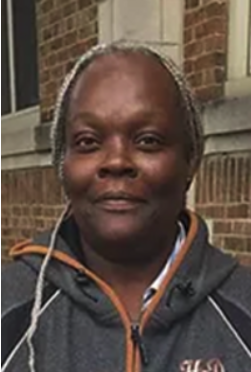
Sheryl McFarland
According to her campaign website, Sharyl McFarland, a member of the Green Party, “is a Milwaukee organizer working for social justice and human rights.” Among issues for which she advocates to correct are voter suppression, racial inequalities, mass incarceration, homelessness, rights for immigrants, poverty, lack of adequate transportation, and healthcare.
Information outlining the candidate’s platform is here: https://www.wisconsingreenparty.org/sharylforwi.
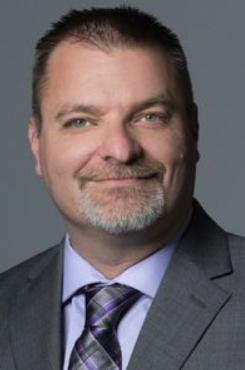
Neil Harmon
Libertarian Party candidate Neil Harmon offers information about his campaign through a Facebook page. Among his comments, he writes: “First off, I am a family guy and my kids are the most important aspect of my life. My wife and I have been married for over 15 years and continue to thrive. I currently have zero credit card debt so handling financials is a forte. My current job is very rewarding as I help people, through non profits, to lower prescription costs. No government involvement. I enjoy playing volleyball and traveling. I have been an advocate against blanket mandates. One of my goals if elected is to see if our money is being served well by the state. As proof in running, there is a lot of secrecy within our government and media. This is also a main reason I am running as a third party to expose the duopoly.” More information about the candidate is here: https://www.facebook.com/HarmonforSecretaryofState/.
Running for U.S. House Wisconsin District 1
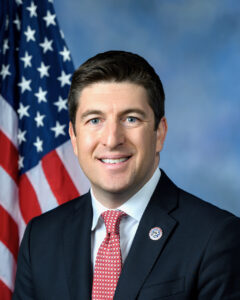
Bryan Steil
According to his official website, Bryan Steil was first elected to the U.S. House of Representatives in Wisconsin’s 1st District in 2018. His predecessor was Paul Ryan. Prior to his election, Steil worked in Wisconsin’s manufacturing industry, first with an industrial motion control manufacturer in Beloit, and then with a plastics manufacturer in Milton. In 2016, he was appointed to serve on the University of Wisconsin Board of Regents. He is a native of Janesville, graduating from Janesville Craig High School, and has attended Georgetown University and the University of Madison Law School. Steil’s official website can be found online. His Ballotpedia profile is here: https://ballotpedia.org/Bryan_Steil.
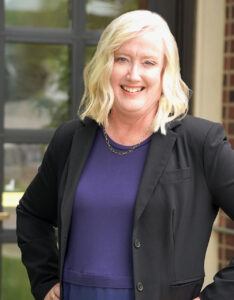
Ann Roe
According to her campaign page, Ann Roe is a small business owner, former educator, working mom and the daughter of a Korean War veteran. She has worked in corporations, small businesses, nonprofits and the educational system. She has served as president of the Downtown Janesville board for the last year. She has lived in Janesville for 25 years, with her husband, who is a pediatrician. The couple has two children. Roe’s campaign page can be found online. Her Ballotpedia profile is here: https://ballotpedia.org/Ann_Roe.

Charles Barman
Offering information on his Linkedin.com profile, Charles Barman describes himself as the owner of Swingbelly Farm, Sharon, which he has owned since 2016. He notes that through the farm he “provides eggs and produce to folks that want to eat healthy and without antibiotics or GMO.” Additionally, he notes that he is a freelance “Santa,” and has worked as a construction superintendent. Information about the candidate is here: https://www.linkedin.com/in/charles-barman-007089a3/.
Running for U.S. House Wisconsin District 5
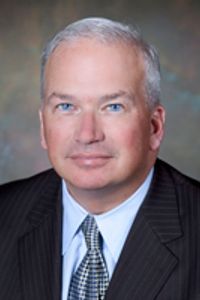
Scott Fitzgerald
According to his official website, Scott Fitzgerald was elected to the U.S. House of Representatives in 2020. Prior to his election to Congress, he served in the Wisconsin State Senate representing the 13th District from 1995 to 2021. Fitzgerald joined the U.S. Army Reserve in 1981 and was commissioned as a lieutenant in the Armor Branch in 1985. He completed the Army Command and General Staff College and served in a number of assignments during his 27 years of service, including Battalion Commander. In 2009, he retired from service at the rank of Lieutenant Colonel. Born in Chicago, he moved to Wisconsin, graduated from Hustisford High School, and earned a bachelor’s degree from the University of Wisconsin-Oshkosh in 1985. He is a former owner of the Dodge County Independent News in Juneau and the Watertown Daily Times. His father, Stephen Fitzgerald, was sheriff of Dodge County for 14 years, served as the U.S. Marshal for the Western District of Wisconsin and most recently served as the superintendent of the Wisconsin State Patrol until his retirement in 2016. His brother, Jeff, was an Assembly Representative from Dodge County who served as the Assembly Speaker for the 2011-2012 legislative session. Scott and his wife live in Clyman. The couple has three children. Fitzgerald’s official website can be found online. His Ballotpedia profile is here: https://ballotpedia.org/Scott_Fitzgerald.

Mike Van Someren
According to his campaign page, Mike Van Someren is the son of an over-the-road truck driver. He is a former public school basketball and football player, and played football in college at UW-Madison and UW-River Falls. He holds a bachelor’s degree in history. He holds a law degree from Marquette Law School. Van Someren began his law career in Waukesha, focusing on real estate law. He serves on the board of Habitat for Humanity of Waukesha County and the Veterans Community Foundation. He has also served as a board member of ArtWorks for Milwaukee. Van Someren is married and the couple has two children. The family lives in Delafield. His campaign page can be found online. His Ballotpedia profile is here: https://ballotpedia.org/Mike_Van_Someren.
Running for Lieutenant Governor

Sara Rodriguez
Serving in the Wisconsin Assembly representing district 13, Sara Rodriquez assumed office in 2021. District 13 includes constituents living in Brookfield, Elm Grove, and western Wauwatosa. Rodriguez, according to her Wikipedia profile, is a registered nurse. She is 47, and the parent of two children. She was born and raised in Milwaukee and holds a bachelor’s degree in neuroscience from Illinois Wesleyan University. After college, she volunteered with the Peace Corps and served for two years in Samoa. She has also volunteered with the World Health Organization. After returning to the U.S., she continued her education earning a bachelor’s degree and master’s degree in nursing from John Hopkins University. Professionally, she has worked as an ER nurse at Mercy Medical Center in Baltimore, and at the Center for Disease Control and Prevention (CDC) in its Epidemic Intelligence Service from 2004 to 2006. In 2011, she returned to Wisconsin and was employed as vice president of Clinical and Analytical Services at The Benefit Services Group, Inc., until 2014. She then worked three years as vice president of Clinical Services at Honeywell Life Care Solutions. From 2017 until her campaign for the Assembly in 2020, she was vice president for Population Health and Integrated Care Management at Advocate Aurora Health. Information about the candidate as provided by Ballotpedia is here: https://ballotpedia.org/Sara_Rodriguez.

Roger Roth
President of the Wisconsin State Senate, Roger Roth has served in that body, representing constituents in the 19th district, since 2015. Prior to winning his Senate seat, he served in the Assemble, representing district 56, between 2007 and 2011, according to his Wikipedia profile. The 19th State Senate District includes northern Winnebago County and southwest Outagamie County, along with Appleton, Menasha and Neenah. Roth is 44. He was born in Appleton. He holds a bachelor’s degree from the University of Wisconsin-Oshkosh. Prior to entering politics, he worked for his family’s homebuilding business and served in the Wisconsin Air National Guard, joining in 2003. He served four tours of duty during the Iraq War. During the course of his political career, according to his profile, he supported a resolution backing a Republican lawsuit challenging the Affordable Care Act, the federal health care reform legislation signed into law by President Barack Obama. Information about the candidate provided by Ballotpedia is here: https://ballotpedia.org/Roger_Roth.
Running for Wisconsin Treasurer

Aaron Richardson
Aaron Richardson does not currently have a Wikipedia profile. According to his Ballotpedia profile, Richardson was born in Madison. He earned a bachelor’s degree from the University of Wisconsin-Green Bay in 2000 and an MBA from the University of Wisconsin-Whitewater in 2012. Richardson’s career experience includes serving as the mayor of Fitchburg and working in tech support within the Oregon School District. According to his campaign page, he is the fifth generation of his family to live in Fitchburg. Before taking his position with the Oregon School District, he worked for 16 years in marketing at various companies. He also serves as a youth basketball coach. Richardson’s campaign page can be found online. Information provided about the candidate by Ballotpedia is here: https://ballotpedia.org/Aaron_Richardson_(Wisconsin).

John Leiber
John Leiber does not currently have a Wikipedia profile. According to his Ballotpedia profile, Leiber ran for a seat in the Wisconsin State Assembly District 62. He lost that bid during the primary held in 2018. According to his campaign page, Leiber’s hometown is Racine, where, the page states, his ties go back four generations. He has served as the president of his local parks and recreation commission and as a commissioner for his local housing authority. He holds a bachelor’s degree in history from the University of Wisconsin-Parkside and earned his law degree from the University of Wisconsin Law School. He is married, and the couple has three adult children. Leiber lives in Cottage Grove. His campaign page can be found online. Information provided about the candidate by Ballotpedia is here: https://ballotpedia.org/John_Leiber.
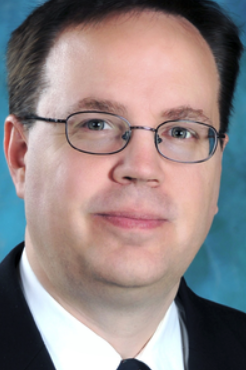
Andrew Zuelke
Constitution Party candidate Andrew Zuelke offers a blog, titled: Wisconsin Treasurer Defender,” through which voters can learn about his political positions. Many posts are radio interviews and letters to the editor written to various newspapers across the state. In a letter he titles: “My final letter to the editor before Nov. 8th — Inflation,” he writes: “Once again, Democrat and Republican candidates are declaring that they care about us “more than their opponent,” and they alone understand our issues and struggles.Why are they asking any of us for money during an inflationary cycle? They are bombarding us with text messages and mailings we didn’t ask for and hitting us up for campaign contributions we can’t afford to give. Many solicitations are from out-of-state candidates we couldn’t vote for anyway. I haven’t solicited campaign contributions from anyone. People need every penny now to buy food, gas, and other staples.” A link to the candidate’s blog is here: https://wisconsintreasurerdefender.wordpress.com.
Running for Wisconsin Senate District 11

Stephen Nass
According to his Ballotpedia profile, Stephen Nass has served in his position as State Senator for seven years, assuming office in 2015. Prior to serving in that role, he served in the State Assembly from 1990 to 2015. From 1978 to 1981, he served on the Whitewater Common Council. Nass is a graduate of Whitewater High School and holds a bachelor’s degree from the University of Wisconsin-Whitewater and a master’s degree in school business management. He has served professionally as a negotiator/payroll benefits analyst. He is a member of the Wisconsin Air National Guard, and served in the Middle East in operations Desert Shield and Desert Storm. He also is a member of the American Legion, Veterans of Foreign Wars, the Mukwonago Business Breakfast Club and Jefferson County Agribusiness Club. His official website can be found online. His Ballotpedia profile is here: https://ballotpedia.org/Stephen_Nass.

Steven Doelder
According to his Ballotpedia profile, Steven J. Doelder was born in Sheboygan. He holds a bachelor’s degree from the University of Wisconsin-Stevens Point and a graduate degree from Carthage College. According to his campaign page, Doelder also holds an associate degree from Gateway Technical College. He completed his certification in teaching chemistry awarded through UW-Madison, and has served professionally as a lifelong teacher. He has served as president of the Racine Education Association. He also has written columns for the Racine Labor paper and the Lake Geneva Regional News. Doelder is the father of two grown children. His campaign page can be found online. His Ballotpedia profile is here: https://ballotpedia.org/Steven_Doelder.
Running for Wisconsin Assembly District 31
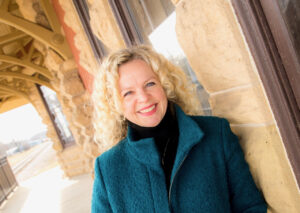
Brienne Brown
According to her Ballotpedia profile, Brienne Brown is running for a seat in the Assembly representing District 31. According to her campaign page, Brown has worked to create a weekly farmers market in Whitewater and has served on the Library Board. She helped reorganize the Whitewater Community Foundation, and writes grant proposals for the Whitewater Grocery Cooperative. She is serving her second term as a City of Whitewater Common Council member and serves on the city’s Plan Board. Brown and her husband both teach at the University of Wisconsin-Whitewater and Brown has worked as a managing editor for an open-source intelligence company, and as an epidemiologist for the Texas Department of Health. Brown’s campaign page can be found online. Her Ballotpedia profile is here: https://ballotpedia.org/Brienne_Brown.
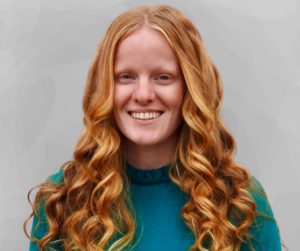
Ellen Schutt
According to her Ballotpedia profile, Ellen Schutt is running for a seat on the Assembly in District 31. According to her campaign page, Schutt is a native of Darien and was raised on her family’s farm. She was a member of 4-H and FFA. She graduated from Delavan-Darien High School and attended the University of Wisconsin-Madison. She helped “re-form” the Young Americans for Freedom chapter on campus and established a chapter of the Luce Society. She also interned for State Rep. Amy Loudenbeck and U.S. Rep. Paul Ryan. She also has worked as a research assistant for State. Rep. Tony Kurtz of Wonewoc. Schutt is married and lives in Clinton. Her campaign page is found online. Her Ballotpedia profile is here: https://ballotpedia.org/Ellen_Schutt.
Running for Walworth County Clerk of Circuit Court
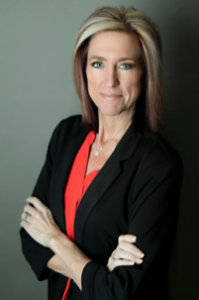
Kristina Secord
According to Ballotpedia.org, Kristina Secord “is running for election to the Walworth County Clerk of Circuit Court in Wisconsin. Secord is on the ballot in the general election on November 8, 2022.” No other information is presented about the candidate. On her Linkedin.com profile, she wrote that she began her tenure in the Walworth County Clerk of Circuit Court’s office as a high school intern, and began working full time in the office in 1992. She was promoted to chief deputy clerk of court in 2014. More information about the candidate is here: https://www.linkedin.com/in/kristina-secord-051094236/.
Running for Walworth County Sheriff
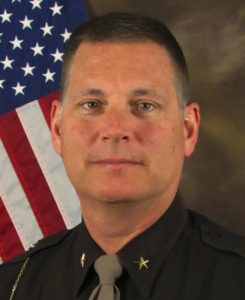
Dave Gerber
According to his campaign website, Dave Gerber has served in law enforcement in Walworth County for 27 years. He serves today as undersheriff of the Walworth County Sheriff’s Office. Prior to his service within the sheriff’s department, he served for a year within the Village of East Troy Police Department. After joining the sheriff’s office, he continued to serve as a police officer in East Troy part-time for 15 years. Additional information about Gerber is available on his website, found here: https://sheriffdavegerber.com.
Running for Wisconsin Assembly District 33
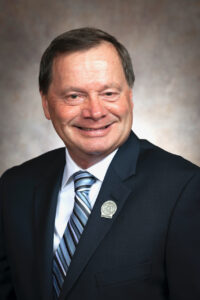
Don Vruwink
According to his Ballotpedia profile, Don Vruwink assumed office representing the state’s 43rd Assembly District in 2017. He continues to represent the district. After legislative redistricting earlier this year, he resides and is now running for a seat in the 33rd district. According to his campaign page, Vruwink grew up on a dairy farm in central Wisconsin. He holds a bachelor’s degree from the University of Wisconsin-Stevens Point and a master’s degree in social studies from UW-Whitewater. Now retired, he spent 42 years as a school teacher, serving, since 1979, as a history teacher at Milton High School. He also served as a coach for more than 90 high school teams. After retiring in 2011, Vruwink served on the Milton City Council and the Milton School Board. He has earned a Lifetime Achievement Award from the Milton Area Chamber of Commerce. Vruwink is married and the couple has one child. Vruwink’ campaign page can be found online. His Ballotpedia profile is here: https://ballotpedia.org/Don_Vruwink.
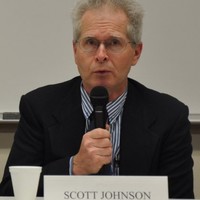
Scott Johnson
According to his Ballotpedia profile, Scott Johnson is a Republican candidate whose name will appear on ballot. The candidate is a resident of Jefferson. According to his Linkedin profile, Johnson has served as a consultant for Johnson Enterprises for 38 years. The company provides farm and financial management and debt restructuring services. Johnson is a former member of the Fort Atkinson School Board, serving from 1999 to 2014. During that time, he writes, “I initiated and led the process of educating the school board, administration, staff, and public on the value of utilizing Geo-Thermal Energy Technology to retrofit four of our schools; replacing old inefficient conventional HVAC systems.” Johnson holds a bachelor’s degree in agricultural economics from the University of Wisconsin-Madison and is a graduate of the leadership program offered through the University of Wisconsin-Extension. He holds a master’s degree earned at UW-Whitewater in school business management. Johnson is a graduate of the Milton High School. His Linkedin profile can be found online. His Ballotpedia profile is here: https://ballotpedia.org/Scott_Johnson_(Wisconsin).
Running for Jefferson County Clerk of Circuit Court

Cindy Hamre Incha
Cindy Hamre Incha, Republican, is the county’s clerk. Information on Ballotpedia.org notes the following: “Cindy Hamre Incha is running for reelection to the Jefferson County Clerk of Circuit Court in Wisconsin. Incha is on the ballot in the general election on November 8, 2022.” No other information is presented about the candidate. According to her Linkedin.com profile, she is the “lead clerk” in Jefferson County.
Running for Jefferson County Sheriff
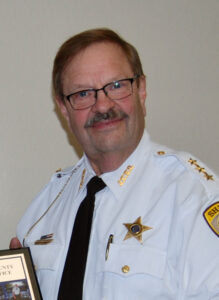
Paul Milbrath
Paul Milbrath, Republican, is the Jefferson County Sheriff. Information on Ballotpedia.org notes the following: “Paul Milbrath is running for reelection to the Jefferson County Sheriff in Wisconsin. Milbrath is on the ballot in the general election on November 8, 2022.” No other information is presented about the candidate.
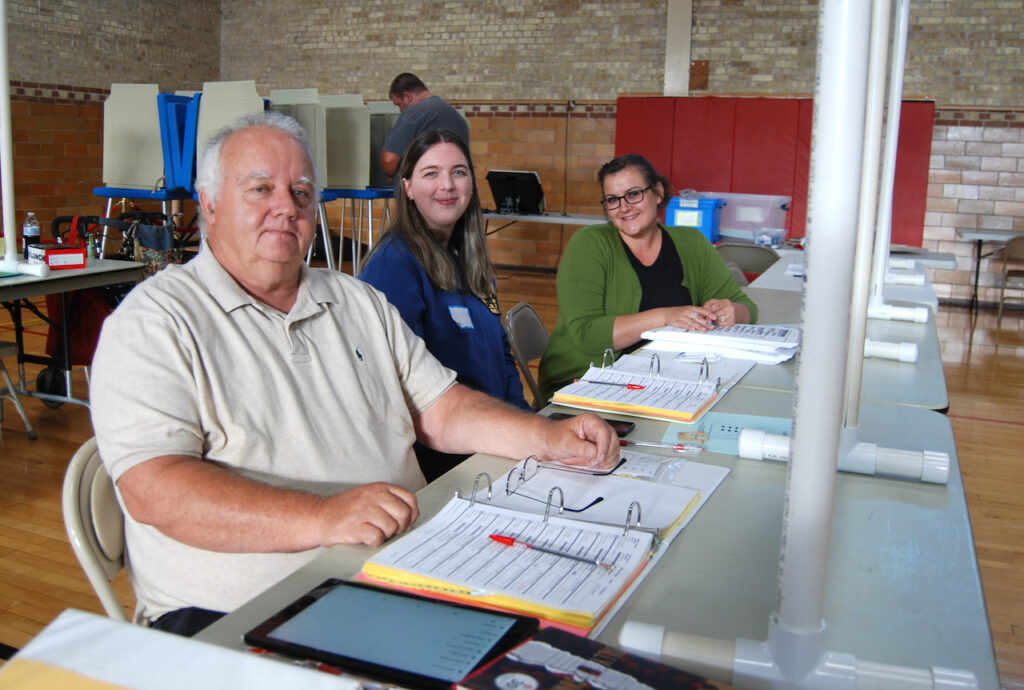
Poll workers Bill Smith, from left, Olivia Pratt and Alaina Smith man a table where Whitewater residents living in Jefferson County received their ballots during the August primary election. Voters will be returning to the polls Tuesday for the fall general election. File photo/Kim McDarison.
Whitewater finance director: City budget offers less tax impact than initially anticipated
(Originally published Nov. 5, 2022.)
By Kim McDarison
Members of the Whitewater Common Council Tuesday received an updated budget briefing.
According to Whitewater Director of Finance Steve Hatton, depending on the outcome of a $1.1 million fire and EMS referendum question, which will be brought before city of Whitewater voters for approval during the Nov. 8 election, one of two proposed budgets — one if the referendum is approved by voters and one if it is not — will be adopted by the council on Nov. 15.
Four taxing jurisdictions
Aided by slides, Hatton noted that four taxing jurisdictions receive a portion of the tax levy charged against property owners within the city, with those dollars used to support services delivered by each jurisdiction. They are: Walworth and Jefferson counties, each of which receive 15% of the overall levy; the area technical college, which receives 4% of the levy; the Whitewater Unified School District, which receives 47% of the levy, and the city, which receives 34% of the levy.
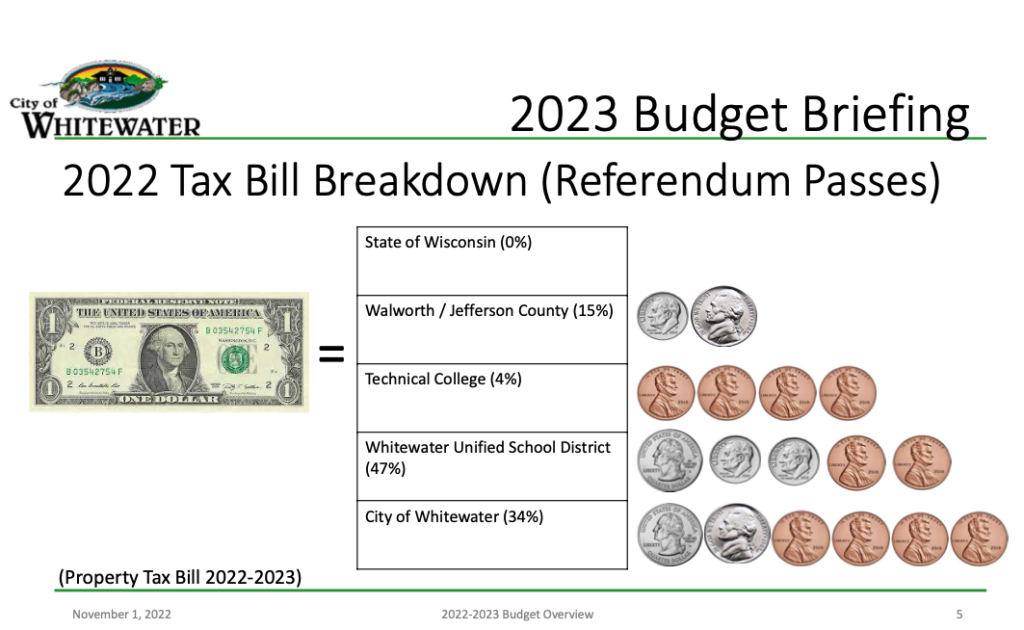
The slide shown above and presented to the Whitewater City Council Tuesday by Director of Finance Steve Hatton uses a graphic to depict the percentage of the full tax levy supported by residents of Whitewater used to fund services provided by each of four taxing jurisdictions: the county, technical school, public school district and city.
Two city budgets developed
Among goals set by the city in advance of the Nov. 8 election, Hatton said two budgets were developed, each of which would deliver a plan for wage treatment given the inflationary environment, which, as reported in August by the Consumer Price Index, was 8.3%, and maintain a fund balance equal to or greater than 20% of the city’s general fund operating budget.
Would the city’s fire and EMS referendum receive voter approval, the city would use $1.1 million collected through the levy and above the state-imposed revenue cap to sustainably close the city’s share of the funding gap. The gap represents a different in cost between operating the city’s fire and EMS department as an outside nonprofit agency as opposed to an in-house department with city-employed staff. The additional funding would be used to maintain EMS onsite staffing up to 17 full-time employees, and allow the city to fully fund the replacement of fire and EMS equipment without accruing debt.
During the presentation, Hatton said the money would allow the city to operate two ambulances staffed by in-house EMS personal on a 24/7 bases.
Additionally, Hatton noted, the full budget, would the referendum pass, would allow the city to offer a 4.0% wage increase which would give more flexibility when recruiting and retaining staff and would also include $28,000 coming from within the general fund to pay for a solid waste and recycling fee increase.
Would the referendum fail, the city would be in a position to operate one ambulance on a 24/7 bases, Hatton said.
Other changes to the budget, would the referendum fail, would include billing a $15.15 per month waste recycling fee directly to service users, and deferring transfers of money that might have been used for street repair and equipment replacement.
Among proposed changes within the city’s operating budget in either scenario — the referendum does or does not pass — plans call for parks and recreation overhead to be move to the city’s Fund 248, and changes to be made within the operation of street lights designed to reduce expenditures for electricity.
Comparing budgets
Looking comparatively at the general fund budget last year, this year, and including the two proposed budgets for 2023, numbers are as follows:
• in 2021, the city operated using a total general fund balance of $9,641,209, with $8,512,328 used to fund operations, $182,529 used to support the city’s fire and EMS department, which then operated as a nonprofit, independent agency, and $946,352 was used to support debt service.
• In 2022, the city operated using a total general fund balance of $10,020,828, with $8,792,334 used to fund operations, $182,529 used to support the fire and EMS department as a nonprofit, independent agency, and $1,045,965 used to support debt service.
• In 2023, would the referendum succeed at the ballot, the city would operate using a total general fund balance of $11,510,978, with $8,995,258 used to fund operations, $1,258, used to support the fire and EMS department, which, this year, was brought in-house and will henceforth operate as a city-managed agency, and $1,257,105 used to support debt service.
• In 2023, would the referendum fail on Tuesday, the city would operate using a total general fund balance of $10,259,029, with $8,400,924 used to fund operations, $601,000 used to support an in-house fire and EMS department, and $1,257,105 used to support debt service.
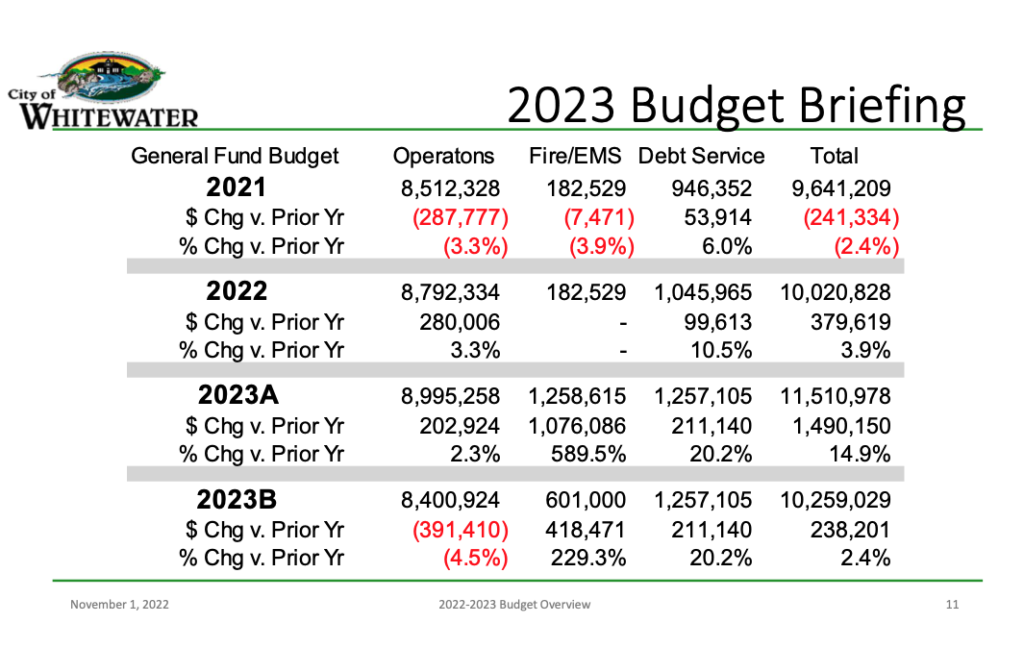
The slide above, as provided by Hatton, shows a comparison between monies used to support the city’s general fund, and fire and EMS department, last year, this year, and next year. In 2023, the comparison offers two budgets, one developed with referendum monies included, and one without.
Referendum passes: general fund expenditure, revenue breakdown
During his presentation, Hatton shared a pie chart showing the breakdown by percentages of expenditures funded within the city’s budget.
Among expenditures, 44% of the general fund is used to support public safety, according to the chart. Another 23% was marked “transfers,” with 15% used to support “administration,” 10% used to support “public works,” 5% earmarked for parks and recreation, and 3% used for neighborhood services and planning.
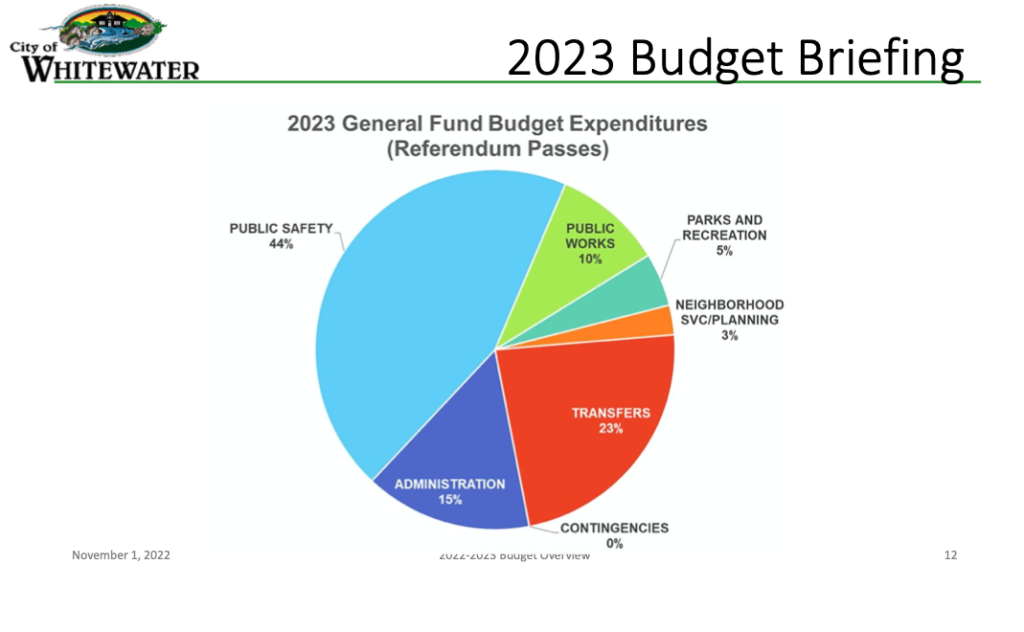
The pie chart above shows the breakdown by percentages of expenditures funded within the city’s budget.
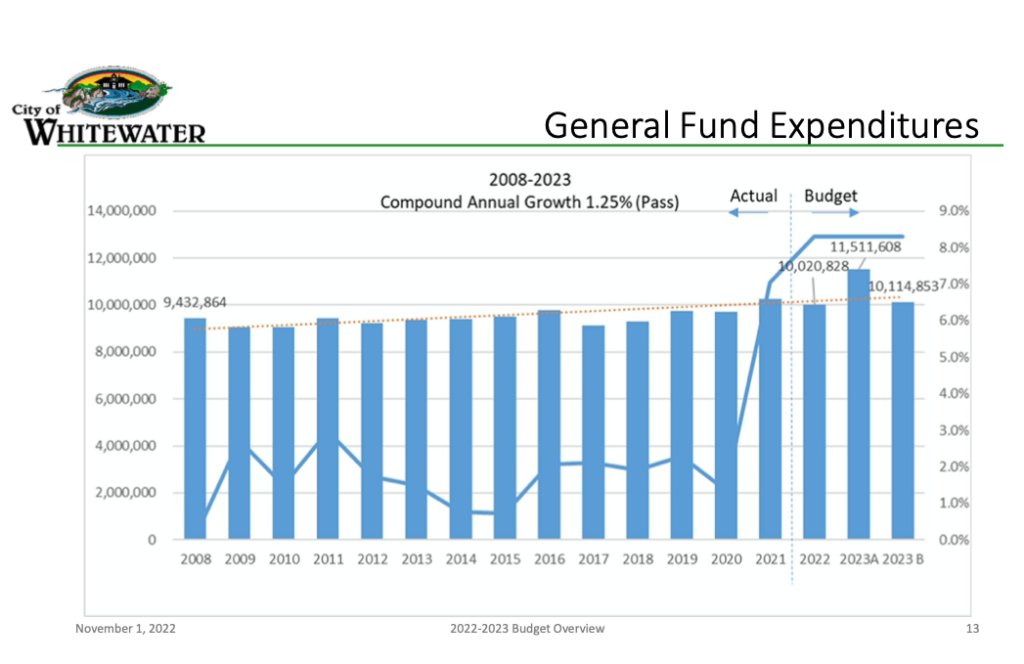
Additionally, Hatton produced a bar chart, above, showing annual growth in expenditures between 2008 and 2023, including a bar to represent each of the proposed budgets associated with the referendum’s outcome.
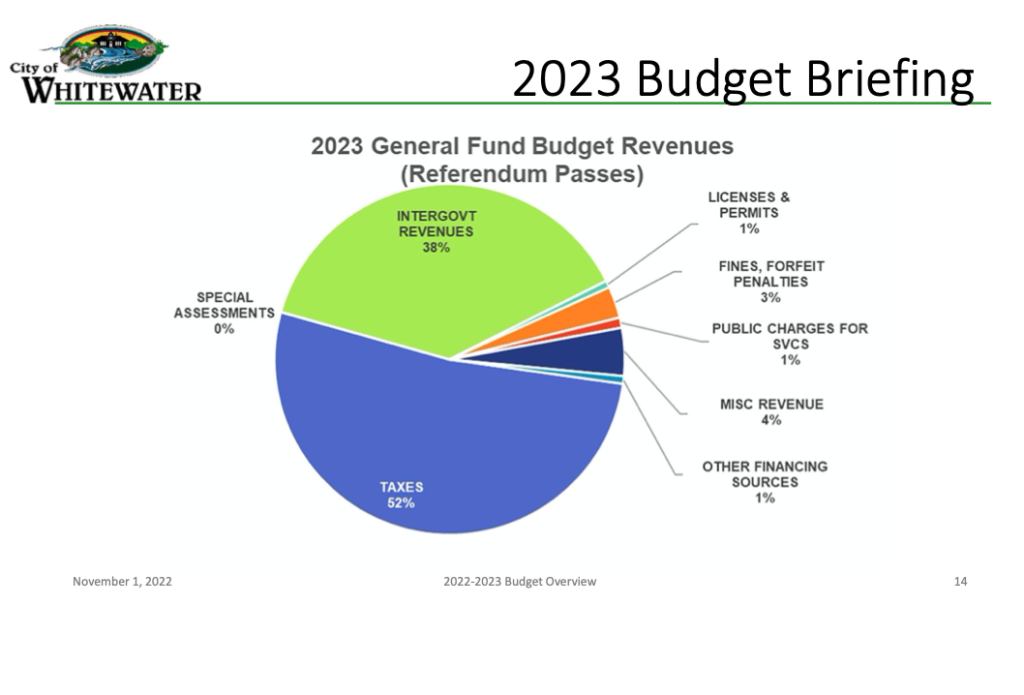
A second pie chart, above, showed the breakdown by percentages of revenues used to fund the city’s budget.
Among revenues, 52% is obtained through taxes. Another 38% is obtained through “intergovernmental revenues,” with 4% coming through “miscellaneous revenue,” 3% gained through fines, forfeitures and penalties, 1% obtained through licenses and permits, 1% coming from public charges for service, and another 1% earned through “other financing sources.”
Referendum passes: total levy, mill rate
Using a blended Walworth and Jefferson county illustration, defined by Hatton as one using a weighted average mill rate, based on equalized value in each county, used to represent rates in both Walworth and Jefferson counties, numbers presented Tuesday are as follows: the tax levy paid by Whitewater residents in 2021 and used to support services in 2022 delivered by the four taxing jurisdictions — county, technical college, school district and city — was $16,923,904. The levy was assessed against the equalized property value of all homes within the city, and calculated by the Wisconsin Department of Revenue at 750,563,583. The full mill rate paid by the city’s taxpayers was $22.55 per $1,000 of home value. In 2022, would the referendum pass, the levy paid by taxpayers to support 2023 budgets across the four jurisdictions is $16,463,764, calculated against a total equalized property value of 826,163,828, which is collected using a mill rate of $19.93 for taxpayers within the city.
The illustration shows that among factors affecting the full levy and mill rate is the closing of a Tax Incremental Financing District (TID), which, the chart shows, added back into the tax roles some $1,947,305 in revenue, which was then redistributed back to the four taxing jurisdictions. The reintroduction of those monies lowered the full levy and the mill rate, Hatton said.
Looking at the portion of the levy used to support the city’s budget, this year, taxpayers will be asked to support $5,756,853, with a mill rate of $7.01 per $1,000 of home value to support city services delivered in 2023. The number represents an increase in the levy used to support the city’s budget last year, which was $4,200,935, with a mill rate of $6.37.
Looking at the other taxing jurisdictions, the (blended) county levy in 2021 was $2,391,227, supported by a mill rate of 3.24. In 2022, the levy is $2,547,180, supported by a mill rate of $3.11. The technical college levy in 2021 was $514,651, with a mill rate of 78 cents. In 2022, the levy is $554,174, with a mill rate of 68 cents. In 2021, city of Whitewater residents supported a Whitewater Unified School District levy of $7,758,451 which came with a mill rate of $11.76. In 2022, the school district levy is $7,494,221, with a mill rate of $9.13.

The chart above shows total levy amounts developed across the four taxing jurisdictions in 2021 and 2022. Taxes levied in 2021 are used to support expenses in 2022. Taxes levied in 2022 will be used to support services provided in 2023.
Referendum does not pass: total levy, mill rate
Within his presentation, Hatton shared a slide showing the impact to the levy and mill rate across the four taxing jurisdictions would the referendum fail to receive voter approval.
Would the referendum not pass, the total levy used to support the taxing jurisdictions would drop from $16,923,904, which was the amount collected in 2021 in support of the 2022 budget year, to $15,057,661. The mill rate would also decrease from $22.55 to $18.23.
Looking at the difference in levy and mill rate over last year without the additional revenue from the referendum, the city’s levy would be $4,389,278 with a supporting mill rate of $5.31.
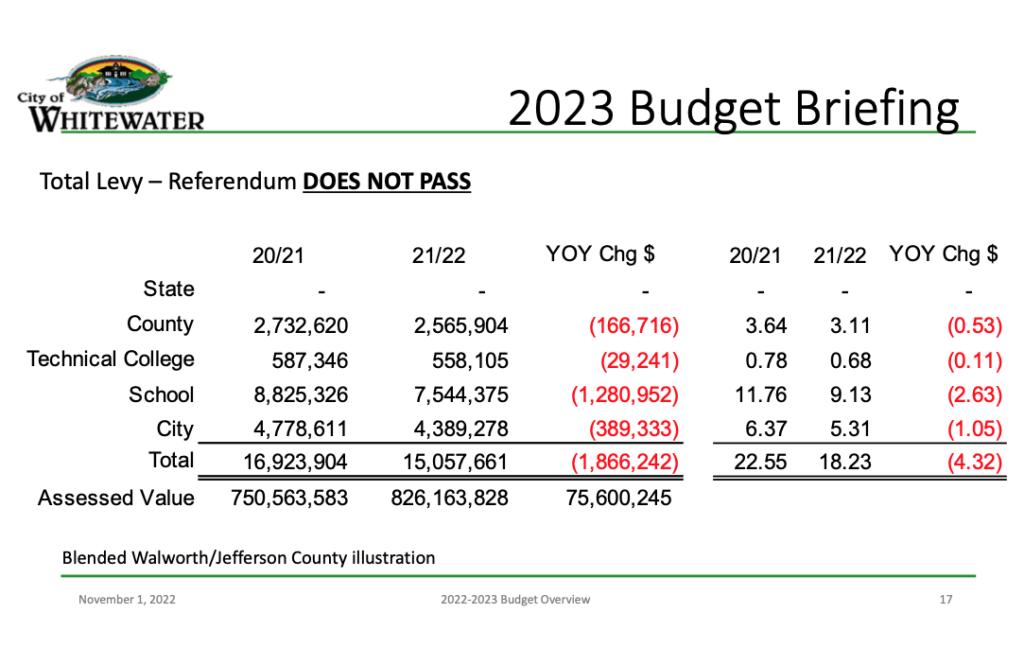
The chart above shows the impact to the levy and mill rate across the four taxing jurisdictions would the referendum fail to receive voter approval.
Impact on average homeowner
Comparing a slide offering a “tax bill Illustration” for the average homeowner in both Jefferson and Walworth counties with a similar slide presented during a budget presentation made last month, Hatton said the outcome for taxpayers, even with approval given by voters to the city’s referendum and one placed on the ballot by the Whitewater Unified School District, was “better” than initially anticipated.
In a “draft” slide presented to council in October, Hatton noted that a homeowner, with a home assessed at $200,000 and living in Walworth County, who, in 2021-22 had seen no change in their assessed value, could expect to see a reduction in the amount of taxes paid across the four taxing jurisdictions by $409.01. In Jefferson County, a similar homeowner could expect to see a reduction of $524,59.
Updated numbers presented Tuesday showed that a Walworth County homeowner meeting the same conditions as presented earlier with no change in their assessment would realize a reduction is their tax bill of $514,69. A similar homeowner in Jefferson County, would see a reduction of $593,10.
According to draft numbers presented in October, for those homeowners who did experience an increase in their assessed value, estimated in Walworth County, according to officials at 7.8%, which would bring their assessed value up from $200,000 to $215,000, that homeowner could still expect to see an overall decrease in their tax bill of $91.17. In Jefferson County, the average assessment increase, city officials said, is 13.5%, which would mean a house worth $200,000 in 2021 would be worth $227,000 in 2022. In that case, according to city officials, the homeowner would see a modest increase in their overall bill of $33.13.
Updated numbers presented Tuesday showed that Walworth County homeowners whose homes did experience an increased assessment could expect to see a decrease in their tax bill of $205.08. A similar homeowner in Jefferson County could expect to see a decrease in an overall tax bill of $44.61.
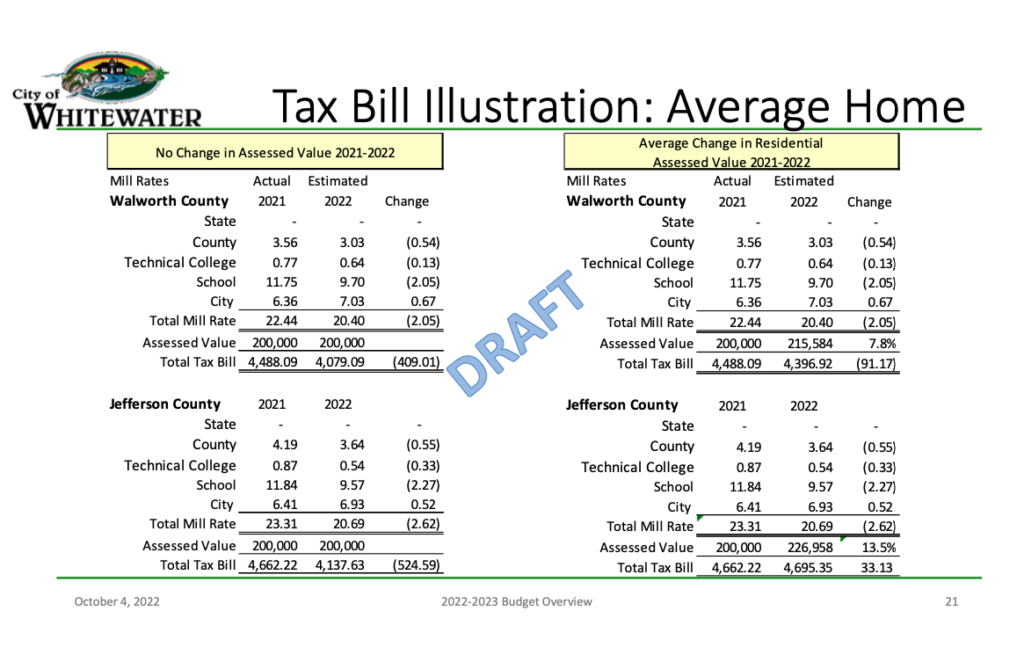
The chart above, shared in October, shows impacts to taxpayers’ property tax bills with no increases in home value assessments and increases in home value assessments for city residents living within Walworth and Jefferson counties.

The chart above, shared Tuesday, shows impacts to taxpayers’ property tax bills with no increases in home value assessments and increases in home value assessments for city residents living within Walworth and Jefferson counties. During Tuesday’s city council meeting, Hatton noted that impacts to tax bills are more favorable than the city had initially anticipated.

The chart, shown above and shared Tuesday by Hatton, shows the actual tax bills in 2021 of two residents living within the city. One, Hatton said, was the tax bill for a council member’s home in Walworth County and the other was the tax bill for a staff member’s home in Jefferson County. In each case, he said, with the city’s referendum passing, estimates calculated for 2022 show a reduction in both taxpayers’ bills.
Whitewater voters arrive at the polls
(Originally published Nov. 8, 2022)
By Kim McDarison
Bill Smith, chief inspector at the downtown armory — one of two polling places receiving city of Whitewater voters Tuesday — said some 1,200 voters had visited the armory by around 1:45 p.m.
A second polling place was open on the University of Wisconsin-Whitewater campus in the Hamilton Room in the University Center. City Clerk Michele Smith, who also is Bill’s wife, was on site at that location, Bill said.
At the armory, Bill, who has served as a poll worker in Whitewater for 20 years and as a chief inspector for 12, described the traffic as “good,” and producing a steady flow throughout the day.
All of the poll workers manning tables and receiving voters by wards were busy, he said, adding that even poll workers at the registration tables were busy.
Speaking with Bill Smith by phone, Michele Smith said some 1,200 absentee ballots were requested and by Tuesday afternoon, about 1,100 had been returned.
“Some are still out there, but the majority have been returned,” Bill said.
Describing the mood of the voters, Bill said: “All of them seem like they want to make a difference, no matter what their preference. Some elections seem like a social event. Not this time. People are very purpose-driven.”
During the August primary, Michele Smith said the city had about 6,000 registered voters.
During the primary, some 750 absentee ballots were issued, with the clerk describing that number as larger than the average number of ballots requested by voters before COVID-19.
Photos taken at the city’s downtown polling location follow.
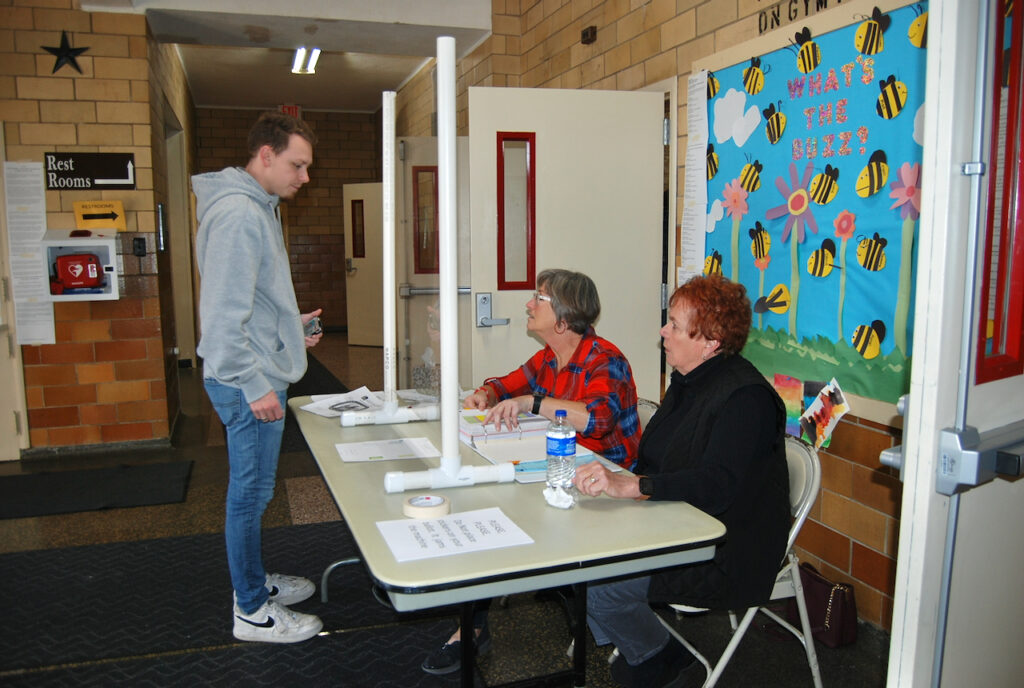
Operating from a table in the vestibule of the downtown armory, greeters Pam Cronce, seated, at left, and Whitewater Common Council member Carol McCormick direct UW-Whitewater Student Colin Vorreyer to his polling place, which, in his case, was at the city’s other polling location on campus.

Poll workers Lynn Binnie, from left, Patti Rohrs, standing, Valerie Cole, Sharon Knight, and David Medici receive voters living within the city’s wards 1 and 2.

Poll worker Dorothy Spurgat is ready to assist voters from within the city’s wards 6-8.
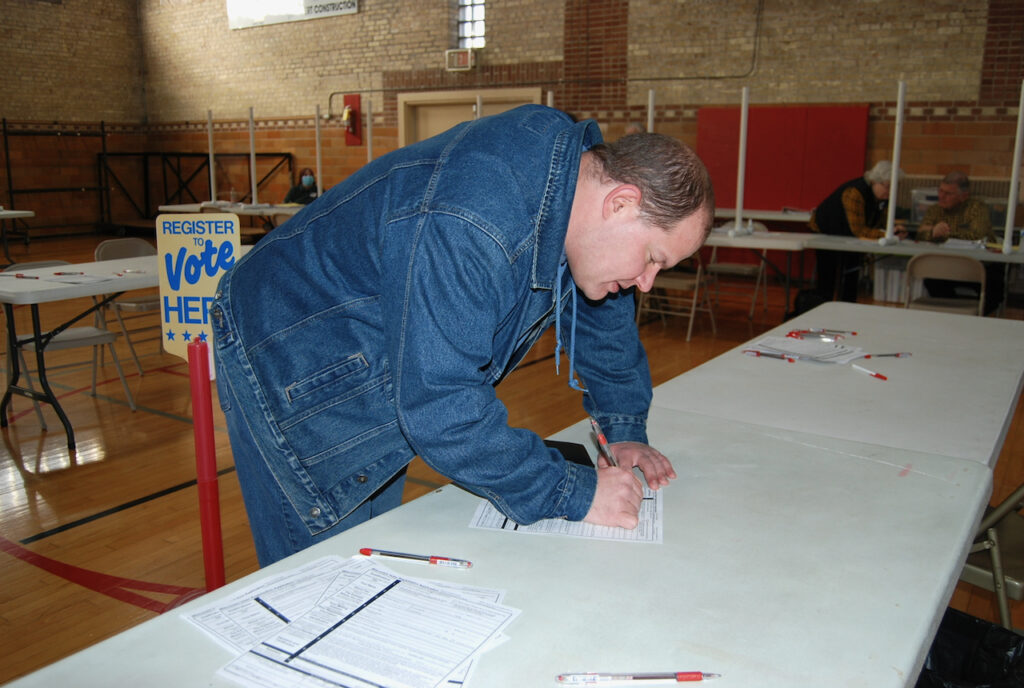
Nate Schulte fills out his voter’s registration form.
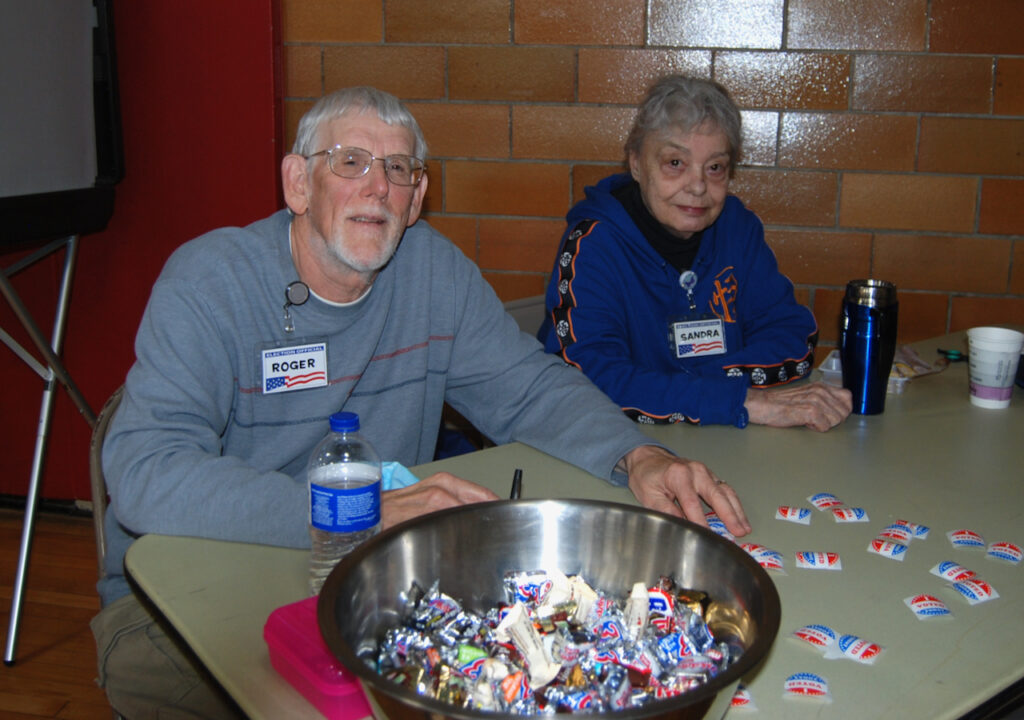
Poll workers Roger Cole, from left, and Sandra Hass, watch the voting machine to make sure ballots are inserted correctly and counted.
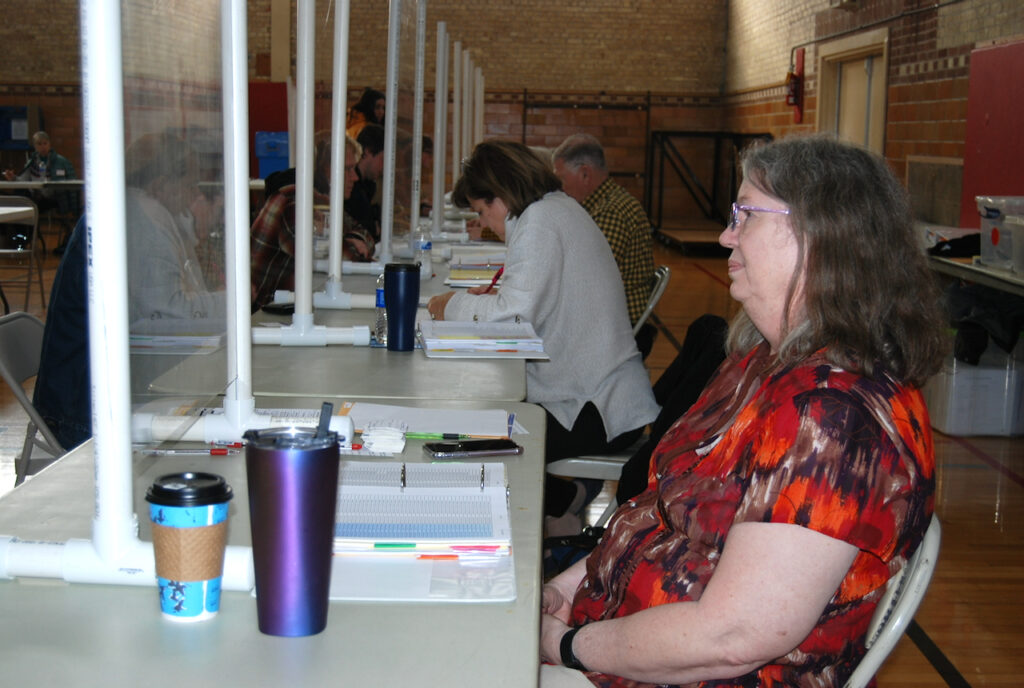
Cynthia Abernethy is among poll workers manning the voter registration table.
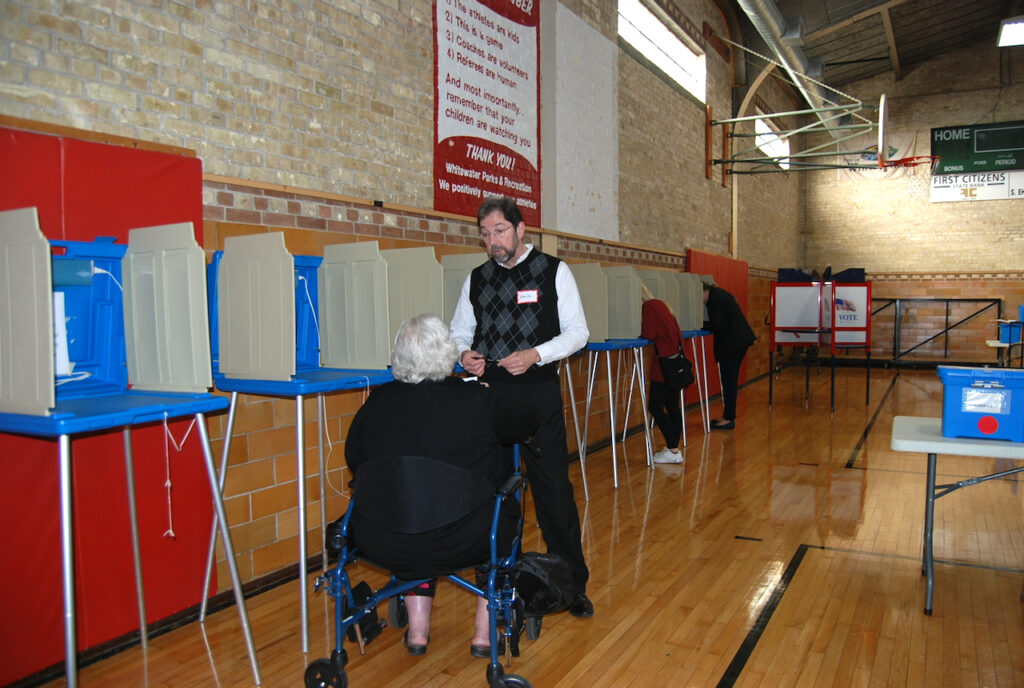
Poll worker David Medici assists a voter.
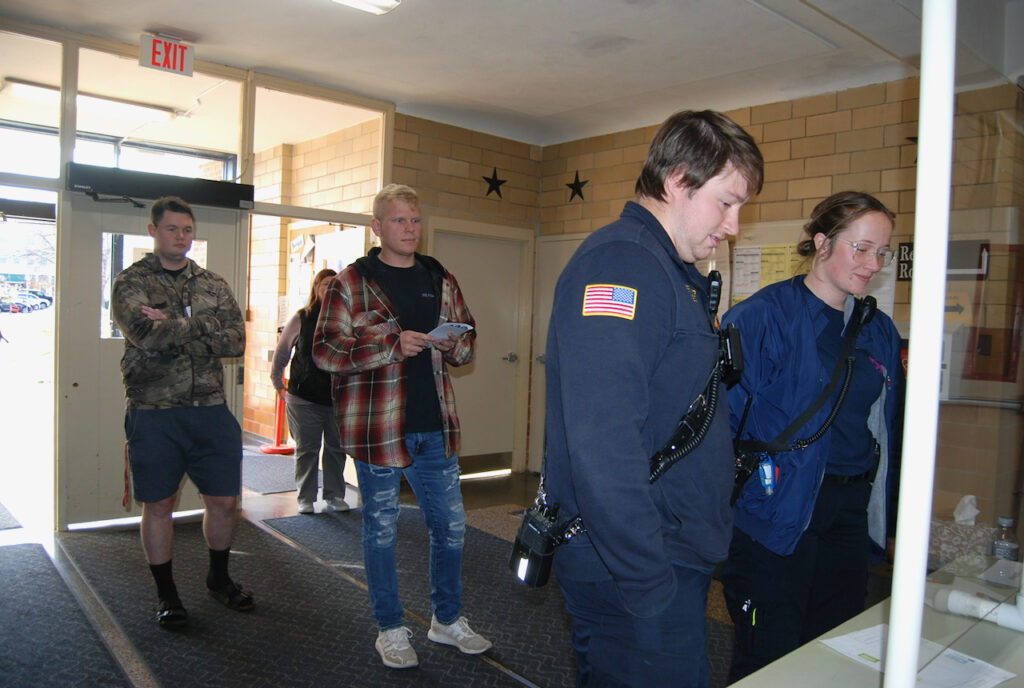
Residents begin the voting process by arriving at the greeters table in the vestibule of the downtown armory.
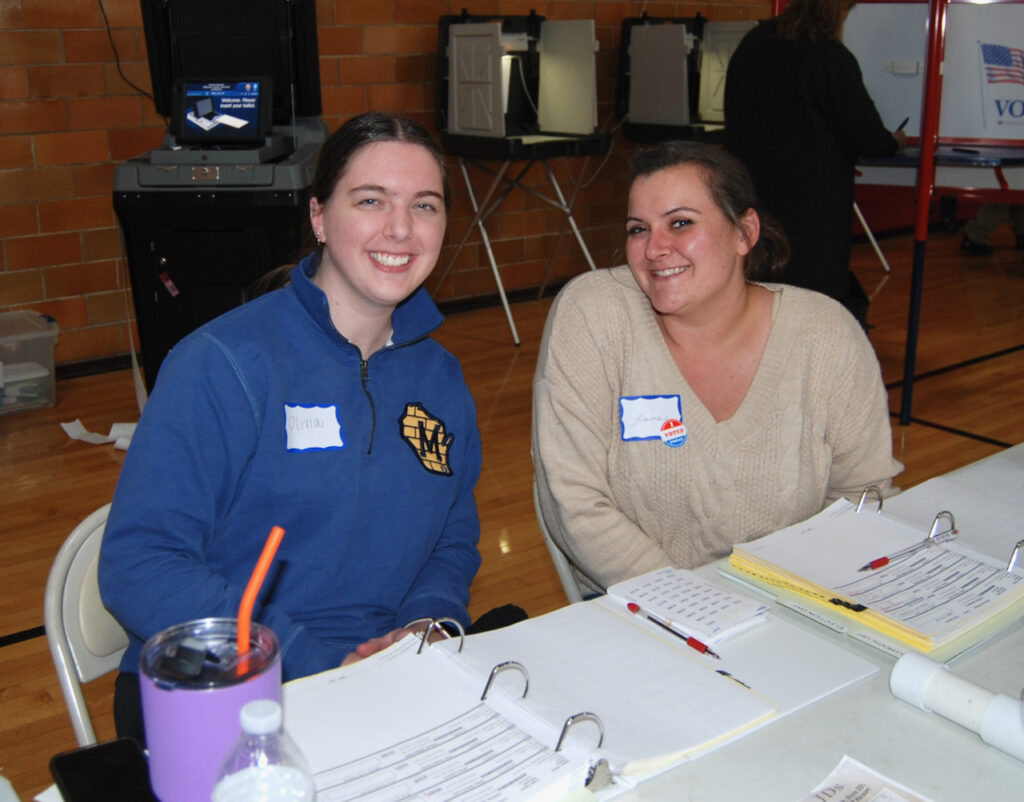
Poll workers Olivia Pratt, at left, and Alaina Smith receive voters and issue ballots at a table serving city of Whitewater Wards 11 and 12, both of which are in the Jefferson County portion of the city.
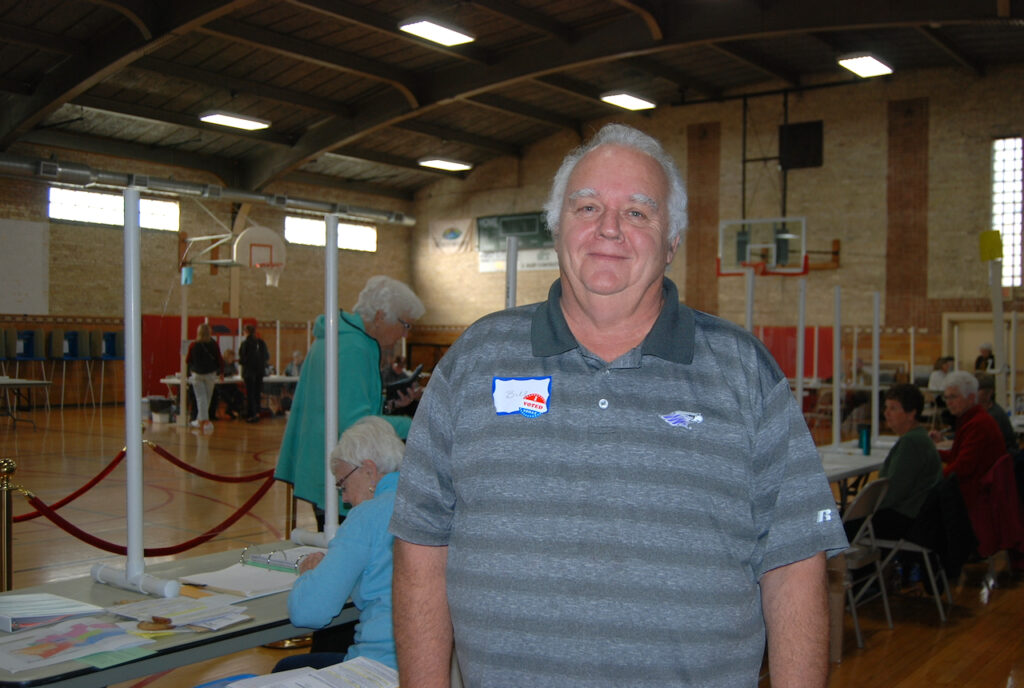
Chief Inspector Bill Smith oversees the election process Tuesday afternoon at the downtown armory in Whitewater.
Kim McDarison photos.
Whitewater: Council approves ordinance aimed at reducing nuisance emergency calls
(Originally published Nov. 17, 2022.)
By Kim McDarison
An ordinance aimed at reducing nuisance emergency calls received final approval Tuesday during the Whitewater Common Council’s regularly scheduled meeting.
The item was approved without discussion and as part of the council’s consent agenda, a tool used by municipal governments, allowing multiple routine meeting items to be grouped together as a single agenda item and approved with one motion.
Along with the ordinance outlining preventable EMS calls, an item acknowledging the filing of financial reports for October was included within Tuesday’s consent agenda. The consent agenda received unanimous approval.
Councilman Greg Majkrzak was not in attendance.
The ordinance addressing preventable EMS calls was initially discussed during a council meeting in October, during which time council voted to postpone the matter.
During discussion held in October, council members expressed concerns with stipulation proposed within the ordinance which presented a schedule of penalties for those residents who engaged in activities the police and fire departments defined in the ordinance as “unnecessary or preventable” calls.
Within the ordinance, as initially proposed in October, eight behaviors were defined as unnecessary or preventable, including:
- Calls that do not require emergency service.
- Repeated calls that display a pattern indicating the home/care employee skill levels and capabilities do not align with the special needs of the resident.
- Fire alarms caused by unattended, burned food.
- Fire alarms caused by detectors that have not been maintained.
- Fire alarms caused by excessive dust or a similar non-combustible trigger.
- 911 misdial/hangup calls.
- Runaway, elopement or missing resident calls.
- Lift assist calls not caused by a fall.
In the revised ordinance that received approval Tuesday, one behavior — lift assist calls not caused by a fall — was removed from the list.
Additionally, during discussion held by council members in October, several expressed concern with the punitive nature and schedule of fines proposed in the ordinance.
In October, the ordinance outlined the following penalties for the listed offenses: First offense, not less than $100 or more than $300; second offense within one year, not less than $300 or more than $550, and for a third or subsequent offense within one year, not less than $500 or more than $700.
Majkrzak asked about the process that would be used to initiate punitive action, further asking: at what point would someone be citied for a violation?
He suggested that a three-strikes concept might be developed, giving residents an opportunity to resolve problematic behavior before receiving a penalty.
He also suggest that the first offense could be treated like a warning.
Councilman Jim Allen expressed concern that some individuals within the community might not understand that they were in violation of a city ordinance.
He said: “This could be used more against Hispanic people, or interpreted that way, if it’s used unequally.
“It’s tough to create an ordinance that could be used against someone who doesn’t understand what they’re at fault for. Secondly, there are situations where they don’t have $300. … I don’t know. I think it needs a little more work.”
Language within the ordinance which was approved Tuesday states that “any person, company or organization, which has generated three or more documented complaints or circumstances requiring emergency services, determined to be an unnecessary or preventable call for emergency services on three or more incidents within one year, shall receive a written notice from the police department outlining their violation of this ordinance.”
Subsequent violations, according to the ordinance, occurring in the one-year period may result in a fine.
Penalties are as follows: not less than $100 nor more than $300 for a first offense; not less than $300 nor more than $550 for a second offense within one year; and not less than $500 nor more than $700 for a third or subsequent offense within one year. One year is defined as a 12-month rolling calendar year, according to the ordinance.
An earlier story about the ordinance and a presentation made to council in October is here: https://fortatkinsononline.com/whitewater-council-postpones-ordinance-aimed-at-reducing-nuisance-emergency-service-calls/.
The full ordinance is here: http://fortatkinsononline.com/wp-content/uploads/2022/11/WW-ordinance-unnecessary-preventable-EMS-calls-.pdf.
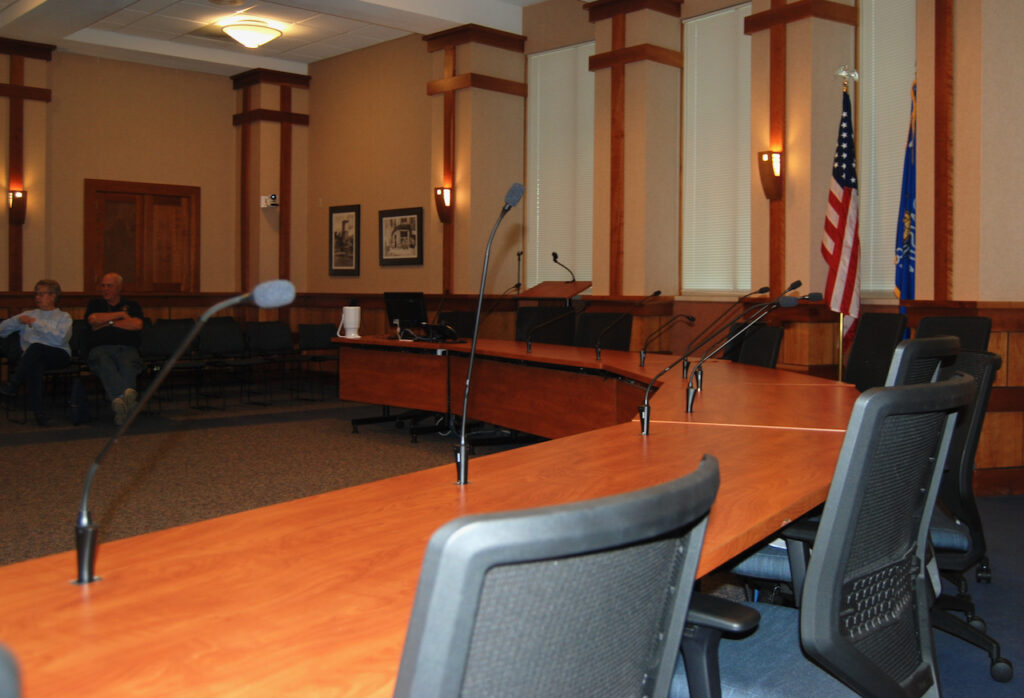
Whitewater council chambers, file photo/Kim McDarison.
Voters approve Whitewater Fire, EMS referendum
(Originally published Nov. 8, 2022.)
By Kim McDarison
By a nearly 2-1 margin city of Whitewater voters approved a Fire and EMS referendum, allowing the city’s operational budget to increase beyond the taxpayer-supported, state-imposed revenue cap by $1.1 million beginning this year and into perpetuity. The funding will be used to support 17 full-time fire and EMS employees who will man two ambulances and provide round-the-clock service.
The referendum garnered voter approval by a vote of 2,476 to 1,379.
A breakdown of votes by county follows: In Walworth County, voters within the city cast 2,053 votes in favor of the referendum and 1,121 against.
In Jefferson County, voters living within city of Whitewater Wards 11 and 12 cast 267 ‘yes’ votes and 160 ‘no’ votes. Voters in Ward 13 cast 156 ‘yes’ votes and 98 ‘no’ votes.
In July, the Whitewater Common Council approved an agreement to bring the city’s then independently operated fire department in house as a city-operated department.
The change was made to help alleviate increasing difficulties with staffing faced by the department when using a paid-on-call model, Whitewater Finance Director Steve Hatton noted in July.
With staffing constraints, he said, Whitewater was often forced to seek mutual aid from neighboring departments, putting additional stress on those departments’ manpower and assets.
Plans associated with bringing the department in house called for the use of a paid-on-premises model, which would improve the department’s response times and improve its ability to recruit manpower, Hatton said.
The new model would also provide department employees with health and retirement benefits and produce a schedule with more reliable hours, he said.
In March, the Whitewater Common Council received a presentation made by Whitewater EMS Chief Ashley Vickers.
Within her presentation, Vickers shared a proposal to increase EMS staffing.
Additionally, she discussed the EMS department’s growing call volume and concerns with response times using a paid on call staffing model.
An earlier story about EMS staffing, call volumes and response times as outlined by Vickers is here: https://fortatkinsononline.com/whitewater-common-council-considers-referendum-to-fund-ems/.
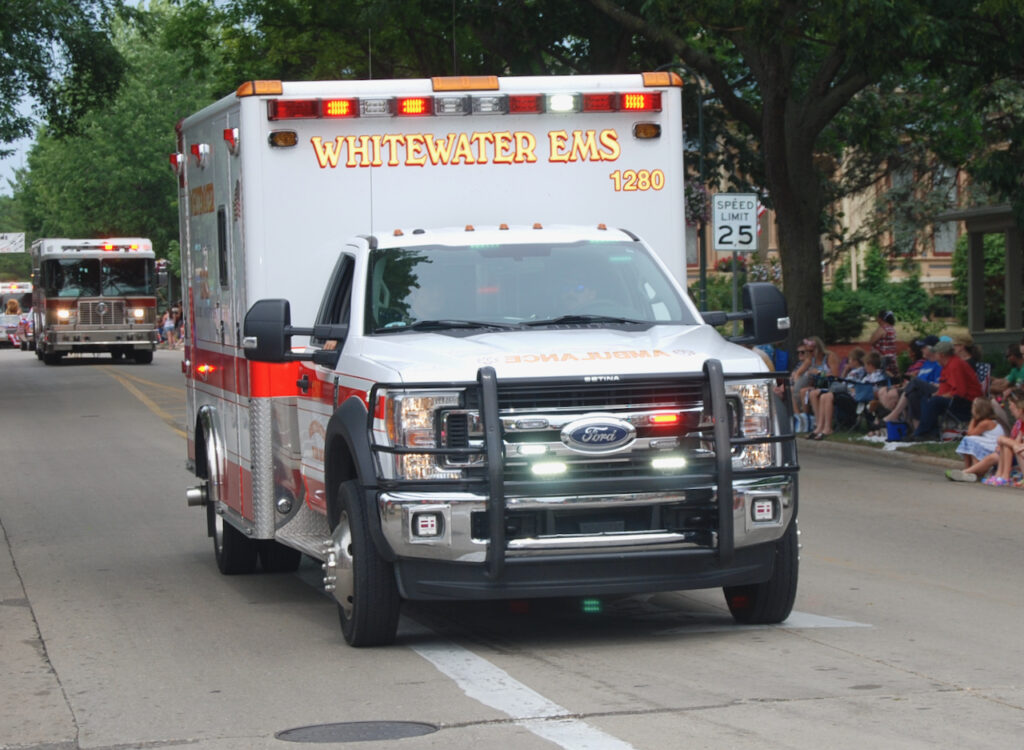
File photo/Kim McDarison.
Whitewater: Voters approve school district operational referendum
(Originally published Nov. 9, 2022.)
By Kim McDarison
Whitewater Unified School District voters Tuesday approved an operational referendum allowing the district to increase its taxpayer-supported funding above the state-imposed revenue cap by $4.4 million over each of the next four years.
As of Wednesday, with eight Walworth County precincts included in the race reporting, according to the county’s election site, the measure was approved by voters from across the district by a vote of 3,832 to 2,985.
A voter breakdown by county is as follows: voters living within the district in Walworth County, including most of the city of Whitewater, cast 2,968 in favor of the measure and 2,262 votes against it.
In Rock County, voters within the district, including those living in the towns of Johnstown and parts of Lima, voted against the referendum 264 to 240.
Voters in Jefferson County, including those living in wards 11-13 in the city of Whitewater, and in the towns of Cold Springs and parts of Koshkonong supported the funding increase by a vote of 624 to 459.
During a presentation given in October by members of the school district about the referendum to members of the Whitewater Common Council, district superintendent Caroline Pate Hefty noted that the referendum was required to continue to deliver services to the district’s diverse student population.
Describing student population, she said, among students in the district, some 50% are within a range that qualifies them for free or reduced lunch programs. Another 13% of students are English language learners, defined as students who speak a language other than English at home, and 19% of the district’s students are enrolled in special education.
Further, she said, students with unique needs require additional funding and resources to ensure high-quality services. Growth in the district’s economically disadvantaged population and students with disabilities has been steady over time. Aided by slides, she demonstrated that between 2016 and 2021, the district’s economically disadvantaged population grew from 41 to 50% and the district’s students with disabilities population over the same period grew from 17 to 19%. Both trajectories place the district above the state average, according to the slides.
School District Director of Business Services Ben Prather outlined several program, such as “Whitewater Builds,” K-12 Drama and Theater, and initiatives to extend Project Lead the Way programming to the elementary-school-level as among services an approved referendum would allow the district to continue to deliver.
Pate-Hefty pointed to continued support through metal health services, citing them as “critical.”
An earlier story about the referendum and the services it will help to support is here: https://fortatkinsononline.com/whitewater-council-receives-referendum-presentation-from-school-district/.
This story has been updated.
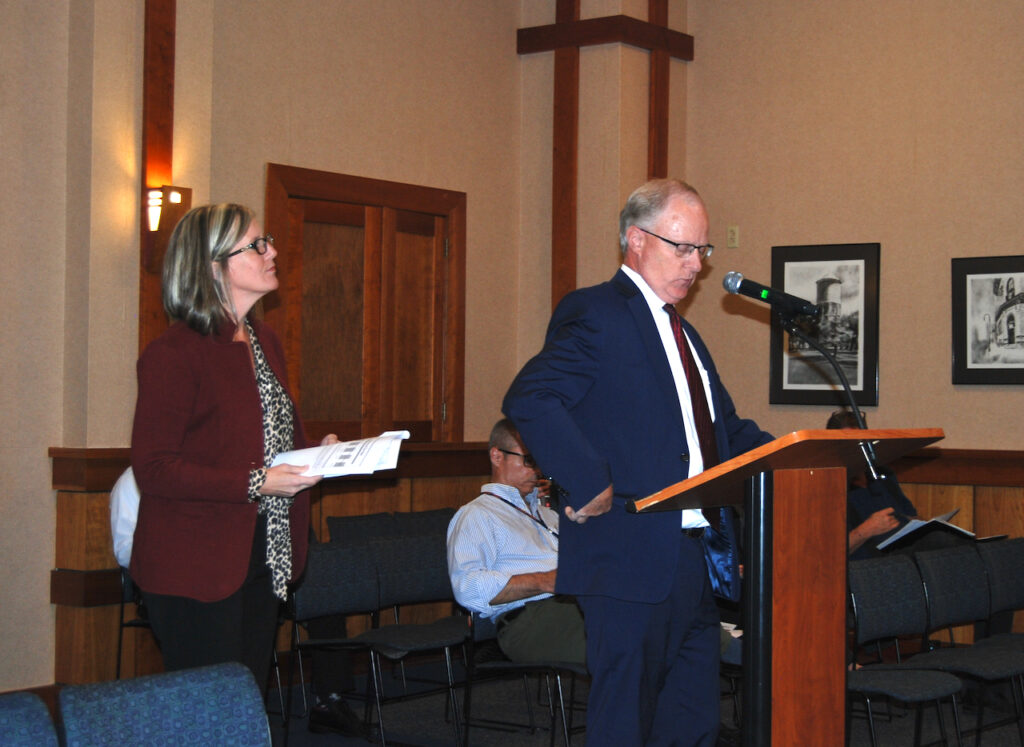
Whitewater Unified School District Superintendent Caroline Pate-Hefty, from left, and Whitewater Unified School District Board of Education member Larry Kachel address the Whitewater Common Council in October. The two, along with a third district representative, Ben Prather, not pictured, gave a presentation about the history, tax impacts and programming needs associated with the district’s proposed operational referendum. As of early Wednesday morning, with one precinct in Walworth County remaining unreported, the referendum was headed toward approval. File photo/Kim McDarison.
Whitewater: Amendments to liquor license quotas, food truck regulations pass first readings
(Originally published Nov. 17, 2022.)
By Kim McDarison
Two ordinance amendments brought before the Whitewater Common Council Tuesday — one increasing the number of class A liquor licenses made available by the city and a second limiting proximity of food trucks to brick-and-motor food establishments — garnered first-reading approval.
Both were approved by unanimous vote. Councilman Greg Majkrzak was not in attendance.
Increase in liquor licenses
Council approved increasing the number of class A liquor licenses available that could be awarded by the city to businesses looking to sell in-package products.
According to the agenda, the amendment, which will return to council for a second reading, seeks to raise the city’s quota for class A beer and liquor licenses from four to 12.
As stipulated within the ordinance, the city holds a quota for class B liquor licenses of 24.
City Attorney Wally McDonell, addressing council remotely and on behalf of City Clerk Michele Smith, who was not in attendance, said that the ordinance amendment to increase the class A license quota had come before council after the city had earlier increased its quota by two class A licenses at the request of Kwik Trip.
McDonell shared definitions of the two types of licenses — class A and class B — noting that class A was not the type of license that was typically associated with bars and taverns.
Describing class A licenses, he said: “that’s where you can buy liquor and beer in stores, and the classic ones would be at Casey’s … and Walmart … and obviously other stores as well.”
McDonell noted that after the city granted two class A licenses to Kwik Trip, other business owners had come forward, looking to obtain similar licensure.
He said: “Michele (Smith) and the city have received some additional requests (from) business owners seeking to receive those types of licenses, and I know there’s been some indication that they felt it was fair and justified because the quota was increased for Kwik Trip — that there should be an increase for other businesses that would like to sell … That is why it was put on (the agenda), to give the council an opportunity to increase the number.”
Additionally, McDonell said, would the council approve the increase in the quota, it would be “very much in line with other communities; the number of those types of alcohol licenses and their in-package-type … is not like a tavern. It’s a bottle of liquor, six-pack of beer or 12-pack of beer, that type of thing.”
He continued: “Of course the licensing, just because they’re available, doesn’t mean it’s a rubber stamp; that they are handed out without being fully vetted. First of all, the police department would be involved in the application processes as well as the other city staff, and ultimately, the council will have to approve any license. So this just allows more licenses to be granted by increasing the quota.”
The motion was approved without additional discussion.
Food Trucks
Describing the proposed amendment to the city’s transient merchants ordinance as “tidying up some language as it pertains to food trucks,” Neighborhood Services Director Chris Bennett said the intent of the amendment was to add language stating that food trucks cannot conduct business within 100 feet of a licensed food establishment unless the truck operator has written permission from the owners of the establishments within that vicinity.
Additionally, he said, the language was meant to ensure that trucks were added to the section of the ordinance concerning food sales. As written, before approval of the amended language, the ordinance identified carts, but not trucks.
A final change was developed to ensure that food truck operators provided proof of liability insurance to the city clerk before they could operate in the city, he said.
After the presentation, Councilwoman Jill Gerber asked about restrictions pertaining to noise that might emanate from generators used by food trucks.
She noted that within the ordinance, trucks would be allowed to operate until 3 a.m. She expressed concern that the early morning time frame might be inappropriate with regard to potential noise from generators.
Bennett said the time was already part of the ordinance, adding that the intent of the amendment was not a “full rewrite.
“We are just tweaking a couple of things here and there, so there’s a lot of stuff we didn’t touch,” he said.
He agreed with Gerber that a generator “sometimes seems loud.”
He asked Gerber for any suggestions she might make to offer a different time.
City Manager John Weidl said staff could consider the suggestion and make suggestions of its own, noting: “One thing off the top of my head is maybe there’s a distance from residential neighborhoods, if they are going to operate that way. Maybe we can use a cutoff. They can only stay open to 3 a.m. if they are largely in the downtown, or an area that’s not … I don’t know, we’ve got to think about it.”
Gerber suggested “cutting the time down.”
Councilman Jim Allen said he had only noticed food trucks operating during early morning hours in the downtown area.
Council President Lisa Dawsey Smith said that the ordinance specified that food trucks could only operate in the city’s B2 District.
“So the portions of it that are being changed are specific to downtown. That would probably need to be a larger conversation if you wanted it here because food trucks are not currently allowed outside of downtown, at all,” she said.
Councilwoman Brienne Brown pointed to language within the ordinance stipulating that food trucks could not begin operation before 9 a.m.
She wondered why the time was chosen, noting that food trucks that serve breakfast could benefit from an earlier starting time. She suggested 7 a.m.
“It’s a weird time thing,” she said, adding: “I’m ok with approving it (the amendment) with the additional stuff on it. I think we need to bring this back.”
Weidl said the amendment was appearing before council for its first reading. The language could be returned at a later date as a second first reading or as a second reading.
“There’s no rush,” he said.
Dawsey Smith said she was interested in seeing changes made to the ordinance that would increase the food truck vender license application fee, which, according to the ordinance, is $2.
She also said she would be interested in making changes to the vetting process required for licensure within the ordinance, which stipulates that the applicant produce two references from Walworth County property owners. She suggested the language should be changed to include something similar to a background check.
Would a background check become a requirement, she said, then she was in favor of the increase in application fee to be more representative of the time it would take for staff to undertake that process.
Further, Dawsey Smith said, within the ordinance, food sales are limited to certain locations, among them is the area along First Street between Main and North streets.
“That’s not a level street. So if we are putting food trucks out there, they’d be serving at an angle,” she said, calling the offerings “ literally sliders.”
Weidl said council members’ concerns could be addressed.
“It was just sort of a first shot over the bow,” he said of the amendment, adding that the initial intent was to offer the ordinance more structure and address issues of liability, and to ensure that food truck vendors had liability insurance.
“This item was on the punch list for a lot of us (staff) to get done by the end of the year. And so we decided to throw it on the wall and get you (council) to help us make it stick,” Bennett said.
Brown said she would like to revisit a section of the ordinance addressing noise from speakers. She suggested that the ordinance might serve as a deterrent for those venders operating ice cream trucks.
“It says no bells, no amplifying devices, so with an ice cream truck … it just seems like it cuts short entrepreneurial activity,” she said.
Said McDonell: “Our transient merchant ordinance does currently regulate door-to-door sales quite strictly. Since we are bringing it back, maybe there’s going to have to be a change in how that’s regulated.”
He said he wanted to supply a “heads-up” so there would be no surprises if that part of the ordinance also appeared before council with the amendment’s next reading.

City of Whitewater Neighborhood Services Director Chris Bennett Tuesday presents Whitewater Common Council members with an amendment to an ordinance governing food truck regulations. Photo/Video screen shot.
Whitewater: Council approves paid time off for police to learn Spanish
(Originally published Nov. 18, 2022.)
By Kim McDarison
The Whitewater Common Council Tuesday approved an option allowing members of the Whitewater Police Department to increase paid time off by one day, with those hours used to learn Spanish.
The concept was presented by Police Chief Dan Meyer, who said he was looking to incentivize his staff.
The request was approved by a vote of 5-1, with Councilman Jim Allen voting against the measure.
Councilman Greg Majkrzak was not in attendance.
During discussion, City Manager John Weidl said that if the measure was approved, it would be made available to all members of city staff.
Whitewater Human Resources Coordinator Judy Atkinson said a program to explore incentives to help all of the city’s employees learn Spanish was in the development stages.
Council President Lisa Dawsey Smith asked city staff to develop a policy, providing a framework for a citywide incentive program with regard to those interested in learning Spanish, which could be brought before council at a later date.
During Tuesday’s meeting, Meyer said that Irvin L. Young Memorial Library Director Stacey Lunsford had made him aware of a program available at the library through which an individual could learn to speak Spanish. Three members of his staff had participated in the program and found it useful.
Meyer asked council to consider approving an additional day of vacation time for members within his department who might like to take the course.
Outlining his request in a memo, Meyer wrote that the library is offering an online instructor-facilitated course, which, he noted, “catered to a specific subject matter.”
Within his memo, Meyer stated that members of his staff could be registered for the training by obtaining a library card and “connecting with a library staff member.”
As of Tuesday, he said, three police department staff members had completed and another had registered for a 24-hour “Spanish for Law Enforcement” course.
Those taking the course had completed online training modules “through a mix of on-duty and off-duty time,” Meyer noted.
Meyer wrote that he was requesting an ability to offer his staff an incentive to take the course by increasing paid vacation time by one day for any staff member who successfully completed the course.
Meyer said he saw those completing the course as providing a citywide benefit, given the recent influx of Spanish-speaking residents living within the city.
“I believe employees should be incentivized to complete the course regardless of whether they use on-duty or off-duty time to do so,” he wrote in the memo.
Approval of the request would allow staff taking the class to receive eight hours of paid vacation time applied to time used to complete the course, he added.
Upon course completion, he said, the student is awarded a certificate.
Meyer noted that the impact of approving the request would be minimal, consisting of lost productivity from paid time off.
“We will not approve time off that would create a shortage and subsequent overtime,” he wrote.
During discussion, Weidl said that while the city did not have a policy in place to address the proposed incentive program, it did have a “practice.”
He cited a program called “Rock the Walk” in which Lunsford had participated, receiving four hours of vacation time for her participation.
Allen asked whether the time had been awarded by the city or the library board.
Weidl said he wasn’t sure.
Giving some background, Meyer said ”Everybody is aware that a lot of our energy at the police department has been put toward trying to better communicate with our increasing number of Spanish speakers here.”
He cited “Propio,” a mobile app providing over-the-phone interpreting services, as a tool that the department has been using with some success.
He added that he believed the best approach to communicating with Spanish-speaking residents was to increase the staff’s ability to “actually communicate themselves.”
He noted that the 24-hour online training program offered through the Bridges Library System was tailored to meet his department’s needs.
According to Meyer, the six-week course offers two lessons per week.
Those participating with the program have found time to learn during work time and their time off, Meyer said, adding: “so, the request at this point is for a full day of vacation or some type of benefit time to account for that.
“As far as cost, I think it’s negligible. We’re not going to approve off time that would cause overtime or additional cost than what’s already there. So, really, it’s essentially a loss in productivity, but not in dollars and cents.”
Said Allen: “The easy thing would be to say, ‘oh, let’s be nice, let’s just give it to them,’ but in reality, this costs taxpayers quite a bit of money. Spanish classes of some kind should be afforded to all of our employees, and it should be directed by the HR department, and we are way behind on it. Those classes should be — people’s time to take that class — should be accounted for and they should be compensated for their time, but to give them an extra day of vacation time is not heard of, except in maybe municipal government. In the rest of the world, you’re told to do it by your HR director, you’re compensated for your time, or you do it on time that you’re in your office, and that’s that. It’s part of your mandatory continuing education.”
Additionally, Allen cited concerns with “bad blood,” which, he said, could arise would the option be made available to the police department and not other city staff members.
He noted his objection to the use of vacation time, saying: “Vacation time is just a wrong way to go. Compensate them for their time, but not vacation time.”
Said Weidl: “Assuming this was approved, we would roll it out citywide. I could see this being useful to people from the after-school programming in our park and rec. This would also be useful to people in the utilities department who are looking at lead pipes across the city.”
Allen asked how a citywide program might affect the city’s budget, both in dollars and time.
Weidl responded: “I don’t think it’s a concern; we’re not going to approve anything that creates overtime.”
Said Allen: “I just don’t think it’s something we should be doing compensatory with the officers. It should be part of the HR program. They should be paid for their time — they take the class — if they drive somewhere they should be compensated for that, but it should not be vacation time. It has nothing to do with vacation and it should not open a door that way, and we do not have other policies that do it, so if Stacey Lunsford is getting four hours, that’s from the library board. That’s who directs her, not city staff. That didn’t come from this board.”
Councilwoman Jill Gerber asked whether those taking the course were tested about their knowledge upon completion.
“Is it a pass-fail type of thing?” she asked.
Meyer responded that it was.
Gerber asked Meyer if he’d seen proof of the course’s value, asking if he had heard any of the staff members who had completed the course speak Spanish.
He said he had. He noted that he had a recording which was made when one of the department’s dispatchers responded to a Spanish-speaking caller.
“Clearly there’s benefit. They (staff members) see that, and I can see it, and you can hear it in the recording,” Meyer said.
Meyer said that the course his staff is taking offers language to help describe vehicles, traffic violations, medical emergencies and speaking with witnesses.
“It’s more in-depth than just a Spanish introductory course where you get the basics. It’s very specific to law enforcement, and I think that’s what’s going to be most beneficial for our staff,” he said.
Allen said he saw value in taking courses.
“We all should be taking them. As an employer, we should be telling our HR person that this is something that we want to do,” he said.
Gerber asked if employees who had taken the course noted how long it actually took them to complete.
Meyer said 24 hours was accurate, adding that more than eight hours is used to learn the material, and participants put in time at home.
“We just can’t accommodate it during work hours. That will come at a cost because they (employees) are busy doing other things while they are here. To me, we’re getting 24 hours worth of work for a day off,” Meyer said.
Gerber asked if those who had taken the course understood there might be some incentives.
Meyer said they did not, but, he added, three out of 37 staff members in his department had opted to make the commitment.
“I’d like to increase that number,” he said.
Councilwoman Brienne Brown said: “I think it’s really hard to learn a language. If we can incentivize this, trying to get basic vocabulary in there, I think that is really important. It seems like a small thing to give. It’s good for the public; it’s good for everybody. I think it’s an investment.”
Atkinson, who attended the meeting remotely, said she was in favor of the city’s staff learning to speak Spanish.
“We have to decide what’s the most cost-effective way to do it,” she added.
Offering some insight about topics that were earlier discussed, she said the Rock the Walk program attended by Lunsford was a fitness program offered through Fort HealthCare. Members of city staff have been participating in programming offered by Fort HealthCare “for years,” she said, adding that the four hours offered to Lunsford were “floating holiday time.”
She noted that floating holiday time was a better option to use as an incentive because paid vacation time can be carried over by an employee into the next year. Floating holiday time does not carry over. Describing floating holiday time, she said: “If people don’t use it, they lose it.”
Atkinson said using floating holiday time was a “past practice,” but, she added, “we should have a policy on these types of things.”
She described programming which would allow staff to enhance their ability to communicate with Spanish-speaking residents as “a great idea.”
Council approved Meyer’s request for a day off with pay for police department staff members looking to take the online Spanish course, with a change in language from “vacation day” to “floating holiday time.”
“I would like to see a policy brought back to create a sustainable framework for that going forward,” Dawsey Smith said.
Allen asked: “Why wasn’t this put on as a closed-session agenda item and vetted before we brought it public?” adding: “It should have been.”
Weidl asked City Attorney Wally McDonell to offer an opinion about whether the item merited closed-session discussion.
Said McDonell: “I think it technically could. It’s discretionary as to whether or not that type of thing would go on … but because it theoretically would be something that could be negotiable or maybe increased or decreased in certain ways in some strategic negotiating aspects, I think that it technically could. It would be maybe not a slam-dunk. If I was asked to give a thumbs-up or thumbs-down, I’d say technically it could go on as a closed session.”

Whitewater Police Chief Dan Meyer addresses the Whitewater Common Council Tuesday. Meyer requested eight hours of paid time off as an incentive for members of his staff to complete an online course to learn Spanish. Screen shot/photo.
DPI releases 2021-22 district, school report cards
(Originally published Nov. 19, 2022.)
By Kim McDarison
The Wisconsin Department of Public Instruction (DPI) Tuesday released its 2021-22 school year district report cards.
According to a DPI news release, “a majority of public school districts, schools, and choice schools met or exceeded expectations and have maintained the same ratings compared to the previous year.”
Among data reported for the School District of Fort Atkinson, three of the district’s elementary school buildings and its middle school received “overall accountability scores” of “exceeds expectations,” represented with four stars. The system rates districts and schools using scores, denoted by stars, of 1-5, with 5, signifying the most desirable score.
Barrie Elementary School received a top overall accountability score of “significantly exceeds expectations,” represented by five stars.
The Fort Atkinson High School received an overall accountability score of “meets few expectations,” represented with two stars.
Among data reported for the Whitewater Unified School District, three of the district’s school buildings, Lincoln and Lakeview elementary schools and the high school received overall accountability scores of “meets expectations,” represented with three stars.
Washington Elementary School received an overall accountability score of “exceeds expectations,” represented with four stars.
The Whitewater Middle School received an overall accountability score of “meets few expectations,” represented with two stars.
What are DPI report cards?
DPI report cards, published annually, include data on multiple indicators for multiple school years across four priority areas: achievement, growth, target group outcomes, and an area titled “on-track to graduation.”
Districts are given an “overall accountability score,” placing them, and their schools, into one of five overall accountability ratings: “Significantly Exceeds Expectations,” represented with five stars; “Exceeds Expectations,” represented with four stars; “Meets Expectations,” represented with three stars; “Meets Few Expectations,” represented with two stars, and “Fails to Meet Expectations,” represented with one star.
The cards use up to three years of data, the release noted, including achievement data from the following school years: 2018-19, 2020-21 and 2021-22.
The release stated: “Requirements were waived for the 2019-20 school year due to the COVID-19 pandemic, and report cards were not produced. The DPI urges caution when interpreting scores and ratings due to impacts resulting from the pandemic.”
Overall findings
According to the release, during the 2021-22 school year, 377 public school districts received DPI school report cards, of which 358 met, exceeded or significantly exceeded expectations, which the release noted, was 95% of the districts evaluated.
During the 2021-22 school years, some 2,104 report cards were produced for schools within Wisconsin’s districts. Of those schools, 184 or 9% were unable to be scored and were rated using alternate accountability. Of the remaining 1,920, 1,619 or 84% met, exceeded or significantly exceeded expectations.
Of 1,883 schools receiving report cards in both the 2020-21 and 2021-22 school years, 1,226 experienced no change, 231 increased their positioning by at least one rating category, and 426 decreased their positioning by at least one category.
Additionally, DPI produced 391 report cards for private schools participating in a Wisconsin School Choice Program during the 2021-22 school year. Of that number, 58% were unable to be scored due to the school’s choice student population being too small to meet the conditions required to produce scores. Of the remaining 163 schools, 142 or 87% met, exceeded or significantly exceeded exceptions.
Of the 132 choice schools receiving report card ratings in both the 2020-21 and 2021-22 school years, 72 experienced no change, 17 moved up at least one category, and 43 moved down at least one category.
Individualized 2021-22 data for area districts
School districts within and surrounding the Fort Atkinson Online readership area received the following overall accountability scores:
Fort Atkinson: 68.3, “meets expectations,” three stars. The full report card is here: http://fortatkinsononline.com/wp-content/uploads/2022/11/DRCDetail_Public_Fort_Atkinson_2021-22_006510.pdf.
Whitewater: 61.6, “meets expectations,” three stars. The full report card is here: http://fortatkinsononline.com/wp-content/uploads/2022/11/DRCDetail_Public_Whitewater_Unified_2021-22_004160.pdf.
Jefferson: 64.7, “meets expectations,” three stars. The full report card is here: http://fortatkinsononline.com/wp-content/uploads/2022/11/DRCDetail_Public_Jefferson_2021-22_006733.pdf.
Milton: 68.3, “meets expectations,” three stars. The full report card is here: http://fortatkinsononline.com/wp-content/uploads/2022/11/DRCDetail_Public_Milton_2021-22_006991.pdf.
Palmyra-Eagle: 68.0, “meets expectations,” three stars. The full report card is here: http://fortatkinsononline.com/wp-content/uploads/2022/11/DRCDetail_Public_Palmyra-Eagle_Area_2021-22_003578.pdf.
Watertown: 66.1, “meets expectations,” three stars. The full report card is here: http://fortatkinsononline.com/wp-content/uploads/2022/11/DRCDetail_Public_Watertown_Unified_2021-22_002410-1.pdf.
Janesville: 60.2, “meets expectations,” three stars. The full report card is here: http://fortatkinsononline.com/wp-content/uploads/2022/11/DRCDetail_Public_Janesville_2021-22_006597.pdf.
Delavan-Darien: 62.8, “meets expectations,” three stars. The full report card is here: http://fortatkinsononline.com/wp-content/uploads/2022/11/DRCDetail_Public_Delavan-Darien_2021-22_002730.pdf.
Lake Mills: 71.9, “exceeds expectations,” four stars. The full report card is here: http://fortatkinsononline.com/wp-content/uploads/2022/11/DRCDetail_Public_Lake_Mills_Area_2021-22_006785.pdf.
Elkhorn: 71.9, “exceeds expectations,” four stars. The full report card is here: http://fortatkinsononline.com/wp-content/uploads/2022/11/DRCDetail_Public_Elkhorn_Area_2021-22_002827.pdf.
2021-22 data for schools within the School District of Fort Atkinson
Overall accountability scores earned by each school within the School District of Fort Atkinson follow.
Barrie Elementary: 83.2, “significantly exceeds expectations,” five stars.
Luther Elementary: 78.8, “exceeds expectations,” four stars.
Purdy Elementary: 70.2, “exceeds expectations,” four stars.
Rockwell Elementary: 70.2, “exceeds expectations,” four stars.
Fort Atkinson Middle School, 76.6, “exceeds expectations,” four stars.
Fort Atkinson High School, 57.3, “meets few expectations,” two stars.
2021-22 data for schools within the Whitewater Unified School District
Overall accountability scores earned by each school within the Whitewater Unified School District follow.
Lakeview Elementary: 67.0, “meets expectations,” three stars.
Lincoln Elementary: 58.2, “meets expectations,” three stars.
Washington Elementary, 80.3, “exceeds expectations,” four stars.
Whitewater Middle School, 54.3, “meets few expectations,” two stars.
Whitewater High School, 64.8, “meets expectations,” three stars.
An earlier story about ACT scores is here: https://fortatkinsononline.com/wisconsin-dpi-releases-2021-22-act-act-aspire-forward-exam-scores/
The full DPI release about public and school choice district report cards is here: https://dpi.wi.gov/news/releases/2022/district-school-report-cards.
A portal provided on the DPI website through which individual report cards can be accessed is here: https://apps2.dpi.wi.gov/reportcards/home.
Whitewater: ‘Shop Small Holiday Market’ to be held at Cravath Lakefront Park
(Originally published Nov. 23, 2022.)
A “Shop Small Holiday Market” will be held Saturday, Nov. 26, at Cravath Lakefront Park, 341 S. Fremont St., Whitewater, according to information made available by the Whitewater Area Chamber of Commerce.
The market will be held between 10 a.m. and 5 p.m. and will feature gifts and goods from 27 area businesses and vendors.
Additionally, event-goers will find live music, and a bonfire. Several food trucks will be on hand as well as stations providing kids’ activities such as the “Little Elves Workshop and Play Area,” and a place to write letters to Santa.
Additionally, the event will feature 12 “selfie stations” and 16 “story stroll stops” found at various locations throughout the city’s downtown. A map showing the locations of the various activities is here: https://www.google.com/maps/d/u/0/viewer?mid=1SwfHEjre-w2xlUen0-BvsWEmdkdhkkA&ll=42.83198926121354%2C-88.73050224123305&z=18.
The event will conclude with a tree-lighting ceremony and carolers, which will be held near the intersection of Main and Whitewater streets.
Participating food trucks include: Mr. P’s Grilled Cheese, The Food Truck by Sweet Spot, and Sarah’s Sweet Treats.
A schedule of live entertainment includes: 10 a.m., Whitewater Middle School Band student duets; 11 a.m., Keith Minikel; noon, Lakeside Brass; 1 p.m., the University of Wisconsin-Whitewater Chancellor’s Quartet; 2 p.m., UW-Whitewater’s String Quartet; 3 p.m., UW-Whitewater’s Jazz Sextet, and 4 p.m., the Whitewater High School Carolers.
A list of participating vendors includes: Live Life Spiritual Direction, Nordskov Coffee, SJW Handmade, Usborne Books, ReVamp Nutrition, Amanda’s Creations, Angie Rose Creations, 60 is the new 30, Stephani’s Spot, Kristie’s Creative Kitchen, PenJo Glass Creations, Oaks + Cotton & Just Add Wine Candle Co., Shannon Shenanigans Dessert Co., Colby Flade-Author, BaristaCats, Old School Farmstead, Ruth Jones Crafts, Paul’s Sticks n Canes, Studio 84, 2 Crafty Grandmas, Clark Family Gardens, Kettle Moraine Honey, Good Times Clay Co., A Cup Company, Midwest Nest Handmade, Jackie’s Small Batch Bakery, and Botanica Beauty Parlour.
For more information about businesses and events in downtown Whitewater, visit: https://downtownwhitewater.com.

File photo, Unsplash.com/CHUTTERSNAP.
Click on the image above to see the full map of activities and key.
Whitewater: Holiday shoppers fill Cravath Lakefront Park
(Originally published Nov. 27, 2022.)
Some 300 shoppers Saturday visited Whitewater’s Cravath Lakefront Park during the first-ever “Shop Small Holiday Market,” according to event organizers.
The event, which is planned to return annually, offered shopping opportunities, along with live music and other activities, many of which were geared toward children.
More than 20 venders arrived in the park to sell wares, from fashion accessories to honey, as other event-goers found a seat near an open-fire warming station to listen to music provided by bands and orchestras made available through the Whitewater High School and University of Wisconsin-Whitewater.
Festivities included activities beyond the park. A map, provided online by organizing groups: the Whitewater Area Chamber of Commerce and Downtown Whitewater, Inc., identified 12 selfie stations created throughout the downtown area and 16 locations which together comprised a self-guided story stroll.
Santa arrived in the late afternoon and worked his way through the park, greeting his many fans.
An early evening tree-lighting ceremony concluded the event.
Photos from the event follow. Kim McDarison photos, unless otherwise indicated.
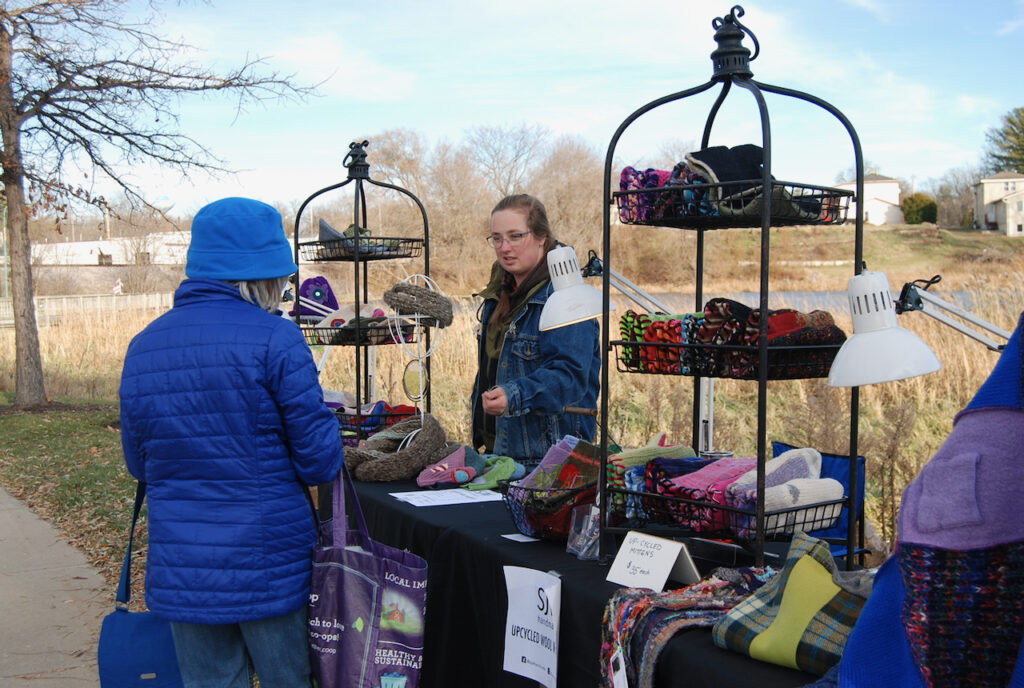
Fort Atkinson resident Sarah Weh, at right, owner of SJW Handmade, visits with a customer.
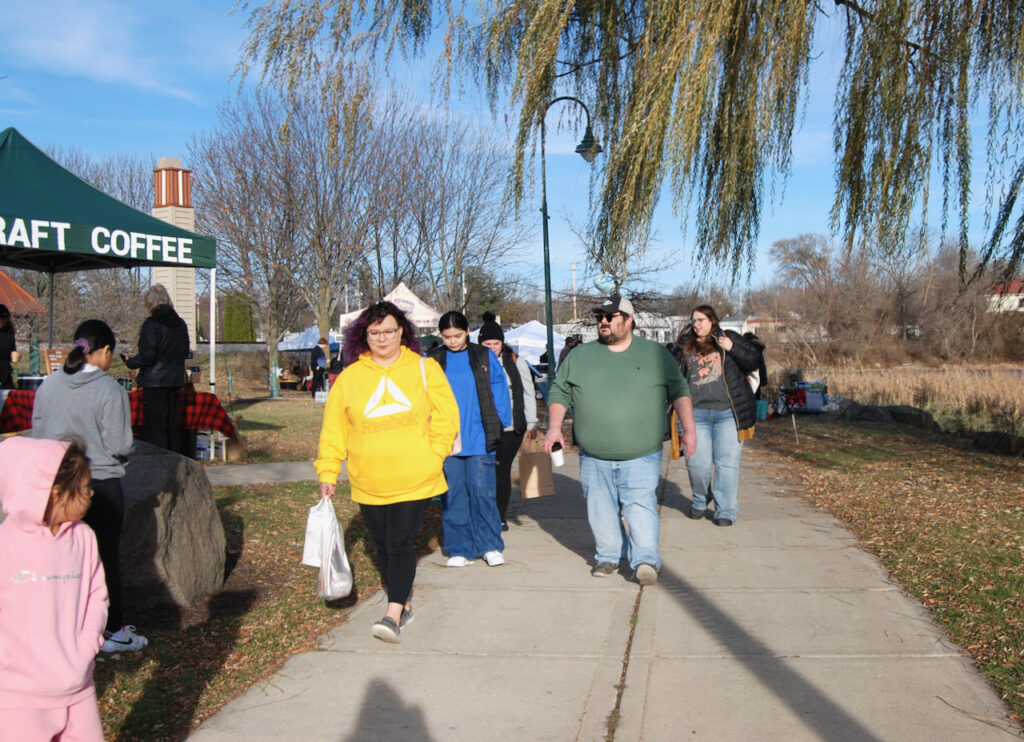
Event-goers fill Cravath Lakefront Park Saturday as they shop at the holiday market and participate in myriad activities.
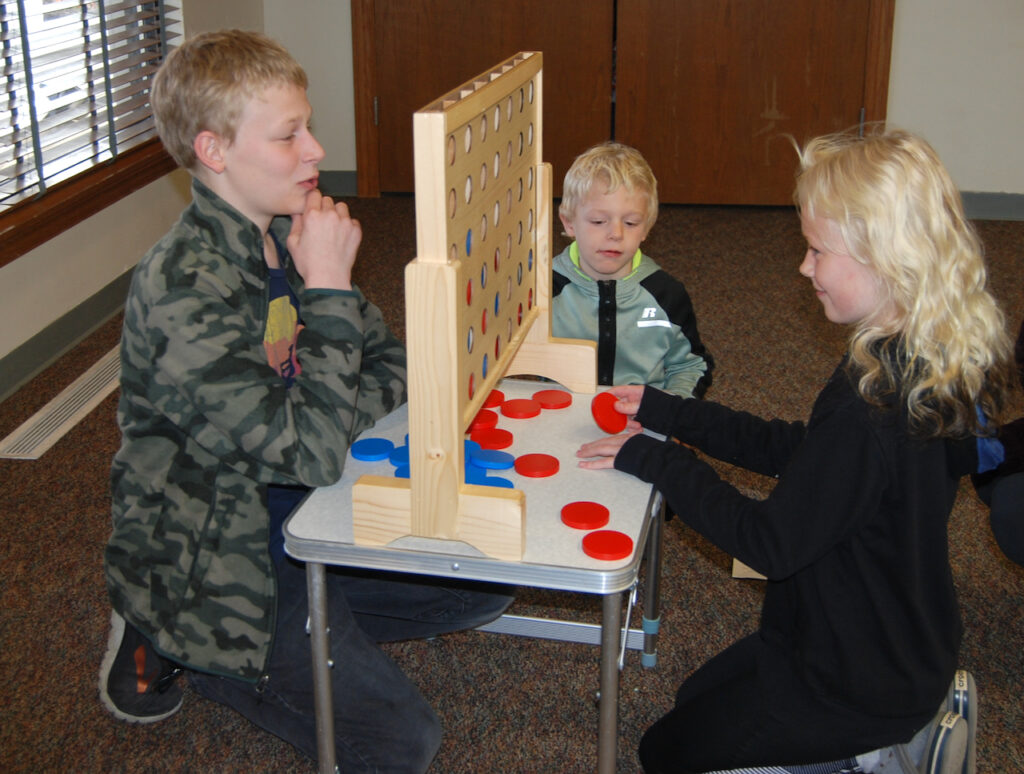
Blended family siblings Levi Sann, 13, from left; Shiloh Ehlert, 5, and Sidney Sann, 9, all of Whitewater, play games together in the community building at Cravath Lakefront Park.
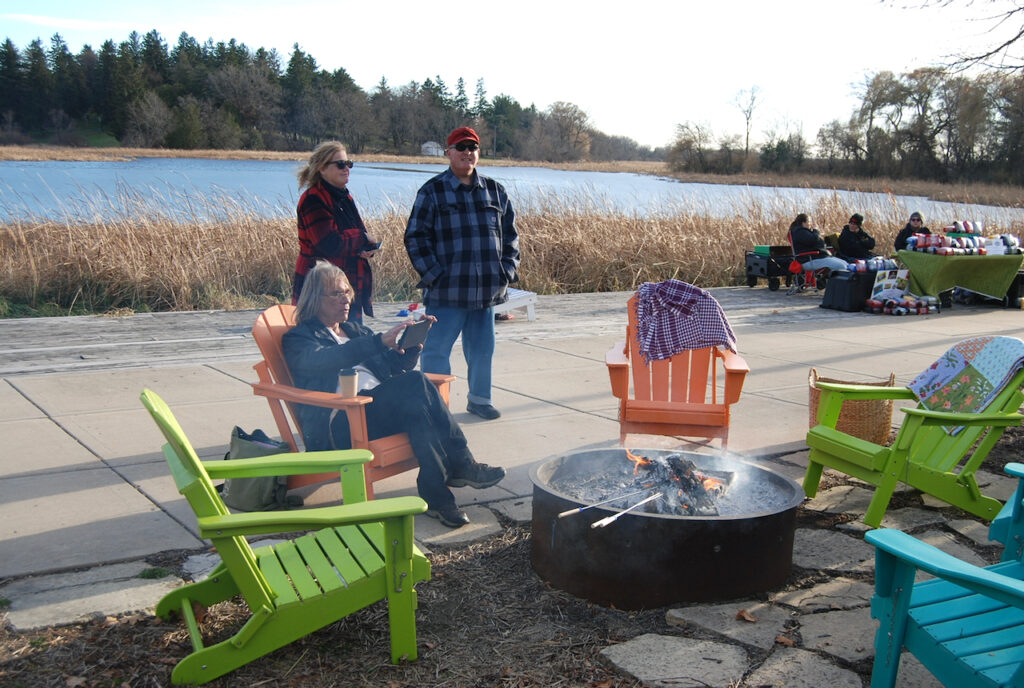
Event-goers pause near an open-fire warming station. The station was situated in front of a tent from which several groups of area students performed live music.

Before making his debut at the holiday market, Santa stops to greet a resident and his furry companion.

Mackenzie Walter, Whitewater, and her lab mix, “Louie,” 3, visit the holiday market.
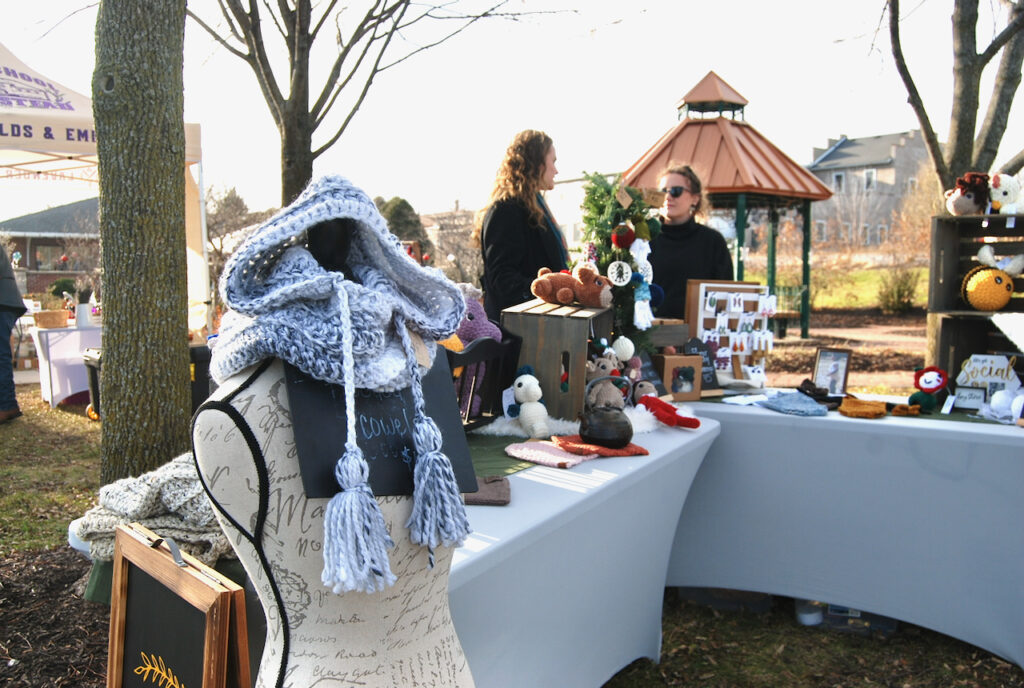
Midwest Nest offers an assortment of fashion accessories. Owner Jessica Mathews, at right, and her sister, Kelsey Getz, both of Milton, were on hand to greet customers.
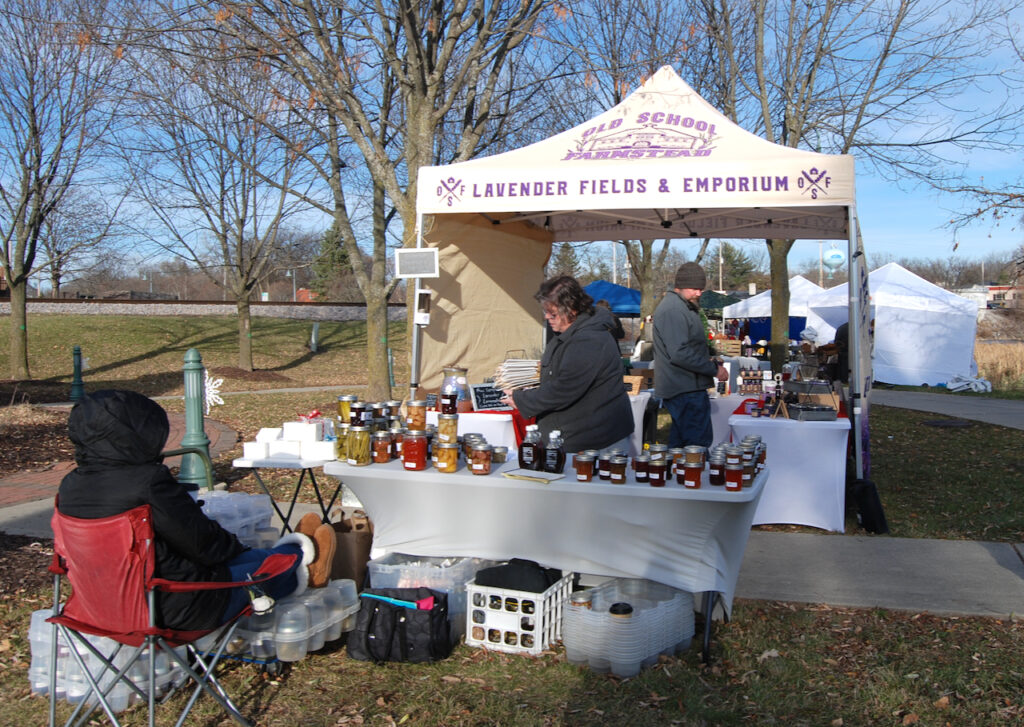
Lavender Fields and Emporium is among venders participating in the first-ever Shop Small Holiday Market.

Representing Cub Scout Troop 340, Beloit, Norah Rounds greets event-goers.
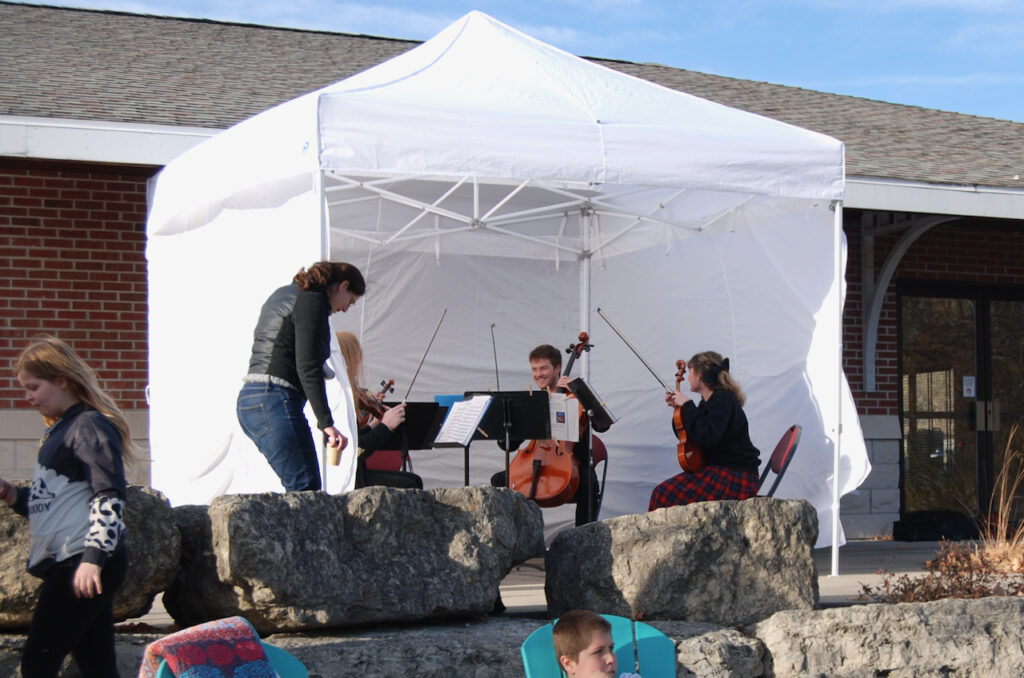
The University of Wisconsin-Whitewater String Quartet performs near a warming station.

Victoria Bailey, from left, and Mackenzie Benish, both of Janesville, color holiday-themed outlines in the community building at Cravath Lakefront Park. The women said they enjoy coloring and through the activity, they were embracing the Christmas spirit.
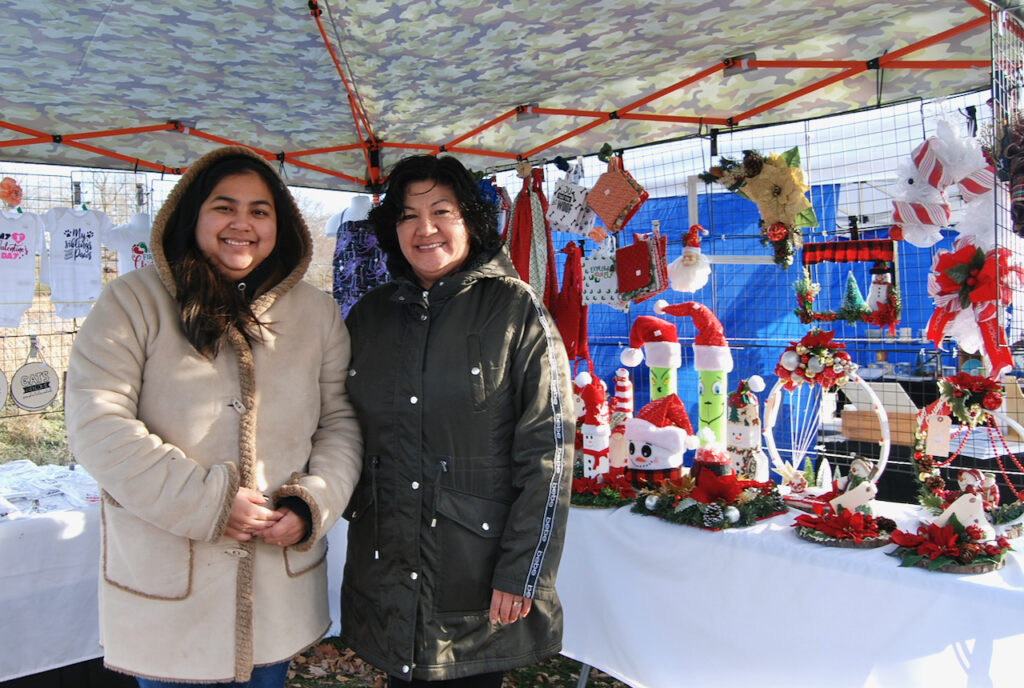
Mother and daughter team Yazmine Ordaz, at left, and Juana Escobar own and operate J and Y Crafting.

Arriving at the market to spread holiday cheer and talk with event-goers, “Santa” said he has been making special visits to the greater Janesville area for 22 years. He has a home in the rural Milton area, he added. He said he donned his suit and began visiting Janesville, making a special visit to an area elementary school, and later found he enjoyed visiting the Lincoln Tallman House, in Janesville, which is owned and operated by the Rock County Historical Society.
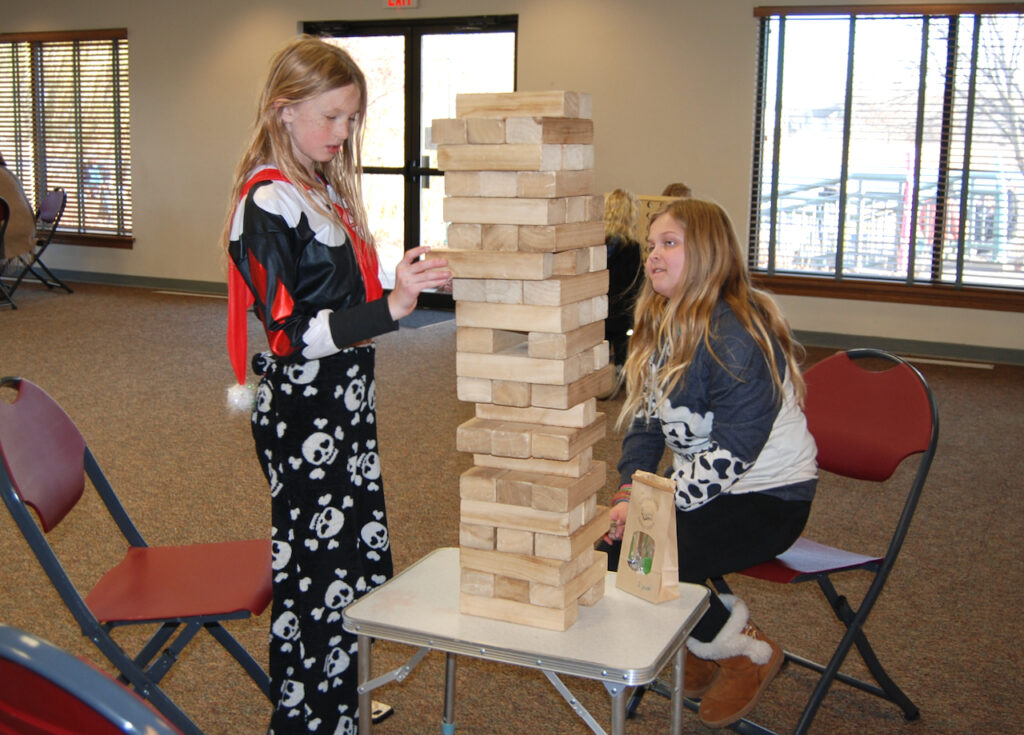
Cayden Warner, at left, and her friend, Apple Schlueter, both 10 and of Whitewater, build a Giant Jenga tower. Activities for kids were found in abundance in the community building at Cravath Lakefront Park.
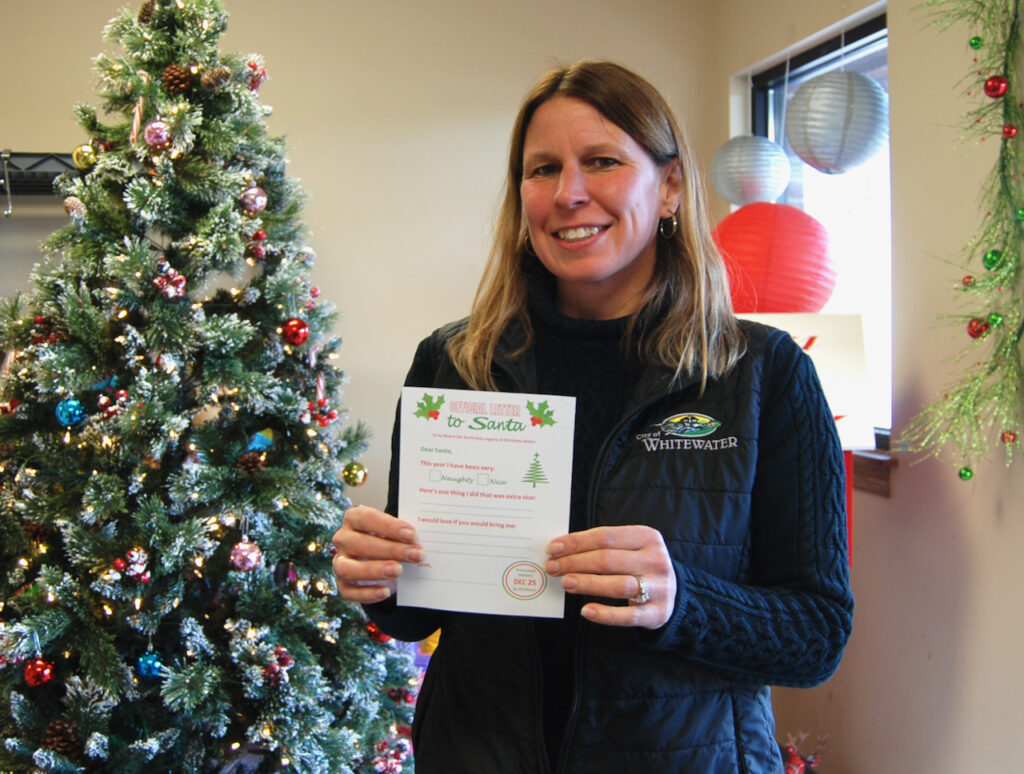
Whitewater Parks and Recreation Department employee Michelle Dujardin holds a form used to help event-goers of all ages write a letter to Santa. By mid-afternoon, she said, some four dozen letter writers had come to her table to send a message to the jolly ole elf.

Members of the Soto Family, including four children, ages 10, 6, 5 and 2, engage Santa and eagerly tell him what they want for Christmas. Among their requests were a squishy shark toy, a plushy deer, “Mario,” and a dump truck.
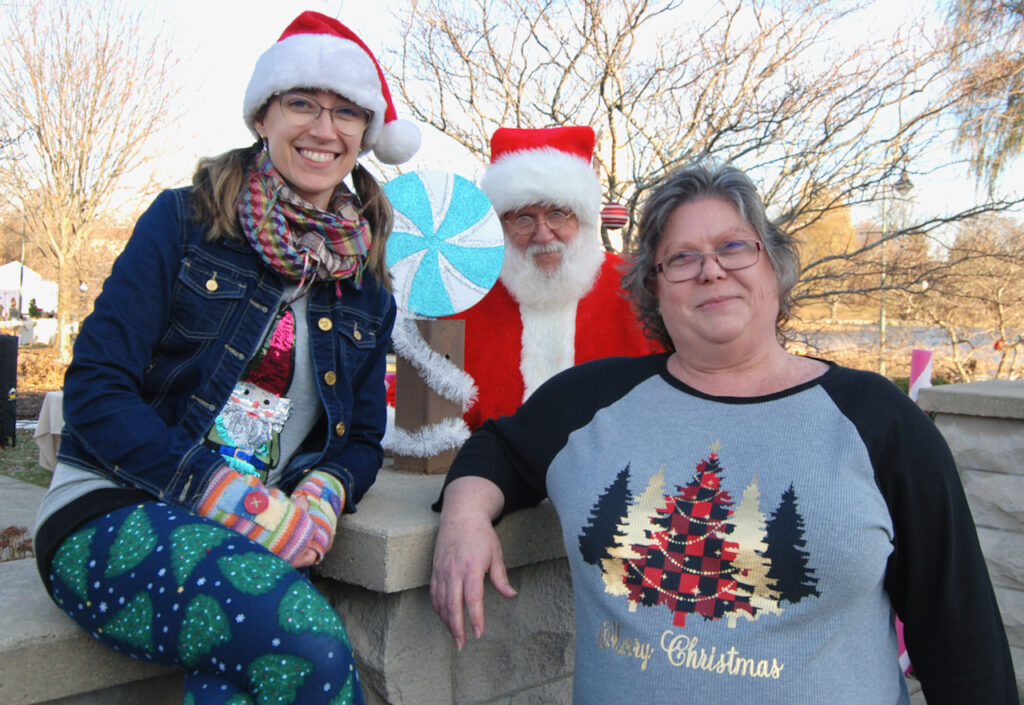
Representing the event’s organizing groups, Downtown Whitewater Inc., and the Whitewater Area Chamber of Commerce, Katy Wimer, at left, and Kellie Carper, the chamber’s executive director, pause from the day’s activities to take a photograph with Santa.
Kim McDarison photos.
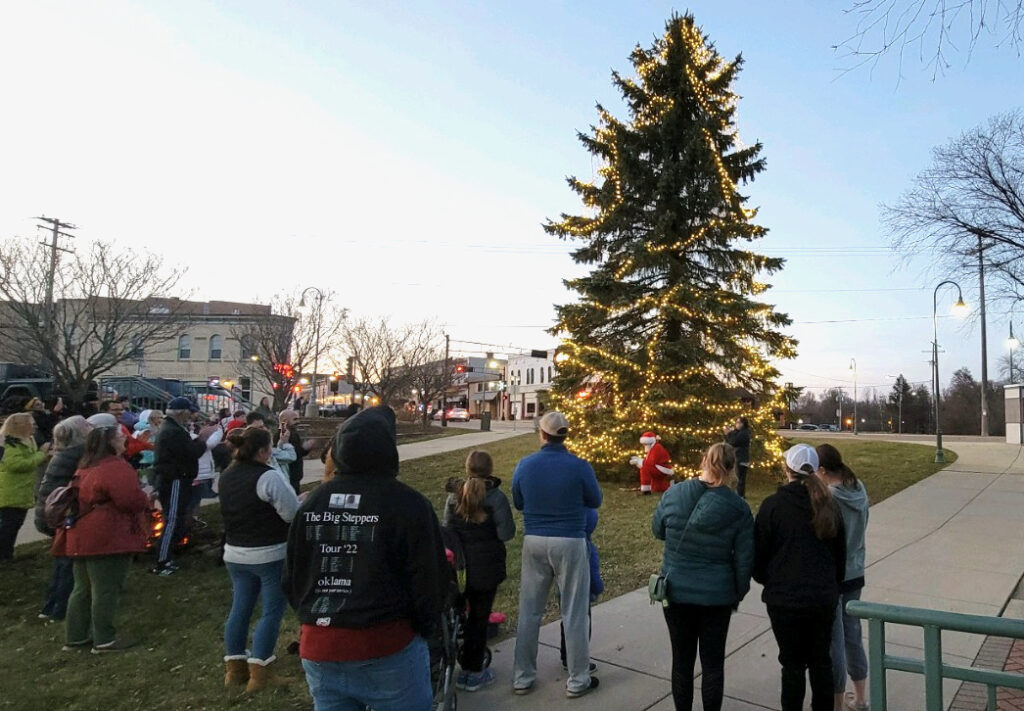
Carolers and event-goers gather for a tree-lighting ceremony, which concluded the first-ever Shop Small Holiday Market. Photo courtesy of Katy Wimer.
Whitewater: Community Foundation to support elementary school robotics league
(Originally published Nov. 28, 2022.)
The Whitewater Community Foundation has announced that it will be providing support through a community action grant to robotics programming within the Whitewater Unified School District’s three elementary schools.
According to the release, the foundation has advanced some $1,500 to the district to go toward the purchase of a Spike Prime robot, a robotics learning tool created by The Lego Group, a privately held company based in Denmark, according to its website, with a goal of providing the tool to the district’s elementary school league.
LEGO Education Spike robot kits are designed to inspire students to “explore more advanced creations and continue to nurture their interest in STEAM learning,” according to information provided by the company.
According to information released by the Whitewater Community Foundation, there are robotics teams in each of the Whitewater Unified School District’s buildings.
The grant will provide funding to purchase a Spike Prime robot for use within the district’s “First LEGO League,” which is comprised of teams within each of the district’s three elementary schools: Lincoln, Washington and Lakeview.
At Lincoln Elementary School, a team called the Lincoln Brick Layers will work under the advisement of Lisa Kaminski. At Washington Elementary School, the Washington Brick Layers will work under the advisement of Chris Nate and Valerie Troxel, and at Lakeview Elementary School, a team, called the Lakeview Bricklayers, will be advised by Sara Brautigam, the release stated.
While students will build robots using a kit, each team will be charged with stylizing its creation, using additional mechanisms provided by LEGO, with an objective to complete assigned tasks, the release noted.
Students also will be responsible for programming the robots.
Additionally, the release noted, Whitewater High School students from the school’s robotics club, Ferradermis Team No. 6574, will act as mentors to the younger robotics students.
While Ferradermis receives some school district funding, the release stated that the program also is funded through grants, corporate sponsorships and donations.
Those interested in donating to the robotics programs are encouraged to visit the foundation’s website: www.whitewatercommunityfoundation.org.
About the Whitewater Community Foundation
According to the release, The Whitewater Community Foundation’s mission is to “enhance quality of life in the Whitewater area via educational, cultural, charitable or benevolent expenditures,” through scholarships and community action grants. The Whitewater Community Foundation is a 501(c)(3) nonprofit corporation.

Whitewater Community Foundation Coordinator Bonnie Miller, back row, from left, foundation board member Ginny Coburn, foundation board co-president Roni Telfer, and team advisor of the Lincoln Brick Layers Lisa Kaminski, along with Lincoln Brick Layers team members Saul Mendoza, front row, from left, Amelia LeFaive, Paige Callahan and Emma Kuzoff, all of whom are in fifth grade, gather during a recent check presentation. The money will be used to support equipment for the full elementary-school-level First LEGO League. Contributed photo.
Five finalists announced for UW-Whitewater chancellor position
(Originally published Nov. 29, 2022.)
The University of Wisconsin System announced Tuesday that it has identified five finalists in its search for a new chancellor at the University of Wisconsin-Whitewater.
The finalists are: Lynn D. Akey, a vice president of student success, analytics and integrated planned at Minnesota State University, Mankato; John D. Chenoweth, interim chancellor at UW-Whitewater; Corey A. King, vice chancellor for university inclusivity and student affairs, UW-Green Bay; Paul D. Plotkowski, dean and professor, Padnos College of Engineering and Computing, Grand Valley State University, Grand Rapids, Mich., and Mrinal Mugdh Varma, provost and senior vice chancellor, Auburn University at Montgomery, Ala.
According to information released by the UW system, a Special Regent Committee selected the finalists from a list of candidates identified by a 12-member Search and Screen Committee.
Next month, the candidates will participate in separate campus public forums, offering opportunities for students, faculty, staff and community members to interact directly with them, the release stated.
After reviewing campus feedback, UW System President Jay Rothman and the Special Regent Committee, comprised of Regents Amy Blumenfeld Bogost, chairman; Ashok Rai; Jill Underly, and Kyle Weatherly, will interview the finalists and recommend a single successful candidate to the Board of Regents, which will approve the appointment, the release continued.
The next chancellor at UW-Whitewater will be the institution’s 18th, the release noted.
Following is information about each candidate, including times when they will be made available to meet members of the public.
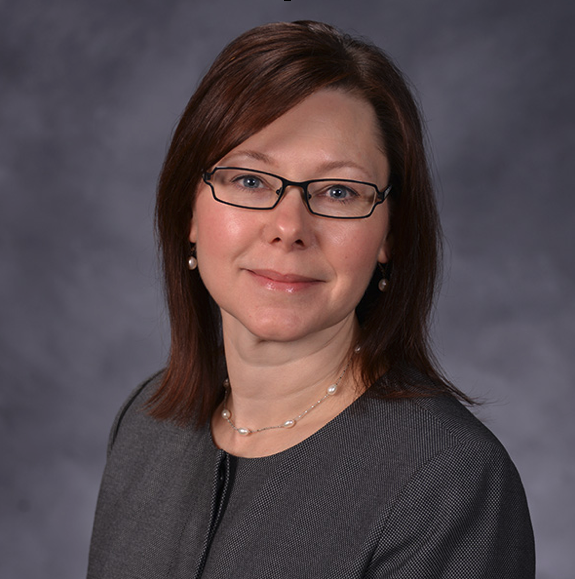
Lynn D. Akey
Lynn D. Akey will be on the UW-Whitewater campus to meet members of the public Tuesday, Dec. 6, between 3 and 4 p.m., in Timmerman Auditorium, Hyland Hall.
According to information supplied to the UW System by the candidate, Akey has served at Minnesota State University in the following capacities:
• Associate vice president for institutional research, strategy and effectiveness, Office of the Provost, December 2017 to February 2019.
• Assistant vice president for institutional research, planning and assessment, November 2013 to December 2017
• Director of institutional research, planning and assessment, July 2011 to October 2013.
• Director of institutional research and assessment, July 2010 to June 2011.
• Director of institutional assessment, March 2009 to June 2010.
A full presentation of her professional accomplishments is here: https://www.uww.edu/documents/executive-search/akey-cv.pdf.
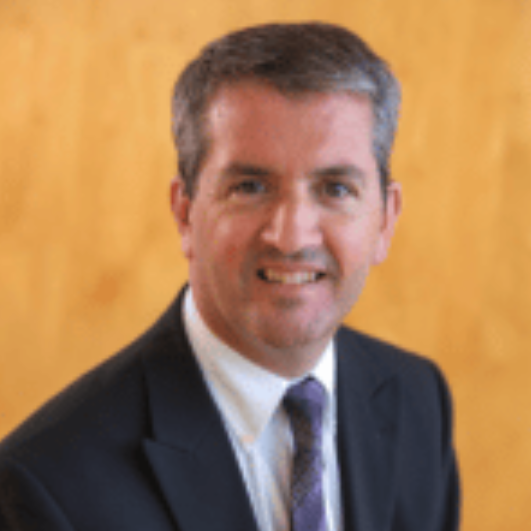
John D. Chenoweth
John D. Chenoweth will be made available on the UW-Whitewater campus to meet members of the public Wednesday, Dec. 7, between 3 and 4 p.m., in Timmerman Auditorium, Hyland Hall.
According to information supplied to the UW System by the candidate, Chenoweth has served at UW-Whitewater in the following capacities:
• Interim chancellor, April 2022 to present.
• Provost and vice chancellor of academic affairs, July 2021 to April 2022.
• College of Business and Economics, dean, January 2015 to June 2021.
• College of Business and Economics, associate dean, August 2011 to January 2015.
• Interim director of the Center for Global Education, January 2011 to August 2011.
• College of Business and Economics, Department of Information Technology and Supply Chain Management, August 2002 to January 2011, serving as chair (2006-2011), professor (2016-present), associate professor (2005-2016),and assistant professor (2002-2005).
A full presentation of his professional accomplishments is here: https://www.uww.edu/documents/executive-search/chenoweth-cv.pdf.

Corey A. King
Corey A. King will be on the UW-Whitewater campus to meet members of the public Thursday, Dec. 8, between 3 and 4 p.m., in Timmerman Auditorium, Hyland Hall.
According to information supplied to the UW System by the candidate, King has served in the following capacities:
• Vice-chancellor for university inclusivity and student affairs, UW-Green Bay, 2020 to Present.
• Vice president for enrollment management and student financial services, Bethune-Cookman University, Daytona Beach, Fla., 2019 to 2020.
• System chair, Council for Student Affairs, State University System of Florida Board of Governors, 2016 to 2019.
• Vice president for student affairs and enrollment management, Florida Atlantic University, Boca Raton, Fla., 2014 to 2019; associate vice president for student affairs/dean of students, 2008 to 2014.
A full presentation of his professional accomplishments is here: https://www.uww.edu/documents/executive-search/king-cv.pdf.

Mrinal Mugdh Varma
Mrinal Mugdh Varma will be on the UW-Whitewater campus to meet members of the public Tuesday, Dec. 13, between 3 and 4 p.m., in Timmerman Auditorium, Hyland Hall.
According to information supplied to the UW System by the candidate, Varma has served in the following capacities:
• Provost and senior vice chancellor, professor of healthcare administration, tenured, Auburn University at Montgomery, Montgomery, Ala, February 2017 to present.
• Associate vice president for academic affairs, June 2008 to February 2017; associate professor, tenured, Department of Healthcare Administration, College of Business, September 2012 to February 2017; assistant professor, Department of Healthcare Administration, College of Business, June 2008 to August 2012, University of Houston-Clear Lake, Houston, Texas, June 2008 to February 2017.
• Director of institutional research, October 2002 to June 2004, State University of New York Empire State College, Saratoga Springs, NY, October 2002 to June 2004.
• Institutional planner, Office of Policy Analysis and Research, June 2001 to October 2002.University of Wisconsin System Administration, Madison, June 2001 to October 2002.
A full presentation of his professional accomplishments is here: https://www.uww.edu/documents/executive-search/varma-cv.pdf.
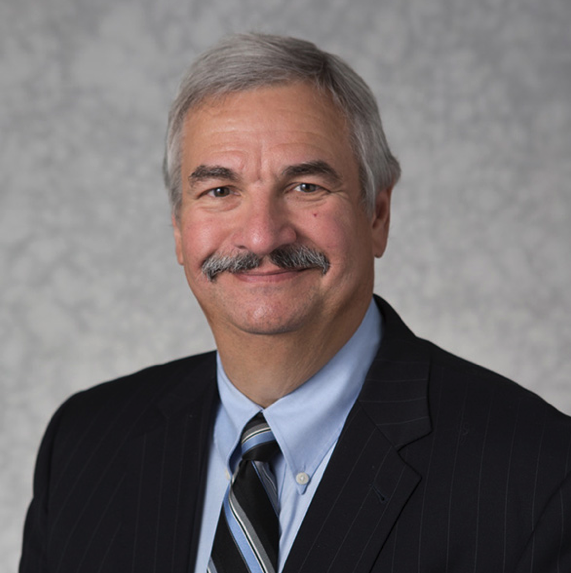
Paul D. Plotkowski
Paul D. Plotkowski will be on the UW-Whitewater campus to meet members of the public Wednesday, Dec. 14, between 3 and 4 p.m., in Timmerman Auditorium, Hyland Hall.
According to information supplied to the UW System by the candidate, Plotkowski has served in the following capacities:
• Founding dean and professor, Padnos College of Engineering and Computing, 2004 to present; supplemental assignment with GVSU Development Division, 2015 to 2016; director and professor, School of Engineering, 1991 to 2004, Grand Valley State University, Mich.
• Institute ABET accreditation coordinator, 1989 to 1991; director, manufacturing systems engineering program, 1988 to 1991; associate professor, tenured, of mechanical engineering, 1986 to 1991; assistant professor of mechanical engineering, 1983 to 1986; GMI Engineering and Management Institute, Mich.
A full list of his accomplishments is here: https://www.uww.edu/documents/executive-search/plotkowski-cv.pdf.
About the search
Information as provided by the UW System about the full and ongoing search effort is here: https://www.uww.edu/chancellor-search.
An earlier story about the formation of the search committee is here: https://fortatkinsononline.com/system-names-members-of-uw-whitewater-chancellor-search-screen-committee/.
Wisconsin Policy Forum report finds local government debt on the rise
(Originally published Nov. 30, 2022.)
By Kim McDarison
The Wisconsin Policy Forum, a nonpartisan, independent policy research organization, recently published a report titled: “Local Debt on the Rise,” which states, among its findings, that statewide, local government debt “hit record levels in 2020,” and is projected to continue to rise.
The report identifies debt, over the last two decades, as being “driven upward by low interest rates, infrastructure needs, and a little-known incentive in state law.
“Even after adjusting for inflation and population growth, debt levels are the highest on record for cities and other municipalities in the state,” the report continued, but, it stated, “while the growth in property values has made it easier for local governments to repay their debts, currently rising interest rates could create new challenges by increasing the costs of new debt and slowing the growth of property values.”
Among its conclusions, the report recommends that policymakers consider options to “slow the growth of local debt, from incentivizing local governments to team up on capital projects and purchases such as a new road or fire engine to giving local governments more flexibility in raising revenues.”
According to the report, total debt owed by local governments within the state rose by 5.4% in 2020, earning it the distinction of being the “highest level on record.”
By year’s end in 2020, local governments, such as cities and counties, owed $11.4 billion, which, the report stated, represented an increase of $566 million over the previous year.
In recent years, the report noted, several factors have driven municipalities to borrow money, counting a need to replace aging infrastructures and update IT systems among them, facilitated by previously low interest rates.
The report further points to the use of “incentivized borrowing,” created through state law, for governments to pay for projects and capital purchases rather than using cash.
“The picture is not all alarming. Counties, for example, have not borrowed so heavily over the past decade and all local governments have benefitted greatly from rising property values that make it easier to pay off their debt,” the report stated.
Additionally, the report noted, that while most debt is owed by cities, “the fastest growth in debt since 2015 has been in Wisconsin towns.”
The report poses the following question: “Given the recent increase in borrowing and the fact that interest rates are now on the rise, … could debt payments begin to crowd out spending on local services such as police, fire protection, parks and libraries?”
According to the report, findings were developed using data from the Wisconsin Department of Revenue (DOR), looking back as far as the year 2000 and included all cities, villages, towns and counties within the state, totaling some 1,920 governments.
The data is derived from financial statements filed by the governments with the DOR.
“The figures deal exclusively with general obligation debt, or debt that municipalities and counties have pledged through property tax levy and other local taxes to repay,” the report stated.
Offering a comparison, the report noted that in December of 2000, cities, villages, towns and counties statewide collectively owed $5.23 billion in general obligation debt. By the end of 2020, the total general obligation debt had more than doubled, and had risen 40.5% after adjusting for inflation.
The report noted: “Most of that increase was due to an increase in debt owed by the state’s 602 cities and villages, which rose from $3.5 billion at the end of 2000 ($5.26 billion in 2020 dollars) to $7.88 billion in 2020, an inflation-adjusted increase of 49.9%. The state’s 72 counties, however, have borrowed less heavily over the past decade and their $2.69 billion in total debt at the close of 2020 was down somewhat from its inflation-adjusted peak of $2.9 billion at the end of 2010.”
Looking at debt as it related to population, the policy forum reported: “When looking at municipalities by their size, debt rose the most from 2000 to 2020 in cities with more than 30,000 residents (144.9%) and barely outpaced inflation in municipalities with 2,500 to 5,000 residents (58.1%). However, the very smallest communities with less than 1,000 residents have also seen somewhat greater growth in debt than mid-sized communities.”
Offering suggestions to explain the trends, the report theorized that while most local governments saw spikes during the Great Recession, debt decreased in the following years. Debt has risen since 2014. The report cited low interest rates, rising needs and costs of infrastructure and other capital projects, and efforts to attract economic development, as causes for increasing debt.
The report further cited state-imposed limits on property tax levies as an impetus for borrowing.
The report stated: “State law limits the amount that local governments can raise property taxes annually for their operations to the rate of new construction in a community. The law, however, also provides an exception equal to the added amount needed to make (general obligation) debt payments, giving towns and other local governments an incentive to borrow for expenses they previously might have paid for in cash.”
In conclusion, the report finds that while debt is “ an essential tool for local governments … for several years, the Wisconsin Policy Forum has been warning that rising debt levels could start to crowd out other spending on key local services such as public safety.”
Further, the report concluded: “rising interest rates, slowing growth in property values and ongoing infrastructure and IT needs will add to the challenges moving forward.”
Included within the report is an interactive tool through which changes within each municipality and county’s debt level over the past 20 years can be viewed.
A link to the interactive tool is here: https://wispolicyforum.org/explore-local-government-debt-levels-in-wisconsin/.
The full report is here: https://wispolicyforum.org/wp-content/uploads/2022/11/Focus_22_21_LocalDebt.pdf.
About the Wisconsin Policy Forum
According to its website, the Wisconsin Policy Forum is a statewide nonpartisan, independent policy research organization with offices in Milwaukee and Madison. It provides informed analysis of critical policy issues affecting local governments, school districts, and the state of Wisconsin. Forum research and facilitation activities encourage elected officials and community leaders to find effective, data-driven solutions to pressing policy challenges, and promote productive discussion among the public and private sectors. To learn more about the forum, visit its website: https://wispolicyforum.org.
Following are depictions of changes in debt level over the last 20 years for several communities within the Fort Atkinson Online readership area.

City of Fort Atkinson
A graph, as developed by the Wisconsin Policy Forum and shown above, depicts both a 20-year trend, between 2000 and 2020, in general obligation debt and general obligation debt as a share of equalized property values in the city of Fort Atkinson. A more detailed view is here: http://fortatkinsononline.com/wp-content/uploads/2022/11/city-of-fort-forum-debt-.pdf.

City of Whitewater
A graph, as developed by the Wisconsin Policy Forum and shown above, depicts both a 20-year trend, between 2000 and 2020, in general obligation debt and general obligation debt as a share of equalized property values in the city of Whitewater. A more detailed view is here: http://fortatkinsononline.com/wp-content/uploads/2022/11/city-of-whitewater-forum-debt-.pdf.

City of Jefferson
A graph, as developed by the Wisconsin Policy Forum and shown above, depicts both a 20-year trend, between 2000 and 2020, in general obligation debt and general obligation debt as a share of equalized property values in the city of jefferson. A more detailed view is here: http://fortatkinsononline.com/wp-content/uploads/2022/11/city-of-jefferson-forum-debt-.pdf.

Town of Koshkonong
A graph, as developed by the Wisconsin Policy Forum and shown above, depicts both a 20-year trend, between 2000 and 2020, in general obligation debt and general obligation debt as a share of equalized property values in the town of Koshkonong. A more detailed view is here: http://fortatkinsononline.com/wp-content/uploads/2022/11/Koshkonong-policy-forum-debt-.pdf.

Jefferson County
A graph, as developed by the Wisconsin Policy Forum and shown above, depicts both a 20-year trend, between 2000 and 2020, in general obligation debt and general obligation debt as a share of equalized property values in Jefferson County. A more detailed view is here: http://fortatkinsononline.com/wp-content/uploads/2022/11/jefferson-county-forum-debt-.pdf.

Walworth County
A graph, as developed by the Wisconsin Policy Forum and shown above, depicts both a 20-year trend, between 2000 and 2020, in general obligation debt and general obligation debt as a share of equalized property values in Walworth County. A more detailed view is here: http://fortatkinsononline.com/wp-content/uploads/2022/11/walworth-county-forum-debt-.pdf.
Whitewater: Candidates running for council may begin circulating nomination papers
(Originally published Dec. 1, 2022.)
Update: this story has been updated to include additional information about the intentions of incumbents as reported by the city clerk.
By Kim McDarison
Today marks the first day candidates interested in running for seats that will be decided during the Spring General Election may begin circulating nomination papers.
Offices with seats for election appearing on the Wisconsin General Spring Election ballot include the State Supreme Court, intermediate appellate courts and those within municipal government and local school boards.
Information released by Whitewater City Clerk Michele Smith thus far notes that Whitewater Common Council incumbents Carol McCormick, representing Aldermanic District 1; Brienne Brown, representing Aldermanic District 3; Greg Majkrzak, representing Aldermanic District 5, and Lisa Dawsey Smith, representing the city at-large hold seats that will come due for reelection this spring.
The Whitewater Common Council is a seven-member board, with candidates each serving two-year terms.
The Spring General Election will be held Tuesday, April 4, 2023.
A deadline for incumbents to file notification on non-candidacy is Friday, Dec. 23 at 5 p.m.
Dawsey Smith shared with Fort Atkinson Online Thursday that she has filed her declaration of candidacy and is in the process of circulating nomination papers.
Additionally Michele Smith reported late Thursday that McCormick filed a statement of non-candidacy earlier this week, and Majkrzak has indicated that he might not run again, although he has not yet filed a statement of non-candidacy.
Also, she noted that Brown and Judge Patrick Taylor, whose seat also is due for reelection in April, have both indicated that they plan to run in the upcoming election, however they have not yet filed declarations of candidacy.
Those interested in running for one of the four open council seats must file a Declaration of Candidacy Form (EL-162) and a Nomination Papers for Nonpartisan Office form (EL-169) with the Whitewater city clerk’s office by 5 p.m. on Tuesday Jan. 3, 2023. Filing by the deadline ensures that the candidates’ name will be placed on the general election printed ballot.
Candidates must also complete and submit a Registration Statement Form (CF-1) prior to raising or spending any funds. The deadline for the submittal of the form is Jan. 3.
For new candidates, the registration statement must be filed before collection or spending of funds and before submitting nomination papers.
Whitewater is designated by the state of Wisconsin as a Third Class city. Candidates running for aldermanic seats in Third Class cities, a designation given according to population, must collect between 100 and 200 signatures from eligible voters living within the areas they will represent on nomination papers.
An explanation of the state’s designation by class for cities is here: https://en.wikipedia.org/wiki/Administrative_divisions_of_Wisconsin#:~:text=Cities%20in%20Wisconsin%20are%20divided%20into%20four%20classes%3A,Fourth%20class%3A%20Cities%20with%209%2C999%20or%20fewer%20residents.
Candidates may not begin collecting signatures on nomination papers before Dec. 1, 2022.
A primary election is required if more than two candidates within each aldermanic district or for the single open at-large seat come forward. If a primary election becomes necessary, it will be held on Feb. 21, 2023.
For further information about running for a city council seat, and obtaining and submitting required papers, contact city clerk Michele Smith: msmith@whitewater-wi.gov.
The Whitewater Municipal Building is located at 312 W. Whitewater St., Whitewater.
Information provided by the Wisconsin Elections Commission for candidates is here: https://elections.wi.gov/candidates.

Whitewater Municipal Building, file photo/Kim McDarison.
Whitewater: School board seats held by Judd, Coburn, Ryan due for reelection in April
(Originally published Dec. 1, 2022.)
By Kim McDarison
According to information released by the Whitewater Unified School District, board of education incumbents whose seats will come due for reelection in April include Casey Judd, Thayer Coburn and Steven Ryan.
Candidates serve at large and are elected to a three-year term.
The district is governed by a seven-member board.
As of Thursday, the district reported that no incumbents had filed papers of non-candidacy and no challengers have come forward.
A deadline for incumbents to file papers of non-candidacy is Friday, Dec. 23, at 5 p.m.
Candidates for three open school board seats on the Whitewater Unified School District Board of Education may file ballot access documents beginning, today, Dec. 1. The last day to file ballot access documents is Tuesday, Jan. 3, at the school district office.
Those interested in running for the seats are required to fill out and submit a Declaration of Candidacy School Board Candidates form (EL-162sd) and a Campaign Finance Registration Statement form (CF-1).
A “checklist,” including links to the required forms, as supplied by the district is here: https://docs.google.com/document/d/1cL7yB4VtwP-VjmtxXEb0Yas-TKNyCzh6aXGoPVtV03o/edit.
Both forms must be completed and returned to the district’s administrative office by 5 p.m. on Tuesday, Jan. 3, 2023.
Collection of signatures and nomination papers are not required by the school district, officials have said.
The district office is located at 419 S. Elizabeth St., Whitewater.
Those looking for additional information about forms and the submittal process can contact Jaclyn Tueting, school board secretary, by phone: 262-472-8702 or email: jtueting@wwusd.org.
A link to the Wisconsin Association of School Boards (WASB) Guide for Candidates 2023 Spring Election Edition is here: https://wasb.org/wp-content/uploads/2019/10/Guide_for_Candidates.pdf.
Additional resources provided to candidates by the WASB are here: https://wasb.org/legal-human-resources-services/school-board-elections-resources/.
A primary election becomes necessary when more than six candidates come forward for the three open at-large seats.
If a primary election becomes necessary, it will be held on Feb. 21, 2023.
Information provided on the school district’s website is here: https://www.wwusd.org/page/school-board-election.
Information provided by the Wisconsin Elections Commission for candidates is here: https://elections.wi.gov/candidates.
Whitewater: Two challengers, two incumbents prepare to run for city council seats
(Originally published Dec. 2, 2022.)
By Kim McDarison
Two challengers have obtained declaration of candidacy forms and have begun collecting the required signatures to run for seats on the Whitewater Common Council, according to information released Friday by City Clerk Michele Smith.
The election will be held in April, 2023.
They are David Stone, 303 W. Ann Street, who will be running for a seat in the city’s Aldermanic District 1, and Neil Hicks, 1254 Tower Hill Pass, who will be running for a seat in the city’s Aldermanic District 5.
As of Friday, both challengers will be running unopposed as incumbents in both districts, Carol McCormick, in Aldermanic District 1, and Greg Majkrzak, in Aldermanic District 5, have said they will not seek another term.
Incumbent Lisa Dawsey Smith, who represents the city at large, has submitted the required signatures to gain ballot access. Michele Smith said the signatures are currently under review.
Also in the process of gathering signatures is Municipal Judge Patrick Taylor who is planning to run for another term as Whitewater’s municipal judge, Michele Smith said.
Aldermanic District 3 incumbent Brienne Brown has said she plans to run in April but has not yet obtained paperwork, the city clerk said.
An earlier story, including information about running for office, is here: https://fortatkinsononline.com/whitewater-spring-election-candidates-running-for-council-may-begin-circulating-nomination-papers-today/.
Whitewater: Generac-sponsored ‘Parade of Lights’ set for Dec. 2
(Originally published Dec. 3, 2022.)
A holiday “Parade of Lights” will be held in Whitewater.
Information released by Downtown Whitewater, Inc. — a volunteer-driven, nonprofit organization focused on promoting the city’s “history and traditions” — notes that the parade will be held on Dec. 2.
Additionally, the release states, among things that are new this year, the parade route will be shortened to help participants navigate in cold temperatures, and the organization is introducing a new holiday-related activity, titled: “Shop Small Holiday Market.”
Further, the release notes that Generac will again be the “title sponsor” of the parade.
This year, the parade theme is “Color Your Holidays Happy.”
According to the release, participants are encouraged to take advantage of the parade’s after-dark start time by incorporating lights into the displays and floats. The parade is slated to begin at 6 p.m.
A parade route will soon be made available on the Downtown Whitewater website: www.downtownwhitewater.com/event-projects.
Those interested in participating in the parade are asked to fill out an entry form. A link to the form is here: https://forms.gle/iENMK2Uv7chMHBbf8.
Along with the parade, several holiday activities are slated, including “a variety of activities before and after the parade,” according to the release, with activities beginning at 4 p.m.
Detail about activities will be updated on the organization’s website, the release states.
Market, tree lighting, letters to Santa
According to the release, a market will be held Saturday, Nov. 26, between the hours of 10 a.m. and 5 p.m., at the Cravath Lakefront Park.
The event will feature area vendors and artisans who will be selling holiday gifts, along with holiday treats and drinks. The event also will include live music performed by “multiple musicians, bands and student,” the release states, and a child-oriented area featuring crafts and activities.
A tree-lighting ceremony is planned at 5 p.m.
Additionally, Downtown Whitewater, Inc., will host a table at two locations: at the holiday market and in the downtown area in advance of the parade, where stationary and envelops will be made available for children who would like to write a letter to Santa.
Several activities are offered in partnership with the Whitewater Parks and Recreation Department, the release notes.
According to the release, Downtown Whitewater, Inc., works to “reenergize and enhance” the community’s historical downtown and advocates a “passion” for Whitewater. The group explores opportunities to inspire confidence and investments “flowing toward an economically vibrant, engaging and exciting place in the heart of Whitewater.”

A lighted float travels along Main Street during a previously held holiday parade in Whitewater.

“Santa and Mrs. Claus” are among parade participants in Whitewater during a previously held holiday event.
Contributed photos.
Whitewater: Holiday lights on parade
(Originally published Dec. 3, 2022.)
By Kim McDarison
Enthusiastic parade-goers lined Whitewater’s Main Street Friday as some 26 parade entries of various shapes and sizes participated in the Generac-sponsored Lighted Holiday Parade.
The event was organized by Downtown Whitewater, Inc., a volunteer-driven nonprofit organization formed to promote Whitewater’s history and traditions, according to its website.
Attendees and participants were greeting with moderate temperatures, and a warming station was made available outside of the Discover Whitewater office on Main Street, complete with s’mores and hot cocoa.
Other activities Friday included an opportunity to meet “Santa and Mrs. Claus,” both of whom were made available for picture-taking inside First Citizens State Bank. The couple also rode, albeit in separate Whitewater EMS vehicles, in the parade. Placing each member of the Christmas couple in a separate vehicle allowed for an individualized presence, Mrs. Claus, said.
A list of parade entries includes: Badgerland Offroad, Whitewater Girl Scout Troop 7639, Fort Atkinson Credit Union, Productive Living Systems, Whitewater Grocery Company, Ferradermis, Generac, Carting K-9s, Walworth County Chapter of the Ice Age Trail, Republican Party of Walworth County, Hispanic Outreach Coalition, CHC Christian Horse Lovers, PremierBank, University of Wisconsin-Whitewater Royal Purple News, Lima 4-H, City of Whitewater Parks and Recreation Department, Visiting Angels, Whitewater Scout Troop, BaristaCats Cafe, The Boat House of Whitewater, Whitewater Charge Club, Visiting Angels LAS, Whitewater High School band, Avant Cycle Cafe, Johns Disposal Service, and the Walworth County Fairest of the Fair.
A cookie-decorating and chili dinner event was held at the Living Word Fellowship Church, also on Main Street, after the parade.
Photos from the event follow.
Kim McDarison photos.


Festively costumed marchers participate in the parade.
A pony and handler participate in the parade as members of the Christian Horse Lovers Club No. 18.


Riding on their float, members of the Whitewater Charge baseball club greet parade-goers.
A Nativity scene lights the way as it travels along Main Street.


A festooned three-wheeler moves along Main Street.
Fort Atkinson resident, dog trainer, and Carting K-9s member Rose Mansavage, and her companion, “Duke,” parade along Main Street.


An inflatable Santa lights the way as he moves through the intersection of Main and Whitewater streets.
Assembled behind their banner, members of the Royal Purple, the student-run newspaper serving the University of Wisconsin-Whitewater campus and community wave to the crowd.


The PremierBank mascot and its helper travel along Main Street.
A float, entered into the parade by Phantom Creek Farm, features Santa on a tractor.


Marching with the group from Lima 4-H is this happy snow-woman.
A decked-out ATV and its occupants share holiday cheer.


Walworth County 2022 Fairest of the Fair Jessica Markham waves to the crowd.
Members of Lima 4-H arrive at the intersection of Main and Whitewater streets.


One of several cart-pulling pups makes its way down Main Street. The dogs, seven in all, were entered into the parade by Sylvie and Dave Dahert. The couple is from Hebron, and are the founders of Carting K-9s, a group, which Sylvie described as “just for fun.” The group builds carts and teaches dogs to pull them. They enjoy appearing in parades, several of the group’s members said. To learn more about the group, visit its Facebook page.
Representing Ferradermis Team No. 6574, a marcher greets the crowd and distributes candy. The team is comprised of Whitewater High School students.


A vehicle covered in children’s art is part of an entry made by Whitewater Girl Scout Troop 7639.
A member of Whitewater Girl Scout Troop 7639 waves to the crowd.


A Fort Community Credit Union (FCCU) mascot and its helper ride on the back of the credit union’s float.
A marcher is part of a larger group traveling behind the Generac banner. Generac is the sponsor of the lighted parade.

A man and his pup travel along Main Street.
A family parades in a decorated ride.


Whitewater City Manager John Weidl and company greet the crowd as they move along Main Street.
Included as part of an Ice Age Trail entry, a participant carries a parade pennant.

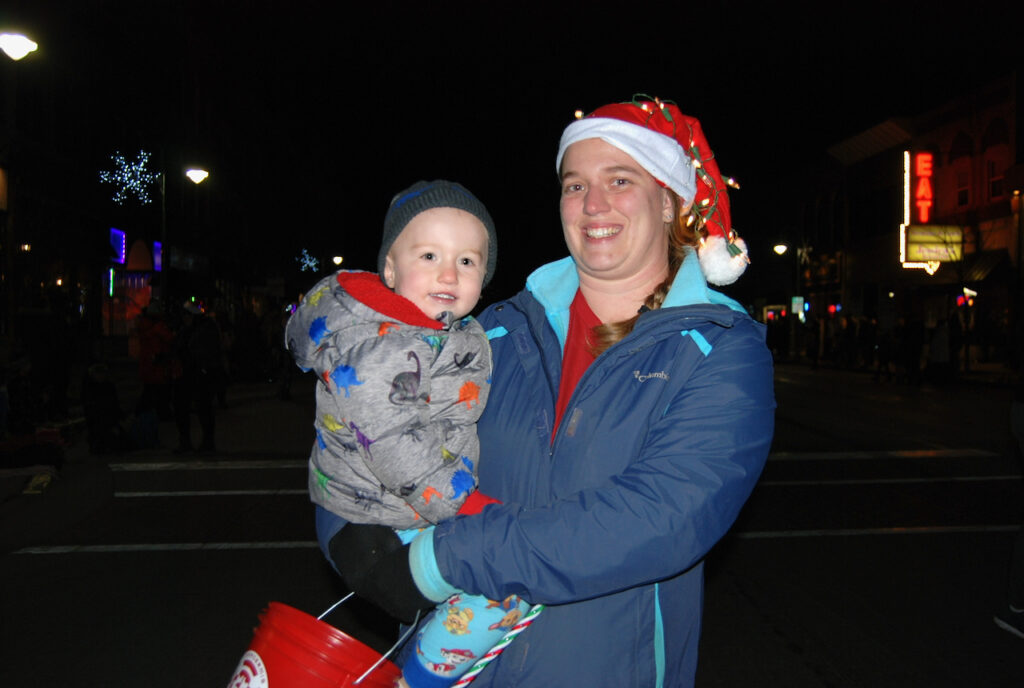
Members of Carting K-9s, a “formed for fun” group from Hebron, march along Main Street.
Representing Ferradermis, parade participants of all ages distribute candy.


Included among Generac marchers, “Rudolph” struts his stuff.
A glistening line of vehicles moves down Main Street.


Adorned with lights, a motorcycle is on parade.
With every inch of their vehicle decorated, this costumed couple travels down Main.


Generac parade participants march along Main.
Winners of this year’s Miss Whitewater pageant wave to the crowd.


A marcher carries the PremierBank banner.
A variety of giant food decorations adorns an entry made by the Whitewater Grocery Company. The organization is working to bring a coop grocery store to Whitewater.

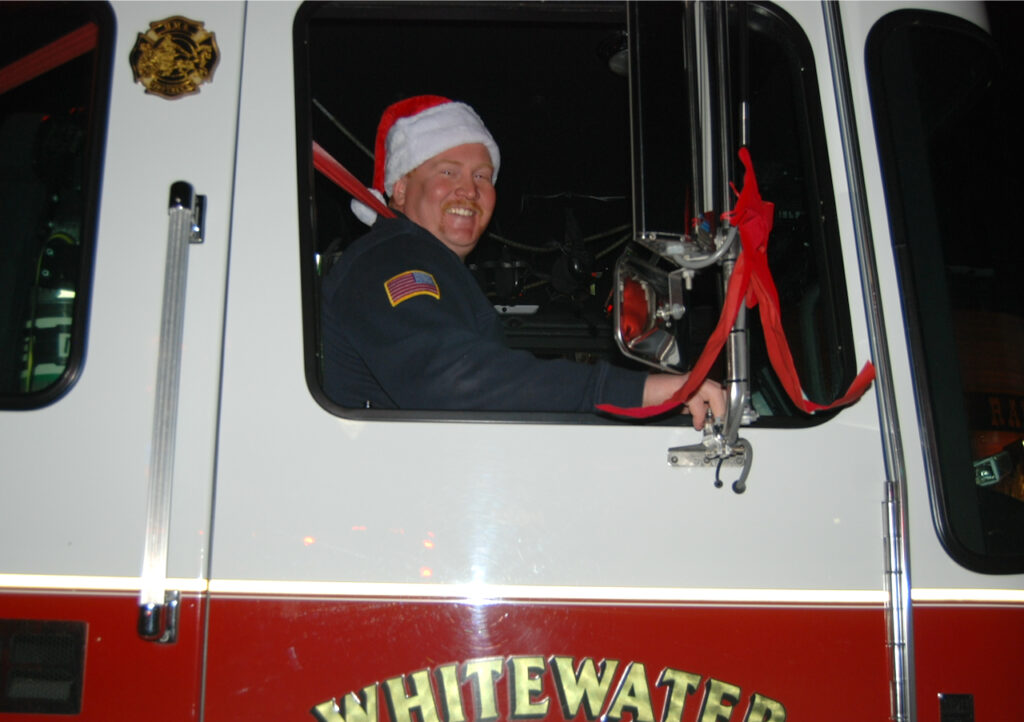
Whitewater resident Ron Binning carries a Whitewater Grocery Company sign.
A member of the Whitewater Fire Department greets parade-goers from a fire truck.
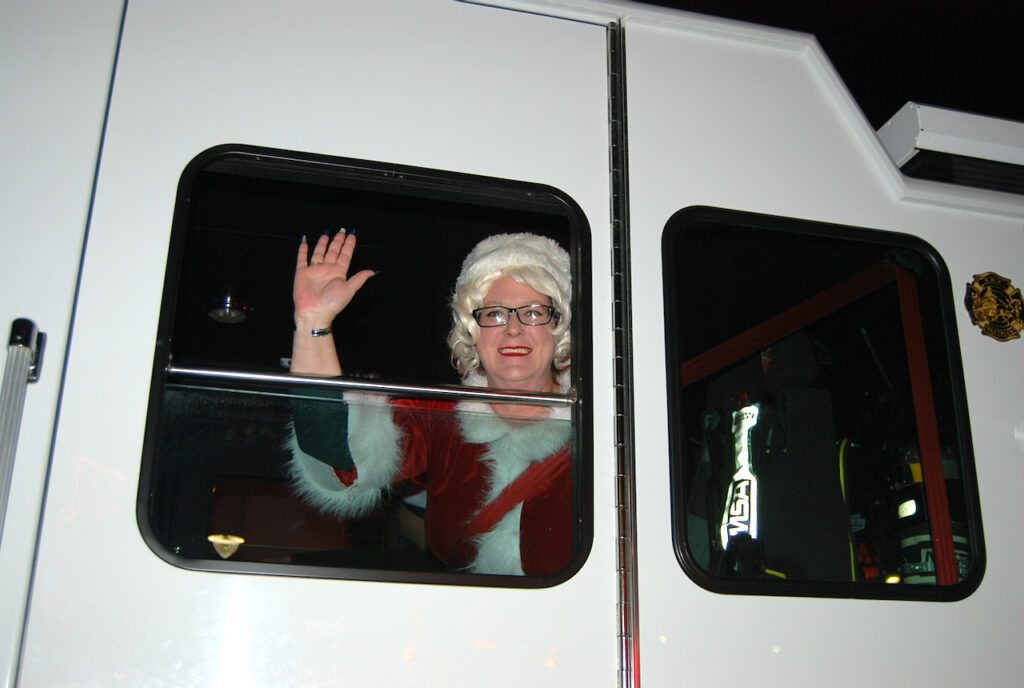
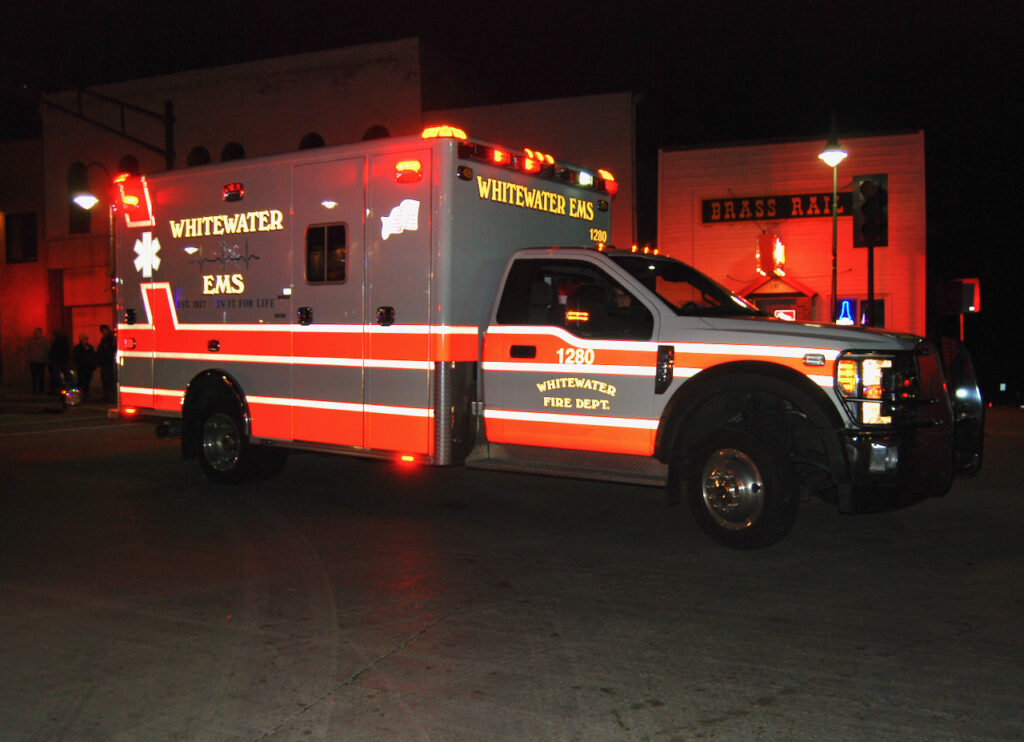
Mrs. Santa Claus smiles and waves to her fans.
A Whitewater EMS ambulance lights up the parade.
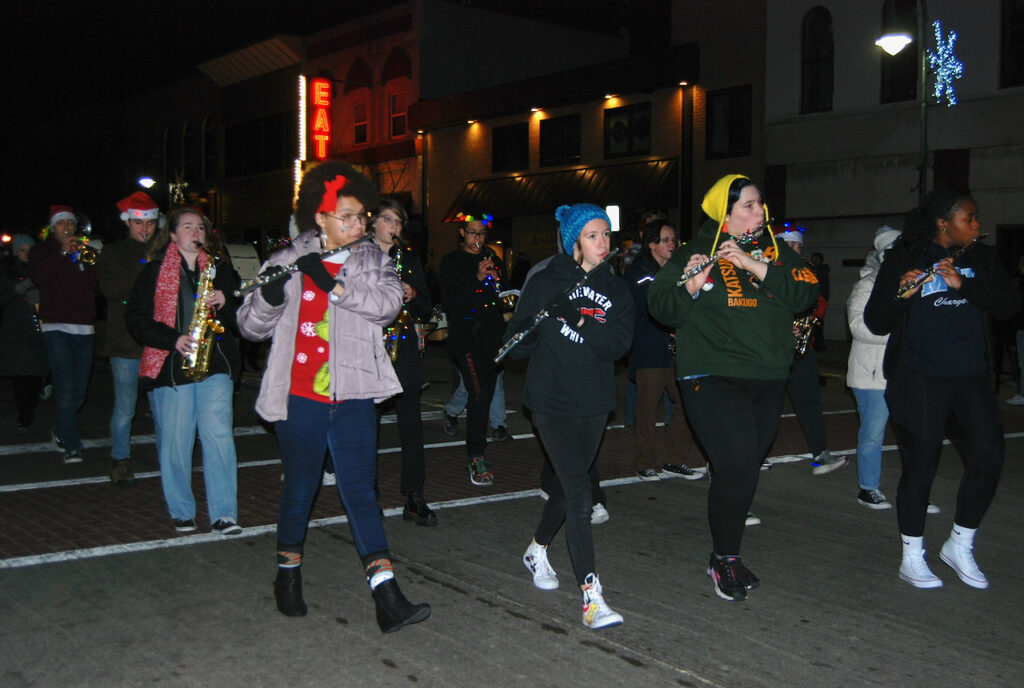

Whitewater High School band students perform as they march along Main Street.
Band students shine through lights and music.


A motorcyclist pulls a cart filled with colorful inflatables.
A snowman figurehead illuminates a boat pulled along Main Street as part of an entry from The Boat House of Lauderdale Lakes.
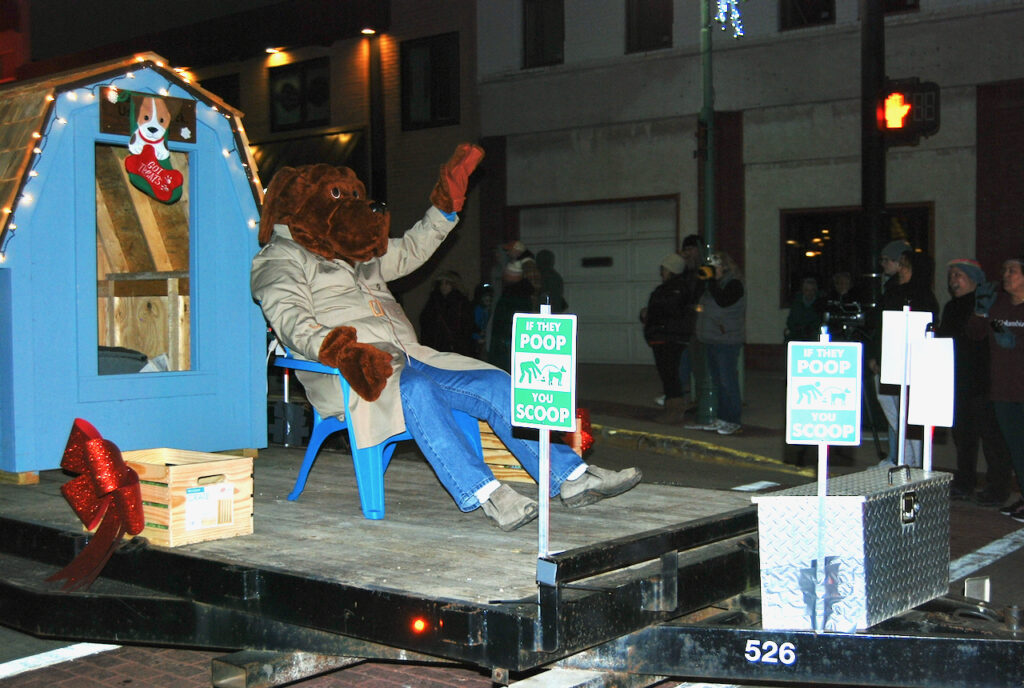

A float entered by the Whitewater Parks and Recreation Department reminds community members to pick up after their pets.
A float entered by the Cub Scouts is populated by festively dressed children.


Inflatable Christmas characters ride in the parade.
Waving from within a fire department vehicle, Santa greets the crowd.


Marchers carry the Generac banner. The company is the sponsor of the 2022 Holiday Parade of Lights.
Lt. Jake Hintz, with the Whitewater Police Department, drives the squad car that signals the end of the parade.
Following are photos taken before and after the parade.
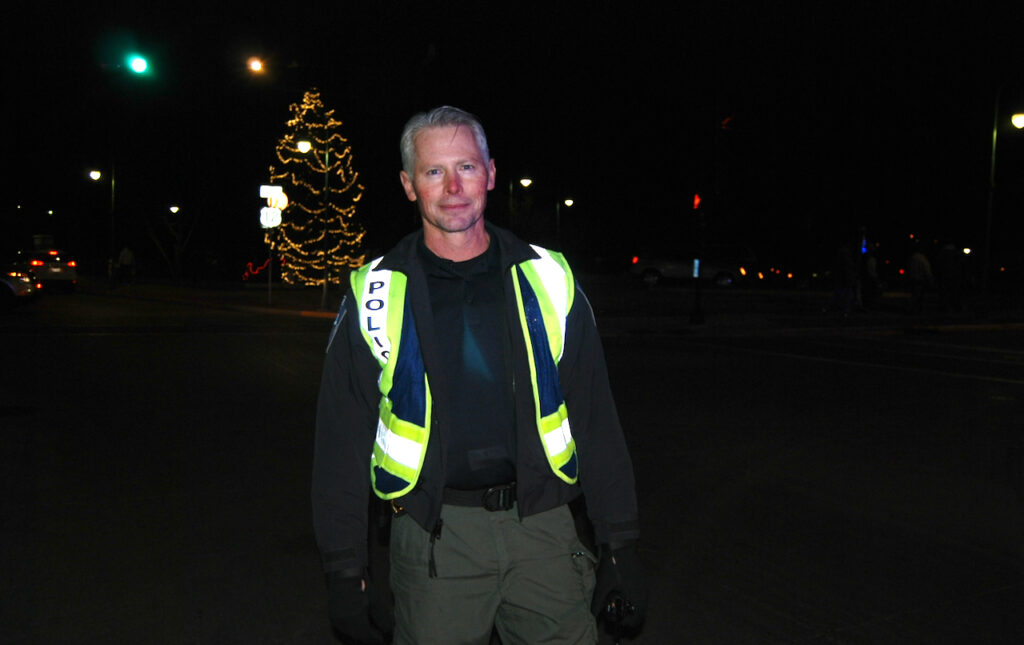
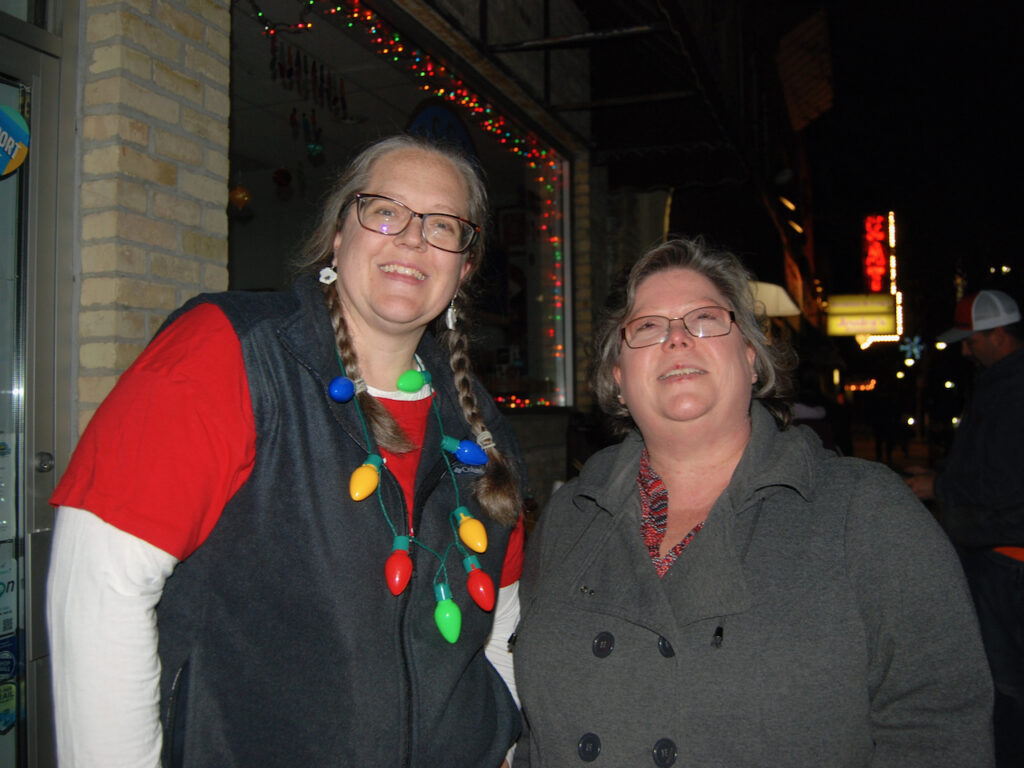
Capt. Dave Gempler of the Whitewater Police Department ensures activities progress smoothly through the intersection of Main and Whitewater streets.
Lisa Dawsey Smith, a representative of Downtown Whitewater Inc., and Kellie Carper, executive director of the Whitewater Area Chamber of Commerce, greet visitors and enjoy the festive ambience downtown in advance of the parade.


Members of the Kincaid family, Whitewater, Delilah, 6, and Arya, 4, enjoy treats in advance of the parade.
A smaller member of the Carting K-9s who was pulled by a furry companion during the parade, waits with his group to be loaded into the vehicle to make the trip home to Hebron.


The Bauschke family, Whitewater, including children ages 8, 7 and 5, makes s’mores at the warming station situated near the Discover Whitewater office on Main Street.
Dressed in warm clothing, complete with reindeer antlers, Nora and Owen Zimborski, Janesville, await the parade.


“Howard,” an approximately 8-year-old Treeing Walker coonhound, at left, is among dogs pulling carts with the Carting K-9s group. He is available for adoption through Albert’s Dog Lounge, a Whitewater-based nonprofit rescue group which caters to senior dogs and those with special needs. To learn more about adopting Howard, visit: https://www.albertsdoglounge.org.
Members of the Dvorak family, Mason, 13, from left; Mikayla, 15; KinLeigh, 10, who is holding “Annie,” a 4-year-old Cavalier King Charles spaniel, and Micah 13, watch the parade from their vantage point on Main Street.


Carting K-9 pups wait after the parade to be unharnessed from their carts.
Seated near the intersection of Main and Whitewater streets, a parade-goer gathers her Pomeranians to ensure they have a good view of the parade.
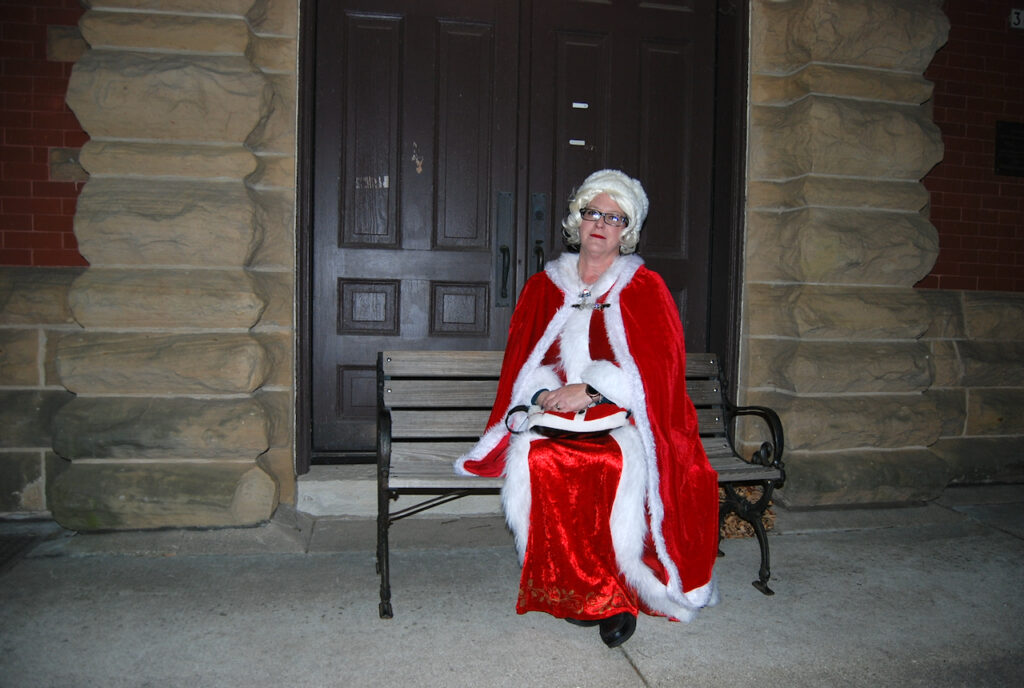
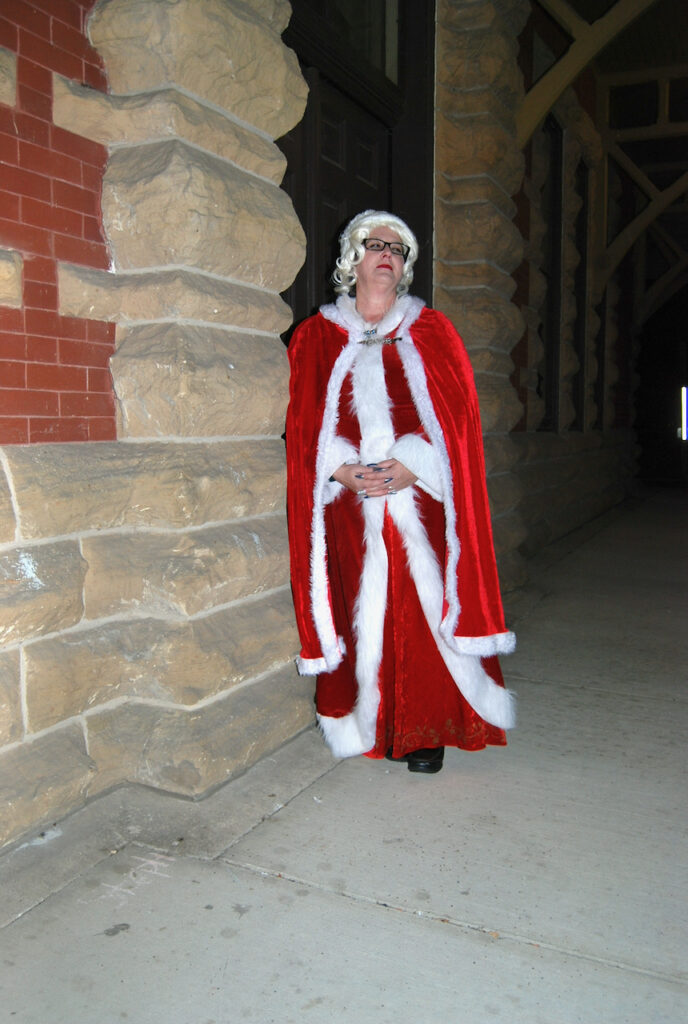
Mrs. Santa reflects upon the holiday season after riding in the parade.
Kim McDarison photos.
Whitewater lights up
(Originally published Dec. 3, 2022.)
By Kim McDarison
Enthusiastic parade-goers lined Whitewater’s Main Street Friday as some 26 parade entries of various shapes and sizes participated in the Generac-sponsored Lighted Holiday Parade.
The event was organized by Downtown Whitewater, Inc., a volunteer-driven nonprofit organization formed to promote Whitewater’s history and traditions, according to its website.
Attendees and participants were greeting with moderate temperatures, and a warming station was made available outside of the Discover Whitewater office on Main Street, complete with s’mores and hot cocoa.
Other activities Friday included an opportunity to meet “Santa and Mrs. Claus,” both of whom were made available for picture-taking inside First Citizens State Bank. The couple also rode, albeit in separate Whitewater EMS vehicles, in the parade. Placing each member of the Christmas couple in a separate vehicle allowed for an individualized presence, Mrs. Claus, said.
A list of parade entries includes: Badgerland Offroad, Whitewater Girl Scout Troop 7639, Fort Atkinson Credit Union, Productive Living Systems, Whitewater Grocery Company, Ferradermis, Generac, Carting K9s, Walworth County Chapter of the Ice Age Trail, Republican Party of Walworth County, Hispanic Outreach Coalition, CHC Christian Horse Lovers, PremierBank, University of Wisconsin-Whitewater Royal Purple News, Lima 4-H, City of Whitewater Parks and Recreation Department, Visiting Angels, Whitewater Scout Troop, BaristaCats Cafe, The Boat House of Whitewater, Whitewater Charge Club, Visiting Angels LAS, Whitewater High School band, Avant Cycle Cafe, Johns Disposal Service, and the Walworth County Fairest of the Fair.
A cookie-decorating and chili dinner event was held at the Living Word Fellowship Church, also on Main Street, after the parade.
Click on the image below to see our full album of parade photos.
Whitewater: Police department receives $1,000 grant from Community Foundation
(Originally published Dec. 5, 2022.)
The Whitewater Police Department recently received a community action grant of $1,000 offered through the Whitewater Community Foundation, according to information released Monday by the foundation.
The grant will be used to offset costs associated with efforts underway to improve communications between the department and members of the community who are unable or have a limited ability to understand and speak English, the release stated.
Improved communications with those who are unable to understand or speak English is a component of the department’s goal to improve community outreach, the release noted.
Among strategies that can help achieve that goal, the department has identified improved communication through interpretation services, which will help members of the department communicate with individuals with limited English language skills while providing them with assistance.
“Timely, accurate and reliable translation services are essential and vital to saving lives, now more than ever. Interpretation services have provided staff with the ability to assist members of our community during a wide range of calls for service, from simple information requests, to assisting victims of significant crimes, and providing emergency medical assistance,” the release stated.
According to the release, the Whitewater Police Department is a full-service, community-oriented and state-accredited law enforcement agency consisting of 24 sworn officers and 13 civilian personnel. The department includes a round-the-clock communications center.
About the Whitewater Community Foundation
As noted within the release, the Whitewater Community Foundation is a nonprofit organization with a stated mission of enhancing the quality of life in the Whitewater area through educational, cultural, charitable or benevolent expenditures. The organization provides scholarships and community action grants. To learn more about the organization, including opportunities to make a donation, and its programming, visit its website: whitewatercommunityfoundation.org.
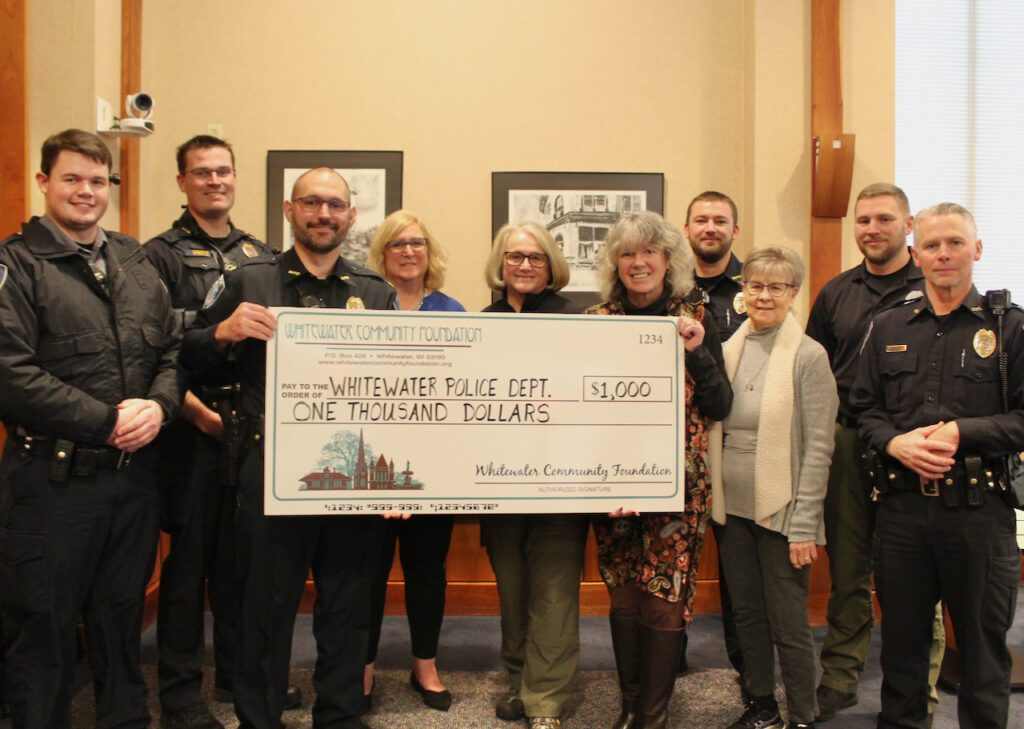
Whitewater Police Department personnel, including Community Service Officer Derek Johnson, from left, Lt. Jacob Hintz, Police Chief Dan Meyer, along with Whitewater Community Foundation member Kat Mahwinney, and foundation co-presidents Roni Telfer and Therese Kennedy, followed by police department Capt. Adam Vander Steeg, foundation program coordinator Bonnie Miller, police department Det. Justin Brock and Capt. David Gempler gather for a presentation of a community action grant of $1,000 presented to the department by the foundation. Contributed photo.
Whitewater: City council incumbent, Brown, challenger, Schanen register as candidates
(Originally published Dec. 5, 2022.)
By Kim McDarison
At least one race is developing for an open seat on the Whitewater Common Council.
According to City Clerk Michele Smith, as of Monday, Brian Schanen, 1199 E. Bluff Rd., has registered as a candidate to run in the city’s Aldermanic District 1. Earlier this month, David Stone, 303 W. Ann St., registered his candidacy with the city clerk’s office. The two challengers have begun the process of collecting the 100-200 signatures required to appear on the April ballot.
The seat is held by incumbent Carol McCormick who has announced that she will not seek another term.
The clerk also reported Monday that Aldermanic District 3 incumbent Brienne Brown has registered and is in the process of collecting signatures. No challengers have thus far come forward to seek placement on the ballot to run for the seat.
As reported earlier by Fort Atkinson Online, Aldermanic District 5 challenger Neil Hicks, 1254 Tower Hill Pass, is collecting signatures to secure a place on the April ballot. Incumbent Greg Majkrzak is not seeking reelection.
Likewise, as of Monday, incumbent Lisa Dawsey Smith, who has submitted signatures to the clerk’s office, is running unopposed. Dawsey Smith holds one of two seats that represent the city at large.
Incumbent Municipal Judge Patrick Taylor also is gathering signatures with plans to run in April to retain his seat. There are, thus far, no challengers seeking the municipal judge seat, according to the city clerk’s update.
The General Spring Election will be held April 4, 2023.
Those interested in running for one of the four city council seats coming due for reelection in April must file a Declaration of Candidacy Form (EL-162) and a Nomination Papers for Nonpartisan Office form (EL-169) with the Whitewater city clerk’s office by 5 p.m. on Tuesday Jan. 3, 2023.
An earlier story, including information about the process for those who would like to run for office in April, is here: https://fortatkinsononline.com/whitewater-spring-election-candidates-running-for-council-may-begin-circulating-nomination-papers-today/.
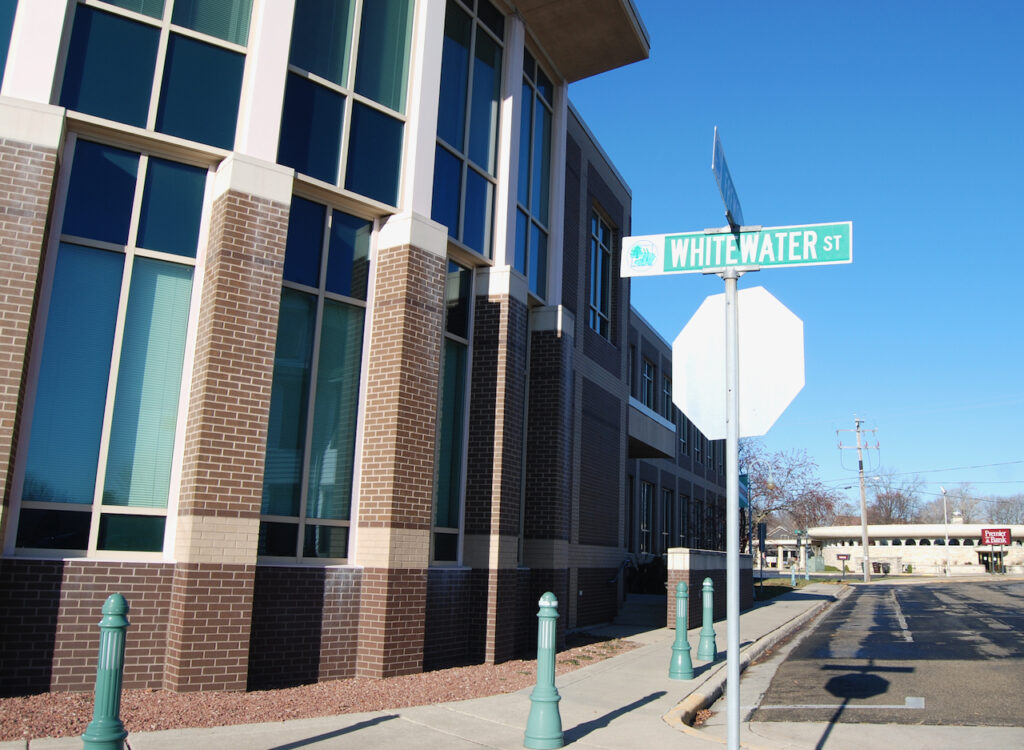
Whitewater Municipal Building, file photo/Kim McDarison.
Whitewater: Coleman tosses hat in ring for municipal judge seat
(Originally published Dec. 8, 2022.)
By Kim McDarison
Art Coleman has begun circulating nomination papers to have his name included as a candidate for Whitewater municipal judge on the upcoming April ballot.
Whitewater City Clerk Michele Smith released his name Thursday as among those in the process of collecting signatures.
According to a Facebook page, Coleman, 403 S. Whiton St., ran as a write-in candidate for the position of Whitewater municipal judge in 2019.
Introducing himself in 2019 to voters, he wrote: “I have 20 years with the state of Wisconsin working for the Department of Corrections. I am a graduate of the University of Wisconsin-Whitewater. My family has strong roots here in Whitewater. I believe I will be an asset to the people and the city of Whitewater.”
Once paperwork is submitted, Coleman will thus far be among those facing incumbent Judge Patrick Taylor who is also circulating nomination papers, according to the city clerk.
The General Spring Election will be held April 4, 2023.
Candidates have until 5 p.m. on Tuesday Jan. 3, 2023 to file a Declaration of Candidacy Form (EL-162) and a Nomination Papers for Nonpartisan Office form (EL-169) with the Whitewater city clerk’s office.
An earlier story, including information about the process for those who would like to run for office in April, is here: https://fortatkinsononline.com/whitewater-city-council-incumbent-brown-challenger-schanen-register-as-candidates/.

Whitewater Municipal Building, file photo/Kim McDarison.
Whitewater: Council hears presentation about improvements at Fox Meadows
(Originally published Dec. 9, 2022.)
By Kim McDarison
The Whitewater Common Council Tuesday received a presentation about improvements made at Fox Meadows, an apartment building on the city’s west side.
The apartment building was a topic of discussion during a council meeting held in September, during which time Police Chief Dan Meyer expressed concerns with over-occupancy at the site and shared statistics noting an increase in calls for service.
In September, Meyer compared an eight-month period between January and August, during three consecutive years: 2020, 2021 and 2022. Meyer said in 2020, the department responded to 30 calls for service at Fox Meadows; in 2021, the department responded to 26 calls, and in 2022, the department responded to 125 calls.
He listed turnover of on-premise management, missing smoke detectors, drug paraphernalia, stains from excrement and urine, and the presence of cockroaches in the building as among additional concerns.
Aided by slides, Jessica Peterson, a vice president with Madison-based property management group BMOC Tuesday offered an overview of the Fox Meadows property, 291 N. Fraternity Lane, Whitewater, along with initiatives taken by the company to address identified concerns.
Introducing Peterson to council, Whitewater Neighborhood Services Director Chris Bennett said that he, a Neighborhood Services Officer Derek Johnson, and Meyer met with the management of Fox Meadows on Nov. 11.
He described the meeting as “productive,” further noting that “some of the matters that we’ve all heard about in the community and that the police department and neighborhood services have been dealing with for quite some time,” were addressed.
Advancing to the podium, Peterson said that BMOC is a management company of properties for third-party owners, focusing primarily on student and conventional housing.
The company has been managing Fox Meadows since November, 2020, she said.
Sharing a slide, Peterson said the management team at Fox Meadows includes a property manager, maintenance technician, leasing agent and regional manager.
The team, which was formed over the past six months, includes two bilingual members, she added.
Among team members, she said, the maintenance technician lives in Whitewater. He along with the property manager are on-premise in a full-time capacity. The regional manager, whom she described as “new,” is based in the Madison office.
Presenting a slide, titled “Fair Housing,” Peterson noted that in Wisconsin, it is “illegal to deny housing or to treat someone different on the bases of sex, race, color, sexual orientation, disability, religion, national origin, marital status (or) family status,” which the slide stated, “includes children in the home.” Also included were status as a survivor of domestic violence, sexual assault or stalking, lawful source of income, age and ancestry.
The company abides by the law, she said, adding: “We can’t rent to certain individuals and not others, and we have a very standard approach to our leasing.”
A slide, labeled, “Resident Verify,” stated that before leasing to a prospective applicant, the company screens through such mechanisms as criminal background checks, credit checks, income verification, and identification.
The company requires a security deposit, which, the slide noted, is risk-based, and residents pay monthly charges, including rent, and fees for parking, water, electricity, and pets.
She described the process as a “standard screening application as part of our accounting software.”
Citing improvements, Peterson said the company had invested in the property by painting cabinets, and using virtual staging.
“Some things we’ve taken on since I’ve been supervising the property are a lot of in-unit improvements. We have upgraded … the flooring in most of the units,” she said.
“All of this is to help our tenant attraction,” she added.
Peterson said when BMOC began managing the property is was approximately 40% occupied. The occupancy rate is now 96%.
“So things have gone well,” she said.
A slide shared the company’s pricing, noting that a unit with a single bedroom and bathroom rented in 2020 for $850 per month, and rents in 2022 for $950 per month; a two-bedroom, two-bathroom unit rented in 2020 for $925 and rents in 2022 for $1,250, and a three-bedroom, two-bathroom apartment rented in 2020 for $1,100 and rents in 2022 for $1,500.
“We’ve slowly improved the quality of the community with the units themselves and then increased rents accordingly,” she said.
Citing availability, she said, as of Tuesday, four units were currently available each with applications pending.
While the company does not maintain an official waiting list, it does contact applicants when a unit becomes available, Peterson said.
Further, she said, improvements recently made to the property include an upgraded camera system, key fob secure entries, which, she said, are being installed this week, asphalt repairs, parking permits, improved cleanliness, monthly inspections, extermination, resident education, bilingual customer services, and the formation of a partnership with the Whitewater Police Department, among others.
In November police and neighborhood service personnel shared brochures and other resources that could be distributed to Fox Meadows community members, Peterson noted.
Said Peterson: “We have been providing resident education in both English and Spanish for common housing concerns that we have, common lease violations. We’ve actually translated our move-in process in Spanish and so it’s really clear where the trash goes, and what it means to be a resident and a participating member of the community. And that’s been very well received.
“We’ve also been, I think, partnering really well with the Whitewater Police Department. I know there was a concern of the number of calls and I had them, too. And when I have reviewed the most recent call reports, I’ve actually noted that our management team, our maintenance staff, are actually the ones making the calls. So, you know, we have an illegal person, we have somebody that’s trespassing, we have a suspicious person on the property, and so we’re actually generating those calls and working together with the police department.”
Looking through 60 days worth of incident reports, Peterson said she was able to group them into one of three categories: “Management,” under which the following types were listed: suspicious activity, dumping, speeding, trespassing, and vandalism; “Social Services,” including school-related truancy, runaway teens, and family disputes, and “Lease Violations,” including noise complaints, drug use, illegal occupants, neighbor disturbance, and fire hazards such as smoking and overloading laundry machines.
While she was aware there had been some concerns at the property, she said staff had become “very diligent” in its efforts to “know what’s going on at the property and taking proper action.”
Looking at goals for 2023, she said they would include the creation of a lease application in Spanish, and the organization of new resident orientation meetings. The company also would plan to partner with schools to ensure 100% enrollment. The company would plan to engage in in-person leasing renewal meetings and a two-strike policy as part of its retention program, with the added goal of maintaining a 100% occupancy rate and an 85% renewal rate within the building. A final goal was to increase rates and fees.
During new resident orientation meetings, the company would work to make sure those within the Fox Meadows community would understand how to “handle things properly so they don’t call the police if it is not a police matter,” Peterson stated.
While partnering with schools, the team would work to help parents of school-aged children understand where and how to enroll their children, Peterson said, but, she added: “We don’t have an active role in enrolling students, we are just trying to share information.”
Peterson expressed an interest on the part of the company to work with the “few large area employers,” whom, she said, employ a majority of the residents that have applied lately.”
She said the company was looking to work closely with UW students.
“The students are applying for next fall — it’s a pretty busy time — this is one of the campuses that a lot of individuals are looking to start leases in May, instead of August; it’s just a different cycle, so we are trying to work with the current residents living at the property to understand who is interested in renewing next May or will be vacating for student housing,” she said.
Referencing occupancy, Peterson said, “the goal is to have a less transient community,” which she added, would be achieved through the renewal rate.
Adding community activities for residents was among ideas to help stabilize the Fox Meadows community, she said.
Questions from council members
During a question period following the presentation, Councilwoman Carol McCormick asked: “What’s your occupancy with students as opposed to families?”
Peterson said she thought about 10% of the Fox Meadows community was comprised of students, but, she added, “I would say our applicant base is about 50%. She described that base as comprised of new applicants looking to move in to the building next year.
Councilman Jim Allen asked: “So you have a loss of students over time then?”
Said Peterson: “Our units are an interesting makeup for students in that they are two-bedroom, two-bath, and we have tried to start marketing individuals so there would be two separate leases, so two individuals, two roommates, sign two leases, each rent a bedroom in the space, like we do with standard student housing. It was really challenging. Individuals either left school or didn’t come in with a roommate — our roommate matching was really challenging — so we’ve kind of, by default, gone back to leasing the entire units.”
She said finding two students who are comfortable with making a year-long leasing commitment can be a challenge.
Still, she said, the company is receiving student applications daily and parents are touring the apartments.
Allen asked: “So do you think your property has become less desirable to UW students?”
Said Peterson: “I wouldn’t say less desirable, I would say that we’ve had a lot of turnover recently, and, again, we are trying to work on retention, and with retention is understanding, I think, we missed the student leasing window this year. We didn’t have a lot of availability in May. So I don’t think we got a lot of new students … I think that during that time there were a lot of transitions going on with the property; we were doing a lot of renovations and improvements, and I just think we missed the leasing window for students.”
Said Allen: “You mentioned a two-strike policy, what happens after that?”
Peterson responded: “Then we would file the legal recourse for a lease, so, again, an example would be a lease violation party, something like that, we would give out a warning, and then the second violation, a five-day notice, which is to stop the activity or vacate, and then we would proceed with the eviction steps.”
“Is there a time period?” Allen asked. He clarified: “If there’s a violation, say there’s one, when does it become a second first violation versus a second violation? Six months? After a year?”
Said Peterson: “I would say within the lease period.”
Peterson said the team was meeting and reviewing incident reports, which will serve to guide a decision about whether or not to renew a tenant.
“Our goal is that we are not having these continuous issues — following fair housing, of course — but these continuous issues with repeat violations, illegal pets or illegal guests surfing, things like that.”
Allen asked: “You showed pictures of people who you said lived on premises. Do they actually live in the building?”
Peterson said they did not.
Asked Allen: “So you don’t have anybody there on-premise?”
Peterson said that was correct, but added that the leasing manager has a family member who lives onsite and the maintenance technician lives under seven minutes away. The property manager lives about 15 minutes away.
Said Allen: “The things you mentioned are all self-reported. So we don’t have an ability to verify pretty much any of them except for making sure that complaints coming from all of our various city departments go down. Because under your management, this property has become a nuisance property. So, I don’t know if Dan (Meyer) wants to speak to any improvements he’s seen or not, but that’s going to be the judge for, I think, most of us up here is you know whether or not these things curtail.”
Peterson agreed, saying that an officer who has frequently answered calls at Fox Meadows told her that he believed the calls had decreased.
Allen asked Peterson who owned the property.
“It’s an investment group out of the Asset Managers in Illinois and Florida. And they have owned the property for 15-plus years. So for a significant amount of time,” Peterson noted.
Councilwoman Brienne Brown asked: “So given that the police department has had many calls there and you have implemented these steps, I’m curious, when did you start implementing them and have the calls gone down?”
Peterson said she believed the steps had been in place for five months.
“I would say from my review of the October/November police reports, yes. The caveat to that is that there are school-related or child-related or social issues that I don’t think we can necessarily impact, and so those have not decreased.”
Brown asked: “I have not been there in four or five months, but before that, I had come by a number of times for reasons. I never could find anybody in the management office. It was closed. So I’m wondering if you fixed that — where there is actually somebody who is there regularly.”
Peterson said the office is manned and maintains regular hours. She said the manager and the maintenance technician often are at the property on weekends.
Councilwoman Jill Gerber said she appreciated the changes the company was making. She said she was glad the company and the various agencies — police, social services, the county and others — were working collaboratively.
Referencing goals presented earlier on a slide, she asked: “Can you tell me what you have planned, because it looks like it was all for 2022. Do you have anything coming out in 2023, or going forward?”
Peterson explained the company’s process for inclusion of capital projects.
“We have proposed — you kind of send a wish list — and how our third-party management world evolves is that we prepare an operating budget and then a wish list of 15 to 20 different items for capital projects.”
She added: “I’m not an investor, so I don’t make those decisions. And it’s all a tradeoff.”
Said Meyer: “I don’t have hard data to confirm what our call volume is, but I do want to say I’ve noticed a big difference with the cameras being installed. So we appreciate that. The fob system is something that we’ve been keeping an eye on because I think that will make a big difference.”
Addressing Peterson, he asked: What, if anything, is the management doing to address the over-occupancy issues?
“We are obviously aware of the issue of individuals leasing an apartment and having individuals, friends, family, move into the apartment, stay for, on average, a month to two months, and then apply for an apartment. That was kind of the cycle that we saw,” Peterson said, adding that she believed in-person inspections would help alleviate the situation.
The company gives notice of issues in English and Spanish, she said.
She cited “maybe three units” within which, she said, “we are still trying to make sure that only the leased occupants are living there on a daily basis.”
Said Allen: “I appreciate you’re working with the truancy aspect of it. That’s not your responsibility, but providing information to the people who move in there both in English and Spanish — they don’t know what our societal norms or expectations are until somebody tells them, and not speaking English, that makes it a little more difficult. We appreciate what efforts you are making. You’ve got a difficult situation with the building right now.”
An earlier story identifying Fox Meadows as a source of increasing calls for police service is here: https://fortatkinsononline.com/whitewater-police-chief-expresses-concerns-with-ongoing-influx-of-new-community-members/.
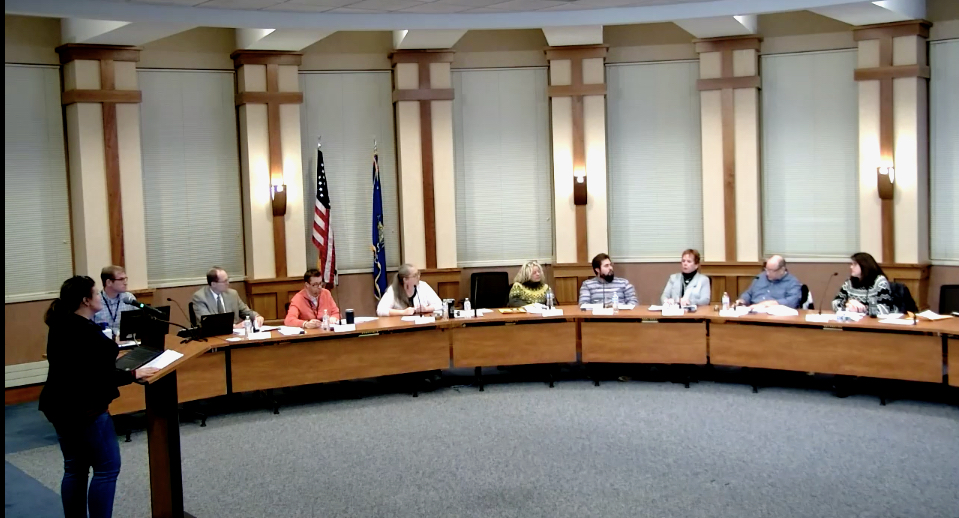
Jessica Peterson, a vice president with Madison-based property management group BMOC, at left, addresses The Whitewater Common Council Tuesday. BMOC is the group that manages Fox Meadows Apartments. The apartment building, located on the city’s west side, was identified by Whitewater Police Chief Dan Meyer, during a council meeting held in September, as a source of increased calls for police service. Screen shot photo.
Whitewater: Council approves class A liquor license quota increases from 4 to 12
(Originally published Dec. 10, 2022.)
By Kim McDarison
The Whitewater Common Council Tuesday approved the second and final reading of an ordinance amendment which increases the city’s quota of available class A liquor licenses from 4 to 12.
The action was approved unanimously as part of the city’s consent agenda.
According to the ordinance, the city will have the ability to issue a total of 12 class A licenses and 24 class B licenses.
A first reading of the amendment garnered unanimous approval from council in November.
During a November city council meeting, City Attorney Wally McDonell explained the difference between class A and B licenses, noting that class A licensure was granted to establishments, such as Casey’s and Walmart, that were looking to sell liquor and beer in closed containers for consumption off premise. Class B licensure is granted to establishments looking to sell liquor and beer for consumption on premise. He described class B licenses as those typically granted to bars and taverns.
McDonell noted in November that the change in the ordinance had been brought for consideration before council after business owners within the city had sent correspondence to the city clerk’s office, seeking the addition of available licenses, after the city had earlier increased its quota by two licenses to accommodate Kwik Trip.
Citing in November the requests brought by the additional business owners, McDonell said: “I know there’s been some indication that they felt it was fair and justified because the quota was increased for Kwik Trip — that there should be an increase for other businesses that would like to sell … That is why it was put on (the agenda), to give the council an opportunity to increase the number.”
An earlier story about the liquor license quota and the amendment’s first-reading approval in November is here: https://fortatkinsononline.com/whitewater-ordinances-amending-liquor-license-quotas-food-truck-regulations-pass-first-readings/.
Food trucks
As indicted on Tuesday’s city council agenda, a second reading of an amendment to an ordinance governing food truck operations within the city was removed from the agenda. A notation identified the item as removed as of Dec. 2.
A first reading of the amendment received council’s unanimous approval during a council meeting held in November.
During the November meeting, Neighborhood Services Director Chris Bennett described the amendment as “tidying up some language as it pertains to food trucks,” adding that the intent of the amendment was to add language stating that food trucks cannot conduct business within 100 feet of a licensed food establishment unless the truck operator has written permission from the owners of the establishments within that vicinity.
During the discussion held in November, council members identified several language additions that they thought might be worthy of incorporation into the revised ordinance.
Additional proposed language covered such topics as restricting hours of operation and limiting operations to certain areas within the city, and increasing a truck vender license application fee to better cover costs associated with proposed initiatives such as background checks.
McDonell told council members that the ordinance also stipulates restrictions regarding door-to-door sales.
Said McDonell in November: “Our transient merchant ordinance does currently regulate door-to-door sales quite strictly. Since we are bringing it back, maybe there’s going to have to be a change in how that’s regulated.”
He said he wanted to supply a “heads-up” so there would be no surprises if that part of the ordinance also appeared before council with the amendment’s next reading.
City Manager John Weidl told members of council that proposed language for inclusion within the ordinance would return to council “at a later date,” further noting: “There’s no rush.”
Council’s discussion in November regarding amended regulations for food truck venders is included in the link shared previously within this story.

Whitewater Municipal Building, file photo/Kim McDarison.
Whitewater: Penalties codified for unnecessary EMS calls, golf carts on public roads violations
(Originally published Dec. 11, 2022.)
By Kim McDarison
The Whitewater Common Council Tuesday approved first readings of two ordinance amendments, the first of which offers a three-tier penalty structure for members of the community placing unnecessary or preventable calls for emergency services, and a second which outlines a two-tier penalty structure for those in violation of the city’s “golf carts on public roads” ordinance.
During the meeting, City Attorney Wally McDonell said both ordinances were required to establish a “deposit amount,” one for offenses associated with unnecessary calls for EMS services and another associated with violations of an ordinance allowing golf cart use on city-owned streets.
Both first readings received unanimous approval.
Preventable calls
According to the ordinance amendment, those placing unnecessary or preventable calls for emergency services could be subject to the following penalties:
• First offense: a fine of $200 plus statutory penalty assessment, jail assessment, court costs and crime lab assessment.
• Second offense: If the second offense occurs within one year, a fine of $350, plus statutory penalty assessment, jail assessment, court costs and crime lab assessment.
• Third offense and subsequent offenses occurring within on year: a fine of $600, plus statutory penalty assessment, jail assessment, court costs and crime lab assessment.
Unnecessary EMS calls ordinance background
As earlier reported by Fort Atkinson Online, on Nov. 15, the ordinance defining preventable and unnecessary EMS calls received final approval as part of the council’s consent agenda.
In October, council voted in favor of postponing the ordinance during its first reading, asking staff to explore language that would make more specific the activities defined as unnecessary or preventable calls, and their frequency that would precipitate the engagement of a penalty system.
A list presented in October included the following:
- Calls that do not require emergency service.
- Repeated calls that display a pattern indicating the home/care employee skill levels and capabilities do not align with the special needs fo the resident.
- Fire alarms caused by unattended, burned food.
- Fire alarms caused by detectors that have not been maintained.
- Fire alarms caused by excessive dust or a similar non-combustible trigger.
- 911 misdial/hangup calls.
- Runaway, elopement or missing resident calls.
- Lift assist calls not caused by a fall.
An earlier story about the ordinance and its first reading is here: https://fortatkinsononline.com/whitewater-council-postpones-ordinance-aimed-at-reducing-nuisance-emergency-service-calls/.
In November, the revised ordinance excluded “lift assist calls not caused by a fall” from the list defining unnecessary or preventable calls.
A story about second-reading approval of the ordinance as part of the city’s consent agenda is here: https://fortatkinsononline.com/whitewater-council-approves-ordinance-aimed-at-reducing-nuisance-emergency-calls/.
Golf carts on city roads
According to the ordinance amendment approved Tuesday, those operating golf carts on public roads within the city in violation of the city’s golf cart operations ordinance could be subject to the following penalties:
• First offense: a fine of $100, plus statutory penalty assessment, jail assessment, court costs and crime lab assessment.
• Second offense and subsequent offensives: a fine of $150, plus statutory penalty assessment, jail assessment, court costs and crime lab assessment.
The ordinance — allowing for the operation of golf carts on city-owned roads — received first-reading approval from the city council in September. The ordinance was brought back before council for a second reading on Oct. 4, at which time it was postponed after language was proposed which would allow golf carts to operate on city sidewalks for “short distances.” On Oct. 18, the ordinance received second-reading approval as it was originally written, excluding language allowing golf carts to operate on sidewalks.
Golf cart use on city streets ordinance background
During a city council meeting held Oct. 18, one of the ordinance’s authors — Councilman Greg Majkrzak — said it had been in development for nearly a year.
A second reading of the ordinance was approved by a vote of 5-2, with council president Lisa Dawsey Smith and councilwoman Jill Gerber casting the two ‘no’ votes.
During the meeting held Oct. 4, council voted to reconsider the ordinance as it was written and approved during its first reading, held Sept. 20.
During the meeting held on Oct. 4, council considered several amendments to the ordinance, including allowing golf carts to operate on city sidewalks for short distances and language that would extend the time during which headlights needed to be operational, from “sunrise to sunset” to “hours of darkness,” which, according to Gerber, is defined by state statutes as the period of time from one-half hour after sunset to one-half hour before sunrise and all other times when there is not sufficient natural light to render clearly visible any person or vehicle upon a highway at a distance of 500 feet.
Also considered during the Oct. 4 meeting was the inclusion of a registration fee.
The ordinance, as passed during its first reading in September, allowed for the registration process to take place every three years. Proposed amendments on Oct. 4 required that the process take place annually.
During the Oct. 18 meeting, Majkrzak said he was not in support of adding language that would allow golf cart use on city sidewalks.
Gerber said she would consider voting in favor of the ordinance with several amendments, including an annual registration fee of $35 and language that would incorporate the state’s hours of darkness definition into the ordinance.
Gerber also asked for an amendment requiring those registering golf carts for use on city streets to present a valid drivers license at the time of registration.
As reported by Fort Atkinson Online after the Oct. 4 meeting, after engaging in an hour-long discussion, council approved a motion to postpone the ordinance, which had come before it for its second and final reading, by a 4-3 vote, with council members Jim Allen, Brienne Brown and Greg Majkrzek voting against the measure. The action returned the ordinance to city staff, charging it with crafting language to include several proposed amendments, such as allowing golf carts to travel for “short distances” on city sidewalks.
After the motion to postpone the ordinance was approved, Majkrzak noted his disappointment with the council’s decision.
A link to earlier reporting by Fort Atkinson Online after the council meeting held Oct. 4 is here: https://fortatkinsononline.com/whitewater-council-postpones-ordinance-allowing-golf-carts-on-city-streets/.

A small fleet of golf carts are at the ready for use at Willowbrook Golf Course, Whitewater. An ordinance allowing the use of golf carts by residents on city streets was approved in November. A schedule of fines for those operating in violation of the new ordinance was approved Tuesday. File photo/Kim McDarison.
.
Whitewater: City looks to hire new CDA director; job description, policy clarifications discussed
(Originally published Dec. 12, 2022.)
By Kim McDarison
The Whitewater Common Council Tuesday began a discussion revolving around hiring a new Community Development Authority (CDA)/economic development director and making clarifications to the position’s job description, chain of authority and additional policies governing job performance.
Earlier this year, the position was vacated first by CDA/Economic Development Director Cathy Anderson and then by interim CDA Director Nathan Theil.
Anderson resigned from her position as CDA Director, according to a resignation letter submitted to then-City Manager Cameron Clapper, in May. A reason for her resignation was not included in the letter.
City records show that Theil served as a limited term employee in the role of CDA director between June 1 and Aug. 11. He left the position after receiving a permanent position in Beaver Dam.
City Manager John Weidl — who advanced Tuesday’s discussion as an agenda item — said he chose to begin the conversation at the council level, with continued discussion planned at an upcoming CDA meeting. He stated that he would plan to return before council after gaining input from the CDA board, offering council a second opportunity to discuss the item before determining a course of action regarding the director’s job description and guiding policies.
A proposal for contracted services
In a memo provided to council Tuesday, Weidl wrote that he had reviewed historical files related to the CDA, and city ordinances and resolutions pertaining the the board’s authority, along with a job description for the economic development director (EDD).
In addition, he wrote, “ I have met in person with previous EDD and community stakeholders, as well as attended multiple CDA meetings and consulted with the city council president, who has also spoken with the chairperson of the CDA.”
Weidl said that through his research, he formed two conclusions: “The first is that the line of oversight and job duties serving both the CDA and the city is murky at best. There seems to be conflicting reporting roles between the CDA, as an appointed body and extension of the city council, and the city manager, as the appointed chief executive and chief administrator of the city. Further, there seems to be no requirement that the CDA have an executive director or that role be correlated to the EDD. Secondly, there is no organizational or operational framework providing direction to the EDD. In short, unclear reporting and no plan for achieving success.”
In his memo, Weidl proposed contracting with an economic development professional for 90 to 180 days of service. During that time, he wrote, the professional could assist the city by providing guidance, and a “framework for succeeding in an area that has been underperforming for years.”
Additionally, Weidl outlined four “action items” a consultant would be tasked to complete before a recruiting process for an EDD could commence, including:
• Develop a recommendation for a staffing and reporting structure for the city’s economic development platform.
• Design an affordable housing tax incremental financing program based on existing housing studies, a Southern Wisconsin Regional Planning Commission (SEWRPAC) report, and best practices taking place across Wisconsin.
• Develop a market strategies report based on current and projected future economic and demographic data, including a list of strategies and objectives for the next five years.
• Establish a consistent, measurable and trackable Business Recruitment and Expansion (BRE) platform for use by the city and CDA.
Weidl proposed that the city set aside the next three to six months to focus on developing a framework for success after which an EDD could be hired.
He estimated a cost for the economic development professional’s services, as outlined in his memo, at approximately $45,000 for a six-month period, and proposed using savings achieved in EDD wages not paid to fund the contracted services.
A proposal from Madison-based Redevelopment Resources, offering the economic development professional services of Kristen Fish-Peterson, also was included in Tuesday’s meeting agenda packet.
Weidl opens discussion
Conversation Tuesday began with the agenda item identified as an update on vacant CDA director/economic development director position and a request for approval to solicit consulting services for up to six months prior to filling the position.
Opening the discussion, Weidl said: “We are just going to have a conversation. We will set some direction.”
Weidl said he found some aspects about the relationship between the council and the economic development director’s position “unclear.”
“My concern is I’m unclear how the city council views the reporting relationship of that position, specifically, I’d like to get some guidance as to how to interact and move forward with the Community Development Authority.”
Weidl said he was looking for clarification about aspects of the position, noting that after doing some research into the background of the position, he had developed an understanding that “the previous manager and the previous person in the economic development director/CDA position, I don’t think saw eye-to-eye on the reporting procedure, and who was accountable to whom, and at what points it was appropriate to work exclusively with the CDA — because I do believe there are many things within the CDA’s purview that is solely for them to execute right on their own terms — there are loans, there are programs, they have their own mission — so the thrust of what I’m trying to put across is I think it might be appropriate to bring in — I don’t have anyone specifically in mind yet — I’ve given you an example — I think someone who has experience in economic development, has experience working with CDAs, to work on meeting with the CDA, work on meeting with the city council, some of the staff, some of the stakeholders and help us determine — answer some of the basic questions for me — including who should be involved in the interview process.”
He asked: “Should it be panel?”
Weidl said that while he did not believe it was illegal for a city manager to fill the economic development director’s position, he also did not believe it was appropriate for the city manager to do so without input from various city stakeholders, departments and boards.
“I want to make sure we’re having these conversations. My intent would be to take whatever is decided here today — as much of a decision as we make — and then go to the CDA and have a conversation with them next,” he said.
He said he believed the city would benefit from having an outside professional, one whom he described as having “no stake in holding the position, applying for the position, or being here after we decide how we are going to fill the position. Their role would be to work with the CDA, and the city council, and the city manager to determine how best to shape the position and determine its reporting authority.”
Council members weigh in
Offering his comments, Councilman Jim Allen, who also serves as the vice president of the CDA, said: “I think you were misled a little bit and maybe in discussion with the previous CDA director. If you had that discussion, you probably shouldn’t have. The CDA is, seems, needs to look somewhat autonomous, but it has to work together with the city as you know. So the city CDA director was part of the management team, and things that came through the CDA were discussed at the management level as they should be. The CDA can’t do anything on its own. It needs the city to do that. Personally, I’d like this to go through the CDA first — I don’t know if you got a hold of (CDA) President (Patrick) Singer, and discussed it with him.”
Members of the CDA include council representatives Allen and Council President Lisa Dawsey Smith, along with citizen members Singer, Jacob Gildemeister, Joe Kromholz, Jason Gleason and Jon Kachel, according to the city’s website.
Weidl said he began the discussion at the council level because that is the body to whom the city manager reports. He said he would talk with the CDA board members and then “circle back,” and bring the item before the city council again.
“I’m happy in the future to do it a different way. I had to start somewhere — right? There’s a chance I’d run the risk that someone on the council would have said: ‘How come you didn’t come to us first?’ So I just picked one,” he said.
Weidl asked of Allen: “In your explanation, did the CDA director then report to the CDA and not the manager? and then, who did the hiring? Those are all the questions I’m trying to answer, and then what should that be going forward? And I’m open to all sorts of ideas.”
“We have an ordinance already published. I’ll let some of that be answered by either Larry (Kachel) or Jon (Kachel) who have been in this game for a long time. Both of them have been directors. The CDA director that was terminated was terminated for cause,” Allen said, adding: “I won’t get into it more than that.”
Offering comments, Councilwoman Brienne Brown said: “My time working with city council, and with CDA, and seeing what’s going on — it’s a mess.”
She described the proposal offered by Weidl as “great,” adding: “I would love to see more collaboration, because the arguments of who do you go to and who’s in charge, and who reports to who, have been happening for years, and I’m a little sick of it personally. I’d like more clarity on how things work and I think it seems like a good investment of money that’s already sort of sitting there, to try and figure out how to make this work better. We’ve lost people and it just seems like we’ve got 10 years of not really having a CDA director working for us. And that’s 10 years of loss right there that we could have done more.”
Describing some of the CDA’s history, Allen said “It ebbed and flowed a little bit.”
In the past, he said, city managers have wanted to “jump in,” adding that he believed “city managers seem to all want to have their fingers in economic development or be the CDA director.”
He said that contributed to a situation where the CDA ebbed and flowed.
Weidl said he did not want to be the CDA director.
“I would like to put someone in that role who very clearly understands the reporting relationship in our shared — there are shared — expectations between both the city, the city manager’s office and the CDA. That’s resoundingly clear to me,” he said.
Several council members agreed that the CDA director answers to the city manager.
Addressing Weidl, Allen said: “Policies are set by the CDA board, but the day-to-day operations answers to you.”
Offering her comments, Dawsey Smith said: “I think that whatever course of action that’s wise to set forth — a sustainable course of development that the community clearly needs — we cannot spend time bogged down in anything at this point.”
Said Allen: “The CDA is really important because we bring in business, we bring up the tax base and help keep our taxes down, so this is Whitewater’s economic arm — this is really important to the city.”
Opening comments to members of the public, Whitewater resident Jeff Knight, who described himself as a former CDA chairman, board member, and said he is still serving on the Tech Park board, said he knew personally the individual whom had been identified by Weidl as an example of a economic development professional.
He said: “I have no problem with her skill or ability. The questions I really dove into when I looked at it — I’m not quite sure you want somebody that’s on a contract doing retention, because it’s all about relationships.”
He suggested the person “doing those retentions” should be a permanent hire.
“So I had a little problem with that piece of it, and the other piece: I think you guys have done maybe three housing studies already, I think that’s been kind of worked on quite a bit, so I’m not sure — so that’s where I had a little disconnect to where is this coming from? Because it didn’t look like she (the economic development professional identified in Weidl’s memo) was really doing the evolutionary planning, and doing like more as a facilitator, bringing people to talk about the position — the descriptions, the mission, the task force — and I think that’s different from what I’m hearing than what I read in the documents, so from my perspective I think it’s crucial that everybody on this council understands what the CDA does — Brienne’s point is very important — it’s crucial to the CDA.
“As their mission, there is a need for you to maintain their independence for the potential of a big project coming here and having the need to get some financing, so you will need both bodies to continue — there’s no ability to get rid of it and think you’re going to stay active in the economic development world.”
Knight said he believed the city needed to concentrate on managing “your grants and loans, and I don’t know how that’s being done, and I think that that’s probably something that could be done without Kristin handling it.”
Knight continued: “It’s really crucial that you keep those current manage and that file going. In the longterm — I think you miss the window on housing — that’s my personal opinion. I’m not sure how energized you can be would change the market (from) what it is, but I do think having the conversation should go to the CDA next.”
Said Knight: “I had heard the same thing: that the current CDA chairman didn’t know anything about this, and so, whether that’s true or not, I have no idea, I haven’t talked to Patrick, I put a call in to find out if that’s true. But I really think you want to do that. You guys want to sit down, whether that be it a joint meeting, whether you call it an emergency joint meeting, but I think you need to get the parties together and I do think longterm the city needs to look at your sunset date that you’ve got on committees and appointments.
“I think that, or you institute a better training program for new people coming on these boards or commissions because the way you sunset people off, you’re losing some pretty qualified positions. Some of the jobs you’ve got in the city are pretty crucial to have some of the institutional knowledge of what’s gone on in the past and why … I think that would make sense for the board to look at longterm: Do you have a good formula when people tap off of these committees? And should you maybe look at, longterm, extending that for another three-year term or something?”
He said training for new CDA members would help alleviate “people getting to the point where they don’t have a clue why they are there or what they are doing, or don’t have any economic development business-related experience of the CDA.”
Councilwoman Jill Gerber questioned whether the city needed another report, agreeing with Knight that the city already had three housing reports.
Weidl responding: “It’s the policy — we currently have no policy on how to spend that $1.9 million.”
His comment referred to money set aside by the city after the closing of Tax Incremental Financing District No. 4, which has been earmarked for housing development.
Weidl said his proposal would help create policy that “would have the capability of turning that into the actionable housing policy that tells us how we are going to attract and build those houses. It’s taking the information and working to turn that into a policy.”
He asked: “Are we going to invest in land? Are we going to reimburse for infrastructure? Are we going to provide mortgage assistance? It’s all of those things.
“We are not doing another housing study. We’ve had plenty,” he said.
Referencing the proposed contracted professional and the development of a BRE, Weidl said, “The intent is not to have this person doing those meetings. The intend is to help us develop a platform, meaning how many businesses are we targeting a year? How are we tracking that data? Making sure we’re asking systematic questions so we can gather data that actually tells us something. So it isn’t the actual going out and having the meetings, it is helping us put up that structured reporting platform that the person incoming into the position will know what they’re required to hit, meaning I can give a job description that sets the expectation.”
Allen said that in the past, the BREs have been set by the CDA board, including goals and objectives, for each year.
Weidl said his next steps would involve going before the CDA board during its next meeting, which will be held Thursday, at the Whitewater Municipal Building, at 5:30 p.m. He said he would plan to bring the discussion back to the city council in January.
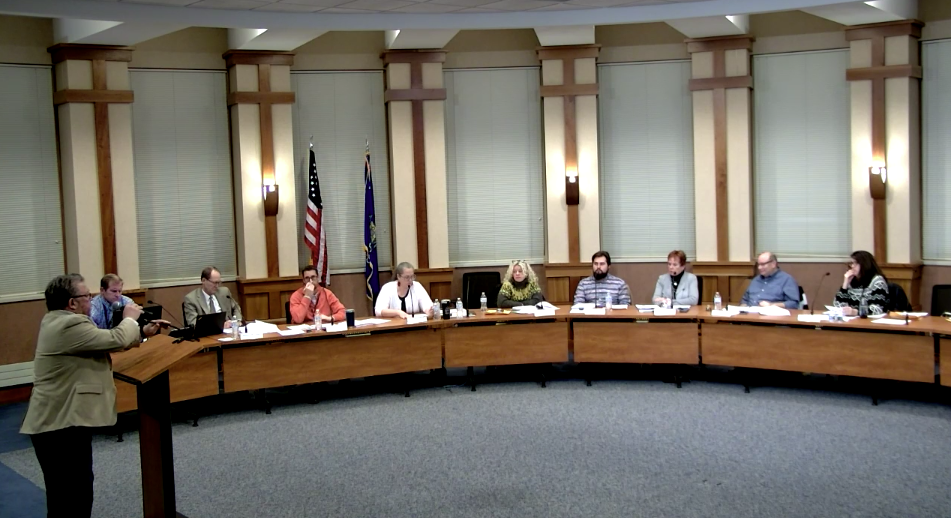
Whitewater resident and former Community Development Authority (CDA) chairman and board member, Jeff Knight, at left, offers the Whitewater Common Council his impressions regarding proposed updates to the job description and governing policies of a CDA director. The city has been without a permanent CDA director since May and an interim director since August. The discussion took place Tuesday during a city council meeting. Screen shot photo.
Whitewater Arts Alliance to present special effects makeup artist
(Originally published Dec. 14, 2022.)
The Whitewater Arts Alliance (WAA) has announced it will be presenting Kim Witte, a graduate of the University of Wisconsin-Whitewater who is a professional special effects makeup artist.
Witte operates Witte Artistry, LLC, a company through which she creates entertaining and educational content, based in beauty, makeup and traditional art work, according to a biography shared about her on the amazon.com platform.
According to the biography, “body painting and acrylic painting are her specialties.”
The biography further notes her recent expansion into the “creative food and metal health space.”
A book written by Witte, titled: “Noodles & Doodles: An Eclectic Cooking Experience with Kim Witte,” is available through the online retailer.
Witte’s makeup work, presented in educational video format, has been featured on such social media platforms as TikTok and YouTube.
An exhibit of Witte’s work, focusing on special effects makeup artwork, will be available for viewing at the Whitewater Cultural Arts Center, 402 W. Main St., from Feb. 2 to March 26, 2023.
An opening reception is planned for Feb. 3, 2023, between 1 and 3 p.m.
Light refreshments will be provided, according to a news release from the Whitewater Arts Alliance.
According to the release, Witte earned a bachelor of arts degree from UW-Whitewater and has been pursuing her makeup art as a career for more than 11 years.
For more information about the exhibit, visit: www.whitewaterarts.org/witte-artistry-exhibit-2023.

Makeup artist Kim Witte explores the concept of becoming a “Cheshire Cat.”

Makeup artist Kim Witte produces the illusion of a hand made out of bacon.
Contributed photos.
Whitewater: Council approves plan to transfer city’s MRAP vehicle to another agency
(Originally published Dec. 20, 2022.)
By Kim McDarison
The Whitewater Common Council last Tuesday unanimously approved plans to transfer the city’s Mine Resistant Ambush Protected (MRAP) vehicle to another law enforcement agency or back to a military installation.
Offering information to council about changes made in the program through which the city obtained the vehicle, and after describing the pros and cons associated with keeping the vehicle, Whitewater Police Chief Dan Meyer said that while there was a usefulness for equipment like the MRAP vehicle, for his department, “the juice isn’t worth the squeeze on this one.”
He recommend transferring the vehicle to another agency.
He noted that a potential for the city to incur an expense of up to $10,000 was possible depending upon the process used to transfer the equipment by the government program through which it was received.
Changes in the program, options
Referencing a memo provided to council members in their meeting packet, Meyer noted that the MRAP vehicle was obtained by the Whitewater Police Department at no cost in July of 2019.
The vehicle was obtained through the U.S. Department of Defense Law Enforcement Support Office, or LESO, also known as the “1033 Program.”
The MRAP vehicle is the only piece of equipment obtained by the Whitewater Police Department through LESO, he said.
Meyer noted that all of the department’s personnel have been trained to operate the MRAP vehicle, which, he said, has been deployed by the department twice. The first time was in support of law enforcement operations during the 2020 riots in Kenosha, and a second time was during a situation in Whitewater, which, the memo noted, “involved a potentially barricaded suspect in possession of a firearm.”
Before new requirements were set by the program, use of the MRAP vehicle was not limited with regard to how it might be used by law enforcement, Meyer said.
He noted that new requirements going into effect as of Jan. 1, 2023, will change the way in which the vehicle can be deployed.
Within his memo to council, Meyer shared several requirements which he believed would impact the department and its use of the equipment, including:
• MRAP Updates: which noted that MRAP vehicles may now only be used for “disaster-related emergencies; active shooter scenarios, and hostage or other search and rescue operations or anti-terrorism preparedness, protection, prevention, response recovery or relief.” Search warrants are not included in the list of approved uses, Meyer wrote.
• Civilian Governing Body Approval: which noted that in order to participate in the LESO program, law enforcement agencies must receive annual approval from their Civilian Governing Board, which, within his memo, Meyer defined as the common council.
• Public Notice: which states that agencies must annually post public notice regarding the type of new controlled equipment the agency intends to requisition through the LESO program. Public notice must be made at least 30 days before the equipment is requisitioned through LESO.
• Training Requirements: which include requirements to provide scenario-based training to personnel that combines constitutional and community policing principles with controlled-property-specific training. The memo noted that those directed to use the controlled property should have enhanced scenario-based training to examine, deliberate, and review the circumstances in which the property should or should not be used.
Additionally, in his memo, Meyer offered several options that could be considered and approved by the council. They were:
• Sign the Defense Logistics Agency agreement enumerating the listed requirements which would allow the department to continue operations of the MRAP vehicle.
• Decline signing the agreement and work toward transferring the equipment to another location.
Meyer noted that, would the council approve plans to transfer the equipment to another agency, one of two processes could take place.
Once LESO was made aware that the department no longer wanted to maintain its MRAP vehicle, LESO would initiate a nationwide “data call,” looking for another agency that might like the equipment. Would another department become known, the Whitewater Police Department and that agency would work together to move the equipment and LESO would complete the required documentation.
In the event that another agency did not want the equipment, the Whitewater Police Department would become responsible for returning the MRAP vehicle to a specified military installation. A cost associated with the process could be as much as $10,000, Meyer said.
Meyer said he did not know which installation might be identified by the program to receive the equipment.
Council discussion
During discussion, Councilwoman Carol McCormick said: “When they delivered it, it was kind of like dumped on the city, wasn’t it?” She asked: “Were we expecting this piece of equipment?”
Meyer said that it was requested.
McCormick said it was her understanding that the city had “kind of tucked it away in the garage,” after, she said, a former city official said “it looked like we were going to be in combat or something.”
Meyer said he thought any misunderstanding about the equipment’s arrival was a “lack of communication.”
McCormick asked about the circumstances under which transferring the equipment might cost the city $10,000.
Meyer said the cost could potentially come if another law enforcement agency did not want the equipment and it needed to be returned to a military installation.
McCormick asked if Meyer knew which installation might be the closest.
Meyer said he did not know to where the program might send the vehicle. He did note that when it arrived in Whitewater, it was shipped from Texas.
Councilman Jim Allen suggested that Meyer might ask the National Guard if it would have an interest in receiving the vehicle.
Meyer said he agreed that might be an option, but, he added, such steps had not yet been taken. City staff had opted instead to bring the item before council for its input before taking any additional steps.
Allen suggested a military base nearby — perhaps Fort McCoy — might have interest in the vehicle.
Meyer agreed.
Councilwoman Brienne Brown asked: “If we decide to get rid of it, and find a better home for it, are we still able to participate in some of these programs for equipment that is a better fit for our community?”
Meyer said the city could still participate. He cited new requirements outlined in his memo, pointing specifically to two: approval to requisition the equipment from city council and the posting of a public notice.
Said Meyer: Essentially those two would need to be followed for any equipment that we request. So it’s not saying that if we give it (the MRAP vehicle) back we can never be a part of the LESO again. But realistically, there isn’t a — other than like night vision, things like that — there’s not a ton of equipment that’s all that useful for us.”
Councilwoman Jill Gerber focused on the cost of returning the vehicle as opposed to keeping it, citing the cost of annual training as the only cost to keeping the vehicle.
Meyer agreed that there was a cost associated with training, further citing costs associated with maintenance, fuel and other “small things.”
Additionally, he said, “I guess, a more implicit cost is potential liability if we are not training to a high enough standard and it’s used. There is liability there I believe as well. But, it wouldn’t be all that expensive to maintain it.”
Gerber asked Meyer to explain the city’s options if it wanted to return the vehicle using the data call, but then learned that no other law enforcement agency wanted the equipment. She asked if the city would have an option to keep the vehicle to avoid a $10,000 charge for its return to a military installation.
Further, she asked: “We do the data call, and let’s just say they come up with an agency out in California that wants it. Do you have to drive it half way, or does that pickup …?”
Said Meyer: “If that happens, I think we’d be on the phone with the LESO to figure out what the best course of action would be. We wouldn’t be driving it out no matter what. We would be putting it on a trailer and having it … “
Gerber asked: “Are we paying to deliver it half way there?”
Meyer said when the vehicle was received it was shipped. He did not believe the vehicle would be driven to a next destination.
Gerber asked about concerns with any potential deadlines that might preclude the city from making a different decision about keeping the vehicle. She stressed her desire to avoid a $10,000 cost.
Meyer said the city could opt to sign the agreement. At some point, he said, LESO would ask for its equipment back.
He said he didn’t know the specifics of when that would happen.
“So we can’t change our mind then?” Gerber asked.
Said Meyer: “Potentially. It really depends how on the ball this group is. I don’t know. And if there is a change in government at the highest level, this could completely go away, but, if it would wait until that point, I don’t know.”
Allen cited small expenditures that he recalled the police department incurring when the vehicle arrived, specifically noting “painting,” but, he said: “We don’t have a lot of expense into it, but I think we all pretty much felt that we didn’t want it anyway. So I don’t have any hard feelings seeing it go. I’d just like to see it go as inexpensively as possible of course.”
Allen asked if the police department might use the program to obtain drones with infrared capabilities.
Meyer said the city had access to drones with infrared capabilities through Walworth County and the town of Linn.
“A lot of the technology available through (the) 1033 (program) has already been through its useful life in the military. That’s why they are getting rid of it.” Meyer said.
With drones, he added: “If you are getting something that’s five years old, it’s really not all that useful anymore.”
Gerber asked from where the $10,000 might come if it would be required.
City Manager John Weidl said staff had not yet identified a source, but, he added, the city would not spend the money without coming back before council.
Finance Director Steve Hatton said: “It was not provisioned in our budget for this expense, so we would bring that back to the city council.”
The council unanimously voted to decline signing an agreement with the Defense Logistics Agency, opting to work towards moving the MRAP vehicle to another agency.


Two photos above: The city of Whitewater’s Mine Resistant Ambush Protected (MRAP) vehicle is parked near the city garage. The vehicle has been a part of the city’s emergency vehicle fleet since 2019. Changes in the program through which the vehicle was requisitioned and a lack of use were among reasons cited by Police Chief Dan Meyer for returning the vehicle to the U.S. Department of Defense Law Enforcement Support Office. The city council last Tuesday approved taking the required steps to offer the vehicle to another law enforcement agency. Contributed photos.
Whitewater: School board incumbents Judd, Ryan file notifications of non-candidacy
(Originally published Dec. 20, 2022.)
Update: The Whitewater Unified School District has reported that Stephanie Hicks, 1254 Tower Hill Pass, has submitted the required forms for inclusion on the April, 2023 ballot. As of Tuesday, Hicks is the only candidate running for one of three school board seats due for reelection this spring.
By Kim McDarison
Whitewater Unified School District Board of Education members Casey Judd and Steven Ryan have each filed notifications of non-candidacy, according to information released by school district officials.
Both candidates submitted their forms on Dec. 19, according to information made available on the district’s website.
A filing deadline for notification of non-candidacy forms by incumbents is Dec. 23, at 5 p.m.
School board member Thayer Coburn has not yet declared his intentions regarding the upcoming April election.
Candidates interested in running for one of three seats on the school board which will come due in April 2023, may file ballot access documents. A deadline to file documents for ballot access is Tuesday, Jan. 3, at the school district office.
Those interested in running for the seats are required to fill out and submit a Declaration of Candidacy School Board Candidates form (EL-162sd) and a Campaign Finance Registration Statement form (CF-1).
A “checklist,” including links to the required forms, as supplied by the district is here: https://docs.google.com/document/d/1cL7yB4VtwP-VjmtxXEb0Yas-TKNyCzh6aXGoPVtV03o/edit.
Both forms must be completed and returned to the district’s administrative office by 5 p.m. on Tuesday, Jan. 3, 2023.
Collection of signatures and nomination papers are not required by the school district, officials have said.
The district office is located at 419 S. Elizabeth St., Whitewater.
Those looking for additional information about forms and the submittal process can contact Jaclyn Tueting, school board secretary, by phone: 262-472-8702 or email: jtueting@wwusd.org.
A link to the Wisconsin Association of School Boards (WASB) Guide for Candidates 2023 Spring Election Edition is here: https://wasb.org/wp-content/uploads/2019/10/Guide_for_Candidates.pdf.
Additional resources provided to candidates by the WASB are here: https://wasb.org/legal-human-resources-services/school-board-elections-resources/.
A primary election becomes necessary when more than six candidates come forward for the three open at-large seats.
If a primary election becomes necessary, it will be held on Feb. 21, 2023.
Information provided on the school district’s website is here: https://www.wwusd.org/page/school-board-election.
Information provided by the Wisconsin Elections Commission for candidates is here: https://elections.wi.gov/candidates.
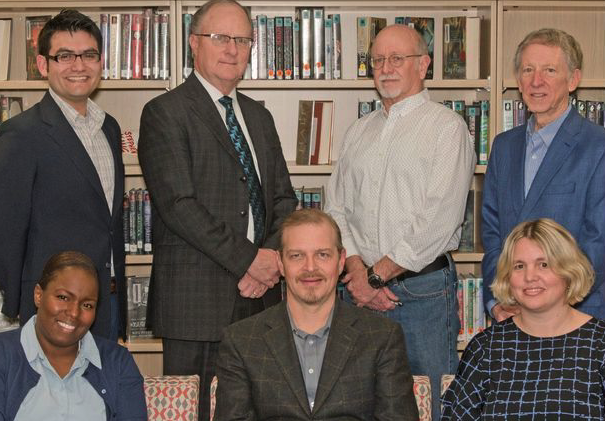
Whitewater Unified School District Board of Education members include Miguel Aranda, back row, from left; Larry Kachel; Casey Judd; Steven Ryan; followed by Maryann Zimmerman, front row, from left; Thayer Coburn and Jennifer Kienbaum. Board members whose seats come due in April 2023 include Ryan, Judd and Coburn. Ryan and Judd, as of Dec. 19, have filed notification of non-candidacy forms with the district.
School board candidates serve at large and for three-year terms.

Whitewater: Interim leadership team installed at Bethel House
(Originally published Dec. 22, 2022.)
Bethel House, Whitewater, has announced the installation of an interim management team, according to information released by the organization.
The new team includes Megan Hartwick, who formerly served as the executive director of the United Way of Jefferson and North Walworth Counties, and Nicolle Muskevitsch, who is a licensed social worker.
In their interim capacities, Hartwick will serve as executive director and Muskevitsch will handle client case management responsibilities, the release stated.
“Maintaining the stability of our organization and services is of utmost importance to our board of directors. Our entire board has full confidence in the skills and abilities of Megan and Nicolle to assist and support the great work of our existing Bethel House team,” Bethel House Board of Directors Chairperson Jessie Dugan was quoted as saying in the release.
According to the release, Bethel House staff, including Nonprofit Support Coordinator Becca Cohen and Bilingual Case Manager John Roherty will be working with the interim team to ensure continuity of services and operations.
During the interim period, efforts to fill the permanent full-time executive director’s position will be underway, the release noted.
Within the release, Hartwick said: “I am honored to have been asked to join the Bethel House team and support the incredibly life-changing work they provide for families facing homelessness in the Whitewater area. Becca and John have done such a tremendous job leading the organization during this transitional time, and I look forward to providing them the support and relief they need to ensure Bethel House can continue to serve those in need as effectively as possible.”
According to the release, in September, Kristy Weinberg, then-Bethel House executive director, stepped down from her position to pursue new opportunities with The Salvation Army.
Dugan described Weinberg as “an invaluable leader,” who supported the organization for more than 13 years.
Weinberg will continue to support Bethel House, serving in an ex-officio capacity with the board of directors, the release noted.
Hartwick said she has previously worked with Weinberg “in another capacity for the past eight years.”
She described her predecessor as leaving her big shoes to fill, adding that “having her as a resource on the board will only further ensure the success of Bethel House, should provide comfort to the organization’s donors and supporters, and will aid in the process of filling the full-time role in 2023.”
About Bethel House
According to the release, Bethel House is an ecumenical project helping families facing homelessness in the Whitewater area. Bethel House provides transitional housing, emergency financial assistance, and case management to families in need. Bethel House utilizes seven private housing units where families can live for up to one year while working on the issues that led to their homelessness. Case management services include budgeting, debt repayment, job searching, resume creation and building, life skills and decision-making, and accessing other community resources and services.
To learn more about Bethel House and its programming, visit: www.bethelhouseinc.org.

Megan Hartwick
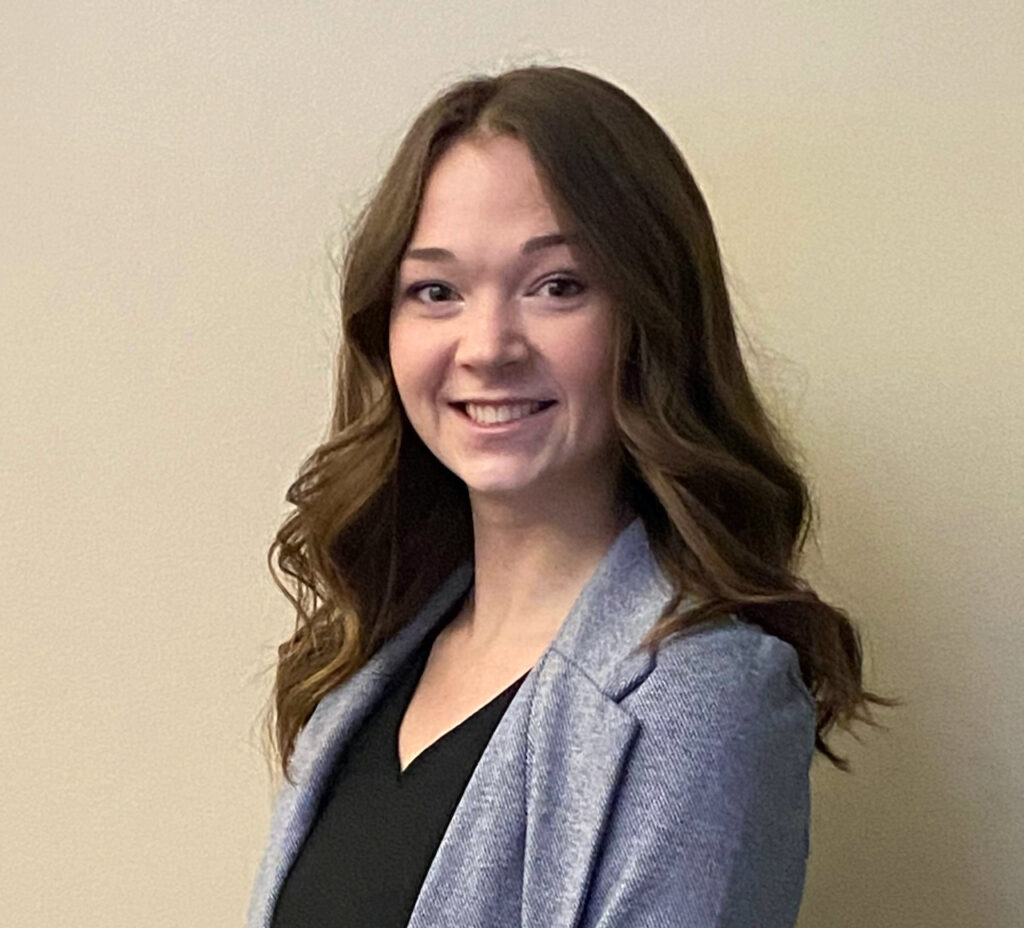
Nicolle Muskevitsch
Whitewater: With non-candidacy declaration deadline looming, school board incumbent offers ‘no comment’ about spring election run
(Originally published Dec. 23, 2022.)
By Kim McDarison
Whitewater Unified School District Board of Education incumbent Thayer Coburn, updating Fort Atkinson Online through email Friday, said he has not filed notification of non-candidacy with the district.
While he acknowledged Friday’s 5 p.m. deadline to file a declaration of non-candidacy, he also pointed to a deadline for candidates, including incumbents, to declare candidacy, which is Jan. 3, at 5 p.m.
When asked if he planned to run for reelection, Coburn said: “I have no comment at this time.”
Two other incumbents, Casey Judd and Steven Ryan, have each filed notifications of non-candidacy, according to information earlier released by school district officials.
As of Friday, one challenger, Stephanie Hicks, has been reported to have submitted the required forms for inclusion on the April, 2023 ballot.
Candidates interested in running for one of three seats on the school board which will come due in April 2023, may file ballot access documents. A deadline to file documents for ballot access is Tuesday, Jan. 3, at the school district office.
Those interested in running for the seats are required to fill out and submit a Declaration of Candidacy School Board Candidates form (EL-162sd) and a Campaign Finance Registration Statement form (CF-1).
A “checklist,” including links to the required forms, as supplied by the district is here: https://docs.google.com/document/d/1cL7yB4VtwP-VjmtxXEb0Yas-TKNyCzh6aXGoPVtV03o/edit.
Both forms must be completed and returned to the district’s administrative office by 5 p.m. on Tuesday, Jan. 3, 2023.
Collection of signatures and nomination papers are not required by the school district, officials have said.
The district office is located at 419 S. Elizabeth St., Whitewater.
Those looking for additional information about forms and the submittal process can contact Jaclyn Tueting, school board secretary, by phone: 262-472-8702 or email: jtueting@wwusd.org.
A link to the Wisconsin Association of School Boards (WASB) Guide for Candidates 2023 Spring Election Edition is here: https://wasb.org/wp-content/uploads/2019/10/Guide_for_Candidates.pdf.
Additional resources provided to candidates by the WASB are here: https://wasb.org/legal-human-resources-services/school-board-elections-resources/.
A primary election becomes necessary when more than six candidates come forward for the three open at-large seats.
If a primary election becomes necessary, it will be held on Feb. 21, 2023.
Information provided on the school district’s website is here: https://www.wwusd.org/page/school-board-election.
Information provided by the Wisconsin Elections Commission for candidates is here: https://elections.wi.gov/candidates.
Whitewater: City commits $3 million towards $5 million library renovation project
(Originally published Dec. 24, 2021.)
By Kim McDarison
The City of Whitewater Common Council approved Tuesday funding $3 million of a $5 million library expansion and renovation project.
The council approved a resolution which stated that the city will make a $3 million contribution to the project once the city’s library board can show it has obtained funding for the remaining $2 million, which, the library board stated, includes fundraising for a portion of the monies needed.
Monies to fulfill the city’s contribution would be included in the city’s 2024 budget.
The measured was approved by a 6-1 vote with Councilman Jim Allen casting the ‘no’ vote.
During the meeting, council heard a presentation given my library board member Jim Winship and Library Director Stacey Lunsford.
Addressing members of council, Winship said the project proposed by the library board was more of a renovation than an expansion.
The proposed addition to the building would add some 7,000 square feet.
In the existing portion of the building, he said, the restrooms and the checkout desk would be the same, but everything else would be different.
The new building would feature increased meeting room space, increased Makerspace space, more space for teens and upgrades allowing for the use of better technology.
“Updating the library is just another selling point when enticing families to come to Whitewater,” Winship said, adding: “We can afford to make this investment.
“I think this is especially important now, because we are in a community where close to half the students get free or reduced lunches, and the impact of the pandemic will still be going on for many, many years when this library opens.”
Looking at the $2 million commitment to the project which would need to come from the library board, Winship said: “The library has, one way or another, about $1 million in assets. We would fundraise for the other one.”
Lunsford next addressed the council sharing highlights of the plan.
Aided by slides, Lunsford presented a graphic showing the library’s current footprint. The graphic included the library, its parking lot and some properties, Lunsford said the library board had acquired to the east.
Looking at the library building, she said, a small area extending from the west side of the building delineated the current “Community Room.”
“That’s the part that’s going to be expanded,” she said.
Said Lunsford: “We are going to demolish the current lobby and Community Room and we are going to build an addition on the west side. So there will be an expanded lobby; there’s going to be several meeting rooms of various sizes that are going to be flexible in their sizing — they can be made smaller, they can be made larger, they can open up into the lobby for venues that require extra space. So we are making it very flexible.”
Plans also call for a walkway along the building’s west side which could be used for additional programming, she said.
Looking at the existing building, she said, plans for renovations include moving the adult section closer to the current library entrance and moving the early learning section into the building’s southeast corner.
“We are going to be adding a children’s restroom there, a nursing mother’s room there, (and) there’s going to be a new small office space for the youth educational services librarian,” Lunsford said, adding that the area used for the library’s Makerspace program will be renovated into a children’s story time room.
With the expanded building, Lunsford said, “we need to have expanded restrooms; you need to have so many stalls per square foot.”
Within the one-story addition visitors to the library will find a new social reading and discover area.
Space within in new addition will accommodate the free pantry, and spaces where people can sit, use wifi, read, socialize, all outside the library proper, Lunsford said.
“A lot of times people want to talk, they want to chat, and then other people want quiet. So this offers us the opportunity to do that, which we don’t have right now. It’s hard to get a quiet corner in the current library,” she said.
Addressing costs associated with the project, Lunsford noted that construction costs for the addition are estimated at $1.7 million. The remaining costs of the project are for the renovations to the existing building, and costs associated with the architectural and design team.
Citing a need for renovations, Lunsford said the library building is 30 years old.
“It is not a very modern building as far as the ability to have technology and those things in it. We need to replace the lighting. The lighting is very bad. The carpet needs to be replaced. We have a lot of bubbling and tears there. We need to have more electrical outlets. We need to have more places for people to plug in their devices. That’s extremely important to people. What we have right now are some outlets that sit up off the floor; they are a tripping hazard, but it is the best we can offer.”
Discussion about financing
Councilwoman Carol McCormick expressed concern with rising construction costs. She asked: “This is going to be through 2024? How are you going to compensate for the cost of construction over the next two years? We are committing $3 million. Would you be able to cover that gap should it increase?
Lunsford responded: “I don’t have a crystal ball so I can’t really answer that with any confidence. I like to have facts when I say things. We understand that asking for this commitment — that we have to come up with the rest of the money first. And so we will be looking at that and I would assume that we would be adjusting our capital campaign as we saw things going up.”
Offering encouragement, Lunsford said she and library board members had learned, after having conversations with other library boards which had engaged in capital campaigning, that they had exceeded their fundraising goals.
Whitewater Director of Finance and Administration Steve Hatton also offered some financial information, looking to answer the question, he said: “How does this fit into our CIP and our financial plans?”
Sharing several slides from the city’s November budget process, Hatton said the city, along with its biennial budget and Capital Improvement Plan (CIP) had created a “10 Year Horizon,” which, he said, aimed to predict and plan for the city’s capital needs within a 10-year window.
Within those documents, he said, the city had identified resources for the library renovation project.
Among dollars earmarked, he said, was $250,000 of spending from within the fund balance in the 2023 budget, and, he said, the library board has roughly $1 million in funding that would be coming from assets held and controlled by the board.
Hatton said those dollars were among the first that could be spent to pay for design and other early project costs. Construction, he said, would likely take place in 2024 or 2025, at which time the council would need to approve its contribution coming from that budget cycle.
Looking more specifically at funding sources, Hatton said, “I can see a bond issuance in 2024 for $3 million.”
Additionally, he pointed to $1 million in fundraising, $500,000 of cash or fund balance from the library board, which, he said represents the real estate the library board holds, and some funds held by the library board in its fund 220, which, he said, the board intends to commit to the project.
Looking at revenue forecasts, he said: “We’ve been very conservative with property values, so we show a return on TID 4 that comes back into the tax base, and then the growth of the property values …so we don’t want to paint a rosy picture … we’ve been very conservative with estimates for the tax base.”
The forecast and the 10-year CIP horizon include plans for several city projects, he said.
Looking at a potential for borrowing, Hatton pointed to a chart showing state imposed limits on the city’s borrowing capacity. The council, he said, has a policy whereby the city may not borrow more than 70% of the state imposed limit. The chart showed that the city’s current level of borrowing was within the 50- to 55% range over the full 10-year horizon.
Discussion
During discussion, Councilman Lukas Schreiber said he was in favor of the project and saw a need for the library to keep up with “changing times and the need for upgraded technology, especially.”
Said Allen: “I think we are all in favor of the expansion of the library. I think the library needs changes, certainly technology needs to change, and maybe the lighting needs to be changed … The problem I have is $3.3 million for remodeling … that seems a little outlandish to me.
“We’ve got $1 million set aside for a water tower, a million and a half for the lakes drawdown, a million-plus for a lift station, $10 million projected for the city garage, $2 million projected for police property garage, and another $5 million for the library, that’s twenty and a half million dollars.
“You have to scale things back. This doesn’t even include the fire and rescue referendum; we already know we are going to have to go to referendum because we are going to have to ask the taxpayer to pay more, an increase, on their taxes, than the state allows us to give …
“I can’t support this as it is,” Allen concluded.
Allen proposed making changes to language within the resolution whereby the city would be committed to the project “up to $2 million.”
With no second offered by other council members the motion failed.
Council members discussed changes that had been made to the resolution as it was presented Tuesday by city attorney Wally McDonnell.
New language stipulates that the library board must raise its portion of the funding required before the city will take action to approve the $3 million committed.
“My feeling is if people are telling us they want this, and the library board can have them put their money where their mouth is, then we should support this and say, put your money where your mouth is, and see what happens. If it doesn’t happen, we don’t have to do this,” said Councilwoman Brienne Brown.
For more information on the library renovation project, visit the city’s websote: https://whitewater-wi.gov/CivicAlerts.aspx?AID=341.
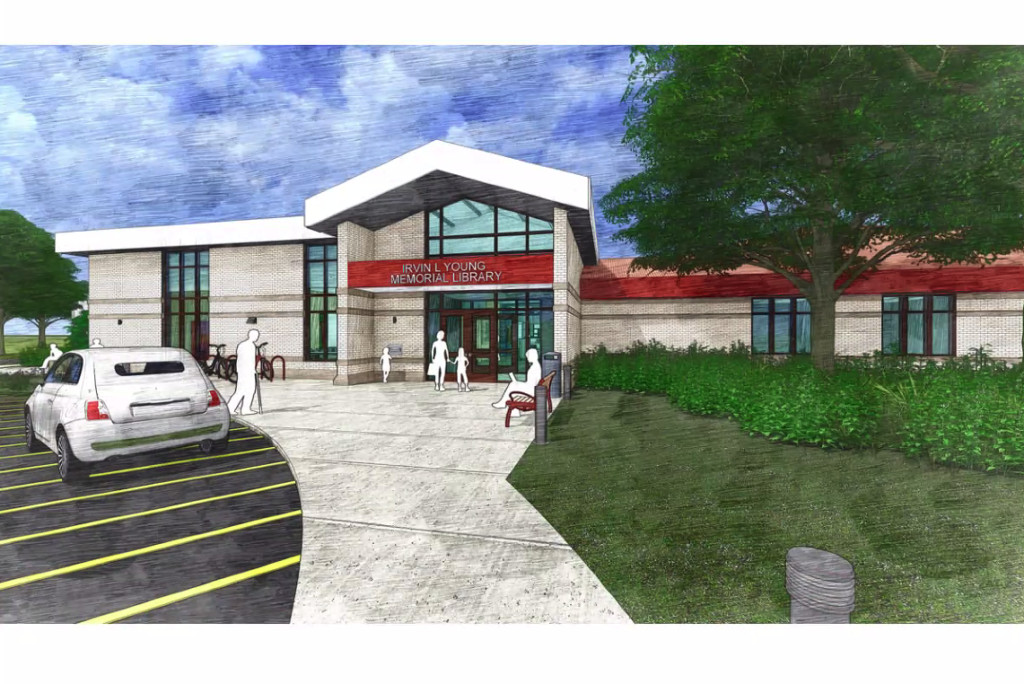
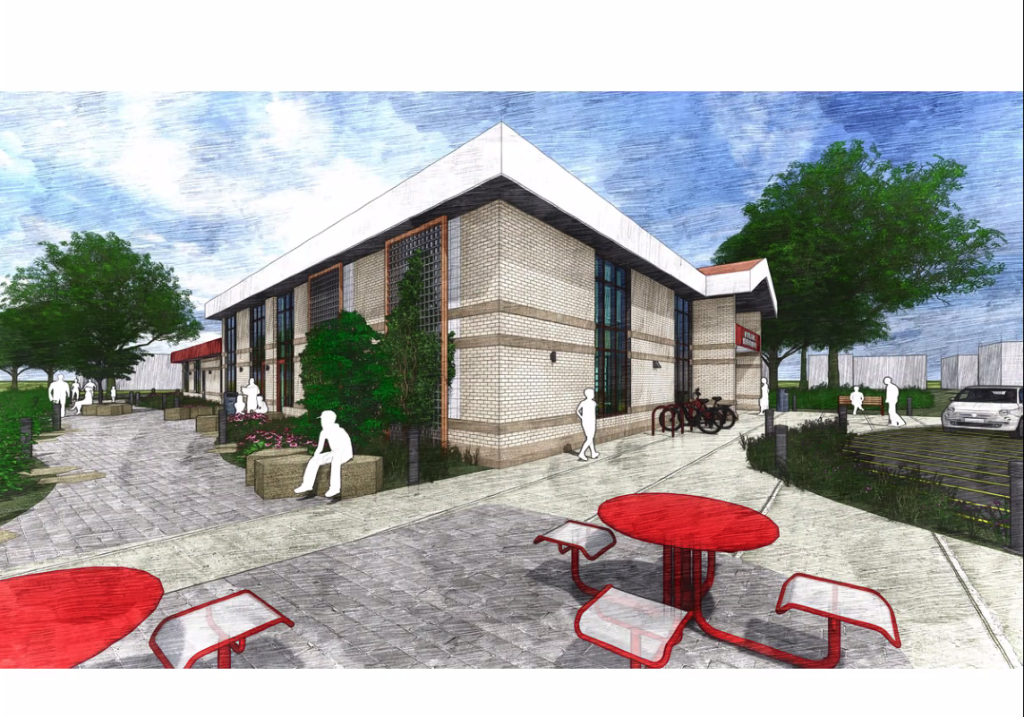
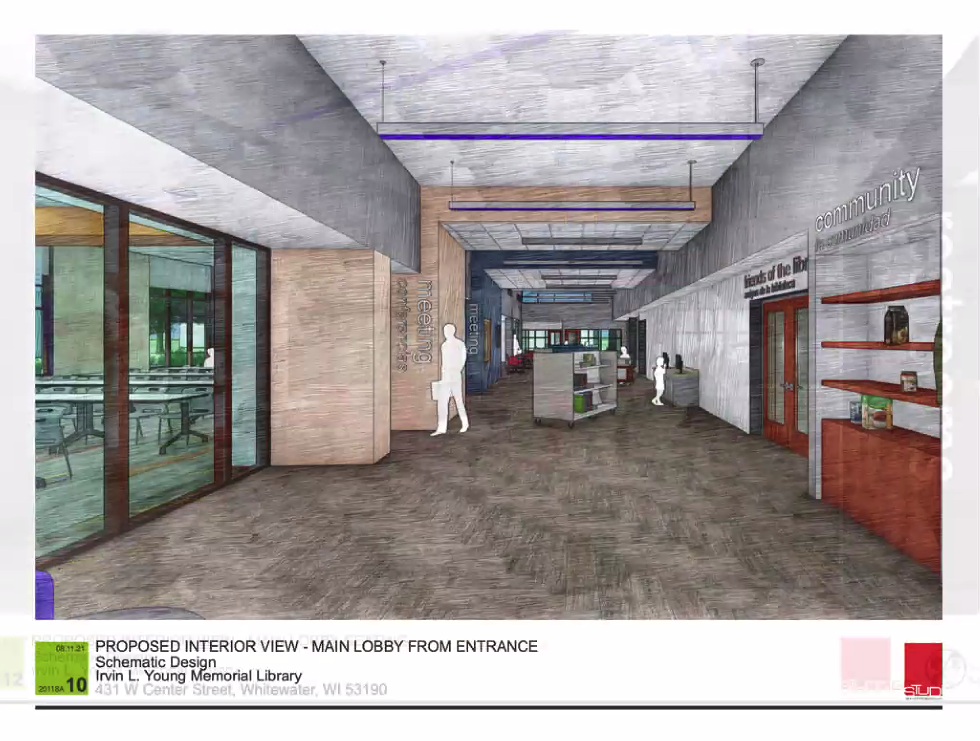
Three graphics above show an artist’s rendition of how the interior and exterior of a renovated and expanded Irvin L. Young Memorial library might look.

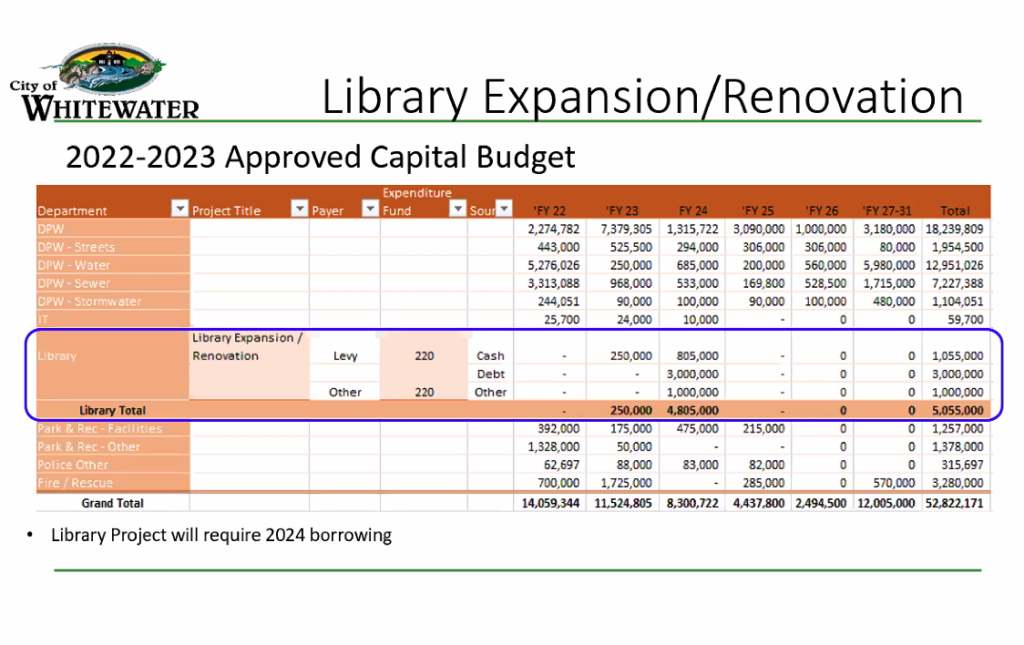

Three graphics above show the budgetary plans and 10-year horizon capital improvement forecasts made by the City of Whitewater. The slides were shared by Whitewater Finance Director Steve Hatton during Tuesday’s council meeting.

Looking at a potential for borrowing, Finance Director Steve Hatton points to a chart showing state imposed limits on the city’s borrowing capacity, indicated by the orange line. The council, Hatton said Tuesday, has a policy whereby the city may not borrow more than 70% of the state imposed limit, shown by the blue line. The chart showed that the city’s current level of borrowing was within the 50- to 55% range up until 2026, indicated by the gray bars.
Whitewater: City to hire consultant to develop CDA director job description, parameters
(Originally published Dec. 26, 2022.)
By Kim McDarison
The Whitewater Common Council learned Tuesday that city staff will be moving forward with a proposal to hire an outside consultant to help develop a job description, chain of authority and additional parameters associated with the city’s CDA/economic development director position.
Plans call for a consultant to assist the city for 90 days with the development of a job description for a CDA director, identify to whom the position will report, and outline a search process to be used by the city to fill the position. The work will be performed at a cost of approximately $22,500, City Manager John Weidl told members of the CDA during a meeting held Dec. 15 and the council during its most recent meeting.
Funds earmarked to pay the wages of an economic development director will be used to pay for the consultant, Weidl told both the council and CDA during separate meetings, calling the expense “budget-neutral.”
The proposal, which was initially presented by Weidl to council on Dec. 6, outlined a potential for 180 days of work, and included additional components such as a market strategies report and business recruitment and expansion platform, to be used by the city and CDA.
After discussion on Dec. 6 with council members and a member of the public, who identified himself as a former CDA board member, council asked Weidl to bring the discussion to an upcoming CDA meeting, and then return at a later time to allow council an opportunity to conduct a followup discussion.
Weidl introduced the proposal to members of the CDA during its meeting held Dec. 15.
Within a memo to council introduced on Dec. 6, Weidl noted that he had reviewed historical files, city ordinances and resolutions pertaining to the CDA board’s authority, and a description of the economic development director’s job. He also had spoken with stakeholders and attended CDA meetings.
After completing his research, he wrote that, relative to the position, the oversight and job duties developed to serve both the CDA and the city were “murky at best.”
According to city documentation, the position of CDA/economic development director has been vacant since interim director Nathan Theil left the position in August. A permanent director left the CDA in May.
During the council’s Dec. 6 meeting, Weidl proposed hiring an economic development professional for 90 to 180 days. The consultant’s role would be to offer the city guidance and a framework, which, he wrote, would be established before a search for a new permanent CDA/economic development director would begin.
He estimated a six-month cost for consulting services at approximately $45,000, which, he said, would be paid for using funds that would have been used to compensate an economic development director would the city have had one in place.
Also within his memo, Weidl noted that in order to fund the full six-month scope of the proposal, council approval of an expenditure of $20,000 was required. Citing city policy, he said council’s approval was required to expend more than $25,000.
Would council vote against the $20,000 expenditure, Weidl said he would reduce the cost associated with his proposal by removing expenditures associated with asking the consultant to develop a market strategies report and business recruitment and expansion platform.
An earlier story about the proposal and discussion held Dec. 6 is here: https://fortatkinsononline.com/whitewater-city-looks-to-hire-new-cda-director-job-description-policy-clarifications-discussed/.
CDA board discussion
Continuing the discussion on Dec. 15 with CDA board members, Weidl said that he was appearing before the board as instructed by city council.
Weidl told CDA board members that setting parameters for the CDA director’s job was within his “purview” as city manager, adding: “What I’m suggesting we do is we bring in someone to work with the CDA and the city council to very clearly outline the roles and responsibilities, the reporting structure.”
Weidl said the consultant also would help those involved — himself, the CDA and the city council — develop an interviewing process. He suggested the possibility of using an interviewing panel to find the next director.
“I want the process — as long as I’m here, searching for the CDA director — to follow a prescribed process and I want that position to have a very clear reporting structure. My single largest concern is it seems like we haven’t had that consistently, and it has contributed to some of the, I don’t know, tension? I don’t have a good word for it,” Weidl said.
CDA board member Jim Allen said the processes in place at the CDA “may have evolved over time a little bit.”
Weidl said a goal was to make sure both CDA and council members had an understanding of the roles and responsibilities of the CDA and the “scope of what each body is doing.”
Outlining his plan, he said that within the next 90 days, a consultant would guide the city to help it achieve its goals.
Weidl said that he wanted to call the new position CDA director. “Right now, it’s in the wage scale of economic development director,” he said.
“What is clear to me is this position is integral to the success of the CDA,” Weidl added, noting his desire to develop clear reporting authority and processes for day-to-day management.
“What I’m asking for is feedback to the idea that I’d like to bring in a consultant who has been an economic development director, served as a CDA director and now works in the consulting world, has been a director of WEDC (Wisconsin Economic Development Corporation), and on ICMA (International City/County Management Association), (and) very much has the technical skills to help us design a position and reporting structure for success, and also help us create a recruitment and selection process that we can repeat time and again, so as to remove any tensions and confusions,” he said.
Weidl said he had the funds and the funding authority to move forward with his plan. His purpose in attending the meeting was to gain feedback from CDA members, he said.
Responding to Weidl’s request for feedback, CDA president Patrick Singer said: “You indicated that there’s a lot of history — past ups and downs — and I know we’ve already started chipping away at getting that structure, because a lot of it was all up in somebody’s mind, or it was just tradition. So I think you’re spot on in terms of getting an expert in to help us structure this in an appropriate way that, from a policy decision, the council’s comfortable with, the CDA is comfortable with, you are comfortable with as the executive. I think that makes a lot of sense.”
Joining the meeting remotely, CDA board member Joe Kromholz said: “I think just the long and short of it is, yeah, let’s do this.”
Kromholz said he had been a board member for “a few months,” recalling that his first meeting was one where the economic development director was “fired, or whatever, but the bottom line is we need a defined structure however that works, that’s great. Once we get a defined structure, we make it go forward. That’s all there is to it.”
City records indicate that the former permanent CDA/economic development director resigned.
CDA board member Jason Gleason said: “I love the thought of bringing in somebody to help us define what we need versus what everybody is doing. I think that will be very beneficial for us.”
Allen, addressing Weidl, said: “I think it will help you especially so that when we bring somebody new in, both sides know the reporting structure. And that’s where we had some personality conflicts in the past.”
Allen asked Weidl if he had chosen a consultant to perform the work.
Weidl said he was “inclined” toward hiring Madison-based Redevelopment Resources and its economic development professional Kristen Fish-Peterson.
He said he had received two proposals, but Fish-Peterson was a strong consideration based on years of experience, a familiarity with the region — he cited her former experience as the director of Watertown’s CDA — and recommendations coming from a staff member who had worked with her before.
He noted that former CDA board member, Jeff Knight, who spoke at the council’s Dec. 6 meeting, said he also had experience working with Fish-Peterson.
“Certainly her resume and her experience in economic development, both in and on economic development, and specifically with CDAs, that’s the other reason I’m reaching out to her is having served as an executive director and having worked to implement CDAs as they get invented, I think she brings a level of expertise we’re looking for to help guide us through this process,” Weidl said.
Arriving after the initial discussion and participating remotely, CDA board member Jon Kachel asked if the money to pay for a consultant would be coming from CDA or city funds.
Whitewater Finance Director Steve Hatton said the consultant would be paid using funds that had not been paid out as wages while the position is vacant. The funds would come from the city’s Fund 900, he said.
Responding to comments about funding, CDA board member Lisa Dawsey Smith said: “I think that there should be a distinction that, in 2022, the bulk of the salary for the CDA was reliant upon the general fund balance.”
Kachel cited a use of money coming from the city’s tax incremental financing district (TID) balances to supply Fund 900 with funding in the future.
Hatton said Fund 900, which is used to finance the CDA, will be reliant on transfers from the general fund through 2023.
Offering an overview of CDA funding, Hatton said funding for CDA operations has historically come through Fund 900, with those monies coming from the city’s general fund or TID increments.
“So to the extent that there is no TID increment, there’s fund balance and transfers from the general fund as available sources of revenue,” Hatton said. He noted that the city had recently reestablished its TIDs, calling them “next generation TIDs.”
As of the 2023 budget, Hatton said, the revenue generated by the new TIDs, across all TIDs, was about $110,000.
“Portions of that were earmarked for transfer into Fund 900. There are also TID expenses from establishing them — many of them still are in deficit until those establishment costs get recouped. But in terms of payment for the study, that would potentially, or the intent of that as I understand it, was to use the nonpayment of wages, the savings — the budgeted savings — from not having that wage expense, to redeploy those funds to bring in the study and create some disciplines and some input from an outside expert,” Hatton said.
Said Kachel: “The point I wanted to make was we always wanted the CDA director answerable to us and I know the city would always like that answerable to them.” He asked: “What’s the board feel like?”
Kromholz responded, saying: “Well I think that’s the whole point is to go through this process, listen, and then come up with and state positions at the end of that process.”
Said Allen: “As far as who the CDA director reports to, Jon, I think I understand where you’re coming from. In the past, it’s been the goals and objectives, and the vision to be given to the CDA director by the board, but the day-to-day operations are overseen by the city manager. But this report, if we are going to pay for this report, should include that. And you know, we could always change it a little bit if we need to, but let’s see where they go.”
Council discussion, revisited
During Tuesday’s meeting, Weidl returned with an update to council regarding the CDA director proposal.
He said: “I spoke with the CDA, they were unanimously supportive of going forward with bringing in a consultant to … guide us through the process of training for the roles and responsibilities in reporting structure and a selection process for the next CDA director.”
Additionally, Weidl said he had scaled back his original proposal as presented on Dec. 6, noting that a new cost associated with hiring the consultant would be $22,500.
“We are ready to go forward,” Weidl said. “I did as the council asked. I think the proposal is stronger for it, and certainly, now with the unanimous recommendation of the CDA, I’m very comfortable moving in the direction we are headed,” he said.

Whitewater Municipal Building, file photo/Kim McDarison.
The year in review: Top 10 headlines from 2022
(Originally published Dec. 28, 2022.)
Fort Atkinson Online has nearly completed its second year in publication. We began in February of 2021. We will celebrate the anniversary of our second full year in publication on Feb. 1, 2023.
To determine our list of the most read stories in 2022, we, once again, consulted the counters placed on our stories, looking specifically at the number of “reads” between Jan. 1 and Dec. 28.
A list of our top 10 most read stories in 2021 is here: https://fortatkinsononline.com/the-year-in-review-top-10-stories-from-2021/.
In 2022, here, in descending order, are our most read top 10 headlines:

1. “Fort resident charged with attempted sex assault of a child, possession of child pornography,” read 24,091 times.
Reported on March 10, the story was developed around a criminal complaint filed by the Fort Atkinson Police Department with the Jefferson County District Attorney’s office bringing 12 counts of alleged possession of child pornography against Donald Reynolds, a resident of Fort Atkinson. Evidence offered within the complaint was collected in June of 2021. At the time, Reynolds also was facing charges of attempted first-degree child sexual assault.
In December, Fort Atkinson Online ran the following headline: “Fort man found guilty of causing mental harm to a child.” The followup story reported that Reynolds had been found guilty of two counts of the charge of causing metal harm to a child and received a sentence of 10 years in prison for each count to be served concurrently. All charges reported in the March 10 story were dismissed by the court.
The full story developed from the criminal complaint filed in March is here: https://fortatkinsononline.com/fort-resident-charged-with-attempted-assault-of-a-child-possession-of-child-pornography/.
The story in which the two counts of causing metal harm to a child were reported, along with the defendant’s sentencing, is here: https://fortatkinsononline.com/fort-man-found-guilty-of-causing-mental-harm-to-a-child/.

2. “Woman dead after being struck by vehicle near Whitewater,” read 22,135 times.
In October, a woman was struck by a vehicle in Jefferson County just north of the city of Whitewater on County Trunk N. Maricela Del Camen Rivas Rivas, 30, of Nicaragua and living in Whitewater, was pronounced dead at an area hospital after succumbing to injuries sustained in the crash. She was married and the mother of a 5-year-old son. A GoFundMe account was opened to raise money to send her body back to Nicaragua.
The full story about the crash is here: https://fortatkinsononline.com/woman-dead-after-being-struck-by-vehicle-near-whitewater/.

3. “Linda Godfrey, who launched ‘Beast of Bray Road’ legend, has died at age 71,” read 16,752 times.
Reported on Nov. 29, the story, sharing news of the death of Linda Godfrey, who lived in Delavan and Janesville, was republished with permission from the online news site Walworth County Community News. The story was written by Dan Plutchak, a former editor of “The Week,” which featured news about Walworth County communities. Godfrey served as a reporter with the publication. She began writing stories about the legend of the Beast of Bray Road in the weekly newspaper in 1991. Bray Road is in Elkhorn. After she began writing about the legend, TV crews began arriving in Walworth County to interview Godfrey, which helped her launch a new career as an investigative researcher. In her new role, she authored more than 20 books, including novels, crime stories and cryptozoology, Plutchak wrote.
The full story is here: https://fortatkinsononline.com/linda-godfrey-who-launched-beast-of-bray-road-legend-has-died-at-age-71/.

4. “One dead, one injured in crash on Twinkling Star Road,” read 14,886 times.
A crash reported in May on Twinkling Star Road in the town of Koshkonong left one person dead and another critically injured. The two occupants were traveling in a vehicle headed northbound when it left the roadway and struck a tree. According to the Jefferson County Sheriff’s Office, both occupants of the vehicle were initially transported to an area hospital with critical injuries. The passenger in the vehicle was pronounced dead at the hospital.
The full story about the single-vehicle crash is here: https://fortatkinsononline.com/one-dead-one-injured-in-crash-on-twinkling-star-road/.
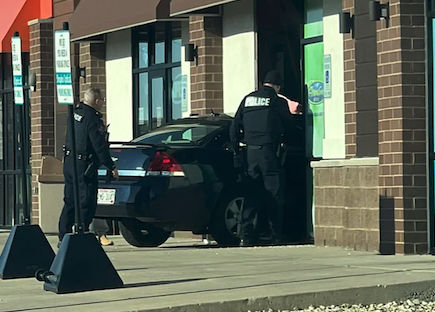
5. “Delavan woman, 92, drives into Madison Avenue building,” read 13,963 times.
Earlier this month, Fort Atkinson Police Chief Adrian Bump confirmed that a 92-year-old Delavan woman had mistaken the gas pedal in her car for the brake while trying to park in front of X-TremeSmoke. As a result, her vehicle accelerated, crashing into the smoke shop, which is located within a strip mall on the city’s north side. Bump reported that no one was injured during the incident, but, he said, there was structural damage to the smoke shop and “moderate” damage to the vehicle.
The full story about the incident is here: https://fortatkinsononline.com/delavan-woman-92-drives-into-madison-avenue-building/.
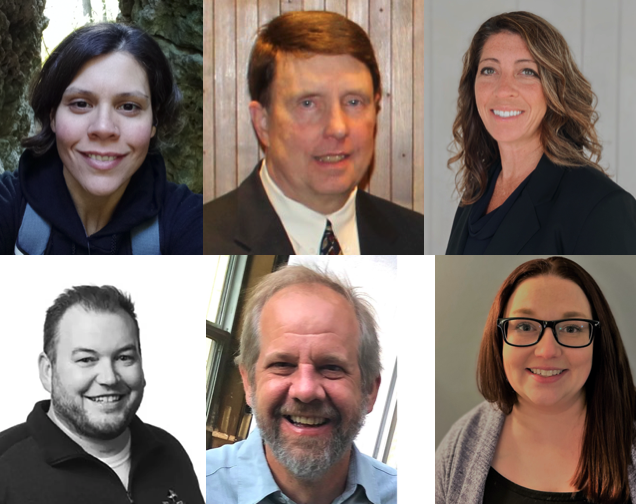
6. “February Primary Voter’s Guide: Fort school board candidates share experience, views,” read 13,087 times.
A spring primary election in 2022 was held Feb. 15. In advance of the primary, on Jan. 18, Fort Atkinson Online published responses made to questionnaires from six candidates running for two seats on the School District of Fort Atkinson Board of Education. Candidates headed into the primary included Samantha LaMuro, Matt Loup, Dale Prisk, Christopher Rogers, Robynn Selle, and Rebecca Van Ess. Those candidates advancing from the primary to the general election included LaMuro, Loup, Rogers and Selle. After a spring general election held April 5, Christopher Rogers and Robynn Selle emerged as the board’s new members.
The full story including the candidates’ questionnaire responses is here: https://fortatkinsononline.com/february-primary-voters-guide-fort-school-board-candidates-share-experience-views/.

7. Obituary for Luke Joseph Veenhuis, read 10,889 times.
The obituary of Luke Joseph Veenhuis, 30, formerly of Fort Atkinson, reported that he passed away unexpectedly from natural causes at his home on Monday, September 26, 2022. He graduated from Fort Atkinson High School in 2010, was an Eagle Scout, and attended the University of Wisconsin-Whitewater, where he earned both a bachelor’s and master’s degree in computer science. He was employed by Dartmouth College of Hanover, New Hampshire, as a computer research engineer, specializing in artificial intelligence.
His full obituary is here: https://fortatkinsononline.com/luke-joseph-veenhuis/.
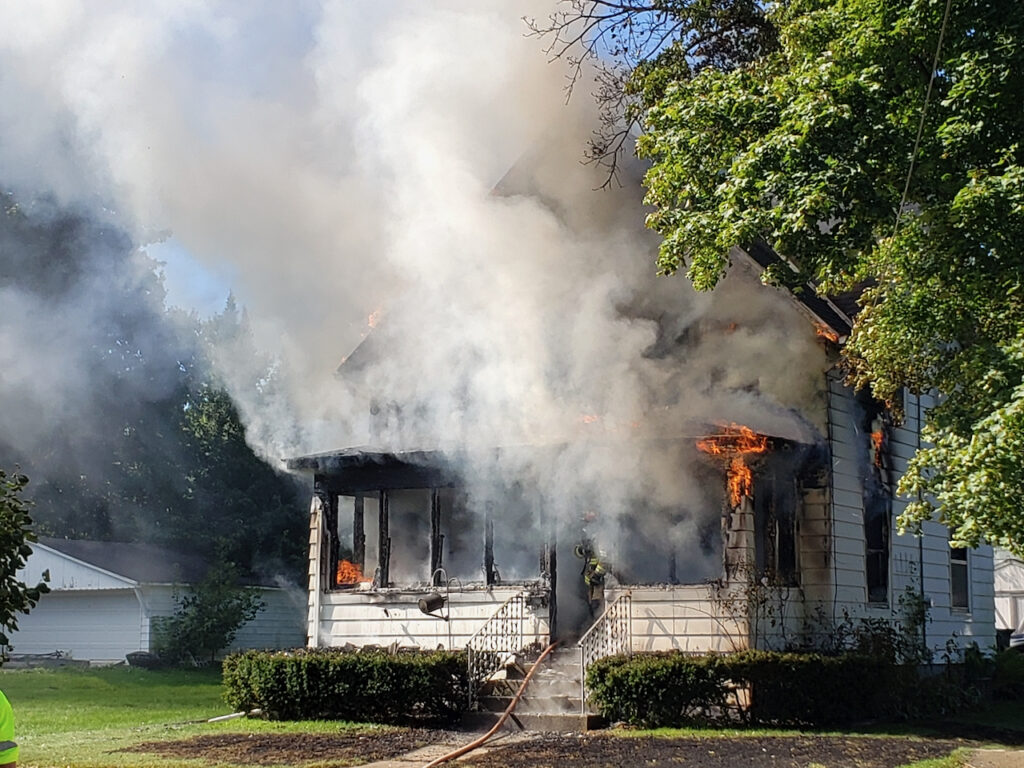
8. “Fort Fire Department responds to house fire,” read 9,139 times.
On Sept. 28, the Fort Atkinson Fire Department responded to a fire in the 400 block of Edward St. Upon arrival, firefighters found flames coming from the porch and the first and second floors of the home. Three residents were reportedly living in the house, but, according to Division Chief Dion Brown, only one was at home at the time of the fire. The individual was transported to Fort Atkinson Memorial Hospital to receive treatment for smoke inhalation. A cat was found deceased in the building, which Brown described as a total loss.
The full story about the fire is here: https://fortatkinsononline.com/fort-fire-department-responds-to-house-fire/.

9. “Crowd of 400 welcomes drag queen to Fort market stage,” read 8,924 times.
In June, some 400 people gathered at the Fort Atkinson Farmers Market to watch a performance given by Victorya Atwood, a drag queen. The performance came under some scrutiny and was briefly canceled, with organizers citing “some negative Facebook posts,” as reasons for concern. The farmers market organizers later said after talking with representatives from the Fort Atkinson Area Chamber of Commerce and the police, they opted to continue with the show. On the day of the performance, a Fort Atkinson Online reporter noted that the audience was “appreciative and supportive, with no problems observed.”
In the weeks that followed, some area organizations reported continued negative comments on their social media sites and, as reported by Fort Atkinson Online in June, 14 residents arrived at city hall during a Fort Atkinson Common Council meeting seeking a public apology from council for allowing the performance to occur.
The full story about the performance held at the Fort Atkinson Farmers Market is here: https://fortatkinsononline.com/crowd-of-400-welcomes-drag-queen-to-fort-market-stage/.
A story about the residents who arrived at city hall is here: https://fortatkinsononline.com/residents-bring-comments-to-council-regarding-recent-drag-queen-performance/.

10. “Jefferson County residents included in suit filed to disqualify Johnson, Fitzgerald, Tiffany from running in November,” read 8,469 times.
As reported in May by Fort Atkinson Online, 10 Wisconsin plaintiffs, including two from Jefferson County, filed a civil rights lawsuit in the United States District Court Eastern District of Wisconsin seeking a declaratory judgement to disqualify U.S. Sen. Ron Johnson, and U.S. Reps. Tom Tiffany and Scott Fitzgerald as candidates running for public office. All three are Republican seat holders whose terms end Jan. 3, 2023. In November, all three were reelected to another term.
Jefferson County residents Dan Russler and Leslie DeMuth were among the 10 plaintiffs naming Johnson, Fitzgerald and Tiffany as defendants in a complaint filed with the federal court on March 10.
The complaint alleged: “This action seeks a declaratory judgement … establishing that Senator Ron Johnson and Representatives Tom Tiffany and Scott Fitzgerald, having previously taken oaths as members of Congress and/or the Wisconsin Legislature, engaged in insurrection or rebellion against the United States of America during the period between November 8, 2020 and January 6, 2021 …”
The complaint further alleged: “Ten fraudulent electors from Wisconsin met at the State Capitol on December 14, 2020, the date designated by law, in a room procured for them by Fitzgerald, and committed multiple crimes by preparing and signing documents that falsely asserted that they were duly and lawfully chosen electors from Wisconsin whose votes were entitled to be tallied in the Joint Session on January 6, 2021. The fraudulent electors then compounded their illegal conduct by sending their forged electoral votes to (then-vice president Mike) Pence in his capacity as President of the Senate, without any reservation or condition stating the truth: that the fraudulent electors were not in fact duly and lawfully chosen pursuant to Wisconsin law.”
Additionally, the complaint alleged that “The falsehoods of Johnson, Fitzgerald, and Tiffany about the integrity of Wisconsin’s election procedures began even before citizens were allowed to cast their ballots in the 2020 Presidential Election and continued long after their lies were disproven.”
In June, Fort Atkinson Online ran a story with the following headline: “Judge finds suit against Johnson, Fitzgerald, Tiffany ‘procedurally improper.’” The story reports that the United States District Court Eastern District of Wisconsin granted a motion to dismiss the suit on procedural grounds.
The full story about the filing of the complaint is here: https://fortatkinsononline.com/jefferson-county-residents-included-in-suit-filed-to-disqualify-johnson-fitzgerald-tiffany-from-running-in-november/.
The story about the court’s decision to dismiss the suit is here: https://fortatkinsononline.com/judge-finds-suit-against-johnson-fitzgerald-tiffany-procedurally-improper/.
Whitewater: Council revisits 2020 housing study
(Originally published Dec. 29, 2022.)
By Kim McDarison
A Southeastern Wisconsin Regional Planning Commission (SEWRPC) housing study conducted in 2020 was revisited Tuesday, Dec. 20, during the Whitewater Common Council meeting.
The report, titled: “City of Whitewater TID (Tax Incremental Financing District) Extension Report: 2020,” was introduced by Neighborhood Services Director Chis Bennett and City Manager John Weidl.
Earlier in December, Weidl reminded council members that, through use of the state’s TID extension program, some $1.9 million will be made available to help alleviate issues surrounding a shortage of affordable housing within the city.
Information presented within the Dec. 20 meeting packet indicated that the SEWRPC “report sat dormant until John Weidl discovered the document among papers at his desk when he took over the city manager position. Weidl and Bennett worked with (SEWRPC interim Executive Director Ben) McKay to finish the report.”
The report was developed after the city approached SEWRPC in 2020 requesting assistance to determine how TID extensions could be used to support affordable housing within the city.
Addressing council from the podium, McKay offered a brief summary of the report and the process undertaken in 2020 to produce its findings.
What’s in the report?
According to the report, its purpose was to assist city officials “to discuss how TID extensions could be used to support affordable housing.”
The report includes information about tax incremental financing (TIF) legislation and housing needs identified by the city’s “housing affordability report,” and the city’s comprehensive plan.
TIF, TID, history and uses
Offering some history, the report noted that the state of Wisconsin adopted legislation supporting TIF in 1975 for the purpose of providing a method to communities to promote tax base expansion.
The report states: “TIF is aimed at eliminating blight, rehabilitating declining property values, and promoting industrial and mixed-use development. TIF is intended to spur development that would not otherwise occur by using increased property taxes from new real estate development to finance the cost of development.”
When the TID is formed, taxes collected against the property within the district are frozen, with that value called a “base.” Any increment generated above the base value is used to fund development projects within the TID.
While active, taxing jurisdictions that gain revenue from the property within the TID do not gain benefit in revenue above the base value until unit project costs are recovered and the TID is retired, at which point the increase in property value, the increment, is added back to the base and the taxing jurisdictions share the revenue from the increased property value, the report stated.
Additionally, the report noted that in 2009, TIF legislation was amended to allow municipalities to extend the life of a TID by one year after paying off the TID’s project costs.
“In that year, 75 percent of any tax revenue received from the value increment must be used to benefit affordable housing in the municipality and the remainder be used to improve the municipality’s housing stock.
“Whitewater (in 2020) has five active TIDs with base years ranging from 1990 to 2007.”
Additionally, the report identified two land use inventories: the first was regionally based and completed by SEWRPC in 2015, a second was conducted by Whitewater in 2016 as part of a 10-year update to the city’s comprehensive plan.
Land uses within the city
The report used data from the city’s inventory, pointing to various land uses, as identified in the comprehensive plan.
As stated in the report, city development comprises about 13% of the city’s total land and about 23% of developed land within the city.
The city has an average gross density of about three homes per acre.
Excluding dormitories, a combined total of about 11% of the city’s land is developed into two-family, townhouse, multifamily and mobile home residential property, with an average gross density of between 8 and 13 dwelling units per acre.
The report notes that some 8% of the city’s developed land is used commercially, a category which includes retail businesses and services, utilizing 14 acres within the Central Business District and 267 acres in other areas of the city.
Another 5% is identified as industrial and manufacturing development, found within the Business/Industrial Park on the city’s northeast side.
Within a category of “other development,” the report identifies churches, schools, and municipal facilities as occupying 5% or 265 acres within the city, and attributes 397 acres to the University of Wisconsin-Whitewater campus.
As of 2016, the report states that 41% of land within the city is used for agriculture and was undeveloped. Of the 41%, some 47% was unable to be developed because it is in a floodplain, is a wetland or has steep slopes.
An inventory of housing stock was compiled using 2013-2017 American Community Survey data from the U.S. Census Bureau.
Vacancy rates
The report identified the existing number — 5,145 total housing units in the city — as “a necessary baseline inventory item in determining existing housing demand and forecasting future housing demand in the city.” Some 30% of those units are owner-occupied and about 60% are renter-occupied. Another 10% are vacant, according to the report.
The report citied Whitewater as having a “higher renter-occupancy rate” than Walworth and Jefferson counties, the region and the state. It identified the student population living in the city as a likely reason for the statistic.
While the report notes a minimal loss of housing units within its data collection period, it also cites building permit data compiled annually by the Wisconsin Department of Administration, which, it states, indicates “a net gain in housing units every year during this time span.”
Regarding vacancy rates, according to standards set by the U.S. Department of Housing and Urban Development, the report states that the department recommends that an area have a minimum overall vacancy rate of 3% to ensure adequate housing choices, further noting that a recommended vacancy rate for homeowner housing is between 1 and 2%, and for rental housing, between 4 and 6%.
In Whitewater, at the time of the study, the overall vacancy rate was 10%, which, the report stated, was higher than rates in Walworth and Jefferson counties, and the region and state. The report pointed to seasonal and “other categories” of housing, which, it noted, added to the high overall rate.
Cost of housing
Looking at costs associated with housing, the report noted that the median value of an owner-occupied house in Whitewater was $164,000, which, it stated, was lower than the median value in Walworth and Jefferson counties, the region and the state. The city was identified as having a high percentage of owner-occupied homes falling within a range of between $100,000 and $200,000.
Looking at housing costs from the perspective of monthly expenditures, the report noted that the median mortgage payment in the city is $1,479, which is lower than payments made in Jefferson and Walworth counties, the region and the state.
The city has a high percentage of homeowners making monthly mortgage payments between $1,000 and $1,500, which, according to the report, “may indicate that moderate cost single-family housing is in demand.”
The report identifies $722 as a monthly cost for renters, with the city having “about double the percentage of renters paying less than $500 (per) month,” which it attributes to a large student population.
Under structure type, the report identifies multifamily housing, such as apartment buildings, as the most affordable in market-rate housing trends.
Within the city, about 36% of the housing units are single-family homes while 46% are found in multifamily buildings. Another 17% are found in duplexes.
Looking at the number of bedrooms within housing units within the city, the report notes that 37% have two, 26% have three, and 16% have one.
Relative to the age of existing housing stock, the report notes that about 56% was build after 1970. Another 22% was build between 1950 and 1970, and 22% were built before 1950.
Jobs and housing
The report cited workforce development — specifically, the creation of more jobs — as a goal of the city.
It stated: “Providing an adequate amount of workforce housing is a key consideration in meeting existing and forecast housing demand in the city.”
The report identifies the Low Income Housing Tax Credit (LIHTC) program as a primary source of government assistance for new subsidized housing units. It defines the program as one which offers incentives for developers to construct or rehabilitate affordable rental housing for low- and moderate-income households.
Developments operating through the program “typically reserve a number of units for households with incomes of about 60% of the county median income,” the report noted, adding that, as of 2020, there were three LIHTC developments in the city.
“The affordability requirements have lapsed on two developments and the third includes 40 affordable family housing units,” the report continued.
The report noted that a use of funds from the TID extensions in other Wisconsin communities has provided gap financing for LIHTC developments.
City demographics
Using statistics developed between 2013 and 2017, and information found within the city’s comprehensive plan, which, according to the report, relies on data developed between 2010 and 2014, the report offers details defining the city’s demographic characteristics.
According to the report, the city, which was incorporated in 1885, has a population of 14,762. Between 1950 and 1970, the report identifies a period when the city “grew rapidly,” followed by a “small decline,” between 1970 and 1980. There has been steady growth ever since. The report stated that Whitewater’s growth patterns are similar to those of Walworth and Jefferson counties, but, it added, between 1950 and 1970, Walworth County crew more rapidly. Since 1970, the region and state have shown growth at a “modest” rate, with the state growing “at a faster pace” than the region.
Citing the city’s land use provisions, which, the report notes, provides “significant opportunities for residential development,” and a “forecast” for “economic growth in the city,” the report states that there will be a “likely result in significant population growth in the coming decades.”
Looking at age distribution among the city’s residents, the report noted that 59% fall within the ages of 15 and 24, citing the University of Wisconsin-Whitewater as a contributor in creating the statistic. Of the city’s student population, according to census data developed in 2010, some 3,400 students live in the university’s dormitories. Others reside in off-campus units.
According to the report, which defines the city’s population of residents who are 65 and older as “small,” it “could grow” over time. The report offers growth projections, predicting that the population segment could grow from 12% to 21% within the region by 2050. The report suggests that multifamily housing, which offers less upkeep, may become beneficial to residents within the aging population segment.
Additionally, according to the report, federal and state fair housing laws require most multifamily housing units build after the early 1990s to include basic accessibility features for people with disabilities.
“The low vacancy rate for single-family housing suggest that there may already be a greater demand than supply for modest single-family housing in the city,” the report states.
Looking at ethnicity and race, about 82% of the city’s population is non-Hispanic white. Eighteen percent is described as “the minority share of the city’s population,” with the report further noting that Walworth and Jefferson counties each have a lower share of minority population than the city.
The study reports that there are 4,609 households in Whitewater, and that the city’s average household size has “generally been declining since the 1970s,” which, the study notes, mirrors trends within the region, state and nation. The report states that the average household size within the city is 2.36 people. The household size is smaller for renter-occupied housing, at 2.18 people, and larger for owner-occupied housing, at 2.72 people. Some 60% of households within the city are defined as “non-family,” which, the report attributes to the presence of UW-Whitewater.
There are some 100 nursing home residents and about 50 people residing in community-based residential facilities or adult homes in the city.
Employment and city residents
The report points to “historically low unemployment rates seen across the region, state and nation within the last few years,” noting that information presented within the earlier data collected places the state’s unemployment rate at 8.6%, which was slightly lower than the unemployment rate of 9.1% reported in 2000, which was included within the city’s comprehensive plan.
Some 66% of the city’s working-aged residents is participating in the labor force, the report noted, as compared to Walworth County, with 68%; Jefferson County, with 69%, and the region and state, each with 67%.
The report next draws attention to the types of employment found within the city, citing as among its most prevalent: sales and office work; production, transportation and material moving, and education, legal, community service, arts and media. The aforementioned occupations tend to have “moderate” wages, according to the report.
Additionally, the report notes, there is a “significant number” of workers in the food preparation and serving sector, which the report describes as “low wage.” The report suggests that for those workers, affordable housing “may be a concern,” and that “many of these residents may be UW-Whitewater students.”
The report cites household income as a determining factor in demand for housing, noting that Whitewater’s median annual household income is $31,827, which, it stated, is “significantly lower than the median income in Walworth County, reported at $58,401; Jefferson County, reported at $59,215; the region, reported at $57,926, and the state, reported at $56,759.
The low median income in Whitewater is “very likely skewed by college student households,” the report noted.
According to the report, 62% of households within the city have annual incomes below $45,000. The report cites a “cost of housing development analysis completed for (a) regional housing plan adopted by SEWRPC in 2013, which concluded that households with incomes below $45,000 “could benefit from multifamily housing.”
Still, the report noted, Whitewater “has a relatively high multifamily vacancy rate.”
Some 933 households in the city have incomes ranging between $45,000 and $75,000. The regional housing plan found that modest single-family homes on lots of 10,000 square feet or less could benefit those families.
Within the city, the study noted, some 4,000 people are experiencing poverty. The report suggested that the number was “skewed by UW-Whitewater students living off campus.”
Looking at “cost burden,” the report noted that a household is considered cost burdened when the monthly housing cost exceeds 30% of the gross household income. About 25% of the city’s households fall within the category, which, the report stated, is lower when compared to Walworth County households and higher when compared to Jefferson County, the region and the state.
“A number of Whitewater’s low-income households may benefit from housing assistance programs,” the report stated, defining eligible low-income households as those with incomes of 80% less than the median income within a particular county.
Future housing needs
Looking at Whitewater’s anticipated future housing needs, based on population and household projections, the report found that a significant amount of land used for agriculture or that is otherwise vacant is available for potential development, as well as opportunities within the city for redevelopment.
The study cites a projected population for the city by 2040 of 17,958, which would result in the addition of 1,356 households.
“This means there could be a demand for almost 1,400 more housing units in the city by 2040 if a 3% vacancy rate is included,” the report concluded.
Also among its conclusions, the report noted: “there is a significant amount of commercial and industrial development in the city, which may create a demand for workforce housing in the city.”
In addition, the report notes that LIHTC development “could be a source of future workforce housing in the city.”
TID extension recommendations
The report outlined the steps required by state statute to make use of the housing TID extension, which include: adopting a resolution to extend the life of the TID up to 12 months, and including specifications regarding how the municipality intends to improve its housing stock, and sending a copy of the resolution to be filed with the Wisconsin Department of Revenue as notification to the department that it must continue to allocate tax increments to the district.
The study noted that state law does not specify how the funds must be used in support of affordable housing, and allows funds to be used anywhere within the municipality. The report cited the following uses as examples: funding a new or existing housing trust fund; funding a new or existing down payment assistance program for low-income households; providing gap financing, using vehicles such as low interest or no interest loans, for affordable housing development, including gap financing for Low Income Housing Tax Credit projects; funding new or existing rehabilitation programs for low-income households or for landlords who own low-income properties; funding permanent supportive housing for families experiences homelessness, and using funds as matches for state or federal affordable housing grant programs.
Between 2010 and 2019, the TID extension was used to support affordable housing 52 times in Wisconsin.
The report cited examples of the extension used in Milwaukee, Racine, Wauwatosa, Madison, Fitchburg, Monona, La Crosse and Appleton.
In Whitewater, the report suggested the following TID extension uses:
• Existing housing programs: The report stated that “a number of city, state and federal housing programs that provide assistance to home owners and renters are identified in the city’s comprehensive plan.
• CDA housing loan: The report points to a program available through the city’s CDA which provides low- and moderate-income homeowners and landlords with loans to make repairs and improvements to residential properties. The loans, the report stated, are offered with zero percent interest to those who qualify.
• State and federal programs: Funds could be used to support a local match when required to participate in state and federal programs for low- and moderate-income residents in need of housing assistance.
• Land use element: A number of the residential development-related programs presented under the Land Use Element of the Comprehensive Plan could be supported through a TID extension program.
• Single-family residential program: The report points to the city’s ability to “consider retooling” the CDA Housing Loan Program, to focus on increasing rehabilitation and owner-occupancy in single-family residential and city neighborhoods to “broaden the pool of people eligible for the program.”
• Central neighborhood: The report points to programs which “recommend that the city work with developers and landlords to identify ways the city can help facilitate housing conversations, housing upgrades, and the development of new housing to meet the needs of students and renters.”
• Higher density residential: The report cites a program which “recommends that the city promote continued reinvestment in mobile home properties, including efforts to bring existing homes up to modern standards, replace existing homes with more modern manufactured homes, and provide and enhance onsite amenities.”
• Family/young professional housing: The recommendation suggests that monies could be used to support affordable, modest singly-family housing within the city, suggesting such homes could be built on smaller lots of 10,000 square feet or less.
• Student housing: The report states: “While additional off-campus housing for students may not be a critical need, improving the quality of existing off-campus student housing may be a critical need.”
• Aging population: Funds could be used to benefit the city’s lower-income aging population by supporting accessibility modifications as well as gap financing for senior LIHTC developments.
• Housing trust fund: The report notes that such funds are established to “provide a predictable, stable source of revenue reserved solely for addressing affordable housing needs.”
• Additional housing support: The report states: “In addition to the 75% of a TID extension increment that must be used to benefit affordable housing in the city, TIF legislation would allow the remaining 25% to be used to benefit the city’s housing more generally. This could allow the city to use TID extension funding to support a number of polices, programs, and neighborhood strategies identified in the comprehensive plan, as well as other neighborhood plans.”
2021 Jefferson County study finds housing shortage
As earlier reported by Fort Atkinson Online, A 91-page study analyzing the condition of housing inventory throughout Jefferson County was released in February of last year.
The study, which was commissioned by Jefferson County and conducted by the Fiscal and Economic Research Center (FERC) — an analytical branch operating from within the University of Wisconsin-Whitewater, and led by principal researcher Russell Kashian — looked at housing conditions across the county and within its municipalities, including Fort Atkinson and Whitewater.
Among its findings, the study concluded that the Jefferson County housing market “shows signs” of a shortage, with significant shortages within the area of “affordable housing.”
A link to a story about the study conducted by FERC is here: https://fortatkinsononline.com/2021-jefferson-county-study-finds-housing-shortage-in-county-and-fort/.
The full “City of Whitewater TID Extension Report: 2020” can be found within the Whitewater Common Council packet of Dec. 20. A link is here: https://whitewater-wi.gov/AgendaCenter/ViewFile/Agenda/_12202022-1626. The 45-page report begins on page 89 of the packet.

Whitewater Municipal Building, file photo/Kim McDarison.
Whitewater: School board incumbent Coburn announces April run
(Originally published Jan. 3, 2023.)
By Kim McDarison
Whitewater Unified School District Board of Education incumbent Thayer Coburn has filed a declaration of candidacy making clear his plans to run for reelection in April.
Coburn’s plans remained unclear after he missed a deadline to file a declaration of non-candidacy in December.
As earlier reported by Fort Atkinson Online, two other incumbents — Casey Judd and Steven Ryan — have each filed notifications of non-candidacy, according to information earlier released by school district officials, making clear their intentions to forego seeking another term.
To date, the district has reported one challenger, Stephanie Hicks, who also has submitted the required forms to be included on the April ballot.
Three seats will come due for reelection in April. A deadline to file a declaration of candidacy with the school district was Tuesday at 5 p.m.
Candidates coming forward after the deadline may seek election through the ballot write-in process.
School board members serve three-year terms.
Whitewater: No races anticipated for aldermanic seats
(Originally published Jan. 3, 2023.)
By Kim McDarison
Voters headed to the polls in April will find one candidate running for each of four seats due for reelection on the Whitewater Common Council.
Whitewater City Clerk Michele Smith earlier reported that two candidates would vie for an open Aldermanic District 1 seat held by incumbent Carol McCormick, who is not running for reelection.
After the close on Tuesday of the filing deadline for candidates to have their names appear on the April ballot, Smith reported that one candidate, Brian Schanen, had withdrawn from the race, citing as reason his purchase of a new home in Whitewater that is located outside of the Aldermanic District 1 boundary.
Schanen’s withdrawal leaves a single candidate, David Stone, 303 W. Ann St., running for the seat.
In Aldermanic District 3, incumbent Brienne Brown has filed the required paperwork and will run unopposed for reelection.
In Aldermanic District 5, newcomer Neil Hicks, 1254 Tower Hill Pass, will run unopposed for a seat held by incumbent Greg Majkrzak, who will not be seeking reelection.
Neil Hicks may be joined on the April ballot by his wife, Stephanie Hicks, who will be running for an at-large seat on the Whitewater Unified School District Board of Education.
In addition, voters will find incumbent Lisa Dawsey Smith’s name on the ballot. Smith will be running unopposed to retain her at-large seat.
Whitewater: 12 candidates to vie for three at-large school board seats
(Originally published Jan. 3, 2023.)
By Kim McDarison
Information released Tuesday by the Whitewater Unified School District indicates that 12 candidates will vie for three at-large seats on the district’s board of education which will be decided in April.
The field of 12 candidates will necessitate a primary election which will be held in February.
Voters will find the names of the top six vote-getters emerging from the primary placed on the April ballot.
The primary contenders are: Stephanie Hicks, Joseph A. Kromholz, Christy Linse, Michael Bergman, Chuck Mills, Daniel Dern, Lisa Huempfner, Will Dammeir, Brian Schanen, incumbent Thayer A. Coburn, John D. Truesdale, and Nathan Vander Pas.
The filing deadline for candidates to have their names included on the ballot was Tuesday, at 5 p.m.
Three candidates emerging victorious after the April election will be seated on April 24.
Candidates serve for three-year terms.
Two incumbents, Steve Ryan and Casey Judd, as earlier reported, filed declarations of non-candidacy in December.
Whitewater: Two vie for municipal judge’s seat
(Originally published Jan. 3, 2023.)
By Kim McDarison
Whitewater City Clerk Michele Smith has reported that voters will find the names of two candidates on the upcoming spring election ballot vying for the position of Whitewater municipal judge.
They are incumbent Patrick Taylor and challenger Art Coleman.
As earlier reported by Fort Atkinson Online, according to a Facebook page, Coleman, 403 S. Whiton St., ran as a write-in candidate for the position of Whitewater municipal judge in 2019.
Introducing himself in 2019 to voters, he wrote: “I have 20 years with the state of Wisconsin working for the Department of Corrections. I am a graduate of the University of Wisconsin-Whitewater. My family has strong roots here in Whitewater. I believe I will be an asset to the people and the city of Whitewater.”
On his linkedin.com profile, Taylor wrote: “For 37 years I have been dedicated to the law as a judge and previously as a litigator and trial attorney resulting in many hundreds of court appearances before state and federal judges. I have defended public entities, including cities, police and school districts, as well as individuals and companies in a wide range of matters. I am licensed to practice law in Wisconsin and California, and a member of the Walworth County Bar Association.
“As Whitewater Municipal Court Judge, I work with individuals of all ages, walks of life and circumstances, law enforcement and the community to fairly administer justice and reduce repeat offenders through judicious, impartial and thoughtful review, counseling and disposition of cases. A particular focus of mine is working with juveniles, their parents, and school administrators to identify causes of bad behavior and use all the tools at my disposal to modify this behavior.”
Whitewater: Police report open investigation following fatal gunshot wound
(Originally published Jan. 3, 2023.)
Update: As a matter of clarification, Police Chief Dan Meyer told Fort Atkinson Online that the incident on Sunday was identified by the caller reporting it as a suicide. The department is unable to make any confirmations until a death investigation is completed.
By Kim McDarison
The Whitewater Police Department responded Sunday to an incident involving a fatal gunshot wound.
According to Whitewater Police Chief Dan Meyer, police responded to an apartment within the 1000 block of West Main Street Sunday at approximately 2:19 p.m.
Citing an open investigation, Meyer, responding by email, said he could release few details at this time.
Meyer confirmed that a 40-year-old male Whitewater resident was found inside the apartment, and that he had succumbed to a “fatal injury due to a sustained gunshot wound.”
The victim was transported from the scene by Whitewater EMS to Fort Memorial Hospital, Meyer noted.
Meyer responded to questions about the particulars of the incident by saying he was “unable to comment at this time.”
He indicated that no one has been charged with a crime. The Whitewater Police Department is conducting the ongoing investigation, he said.

File photo/Kim McDarison
Whitewater: Presentation set to discuss area landmarks ‘at risk’
(Originally published Jan. 7, 2023.)
The public is invited to a presentation about local landmarks at risk, featuring four city-owned landmarks, including the Birge Fountain, Starin Park water tower, White Memorial Building, and Whitewater Effigy Mounds Preserve.
According to information released by the Irvin L. Young Memorial Library, during the presentation, members of the city’s Landmarks Commission will provide brief overviews and photos of all four landmarks, along with details concerning their deteriorated conditions and needs for repair and restoration.
The presentation will be held Tuesday, Jan. 24, at 6:30 p.m., in the community room in the Irvin L. Young Memorial Library, 431 W. Center St., Whitewater.
The program is free. Registration is not required, according to the release.
“Local landmarks not only enhance the visual and aesthetic character, diversity and distinctiveness of Whitewater, they are visible reminders that raise the community’s awareness and pride in its past. It is this ‘sense of place’ that encourages people to put down roots in a community. Landmarks also enhance the community’s attraction for residents, visitors, tourists and prospective residents, while stabilizing and increasing property values. They also encourage investment in economic development. These are some of the many reasons that we hope people will help the city safeguard our community’s history and cultural heritage,” Landmarks Commission member Kori Oberle was quoted as saying in the release.
For more information about the presentation, visit the library’s website at www.whitewaterlibrary.org or call 262-473-0530.

The Starin Park water tower protrudes above the treetops. It has been a prominent landmark in Whitewater since 1889. Recently decommissioned, plans for its preservation have become a topic of discussion among Whitewater City Council and Landmark Commission members. File photo/Kim McDarison.
Whitewater: Firefighters respond to John’s Disposal recycling center fire
(Originally published Jan. 9, 2023.)
Whitewater: Firefighters monitor hot spots after Sunday’s recycling plant fire
(Originally published Jan. 9, 2023.)
By Kim McDarison
City of Whitewater officials held a press briefing Monday with regard to a more than five alarm fire which broke out at a recycling center Sunday night.
According to information shared by Whitewater Assistant Fire Chief Joe Uselding during a nearly 17-minute news briefing, the Whitewater Fire and EMS Department responded to a report of smoke and flames emanating from a recycling building on a property owned by John’s Disposal, 107 County Highway U, Whitewater, at approximately 9:54 p.m.
The briefing was conducted by Uselding and Whitewater City Manager John Weidl, who used his opening remarks to thank “everyone who was a part of responding to the incident at John’s Disposal.”
Weidl described the fire as “very large,” noting that more than 30 agencies from the area and surrounding counties responded to the scene.
Weidl said Uselding was among firefighters responding to the incident.
Reading from a prepared statement, Uselding said that upon their arrival, firefighters found heavy smoke and flames coming from a sorting and recycling building.
Uselding said the fire was quickly upgraded to a five-alarm fire, later surpassing that status due to cold conditions, the size of the incident and the need for additional water.
“Crews set up multiple master streams to protect an adjacent building and other mobile equipment on site,” Uselding said, adding that firefighters were assisted by John’s Disposal employees who helped move equipment away from the compromised structure, allowing emergency crews more room to operate.
According to Uselding, the affected building was used to house sorting equipment for recycling and recycling product.
As of Monday, he said, “a significant amount of recycling materials continue to smolder … as crews remain on scene conducting overhaul and dousing hot spots.”
The assistant chief noted that there is no danger to the public and that the Wisconsin Department of Natural Resources continues to monitor water runoff from the incident. He said firefighting crews will continue to monitor the situation for the next few days.
The cause of the fire remains under investigation, he said.
Uselding estimated the value of the building and its contents as “likely in the millions of dollars.”
Responding to questions from reporters, Uselding said efforts to monitor hot spots developing at the scene would continue “potentially for a couple more days.”
He described the building that was involved in the fire as “structurally compromised,” and with a “partial collapse.”
“We cannot enter the building safely at this point to get to all the hot spots that are in it. At this point we’re just going to monitor it and respond as required to douse any hot spots,” Uselding said.
The assistant chief told reporters that there remained a large amount of recycling materials outside of the building.
“Some of the John’s Disposal staff are able to move product around to pools of water that remain on scene, however as the temperatures fluctuate, those pools of water may freeze, and may not be available for them to do that, so we may need to go back out there in order to douse any hot spots that come up through the product,” he said.
Uselding described the building damaged by fire as an approximately 20,000-square-foot, four-sided structure, which housed “quite a bit of equipment,” including such items as a conveyor unit and other sorting units.
Additionally, he said, “It is also on multiple levels, so, where we’re working with the recyclable materials, it’s on a lower level than where the building is, and it’s also at a little bit of a slope, moving up, so that also creates a little bit of an issue for us setting up equipment and getting around the various sides of the structure.”
Uselding estimated the size of the John’s Disposal property at approximately 15 acres. He described the building as residing on the southwest side of the property, noting that when firefighters arrived, a priority was to protect a second building, situated to the west of the burning structure.
Firefighters were successful in protecting that structure, he said, adding that some damage may have been sustained by nearby mobile units, such as trailers, describing damage to those units as likely heat-related.
While fighting the fire, Uselding described a process used to transport water.
“There is no water supply on the John’s Disposal property other than drinking water. So, we didn’t have the water that we required to fight that incident,” he said.
LS Power in Whitewater is situated to the west of the John’s Disposal property, he said, noting that firefighters were able to tap the adjacent property as a water source. Some 15 tenders were requested through mutual aid, Uselding said, adding: “They were running a water shuttle, basically circling the incident, dropping water. Engines would then draft that water and pump it up to the incident.”
Other issues confronting firefighters Sunday night included cold temperatures, which affected both people and equipment, he said.
“Plus the scope of the incident, and managing something that large, can be very, very difficult. It takes a lot of people, a lot of leadership involved, to make sure that we’re organizing it properly, and that we are making sure that crews are effectively released when they are no longer needed — not remaining on scene and waiting to be released. We want to get them back to their agencies as quickly as possible because they might have an incident as well, and if they are not there for that incident that also affects their response,” Uselding said.
He said the “bulk” of the fire was “knocked down” on Sunday by 2 or 3 a.m.
While smoke from the fire was a concern for firefighters, he said most of it moved north over land which he described as “a lot of empty farmland.”
Uselding reported that no one was injured during the event, adding that there were no workers at the plant when the fire broke out.
While a cause of the fire remains unknown, Uselding said: “We don’t have any inclination that it’s suspicious in nature.”
He stated that County Highway U opened to traffic Monday. The highway was closed during the incident to accommodate the equipment that was used to fight the fire and keep an open pathway so water could arrive at the scene.
In addition, he said, water used to fight the fire spilled on the roadway, causing slick spots. The Jefferson County Highway Department and the Whitewater Streets Department arrived at the scene to apply salt to the roadway.
Uselding said the owners of the property arrived at the scene “fairly quickly” after the incident began, and were able to assist firefighters by moving trucks and equipment away from the building.
“We have not heard anything as far as what their plans are right now to rebuild,” Uselding said.
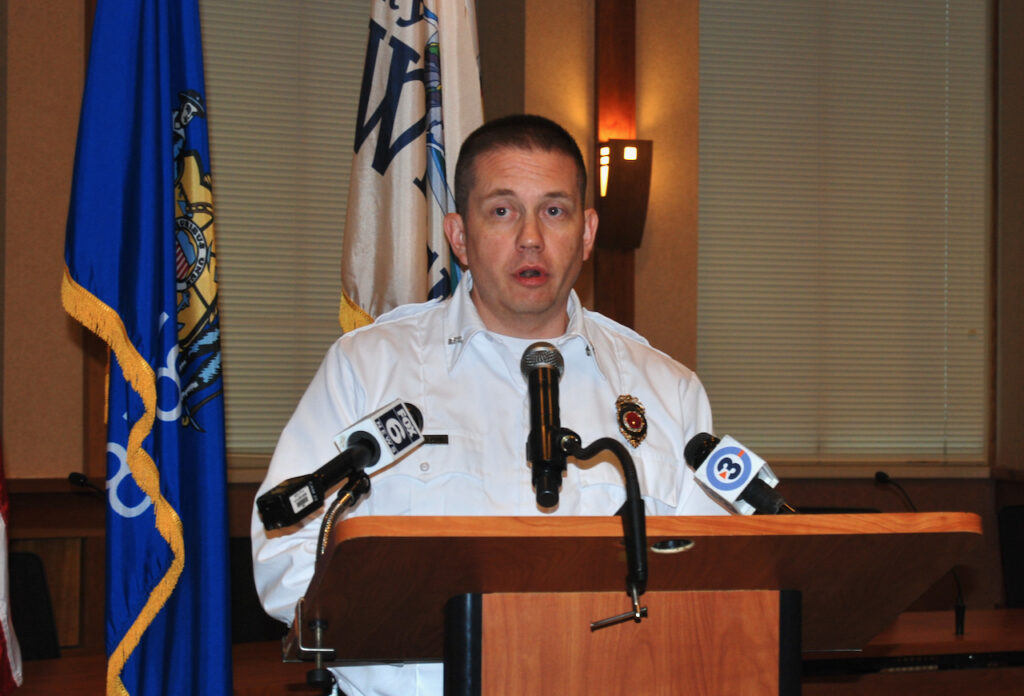
Whitewater Assistant Fire Chief Joe Uselding addresses several reporters Monday at the Whitewater Municipal Building. Kim McDarison photo.


Two photos above: Firefighters monitor on Monday the smoldering remnants after battling a more than five alarm blaze Sunday at the John’s Disposal property in Whitewater. More than 30 area agencies responded to the fire. Photos courtesy of Whitewater city staff.

A map, as shared by Whitewater officials during a news briefing held Monday afternoon, shows buildings on the John’s Disposal property situated along County Highway U, Whitewater. The building which was damaged by fire Sunday is indicated with a red dot. (Image produced through Google Maps.)
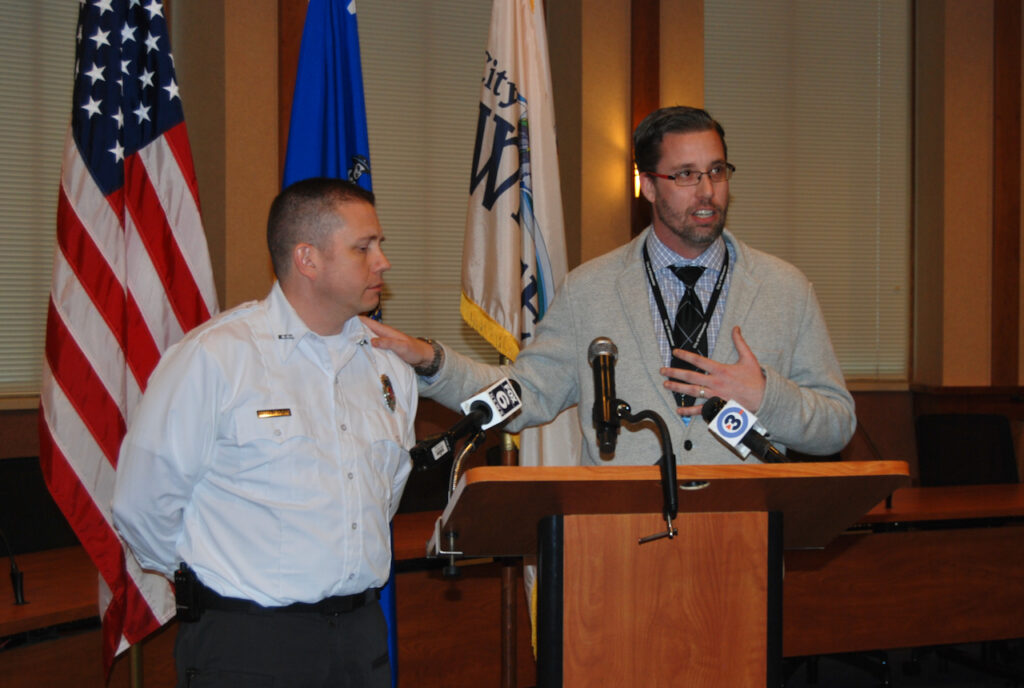
After offering thanks to those who responded to a fire Sunday at John’s Disposal, Whitewater City Manager John Weidl, at right, introduces Whitewater Assistant Fire Chief Joe Uselding during a news briefing held Monday at the Whitewater Municipal Building. Kim McDarison photo.
Whitewater: Co-op grocery reaches second of three-stage plan; location search underway
(Originally published Jan. 11, 2023.)
By Kim McDarison
Members of a group calling itself the Whitewater Grocery Co., or “GroCo,” say they have reached several milestones as they work toward bringing a co-op or “community-owned market” to Whitewater.
Seated Friday at the Irvin L. Young Memorial Library, Whitewater, three members of GroCo’s eight-member board of directors — Ron Binning, Steve Michaelson, and Brienne Diebolt-Brown, who also is a member of the Whitewater Common Council — offered a recap of the journey taken by the group since its inception in 2017 and plans as it moves forward.
In 2023, they are moving through the feasibility stage, the second of a three-stage process identified by the Food Co-op Initiative (FCI) — a Vermont-based, nonprofit group which, according to its website, “provides exceptional resources for people in the U.S. working to start a retail food co-op that meets the needs of their community.” The group offers some services to startups free of charge. The FCI’s three-stage process is outlined in its 104-page guide called “Starting a Food Co-op.”
The GroCo board has been following the guide and working with several consultants, Diebolt-Brown said Friday.
GroCo board members said they anticipate their efforts within the feasibility stage will cumulate in the identification of a location for a store in Whitewater sometime this year.
Additionally, board members said, this month, some 8,000 area households can expect to receive a survey questionnaire as part of an ongoing initiative to collect data within the feasibility stage.
A $46,300 grant received by GroCo from the Wisconsin Economic Development Corporation (WEDC) in March has been instrumental in funding ongoing work within the feasibility stage, Diebolt-Brown said.
What is GroCo?
Whitewater GroCo is a “for-profit,” organization with ownership held by its approximately 840 members.
Plans call for the company to bring a 7,500- to 12,000-square-foot, full-service grocery store to Whitewater.
According to Binning, the concept of bringing a co-op to Whitewater was initially discussed in 2016, after the Sentry Foods store operating in Whitewater closed.
The city has not had a store dedicated exclusively to the sale of groceries since, he said.
Michaelson acknowledged that the community does have a Walmart that sells groceries, but, he said, it is not a full-service grocery store.
Binning noted that the co-op concept became favorable with some community members after they came to the conclusion that a corporately owned grocery store was not making plans to open in Whitewater.
“We need a locally owned grocery store that offers fresh, healthy produce, locally sourced as much as possible, and other locally sourced foods,” Binning said, adding that, according to a definition offered by the United States Department of Agriculture (USDA), Whitewater is partially located in a food desert.
Binning said he believed the co-op would help alleviate that condition.
According to information supplied by the USDA, “some low-income communities in the United States lack stores that sell healthy and affordable food. The lack of store access in these communities —sometimes called food deserts — may contribute to poor diet, obesity, and other diet-related illness.”
Additionally, according to the USDA, a definition developed by the department, the U.S. Treasury and U.S. Department of Health and Human Services notes that low-income census tracts with a substantial number or share of residents with low levels of access to retail outlets selling healthy and affordable foods are defined as food deserts. A census tract is defined as a “small, relatively permanent subdivision of a county that usually contains between 1,000 and 8,000 people but generally averages around 4,000 people. Census tracts qualify as food deserts if they meet low-income and low-access thresholds.”
Within the definition, low income tracts are areas with a poverty rate of 20% or greater, or a median family income at or below 80% of the statewide or metropolitan area median family income. Low access is defined as occurring within populations of at least 500 persons and/or at least 33% of the population lives more than one mile from a supermarket or large grocery store — 10 miles, in the case of rural census tracts.
According to Diebolt-Brown, Whitewater has a low median family income.
Also, she said, people believe that a co-op store will only sell organic food and therefore be very expensive. She said the GroCo model does not embrace that concept. Instead, she said, plans call for a full range of price points within the store, offering affordability.
Affordability is further achieved when shoppers no longer need to drive to a different community to shop, with an added benefit achieved for shoppers who don’t have access to a car, she said.
Sharing some GroCo history, Binning said the group was organized by then-Whitewater business owner and founding member Lacey Reichwald, who organized some friends to discuss the absence of a dedicated grocery store within the city.
The group began with about 200 members, and grew quickly to more than 600, and then came COVID. In March of 2020, “membership almost came to a halt,” Binning said, adding that membership has since resumed a pattern of growth. Of the 840 members, he said: “Thirty-three of them are businesses from Whitewater and the surrounding area who are members and support our efforts to open our cooperative grocery store.”
Barriers for commercial grocery stores
“Most large commercial grocery stores are looking to locate in a community where the median family income is $65,000. In Whitewater, it is $37,000,” Diebolt-Brown said.
“Part of the reason large commercial retail grocery stores don’t do well is because they work on small margins. Stores only make 2-4% profit on groceries. When you have a low median family income, everybody is on a budget, and they will buy the cheapest things on the shelf,” she said, adding that when stores are only able to recoup the small margin on the cheapest items, their overall profit is small.
“For a grocery store that’s community-owned, that’s not a big deal, but for a corporation that has to pay shareholders, it is,” she said.
In addition, she said: “Many of their potential customers are now going to Amazon or Sams Club. So we don’t need a 60,000-square-foot grocery store.”
FCI stages
Within the FCI guidebook, three stages suggested to successfully bring a co-op store to a community are outlined.
The process begins with Stage 1: Organizing. According to the guide, “the organizing stage includes convening a core group, assessing common interests and needs, creating a shared vision, incorporation, building leadership and accountability systems, creating community excitement and support, committing money and time, coordinating initial market research and preliminary feasibility work, developing a membership program, launching a membership campaign, and researching Stage 1 target for membership.”
Stage 2: Feasibility and Planning, as outlined in the guide, comes with “two aspects.” The first aspect includes “in-depth assessment of market potential, financial feasibility, organizational commitment and capacity, and preliminary design feasibility.” The second aspect “begins once the probability of feasibility has been determined through a thorough assessment. Planning includes many components, including pro forma budgets, the formal business plan, capital campaign planning, initial contracts with external lenders, general manager search, and site selection.”
Stage 3: Implementation, according to the guide, comes with four aspects. They include: Pre-Construction, “which involves site and facility design, development bids — both construction and equipment — and financing — both internal and external”; Construction and Renovation, which “entails overseeing construction, equipment acquisition, building business relationships, developing merchandising plans and determining opening orders, store and production promotions and staffing plans”; Preparation for Opening, which “involves building organizational and operating capacity and implementing staffing, marketing, and membership plans,” and Sustaining Operations, which goes “beyond the store opening and the grand opening (and) includes preparing for the first year and beyond.”
Binning said that as the concept develops, store profits will be shared with members and used to expand the GroCo store.
Searching for a location for the store has been an ongoing endeavor, he said, citing COVID as among situations that contributed to slowing the pace of that progress. The hunt for a location is a top priority in 2023, he added.
As part of the feasibility stage, Diebolt-Brown said, GroCo has been looking at two or three locations for a store in Whitewater.
Last year, the organization looked at operating from a portion of the space within the former True Value building, she said, adding that after its recent purchase, new owners indicted that they had plans for the entire building.
Working with the CDA
Diebolt-Brown said some city officials within Whitewater have expressed an interest in helping the co-op develop.
“The city is very interested in helping us and the CDA (Community Development Authority) is interested in helping us buy land and utilizing land that the city already owns, and getting a developer,” she said.
Looking at the city’s broader plans to develop housing, she said a co-op grocery store could bring an added benefit to those neighborhoods and be included within a development plan.
She said statistics indicate that retail stores do well when they are included in shopping areas with grocery store options.
“Customers come to the grocery store for groceries and then shop for other things they might need nearby. They complete their list of errands while they are out,” she said, adding, that for that reason, the co-op would ideally be located in a development with other stores.
According to Diebolt-Brown, when customers leave Whitewater to do their grocery shopping elsewhere, they also tend to do their other shopping in that location.
“Nobody wants to go out for one thing. Right now, people go to Fort (Atkinson) or Janesville for groceries and then do their other shopping there, too, so the city loses those customers, too.”
Several members of the city’s CDA understand that dynamic, she said, adding, “the city is dedicated to helping to develop that ecosystem.”
Diebolt-Brown noted that before the co-op group formed, the city looked at bringing a large grocery store to town.
She cited a study performed by a contractor in 2016 which was presented to the CDA.
After receiving the study, she said, the CDA gave $10,000 to the GroCo group to help pay for its startup costs. Monies also were used to send GroCo representatives to an annual FCI convention which was held in Indiana.
Board members continue to attend the convention annually, Diebolt-Brown said.
Funding mechanisms
According to Diebolt-Brown, a potential for further support from the city exists as GroCo considers the option of buying land and developing a building. It is plausible, depending on where the land is located, that tax incremental financing money could be made available to help fund the project, she said.
The grocery store could be considered as a component of housing needs, she added.
Citing additional opportunities for funding, Diebolt-Brown said the USDA offers guaranteed loans that can be procured through local banks.
There is a potential to offer stock options and seek opportunities through low-interest loans, she said.
Before land options and development can be explored, she said, GroCo would need to organize a capital campaign.
Federal grants are available, she said, especially in areas that are considered food deserts.
Looking ahead
Looking at a timeline, she said: “If we could get a lease signed or buy land, theoretically we could be built in a year. But right now, supply chain issues make it right now about 18 months out.”
As they move forward, Diebolt-Brown said, the company is following a schedule and steps as developed by its consultant.
Aided by a grant from the WEDC, the co-op group has been able to move through the steps within the feasibility stage and begin a feasibility study with guidance from Seven Roots, a Vermont-based organization, which, according to its website, is “dedicated to co-ops and natural foods stores,” listing “design and operational support,” as among its services.
Diebolt-Brown said GroCo has been working with Seven Roots since June.
Michaelson said Seven Roots will be working with GroCo through the site selection process.
WEDC grant monies also have been used to cover costs associated with the group’s pro forma, which, Diebolt-Brown said, is a “very detailed” 20-year business plan.
GroCo also has employed the services of a second consultant, Minneapolis-based Columinate, which created a pro forma for the group six years ago and will continue its efforts through updates made to the plan.
The GroCo group is moving through a multi-step process to complete a feasibility study, the three board members said. WEDC procured funds will be used to offset those costs.
A feasibility study must be completed before a site for the store can be secured, Diebolt-Brown said.
In past years, GroCo has completed several proprietary market studies, which also have been updated, to help determine the needs and location of a site, she said.
Further, she said, with help from the University of Wisconsin-Whitewater, a community survey will be distributed to some 8,000 households this month to develop a better understanding of the community’s needs.
Also under development through the feasibility study is a rough design of a building and how it might match to a site, she said.
Once the feasibility stage is completed, Michaelson said, board members will turn their attention to a capital campaign, with a goal set at raising approximately $1 million.
The board members said they anticipated that a capital campaign could begin as early as June of this year.
Additionally, the three board members said, a goal of achieving a membership of 1,200 before the store opens has been identified.
Looking ahead to the opening of the store, Diebolt-Brown said: “A lot of people might have a misconception that the members will run the store. This will be a real business, with a CEO, and a manager. When we hire a manager, it will be someone who knows how to serve a small community, and the kind of volume we need to get up and running, and then that person will hire.
According to Binning, the group envisions that it will need at least six or seven full-time employees who will serve as store managers and department heads, and another 20 to 25 people who will serve as part-time employees.
As GroCo looks to develop its consumer market, the three board members said they are hoping to attract members and customers from a 25-mile radius surrounding Whitewater.
Anyone can shop at the co-op, the board members said. One does not need to be a co-op member.
The three board members said that when they begin sourcing local product to sell in the store, they hope to draw from a radius of 100 miles.
Noting that his father worked as a grocery store manager, Michaelson, a resident of Williams Bay, said: “I envision an old-fashioned store with customer service.”
For more information about GroCo, and becoming a member, visit: https://www.whitewatergrocery.co.
A link to the FCI website is here: https://fci.coop.
A link to the full FCI guidebook is here: https://fci.coop/the-fci-guide-to-starting-a-food-co-op/.
A link to the website of consulting company Seven Roots is here: https://www.sevenrootsgroup.com.
A link to the website of consulting company Columinate is here: https://columinate.coop/consultants/don-moffitt/.
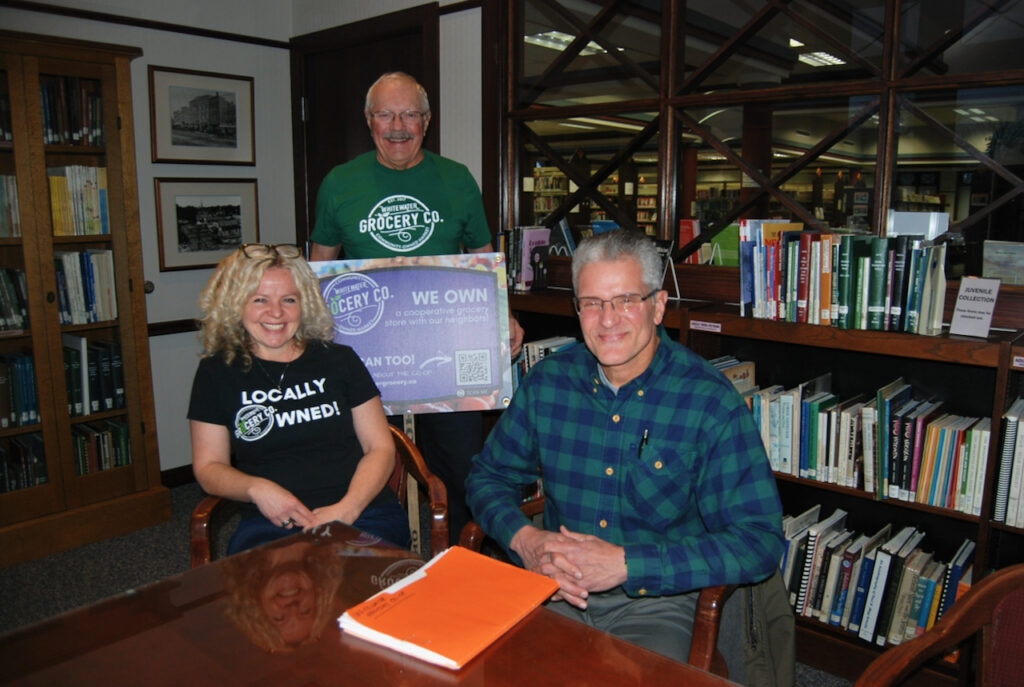
Whitewater Grocery Co., “GroCo,” board members Brienne Diebolt-Brown, from left, Ron Binning and Steve Michaelson talk about plans underway to bring a 7,500- to 12,000-square-foot membership-owned and full-service grocery store to Whitewater. Kim McDarison photo.
Whitewater: Schanen announces candidacy for school board
(Originally published Jan. 12, 2023.)
Editor’s note: information below has been provided by a political candidate announcing his intention to run for office. Other candidates wishing to run for political office will have equal opportunity to announce their intensions.
Brian Schanen, a resident of Whitewater, has announced his intention to run for a seat on the Whitewater Unified School District Board of Education.
He is one of 12 candidates running for three seats. The full field necessitates a primary election which will be held Tuesday, Feb. 21.
According to his announcement, Schanen has lived in Whitewater for “a little over a decade,” noting that he originally came to Whitewater in 2011 to attend the University of Wisconsin-Whitewater. He graduated in 2015 with a bachelor’s degree in communication and in 2017 with a master’s degree in mass communication.
“I have worked with a variety of small businesses and organizations in the region on their video and marketing strategy. I now teach public speaking, video production and audio production at UW-Whitewater, and lead their award-winning speech team,” Schanen was quoted as saying in the announcement.
Additionally, he noted that he met his fiancée, Heather, while in college, stating that she earned her degree in biology and went back to school a couple years later to get her teaching certification. She teaches high school science and engineering and is in her fourth year.
Said Schanen: “We are setting down roots, and our hearts, in Whitewater, and being more involved in the community has made us fall in love with the city even more. I have served on the Community Involvement and Cable TV commission for the past two years. I was about to run for Common Council, however, Heather and I found a house just before Christmas, that moved us out of that aldermanic district. While having to leave that race was tough, I knew from the get-go that I wanted to be more involved in the community.”
According to the announcement, Schanen grew up in Port Washington, north of Milwaukee, where he said he saw “the positive impact of having strong school district-community relations.
“I have an older sister. Both her and my brother-in-law work in the education space as well up north. Growing up, my parents placed a high priority on education, knowing it was vital for whatever path my sister and I chose to embark on. They also instilled the importance of hard work. One of the memories that stands out most is helping my father on his hobby farm.
“Heather and I often talk about how much education and students have changed in the last decade. I want to make sure that as a district we are setting up our students for success, and that we are fostering healthy, constructive relationships with the community,” Schanen stated.
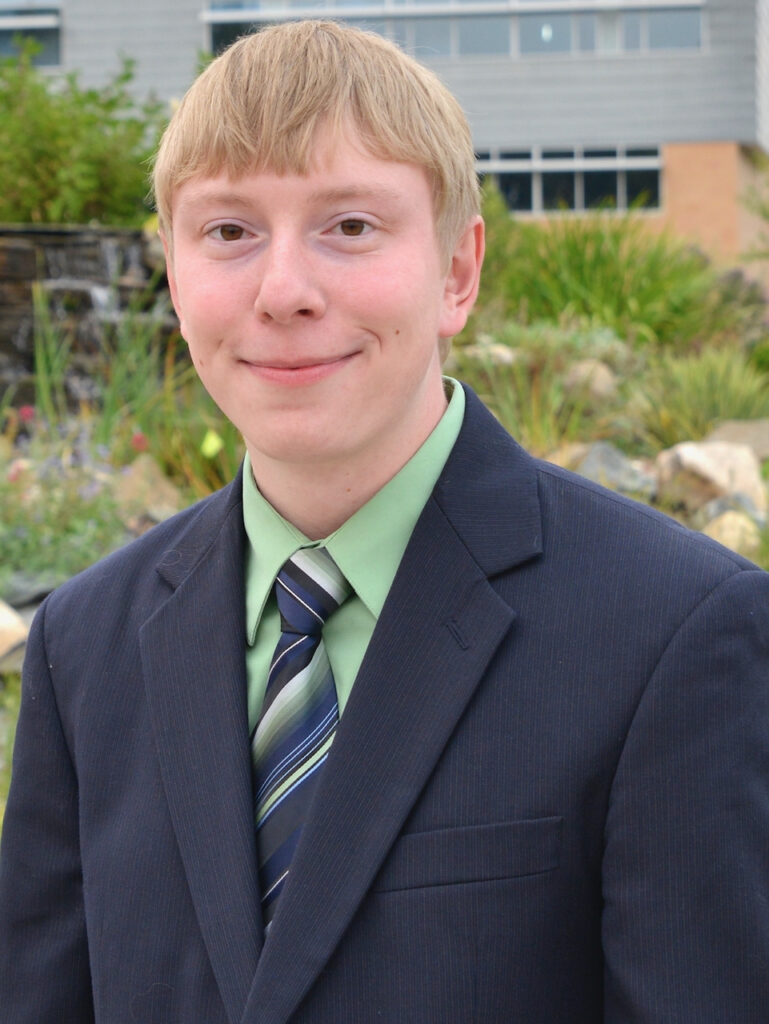
Brian Schanen
Whitewater: BaristaCats Cafe opens
(Originally published Jan. 12, 2023.)
The Whitewater Area Chamber of Commerce has announced that BaristaCats Cafe, 135 W. Center St., has opened in Whitewater.
The chamber was on-hand Tuesday to help the company with its opening by providing a ribbon-cutting ceremony.
According to information released by the chamber, the Whitewater BaristaCats Cafe is Walworth County’s “first all-encompassing cat cafe.”
The cafe’s owner, Natalie Serna, has expressed a passion for cats, seeing a perfect home for the endeavor in the university town, the release stated, further describing the cafe as “her dream business.”
The release noted: “The mission and purpose of this unique business model is to give the community and university students a safe place to sit, sip, study and connect,” while visiting with feline friends.
Serna plans to provide the community with a welcoming environment in which to “relax and destress,” the release stated, further describing the cafe as a safe place for kittens and cats while they await a forever home.
The cafe has established a partnership with the Humane Society of Southern Wisconsin, which offers opportunities to adopt the animals in the cafe, in some cases, even on the same day, according to the release.
While activities such as enjoying a treat and watching cats through a viewing window are available when the cafe is open, an appointment is required to enter the environment in which the cats live and enjoy a hands-on interaction.
During Tuesday’s ribbon-cutting ceremony, the cafe acknowledged a “soft opening,” and chamber ambassadors were offered a tour of the new facility, the release continued.
The cafe is planning to hold a grand opening Saturday, Feb. 4.
For more information about the cafe, visit its website: https://baristacatscafe.com/.
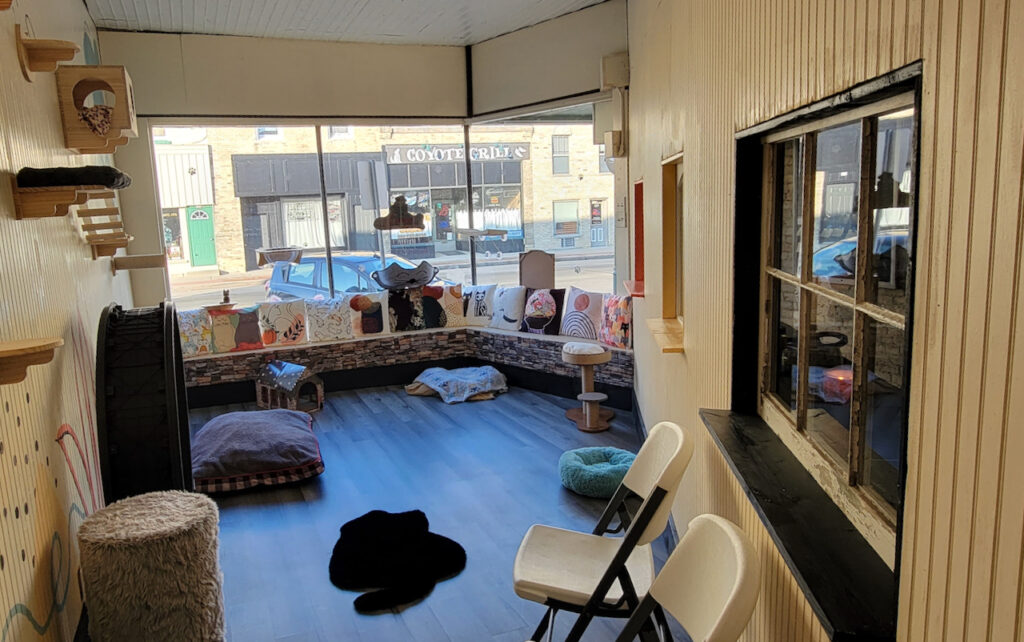
An environment created to appeal to cats and their guests awaits visitors to BaristaCats Cafe, Whitewater. Entry into the cats’ environment is provided by appointment. Contributed photo.

Members of the Whitewater Area Chamber of Commerce help BaristaCats Cafe owner Natalie Serna celebrate a soft opening Tuesday. A grand opening is planned for Saturday, Feb. 4. Those gathered to acknowledge the event include Kellie Carper, chamber executive director, from left; Cassandra Kambitsis, cafe operations manager; Serna; Karen McCulloch, chamber board president; Kim Brotz, chamber board treasurer, and Lisa Dawsey-Smith, a chamber board member who is accompanied by her children. Penny Ardeldt, a chamber ambassador, not pictured, also was in attendance. Contributed photo.
Whitewater: Vander Pas withdraws from school board race
(Originally published Jan. 16, 2023.)
By Kim McDarison
Nathan Vander Pas has announced that he is withdrawing his candidacy for one of three seats on the Whitewater Unified School District Board of Education. The seats will be decided by voters this spring.
Vander Pas made his announcement late Monday afternoon.
In an email to Fort Atkinson Online, Vander Pas wrote: “After careful consideration, I have decided I will be withdrawing my candidacy for the school board. I look forward to supporting the remaining candidates through this and after the primary.”
The withdrawal of Vander Pas’ candidacy leaves a field of 11 candidates running for the three seats which will be decided in April.
A February primary becomes necessary with a field of seven or more candidates running for the three seats. The six top vote-getters in February will find their names placed on the April ballot.
Remaining candidates include incumbent Thayer Coburn, and challengers: Christy Linse, Joseph Kromholz, Michael Bergman, John Truesdale, Daniel Dern, Chuck Mills, Stephanie Hicks, Will Dammeir, Brian Schanen and Lisa Huempfner.
UW-Whitewater chancellor named
(Originally published Jan. 19, 2023.)
Editor’s note: University of Wisconsin-Whitewater officials Thursday released the following announcement.
Dr. Corey A. King, Vice Chancellor for Inclusivity and Student Affairs at UW-Green Bay, has been named the 18th Chancellor of the University of Wisconsin–Whitewater, which has campus locations in Whitewater and Rock County.
The University of Wisconsin System Board of Regents today unanimously approved King’s appointment, following a recommendation made by a selection committee. King will assume the leadership post on March 1.
King served as Vice President for Enrollment Management & Student Financial Services at Bethune-Cookman University prior to his role at UW-Green Bay. He was Vice President for Student Affairs & Enrollment Management at Florida Atlantic University and led the Council for Student Affairs of the State University System of Florida. King also held leadership positions at East Carolina University, Wheeling Jesuit University, and the University of Florida.
“Corey King’s vision for UW-Whitewater and commitment to student success is extraordinary,” said Jay Rothman, UW System President. “He’ll put student learning at the center of his work at UW-Whitewater, and we are looking forward to where his talents can take the university.”
“I am excited to join the faculty, staff, students, and broader community as we continue to advance UW-Whitewater’s mission of being a ‘preeminent academic institution driven by the pursuit of knowledge, powered by a spirit of innovation, and focused on transforming lives,’” King said. “The university’s demonstrated commitment to student success and excellent educational experiences at both the Whitewater and Rock County campuses will continue to be our driving force.”
“Corey’s background in guiding student success, commitment to student learning and the student experience, and enthusiasm for everything public higher education can bring to the community and the state offer a bright future for UW-Whitewater,” said Regent Vice President Amy Bogost, Chair of the Search and Screen Committee. “I am especially thankful for the search committee’s tireless work and the leadership of Vice Chair Lynn Gilbertson.”
King earned a bachelor’s degree in curriculum and instruction and a master’s degree in higher education administration/student affairs from Florida State University. He earned a doctorate in educational administration and leadership from Indiana University of Pennsylvania.
President Rothman and the Special Regent Committee for the UW-Whitewater Chancellor Search recommended King to the full Board of Regents. The Committee includes Regents Bogost, Ashok Rai, Jill Underly, and Kyle Weatherly.
The Search and Screen Committee includes members of the Special Regent Committee; Gilbertson, Associate Professor and Department Chair in the College of Education and Professional Studies; Tanja Anderson, Campus Administrative Specialist, Rock County campus; Ciera Edwards, Associate Director, University Bookstore; Lynn Gardinier, Community/Alumni Representative; Kimberly Nath, Associate Professor, College of Letters and Sciences; Praveen Parboteeah, Professor, College of Business and Economics; Davin Stavroplos, Student; and David Wachanga, Professor, College of Arts and Communication.
King will earn $265,000 as chancellor.
Founded in 1868 as a normal school for training teachers, UW-Whitewater offers more than 48 undergraduate majors, 22 master’s degree programs, one doctoral degree, and one education specialist degree. It has an enrollment of more than 11,000 students and employs about 1,230 faculty and staff. It has campuses in Whitewater and Rock County.
Rothman also thanked Interim Chancellor John Chenoweth.
“I want to think John Chenoweth for stepping into the interim role of chancellor and building a foundation for future success,” Rothman said. “His dedication, with over two decades of service to UWWhitewater, is exemplary. We owe him a debt of gratitude.”

Dr. Corey A. King
Whitewater: Council ‘urges’ state lawmakers to review financial systems
(Originally published Jan. 19, 2023.)
By Kim McDarison
The Whitewater Common Council Tuesday unanimously approved a resolution urging state lawmakers, including the Wisconsin State Legislature and Gov. Tony Evers, to review the state’s system of funding for critical local services.
Language within the resolution called the state’s funding system “broken.”
Whitewater joins with other cities that have passed resolutions making similar requests of the state’s governing entities.
Late last year, the Fort Atkinson City Council approved a resolution in which it described the current statewide funding system as “broken” and called for its repair.
A link to the story about the resolution approved by the Fort Atkinson City Council is here: https://fortatkinsononline.com/fort-council-approves-resolution-urging-state-lawmakers-to-review-financial-system/.
During Tuesday’s Whitewater Common Council meeting, City Manager John Weidl said the city’s officials had been asked “by numerous outlets,” including the League of Wisconsin Municipalities, to consider approval of the resolution.
Said Weidl: “I don’t have any hard details because the Legislature is not talking about them, however there is a caucus that is currently meeting with members of both sides of the aisle to make considerations to changing how much money is allocated to local governments annually.
“Said a different way, they are strongly considering changing the amount of money, upward, that all communities in Wisconsin get in, I believe it’s going to be general aids, because there’s not another way to cut it. I’ve met with our local representative, Ellen Schutt … to discuss this. Her opinion is the same as mine in that she has also been informed that there is a caucus working on this, but we have been asked — we are trying to get as many municipalities — to urge them to fix this issue as possible. I don’ think it’s a far-fetching statement for us to say we could use more resources from the state to help sure up some of our budgetary issues.”
“It’s the best thing I’ve seen come out of the league in a long time,” Councilman Jim Allen said.
Councilwoman Carol McCormack asked: “This is in regard to that huge budget surplus we had in the spring?”
Weidl replied that is was, adding: “And there’s a bipartisan group committed to figuring out how to allocate some of that. I don’t want to get involved or try and impress our opinion on them. If they’re interested in increasing the dollars going to local governments, my inclination is to get this in front of the city council and ask them to consider supporting it.”
Information within the resolution states that the system to fund local services like police, fire protection, EMS, streets and libraries is “broken, unsustainable, and needs to be reformed.”
Communities “are forced to rely on property taxes and flat or declining state aid to pay for critical local services …” the resolution notes.
As stated in the resolution, “state sales and income tax revenues have tripled in the last 30 years, but the share of those taxes going to support police, fire, EMS, and other local services has gone down.”
According to the resolution: “Over the last 20 years, state aid for police, fire and other critical services has steadily declined in real dollars, while inflation has caused average prices to increase by 51%. The funding level for county and municipal aid in 2003 was $938,529,507. Today, it is $753,032,613.
Additionally, the resolution stated: “County and municipal aid payments to the city of Whitewater (have) dropped from $4,316,975 in 2003 to $3,297,178 in 2022.”
The resolution concluded by noting that the city of Whitewater “urges the Legislature and the governor to work collaboratively with the League of Wisconsin Municipalities, Wisconsin Counties Association, Wisconsin Towns Association, other local government leaders, and business leaders to create a better way of funding local governments that includes revenue options other than property taxes to continue delivering police, fire, EMS, and other critical services.”

The full text of the resolution approved Tuesday by the Whitewater Common Council, urging state lawmakers to “fix the broken system funding critical local services,” is presented above.
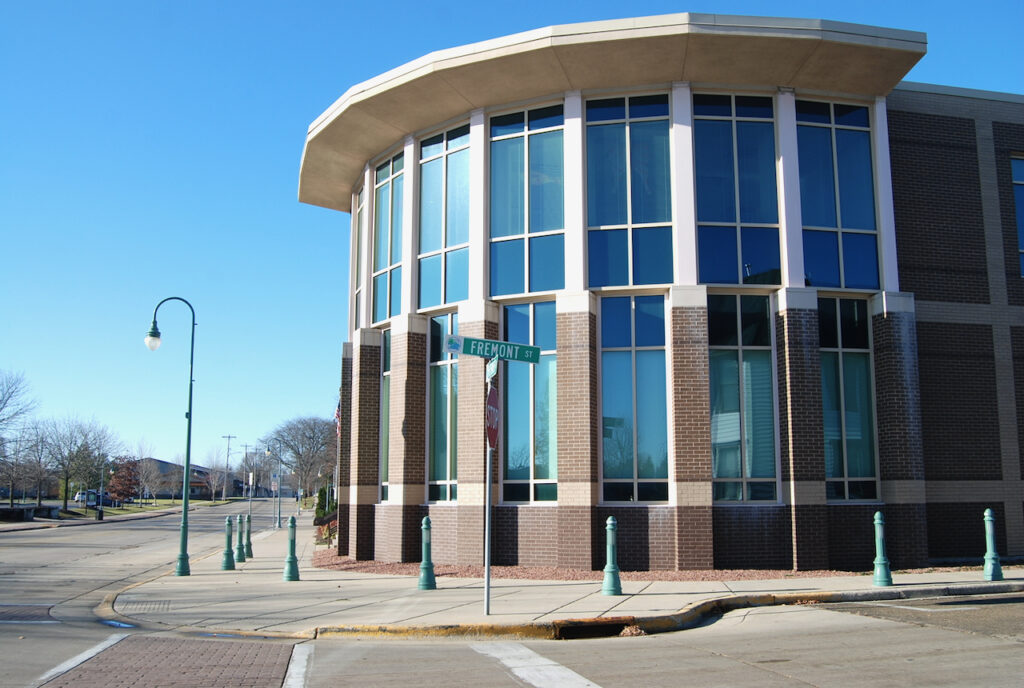
Whitewater Municipal Building, file photo/Kim McDarison.
Whitewater: City to apply for $25,000 matching grant to restore effigy mound park
(Originally published Jan. 19, 2023.)
By Kim McDarison
The Whitewater Common Council Tuesday unanimously approved a resolution authorizing city staff to apply for a Wisconsin Economic Development Corporation (WEDC) grant to help fund restoration work within the city’s Effigy Mounds Preserve.
In a memo to council, Whitewater Director of Parks and Recreation Eric Boettcher noted that the matching grant for which the city will apply comes through the WEDC “Vibrant Spaces” program, which provides grant opportunities ranging from $25,000 to $50,000 to help communities “develop and enhance public spaces.”
The program is part of the WEDC’s Community Development Investment program, according to the resolution.
A dollar-for-dollar match is a stipulation of the grant, Boettcher wrote.
Would the city receive grant funding, monies would be used to restore the mound preserve trail and enhance the park’s entrance, which, Boettcher, wrote, could “draw more people to this preserve and park area.”
Within his memo, Boettcher asked council to earmark $25,000 from the city’s “2022 reserve fund,” with those monies used to fulfill the matching-funds requirement of the grant. The city would plan to apply for a $25,000 grant from the WEDC, he wrote.
According to the city’s website, the preserve, 288 S. Indian Mound Parkway, offers “one of the largest collections of effigy mounds in the country,” with at least 12 mounds, built between 800 and 1200 A.D., located within the park. Mounds range is size from 60 to 300 feet, and are thought to be the work of “several Midwestern Native American tribes,” the website states. The preserve and its maintenance plan were created in 2011.
Addressing council Tuesday, Boettcher said: “We’ve been working on cleaning up the mounds over the last couple years. As part of this, we would ask for $25,000 to continue those improvements and look to get a matching grant of $25,000 through the Vibrant Spaces grant in order to catch up on maintenance for the park reserve and the entry area of the park.”
Councilwoman Jill Gerber asked if other projects besides the effigy mounds preserve and park had been considered as candidates for Vibrant Spaces grant funding. She referenced a discussion, which, she said, she thought she might have read in a committee meeting’s minutes.
Boettcher said only the effigy mound preserve and park projects had been considered.
“So basically it’s for the park area and in front of the effigy mounds, to make more of a welcome center, and then that will lead into the actual mounds preserve,” he said.
Gerber asked: “Was there a grant, or maybe I’m messing them up, about discussion about the downtown space — adding features to the downtown picnic table area?”
Boettcher said he was unaware of that grant.
City Manager John Weidl, addressing Gerber, said: “If what you’re asking is could we conceivably use the Vibrant Spaces grant in consideration for that use, I think the answer is ‘yes.’”
Said Gerber: “I’m just wondering, I thought I saw in the minutes or some kind of discussion about, where maybe it was a Polco vote, about using — updating the downtown space — like to shade it, for lights, I’m not really sure.”
Weidl noted that Gerber was likely referring to a Polco question.
Gerber continued “So I’m just wondering, he (Boettcher) said nothing else was considered. I’m wondering — so nothing else was considered for this grant besides the effigy mounds?”
Boettcher said that was correct.
Councilwoman Lisa Dawsey Smith stated: “And part of that is because there is a match requirement on the part of the municipality.”
Said Weidl: “And we have that funding allocated in the approved budget. So the $25,000 in the approved budget lines up with the … certainly not withstanding that — if you guys want us to consider another project or make sure that our next application considers a range of projects, we can do all of that.”
Gerber said that she would have preferred to see more than one project brought forward for consideration.
“Going forward, I would like to see more come forward than one,” she said.
“This project’s been kicked down the road too many times. I think we need to bring it up to speed. It’s an important project. The more I hear about it, or read about it, the more education you get out of it. It’s quite a feature that really needs to be showcased,” Councilwoman Carol McCormick said.
About Polco
Polco, according to the platform’s website, “is an online engagement tool designed to receive ongoing and reliable feedback from verified members of a community.”
According to the city’s website, the city offers the tool to “enhance the capabilities beyond public meetings and traditional forms of communication.” Polco questions can be submitted by email to the city’s public relations and communications manager, the website states.
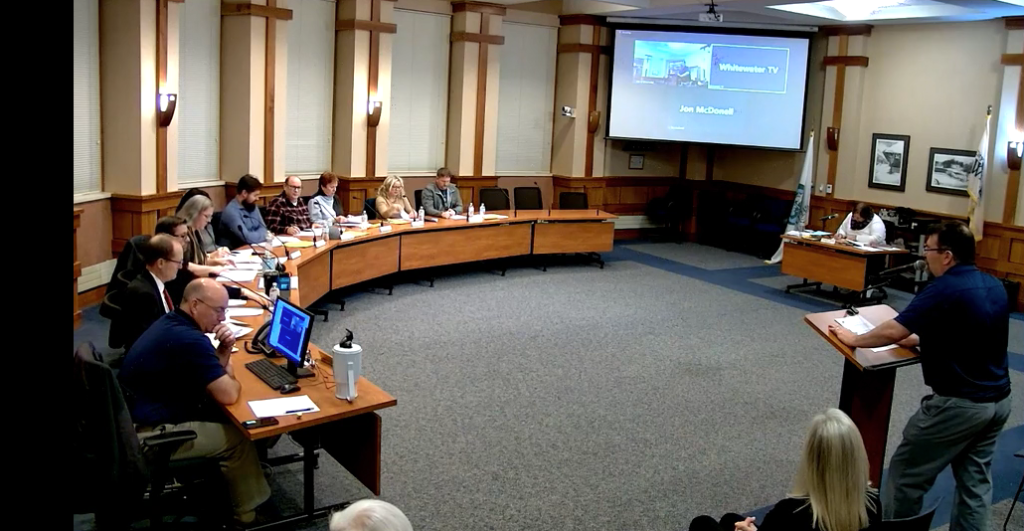
Whitewater Director of Parks and Recreation Eric Boettcher, at right, addresses the Whitewater Common Council Tuesday. Boettcher asked council to approve a resolution allowing city staff to apply for a matching grant from the Wisconsin Economic Development Corporation. Would the city receive the grant funding, monies would be used to make restorations within the city’s effigy mounds preservation and park. Screen shot photo.
.
Whitewater, Part 1: Council receives presentation, begins discussion outlining: ‘What is a CDA?’
(Originally published Jan. 20, 2023.)
Editor’s note: The Whitewater Common Council recently hired Redevelopment Resources, an economic and community development consultant, to aid the city, including its manager, the city council, and the Community Development Authority (CDA), in its efforts to create a guideline under which the three entities will work to craft common goals and develop responsibilities for an economic development/CDA director. Kristin Fish-Peterson, the company’s principal, began an introductory exploration Tuesday with the city council and Thursday with the CDA. The first of a two-part story focusing on the first of the two introductory meetings follows.
By Kim McDarison
The City of Whitewater Common Council Tuesday received a presentation given by hired economic and community development consultant Kristin Fish-Peterson, who, after offering some introductory remarks about herself, community development authorities in general, and the Whitewater CDA, posed a series of questions developed, she said, to begin a dialogue through which a common economic development vision and policy for Whitewater might be forged and enacted.
Introducing Fish-Peterson, Whitewater City Manager John Weidl said: “As a matter of the process of the city council working with the CDA to outline the future expectations and reporting structure for what is soon going to be the new CDA director, I’ve asked Kristin to help do a training for everyone, including people in the audience, people watching, about the basic powers of a CDA and CDA director, and then ask this council some questions that will both inform our decision-making as we then go to the CDA and try to come up with an aligned vision of how this position will report and what they are going to do.”
Aided by slides, Fish-Peterson told those in attendance that she has operated her consulting firm for 13 years, and listed among her accomplishment, four years serving on the Redevelopment Authority (RDA) in the city of Watertown.
During her tenure there, she helped create “from scratch” and then ran that city’s RDA, she said.
She described the Watertown RDA as having undertaken some “serious downtown rehabilitation.”
As part of her presentation, Fish-Peterson said she had since had the opportunity to consult with other communities, and wanted to share with council members her knowledge of state statutes and their potential application in Whitewater.
What is a CDA?
Fish-Peterson said state statutes define a CDA as a “separate body politic,” which, she said, could be used to perform differing activities, including blight elimination, slum clearance, urban renewal programs and projects, and housing projects.
Citing some history, in past years, she said, communities within the state of Wisconsin had redevelopment authorities and housing authorities, and some communities had both. The state statutorily combined the two bodies, offering communities an option to form community development authorities, endowing those bodies with the powers previously held by their earlier formed counterparts.
“So Whitewater has a CDA. We tried in Watertown … using the CDA at the time, to do the redevelopment work, but because that CDA had only ever implemented public housing, they just didn’t have the leadership, and the vision, and the guts, to propose tearing down buildings and creating a public square. And it was — that was a lot of scary work for them to do, but we solved that by reverting the CDA back to a housing authority in Watertown, and then creating a new redevelopment authority. So we could undertake that big, redevelopment work in the downtown.”
She noted that Whitewater’s CDA served a combined function of facilitating redevelopment and housing projects.
Further defining generally a CDA, she said the board is comprised of seven residents who have sufficient ability and experience in the fields of urban renewal, community development and housing, who serve as commissioners. Typically, she said, CDAs are comprised of five residents serving at-large and two city council members.
Powers and duties
Describing the duties and powers of the CDA, Fish-Peterson said the body is able to prepare, carry out, acquire, lease and operate housing projects approved by council, as well as provide for the construction, reconstruction, improvement, alteration or repair of any housing project or any part of a housing project.
The body acts as an agent of any government in connection with acquisition, construction, operation or management of a housing project or any part of a housing project, and can acquire through use of eminent domain any real property, including improvements and fixtures on the real property.
“The CDA is acting at the direction of the governmental body and approved by the city council,” she said, adding: “The CDA may acquire property through eminent domain and make improvements on that property, so one reason a community may use a redevelopment authority or a community development authority to do this work is to shield itself, the city council, from enacting eminent domain on a property. It’s a political way to have another party deal with that — take the flaming arrows and all the public comments, and all of that stuff that would happen.”
Additionally, she said, the CDA can own, hold, clear and improve property, to ensure or provide for the insurance of the property or operations of the authority against any risks; it can contract for the sale of, and to sell, any part or all the interest in real estate acquired, and it can invest any funds held in reserve or sinking funds, or any funds not required for immediate disbursement, in property or securities in which savings banks may legally invest funds subject to their control.”
The body can sue and be sued, she said.
According to Fish-Peterson, CDAs can prepare redevelopment plans and urban renewal plans and undertake and carry out redevelopment and urban renewal projects within the corporate limits of the city in which it functions; enter into any contracts; borrow money and issue bonds; execute notes, debentures, and other forms of indebtedness, and apply for and accept advances, loans, grants, contributions, and any other form of financial assistance from the city in which it functions, from the federal government, the state, county or other public body, or from any sources public or private.”
Community use
Communities have used CDAs to oversee planning activities for redevelopment areas, new development areas, downtowns and neighborhoods; create and operate loan funds; implement redevelopment projects; oversee development deals; construct and manage public housing, and construct and operate incubators, Fish-Peterson said.
Who leads?
“In many cases they are staffed with city employees who serve the organization as well as the city. The leader of the CDA or the head staff member is also an employee of the city … in Watertown, I was on contract for the first four years, but then the city hired an employee to serve the city as an employee and lead the RDA. That’s the same model that’s used in many other communities such as Wausau, Madison, Eau Claire, Fond du Lac, Green Bay and Stevens Point,” Fish-Peterson said.
She described CDAs and RDAs as the “first stop for development approval,” adding that when incentives are involved, especially if the incentive comes through a city-owned tool such as a tax incremental financing (TIF) district, projects move to the city council for approval.
“Loan programs are run through the CDA or RDA without need for city council approval except for the original capital funding. If the entity has its own source of capital funding, they can run that without permission or approval from city council. Sometimes the city council is the source of that original funding,” she said.
Additionally, she said, projects come before the city council because there may be expenditures involved for which the city must give approval.
How does Whitewater want to use its CDA?
In Whitewater, the city has used the CDA as a development agent for affordable housing, and industrial and commercial property, and as a lender, realtor, business attraction agent, and marketer, Fish-Peterson said.
“But I think there’s an opportunity to consider how it should continue to operate,” she said.
Fish-Peterson identified several funding sources that have been used by the Whitewater CDA, including U.S. Department of Housing and Urban Development (HUD) Community Development Block Grants (CDBG), which, according to the HUD website, are provided on a formula bases to states, cities and counties to develop viable urban communities by providing decent housing and a suitable living environment, and by expanding economic opportunities, principally for low- and moderate-income persons; facade grants, which, according to the city’s website, have been made available through a program begun in 1991, and have “helped a number of downtown businesses over the years”; Capital Catalyst Fund, which, according to information provided in 2020 to area news outlets by former Economic Development Director Cathy Anderson, was funded with a Wisconsin Economic Development Corporation (WEDC) grant of $250,000; funding identified as a Paquette Center loan fund; an HUD Urban Development Action Grant (UDAG), which provides funding to assist revitalization efforts in distressed cities and urban counties that require increased public and private investment; and holdings within the city’s business park in land and real estate.
Said Fish-Peterson: “Currently you have a variety of programs and I’ve been studying all of your programs, your sources of funding, the levels of funding that you have in each program. You have your housing program that is largely funded by Community Development Block Grant — that’s federal funding — you have a facade fund, a capital catalyst fund, which is investment dollars into startups in the form of equity, you have a loan fund, a revolving loan fund, a UDAG fund, and then you have the business development park that the CDA operates, and you have land and real estate listed as assets on your CDA balance sheet.”
Why serve on the CDA?
Fish-Peterson said CDA members serve at the request of the city manager and are approved by city council.
Those who serve on a CDA might be motivated by such factors as a desire to see change in the way the community develops, to help meet housing and other economic development needs in the community, to serve the city with specific professional talents and skills and to ensure the city is a good steward with its development incentives and land.
“It’s important to staff or appoint community development authority members that have skill sets that will help the process,” she said, listing attorneys, bankers, realtors and accountants as among those who could provide useful skills.
Fish-Peterson next asked city council members a series of questions, which, she said could begin a discussion about the future of the CDA.
She asked: What are the CDA’s functions currently? What are the priorities? What is the city’s charge to the CDA? Are they an independent body? Do they operate at the pleasure of the city council? Where is the line between what property the CDA owns and what the city owns? How are they funded? Do they have their own funding sources? What do you want it to be?
“I’m familiar with some of the CDA’s functions currently, but what are the priorities? What is the city’s charge to the CDA? Do you have a direction?” she asked.
Council discussion
Responding to Fish-Peterson’s questions, councilman and CDA member Jim Allen said that he had served “a lot of time” on the city’s CDA, calling it “very important to the city.
“Our CDA also manages the business park and technology park, of course you know that, and the Innovation Center, co-owned by the CDA and the university.” He described the center as “an incubator space.”
Allen defined the CDA as “a quasi-independent organization with a dotted line to the city.
“There are times when we need to be independent to where a developer comes in and doesn’t want to bring their projects in front of a group … worried about their project getting out. At the same time, our director works directly with the management team here at city hall to move things along and make things happen. The last seven years or so we’ve made a concerted effort in making our system streamlined, so that developers who come to town don’t feel like they were turned away — and sometimes by either side, the city or CDA — but to know that we are here to help. And that together, the city and the CDA make things happen as quickly as possible. So that’s been the goal over the last seven years, and something that we really needed to work on and streamline because the city especially was being accused of being unfriendly to, some say, outside developers, and others say local developers. So that’s just something we’ve been working on.”
“Apparently we are equal-opportunity unfriendly. That needs to change,” Weidl said.
Allen agreed.
Allen continued: “So is it an independent body? yes and no. That’s the best answer I can give you. Do they operate at the pleasure of the city council? Well, yes and no. I think currently half of our funding comes from profits from the CDA, half the funding comes from the city. Where’s the line between what property the CDA owns and what the city owns? That’s pretty well defined, I think. I’m sure when you talk to the CDA on Thursday … that will become very clear.”
Said Weidl: “What I want — one of my main goals is to make sure that any toe-stepping is avoided … and we all pull in the same direction to do what needs to be done, which is to increase the growth of the city, and to do that, we’ve just got to check these boxes, answer these questions, make sure we all agree to what the answers are and then move forward.”
“I think we cleaned up a lot of that in the last several years about if the CDA sells property, what property sale goes to the city or to the CDA coffers. That’s been clearly defined,” Allen said.
Addressing the full council, Weidl asked if members would be comfortable with leaving the appointment of a new CDA director and the “handling of those duties” to the CDA.
“That’s one great route to take. I just want to make sure we are clear, so it’s at the point when someone’s hired, I can be like, ‘hey, we talked, and you wanted the CDA to handle it, so I asked them to handle it,’” he said.
Said Allen: “We (CDA) also manage our tax increment districts … this CDA here in Whitewater has its own staff. Just, right now, a part-time secretary, but, hopefully, a full-time secretary, her assistant, with that John, typically it’s been the CDA members who have chosen the CDA director along with the city manager,” Allen said, adding: “Not that that can’t change.”
Councilwoman Brienne Brown offered ideas revolving around housing projects.
“We have a housing crisis as many cities do, and I think we need new housing, but also there are some beautiful homes — broken teeth kind of housing — some of them do need to be torn down, and some of them need to be fixed up, and I would love to see the CDA somehow get its hands on some money that they can give in low-interest loans to homeowners so they can afford to fix up their homes.
“I know that right now we have access to some county money, but you have to be really poor to get your hands on that money. So if you’re making $45,000 or $60,000 a year and maybe have student debt, etc., there’s no way you can get a loan to fix a roof. You have to be incredibly below poverty level essentially to do that, so I’d like to be able to see that happen, that we can get people in this community who would like to fix things up, give them some money they could pay back,” Brown said.
Allen said he believed the city had secured some money for housing.
Weidl said the city had $1.9 million earmarked to help alleviate the housing shortage.
“It would totally be within the purview of the city council to turn some of those funds over to the CDA for that purpose,” he said.
Said Allen: “So housing has been a concern for quite some time, and here’s where we really fall short within our city: people in Whitewater don’t know what we have available or what the CDA does.
“There are loans available for people who wanted, you know, their porch is falling off their house, they can borrow that low-interest money or borrow it to never be repaid until they sell the house.”
Councilwoman Carol McCormack asked Allen how the public was made aware of the program.
“That’s what I’m saying, this is where we fall short,” Allen said.
He continued: “The general public doesn’t always know this information, and that’s something that we need to get out so a lot of those things that you asked are already in place. … The banks have been helping us — we have programs for new buyers to come in and are educated before getting their loans — but we’ve got loans all over town that you don’t know about, and a lot of them we don’t know about, because they are numbered instead of named.”
Council president and CDA member Lisa Dawsey Smith said she had a short list to share with council, and was prepared to share thoughts during the CDA meeting on Thursday.
“As far as hiring (a CDA director), I think it’s pivotal that the CDA have some input to that, but it also needs to be someone who works with the team, who they will see more often than anyone else here (within the council) or at that body. I think it’s important that we not sit on our ($1.9 million) housing extension money any longer. We need a policy and we need that quickly. Something else that I’ve noticed, the number of regional things that I’ve attended, is that Whitewater is very poorly represented at county levels. You can go to county economic development events and there’s no-one from Whitewater there in attendance aside from the chamber director, and myself, and the city manager.
“I would be personally interested in seeing a thoughtful review of our ordinances, whether or not they give us the nimbleness to be able to be reactive to blighted properties. I do believe there are gaps that could be addressed there. And I’d like to see a much larger focus on the bigger picture. Instead of being reactive to immediate needs, we need to be reacting to those now, as well as what’s coming in five to 10 or 20 years, because not focusing on the larger picture can keep us in second place for too long,” Dawsey Smith said.
Joining the discussion from the podium as a member of the public, Jeff Knight, a former CDA member, talked about term limitations on the CDA.
“I think one of the restrictions you have is that there have been turnover in staff over the years. I think it’s unfortunate, but it’s part of the world we live in. Some of the rules that you’ve got relating to the governing body are restrictive in how fast people have to turn over. I’m not here asking to go back on, but I am suggesting that the people you have on there, once they’ve gone through the process for a short while, the six-year stint, based on the complexity of what you’re doing for the city, probably should be looked at by Kristen and a recommendation back, because I do think that most of the people, by the time they are on there for four, five years, they’ve become pretty good specialists in this — it’s a complicated world, the TIF and the economic development loans, and the functions of where it is, and if you turn that position over, you need to have a body that’s pretty learned in what is going on, so you need the documents to be there, to be available for everybody to see, but my recommendation is for Kristen to come back to the city council and CDA, and perhaps an additional length of three-year term for whoever you do appoint on there, at least you consider that,” Knight said.
“I think our ordinances also address how long somebody who’s termed has to stay off, and that should probably be addressed, too,” Allen said.
“I think the state statute stair-steps the turnover so that you don’t have your whole CDA leaving at one time. If somebody serves for five years, the next person serves for four, and three, and those can be renewed, but, according to statute, I can check local ordinances, too, to see,” Fish-Peterson said.
Part 2, of this story is here: https://fortatkinsononline.com/whitewater-part-2-cda-receives-presentation-begins-discussion-outlining-what-is-a-cda/.
A link to the Redevelopment Resources website is here: https://redevelopment-resources.com.
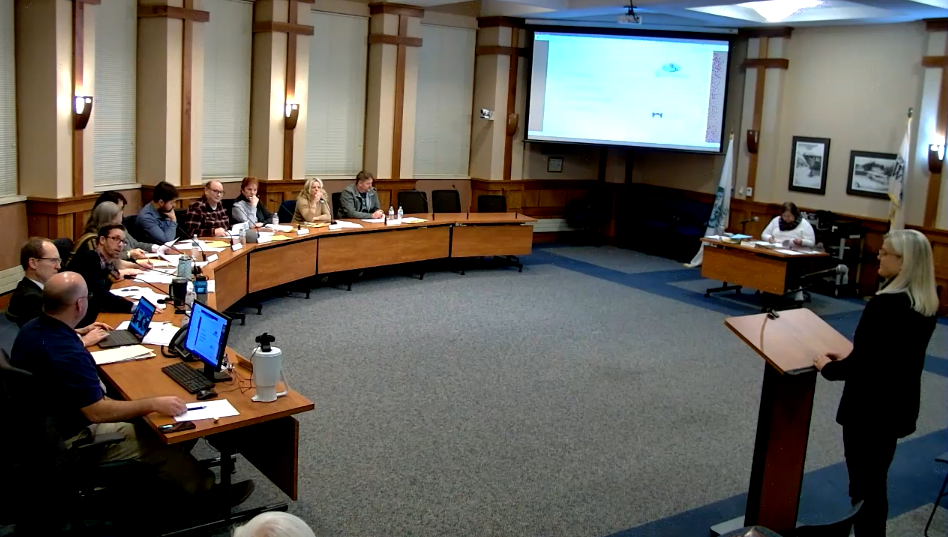
Kristen Fish-Peterson, principal at Redevelopment Resources, an economic and community development consultant working with the city to craft common goals and responsibilities for an economic development director, at right, addresses the Whitewater Common Council Tuesday. Screen shot photo.
Whitewater, Part 2: CDA receives presentation, begins discussion outlining ‘What is a CDA?’
(Originally published Jan. 22, 2023.)
Editor’s note: The Whitewater Common Council recently hired Redevelopment Resources, an economic and community development consultant, to aid the city, including its manager, the city council, and the Community Development Authority (CDA), in their efforts to create a cooperative guideline under which the three entities will work and facilitate the city’s efforts to hire an economic development director. Last week, Kristin Fish-Peterson, the company’s principal, began an introductory exploration with the city council and CDA. This is the second of a two-part story focusing on introductory meetings held within the two bodies.
By Kim McDarison
The City of Whitewater Community Development Authority (CDA) Thursday received a presentation given by hired economic and community development consultant Kristin Fish-Peterson, who, after offering some introductory comments about herself, community development authorities in general, and the Whitewater CDA, posed a series of questions developed, she said, to begin a dialogue through which a common economic development vision and policy for Whitewater might be forged and codified.
The introductory presentation, which was an abridged version as compared with the one presented to members of the city council on Tuesday, presented an array of similar topics and focused on similar questions posed to the common council.
A link to the story, including the full presentation made during Tuesday’s city council meeting, is here: https://fortatkinsononline.com/whitewater-part-1-council-receives-presentation-begins-discussion-outlining-what-is-a-cda/.
Within her comments presented Tuesday to the city council, Fish-Peterson identified several funding sources that have been used by the Whitewater CDA, including U.S. Department of Housing and Urban Development (HUD) Community Development Block Grants (CDBG), which, according to the HUD website, are provided to states, cities and counties to develop viable urban communities by providing decent housing and a suitable living environment; facade grants, which, according to the city’s website, have been made available through a program begun in 1991; Capital Catalyst Fund, which was funded in 2020 with a Wisconsin Economic Development Corporation (WEDC) grant of $250,000; funding identified as a Paquette Center loan fund; an HUD Urban Development Action Grant (UDAG), which provides funding to assist revitalization efforts in distressed cities and urban counties, and holdings within the city’s business park in land and real estate.
Within comments made during Thursday’s presentation, Fish-Peterson said: “When I was looking through your financials, I recognized these programs, so you have your (federal CDBG) housing fund, and it is a housing rehab program, but, according to the numbers, you only have about $11,000 to lend, and it is for affordable housing, it is for low-income homeowners, and so when a loan gets paid off, whether the owner sells it, if they are required to pay off the loan, then we will have more money to market the fund and spend those funds. But right now, with only a small amount of money, it doesn’t make sense to market a fund that doesn’t have a lot of money in it.”
Additionally, she noted that the CDA has a facade fund, and a capital catalyst program.
“You also have the general business loan fund, a UDAG fund, you have funds that are for business park development, and those funds are to buy new land for the business park, and then you do own land, and you own the real estate of the Innovation Center.”
She described the list as “the balance sheet buckets that I identified.”
She asked CDA members if it was “a good summary.”
They agreed that it was.
After the presentation, CDA members were asked the following questions: What are the CDA’s functions currently? What are the priorities? What is the city’s charge to the CDA? Are they an independent body? Do they operate at the pleasure of the city council? Where is the line between what property the CDA owns and what the city owns? How are they funded? Do they have their own funding sources? What do you want it to be?
CDA discussion
In advance of the presentation, City Manager John Weidl told those in attendance that the purpose of questions posed by Fish-Peterson was to discuss the “major things” CDA members would hope to find in the next CDA director and determine a process in which CDA members would be interested in engaging to find a successful candidate.
At the conclusion of the presentation, Weidl said: “We are looking for some real back-and-forth now, because these priorities are going to drive the type of talent we try and bring in, they are going to drive the way we write the job ad, as we reflect, and it’s going to affect the way we do the recruiting process.”
Weidl said candidates for a CDA directorship typically asked: “What do my first three months look like? What does my year look like? Who do I report to? and: What do I do to be successful?’”
CDA member Joe Kromholz asked: “Who does the CDA director report to?”
Weidl said the process underway was meant to help the group determine the answer to his question.
Kromholz asked if the CDA director was an employee of the city.
Weidl said it was.
Kromholz: asked: “If they are an employee of the city, if they only answer to the CDA, doesn’t that create a tension then with you?”
CDA member Jim Allen said past CDA directors did not only answer to the CDA.
Said Weidl: “As long as they’re producing — I’m not a micromanager.”
CDA President Patrick Singer, addressing Weidl, said that in the past, the CDA’s experience had been that without a clear delineation of roles, directors would sometimes “flip, like mom and dad.”
They would say, he said: “The manager’s not doing this, so they run to the CDA chair or members, so we just want to make sure that those lines of authority are clear.”
He suggested that the CDA board might serve as the organization charged with setting policy, but, he said, addressing Weidl, “day-to-day, you’re that mix.”
Weidl said he preferred to “focus on the process,” which, he said, meant that he would ensure the director would meet with CDA members to set goals at the beginning of the year, and again in the middle of the year to “refresh” goals.
“I don’t necessarily need to be involved in the creation of those goals,” he said.
Comparing Weidl to previous city managers, Singer described Weidl as possibly having “a new perspective.”
“The city managers in the past that I dealt with when I was on council were very much hands-on with economic development,” he said.
He described former City Manager Cameron Clapper as “very involved,” adding: “You almost need to be because there are other city resources.”
He described economic development activity as “a team effort,” further suggesting that while the economic development director was “kind of the cheerleader and the ombudsman” to interact with businesses, “the city manager was the quarterback, and making the final call.”
Singer said it was a system that sometimes worked and sometimes did not.
He asked Weidl for his opinion about how, as the city’s chief executive, he saw his role when working with the CDA.
“I prefer to manage all my direct reports consistently, which normally involves biweekly meetings, and I would anticipate continuing those. I ask my reports to come up with their own goals for their department, based on the vision set by the governing body, and in this case the governing body is the CDA,” Weidl said noting that he anticipated “a rough planning process that we all engage in together.”
He described his role as one in which he was less interested in leaving his “imprint” on the CDA director and saw himself as looking more “to help ensure the process is set up and is being followed.”
Kromholz asked if Weidl viewed the CDA director as a position that reports to the city manager.
“It has to be by virtue of it being a city position,” Weidl said.
Kromholz described himself as having limited exposure to activities that took place in advance of the departure of the last CDA director, but, he said, he was aware that there were “communication issues.”
Addressing Weidl, he said: “From where I come from, we want to make sure that it’s clear that this person has to communicate with you — that’s the direct report.”
Fish-Peterson, offering her recommendation, said: “I would say this person, as a city employee, should report to John (Weidl) and serve the CDA, because there are other things that this person will be doing other than just CDA work. They’ll serve on the development team with the city, which includes (Public Works Director) Brad (Marquart), John (Weidl), (Director of Finance and Administration) Steve (Hatton), whoever has those development team meetings to make sure developments are actually carried all the way through.”
Said Singer: “I think that’s were there has been some confusion. Not to say the day-to-day hasn’t gotten a little murky, but on the hire and fire.” He asked: “Who is the appointing authority?”
“It’s the manager,” Weidl said.
Singer said that other bodies working with directors “have input,” but, he agreed, ultimately the decision resides with the city manager.
“If we just have that defined, that will solve a lot of problems,” Singer said.
Weidl said he had suggested to Fish-Peterson that the city engage is a panel process to hire the next CDA director. He saw the panel as having five members, including himself, Fish-Peterson and three members of the CDA board.
Addressing Weidl, Kromholz said: “One thing that is important to this group is ensuring that this person understands their role, and that they have to communicate with you, and that there is no decision about what they communicate and what they don’t communicate.”
Addressing priorities, Singer said he wanted to focus on some of the CDA’s successes and also “what we’ve heard in the community.”
Citing business retention, he said: “For existing employers, and clearly, being a point of contact for potential new developments as well — that’s always been something that we wanted to see — you know we don’t want to have over-metrics — but we want to see how many were done.”
As a matter of data collection, he said, questions he thought should be asked included: “What is the kind of feedback you’re getting from the community employer, even the existing ones?” and: “How can we be of help?”
He said collecting that information “has had fits and starts.”
Weidl agreed with Singer, saying he saw data collection as “the single most important thing that’s going to make us successful.”
Citing his experiences with economic development in Mukwonago, he said the “vast majority” of investors in a community are people who are already operating a business within the community.
“To put that into real world perspective,” he said, “the first anchor tenant of Mukwonago’s business park was an existing Mukwonago business. Our first expansion in the business park was a business that moved over within that park and made their expansion.”
He offered “kudos” to the CDA board for identifying data as a driver, noting that, in Whitewater, the collection of economic development data was “something we haven’t had.”
Looking at procedures, Weidl said: “Kristen and I have talked at length about making sure we have a documented process, where you know what the outcome should be — and that’s something we would obviously vet with the CDA — here’s some outcomes that communities typically use to suggest some basic demographics and goals of this community. It needs to be in writing, it needs to be — we need to be able to replicate it annually — doing the same thing over and over, reflecting the same types of data so we can look for trends.”
CDA member Lisa Dawsey Smith agreed the city had collected a “small” amount of data.
Singer said he saw the CDA director as “being that ombudsman for community development.”
He added: “One of the things I’ve heard over the years is that the city is so hard to deal with for new businesses or developers.”
He said he saw an advantage in having a CDA director serve as a “pathfinder” for businesses, and also as someone who could identify obstacles and advocate for change at the CDA and council levels.
He described an environment in which the CDA would “do our due diligence, but we are also flexible and responsive to developers and the people who want to invest in our community. Having that kind of wholistic view of our organization,” asking, he said: “What resources are available through the city’s departments?”
Using a team approach, he said, he envision a process through which department heads also might be involved in helping to find answers to questions and developing solutions.
CDA member Jon Kachel asked: “Are you saying it would be the executive director doing that or the city doing that?”
Singer responded: “I would say the executive director, but I mean we are all in this together. So, if we hear stuff … we should feed that to John (Weidl) and say, ‘hey, we’ve heard these concerns,’ because sometimes you hear those rumblings and then nobody does anything and it just kind of compounds the problem.”
He identified the CDA staff person as the one who should be responding to those concerns.
Kachel said he saw the CDA director as an individual who, through their networks, could enumerate required steps to successful development and then introduce business owners and developers to the right individuals to facilitate an outcome quickly.
CDA member Jim Allen suggested that Weidl, in the interest of familiarizing himself with active developers and projects, might attend meetings with potential developers.
Singer questioned whether that was the best use of the city manager’s time. He suggested that the city strive to achieve the “balance of having the right people in the room.”
Weidl said he had been working on a “focus list” of the city’s largest businesses and manufacturers. He said he planned to add to his list entities that had completed a development or project in the last year, and those currently engaged in the process. As the city developed its process and strategies, he said, “I want to be a part of it; I don’t want to control it. Honestly, it’s too much work. It’s not worth the struggle. I’d rather put the right person in the position, (and) give them the autonomy and the flexibility to be successful.”
Citing city resources, Singer pointed to the Whitewater University Technology Park. The CDA owns the Innovation Center located in the park, he said. A goal of the building was to serve as a business incubator, continuing from that starting point to develop the rest of the lots in the park, he added.
“Through no fault of anybody’s, it just maybe hasn’t happened quite at the speed maybe we had hoped,” Singer said, adding that a CDA goal was to maintain occupancy within the building.
Further describing the Innovation Center, Kachel said it also served as a draw for new businesses coming to Whitewater.
“You say you have a technology park and you have the university online to help us, and I think that’s a great sales opportunity to bring in any new business from out of town, because most communities don’t have something like that,” he said.
Turning his attention to housing, Singer asked: “Whitewater’s a little bit tricky because we have such a kind of rental-dominated market, but when TIF (tax incremental financing) (district) No. 4 was closed out, we did leave it open for that extra year to get those excess funds that we could put towards housing development. We already had a housing study that was done prior to John’s hire, but, how do we partner with that to find that right housing? We don’t want to start again with rentals, because that’s a saturated and very busy market, but how can we use that funding, and anything else, to help elevated filling those gaps within the housing continuum?”
Kachel said a solution was to build new single-family housing.
Fish-Peterson said she had read a study contracted by the city which pointed often to what it termed the “missing middle.”
“That’s what you are needing constructed, so we will work on a policy towards spending that money,” she said.
Allen — stating that he was making an announcement — said: “The Greater Whitewater Committee, along with Jeff Knight, Larry Kachel, and Jim Caldwell, have volunteered their time to head up a housing committee to spearhead things and get them rolling. And they have done this in the past, and done one of the housing studies in the past, so they — the Greater Whitewater Committee did — those three gentlemen are set and ready to go to help with that.”
“We want to make sure you utilize them because the table’s been set. They know what’s at the table, and what we’ve got coming in from out of town,” Jon Kachel said.
Weidl responded, saying: “I’m not disagreeing with you, but part of also having an independent consultant is to get a point of view that is independent of special interests in the city, and Mr. Knight and Mr. (Larry) Kachel have certain special interests that are part of the housing study. All three of them have to acknowledge that.”
Said Allen: “Anybody does.”
Said Singer: “And I know they have acknowledged that. All three of them have served on the CDA in some form or fashion before, but I agree, I mean they are tremendous resources, but everybody has an agenda, everybody has a point of view.”
He pointed to their experience within their industries.
Said Allen: “I think they are very professional and set their own agendas aside. Jim Caldwell is one of the creators of our CDA.”
Singer said the CDA also needed to look to the future, noting that the body was created in the 1980s.
“And some of the stuff that we’ve been told about how it worked back then doesn’t match with the statute,” he said.
Jon Kachel, who also is Larry Kachel’s brother, suggested that additional members could be added to provide a comfort level for those who disagreed with the makeup of the proposed three-member consulting committee.
“It’s not a disagreement, it’s about taking an objective look at what’s best for the city,” Weidl said.
Kromholz said he was an advocate of undergoing the process in place.
“Let’s listen to what the consultant has to say, and go through that process,” he said.
Said Kachel: “We’re like a black hole in single-family missing in our community. We’re not asking them to rewrite it, we are asking them to help consult with you.”
Fish-Peterson said that the $1.9 million the city had achieved through the closing of TID No. 4 came with a requirement from the state that 75% of it needed to be invested in affordable housing.
“So the policy will address that and allow for that money to be put to the best use for the community,” she said.
“It’s very clear to the staff that the vast majority of this money should be going to propping up single-family for the missing middle … We should still have components of the program that address other areas in addition to brand new single-family housing. That’s all I’m trying to say. We have to be willing to build a program that hits multiple targets, not just new single-family homes,” Weidl said.
As a first step towards developing a housing plan for the city, he said, the city council had recently been given a 2020 Southeastern Wisconsin Regional Planning Commission (SEWRPC) housing study and asked to revisit it. He said he would provide copies of the study to CDA members as well.
He assured CDA board members that no new policy would be drafted without further input and dialog from the group.
He said he and Fish-Peterson would look at examples of ideas used in other communities and return to the board “to work it again.”
A story about findings within the 2020 Southeastern Wisconsin Regional Planning Commission (SEWRPC) housing study, which was presented in December to council members for revisiting, is here: https://fortatkinsononline.com/whitewater-council-revisits-2020-housing-study/.
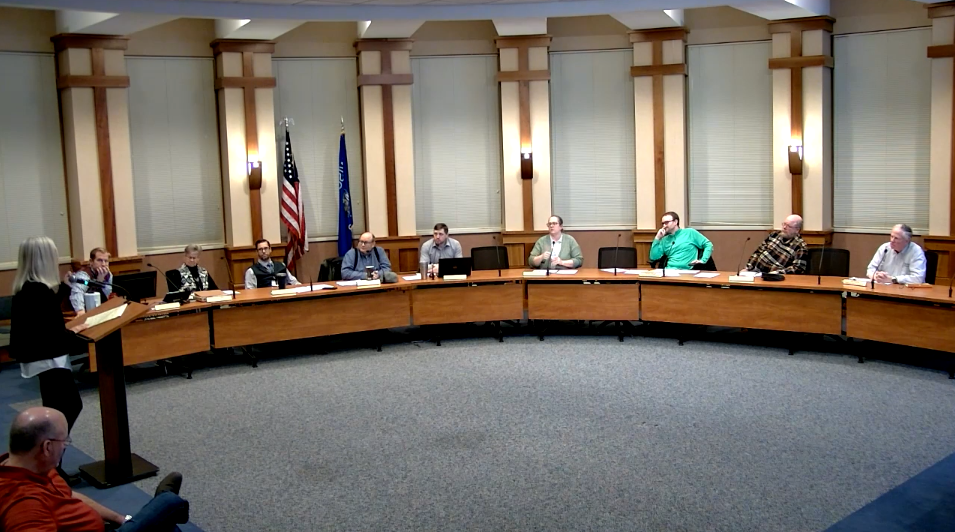
At the podium, Kristin Fish-Peterson, at left, a consultant hired to aid the city in developing a guiding policy and job description for a new Whitewater Community Development Authority (CDA) director, addresses members of the CDA. The presentation was the second of two given last week: on Tuesday to members of the Whitewater City Council, and on Thursday to members of the CDA. Screen shot photo.
Whitewater primary voters guide: Eleven school board candidates share views
(Originally published Jan. 23, 2023.)
Compiled by Kim McDarison
Eleven candidates are running for seats on the Whitewater Unified School District Board of Education. A primary election to narrow the field will be held Tuesday, Feb. 21.
Three seats on the district’s seven-member board will be decided during a spring general election on Tuesday, April 4.
The six top vote-getters emerging from the primary election will find their names placed on the April ballot.
Of the three incumbents holding seats to be decided in April, one, Thayer Coburn, has announced that he will be seeking reelection. Two others — Casey Judd and Steven Ryan — have said they will not seek another term.
Earlier this month, in addition to Coburn, 11 challengers threw their hats into the ring vying for a place on the board, creating a primary election field of 12 candidates.
Also earlier this month, one challenger, Nathan Vander Pas, announced by email that he had reconsidered his candidacy and would not be making a run. Vander Pas, within his email, did not offer an explanation for his decision.
Following the announcement made by Vander Pas, a field of 11 candidates — one incumbent and 10 challengers — remains.
Candidates winning seats in April will join school board members Jennifer Kienbaum, Larry Kachel, Maryann Zimmerman and Miguel Aranda, to comprise the district’s 2023 board of eduction.
Board members serve at-large and are elected to three-year terms.
The 10 primary election challengers are: Michael Bergman, Will Dammeir, Dan Dern, Stephanie Hicks, Lisa Huempfner, Joseph Kromholz, Christy Linse, Chuck Mills, Brian Schanen and John Truesdale.
Fort Atkinson Online recently asked each of the candidates to provide some biographical information and fill out a short questionnaire. Candidates were asked to respond to four questions using a combined total of between 700 and 1,000 words.
Candidates were asked to submit a photo for publication.
The electorate also will have an opportunity to see these candidates respond to questions during a candidates forum which will be held Saturday, Jan. 28, from 10 a.m. to noon, in the council chambers of the Whitewater Municipal Building, 312 W. Whitewater St., Whitewater. The forum is sponsored by the League of Women Voters-Whitewater Area.
Candidates’ responses to Fort Atkinson Online’s questionnaires, presented in alphabetical order, follow.

Michael Bergman
Age: 38
Address: N6323 Delany Road, Delavan
Occupation: Farmer
Number of years resided in the district: 10
Education: College
Civic and other organizational memberships: none
Political experience: none
What are your reasons for seeking this position?
I am running for the board because the taxpayer needs representation on the Whitewater School Board. Since living in the district, every four years the school district has demanded more money with little to show in advancement in extra-circular activities and academics. It is time to see the value of our hard-earned money do better for our school district.
What are the most pressing issues facing the position you seek?
I believe we should be preparing the students of our district for the world that they will be entering. I would propose mandatory classes suited to helping students learn skills necessary to survive outside in the real world. Classes that teach budgeting, how to pay taxes, financial management, preparing for retirement, balancing your checking account and how credit works. These skills are so important beyond our general education.
I also am a huge proponent of our technical education classes. Not every kid needs to go to college or technical school. Not every child is cut out to go to college or technical school. We need programs that encourage collaboration with local skilled labor such as: plumbing, electrical, welding and general construction. There is a need for people to enter the trades. Students need to be taught there are other opportunities beyond higher education that require skilled labor and provide higher income. Our country and communities need to see these skilled labor positions promoted. Kids need to know they have a multitude of options beyond higher education.
What unique perspective do you bring?
I bring a think-outside-the-box perspective to anything I do. In my line of work there is no option to fail, no option for a redo. We have to perform to make a living, so everything I work on and get involved with has to live up to a higher standard.
Any additional comments? An answer was not supplied by the candidate.
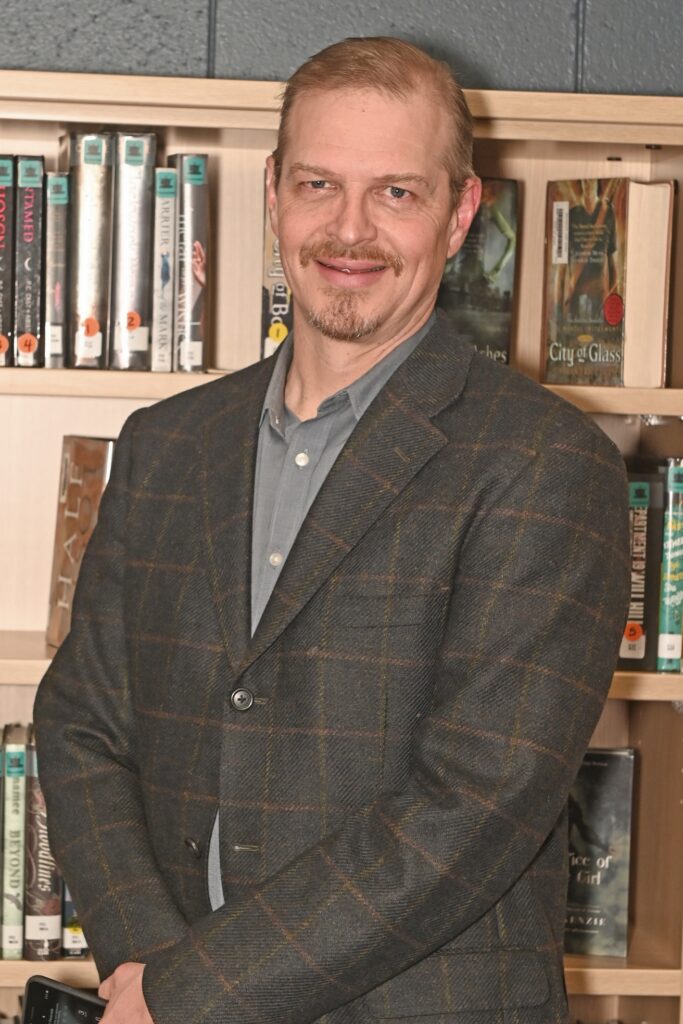
Thayer Coburn
Age: 51
Address: 509 S. Franklin St., Whitewater
Occupation: Owner, The Coburn Company, Inc.
Number of years resided in the district: 44
Education: Graduate of Whitewater High School; BA, Stanford University; MA, San Francisco Conservatory of Music
Civic and other organizational memberships: Current Whitewater School Board member, former member of the boards of the Whitewater Aquatic Center and the Whitewater Community Foundation
Political experience: 12 years on Whitewater School Board
What are your reasons for seeking this position?
Schools are the roadmap for a community’s future, and I am committed to helping Whitewater be the best it can be. Our district’s taxpayers invest millions of dollars in this shared resource every year, and they deserve to have their interests protected by somebody who brings an efficient, pragmatic, and open-minded approach to the job. If reelected, I will continue to build confidence in our public schools through transparency and good governance, and to monitor and question, but ultimately support our administration’s management of the district. I pledge to approach each issue on its own merits, with no specific policy objectives or plans to satisfy a particular constituency.
What are the most pressing issues facing the position you seek?
The most pressing general issue for the board is moving forward with the many recent changes in leadership and programming in the district. Our current Superintendent, Dr. Pate-Hefty, is by far the strongest superintendent I’ve worked with in my years serving on the Whitewater School Board. She joined the district at the beginning of the COVID-19 pandemic and had to make a lot of tough decisions while managing the district’s response. Nonetheless, she continued to push the district forward by reconfiguring several programs and responsibilities to the point where I believe the district in a much better place than it was when she started three years ago. Whitewater is fortunate to have a leader with the critical eye to see problems and the energy, knowledge, and fortitude to fix them. Dr. Pate-Hefty has stabilized the district’s foundation, and I am committed to helping her build on that foundation.
As for specific issues, we must continue to work to improve academic achievement throughout the district. We are already addressing this through two primary means – by aligning curriculum between the three elementary schools to ensure that all students are on the same page when they arrive at the middle school, and by increasing support for the relatively large number of English language learners (non-native English speakers) in our district. Aligning curriculum minimizes the amount of time spent re-teaching things, and supporting our English language learners increases their achievement while reducing distractions for classroom teachers. Both efforts will have a lasting, meaningful impact on our metrics – test scores, etc. – in the coming years, but will require patience and commitment to see them through.
We must also make sure every student that graduates from our district has the tools they need to follow their chosen path. Whether jumping right into the workforce, or going to tech school, college, or something else, we need to set up every student to succeed after they graduate. Our new high school principal Mr. Mansky is implementing many great new programs and classes to ensure that all of Whitewater’s high school students are ready for the next step in their journey. I look forward to supporting his ongoing efforts.
Finally, funding is always an issue. I was very grateful to the voters of the community for passing our most recent operational referendum, which will allow us to continue with the same level of services that we have offered for many years. However, due to a higher proportion of students with needs related to special education and language acquisition, and families below the poverty level, delivering education is more labor-intensive and expensive for the Whitewater Unified School District than for other districts around us. Funding is mostly controlled by the State Legislature, and I want to help work toward a state school funding formula that evens the playing field for districts like ours.
What unique perspective do you bring?
Being the only incumbent school board member in this race makes me unique. Serving as a board member for twelve years, including one year as the board president, has given me a perspective that few have on the challenges facing the district, and I believe that experience and institutional knowledge is invaluable. I understand the importance of working constructively with the professionals who administer, teach in, maintain and serve our district, and I understand the importance of faithfully working in our community’s best interests. Finally, as a lifelong resident of Whitewater, I believe I understand how our schools fit into our community and how to work with the city, the university, and private businesses for the betterment of all.
Any additional comments?
I am grateful that so many people have stepped forward to run for school board this year. The public benefits when they have more choices of candidates, and our schools benefit when a wider variety of perspectives are represented on the board.
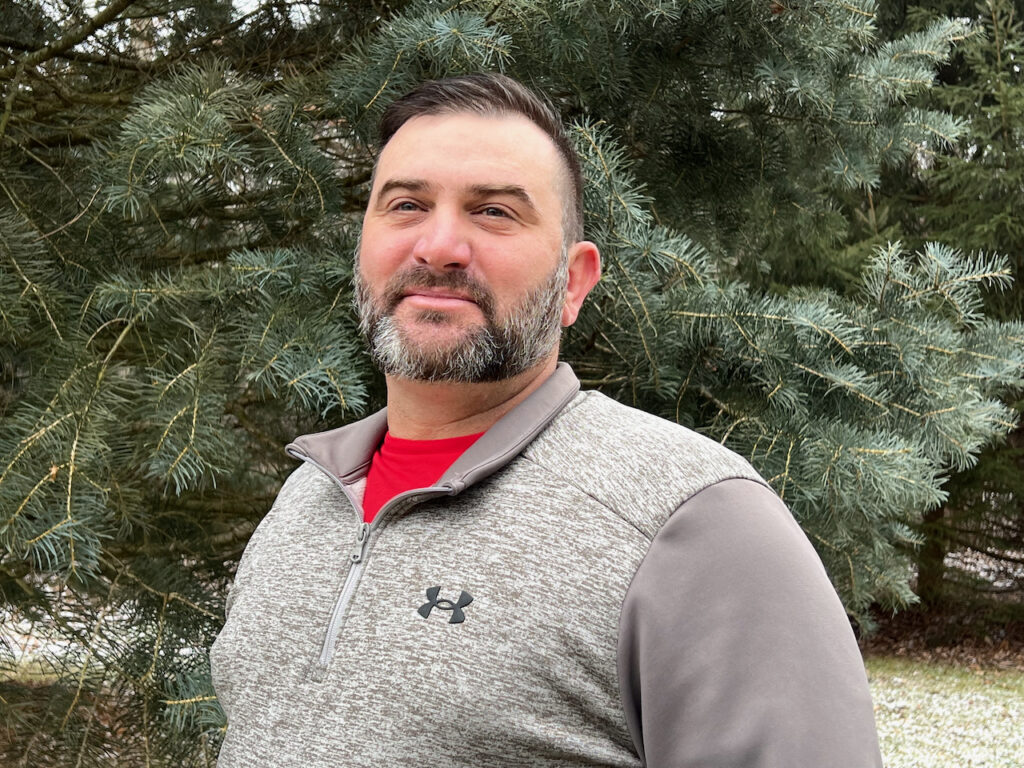
Will Dammier
Age: 45
Address: W9036 Lake Lorraine Rd. Delavan
Occupation: Self Employed
Number of years resided in the district: 23
Education: Dad of two young men, ages 12 and 8, journeyman tree surgeon, journeyman high voltage line worker, trained union steward, sergeant U.S. Army, Army combat life saver, combat veteran, business management, 7-plus years youth leadership, working on my masters degree from the “School of Life.”
Civic and other organizational memberships: 7-plus years youth coaching, 5-plus year Boy Scout volunteer, assistant den leader, den leader, cub master
Political experience: None, I observe, pay attention, and research.
What are your reasons for seeking this position?
During my time in the Army, one of our leadership courses taught about climate and culture. Climate is described as the atmosphere in an organization right now, whether it is positive or negative, whereas culture is the culmination of the climate over a long period of time. Generally speaking, when the climate of an organization changes, for good or bad, over a short time period, there is little to no affect on the long-term culture. Unfortunately the climate in our district has regressed so far for so long that our culture has been affected, which has led us to our current situation. I believe that strong, transparent and compassionate leadership, from the top down is what is needed to change the culture for the better.
What are the most pressing issues facing the position you seek?
The most pressing issues facing the school board are lack of transparency, trust and accountability. There has been a history of closed door meetings, lying through omission, and back door conversations that have led us to our current situation. Our staff does not feel comfortable expressing themselves due to fear of retaliation, from either the school board or administration. Finally the board and administration need to be held accountable for decisions that have been made regarding allocation and disbursement of funding, and the metrics, if any, that have been put in place to measure success or failure.
What unique perspective do you bring?
I bring a true, blue collar, tax paying, middle class perspective to the table. More importantly, I bring a point of view that has been evolving over the course of 7 years, being actively engaged in our youth through volunteerism and coaching. Our youth, regardless of race, religion or social status are capable of great things, they just need the opportunity to express their potential. It is the school’s obligation to help prepare them, and give them a platform to do so.
Any additional comments?
My first priority, if elected, would be to observe. I would meet with the district administrator, principals of each school, most importantly our front line educators who are in the classroom, and students. We often disregard their opinions, however solutions can often be found where we least suspect them. We were given two eyes, two ears and one mouth for a reason. If effective changes and decisions are to be made, we should use our first two senses twice as much, which will allow our words, when spoken, to carry twice as much weight.
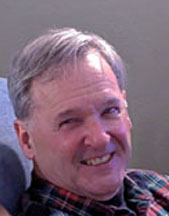
Dan J. Dern
Age: old enough to vote
Address: N7536 W. Lakeshore Dr., Whitewater
Occupation: Retired
Number of years resided in the district: 19 years
Education: BS Engineering and MBA
Civic and other organizational memberships: Whitewater Parks and Rec.
Political experience: Corporate politics.
What are your reasons for seeking this position?
I have lived in the district for almost 19 years and am a product of public education. Milwaukee PS and UWM (BSME). I have a somewhat unique background that can help the district to continue to move forward and I want to give back to my community
Let’s face it, these are trying times in education and I believe I can help shape the path forward.
What are the most pressing issues facing the position you seek?
Continuing to improve the performance of the students by addressing the needs of the students, parents (guardians), community, teachers, and administrators.
Assuring that the dollars spent on education are value-added and that our students are prepared for their future roles in life. Getting back to the basic fundamentals of education.
What unique perspective do you bring?
Over 40 years working in the private sector with 25 years of that in Fortune 100 and Fortune 50 global corporations at senior management levels, including but not limited to:
• Leading and developing teams and individuals in a diverse global environment.
• Strong management and leadership skills.
• Multimillion dollar purchasing and procurement.
• Global multi-site responsibility.
• Regulatory responsibility (OSHA, FDA, EPA, DNR, etc.).
• Strategic planning and execution.
• Staff development, training and consulting.
• Manufacturing plant management/division senior management.
• Financial: P and L, budgets, capital.
• Substitute taught at every school in the district.
Any additional comments?
I truly believe I have many unique experiences, learnings and education that will have value to the WWUSD School Board as well as the community, teachers, administrators and students. We all have limited resources and the school district is no different so we must assure we get the best results possible when working within those constraints while ensuring that the students continue to receive an education that will help them in their future endeavors.
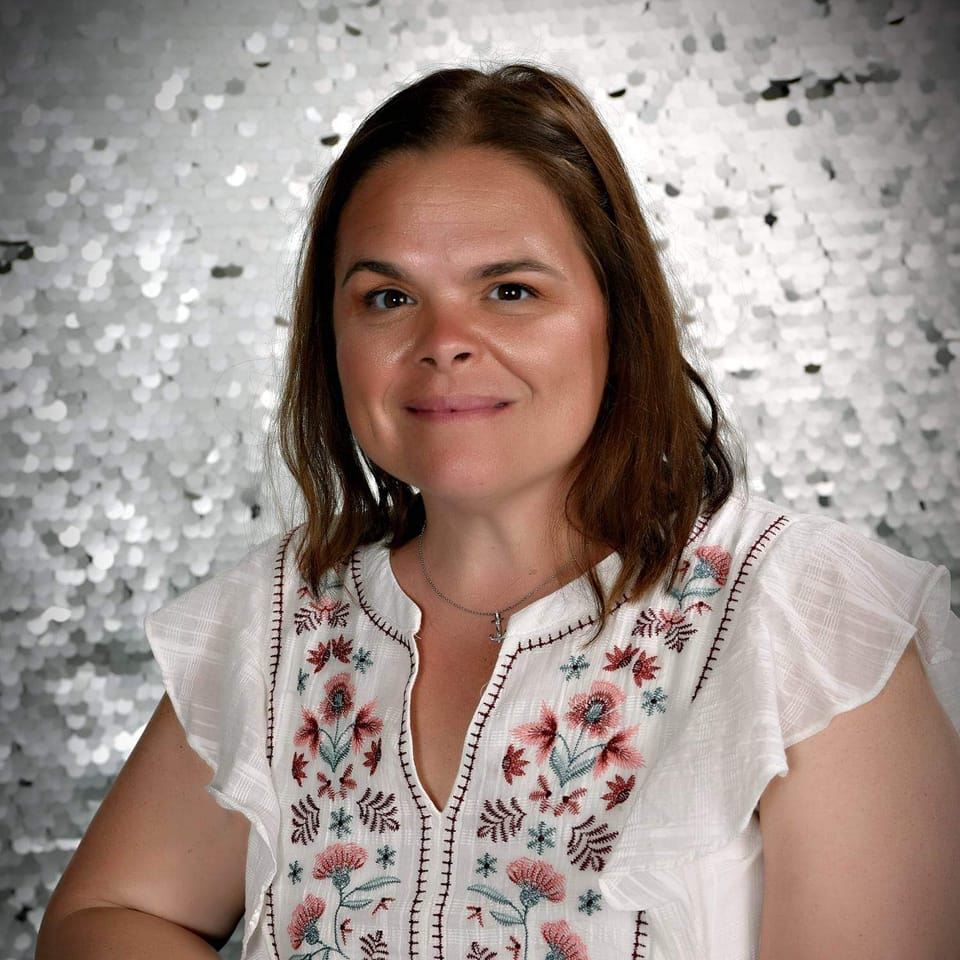
Stephanie Hicks
Age: 41
Address: 1254 Tower Hill Pass, Whitewater
Occupation: Special Education Early Childhood Teacher
Number of years resided in the district: 23
Education: B.A. UW-Whitewater in Special Education Early Childhood; M.A. in Educational Leadership from National Louis University
Civic and other organizational memberships: N/A
Political experience: N/A
What are your reasons for seeking this position?
I believe we can do better for our children and our city. I believe our community’s future depends on the ability of our district to bring excellence with equity to all students. It starts with our ability to build stronger relationships between our community and our schools. That should always be based on honesty, integrity, and transparency. I am also a mom of two children in the district and I am fully invested in the schools doing well. Like all parents, I want what’s best for my children and that includes a top-notch education.
What are the most pressing issues facing the position you seek?
One of the biggest issues facing school districts at this time is the need to attract and retain qualified teachers. Due to the recent loss of teachers within our district, we need to reexamine our current district policies and procedures. In addition, we need open and honest communication between our current staff and school board as well as conduct exit interviews to better understand how to improve as a district.
Secondly, school safety has and will always remain a top priority of the school board. It is the district’s number one job to keep their children safe within their schools. It is the school’s responsibility to foster a culture of communication where students feel safe reporting information. It is imperative that there are procedures in place that continuously and adequately monitor classrooms and public school buildings. It is critical we continue to cooperate with law enforcement. But most importantly, if a threat is made to a school, it is taken seriously, it is responded to in a timely manner, and appropriate actions have been taken.
Lastly, strengthening academic achievement within our school. Giving our students the best experiences and opportunities possible, teaching them how to be good citizens and human beings, and preparing every student who graduates to be college or technical school or work ready is the end goal. It is our job as a school board to ensure that how we get to that is always under review, reflected upon, and changed accordingly to the diverse needs of our students.
What unique perspective do you bring?
I have been a special education teacher for 19 years in the public school system, along with numerous leadership roles within my profession. I have strong communication and collaboration skills. I consider myself open minded and I am an “outside the box” thinker. I am very detail oriented and goal driven. I am an extremely hard worker and feel I have a very strong rapport with those I work with. These skills and experiences allow me to come to the school board not only as a community member but also as a professional educator. I feel that it is extremely important to have someone around the table with that experience who can relate to the ins and outs of a school district on a daily basis.
Any additional comments? An answer was not supplied by the candidate.
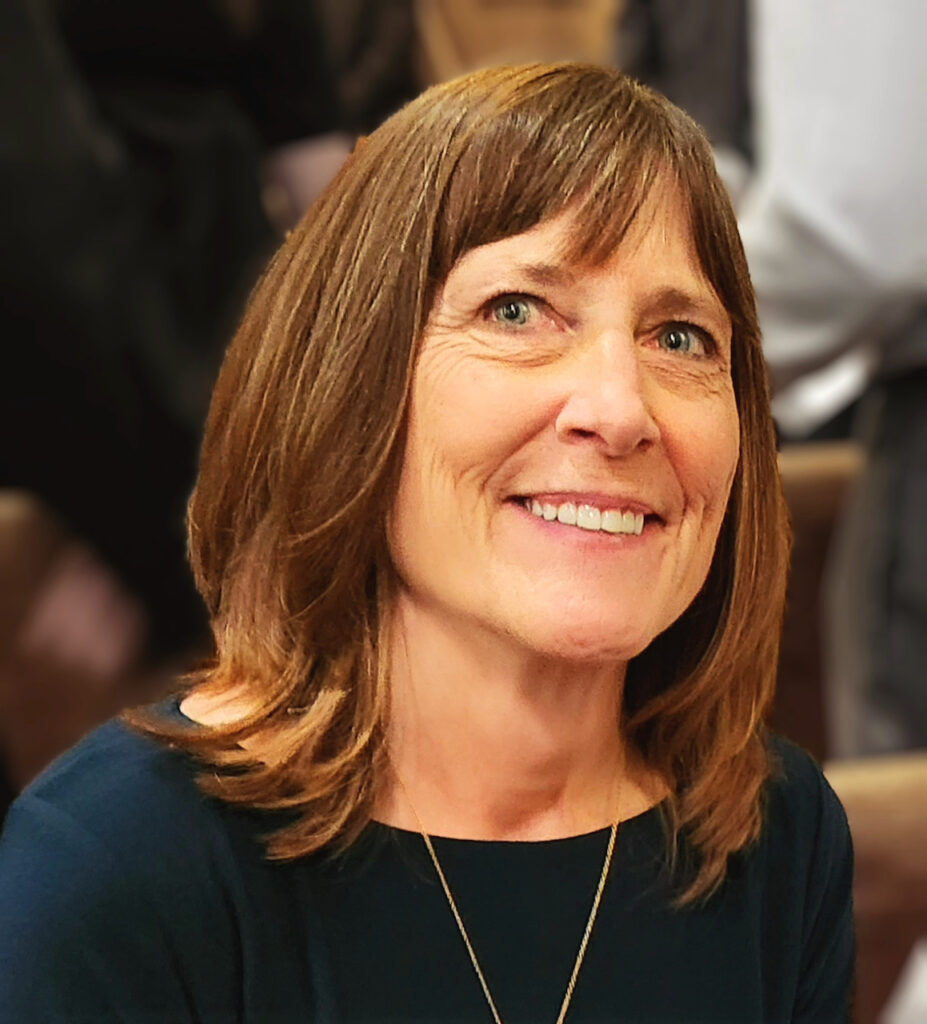
Lisa Huempfner
Age: 60
Address: 976 W. Charles St., Whitewater
Occupation: Associate Professor of Spanish
Number of years resided in the district: 11.5
Education: Ed.D. Educational Leadership and Policy Studies, University of Vermont, I did my doctoral research with a Fulbright Scholarship to Spain; MA Hispanic Literature, University of Arizona, and BA Journalism and Latin American Studies (double major), University of Arizona
Civic and other organizational memberships:
• Whitewater Leads
• Conexiones Latinas
• Community Partners of Jefferson County
• WUL (Whitewater Unites Lives)
• Whitewater Youth Soccer Organization
Political experience: None
What are your reasons for seeking this position?
I am running for school board for a number of reasons. First and foremost is that I care about kids, all kids. In addition, I believe that healthy schools are at the heart of healthy and thriving communities and as a member of this community I want to contribute to its well-being. The recent influx of immigrants to our community in addition to the pandemic and other events have placed some unusual strains on the district, and I believe I have the knowledge and experience that the school district and larger Whitewater community need to help successfully navigate these challenges. An obvious priority for me, given my professional and experiential background, will be to help the district to make sound decisions regarding the integration of immigrant children, while at the same time meeting the needs of all kids and promoting programs and instruction that will move our district forward in the 21st century
What are the most pressing issues facing the position you seek?
I think the most pressing issue for the Whitewater Unified School District at this moment is how to successfully integrate all of the new immigrant children that have arrived in our community over the past couple of years while at the same time, meet the needs of all of the other children and families as well. This, while the district, as many others throughout Wisconsin and the U.S., is trying to bring instruction and learning back to where it was pre-pandemic, and at the same time retain good teachers and move forward.
What unique perspective do you bring?
My professional training and research is in the area of Educational Leadership and Policy Studies, but perhaps more importantly, I have been involved with public education throughout my life. Before taking my position in Spanish at UW-Whitewater, I not only had taught for a number of years at other colleges, but I had worked as a developer of the Spanish version of the Iowa Tests of Basic Skills and researched the assessment of bilingual children and I coordinated a large Foreign Language Teacher Education Program at Illinois State University for eight years, among other educational stints. The former opened my eyes to many problems within school assessment systems, particularly, as they pertained to bilingual children, and the latter took me to many schools throughout central and north central Illinois to observe teachers. I also regularly attended and participated in professional conferences on the teaching of languages.
Since moving to Whitewater in 2011, I have been involved on both a professional and parental level in the schools. Every year, I place my students in the schools as volunteers and I frequently collaborate with teachers and school personnel on a number of matters, especially as pertain to bilingual education and outreach to the Spanish-speaking community. In addition, I was a very active school parent throughout my son’s journey through the WWUSD, serving on the PTA at both Lincoln Elementary and the middle school and volunteering for sports and music programs. In his 10 years of school here, I don’t believe I missed a single school or extracurricular event in which my son participated. This has allowed me to meet a lot of school district parents and learn of their perspectives regarding the schools. My son graduated from Whitewater High School last spring, so my familiarity with the schools is very fresh. Through my involvement in a number of community outreach groups, I also am connected with many service providers in the area and have collaborated with several Whitewater business leaders to promote literacy in Whitewater schools.
But while I have an extensive background in education and Spanish, I think it is important to note that my roots are in a working-class family of Green Bay. This, I believe, lends me an understanding of many of the values and desires of a lot of our community members who come from similar backgrounds. It is my ability to cross boundaries and understand varying needs and perspectives that I believe can help our district to confront challenges and develop solutions that can be beneficial to all.
Any additional comments?
While I feel my knowledge and experience is especially pertinent to the current demographic shift in Whitewater, I would like readers/voters to know that my knowledge and concerns extend well beyond this matter. I care deeply about the success of all of our children and am aware of many other challenges faced by our schools such as:
• School safety
• The availability and use of alcohol and substances such as vaping and marihuana
• Social media influences on youth as well as excessive screen time
• Bullying
• An increase in depression and other mental health problems
• Poverty and homelessness
• Teacher burn-out
• School funding issues
• Student apathy for learning
• Family issues affecting students and learning
• Inequalities in resources across students
This said, my general experience has been that the teachers and administrators in our district truly care about our kids and many, if not most of them, go beyond their official duties to do all that they can for the betterment of our students.

Joseph Kromholz
Age: 61
Address: 393 Eagle Court, Whitewater
Occupation: Attorney
Number of years resided in the district: Since 2003
Education: JD
Civic and other organizational memberships: Former member of the WUSD School Board, current member of the Whitewater Community Development Authority, and current member of the Whitewater University Technology Park Board.
Political experience: Previous member of the WUSD
What are your reasons for seeking this position?
I am running for school board because I believe in public education and, in particular, believe that Whitewater schools do provide an excellent education for our children. However, our schools require the strong support of our community and the school board, and I fully intend on providing my strong backing to support our schools.
My priorities will be (1) to ensure that all teachers and children are treated equitably and have the support that they need; (2) to ensure continuity of current programs, support movement toward fully achieving a dual-language program in our schools; and (3) to increase funding and support for technical education.
What are the most pressing issues facing the position you seek?
There are many pressing issues, but it is my position that we must emphasize continued movement to a dual-language program and vastly increase the role of technical education. If all of our children can leave the WUSD with competency in two languages as well as a sound foundation in technical education, then those kids will be highly employable and successful regardless of whether or not they choose to go on to higher education or to directly enter the workforce.
In addition to continued movement toward greater emphasis on training our children to speak at least two languages, we must pursue greater funding for technical education and improving technical education resources for our students. Fundamentally, this comes down to continuing current programs, using current resources wisely, and pursuing additional funding for the district. All children need to be given the opportunities to succeed. For some this may be to go to college and for others this may be to go to work in industry. Local and national industries need qualified, skilled people. For too long we have underfunded technical education in our school system, and we have fallen behind in the types of training and education that other districts offer. For example, the state of Wisconsin currently has a five billion dollar surplus and yet none of that surplus is being earmarked for education. That said, I am encouraged to learn about the dual-degree opportunities now offered by Gateway through our high school. I believe continued support and funding of such programs can only bring benefits.
We should continue or enhance programs that provide a strong civics foundation in teaching our history including strong foundational knowledge of the Declaration of Independence and the Constitution.
What unique perspective do you bring?
I have previously served on the school board so I am familiar with its role and operations. I have been a lawyer in this state since 1989 and served on numerous committees and organizations. I have also lived in Whitewater for nearly 20 years and my son received an excellent education through the school. I am therefore very familiar with the city and its environment and am familiar with working with people here to reach consensus to achieve goals.
Any additional comments?
It is my position that we need focus on ensuring continuity and stability in our educational system. I believe that kids and teachers will do better when the policies support them and provide them with steady and consistent guidance.
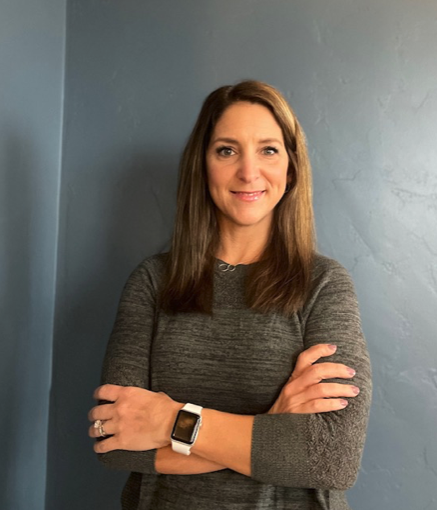
Christy Linse
Age: 44
Address: W5106 Meske Rd. Fort Atkinson
Occupation: Clinical Specialist for medical device company
Number of years resided in the district: Born and raised in the district. Moved to Milwaukee area for school and job for about 10 years. Have been back in Whitewater district for the last 14 years.
Education: Associates Degree in Cardiovascular Technology. Bachelor’s Degree in Health Service Administration
Civic and other organizational memberships: Previous memberships in healthcare-related organization (Society of Invasive Cardiovascular Professionals). None currently.
Political experience: None
What are your reasons for seeking this position?
I’ve listened to parents, teachers, and community members voice their frustration over the current state of the district and various board decisions that have been made. Some of these frustrations are shared and others are unfamiliar to me. The more I learn, the more I want to be involved. I have a vested interest in the school district. My son attends this district; his friends attend this district, some of my friends work in this district. This district represents our community. Their success will be a result of our decisions. I want to be a part of that success.
We need people on the board who are going to take the time to research, question all decisions and discern the truth. Input should be obtained from various sources before any decision is made. I want to see problems openly addressed and metrics put in place to evaluate outcomes. Teachers should have confidence their concerns will be heard without fear of retaliation. Leadership should admit shortcomings and not be afraid to change course to achieve the desired conclusion.
What are the most pressing issues facing the position you seek?
My priority will be to strive for excellence in academics, sports, and personal conduct. The first thing that must be done is for the board members to admit we are failing our kids. The board needs to take accountability for this and now address it head on. Current metrics measure success on academic achievement. Our district needs improvement here. Why isn’t the board asking why this is happening or how can they fix it? Why haven’t we compared our best practices to other successful districts? Additionally, we need more transparency. The district has been described to me as top down leadership. The lack of transparency in our district has greatly depleted trust and morale within staff and community.
What unique perspective do you bring?
A new perspective. A fresh perspective. Every position I’ve held requires a team approach with an emphasis on communication. I work with people from all different backgrounds; this promotes better outcomes within my field. I’ve learned to listen first and act second. The more questions I ask, the more we all learn together. I am not afraid to politely challenge decisions that don’t make sense. I can keep the end result in mind when making decisions. I believe these attributes would serve this board well.
Any additional comments?
I was born and raised in Whitewater. Born as Christy Boyer. My family has been a part of the community in numerous ways. My grandfather was a business owner (CK’s Keg, Citgo Service Station at 5 points), police commissioner, and university maintenance. Not to brag, but he is currently the oldest living retired police officer and volunteer fireman in Whitewater. My mother retired from the Whitewater post office and my father worked construction in Whitewater and surrounding areas. Family and friends are still business owners in Whitewater; a cousin is currently a police officer here (officer of the year 2022). I attended Whitewater schools and was the second class to graduate from the “new” high school. I have amazing memories of the “old” middle school. This should give many of you a perspective on how long I’ve been around. Hehe.
Skipping ahead to my adult years, I have, for most of my adult life, worked taking care of others. I spent 14 years working alongside physicians in the Cardiac Cath Lab and Interventional Radiology. I transitioned out of a single hospital system and joined a medical device company where I currently support physicians in multiple hospitals across Wisconsin.
I married another Whitewater lifelong resident, TJ Linse. We currently have one child in middle school; the older is working full-time selling insurance with State Farm near Milwaukee. Thomas is doing well in middle school and even decided to join wresting again. He has a great friend group that has allowed us to also have a great friend group in the community. As a family, we enjoy camping, biking, skiing, gardening, and bee keeping. We live on the edge of town with our dogs and chickens.
I consider myself very approachable and welcome questions and dialog. I look forward to hearing from you.

Chuck Mills
Age: 62
Address: 707 E Milwaukee St., Whitewater
Occupation: Owner/Operator: Mills Automotive
Number of years resided in the district: 30 years
Education: ASE Certified Mechanic; State Certified Welder; CDL Driver; ABCDM (doubles, triples and tankers)
Civic and organizational memberships: Most recently, “Kids Mechanic’s Club”
What are your reasons for seeking this position?
• Reestablish the vision of our school board to better prepare our students for their immediate and distant futures.
• Restore the highest standard of education that will place our students in a competitive position for the “real world.” Competency will no longer be the standard and I will discourage any curriculum that does not meet the highest quality standards. Specifically, I will deter the teachings of gender identity and expression (LGBTQ Curriculum) because of the lack of experienced educators and developed curriculum on this topic.
• Renew enthusiasm for education and praise the young minds who thrive beyond the standard set by institutional status quo.
What are the most pressing issues facing the position you seek?
Misrepresentation and lack of transparency under our own roof; what now?
• Dissolving and reinventing the way in which we conduct a school board meeting will help us to reestablish, restore and renew the readiness of our bright young minds for their futures. We must first provide exemplary communication within our own team in
order to make effective change in our classrooms.
• Creating a voice for the students that speaks volumes to the school board will be a challenging and exciting opportunity for this elected team.
• Designing a clear pathway for community members to voice concerns and have them heard with integrity has the potential to bring collaboration and clarity between the school board, community and most importantly, the students.
What unique perspective do you bring?
Perspective is valuable when heard. The unique perspective I bring to this team of board members is that of the students themselves. My own perspective is a fraction of what is needed to fill this seat. Establishing a clear path of communication between the school board and student body will be the first step in providing me the opportunity to have the students heard. The students’ front-row perspective in collaboration with my determination to arrive at every discussion with the highest of standards for their futures (only their futures) in mind; this is the unique and urgently needed perspective I bring.
Any additional comments?
Unity and leadership will be requisites to ensuring the Whitewater School Board can refocus the vision and resources to better the overall education of our students. We must hold ourselves accountable to ensure there is a parallel relationship between the intent and impact of the Whitewater School Board. The greatest opportunity for improvement is to identify where we have formerly detoured our execution of intentions, resulting in negative outcomes. If elected to a seat on the Whitewater School Board, I will unify the communication between the school board, community members, and most importantly the students. We will work in collaboration to align the intent and impact of our decisions. Because ultimately they’re worth it.

Brian Schanen
Age: 30
Address: 1199 E. Bluff Rd., Apt 203, Whitewater
Occupation: Lecturer at UW-Whitewater
Number of years resided in the district: 11.5
Education: Bachelor of Arts in Communication from UW-Whitewater, Master of Science in Mass Communication from UW-Whitewater
Civic and other organizational memberships: My fiancée and I recently joined the Whitewater Grocery Co. Additionally, I have been a member of the City of Whitewater Community Engagement and Cable TV Commission for the past two years.
Political experience: Beyond my work with City of Whitewater Community Engagement and Cable TV Commission, I have not held any political offices. It is my belief that schools should not be political. They should be laser focused on helping students become problem solvers, critical thinkers and good citizens.
What are your reasons for seeking this position?
I grew up just north of Milwaukee in Port Washington. Thinking back to when I was in first grade while, I did not know what exactly was happening at the time, I remember teachers not being happy with the school board. They had signs outside their classroom with sad faces stating their displeasure, note that that is a memory that has stuck with me for over 25 years!
Shortly after a new superintendent was hired. They stayed in the position for over two decades and did a lot to heal administration, teacher, community relations. When he announced his retirement the other year, you could feel everyone in the community, regardless of political opinion, acknowledge the loss, even from a distance (I keep an eye on where I grew up).
Having gone to school in a district where we had a strong leader, and strong district-community relations, I have seen firsthand the power that can have. It retains staff, it helps with alumni relations, and most importantly, it leads to student success. Over the last decade I have watched as districts across the state lose that connection. Districts and communities are becoming more fractured, and as that happens, students lose. Teachers leave, scores fall, and students disengage, with test scores following. I do not want to see that happen to Whitewater.
Whippet (and Warhawk) pride is a vital part of what makes Whitewater, Whitewater, and I want to help that bloom even more. It means working to mend the breaks in trust between community and the district that have occurred in recent years. It means becoming better at communicating when these complex issues arise.
What are the most pressing issues facing the position you seek?
The district is losing the open enrollment battle. Districts such as Elkhorn and Delevan-Darian are piloting programs (e.g. DD Tech) that meet students where they are at. In this region college is nowhere near a one-size fits-all solution. Having programs that specifically target students interested in trades, tech school, and work ready programs is essential.
While the recent partnership with Gateway is a great start, Whitewater must continue to find innovative and cost effective solutions to meet students where they are at, this means a few things.
• Learning what their interests, and goals are beyond school. The curriculum must match were our students are, and where we hope they get.
• Publicly supporting a wide variety of after school programs, not just athletics. Music ensembles, forensics, robotics, honors programs and the other countless programs. These programs not only have a significant impact on student success, but it gives them a sense of belonging. When students feel that they have a place in the larger school community, success comes with it.
• Ensuring an appropriate curriculum. Students in the Whitewater Unified School District have a wide range of talents, lived and developmental experiences. Every district has unique challenges when it comes to developing curriculum for students, and teachers are best suited to manage this. It is important that state standards are met, but they need to be met in a way that fosters student success. One-size fits all commercial curriculum is often not the best strategy. They often leave a large segment of students behind, often those at greatest risk, and they lose interest and don’t reach their fullest potential.
What unique perspective do you bring?
Education has always been important to me, and education policy an interest of mine. My fiancée, sister, brother-in law and myself all work in education. We see first-hand every day the unique challenges today’s students face, and the strengths they possess. We have had many conversations about how much education has changed in just the past ten years, from when I was a student.
The environments that schools are operating are different, and pandemic aside, the students are different. The world is a different place, and employer’s needs are different. It is critical that school boards work to make sure that decisions are made with a clear understanding of current student experience, and current workforce needs. My close connections to the education world help bridge the gap between policy and the people those policies affect.
Any additional comments?
I am a firm believer in elevating students’ voices, because at the end of the day, any decision the school board makes will impact them in some way or another, whether it is staffing, curriculum, budget, or any of the countless other decisions the board makes.
If elected, my priority will be ensuring that school board decisions do at least three things:
• Meet students where they are at.
• Ensure students will be college, technical school or work ready when they graduate.
• Be fiscally responsible.

John Truesdale
Age: 80
Address: 175 N. Esterly Ave., Whitewater
Occupation: Retired UW-Whitewater Program Administrator
Number of years resided in the district: 51
Education: UW-Madison, B.S. in Sociology; UW-Milwaukee, M.S. in Counseling Psychology; UW-Madison, completed coursework toward Doctorate in Educational Administration
Civic and other organizational membership: Registered Official in Wisconsin Interscholastic Athletic Association (WIAA).
Political experience: was elected and served four years as secretary and president of the Master Board that ran a 4,000 resident community with 225 employees and an annual budget of $15-20 million dollars.
What are your reasons for seeking this position?
Provide a better educational and developmental environment for students, staff and the community as it tries to overcome the deficits created by the Covid-19 pandemic.
What are the most pressing issues facing the position you seek?
Bringing students’ educational and developmental environments back to where they were before the pandemic struck.
What unique perspective do you bring?
I have experience in developing new programs to meet student needs at UW-Whitewater over a 30-year period. That effort was recognized by the national organization of student affairs professionals when they recognized the UW-Whitewater program as one of the best of its kind in higher education in the country. I have also served as a member of the Governor’s Committee on the Problems of Persons who Happen to Have Disabilities.
Any additional comments?
Students are facing educational and environmental deficits caused by the Covid-19 pandemic. We need to bring all members of the educational community together to work to address these deficits.
Whitewater: ‘If we don’t stand up, they’re going to fall down,’ Landmarks commissioner says
(Originally published Jan. 28, 2023.)
By Chris Spangler
Four of Whitewater’s historical landmarks are deteriorating and in dire need of restoration.
That was the message that members of the city’s Landmarks Commission shared with 40 people attending a presentation at the Irvin L. Young Memorial Library Tuesday.
The commission outlined the history and repairs needed to save the Birge Fountain, Starin Park water tower, White Memorial Building and Whitewater Effigy Mounts Preserve, and encouraged public action.
There are 27 landmarks in Whitewater, eight of which are city-owned.
“The Landmarks Commission has existed since 1985 … and its main two functions are to nominate and designate local landmarks, which then are protected by local ordinance, and to also provide educational programs such as this,” member Kori Oberle told attendees. “Tonight we are focusing on four local landmarks of varying ages spread out around town, and we’re here simply to provide historical evidence and scientific fact about where they’re at in their lifespans.”
Starin Park water tower
Commission member Dan Richardson reported that the Starin Park water tower was built on Prospect Hill, one of the highest points in the city, in 1889. Its construction was sparked by a fire at the Whitewater Normal School a year before.
“The fire was put out and the damage was repaired rather quickly, but then the city fathers began to realize it was pretty necessary that they have a water system,” he said, noting that there was neither a water nor sanitary sewer system in Whitewater a the time.
The city contracted with the Gray Construction Co. of Chicago, which built the water tower and owned it until 1912, when the city took over.
“When the water tower was first built, they didn’t put a lid on it; it was open. They decided that probably, for health purposes, they should cover it,” Richardson said.
The tower stands about 100 feet tall with eight courses of locally quarried limestone. The base foundation of the tower itself is eight feet thick and the pedestal of limestone rises eight feet up with courses. The tower’s tank held 185,000 gallons of water, or about 770 tons.
“So the eight-foot base narrows down to about four feet at the steel tank at the top,” Richardson said, noting that it was decommissioned when the new water tower went into use late last year.
“A couple years ago if you’d walk by, you would have noticed that pieces of stone the size of your fist, some even bigger, had fallen off the building, and it was a cause for concern,” he said.
Last year, Cornerstone Restoration of Sullivan performed tuckpointing on the 80-foot stone portion of the tower, much of it in the interior.
Cornerstone reported structural problems with the water tower, prompting the city to hire McEnroe Consulting Engineers of Wauwatosa to undertake a structural study.
“They found quite a few things wrong with the water tower, but that imminent collapse is not evident,” Richardson said.
What McEnroe did find included:
• The stone belt courses that encircle the tower need replacement.
• The entire masonry exterior needs to be cleaned.
• Mortar wash comes off of the top of the tower under the steel tank, as well as the base of the masonry wall.
• The top of the tower wall should be replaced completely.
• There are a number of places where stones need to be replaced, arches need to be fixed, exterior joints need to be tuckpointed and cracks need to be filled.
“They also indicated that there’s been no structural study of the tank at the top of structure at this point, but there are repairs that probably need to be made at the base; that’s as far as it went,” Robertson said, adding that various steel repairs are necessary, including the interior ladder, and doors in at least five locations require replacement.
McEnroe recommended an eight-step process for repairs, divided into three phases.
He said that phase one includes repairing the masonry seal at the top of the tower, considering repairing the entire top of the tower, continuing work down the tower as funding allows, and fixing missing stone and cracks that are of major concern.
“The cost of phase one was equivalent to the cost of tearing it down,” Robertson said of the water tower, noting that the phase-one repairs would cost $590,000 while demolition of the tower would be $600,000, in 2023 dollars.
The next two phases would continue repairs throughout the structure.
“And then, of course, you get to the end, not considering the steel tower at the top, and the building needs to be maintained,” he added.
One attendee asked why nobody noticed the deterioration throughout the years.
“We’re really not sure, but we don’t want to put blame over time. Whether they were employees or volunteers, we’re very grateful that these artifacts have been taken care of to the extent that they have been and that they’re still with us,” Oberle said. “That’s the road that we’re traveling.”
Attendee Doug Anderson pointed out that deterioration will speed up now that the tower is not in use.
“As they age, they come apart, and that’s natural,” he said. “It’s been in use; now it’s not going to be used and this is the perfect time to evaluate it.
“I think that you guys were really responsible in taking it over. The city could have said ‘you know, it’s $600,000 and we’re done’ or ‘it’s $600,000 and every five years or 10 years or 20 years we’re going to have to come up with other big sums.’ And not being in use, it’s going to deteriorate more than being in use,’” Anderson added.
Oberle emphasized that the Landmarks Commission is limited in how far it can go.
“We have no fiduciary ability so the best we can do, charged with preservation and education, is call attention to the fact that something needs attention and that’s what we’re trying to do,” she said.
The commission was asked whether, even after the suggested repairs, the interior of the water tower would be able to be toured like the tower in Fort Atkinson.
Richardson said that the Starin Park water tower has a rusty ladder in the interior, not stairs like Fort Atkinson’s tower.
“That rather substantial staircase is not the original or a reproduction. That was added to be for tourists like us and so, depending on what happens in the future to the water tower, that could be installed if enough people had deep enough pockets to make it happen and the city agreed to let it happen,” Oberle said.
She handed out common council and city officials’ contact information, urging attendees become involved and take their concerns to those in power.
Effigy Mounds Preserve
Oberle said that in 2024, the city will have owned the Effigy Mounds Preserve for 50 years and it will have been a local landmark for 30.
“Over the last five years — again, we’re not pointing any blame, but we could give Mother Nature a slap on the back for not cooperating — the landscape has gone wild,” she said. “We could do a nice TV series on landscapes gone wild there.”
Oberle noted that the 13 mounds need to be measured by archaeologists. The walking path has disappeared beneath overgrown plants and trees, and state statutes have increased the buffer around mounds from five to 15 feet.
“We have a big expense, the city does, to restore the landscape so that a new path can be laid that allows the archaeologists in there to measure them,” Oberle said.
She noted that mature trees are growing at the edges of the mounds and within the five-foot buffer. Should a windstorm pull them up by the roots, the city would be breaking state statutes by disturbing the ground.
“In some cases, part of the softening of the landscape issue is to remove trees at the surface and let the stumps just biodegrade,” Oberle said.
The invasive weeds and trees have grown taller than the preserve’s signs in the five years since landscape maintenance was discontinued.
Oberle said that in September 2021, the Landmarks Commission presented a more-detailed program on the mounds preserve to the common council and wrote a letter to the city manager. As a result, a onetime $25,000 was earmarked for 2023 to be used toward some of the management issues and, hopefully, the archaeological measurement, according to Oberle.
In addition, the commission is in the final throes of applying for state grant that, if approved, would match the $25,000 city monies. It would be used for outfitting the empty lot that sits on Indian Mounds Parkway.
“It’s just a green empty space. It has a sign on it and a pine tree and a display guide. We would like to turn it into the most enchanting people-centered destination park in the world,” Oberle said. “I said destination park. It’s not a Disney park. It’s a place for people to go and find community in the tradition of all of the native peoples that came and went from the preserve during thousands of years and celebrated and performed rituals.”
She described the area as having places where people can gather, eat and drink and exercise.
“There’s a place for doing yoga, there’s a play area with cool things made out of tree parts and a magnification station and a mounted telescope looking into the preserve,” Oberle explained. “There’s a path that runs through the middle, which is our very best marketing device because it signals to anyone walking, biking or driving by that it’s the yellow brick road and ‘let’s go see what’s at the end.’ … Then people will be curious to find out about more of what’s inside.”
She said the area is being called the preserve gathering space. It will not be known until May whether the grant will be awarded.
“Several of us in the community are committed to doing some private fundraising if the grant isn’t awarded so we can make something happen,” Oberle added.
White Memorial Building
The White Memorial Building is so named because it was a gift from Mary Flavia White and her family in 1904.
Oberle said it is one of about two-dozen library buildings in Wisconsin designed by Cloud and Stark, a team of architects in Madison. It is a Carnegie library, having received funding from the Andrew Carnegie Foundation with the requirement that it be designed by a local architect.
“It is architecturally significant for Whitewater, but also beyond,” Oberle said. “It is a candidate for the National Register of Historic Places as a structure, even though being a city landmark provides it more protection through the municipal code. The national register listing and the state listing are purely honorary. They’re feathers in the cap.”
Unfortunately, she said, moisture has gotten in between the bricks and freezing and contracting has caused mortar to fall out.
“On all four sides of the building — and it’s a big building — I was able to stick my little finger and my ring finger in between most of the bricks. It needs tuckpointing bigtime,” she continued. “Every time it rains and rain is blown by the wind, water gets in there and causes damage. It’s not just sitting there looking nice. It’s kind of like aging before our eyes.”
Also needed is a new roof on the non-original portico, she said.
Several attendees offered remarks on the White Memorial Building’s condition.
“Once the roof goes, it’s dead.” Dr. Roy Nosek said.
Again, a woman asked why the deterioration hadn’t been noticed in the past.
“I’m old enough to know that we often don’t look in our own backyard at the things we don’t see every day; that’s kind of human nature, and I also don’t want to point any fingers,” Oberle responded.
As an example, she recommended that people take a look at the roof of the current library, which was built circa 1992.
“I feel terribly negligent, having come back to town after 30 years away, that it’s taken me until now to look closely in my own backyard,” Oberle said. “But I feel totally powerless to make any changes.”
She said she has worked for other municipalities and the state of Wisconsin, and usually there are staff responsible for facility management.
“I think we all may have been assuming that was the case and that everything’s going the way it should go. That’s why we’re having this conversation. Not to point blame and get emotional about it, but to say ‘hey people, it could be 1971 all over again.’ … That’s my tagline, because in 1971, the original city hall, which sits on a parking lot now, was torn down and many people were surprised because they didn’t know that it had gotten to the point where it was the only course of action,” Oberle said, adding that the same thing happened to the old stone mill.
She again encouraged residents to contact city officials, and an attendee suggested as well to talk to state representatives about state funding coming to local municipalities.
“There’s also the preservation ethic. We are sort of like taking that for granted, I think, in this community and we are at risk of losing the unique features that make Whitewater what it is,” Oberle said. “What will be put on library park when the building falls down and the fountain caves in? What will we put there?”
Birge Fountain
Pat Blackmer, chairperson of the Landmarks Commission, shared the history and problems with the Birge Fountain, located at the triangle — also known as flatiron and library park — in front of the White Memorial Building.
“Isn’t it a wonderful piece of public art? It’s really iconic. It’s one of the things that, when you think about Whitewater, you think about the water tower, but everyone sees this, particularly when they’re driving by. And we’re so fortunate that it was a gift,” she said.
Julius Birge was the first child of European settlers to be born in Whitewater, in 1839. Blackmer said that although he lived here only during childhood, Birge was so attached to the city that he donated the fountain.
It was installed on July 4, 1903, on the former site of the one-room brick school that Birge attended as a child, and was made a local landmark in 1985.
“The fountain really, really became a significant and historic part of Whitewater,” Blackmer said.
The catalog fountain was created by J.W. Fiske & Co., an ironworks company in New York.
“It consisted of the maid of the mist and the cherubs on dolphins. There are two nearly identical fountains, in Nova Scotia and Lancaster, Ohio. Both are larger,” she explained.
The cherubs were replaced in 1983 by a University of Wisconsin-Whitewater art professor and his students after vandals stole and damaged one of them. In 1998, the wooden teepee covering the fountain in winter was vandalized, damaging the maid of the mist. She was then recast in bronze.
Blackmer said that not only do the elements need microabrasion, but they also need to be returned to their statuary color of bronze and possibly lacquered. In addition, the iron base, column and basin are corroding from the inside out.
She said that in 2017, the Landmarks Commission suggested undertaking a virtual assessment of the fountain. McKay Lodge Laboratory of Oberlin, Ohio, did an assessment, discovering severe corrosion.
“They projected that by 2027, we would have to take the fountain apart, disassemble it, soft-package it and send it in for conservation,” Blackmer said. “It’s 2023. We have a very short time.”
She noted that the maintenance and care of the fountain have increased its longevity, as they were found to be adequate and, in some cases, exceptional, according to the report.
Triage for the fountain is very important, Blackmer said. First steps would include removing corrosion to stabilize the pedestal, treat the cherubs and also replace the concrete base.
“So we are looking at an expense. We are looking at the fact that this is an iconic, artistic, culturally significant part of the city of Whitewater and dear probably to all of your hearts,” Blackmer said.
Nosek, a former city council member, said the metal exterior of the fountain has been painted periodically. He asked whether it was recommended that the rust and paint be removed while the fountain remained intact.
“They suggested disassembly of the entire fountain,” Blackmer replied.
“It’s been almost 125 years and the only thing that has been given rust treatment is the exterior of that fountain,” Nosek said, cautioning that disassembling and sending it off to be repaired could take as long as a year.
“Microabrasion of the cherubs has been done twice by local sandblasters,” he added. “Microabrasion is a big word that you don’t have to take to Ohio to accomplish. We’ve done it here two times.”
Blackmer said that sandblasting was not recommended by the conservator. However, Nosek disagreed.
“This is bronze. Bronze will take a howitzer shell and bounce off. You can microabraise a bronze statue and bring it back to its original cast appearance. Believe me, there are bronze statues that are as old as Jesus,” he said.
Nosek showed more photos of the fountain to interested people after the program.
Blackmer, meanwhile, said that the 2017 conservator’s report estimated that it would cost $100,000 to $125,000 to do the work, including non-triage items such as changing lighting and the pump.
“The conservator needs to do the cherubs and the ironwork,” she said. “Contractors within our locality could do the rest of the work. They could do the painting, and, certainly, the cement work that needs to be done for the base. Those could all be done locally. So when they gave us the figure, they estimated rather on the high end rather than the low end.”
Winding down the program, Oberle reiterated the importance of contacting city officials and having residents step forward to lead fundraising efforts.
“What we’re hoping is that there will be momentum from this meeting that will result in the creation of an ad hoc committee of representatives of all the different factions in the community, and one of the things they do is set up a tax-deductible place to park that money,” she said. “But right now, we are still in the early stages of trying to draw public attention to this, so we would be happy to take this talk on the road …”
The Whitewater Community Foundation is able to be the conduit for such fundraising, a representative said.
“We need to act before the few Landmarks members need restoration themselves, because we’re getting pretty tired of being the carriers of the light on this and being continually shot down and told things that are not true,” Oberle concluded. “And I’m not trying to point blame, but I’m just saying, if you guys care at all, get involved.
“If we don’t stand up, they’re going to fall down.”
A link to the 53-page “Starin Water Tower Structural Analysis Report created by McEnroe Consulting Engineers, LLC, is here: http://fortatkinsononline.com/wp-content/uploads/2023/01/McEnroe-assessment-of-water-tower_final.pdf.
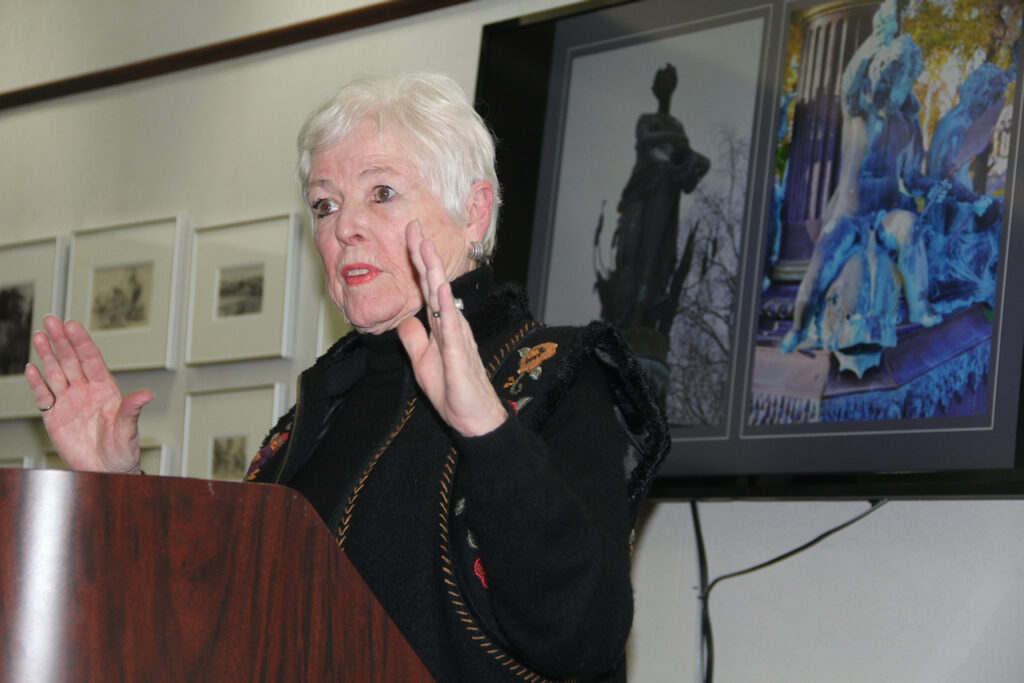
Pat Blackmer, chair of the Whitewater Landmarks Commission, outlines the repairs needed for the Birge Fountain during a program Tuesday. Chris Spangler photo.

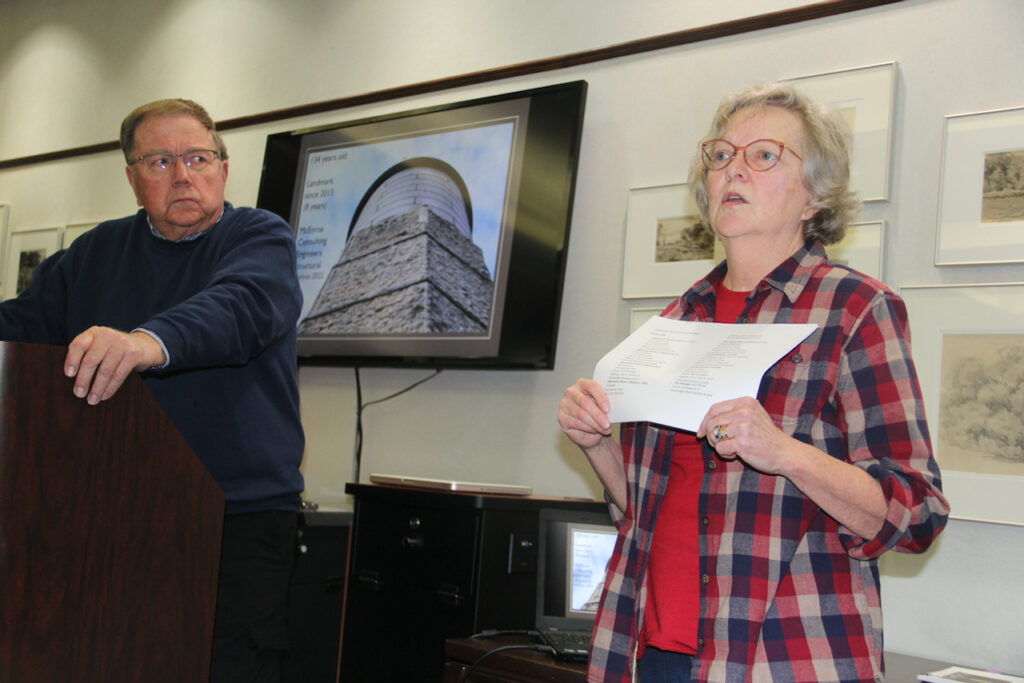


Rust is depicted within the interior of the Birge Fountain, one of four landmarks in need of repair, according to members of the Whitewater Landmarks Commission. Contributed/Kori Oberle.
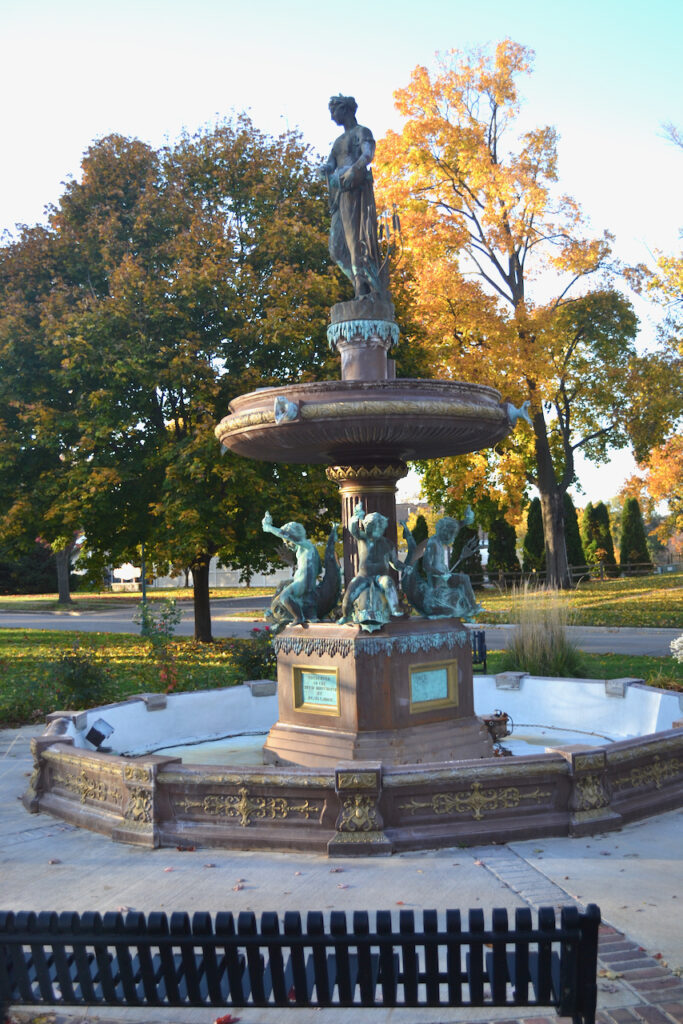
An image of the Birge Fountain in downtown Whitewater, as shared Tuesday by Whitewater Landmarks Commission member Kori Oberle, offers a glimpse of the structure when it is not filled with water. The fountain is among city-owned landmarks identified by the commission as in need of repair. Contributed/Dan Richardson.

A piece of rock from the exterior of the historical water tower in Whitewater’s Starin Park is shown to be missing. The tower, which was recently decommissioned, is among landmarks identified by the city’s Landmarks Commission as in need of repair. Contributed/Kori Oberle.
Whitewater: Thelen to head Technology Park, Engagement Center
(Originally published Jan. 31, 2023.)
Whitewater city officials have announced that Elizabeth Thelen has been appointed to serve as the executive director of the Whitewater University Technology Park and Community Engagement Center.
Thelen was appointed by the Whitewater University Technology Park Board of Directors, according to information released Tuesday.
According to the release: “after an extensive nationwide search, the search committee narrowed the prospects down to three final candidates for in-person interviews.”
Within the release, Thelen was described as “a leader working at the intersection of technology, economic development and people. She has dedicated her career to connecting people, leading projects and organizations, and getting things done. Elizabeth does this by building trusted relationships, strong networks and a passion for technology.”
The release named BDHS Consulting, AeroX Tech, The Water Council, HRDC, Slinger Speedway, and the Midwest Innovation Exchange as organizations Thelen has founded, co-founded or led.
She sits on a number of business advisory boards, including the Wisconsin Aerospace Advisory Board as its secretary and is the Wisconsin chapter leader of the national non-profit, Independent Women’s Network, the release noted.
As an entrepreneur, the release continued, Thelen “has the experience of what it takes to build a team, manage financials, inspire vision and implement for results. She has real world experience in technology projects, working with startups and researchers, organizing and leading teams, and leading businesses through change.
“Acting as president, vice president, director, network builder, coach, facilitator, or whatever title she has, Elizabeth brings energy, optimism and results to all her assignments. Not only will she support the Whitewater entrepreneurial community, but also contribute to the broader Wisconsin Entrepreneurial ecosystem.”
In support of the board’s choice, Kevin Kaufman, University of Wisconsin-Whitewater business outreach director and a member of the search committee, said within the release: “Elizabeth brings a deep network and is known as a great leader in entrepreneurial support in southeastern Wisconsin.”
“I look forward to collaborating with Elizabeth to continue the partnership between the city of Whitewater and the University of Wisconsin-Whitewater. We will be working closely to build on the Innovation Center’s successes to bring new businesses and a new tax base to the industrial park,” John Weidl, Whitewater city manager and the vice president of the Whitewater University Technology Park, stated in the release.
Said Thelen: “We all look forward to reigniting the Innovation Center’s vision with the city of Whitewater and technology park. We need to dig deep and ask who do we want to be and how will we get there? Be bold! Be clear!”
About the Whitewater University Technology Park
According to the release, the city of Whitewater, the Whitewater Community Development Authority, and the University of Wisconsin-Whitewater partnered and founded the Whitewater University Technology Park and Innovation Center in 2011. As the cornerstone of the 130-acre Whitewater University Technology Park, the Whitewater University Innovation Center is a mixed-use incubator and serves as a community for entrepreneurs.
About the Community Engagement Center
According to the release, the vision of the Community Engagement Center is to provide resources for successful meetings and events to help move the community forward. It is designed to combine ideas and organizations with the University of Wisconsin-Whitewater campus. The Community Engagement Center opened in December 2019.
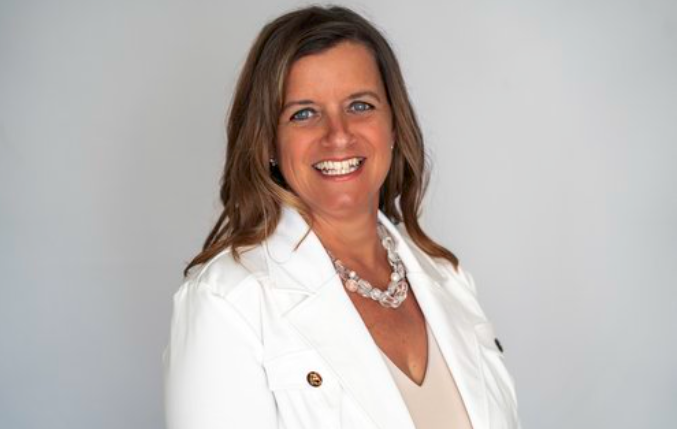
Elizabeth Thelen
Faces of makeup artist Kim Witte on display at Whitewater Cultural Arts Center
(Originally published Feb. 7, 2023.)
By Kim McDarison
When Kim Witte, a Rockton, Ill., native and University of Wisconsin-Whitewater graduate, was in her teens, she saw an American reality TV game show called “Face Off.”
The show aired on the Syfy cable network channel between 2011 and 2018, according to information presented online.
Witte said the show, which showcased special effects makeup artists, captured her imagination, adding: “I didn’t realize that was a job, so I got a body paint palette and started painting on my face.”
As a child, she and her neighbors often shared time drawing together, collecting their creations, which often were characters they created, and writing about their attributes in notebooks.
“I had monster spirals,” she said, adding that collecting characters in notebooks remains a focus: “I’ve done that the entirety of my life.”
Armed with her body paint palette, she began practicing, using herself as a model, in front of the bathroom mirror. After she finished painting herself, she said, she would take a photo of her creation and share it with her neighbors.
By the time she arrived on the UW-Whitewater campus, she and her roommate would bravely bring the characters outside for public viewing.
Witte said she would transform herself or her roommate into a character and they would walk around campus, attend an event or go together for ice cream.
Art, in several of its forms, was already in her mind as an idea for a professional career, she said, adding that when she arrived on campus, she considered two professional paths: art or a career in the medical profession.
After exploring classes in both disciplines, she said, she determined that working in the medical field would be more stressful than she might like, and devoted herself to art. Witte graduated in 2016 with an art degree. She also had a minor, which, she said, was formed using a program on campus that allowed students to create a major. In Witte’s case, the artist said, she chose to pursue an already established art major — exposing her to painting, drawing and sculpting — and a minor of her own configuration, which focused on forming a business and developing skills as a social media marketer.
Artist and marketer
Witte described the art and business-related classes she took in college as “critical” in the development of her niche-market business.
She formed Witte Artistry, LLC, in 2016.
In the beginning, she said, the business “leaned heavily” on special effects makeup, but she soon found herself “branching out.” Today, she makes tutorial videos about special effects makeup application and sells photos and prints of herself in character. She also creates acrylic paintings, does commissioned work for clients who are looking for something more specific, performs face-painting services at events and parties, and serves as a guest speaker at various events. More recently, she published a cookbook which is available through amazon.com.
Describing her business, she said, “it’s not just one thing.”
Creating a business based on her skills was an idea she crafted while in college, she said.
Witte said her goal was to work at something she really enjoyed as opposed to a standard 9-5 job which might not have offered her a chance to use her skills and grow.
Starting a business didn’t mean putting in less time at work, she said. A 12-14 hour day, with some character transformations taking as many as eight hours, was not unusual.
Witte noted that she makes much of her online content herself through use of phones purchased for their quality cameras and a tripod.
She often uses herself as a model.
Witte said she also transforms other people into creatures. Both concepts come with pros and cons.
“With myself, I’m always available, and I know when I’m going to sneeze or twitch. I can hold still for a long time,” she said, adding that a downside is that there are some spots she needs to paint that she cannot easily see.
On the other hand, she said, models can sometimes be “twitchy,” and they might not be able to hold still for long, but she can see her human canvas more clearly.
Sharing tips about social media marketing, Witte said she thinks of the platforms as opportunities to “build communities” rather than to “attract followers.”
The distinction, she said, comes in the manner in which one connects with other individuals using the platforms.
When building communities, Witte said she presents herself as “an authentic human,” and finds that people who visit her sites and engage with her online content tend to be people who like her as a person, and like what’s she’s doing.
Through those associations, ideas are generated, and community members seek to engage her professionally to explore her skills.
Through the various platforms, she said, she has been able to engage with people who sell products, or see that she has a skill set that can be helpful in something they might be building. The contacts have led her to build an affiliate network of products, she said, and also meet people who commission works of art. She also has been hired to attend events using her face-painting skill, and as her skill set is shared online, and her communities became more populated, she is able to make advertising revenue from companies that want to advertise using her content.
Going viral
Along with building communities, Witte noted that some of her content has gone viral.
She calculates “virality” on each platform differently, she said.
She considers a YouTube video as viral when it achieves 300,000 views. In 2017, she made a series of videos where she transformed herself into each of the characters from the Pixar animation movie “Coco.” Most of those videos each received about 500,000 views, she said.
Describing YouTube videos, she said: “I call them my honey bees, bringing back pollen to make the hive stronger.”
A viral video on the TikTok platform is more likely to reach a view count well into the millions, she said, noting that in 2019, she made a series of nine videos, with each one featuring herself as a cat.
“I turned myself into a lynx, tiger, cheetah, leopard, the ‘Cheshire Cat,’ and each of the videos received between 26 million and 36 million views,” she said, adding that the difference in viewership between TikTok and YouTube is somewhat attributed to the purpose and time commitments viewers must make to each video. TikTok is entertainment-based, she said. Videos are shorter, and not educational like tutorials, which tend to attract a more specialized audience and are longer.
Overall, she said, content must keep “optimizing the search engines” and then a “network that makes affiliate money, or ad money, or brings leads” is built.
“The platforms now offer pay-per-view options. I build a fanbase, which gives value, and it becomes a big network,” she said, further describing the process as building a “niche audience.”
Between 2016 and 2021, Witte said she posted a tutorial every Saturday. Today, she has hundreds of videos available on social media platforms for viewing.
Several of the videos are available in February and March for viewing on a big screen set up in the Whitewater Cultural Arts Center run by the Whitewater Arts Alliance. The video presentation is part of the artist’s first solo art exhibit, and features, along with the videos, 34 pieces of artwork, including paintings made by Witte and photographs of her transformed into various creatures.
Witte said her tutorials feature a “healthy mix” of characters from books and movies, and some of her own creation or they are a creative interpretation of a character that already exists. Some works feature an individual body part, like an arm, and are creative interpretations of a concept, she said.
When working with acrylic paints, Witte said she likes to paint on wood.
Witte said she also has been asked to speak at business conferences and to school children about such topics as special effects makeup, building a business, and social media marketing.
Making a cookbook
Among her newest endeavors, Witte talked about the events which led to her development of a cookbook.
The idea evolved on the internet, she said.
In 2020, Witte said, she became more active with her interest in cooking. She described herself as a good cook, but only a fair baker. She began organizing baking sessions with her sister-in-law and posting videos, sharing the ingredients of a recipe and taste-testing the finished products. In time, she said, she built a community around food, and people were telling her she should make a cookbook and share the recipes she was sharing in videos.
The book, titled: “Noodles and Doodles,” was independently published in August, according to its description on amazon.com, and features 115 pages of “eclectic cooking experiences with Kim Witte.”
According to the Amazon description, the book brings the reader an array of experiences, “from American favorites to Peruvian and Italian inspired delights, Kim expands her exploration of food by pushing the boundaries of flavor. Using her deep understanding of seasoning and flavor layering, she has developed a variety of unique entrèes to pique your interest and your appetite.”
The book is complete with “fun doodles by the artist,” the description notes.
Looking ahead
As she continues to grow her business, Witte said she would like to make more content revolving around advocacy for positive mental health, food, and recipes.
She also plans to continue her video adventures through special effects makeup and tutorials, and creating acrylic works of art.
As the owner of a time-intensive business, she has come to reevaluate her work-life balance, she said, working on what she described as a “less regimented timetable.”
The changes have allowed her to tap more deeply into her creativity and produce work faster, she said.
Witte also has become involved with a second company which makes cosplay shoes that look like hooves, she said.
During a reception held Friday at the Cultural Arts Center, Witte said she felt well-received by the visitors who came to meet her.
Comments were very positive, she said, noting that she sometimes worries that her work could be considered pretentious: “I mean do people want to hang pictures of me on their walls?”
She found that people do enjoy the prints and make purchases. She described her solo show as a unique, new, fun experience, and the people she met at the reception as confidence-builders.
Always looking for new horizons, she said, her next exploration will involve venturing onto the art fair circuit.
Witte’s solo exhibit will be available for viewing at the Cultural Arts Center through March 26.
For more information, including hours when the gallery is open, visit the Whitewater Arts Alliance website: https://www.whitewaterarts.org.
To learn more about Witte, visit her website: https://www.witteartistry.com/my-links/.
Information about the cookbook written by Witte is here: https://amzn.to/3CEl2hF.
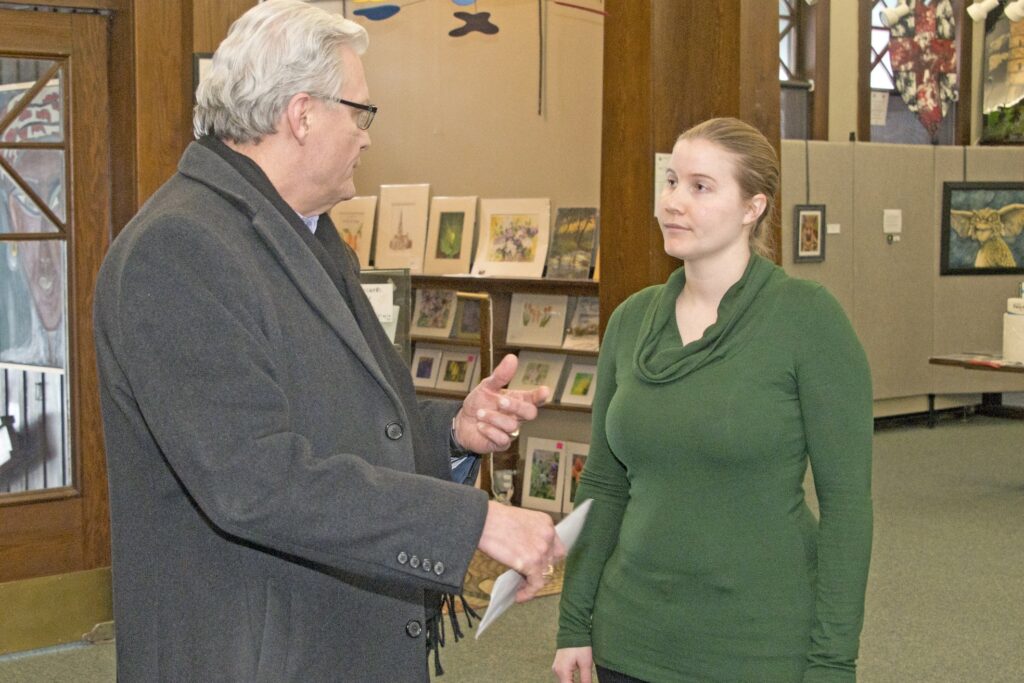
Whitewater Arts Alliance Board Treasurer Art Thompson visits with artist Kim Witte during a reception held Friday. Tom Ganser photo.
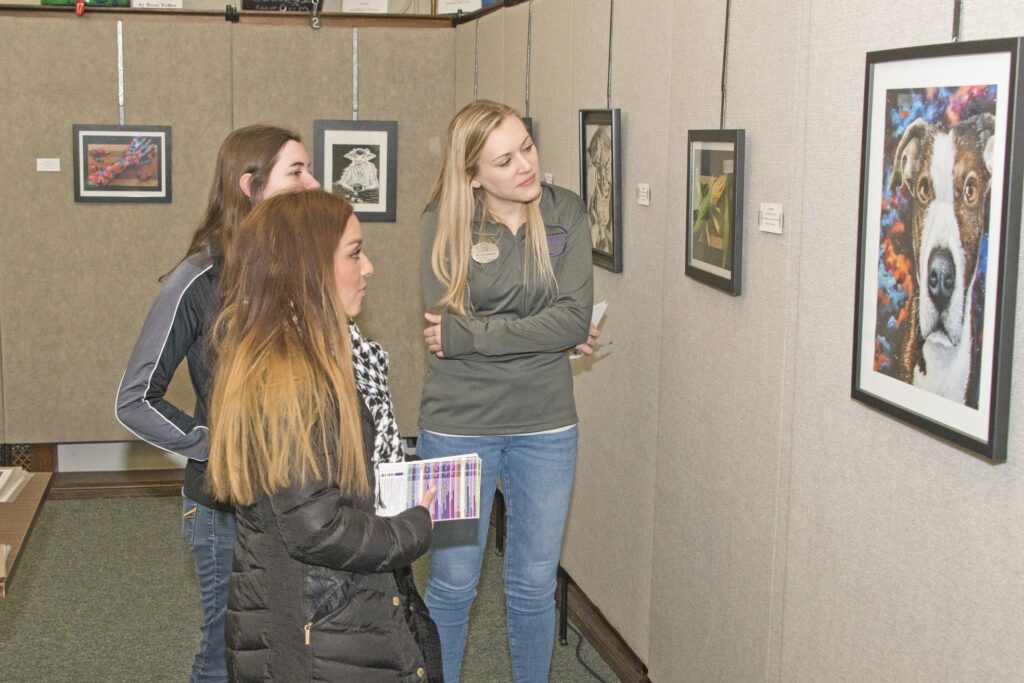
University of Wisconsin-Whitewater students and Roberta’s Art Gallery workers Angela Malo, from left, Salmai Valadez and Veena Johnson view the work of Kim Witte Friday at the Whitewater Cultural Arts Center. Tom Ganser photo.

A rendition of the character “Davy Jones” is among acrylic paintings by artist Kim Witte on display at the Whitewater Cultural Arts Center through March 26. Tom Ganser photo.

Kim Witte appears in special effects makeup as an ocelot. Tom Ganser photo.
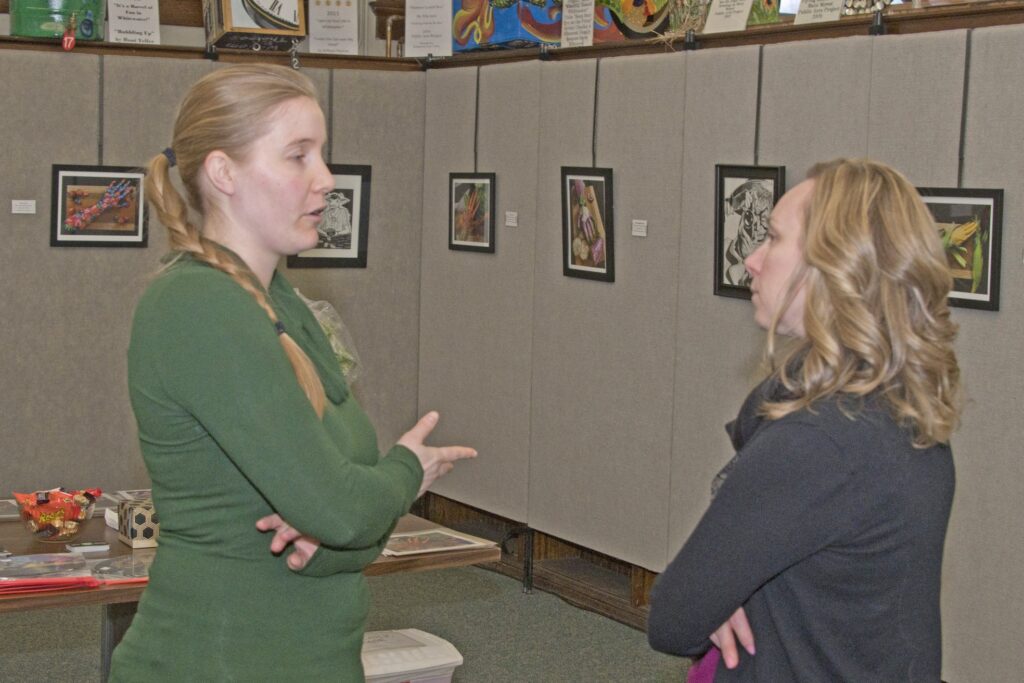
Special effects makeup artist Kim Witte, at left, shares insights about art included within her solo exhibit with University of Wisconsin-Whitewater University Center Services Manager Tonia Kapitan. Tom Ganser photo.

Among pieces on exhibit is “Harley and Poison Ivy,” an acrylic painting on a foam palette. Tom Ganser photo.

A table features prints for sale of Kim Witte’s work. Kim McDarison photo.

Kim Witte appears on the big screen set up in the Whitewater Arts Alliance’s gallery in the Cultural Arts Center as she applies special effects makeup to her face. Kim McDarison photo.

Special effects makeup artist Kim Witte appears in full body paint in her rendition of “the Terminator.” Kim McDarison photo.
Former Whitewater exchange student aids EU, Ukraine
(Originally published Feb. 8, 2023.)
By Chris Spangler
A former Whitewater High School foreign-exchange student has a front-row seat in the European Union’s efforts to show solidarity with Ukraine as it fends off Russian aggression.
Thor-Sten Vertmann, a 1995-96 Rotary Youth Exchange student from Estonia, is a member of the European Commission’s College of European Commissioners, which traveled to Kyiv recently to meet with Ukrainian government officials.
He spoke to the Whitewater Rotary Club via Zoom on Monday. Also joining the online gathering were Whitewater High School students and other interested exchange students and guests nationwide.
The 16-member European Commission’s College of Commissioners met with President Volodymyr Zelenskyy and his Ukrainian government on Feb. 2 to take stock of the EU’s support to Ukraine in different areas, including financial, humanitarian, energy, budget support and military assistance, as well as of the next steps of cooperation and reform efforts by Ukraine to advance on its EU path.
Vertmann’s own path to Kyiv traces back more than a quarter-century to when he was living with host family Ron and the late Kathy Binning and their son, Randy, in Whitewater. A daughter, Kari, was away in college.
Vertmann graduated from Whitewater High School in 1996 and went on to study political science and English language and literature in his hometown at the University of Tartu, Estonia. He also studied one semester at the University of Melbourne in Australia.
“I started my career as a civil servant in Tartu city government and held subsequent positions in several Estonian governmental bodies,” he told Fort Atkinson Online in an email. “Since 2015, I’ve worked in Brussels, Belgium, and have served two European commissioners — political appointments in European Union’s executive branch, the European Commission — from Estonia.”
He currently is on the team of Energy Commissioner Kadri Simson, covering the electricity market, nuclear energy and energy efficiency. Her position is the equivalent of the secretary of energy in the United States.
Energy assistance
Since the Feb. 24, 2022, Russian invasion, the European Union has provided around €50 billion (euros) to Ukraine, and the commission is working toward a €1 billion contribution toward fast recovery.
In addition to the up to €18 billion in macro-financial assistance for 2023, the EU announced during the Feb. 2 meeting another €450 million in assistance that includes 2,400 additional generators on top of the 3,000 already delivered; €157.5 million from the Energy Support Fund; and 35-million LED lightbulbs purchased by the EU to help Ukrainians reduce energy consumption.
It also created a strategic partnership to expand the ongoing energy cooperation between the EU and Ukraine to renewable gases such as biomethane, hydrogen and other synthetic and sustainably produced gases, and reaffirmed both sides’ commitment to reduce dependency on fossil fuel imports, especially Russian gas, and work toward climate neutrality.
“The EU has responded with sanctions for Russia’s actions, but more importantly for me, we have worked to cut the economic ties because Russia is a resource-rich country,” Vertmann explained Monday. “And just to go out of using Russian fossil fuels as quickly as possible is what we do. You need to do these things in kind of a tailored way.”
He noted that, when comparing the Gross Domestic Product or a country’s wealth, Estonia — a nation of 1.35 million residents with the minority being Russian-speaking — is the largest EU donor of military assistance to Ukraine.
“I would like to think the Baltic states, Estonia, Poland and other countries that have had experience with the Soviet Union are, in a way, the first responders, front-runners, when it comes to the Russian aggression,” he said. “We are trying to decode what is going on in the heads of the Russian leaders. Me, as an Estonian, a private individual, I am proud of what the EU has done in response to the war.”
A major impact, he said, has been cutting independence on Russian fossil fuels.
“It is very difficult to explain what is going on,” Vertmann said. “Work has been really tough for the past months since February last year.”
He said that no longer does he wake up in the morning and struggle for motivation.
“You have … the situation in Ukraine and the scale of human suffering there is just overwhelming, which is always now the context for the work,” the commissioner said. “I suppose all policy areas have implications in history, but the energy policy has been completely overturned by Russia’s behavior, by the war itself, and so this is the context. I am mostly doing things to try … to make Europe more resilient, independent from the Russian energy supplies, while providing direct assistance to the Ukrainians. That’s a big part of the work life now. This doesn’t end at 7 o’clock in the evening. You don’t really put that on hold.”
Typical work day
Vertmann, his wife and their son, 9, and daughter, 7, reside in The Netherlands. His wife works in The Hague for Europol, Europe’s equivalent to the international criminal police organization Interpol. Vertmann, who speaks Estonian, English, French and Russian, commutes 110 miles to Brussels, Belgium, about twice a week.
Responding to a question on his “typical day” at work, he said there is none.
“It depends on the list. Sometimes I need to think in the morning in what city I am. ‘Is it in The Hague in the Netherlands or is it in Brussels or am I on a work mission? And if it is the Hague or Brussels, where is my car? Did I come by car or did I take the train?’” He said.
The commissioner said that he does not like to “stretch things out” in the morning.
“I wake up and a half-hour later, I am at work. A quick coffee and I start doing things. I don’t like to chat in the morning. Let’s just get things rolling. It can be eight-, 10-, 12-hour workdays, especially when I am in Brussels and the family is in The Hague.”
He called Brussels “the capital of burnout and the European institutions.”
“My trick to managing the working hours and the stress at work is … I go as far away from EU quarters, because Brussels and Belgium are so much more than just the EU institutions. It’s small boring part of the town.”
He said that outside of the EU sector, Brussels is a beautiful city with two universities and many cultural, educational and culinary offerings.
“The working conditions are excellent in Brussels,” Vertmann said. “I have nothing to complain about. Just the work-life balance. My favorite part of the job is going home.
“I might sound too dramatic,” he added. “Of course, we have loads of fun and the mood is good and it’s good for motivation. I want to make that clear. But it’s not to say these are easy times at work.”
Favorite memories
Asked about memories of his year in Whitewater, Vertmann shared one that perhaps foreshadowed his interest in political science.
“My most vivid memory was in 1995. That was the last year of the Bosnia War,” he said. “This was the last occasion of active warfare on the European continent. And I remember — I believe this discussion took place in English class … — there was a discussion on … what is our (Americans’) role in these kind of things? Do we need to get engaged? Where is Bosnia? Where are the Balkans?”
He continued: “We discussed what was going on in Bosnia and people were saying, ‘you can’t ignore that. If you don’t get engaged, then who will? We have to do something. Just don’t be a jerk. In this situation, it is an easy choice. It is the decent thing.’ That’s made a mark on how I do see the Americans. Some small place in the Midwest, nobody knows Bosnia … and it’s so easy to look away, but you don’t do it. That was a big thing that I remember.”
He said he is witnessing that same concern today. While Eastern European countries have stepped forward to help Ukraine, so have nations around the globe.
“My point is that you don’t need to be next to the country to understand or have the basic empathy for the situation or for the event or the people,” Vertmann said.
Advice to young people
Rounding out the Zoom call, he was asked whether he had any career advice for young people.
“Political science: There have been times where I have been convinced it is really difficult for the younger generation to enter this area of studies because it’s been a popular field of studies,” Vertmann said. “Its really tricky to give advice, but my go-to claim has been ‘don’t pretend to be someone else. If that is what interests you, you want to spend time on it, go for it.’ … What is your skill set? What are your talents?
“I don’t think you can be good at everything, so just focus on your strengths. And if that’s political science, then join me.”
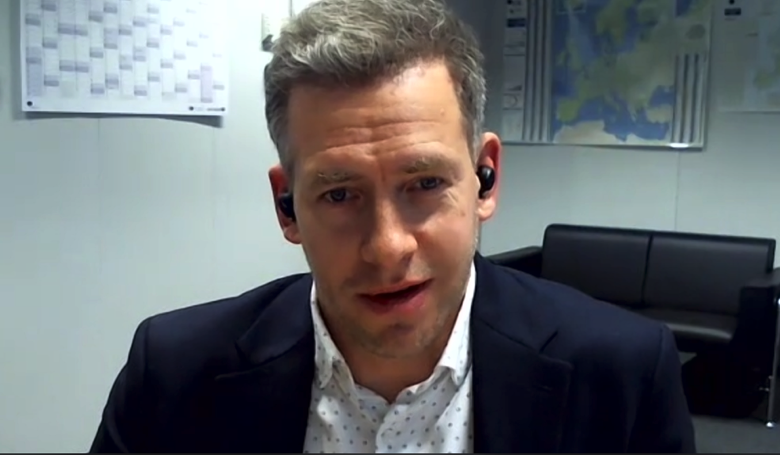
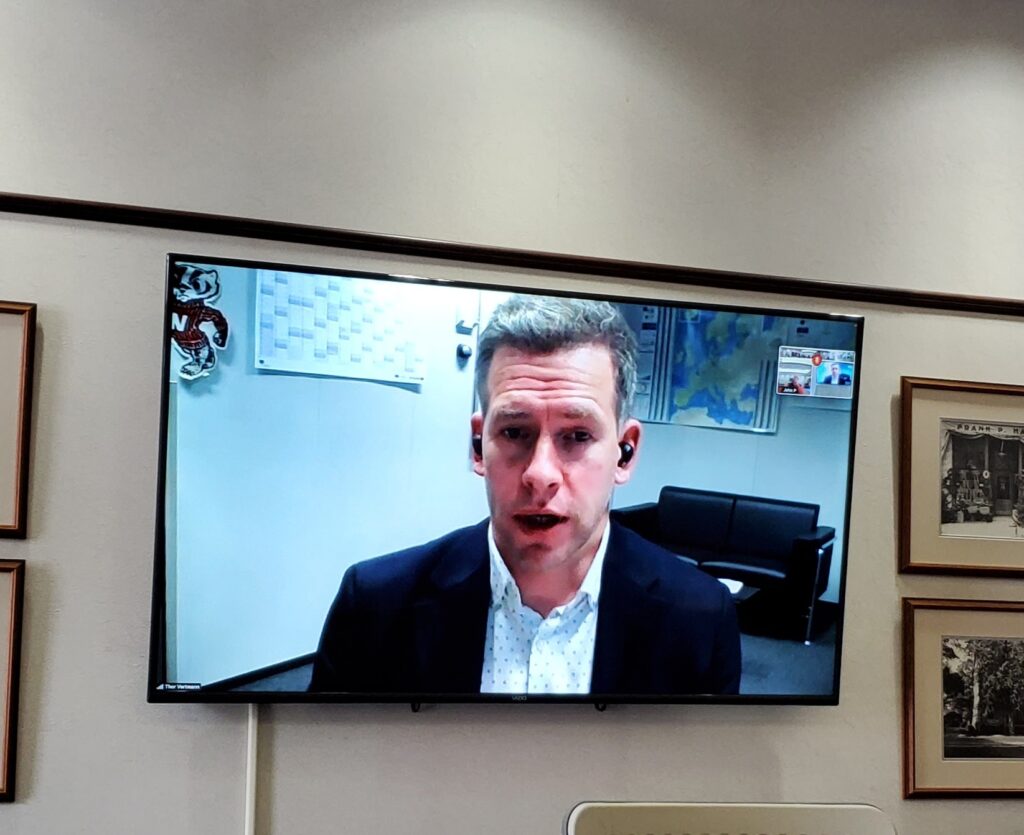
Two photos above: Former Whitewater High School foreign-exchange student Thor-Sten Vertmann addresses members of the Whitewater Rotary Club Monday via Zoom. Whitewater High School students and other nationwide guests participated during the club meeting remotely. At top is a screen shot view of Vertmann as he spoke with club members and guests. Above, Vertmann is seen on a big-screen TV where he is viewed by in-person meeting participants of the Whitewater Rotary Club. The meeting was held at the Irvin L. Young Memorial Library in Whitewater.

Members of the Whitewater Rotary Club assemble at the Irvin L. Young Memorial Library in Whitewater to engage with their guest Thor-Sten Vertmann, a 1995-96 Rotary Youth Exchange student from Estonia, who is a member of the European Commission’s College of European Commissioners, which traveled to Kyiv recently to meet with Ukrainian government officials. Vertmann participated in Monday’s Rotary Club meeting remotely. Contributed photo.

Thor-Sten Vertmann
State budget surplus discussed at Greater Whitewater Committee annual meeting
(Originally published Feb. 12, 2023.)
By Kim McDarison
State Sen. Howard Marklein served as keynote speaker Thursday at the annual meeting of the Greater Whitewater Committee.
Marklein, who is a co-chair of the Wisconsin Legislature’s Joint Finance Committee, offered insight into the state’s budget process and its finances, including the estimated $7 billion surplus within its coffers.
Marklein represents the 17th senatorial district. He is serving his second term. Before winning his state Senate seat, he served as a member of the State Assembly for two terms. He has served as a member of the Joint Committee on Finance, which is the Legislature’s budget-writing committee, for four sessions, according to information presented on his legislative website.
Counted among the 30 people in attendance Thursday were members of the committee and the public, including several Whitewater Common Council members, Whitewater Unified School District Board of Education members, and candidates running for school board seats in this month’s primary and on both bodies in the spring general election. State Rep. Ellen Schutt and Walworth County Sheriff Dave Gerber also were in attendance.
The event was held at 841 Brewhouse, Whitewater.
Kachel to step down as chair
In advance of Marklein’s presentation, Larry Kachel announced that he would be stepping down as Greater Whitewater Committee chairperson.
Speaking from the podium, Kachel, who is also a member of the Whitewater Unified School District Board of Eduction, told those in attendance that Thursday’s annual meeting would be his last as chairperson of the Greater Whitewater Committee.
“I’ll be stepping down in the near future — let’s just say that things are getting quite busy on the school board, and we’ll leave it at that,” Kachel said.
He planned to remain active within the group, he said, noting particular pride in “the spinoff that we did with Whitewater LEADS. That’s our program where we are getting books from the Dolly Parton Imagination Library to the kids ages 0 to 5 in the community. We went over our 20,000 books last August. We now have a grant program that we have money available for Pre-K through fifth-grade teachers in the district. We give out five up to $400 grants per year.”
Goals: Highway 12, UW-Whitewater funding, state payments for municipal funding
Also speaking from the podium, Greater Whitewater Committee President Jeff Knight talked about the organization’s goals and accomplishments.
He, too, pointed to the Whitewater LEADS program, noting its history of becoming a committee goal after the school district received a set of ACT scores, which, he said, caused committee members to reorganize their priorities, create a task force, and develop the program, focused on increasing student literacy by third grade.
Knight updated those in attendance on the status of the U.S. Highway 12 project undertaken by the committee. The goal is to make the now two-lane highway into one with four lanes.
Said Knight: “We worked on Highway 12; we got it into the (state) budget, we got it approved, everything was going fine, and then the state fell behind in the building of all these majors (roads) — there was no money — and unfortunately they did another traffic count after the (COVID-19) pandemic started, when our university kids weren’t here, and I think everybody could understand how that traffic count turned out, and so we are no longer on the list. I think they are starting to get caught up at some of the majors … and I think we are about two years out.”
In addition, Knight said the committee was involved in bringing “equity” to the allocation of general purpose revenue (GPR) to the University of Wisconsin-Whitewater.
Last spring, the group named three lawmakers — State Sen. Duey Stroebel, and then-State Reps. Don Vruwink and Cody Horlacher — each as “Legislator of the Year,” for their efforts in introducing the General Purpose Revenue Equity Bill, which focused on creating an equitable funding formula for the UW System.
According to information released by the committee last year, the GPR funding formula in use by the state allocates funding disproportionately within the UW System. The information cited the UW-Whitewater as receiving the least amount of funding, further noted that UW-Whitewater receives about $1,500 less in funding per full-time student compared to the average number received by the comprehensive campuses in the UW System.
A report describing funding allocations throughout the UW System and at the UW-Whitewater is here: https://www.uww.edu/documents/facsenate/meeting%20archive/2021-2022/2022-04-12_Senate/D2.%20FEAOC%20-%20UWW%20GPR%20Fact%20Sheet%20-%20Spring%202022.pdf.
Within his comments Thursday, Knight said he was in conversations with Schutt, adding: “So our fight has always been your kids and your grandkids — you pay taxes here, your kids deserve the same treatment as the kids up in Stevens Point and Superior. And so we will keep fighting on that issue.”
As a third goal, Knight cited reformations to the Payment for Municipal Services (PMS) program. According to literature supplied by the Wisconsin Legislative Fiscal Bureau, a nonpartisan service agency of the Wisconsin Legislature, the program disperses throughout the state annual payments to reimburse municipalities for property tax-supported expenses incurred while providing services to state facilities. Payments are made for fire and police protection, garbage and trash collection, and other approved direct services.
According to information about the program provided by the bureau in 2021, while statewide entitlements had grown between 2011 through 2020 to $53,703,005, representing a 49.8% increase over the 10-year period, PMS remained at an annual constant level of $18.6 million over the same period, with payments representing, in 2020, 34.6% of the full cost of statewide entitlements.
On Thursday, Knight said: “When the (Whitewater) fire department merged in the city because of the problem with the expense, when you’re in a college town, you’ve got a lot of ambulance, you’ve got a lot of fire, you’ve got a lot of services that other communities don’t have to provide. So one of our goals is to work to see if that 34% of the property value gets raised. It’s crucial to a community like Whitewater. … So we really need to make a case back to the Legislature why it’s pretty crucial that that footprint demands some additional pay.”
Marklein on the budget, the surplus and ‘one-time’ money
Arriving at the podium, Marklein said he was a former resident of Whitewater and attended college at the UW-Whitewater. He is by profession an accountant.
Marklein said he was the third freshman senator in the state’s history to serve on the Joint Finance Committee.
After his election to the Assembly, in 2010, he said he consulted with “one of my governmental audit partners in Madison,” who brought him “up to speed,” on governmental accounting practices, he said.
“So, I walked into that first meeting in the Legislature, and I’ll tell you what: I knew more than the 100-year veterans that were there because they didn’t understand this stuff, so anyway, I’m kind of a geek that way,” he said.
Armed with two graphs, Marklein said the first showed a historical rendering of “the balance sheet, financial position for the state of Wisconsin for the last 20 years.”
In 2000, he said, the state was “about $700 million in the hole by the end of the year and then we just spent it down until we hit a low point, here.” He pointed on the graph to the year 2010. At that point, he said, “we had about a $3 billion hole.”
Said Marklein: “People can ask: ‘I thought we had to have a balanced budget. How could that happen?’ And this was, again, at the end of the last Democratic controlled Legislature and governor, and we borrowed $1.2 billion out of the transportation fund. We took $200 and some million out of the patient compensation fund. We owed Minnesota $64 million in reciprocity payments, and all those kinds of things. You just don’t pay your bills. There’s money in the checkbook.”
Pointing to the upward trajectory depicted on the graph which followed the trough created in 2010, he said: “That was our low point, and this is where we ended up this year. And, again, on a GAP (generally accepted accounting principles) basis, $4.2 billion net surplus at the end of June 30, 2022.”
Sharing a second graph, Marklein said: “I want to point out that what the financial position in the state would have been had we adopted Gov. (Tony) Evers’ budget as is, without any changes, two years ago. And we would have gone for — everything’s the same in this graph, except for — boom — and we would have been back in the hole again. In just one budget cycle.
The graph showed the budget peaking in 2020, followed by a downward trajectory.
Turning his attention to the state’s budget surplus, Marklein said that while the number presented in the media is typically between $7 and $7.1 billion, that figure, he said, “is largely one-time money. And it resulted from increases in tax collections because of all the federal money that has come into the state of Wisconsin since the COVID, since 2020.”
Over the last two years, Marklein said, the state has received federal dollars from such sources as “stimulus payments received by people,” the PPP (Payment Protection Program) payments that businesses got,” and “people that were unemployed got an enhanced unemployment add-on to their checks.
“The governor had $4.5 billion at his discretion, the state received — it’s called FMAP (Federal Medical Assistance Percentage), the financial for Medicaid reimbursement — we got a kicker of 6.2%.”
As of last Wednesday, Marklein said, the state had received a cumulative amount of $65,259,289,581.
“I mean it’s a lot of federal money that came in. The reason I bring this up is because that federal money coming into the state of Wisconsin is also one-time money, which is what juiced the economy, sales tax, and created inflation for us, too,” he said.
He added: “In the short term, if you look at a short-term vision of what’s going on, we’re in great financial shape.”
Marklein acknowledged that several entities across the state — local municipalities, the UW-Whitewater — have expressed an interest in having more money.
“I mean there’s a lot of people that want more money. How much do you think is the ongoing surplus for the state? Because it’s not ($)7 (billion); It’s $2.9 billion,” he said, adding, “and we’ve got, that $7 billion that we have, that has been spent multiple times already.”
Looking at the budget process, Marklein said he believed it would be conducted similarly to the process used two years ago.
He said the process would likely include four public hearings held throughout the state.
“We will be doing some agency briefings and then, probably in early May, end of April, is when we really start acting on the budget,” he said.
Marklein said the governor is expected to release his budget on Wednesday, and the Joint Finance Committee would meet immediately after his address.
“Then we introduce the budget,” he said.
Marklein: ‘What I’m hearing’
Marklein shared comments about the concerns he has been hearing from constituents within his district.
“I’m in southwest Wisconsin … my district borders Iowa, and Illinois. Sometimes when people talk about raising gas tax for example, I always look at my neighbors because I’ve got Dubuque right across the river … I have people working back and forth, and going into Illinois … whether it’s tax, gas tax or for other kinds of things, when you live on a border you have to be concerned about it. People can choose where they buy things and impact our businesses as well.”
Employers in his district have noted a “lack of employees,” he said, adding that several businesses about which he was aware had closed their doors because they could not find people to work. He called the outcome “tragic.”
“To some extent, I believe government has contributed to that situation,” he said, noting that an employer with whom he spoke said he was competing for workers “with the couch.”
“Because of COVID, there’s been so many programs that have been initiated, largely funded by the federal government — all of them funded by the federal government — that, it’s made it easy not to work,” he said.
In addition, Marklein noted what he described as forecasted conditions of declining enrollment at the university level.
“I have UW-Platteville in my district,” he said, adding “the number of graduates coming out of our high schools hits its peak in 2025, and then it starts to fall off, and it’s not going to be pretty for communities like Whitewater or any campus town.”
Said Marklein: “From a policymaker’s standpoint, I don’t see us building — well, first of all, we have a lot of empty state office buildings. We’re not going to build any office buildings, we’ve got all kinds of empty space all over. As far as capacity at universities, I think we are going to have to be very strategic about where we invest state money on our campuses. There are programs obviously that are successful and growing an incredible amount of demand, and then there’s others that probably there’s not as much demand.”
Questions from the audience
Marklein next took questions from the audience.
He was asked to revisit the difference between one-time and ongoing money.
In response, he said: “We have this bubble of surplus that’s one-time money and then we’ve got this $2.9 billion stream going out into the future. I’ll tell you what, anybody could do the budget for the next two years because there is so much money there. The challenge is going to be: city, do you want one-time money or do you want something you can rely on into the future? For the school district, you want ongoing money. The ongoing money is the surplus that we project into the future. Whether its schools, whether it’s prisons, any of the shared revenue, that can rely on, so we have a lot of one-time money. It’s that one-time money, in a perfect world, would be spent on one-time projects. Maybe construction, maybe roads, I’m just thinking out loud here, why bond when you can pay cash for it? That’s one time. You’re not obligating something, an agency, into the future. So, as I’ve told some of my colleagues, I don’t want to be sitting here in two years, or four years, and say ‘jeez, I wish we hadn’t committed so much money because we don’t have the revenue anymore.’”
An audience member asked if the surplus could be used to support roads. “They stink in this state,” he said.
Marklein said he agreed.
Said Marklein: “There is going to be a lot of federal money coming in transportation, you know, federal transportation money coming into the state of Wisconsin. Also an incredible amount of money coming in for broadband. Both are needed. One of the things that I always look at, too, is capacity. Because the industry, you know, road construction, they are looking for workers, too. And sometimes in government we measure success by how much we spend. Like with transportation, I want to make sure that whatever we increase the budget by, that we get more roads, not go with the price will just go up. The money will get spent, I guarantee you that, so I want to make sure we get more done. And the same thing with broadband. And they’ve got some capacity issues as well. I want to make sure we get more miles of fiber, and we get people served, not just spend another billion dollars so that there isn’t any results for it.
“Roads would be in my opinion a great example of legitimate one-time use of that money.”
Marklein was asked to share his opinion on flat tax. He said he agreed with it, but did not see much movement on the concept given the political environment.
An audience member asked: How much of the COVID money is still available to school districts?
Marklein said that money arrived at school districts in three tranches.
“I can tell you that Milwaukee School District has three-quarters of a billion dollars of money yet to spend — federal money to spend. That’s a lot of money,” he said.
Monies remaining in school districts varied by district, he said.
“The governor has about a billion dollars left. He had $4.5 billion in his discretionary kitty and he’s got about a billion left to pay out. There’s a fair amount of money that’s out there,” he said, adding: “I will consider the amount of federal money — I don’t care whether it’s school or anybody has, in determining what the state GPR is — general purpose revenue. Because whether it’s federal money or state money it’s all green. It spends the same.
“Going back to transportation, what we did last time in the budget was the Milwaukee Transit System got an unbelievable amount of federal money. They had so much money that they wouldn’t have to charge a fare for four years and they would be just fine. So we said rather than put state transportation money into the transit system, we pulled out the state money and we allocated it to local roads, which is why our local roads budget was really pretty good. And Milwaukee’s fine, I mean at the transit system, they got plenty of money there. We will likely, you know, certainly take a look at that.”
Looking again at dollars for broadband expansion, he said: “At least $1.1 billion of federal money (is) coming in (to the state) plus there’s a couple others, USDA money coming in for broadband … I’m going to be kind of cautious about putting more state money into it unless there’s a good reason to do that.”
Marklein was asked if the state budget would include funding to help communities provide services and share costs associated with immigrants coming into the state.
Said Marklein: “I don’t know that I have an opinion that really matters. That’s a federal issue and they are going to have to deal with that.”
Responding to a question about crime, Marklein said: “One of the things we are looking at is the whole shared revenue formula and system. The shared revenue formula I don’t think has been touched since about 2004, and it’s broken.”
He added: “Part of that is to reform some of the problems they’ve got in Milwaukee — primarily their pension system — but also part of that is to make sure that if they get new revenue, which they could, that it goes to cops on the street. Because I don’t want them to get a chunk of money and hire a new diversity department or whatever. I want cops on the street. That’s stuff that hopefully, we put new money in, it ends up with more cops on the street.”
An audience member enumerated several issues, which, he said, were “hurting” UW-Whitewater. He cited a lack of a four-lane highway, the absence of building projects on campus, but, he said, the “the biggest one” is the university’s lack of funding provided through GPR.
Citing the GPR program, the audience member said: “Our average investment by the state, per student, is the lowest by far … so this cumulative effect of this disinvestment is incredibly problematic for our town, and especially if we look at the 2025 enrollment cliff that you were talking about.”
“That decision, I believe, is largely made by the Board of Regents. If you want to do that (put more money into the GPR program) you are probably talking a separate bill,” Marklein said, adding: “Given the current environment, it’s not going to be an easy fix.”
Interview with FAO
After the presentation, Marklein granted Fort Atkinson Online a brief interview.
Fort Atkinson Online shared with Marklein our understanding of discussions held at the local level — at school districts and within municipalities — during which officials note that they find themselves placed in a position where they must use one-time monies, such as those received through the Elementary and Secondary School Emergency Relief (ESSER) and American Rescue Plan Act of 2021 (ARPA) funds, to cover recurring or operational expenses. Pointing to reduced or withheld state aid, officials say the message from the state Legislature is to use the one-time money in lieu of state aid. Another alternative is asking constituencies for money to support recurring costs through the referendum process.
Local officials have asked the Legislature to consider increasing ongoing state aid to pay for ongoing expenses.
Said Marklein: “So, Milwaukee Public Schools, they have three-quarters of a billion dollars that they are sitting on right now. Why should taxpayers in my district give them more tax money when they have got a lot of federal money? It all spends the same. I don’t think it’s unreasonable, when you’ve got resources already that, you know, it all spends the same. Now, having said that, I fully understand, like with K-12 school districts, that we’re going to have to make up for … you know inflation is hitting them, I get it. And as far as the communities, you know shared revenue, if we are able to put something together, which I hope we are, they’re going to be receiving a significant boost in their base funding.”
He agreed, he said, that there is a need for local governmental units to receive ongoing funds to cover the costs associated with operational expenses and inflation.
“We are working on all of those issues right now. I can’t tell you where we are going to end up. I fully understand the problem,” Marklein said, adding: “Given the extent of conversation that we have had with local government, the League of Municipalities, Wisconsin Towns Association, Wisconsin Counties Association, I mean and the amount of effort that’s gone in already on this topic, I am hopeful that there will be relief for our municipalities and local units of government in this next budget.”
Advancing possible ideas for the state’s one-time surplus gained through federal dollars, he said: “If we were smart, we’ll dedicate it to one-time kinds of things.”
Considering the full surplus for recurring costs, he said: “It’s not to say you can’t fund that for a while, but eventually that’s going to run out. If you had a pot of money — let’s say you are making $50,000 a year of ongoing salary, that’s what you can live on — and you got an inheritance of $100,000, now, you can live off this $100,000 for a while, but to the extent that you build that into your budget, it’s going to run out.”
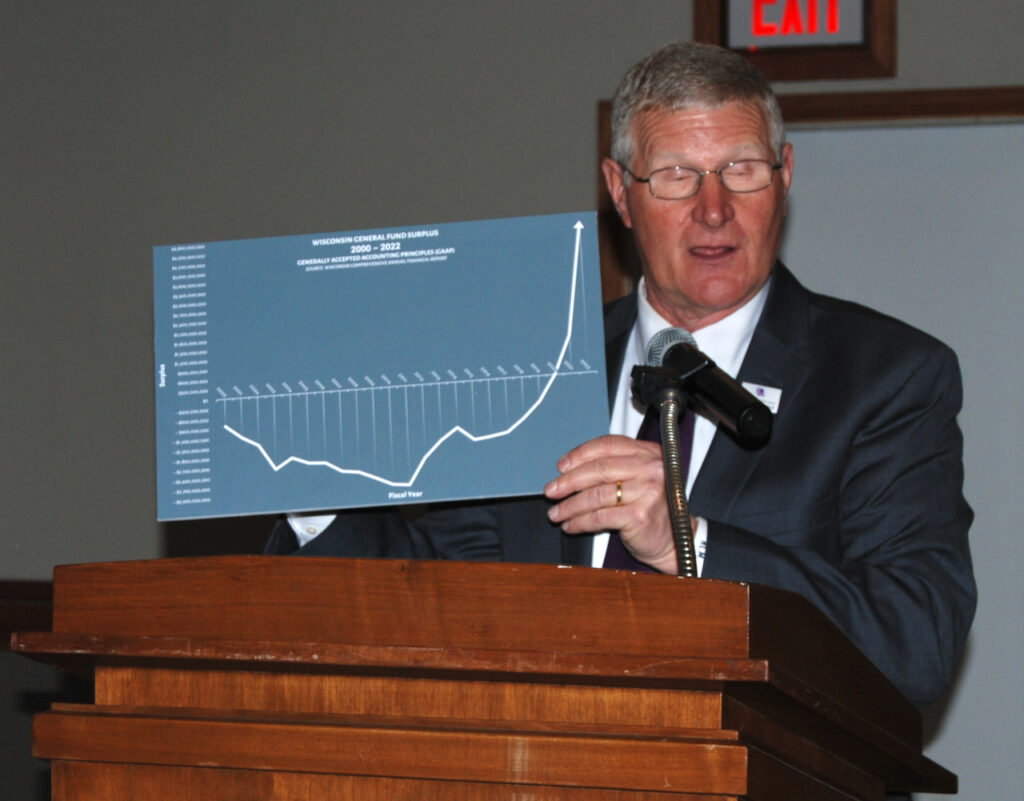

Two photos above: At top, State Sen. Howard Marklein, who also is a co-chair of the Joint Finance Committee of the Wisconsin State Legislature, shares a graph showing the state’s financial condition between 2000 and 2022. Above, Marklein produced a second graph, which, he said, showed what the state’s financial condition would have been had the Legislature passed unchanged a budget submitted two years ago by Gov. Tony Evers.
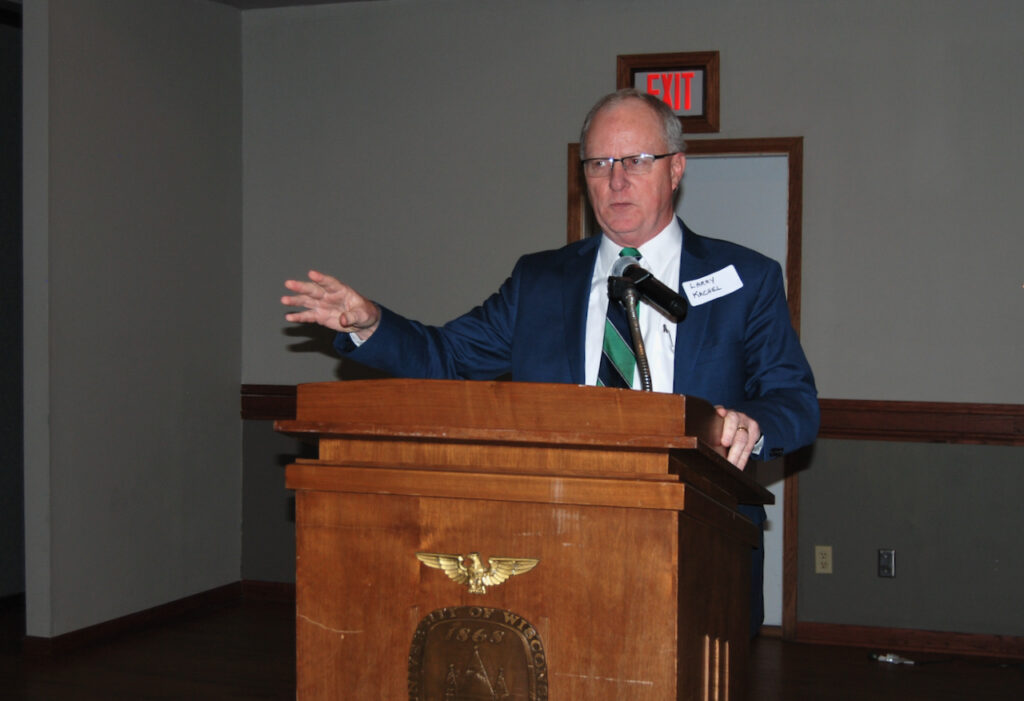
Greater Whitewater Committee Chairperson Larry Kachel addresses audience members.
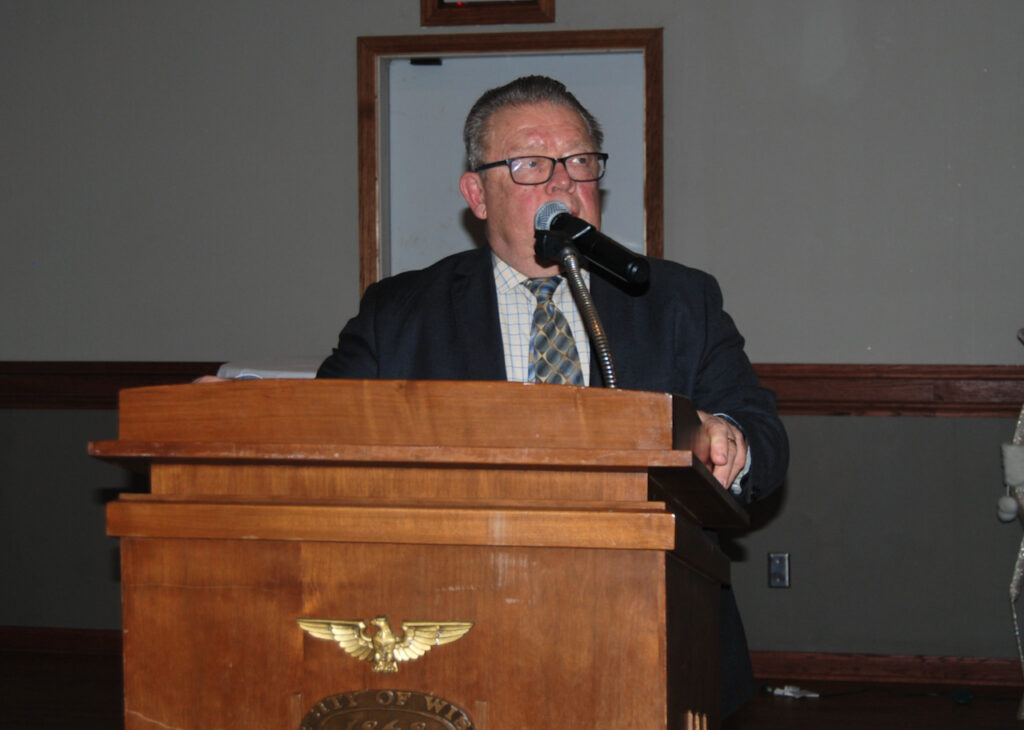
Greater Whitewater Committee President Jeff Knight addresses audience members.
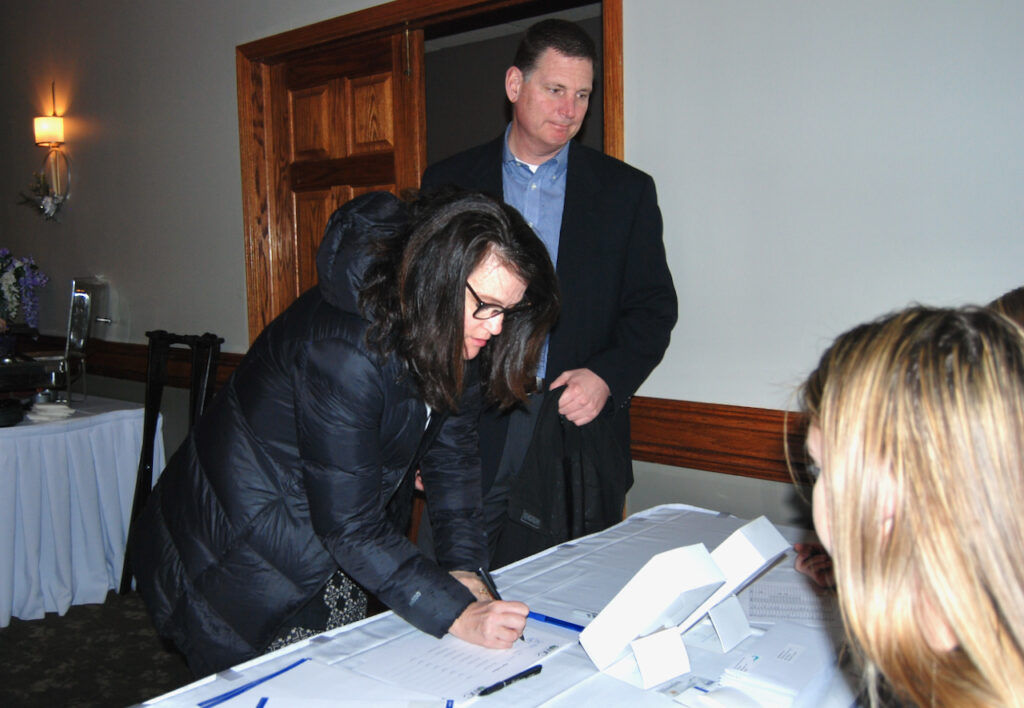
Whitewater Common Council member Jill Gerber and her husband Walworth County Sheriff Dave Gerber arrive at the Greater Whitewater Committee annual meeting.
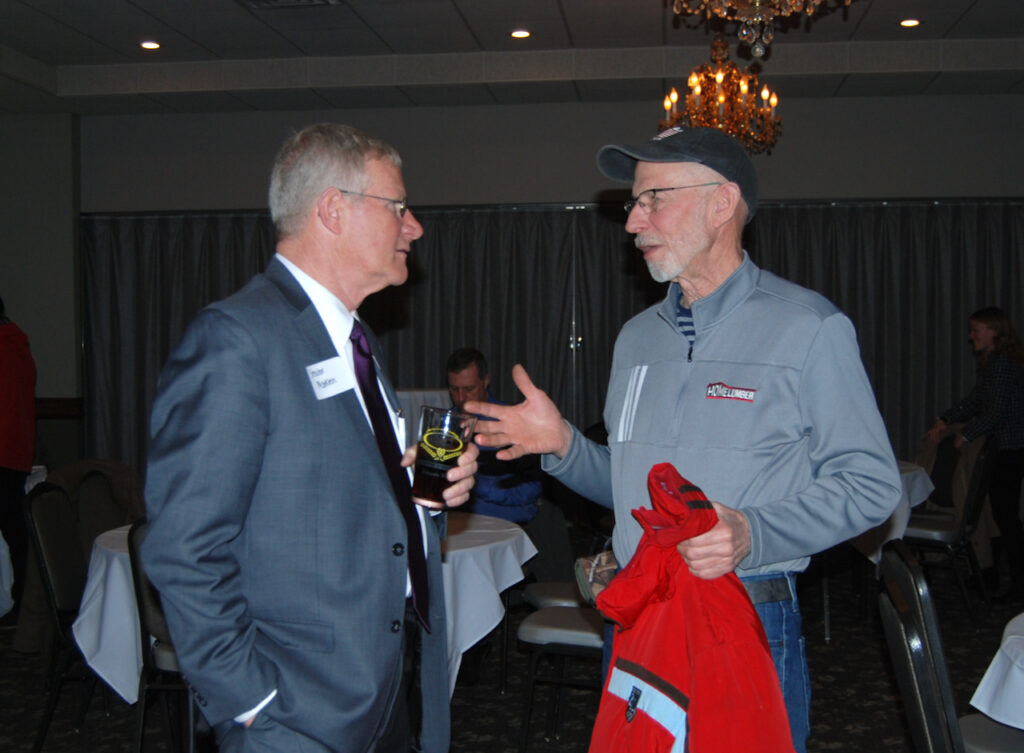
State Sen. Howard Marklein, at left, visits with Whitewater business owner Geoff Hale during a reception held in advance of the meeting’s keynote speaker presentation.
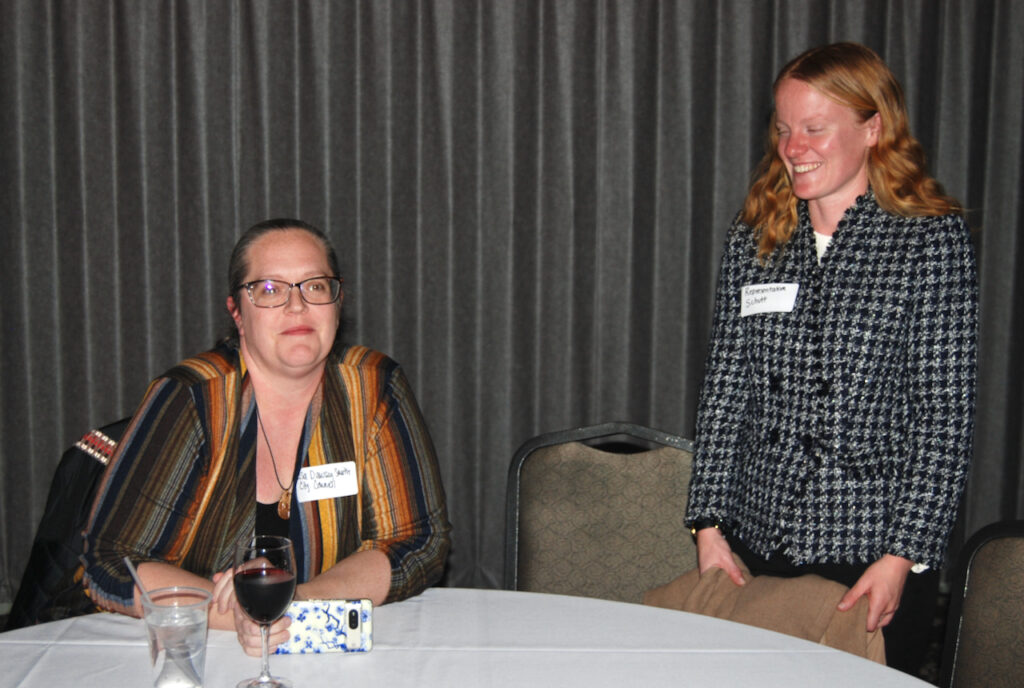
Whitewater Common Council President Lisa Dawsey Smith, at left, and State Rep. Ellen Schutt visit in advance of the program.
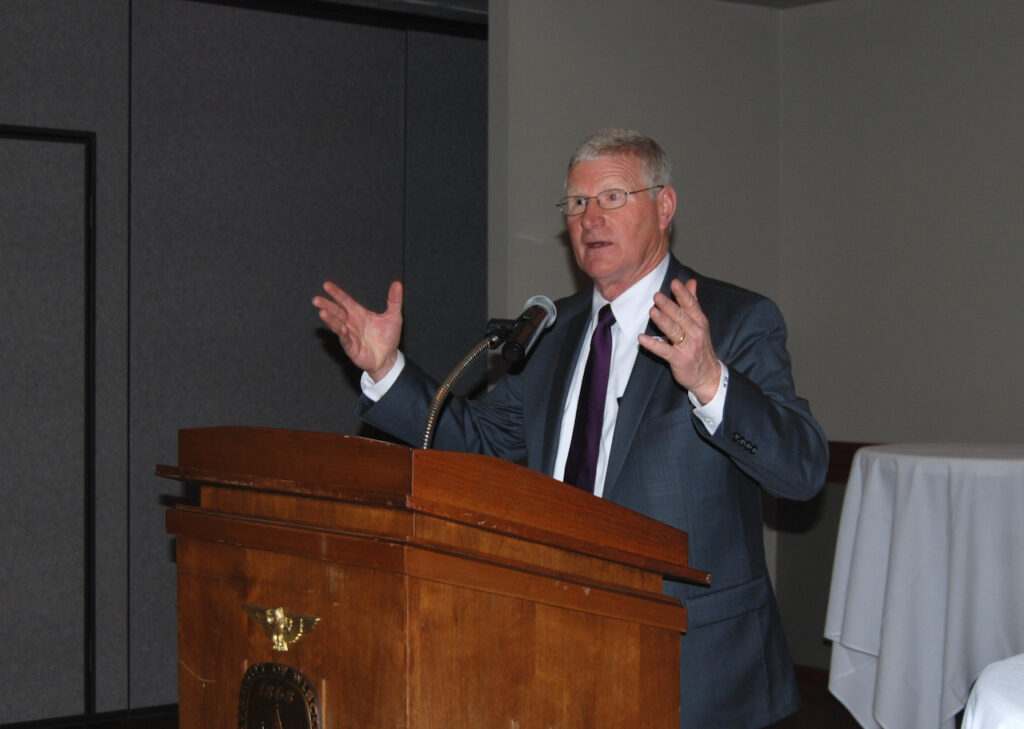
Sen. Howard Marklein addresses event-goers from the podium.
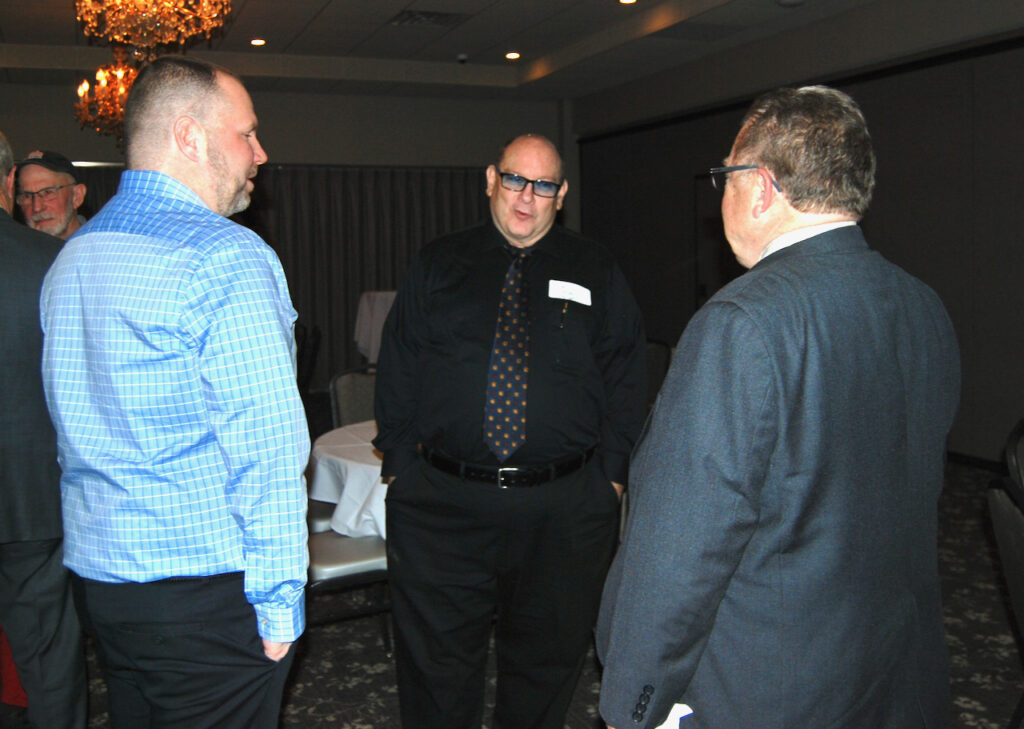
Whitewater Common Council member Jim Allen, at center, visits with event participants during the opening reception.
Kim McDarison photos.
Highway 12 reconstruction between Fort and Whitewater slated to begin March 6
(Originally published Feb. 15, 2023.)
The Wisconsin Department of Transportation (DOT) recently announced that it will begin reconstruction work on U.S. Highway 12, between County Trunk M, just south of the Fort Atkinson city limits, and Buckingham Road, located to the north of the city of Whitewater.
The project resides in Jefferson County. Work is slated to begin March 6.
The project is anticipated to complete by the end of 2023, information found on the projects.511wi.gov website states.
The construction area will be closed to through traffic while the work is underway. Through traffic will be detouring using State Highway 59 to State Highway 26 to U.S. 12, the website noted.
An overview of the project, found on the DOT’s wisconsindot.gov website, notes that work will begin just north of the Whitewater Bypass and extend approximately 4 miles north to approximately County Trunk M.
Work planned for the segment of roadway includes removing and replacing the existing pavement, base course layer, sub-base course layer, pavement markings, and permanent signing. Improvements will include widening the shoulders and safety zone, modifying three substandard horizontal curves to meet design standards and replacing drainage structures, according to the website.
For traffic reports and additional project updates, visit the DOT’s projects.511wi.gov website.

On orange line on the map above and as provided on the DOT’s website shows the Highway 12 reconstruction area that will undergo work slated to begin March 6. The work is anticipated to complete by the end of 2023. A blue line indicates a detour as determined by the DOT to be used by through traffic while the project is underway.
Whitewater: CDA authorizes purchase of two parcels in city’s downtown
(Originally published Feb. 16, 2023.)
By Kim McDarison
The Whitewater Community Development Authority (CDA) after meeting Thursday in executive session for approximately 15 minutes, reconvened in open session and announced its decision to authorize the purchase of two parcels of land in the city’s downtown.
CDA commissioners authorized the purchase of both parcels in an amount not to exceed $150,000.
The two properties proposed for acquisition include 126 North Jefferson Street and a vacant parcel at 104 East Main Street.
In addition, the body accepted a letter of intent from Tanis Properties LLC, which, according to the meeting agenda, regarded a “potential mixed-use development on East Main Street/Jefferson Street.”
Speaking during the CDA’s regularly scheduled meeting, which was held in advance of the closed session, Whitewater City Manager John Weidl said that two representatives from the Whitewater Grocery Co. — a co-op grocery store initiative also known as GroCo — would be invited into the executive session meeting to speak. The individuals would be asked to leave the meeting before CDA commissioners entered into discussion regarding the closed-session agenda items, Weidl said.
A representative from Tanis Properties also was invited to offer comments during the executive session.
Additionally, the city’s contracted economic development consultant Kristin Fish-Peterson was asked to remain during the executive session.
Said Weidl of the GroCo and Tanis Properties representatives: “each of them will speak briefly in closed session and then leave, leaving the CDA and staff alone to discuss the items for potential future action. Once the GroCo has spoken, they all need to move out of closed session. They just have to speak to their intent, and then we can discuss their intent.”
An earlier story about GroCo and it’s plans to bring a co-op grocery store to Whitewater is here: https://fortatkinsononline.com/whitewater-co-op-grocery-reaches-second-of-three-stage-plan-location-search-underway/.

Whitewater Municipal Building, file photo/Kim McDarison.
Whitewater: ‘Freeze Fest,’ including polar plunge, chili cook-off, returns
(Originally published Feb. 17, 2023.)
The City of Whitewater Parks and Recreation Department has announced that it will be hosting “Freeze Fest.”
The event, which was placed on pause in 2020, will return Saturday, March 18, from 11 a.m. to 2:30 p.m.
Held in Whitewater’s Cravath Lakefront Park, the event will include a chili cook-off, polar plunge, live music, and hot cocoa, among other activities, according to information released by city officials.
The multi-activity event encourages participants to be “Freezin’ for a Reason,” the release noted, with proceeds used to support Special Olympics of Wisconsin Athletes and Whitewater’s Seniors in the Park program.
Whitewater polar plunge participants raised $54,000 and $67,056 in 2019 and 2020, respectively, the release stated, adding that Whitewater is one of eight locations participating in a polar plunge event statewide.
The year, statewide organizers have set a goal of $200,000.
According to the release, participants in this year’s plunge can expect to find an 18,000-gallon pool filled with water. Registration during the day of the event will be open between 8:30 and 10:30 a.m.
Participants may also register online through the following link: https://polarplungewi.org/locations/whitewater/.
The plunge itself will follow an 11 a.m. opening ceremony.
Those interested in enjoying chili will be served by cook-off participants beginning at 11 a.m., with judging of chili entries held in the polar plunge warming tent beginning at 11:30 a.m.
The first 12 entries will be included in the cook-off, the release stated. A first-place winner will receive bragging rights, a traveling trophy, and gift certificates, and the runner-up will win gift certificates, the release noted.
A “People’s Choice” chili winner will be named and an award for the best decorated table will be presented.
To register for the chili cook-off, visit: wwparks.org, Class #6224.11, call 262-473-0535, or email jfrench@whitewater-wi.gov. There is no entry fee, the release continued.
“We are excited to have our Freeze Fest back after a two-year absence. Whether you are there to take the plunge to raise money for Special Olympics, or partake in the chili cook-off, it is always great to see everyone enjoying the event. This year’s event is in March rather than February, making it possibly a touch warmer for everyone,” Eric Boettcher, Whitewater Parks and Recreation Department director, was quoted as saying in the release.
“Freeze Fest is a great opportunity to bring our community together while supporting a great cause. Whether you would like to take the plunge, taste the chili, or stop by the event, we hope you will join us,” John Weidl, Whitewater city manager, noted in the release.
For more information about the event, visit www.wwparks.org.

A team of deputies from the Jefferson County Sheriff’s Department take the plunge during a previously held event. Whitewater’s Freeze Fest was paused in 2020. The event makes its return in March.
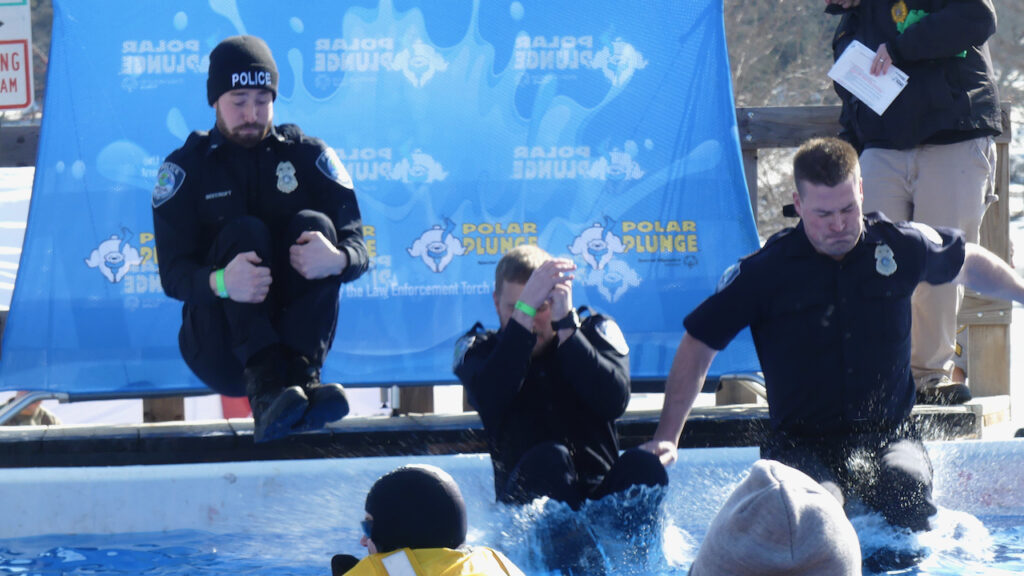
Judging by the expressions on their faces, members of the Whitewater Police Department found water in the Freeze Fest plunge tank cold. The event will once again take place in March; it has been paused since 2020.
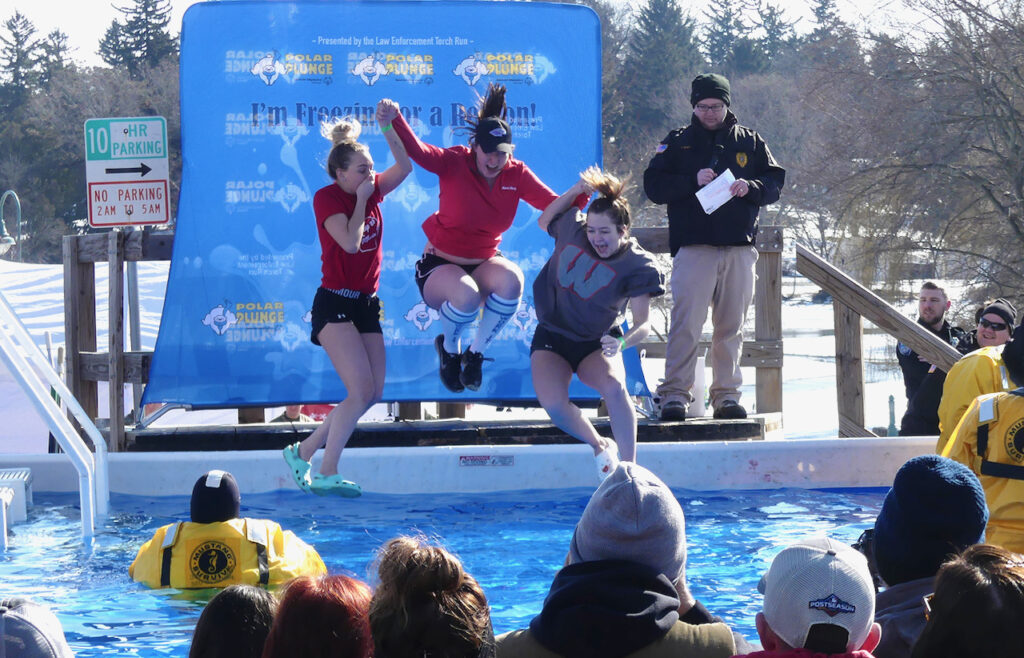
A group of University of Wisconsin-Whitewater students take the plunge.

Christopher Cohen displays his “Sweat Heat Chili.” The offering was among entries at a previously held Freeze Fest event. Contributed photos.
Whitewater: Site eyed for grocery co-op, second business, in ‘newly developed building’
(Originally published Feb. 20, 2023.)
By Kim McDarison
The Whitewater Community Development Authority (CDA) last week “voted to engage in the process of acquiring parcels along Jefferson Street, near downtown Whitewater,” for the purpose of partnering with a local developer “with the intention of locating the Whitewater Grocery Co-op on the site along with at least one other business in a newly developed building,” according to information released Friday by Whitewater City Manager John Weidl.
The information was included in a memo to the city’s common council and staff published Friday, and subsequently shared by the city on Facebook.
The action, as described in the memo, took place during a CDA meeting held Thursday, at which time members of the body voted in favor of extending an offer to purchase two parcels, the first of which is located at 126 North Jefferson St., along with a vacant parcel at 104 East Main St., at a price not to exceed $150,000 for both pieces of property.
An earlier story about the CDA’s decision is here: https://fortatkinsononline.com/whitewater-cda-authorizes-purchase-of-two-parcels-in-citys-downtown/.
Also during Thursday’s CDA meeting, and further detailed in the city manager’s memo, the CDA accepted a letter of intent from Jon Tanis “to partner with him as the adjacent property owner of the (Whitewater) Wrap and Ship (116 E. Main St.). That building and property would also become part of this proposed development within a unified structure,” the memo stated.
The identified properties are within a tax incremental financing district, the memo continued.
“Tax Incremental Financing, along with the CDA’s guidance and participation, are important components that will help ensure the success of this project and simultaneously provide return on investment for Whitewater’s taxpayers,” the memo stated.
Within his memo, Weidl noted that the project is “at the beginning,” and will undergo eight stages within the development process.
Among the steps, he wrote, is that of property accumulation and pre-planning.
“What we are doing next is sending off an offer to purchase as directed by the CDA and hoping for acceptance. The real work will start if acceptance happens, including site analysis, soil testing, and preliminary architectural and engineering design. All of that would take place before any potential sale,” he noted.

Whitewater Municipal Building, file photo/Kim McDarison.
Whitewater: Hicks, Linse, Coburn, Kromholz, Huempfner, Mills advance to general election
(Originally published Feb. 21, 2023.)
By Kim McDarison
Six Whitewater Unified School District Board of Education primary election candidates — Stephanie Hicks, Christy Linse, Thayer Coburn, Joseph Kromholz, Lisa Huempfner and Chuck Mills — will advance to the April 4 general election.
The six candidates will next vie for three seats on the district’s school board.
The six candidates were the top vote-getters emerging from a field of 11. A 12th candidate, Nathan Vander Pas, withdrew from the race, although his name appeared on the primary ballot.
Across the district, with voters weighing in from three counties — Walworth, Jefferson and Rock — vote totals were as follows: Hicks, 921; Linse, 904; Coburn, 881; Kromholz, 783; Huempfner, 771; Mills, 668; Will Dammeir, 389; John Truesdale, 364; Daniel Dern, 330; Michael Bergman, 286, and Brian Schanen, 272 votes.
In Walworth County 5,282 voters living within five precincts cast their votes.
In Walworth County, vote totals were as follows: Hicks, 731; Linse, 710; Coburn, 690; Kromholz, 629; Huempfner, 609; Mills, 514; Dammeir, 322; Truesdale, 291; Dern, 273; Schanen, 230, and Bergman, 212.
In Jefferson County, 885 voters cast their votes, including those within Ward 1 in the town of Cold Spring, Wards 1-6 in the town of Koshkonong, and Wards 11-13 in the city of Whitewater.
In Jefferson County, vote totals were as follows: Coburn, 126; Linse, 116; Hicks, 111; Mills, 107; Kromholz, 107; Huempfner, 98; Truesdale, 51; Dammeir, 50; Bergman, 44; Dern, 39, and Schanen, 25.
In Rock County, 502 voters living within the towns of Johnstown and Lima cast their votes.
In Rock County, vote totals were as follows: Hicks, 79; Linse, 78; Coburn, 65; Huempfner, 64; Kromholz, 47; Mills, 47; Bergman, 30; Dammeir, 28; Truesdale, 22; Dern, 18, and Schanen, 17.
Tuesday’s vote tallies remain unofficial until certified by county clerks.

Fort, Whitewater, Jefferson County officials meet to discuss ‘broken’ funding system
(Originally published Feb. 21, 2023.)
City of Fort Atkinson officials Monday hosted a meeting with state, county and other local level officials to discuss efforts through which they might collaborate to provide services.
An additional focus of the meeting was to “urge the Wisconsin Legislature to fix the broken system of funding critical local services,” information about the meeting released Tuesday by Fort Atkinson officials stated.
The meeting was held at the Dwight Foster Public Library and was aimed at “starting conversations with elected officials in the Wisconsin Legislature,” the news release noted.
Deb Reinbold, executive director of Jefferson County Economic Development Consortium (JCEDC) and president of Thrive ED, offered a presentation during which she discussed what she termed “the shift in economic development strategy and recent local success stories,” the release stated.
Reinbold highlighted the organization’s public/private partnership and explained the overall benefits to Jefferson County, according to the release.
“We are a connector and an ambassador. I’m not going out and building new houses, but I am connecting with developers and going out and meeting with workforce development boards,” Reinbold was quoted as saying in the release.
Additionally, the release noted that the organization’s “strategic plan is working,” citing as an example the city of Fort Atkinson’s Capital Catalyst Revolving Loan Fund, along with the Jefferson County Revolving Loan Fund and additional tools in use to entice businesses to locate in Jefferson County, including, the release stated, partnerships with the Greater Watertown Community Health Foundation, private business and others.
“We are trying to deploy as many incentives as we can to make development happen here in Jefferson County. We need a workforce for businesses to grow. From 2010 to 2020 we only added 1,006 residents. We need to try to engage people to come here,” Reinbold stated within the release.
According to Reinbold, the release stated, the unemployment rate in Jefferson County in December was 2%, and, the release noted, she said the consortium is working with the area’s under-represented populations to help fill some of the jobs in the county that are open.
The county held the first Latino Academy in Watertown to help connect people with jobs and childcare, among other programs, the release continued, adding: “The consortium also is working to keep students in the county after high school to help fill jobs in the area instead of moving away.”
As indicted in the release, Reinbold discussed a video series which she is proposing to the Jefferson County Economic Development and Thrive ED boards geared towards addressing workforce-related topics for high school students.
JCEDC also is partnering with area municipalities to address the lack of housing in Jefferson County, the release stated.
“Affordable housing is an issue, but it’s really housing of all types,” Reinbold said.
Reinbold explained that the vacancy rate in Jefferson County is 2%. The consortium is working with consultants to help municipalities solve some of their housing issues, she was noted as saying in the release.
According to Reinbold, the release noted, there are developers who are interested in building in the county in the next several years, but, she said, an issue facing developers is connected to the amount of rent they can charge in Jefferson County, which, she said, is less than that charged in Dane, Waukesha or Milwaukee counties. The consortium has been meeting with the Greater Watertown Community Health Foundation and a hired consultant to learn how to bridge the gap for developers allowing them to invest in Jefferson County.
A revolving loan fund is among ideas that are being discussed, Reinbold said.
“They all see that Jefferson County is that gateway between Madison and Milwaukee,” she added.
According to the release, officials in attendance also heard comments made by leaders in Watertown, Whitewater, Fort Atkinson and Lake Mills, focusing on the struggle to provide critical services under the current shared revenue funding formula and levy limits.
Within the release, Watertown Mayor Emily McFarland said: “I feel like I’ve been talking about shared revenue and expenditure restraint and local finance reform for as long as I’ve been in local government,” adding that she has worked at multiple levels of government for 10 years.
As noted in the release, “the expenditure restraint program provides targeted, general aid to towns, villages, and cities. The aid is targeted in that municipalities must qualify for a payment by meeting certain eligibility criteria.”
The release stated that in 2017, McFarland said she considered “turning off every other street light” to stay within the expenditure restraint program confines while giving the city’s staff a “small cost of living increase.”
The release stated: “Currently, local governments are primarily funded through property tax revenue and intergovernmental revenue — state shared revenue. Property tax revenue is limited by ‘levy limits’ imposed by state law. The law limits the local government’s ability to increase property tax revenue to the percentage of net new construction from the prior year. The statutes allow for local governments to borrow funds outside of the levy limit and to seek voter approval for an increase in property taxes through the referendum process.”
The release referenced a $1.1 million referendum question which was brought before Whitewater’s voters last November to support expenses associated with fire and EMS services, and a Fire and EMS referendum brought before Fort Atkinson’s voters in 2022.
As quoted in the release, Whitewater City Manager John Weidl said: “These challenges are not unique. Levy limits were designed to force communities into referendums and make it so the threshold is really high. Communities are hitting that threshold and are successful with referendums, but for those that aren’t, they are experiencing the real repercussions of not having the revenues.”
Fort Atkinson City Manager Rebecca Houseman LeMire said: “We saw an increase in our fire calls that required more than a volunteer response. The impact of the referendum was seen on all of our taxpayers.”
In Fort Atkinson, as indicated in the release, LeMire said that the referendum does not have an escalator and will not increase over time, even though the costs of running a fire and EMS service will continue to go up.
She added: “We will blow by expenditure restraint because of the referendum. For our 2024 budget, we will lose over $200,000 from the state because we increased our general fund expenditures past what was permitted for the expenditure restraint program.”
According to the release, Drake Daily, Lake Mills city manager, noted that Lake Mills is in an “unusual spot when it comes to net new construction, which allows a municipality to increase its budget by that percentage, because they had 2.24% net new construction.”
He added: “That allows us to increase our levy by about $65,000. We’re about two police officers behind where we should be and that would cost us about $200,000.”
As stated in the release, Lake Mills also is facing fire and EMS struggles. The Lake Mills City Council decided against placing a referendum question on the ballot in 2023, but is looking at contracted service providers that might cost between $30 and $60 more per capita compared to the $17 per capita the city currently pays for EMS.
“We are actively pursuing economic development. We’ve had success and we have grown and we are still not able to meet the needs of our residents and businesses because of the restrictions from state mandates,” Daily was quoted as saying in the release.
He called for the review of local government funding, the release stated, and added: “Core services are suffering because of it and we need to find a solution. We don’t have the resources to continue doing everything we’ve always done and continue to meet the needs of the future.”
According to the release, Rep. Scott Johnson, (R-Jefferson), attended the meeting and said he understood the needs of local government.
“Half of the state surplus is one-time money. We’re working on it. I have one vote and it’s a learning curve,” he said.
State Reps. William Penterman (R-Columbus) and Ellen Schutt (R- Clinton), were also in attendance, the release noted. Both expressed a willingness to continue an open dialog on the topic and an interest in hearing from their constituents, the release continued.
According to the release, Government Affairs Director for the League of Wisconsin Municipalities Toni Herkert encouraged those in attendance to continue the discussion and to get to know their legislators.
“If we get this across the finish line, we need to thank the legislators who took the vote. This is a huge lift,” she said in the release.
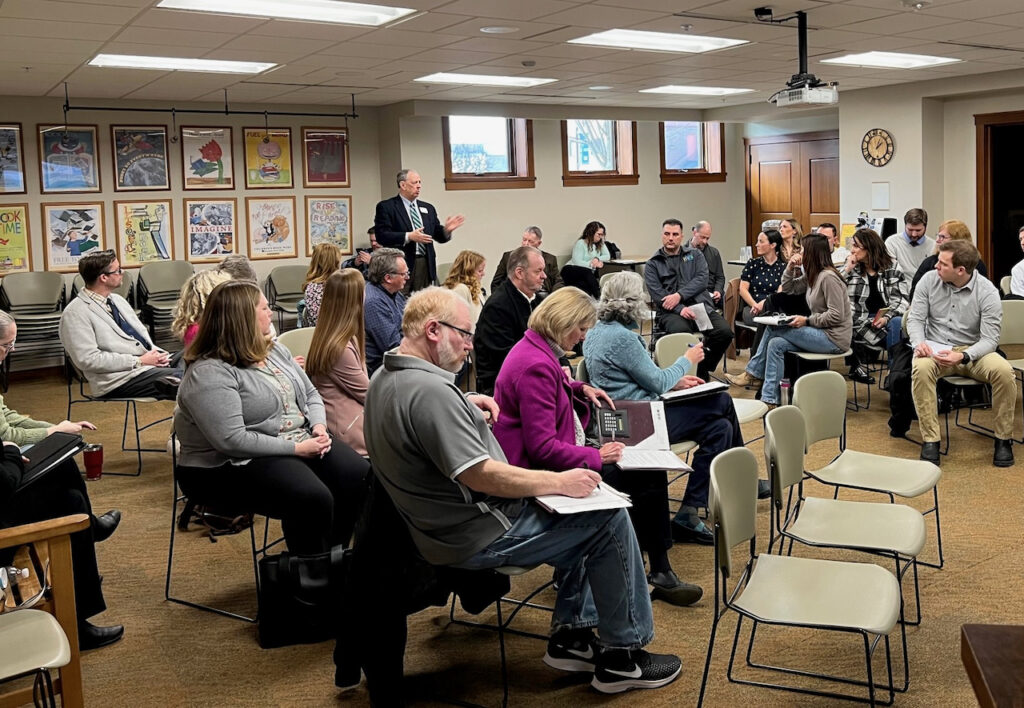
Approximately 30 state, county and local government officials gather to discuss opportunities for collaboration to fund local services. The officials met Monday at the Dwight Foster Pubic Library in Fort Atkinson.
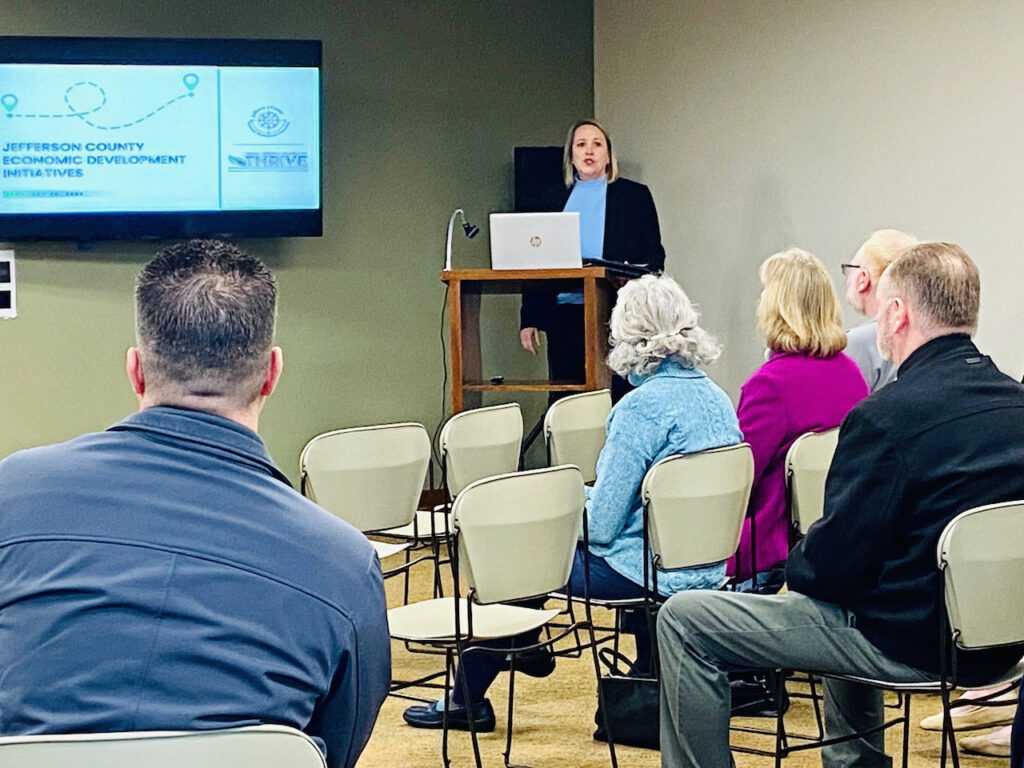
Jefferson County Economic Development Consortium Executive Director Deb Reinbold addresses an audience gathered Monday at the Dwight Foster Public Library.

State Rep. Scott Johnson addresses state, county and local officials in attendance Monday at the Dwight Foster Public Library as they discuss funding for local services and seek to urge the State Legislature to revisit the state’s funding formulas.
Contributed photos.
Whitewater: Water utility users will see 30% rate increase as part of billing in May
(Originally published Feb. 27, 2023.)
By Kim McDarison
The Whitewater Common Council Thursday approved a 30% rate increase for its water utility users.
The increase was approved by a vote of 5-0. Two council members — Jill Gerber and Lukas Schreiber — were not in attendance.
Director of Finance and Administration Steve Hatton said the Public Service Commission (PSC) approved the city’s request for a rate increase Feb. 15.
City staff, according to a memo to council written by Hatton, filed a rate case application with the PSC, after receiving approval from the city council last June.
Within his memo, Hatton noted that the average resident living in the city of Whitewater will likely see a $7.27 increase in their monthly water bill. The estimate was calculated based on water usage of 3,000 gallons per month, including public fire protection charges.
Council approved the rate increase to go into effect on April 28, which is in accordance with a 90-day period within which the rate must be implemented after its approval as stipulated by the PSC. While new rates will be applied to meter readings taken April 28, residents will see the increase represented in their bills in May, Hatton said.
According to information supplied within the PSC’s decision, the “final overall rate change authorized is $687,376, or a 30.07% increase over current rates, for the test year ending Dec. 31, 2022.”
The PSC noted in its document that the city of Whitewater sought the increase to replace two 100-plus-year-old reservoirs with a new water tower.
According to city officials, the new water tower, which came online Oct. 12 of last year, cost $2.77 million.
Other improvements associated with the water utility’s budget included lateral and main replacements on East Main Street, at a cost of $661,903, and Yoder Lane, at a cost of $117,475.
Funds for all three projects were borrowed, Whitewater Public Works Director Brad Marquardt, responding to questions from Fort Atkinson Online by email, wrote.
During Thursday’s meeting, Hatton said that among “ingredients” that led to the size of the rate increase was “some of our financial plannings and a water rate study in 2017,” which, he said “helped identify the vulnerability of our water system.” He noted that the city found that two of the three water reservoirs were more than 100 years old.
“So we moved forward on the replacement of the southwest water tank,” which, he said, “is a piece of this.”
In his memo, Hatton wrote that the rate case was filed by the city after officials identified “a need” to replace two water reservoirs in the city that were at least 100 years old.
“The planned replacement of these reservoirs was pulled forward into the 2022-2023 biennial budget due to the historically low interest rates, the availability of ARPA (federal American Rescue Plan Act) grant funding, and support of the newly established TIDs,” he added.
The PSC’s document stated: “This replacement has been on the capital planning horizon for a number of years, but was accelerated due to required investment to maintain the aged reservoirs and the availability of ARPA funds to lesson the impact on rate payers.”
Also, the document continued, “in 2022, there were two street reconstruction projects requiring the replacement of mains/laterals.”
Under a heading of “Finding of Fact,” the document noted that the city, before approval of the rate case, was authorized to charge rates for water utility service that would provide operating revenues of $2,402,721 for the 2022 test year.
“These rates fall short of the test year revenue needed by $687,376 and are unreasonable,” the document stated.
The rate change will allow the city to earn the necessary revenue requirement and are consistent with the cost of service and rate design, the document noted.
The document calculates the utility’s “estimated net investment base rate for the 2022 test year” at $13,831,166.
Further, the document stated that three water customers filed comments on the PSC’s electronic records filing system which were in opposition to the rate increase.
According to the document, “these customers expressed concern over the magnitude of the increase and its impact on customers, particularly those who are low income.”
Additionally, the document stated: “Three water customers appeared at the hearing and one spoke in opposition to the construction projects that are being funded through the rate increase.”
The document noted that the PSC “finds that the revenue resulting from the authorized rates is necessary to provide for the applicant’s financial needs over the long term.”
Within his memo, Hatton noted that the rate increase will provide $687,376 in additional water utility revenues that will be used to repay a project borrowing.
Hatton wrote: “These rates are expected to produce a rate of return on the utility’s net investment of 6.6%,” which, he noted, would provide the required rate of return by the PSC to maintain confidence in the utility’s financial integrity without resulting in rates to customers that are excessive.”
In addition, within his memo, Hatton provided a timeline of “previous actions,” which began in October of 2017, when, he wrote, Ehlers was selected as a municipal advisor.
An “initial financial management plan was completed in July of 2018, Hatton noted, adding that the last water rate change effective date was Aug. 27, 2020.
In October of 2021, the city’s Finance Committee reviewed the 2022-23 Capital Improvement Plans and corresponding financial model, along with the water utility’s operating budget, and in November of that year, the council adopted its 2022-23 budget and capital improvements plan, Hatton wrote.
In May of 2022, the Finance Committee recommended filing a rate case application with the PSC. The recommendation was approved by the council the following June.
In July, a “Utility Rate Comparison” was posted to the city’s website. A link is here: https://www.whitewater-wi.gov/554/Water-and-Sewer-Utility-Rates, and the city filed its rate case application.
A public hearing about the rate case application was scheduled in December. Water utility customers were notified about the public hearing on their bills and it was posted on the city’s website, Hatton wrote, adding that the public hearing was held in January.
Addressing council Thursday, Hatton said: “As part of this rate case, we did utilize Ehlers to help us with the process, They do have, as part of that service, they will produce an update to our cash flow forecast, so looking forward, and what the future path of rates and the health of the utility looks like, and that includes a presentation to this body if so desired.”
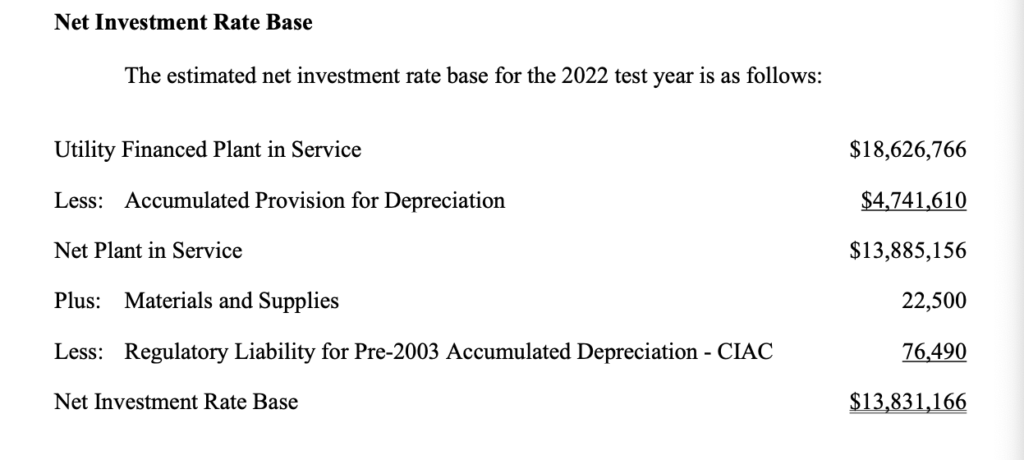
As provided in the Public Service Commission’s (PSC) decision document, shown above, the PSC calculated the utility’s “estimated net investment base rate for the 2022 test year” at $13,831,166.
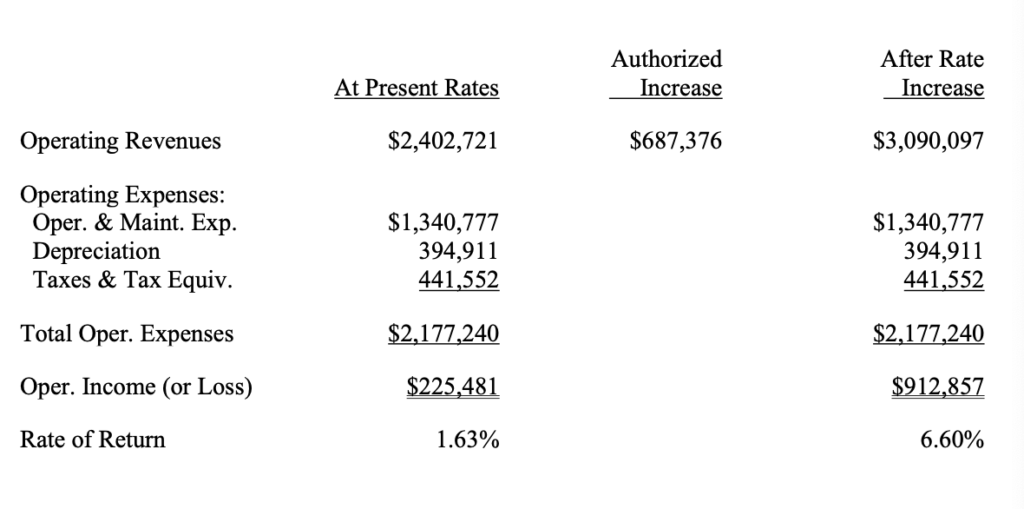
According to Whitewater Director of Finance Steve Hatton, as stipulated by the PSC, a rate of return of 6.6% is required to maintain confidence in the utility’s financial integrity without resulting in rates to customers that are excessive. On Feb. 15, The PSC approved a 30% water utility rate increase for Whitewater’s utility users. Before the rate increase was approved, the PSC calculated the rate of return for Whitewater’s water utility, as shown above, at 1.63%. The Whitewater Common Council approved the rate increase Thursday. Utility users can expect to see the impact of the rate increase represented in their bills in May.

Whitewater Municipal Building, file photo/Kim McDarison.
Whitewater: City to develop operational strategic plan; listening session offered
(Originally published Feb. 27, 2023.)
Whitewater city officials will soon begin working on an operational strategic plan.
According to a statement released Monday, the city will work with the University of Wisconsin-Madison’s Division of Extension to develop a strategic planning process, which will be used to guide the operations of the city and its budget over the next two years.
Residents interested in providing input during the process are encouraged to attend a “community listening session,” which will be facilitated by the Division of Extension, Whitewater City Manager John Weidl noted in the release.
“This session will offer people with diverse backgrounds the opportunity to express their views about key issues of concern through an organized process. The results of this effort will help city leaders and elected officials to further understand the community’s current needs and strengths as they complete the strategic planning process,” Weidl was quoted as saying in the release.
The listening session will be held Monday, March 6, from 6 to 7:30 p.m., in the council chamber at the Whitewater Municipal Building, 312 W. Whitewater St.
City stakeholders, including taxpayers, residents, commercial property owners and representatives of organizations operating in the city of Whitewater who would like to participate in the discussion are encouraged to register, the release noted.
Space is limited to the first 50 people, the release stated. A registration form is available here: https://forms.gle/xApooi8sYsuyjMW7A.
About the strategic planning process
According to the release, “the Extension Institute of Community Development works with communities to build the vitality that enriches the lives of the residents and enhances the quality of life in the community.”
Within the release, Weidl said: “Strategic planning is about our positioning the city of Whitewater relative to our competitors and to our opportunities.”
Weidl said the city is competing for potential residents and taxpayers, qualified and dedicated staff, grant money, and for other resources from non-government organizations.
Additionally, he said, the city is competing for resources from the state and federal government, calling those resources “mission critical.”
Weidl stated that grant monies could be used to make road repairs, fund new ideas, and supply services to neighboring communities and non-city residents.
Further, he noted, departments compete for supplies, financing, and resources to purchase equipment, such as new vehicles, computers, updated software and to fund marketing efforts.
“The city is also positioning itself to attract other key stakeholders, such as future employers, investors or suppliers,” Weidl noted in the statement.
Describing the strategic planning process, Weidl said city staff and officials will “evaluate where we are, identify resources, develop a vision for the future, and plan for challenges along the way. The goal is to create a roadmap to implement lean government principles, prioritize key strategic issues, identify our dependencies and interconnections, and identify what stakeholders want from the city and what the city wants from them.”

Whitewater Municipal Building, file photo/Kim McDarison.
Whitewater: City, school district to hold Aquatic Center operating, lease agreement joint negotiation meeting
(Originally published March 1, 2023.)
By Kim McDarison
Whitewater city officials have announced plans to conduct a joint negotiating meeting with the Whitewater Unified School District (WUSD) to determine a new operating and lease agreement for the Whitewater Aquatic and Fitness Center (WAFC).
A meeting of the Whitewater Aquatic and Fitness Center Subcommittee, which has representation from both the city and the school district, and is the body through which discussions will be initiated, will be held Thursday, March 2, from 6 to 8 p.m., at the Whitewater Municipal Building, 312 W. Whitewater St., Whitewater.
Those interested in learning about the Aquatic Center and negotiations underway for a future contract are encouraged to attend.
According to Whitewater City Manager John Weidl, the WAFC has been operating without a contract for two years.
According to information released Wednesday by city officials, in 2016, in conjunction with the school district, the Whitewater Parks and Recreation Board, a committee of the city’s Common Council, took over operations of the Aquatic and Fitness Center. The facility is attached to the Whitewater High School, 580 S. Elizabeth St., which is owned and operated by the Whitewater Unified School District. A leasing and operational agreement between the two entities — the city and the school district — forged in 2016 has since expired, the release stated.
“To determine the direction and future operation of the facility,” the release continued, “a new agreement will be discussed.”
“To continue the operation of the WAFC, the city of Whitewater will be working with the WUSD school board to outline an operating and lease agreement. Our goal is to keep the public and membership informed of this process and negotiations,” Weidl was quoted as saying in the release.
Early WAFC history
According to information released by the city, in 2001, a “Cooperation Agreement” was made between the city of Whitewater, the Whitewater Unified School District, and a nonprofit organization called “Setting Whitewater in Motion” or SWIM, Inc.
The document stated that the cooperating parties agreed that the community “found a need for an aquatic facility to provide recreational opportunities to the general public, serve the needs of the aquatic organizations within the community, and support the school district’s program needs for its students.”
Further, the document stated, the parties “have jointly undertaken studies to determine the feasibility of constructing an aquatic facility on a site on the grounds of the Whitewater High School.”
The document noted that funds were pledged by private individuals and entities for the construction and operation of the facility.
Under the agreement, the school district would make available a portion of the school site for the facility and pay for the construction of a locker room for school use. The city would manage the construction of the project and contribute $2 million, on a matching funds basis, toward the construction, and an additional $150,000, which would first be used toward project construction, with any residual funds allocated to an endowment fund for the project.
SWIM would contribute $3.5 million raised through private donations toward the construction project, according to the agreement.
The agreement stated that “all parties will create a non-profit entity to undertake the operation and management of the completed aquatic facility in accordance with a ‘lease and operation agreement,’ to be entered into by the parties, all as set forth is this agreement.”
Additionally, the agreement noted, the parties would build an eight-lane, twenty-five-yard competitive pool, a 2,625-square-foot leisure pool, and a 130- to 150-foot long slide, along with the required fixtures, mechanical systems and related improvements, and a school-use locker room which would be maintained and controlled by the school district.
The document further stated that the cost of the locker room, which would be used by district students and staff, was $177,627, with those costs borne solely by the school district, along with its maintenance and control.
The agreement noted that the school district would hold the title to the development and would lease the development to the operating entity for “a nominal rent in accordance with the lease and operation agreement.” The agreement indicated that the “lease of the development shall be specifically conditioned upon operation of the project as a public facility, servicing the general public recreational needs, and school district programming needs …,” noting that the initial lease and operation agreement was set for a term of 20 years, with an option to renew for two additional 20-year terms.
Terms called for the school district to make an annual financial commitment to the operation of the facility of $75,000.
In June of 2001, in keeping with the cooperation agreement, Articles of Incorporation and by-laws for Whitewater Aquatic Center, Inc., a nonprofit 501(c)(3) organization, were filed with the Wisconsin Department of Financial Institutions.
The corporation formed for the purpose of “developing, managing, operating and maintaining an indoor multi-purpose aquatic facility as a public facility serving the general public recreational needs of the city of Whitewater … and its recreational programs and the programmatic needs of the Whitewater Unified School District.”
The organization’s by-laws stated that its board of directors would be comprised of two directors appointed by the city, two directors appointed by the school district, and five directors appointed by SWIM.
2016 contract
According to information supplied by the city, in 2016, the school district and the city entered into a new lease agreement which continued to stipulate that the aquatic facility would be used by the general public and the district. Additionally, it noted: “The lease and operating agreement provides for the use of the aquatic facility by the general public. The aquatic facility is primarily intended to serve the recreational and programmatic needs of the general public, but the school district also wishes to use the aquatic facility for curricular, special education and extracurricular purposes.”
In 2016, the parties agreed that the city would rent the aquatic facility to the school district for its requested purposes at a cost of $7,500 annually, with payment due “on or about July 1.”
Scheduling assets within the facility to allow the district to meet its needs would become the obligation of the city’s Parks and Recreation Board.
As stated within the document, meeting the district’s needs would require its use broadly of the lap and leisure pools, and fitness center throughout the year, and more specifically, for health and physical education courses, and related curricular actives and practice, along with individual instruction for students with disabilities, and training and competition for co-curricular competitive swim teams representing the district.
To meet the general public’s recreational needs, the document outlined public use of the lap pool, fitness center, and leisure pool for youth and adult swimming lessons, along with parent-child recreational programs, health and recreational programs for senior citizens, and other general recreational uses.
To facilitate fair use of the facility between the parties, the document stipulated that the school district by April 30 of each year, would provide the Park and Recreation Board with a proposed schedule of the district’s programming needs for a period between Aug. 1 through July 31 of the following year. Likewise, a proposed schedule for public use of the facility would be provided by the city. The parties agreed to meet to resolve scheduling conflicts within 30 days of receipt of the district’s proposed schedule or June 1 of that year, whichever was later.
Within the 2016 agreement, language continued to identify the district as the sole user of the locker room, and made it solely responsible for its maintenance and upkeep, including any mechanical systems used to maintain it, regardless of where within the facility those assets were located. The district is also identified as the entity solely responsible for all costs associated with utilities, such as sewer, water, and devices to heat water, electricity and HVAC utilities that support the locker room.
The terms of the 2016 agreement were put in place for five years, commencing July 1, 2016 and ending June 30, 2021.
2021 contract
According to information released by the city, a lease and operation agreement, which is entered into the record unsigned, was drafted with a proposed effect date of June 28, 2021.
Offering some history, the document noted that the Whitewater Aquatic Center, Inc., operated the aquatic center through its lease and operating agreement from Dec. 15, 2001 to Dec. 14, 2016, and, the document stated, “the city and the school district have agreed that the Park and Recreation Board of the City of Whitewater assumed the responsibility for the operation and management of the aquatic facility.”
The document further noted that the school district would have the right to appoint two members to the city’s park board.
The terms of the 2021 agreement were proposed for a five-year period, beginning July 1, 2021, with an expiration date of June 30, 2026.
The language stipulated that the parties could extend the new contract “only by mutual written agreement of the city and school district.”
The contract noted that, as terms of the new agreement, “the city shall pay to the school district annual rent of one dollar, payable in advance on the commencement date on each annual anniversary of the commencement date.”
Additionally, the contract stated: “the park board will have the sole and exclusive control over and right to schedule, allocate and lease space within the leased premises. It is anticipated that, in connection with the operation of the aquatic facility, the city may enter into (a) sublease/use agreements with various individuals and user groups, and (b) contractual arrangements with concessionaires, management companies and other service providers. The school district consents to such use agreements and service contracts, all of which, however, shall be expressly subject and subordinate to the terms of this agreement.”
The city’s park board also would become solely responsible for staffing the aquatic facility, with the exception of the district’s locker room.
Looking at finances, the 2021 contract noted that the aquatic facility would have a separate budget, and will “maintain a separate operating account from the city and the Whitewater Parks and Recreation Department. The parties will split all aquatic facility expenses equally to the extend that they are not covered by revenues generated by the park board,” the document stated.
The document proposed a contribution of $153,000 made by the city to cover aquatic facility costs in 2021, and a contribution of $178,000 in 2022, and each of the remaining years covered by the contract.
The district’s contribution in 2021 was set at $145,000, and at $170,500 for each remaining year of the agreement. The amounts could be subject to change on an annual bases with mutual agreement by the parities, the document stated.
Under a heading of “Lack of Funding,” the document stipulated that either party could terminate the agreement at any time upon giving the other party 90 days’ notice. The clause could be triggered, the agreement noted, if the district “is unable to fund its obligations under Section 5.01.F through its Fund 80 community service budget,” and the city could exercise the clause would it discover it was incurring “loses of substantial sources of funds — for example shared revenue — such that it is no longer practical for the city to continue to fund its obligations under this agreement.”
Additionally, under such sets of circumstances, the document continued, “the city and the district would be equally responsible for refunding prorated membership fees if the facility closes.”
A potential inception point for Thursday’s negotiations
According to information released by the city, in January, the Whitewater Unified School District held a “special board meeting.” A document released by the city indicates “positions” and “summary/details,” associated with the meeting.
According to the document associated with the January meeting, the district holds the position that the previous lease agreements note that “maintenance and repair obligations are the responsibility of the city.”
The document states: “It is the position of the school board that the repairs, maintenance and replacements have not been made in accordance with the agreement and need to be made in order to move forward with negotiations/creation of a new agreement. Additionally, negotiations should include a presented budget, including a fund plan for long-term maintenance.”
In order to make necessary repairs, the district offers consideration of a referendum brought before the taxpaying public in the fall of 2023.
The document further notes that “prior debt,” in the amount of $413,429, “is not the responsibility of the school district.”
The school district further recommended that the management of equipment, such as HVAC, at the aquatic center, “due to a lack of maintenance/repairs,” should be performed by district personnel.
A document, prepared by members of the city’s staff in December of last year, noted that the aquatic center opened in 2001 and was operated by a board. In 2003, Mercy Healthcare took over the operation of the facility. In 2009, the Whitewater Aquatic Center (WAC) Board, assumed its operations.
In 2016, the 15-year operational agreement expired and the city’s Parks and Recreation Board took over the operations of the facility “under a new agreement with the school district.”
According to the document produced by city staff, the WAC facility operated at a deficit of more than $400,000 between 2016 and 2021, with those expenses paid by the city. Within the document, the city contends that the school district is responsible for half of the deficit, and has made no payment to-date.
In 2021, the document added, the city drafted and approved the 2021 lease agreement with some changes.
“The school board never passed a revised agreement that included the changes requested by the city council,” the document noted.
An agenda and background information supplied by the city in advance of Thursday’s meeting is here: https://www.whitewater-wi.gov/AgendaCenter/ViewFile/Agenda/_03022023-1660?packet=true.
About the Aquatic and Fitness Center
According to information released Wednesday by the city, “for individuals, families, students, seniors, and commuters in Whitewater and beyond, the WAFC provides an affordable, convenient recreational fitness environment with a variety of amenities including: fitness center, aquatic center, group classes, locker rooms, and concessions.”
Whitewater Parks and Recreation Director Eric Boettcher noted within Wednesday’s release that the community has continued to offer support for the facility.
Since COVID-19, he said, “we have focused on rebuilding membership and creating new ways to access our facility. We are currently in the process of implementing 24/7 access for the fitness center.”
In addition, the release noted that “from January 2022 to January 2023, the WAFC increased total membership revenue from $16,789.99 to $24,719.00, day pass revenue from $5,887.07 to $8,963.69, and total active memberships from 1,488 to 2,176. In 2023, the WAFC aims to add another 300 new members and increase revenue by $20,000.00.”

Whitewater Municipal Building, file photo/Kim McDarison.
Whitewater: $600,000 to $1.5 million needed to address Starin water tower; Finance Committee to investigate options
(Originally published March 4, 2023.)
By Kim McDarison
The Whitewater Common Council Thursday voted to send a report — indicating that between $600,000 and $1.5 million would be needed to either demolish or repair the historical water tower in Starin Park — to the Finance Committee for further evaluation.
The measure was decided by a 5-0 vote. Two council members, Jill Gerber and Lukas Schreiber, were not in attendance, but comments from both were read into the record by council President Lisa Dawsey-Smith in advance of the vote.
According to information presented Thursday by Public Works Director Brad Marquardt, a structural analysis report, produced by Wauwatosa-based McEnroe Consulting Engineers, noted that demolition of the historical water tower in Starin Park would cost approximately $600,000, while repair of the structure would cost between $1.1 million and $1.5 million, depending upon whether the work was done contiguously or in phases. A phased approach would command the higher price point, he said.
Structural analysis
Presenting information from the report to council, Marquardt noted that council authorized city staff to contract with McEnroe to perform the structural analysis of the tower last year, and the report was completed in January.
Information was first shared with the city’s Public Works Committee, Marquardt said, adding that information from that discussion was available in the meeting packet associated with Thursday’s council meeting.
Referencing the analysis, he said, “in general, the report indicates that the tower is in good condition.”
Still, he said, according to the report, “some elements are a little worse off than fair condition.”
Among “primary issued identified in the report,” Marquardt listed “stone cracking and deterioration, primarily at the belt course at each tier; cracked stone around the entry; bad mortar joints on the exterior and interior, and some of the steel supporting girders show corrosion.”
Marquardt next talked about costs and estimates, noting that he had contacted the Public Service Commission (PSC) to determine if any amount of the project’s costs could be paid by the city’s utility.
Marquardt said the PSC indicated that monies from the water utility could be spent up to the cost of demolition.
Looking at the cost of performing maintenance work and repairs, he said, McEnroe offered estimates between $950,000 and $1.1 million in 2023 dollars.
“That’s assuming if it was all done in one construction season. We do not have any money budgeted in 2023 for any of this work, so we would be looking at 2024 at the earliest if it would be the wishes of the council to maintain this tower,” Marquardt said.
As reported by Marquardt, the analysis also looked at doing the work using a three-phased approach.
“Basically to do work over three phases would add some costs to the project, raising it to what they (McEnroe) estimate to be about $1.5 million over those three-phased years,” Marquardt added.
He noted that the analysis also had been shared with the city’s Landmarks Commission.
After his presentation, Marquardt said he was looking to council for “some direction at some point.”
He asked: “How (do) we want to go about this — if we just want to accept the report and use it as a budgeting tool for future budgets or where (do) we want to go?”
Council discussion
Councilwoman Carol McCormick said that during the Public Works Committee meeting, she suggested the city might include a non-binding referendum regarding the tower on the upcoming April ballot, “just to get more of a broader picture of what the public feels about the reconstruction or demolition,” she said.
She noted receipt of “a lot of emails and a lot of talk about the tower,” adding that the issue had been added as a topic on the city’s online engagement Polco platform account, which, she described as “a very limited audience.”
Responding to questions from City Manager John Weidl, City Clerk Michele Smith noted that inclusion of a question on the April ballot was no longer an option as those ballots had already been ordered.
Dawsey-Smith next read statements from two council members who were not in attendance Thursday.
Reading from a statement provided by Gerber, she said: “Jill Gerber has indicated that she has done a fairly high level of analysis on other historical water towers throughout the state and did note that fundraising was done for all that had been preserved. She would hope that in the future, as anything was considered, there would be local quotes for potential for removal of the item if that was determined, and then would like to see the Finance Committee continue the discussion ahead of council for the implications on our capital improvement plan.”
Reading from a statement provided by Schreiber, Dawsey Smith said: “having been on the Landmarks Commission and reading the emails from the local historical society regarding the water tower, he would not be opposed to looking into keeping the water tower. He is for accepting the report into our records and looking into ways to possibly make it into a tourist attraction or implement it as a historical site. He thinks that the benefits of this discussion to keep the water tower outweigh the costs of maintaining it, but that is for a different agenda item, assuming that it would come back to us in the future to consider the cost of maintaining it and some possible ways to keep it standing. He would also not be opposed to an outside entity taking over the water tower if that were an option.”
Weidl asked Marquardt for specifics about a potential timeline.
Marquardt said McEnroe indicated that the condition of the tower was “safe.”
“The only issue that they see right now is rocks falling off the facade, which we do have the fence up which should alleviate that concern,” he said.
Weidl next asked Finance Director Steve Hatton if the $600,000, identified by the PSC as potentially coming from the city’s utility, could be seen as a “potential source of revenue” to “jumpstart” the tower’s preservation.
He asked: “How would that practically happen? Would that mean the utility would be taking on debt to do something like that, or in the event we demoed it, we would come up with the money and then effectively, the money would get transferred …”
Said Hatton: “We don’t have a cash-on-hand, so we’d have to explore ways to finance that, but, yes, if $600,000 of it — if a regulator would approve as the water utility’s share of —whether it’s demolition or if that’s used in a different way where they no longer have an ongoing financial obligation towards it — yes, we could explore different financing plans, but we do not have cash on hand to dedicate in that way.”
Following Hatton’s response, Weidl addressed council, saying: “at a minimum I’d like some time for staff … I’d like to use that $600,000 as a tool to have a thought about both how we would start the process of ensuring preservation — demolition is pretty straight forward — we send out the RFP (request for proposals) … but at least some time to toy with the numbers. We just kind of got ‘em and based on any feedback we get …”
Councilman Jim Allen said he was in support of a future referendum question, adding: “From the Public Works standpoint, I agree with Carol, that we thought there’s certainly time, that this item could wait five to 10 years, at such point when the city has funds to do something with it. Right now, of course, we don’t have any funds to do much of anything, to keep the services that we have. We have to be realistic about that. This would also give time for Landmarks, or whoever wants to take on the project, to do some fundraising, and lastly, I talked to several developers in town who would take it down for much less than $600,000.”
Approaching the podium from the gallery, Neil Hicks, who is running unopposed in April to fill an open Aldermanic District 5 seat, said he was in favor of the idea of placing a referendum question about the tower on an upcoming ballot. Incumbent Greg Majkrzak has announced he will not seek reelection in April.
“If you get three-fourths of the city to tell us what to do, then I guess it can’t be wrong,” Hicks said, adding that he believed there would likely be foundations that would consider funding maintenance for the tower, especially, he said, “if this is one of the oldest water towers in the state, as they’ve been saying.”
He also asked about an antenna which he believed was attached to the tower, citing potential for a need for licensing or regulatory approvals to move or maintain it.
Looking at potential placement for a non-binding referendum question, Weidl asked: “Michele (Smith) is the next election in fact in November?”
Smith responded that it was not, noting that opportunities would next come early next year.
Said Allen: “There’s no immediate hurry on this.”
Majkrzak said: “I share the thoughts of everyone. You know, it’s (historical water tower) really cool; I think it’s nice to have as part of our town. Having sat through the feedback on the (Cravath) lake (drawdown and restoration project), and the money that was invested, I think that adds a lot more value to this town than the water tower does. I think putting it on a ballot would be a really good choice. I love the idea of donations, but I think — I won’t be here when this decision’s made — but the ongoing maintenance and upkeep of this has to really be considered, because if this is a landmark of Whitewater, then it’s going to have to be a budgeted item that we’re going to have to spend money on.”
Councilwoman Brienne Brown asked if the $600,000 identified as potentially coming from the city’s utility could also be used to fulfill the requirements of any potential matching-funds grants for which the city might apply.
Dawsey Smith asked fellow council members if the questions raised and ideas posed were sufficient to constitute a framework which staff might use to further investigate options.
Weidl asked council if they were looking to have a non-binding referendum placed on the next available ballot.
Allen said he was in favor of waiting longer.
“We don’t have any foreseeable funds,” he said.
Said Dawsey Smith: “I would recommend that this item be taken to the Finance Committee as a part of the consideration of the capital improvement plan, and the changing landscape even interest rates are causing, so that there can be further investigation into the financial impact both to the utility or the taxpayer or whatever else may need to be considered, because there’s a substantial amount of information that still would have to be fleshed out, correct?”
The motion was approved.
Responding to questions raised about an antenna atop the tower, Marquardt said he would need to “double-check,” but, he said, “I believe that’s for our SCADA (supervisory control and data acquisition) system so we can send signals back and forth to the plant.”

Historical water tower in Starin Park, file photo.
Whitewater: Police investigate newborn found deceased
(Originally published March 4, 2023.)
Editor’s note: The following information has been released by the Whitewater Police Department.
On Saturday, March 4, 2023, at 11:12 a.m., Whitewater Police and EMS responded to the area of Twin Oaks Mobile Home Park, 755 N. Tratt St., for a report of a deceased newborn located in a field. This is an ongoing investigation, and no additional information will be released at this time.
Whitewater Police are seeking any information that may assist in the investigation. Anyone with information should contact the Whitewater Police Department at 262-473-0555 option #4, or email our Detective Bureau directly at jbrock@whitewater-wi.gov (Detective Justin Brock) and aheilberger@whitewater-wi.gov (Detective Anthony Heilberger). Anonymous tips may also be shared using P3Tips.com.
The Whitewater Police Department also wants to ensure the public is aware of the “Safe Haven for Newborns legislation” (Wis. Stat. 48.195). This law guarantees the rights of parents relinquishing custody of newborn babies, 72 hours old and younger, anonymously and confidentially. Newborns can be relinquished to a law enforcement officer, emergency medical services practitioner, or hospital staff member without fear of legal consequences.

File photo.
Whitewater: Police ask public for information regarding newborn found dead in a field, Spanish translation included
(Originally published March 6, 2023.)
The Whitewater Police Department Monday issued a statement noting that it continues to investigate the death of an infant whose body was found in a field behind the Twin Oaks Mobile Home Park, 755 N. Tratt St., Whitewater.
An earlier statement about the incident has been translated into Spanish, Whitewater Police Chief Dan Meyer noted Monday.
The body was found Saturday at 11:12 a.m., according to information released by the department.
The statement, released Saturday by the department in English, is here: https://fortatkinsononline.com/whitewater-police-investigate-newborn-found-deceased/.
A Spanish translation, released Monday, follows.
La policía de Whitewater investiga el hallazgo de un recién nacido fallecido
Whitewater, WI – 4 de marzo de 2023 –El sábado, 4 de marzo de 2023, a las 11:12 am, la Policía de Whitewater y EMS respondieron al área de Twin Oaks Mobile Home Park en 755 N. Tratt St. por un informe de un recién nacido fallecido localizado en un campo. Se trata de una investigación en curso y por el momento no se facilitará más información.
La policía de Whitewater está buscando cualquier información que pueda ayudar en la investigación. Cualquier persona con información debe ponerse en contacto con el Departamento de la Policía de Whitewater en 262-473-0555 opción # 4, o por correo electrónico a nuestra Oficina de Detectives directamente en jbrock@whitewater-wi.gov (Detective Justin Brock) y aheilberger@whitewater-wi.gov (Detective Anthony Heilberger). Las denuncias anónimas también pueden compartirse utilizando P3Tips.com.
El Departamento de la Policía de Whitewater también quiere asegurarse que el público sepa de la legislación Refugio seguro para los recién nacidos (Wis. Stat. 48.195). Esta ley garantiza los derechos de los padres que renuncian a la custodia de recién nacidos, de 72 horas de vida o menos, de forma anónima y confidencial. Los recién nacidos pueden ser entregados a un agente de la ley, a un profesional de los servicios médicos de urgencia o a un miembro del personal de un hospital sin temor a consecuencias legales.

File photo.
Whitewater: Aquatic Center subcommittee discusses operations, finances
(Originally published March 6, 2023.)
By Kim McDarison
A meeting of the Whitewater Aquatic and Fitness Center Subcommittee — comprised of representatives from both the city of Whitewater and the Whitewater Unified School District — took steps Thursday towards negotiating a new operating and lease agreement for the community’s aquatic facility.
According to an agenda published on the city’s website, the subcommittee meeting was initially scheduled to take place at the Whitewater Municipal Building in the city’s council chambers for two hours, from 6 to 8 p.m.
The meeting, which lasted for approximately one hour, focused largely on two presentations made by city officials, including a history and overview of both the operations and finances of the facility, followed by a period for public comments.
Nine residents spoke before the subcommittee, with a majority in favor of keeping the facility open.
The Whitewater Aquatic and Fitness Center (WAFC), city officials have noted, has been operating for the last two years without an agreement between the two parties: the city and the school district.
Both entities have engaged — through representation on a nonprofit organization’s board or directly, with the exception of a five-year period when MercyCare Health operated the facility — in financial and operational responsibilities through contractual agreements since the facility opened in 2001.
An initial contract went into effect in 2001, followed by a second, placed into effect in 2016.
In 2021, a new agreement was drafted with some contingencies by the Whitewater Common Council. The new agreement continued stipulations for joint operation of the aquatic facility by the two organizations through 2026.
The document remains available as part of the city’s record unsigned.
A story about the history of the WAFC and its contracts is here: https://fortatkinsononline.com/whitewater-city-school-district-to-hold-aquatic-center-operating-lease-agreement-joint-negotiation-meeting/.
Members appearing Thursday as part of the subcommittee and its supporting panel included: Whitewater Finance Director Steve Hatton, Whitewater Parks and Recreation Director Eric Boettcher, Whitewater City Manager John Weidl, Common Council President Lisa Dawsey Smith, Whitewater Common Council members Jim Allen and Jill Gerber, Whitewater Unified School District Board of Eduction members Larry Kachel, Jennifer Kienbaum and board President Thayer Cobern, school district Superintendent Caroline Pate-Hefty, school district Director of Business Services Ben Prather, and school district Director of Buildings and Grounds David Friend.
Goals, overviews presented
Weidl opened the meeting by directing the panel to a “number of documents” provided by the city.
“I think what we are hoping for … is some dialog between the elected officials to provide some guidance to staff as to the type of research we may be missing, questions you may still have, opportunities you want us to take a look at, things that you might want to set an opinion on, and I also know we are prepared … to give a brief history, at least we can go as far back as when the city started taking this over and provide some context,” Weidl said, adding that Hatton would provide during his presentation a five-year history of the facility’s “financials.”
Aided by slides, Boettcher said that the aquatic center opened in 2001, was operated by the Whitewater Aquatic Center Board from 2001 until 2002, and was operated by MercyCare Health from 2003 to 2008. Between 2009 and 2016, the operations returned to the Whitewater Aquatic Center Board, and the city and the school district entered into an operational partnership in 2016 until present time.
Boettcher said capital improvements made to the facility completed in 2016, totaling more than $160,000, included cardio equipment, pool pumps, a pool vacuum, floor repairs, fitness equipment, televisions and carpeting. In 2017, improvements, coming at a cost of $7,800, included a spa rock wall, a pool pump and pool floor door. In 2018, some $98,000 was spent on such improvements as a pre-core machine, “one of four boilers,” and spin bikes. Nearly $48,000 was spent in 2019 on improvements noted as “two of four boilers.” In 2020, improvements, costing just under $53,000, included starting blocks, pool pump repair, pool valve covers, pool floor repairs, play structure repairs including painting, and UV system repairs. In 2021, improvements included a water softener, at a cost of approximately $9,900. In 2022, improvements, costing $18,275, were listed as “fitness center” and “RTU,” or rooftop air handling unit.
Total improvements made over the seven-year period cost $395,613, according to slides shared by Boettcher.
Under a heading of “Key Capital Improvements Remaining,” Boettcher listed: HVAC upgrades, including building-operating software, and air handling units in the pool and locker room areas.
He noted that while two of the four boilers within the aquatic facility have been replaced, two others have not. All are currently functioning, he said, adding that replacement of the remaining two might be needed “five to 10 years out.”
Boettcher said two boilers were required to handle facility operations. With all four boilers working, they were being used in a rotating cycle.
Other pending improvements listed were: play structures, which, Boettcher said, would be replaced because replacement parts for the equipment were no longer available; lap and leisure pool floors; leisure pool deck; slide tower repairs; locker room upgrades; replacement of pool equipment in the lap and leisure pools, and whirlpool, and roofing replacement and “other exterior needs to be discussed with WUSD (Whitewater Unified School District).”
Under a heading of “Financial Overview,” Boettcher said in 2000, the project was begun with a $2 million investment made by the city, a $200,000 investment along with land at the high school site contributed by the school district, and $3.5 million was used to fund the project brought forth by the nonprofit group “Setting Whitewater in Motion” or SWIM.
Between 2002 and 2016, the city and the school district each contributed an annual fixed amount of $75,000 to the functions of the facility.
Since that time, Boettcher said, contributions made by both entities have increased.
Beginning in the summer of 2016, he said, payments from both entities increased to $128,000, with $78,000 spent on operational expenses and $50,000 earmarked to fund capital expenditures.
In 2021, Boettcher noted, with the city and the district being equally responsible for any shortfalls in revenue, the annual support increased by $50,000, for an annual total payment provided by each entity of $178,000.
He noted that the city has continued to fund the operations of the facility, which, as of December, 2021, is showing a deficit of $413,429.
Looking more closely at finances, Hatton, sharing a document, which, he said, had been prepared and circulated as an update to packeted information, and showed the performance of the aquatic facility between 2016 and 2022 at “a very high level.”
Hatton noted that in 2022, the aquatic center showed revenues of $689,000, which was an increase over the previous year when the center showed revenues of $504,000.
Before COVID, when the schools and the facility shut down, he said, in 2019, the facility showed revenues of $776,190.
Hatton said in 2022 a breakdown between operating and capital expenses showed that the operating expenses approached a break-even point, coming in at $682,000, with capital expenditures at $18,275, which produced a net revenue loss for the facility of $11,598.
In 2021, he said, the two organizations, the school district and the city, “changed the level of contributions to try to get the facility to a self-sustainable point.”
The city’s contribution was increased by $25,000 over a period of two years, for a total of $50,000, he said, adding, “so that we’re now $50,000 above the original commitment from the 2016 agreement.”
Additionally, he said, “Through discussions with the school administration, and in preparing that ’21 agreement, the preferred course communicated by the district at that time and built into that agreement was a more laddered escalation of those school district contributions.
“Beginning at this time, in 2021, we began to differentiate to show both the reflection of mismatched and timing of contributions, and amounts, as well as that encapsulates the 50/50 distribution of any shortfall in the operating deficit at that point in time.”
Contributions “weren’t equally paced any longer” at that time, he said, adding that “at the close of 2021, … the acquired deficit since 2016 is $413,000. Once you add the 2022 deficit, we are talking $425,000 on a combined basis.”
Looking at revenues and membership, Boettcher said that, following a return to operations after the COVID-19 shutdown, there has been a focus on rebuilding membership and revenues.
He noted that from January 2022 to January 2023, the WAFC increased total membership revenue from $16,789.99 to $24,719.00, day pass revenue from $5,887.07 to $8,963.69, and total active memberships from 1,488 to 2,176.
Aided by a pie chart showing membership in 2022, Boettcher said, of 1,810 members, a breakdown by point of origin is as follows: Whitewater, 1,139 members or 31.5%; “other,” 283 members or 7.8%; Fort Atkinson, 231 members or 6.4%; Milton, 72 members or 2.0%; Janesville, 56 members or 1.5%, and Elkhorn, 29 members or 0.8%.
Following the presentations, Kachel asked: “The numbers from Fort Atkinson, is there a big business or … hospital there that you get a lot of memberships from?”
Said Boettcher: “They don’t have a winter pool and I think we have quite a bit of faculty that go to the university.”
Said Kienbaum: “Can I ask a question about operations? So I’ve heard some discrepancies and I just think this is a great forum to kind of clear them up. It’s my understanding — you made a comment that all four boilers work, but we were informed that that’s not the case. So I don’t know if between whoever’s in charge of maintenance on your end and who’s looked at it on our end, but can you clarify some of the discrepancies?”
Said Boettcher: “I think someone brought up at another meeting at one time that we only had one working boiler. That is not true. We have — all four boilers are working. We have two that are newer, one that was replaced in ’18 and one that was replaced in 2019. So all four of those boilers work. As I said before, you need at least — when it’s really cold — you need at least two boilers to operate, and when I got here, that was one of our biggest concerns was making sure that we never had to shut down because we couldn’t keep the water. So we currently have two newer boilers, and so, since they rotate, even if one of those boilers or two of those boilers ever go out, we would still be able to operate because of the functioning boilers we do have.”
The two older boilers work, he continued, adding: “so they are in that rotation, it’s just that they are older, and so their life expectancy, about 15 to 20 years, we are getting at the end of that life expectancy obviously, so if one of those were to go out, that gives us time to replace it, to order it and get it to come in, because, like everything now, it’s not like you can get it the next day; it’s three to six months. So this allows us that time.”
Said Friend: “Boiler 3 was in need of repair, but has been repaired since the last time we walked through.”
Said Boettcher: “Yeah, some of it’s been, like the computers talking to it sometimes we have to reset or readjust the sequence of how they were fired, things like that, but our maintenance staff has managed to take care of that.”
Public Comments
Upon completion of the presentations, the floor was next opened for public comments.
Whitewater resident Jeff Knight, who said he was speaking on behalf of himself and his wife, Sharon, noted that he had previously spoken about the pool before both the city council and the school board. Additionally, he talked with “a number of elected officials,” at which time, he said, “I keep hearing a lot about the financial position of the aquatic center and the kind of a hole they’re in. And I think it’s really important for us to note the timing … on the heels of a pretty significant pandemic. Both the city and the school district had some of the toughest closure practices in the area.”
When he spoke before the two bodies, he said, he asked each about their use of COVID relief funds to offset the costs associated with the pool during those “difficult times.”
“I believe the answer is no in both cases, but I’m pretty sure that’s the case. I’ll continue to follow up if I need to put that in writing,” he told the panel.
Knight handed out information to panel members, which, he said, was provided by a company called Trane, and showed that of 100 school districts the company surveyed, 65% of them used COVID relief funds to make HVAC upgrades.
“I would encourage both the city and the school district to sit down and work with the aquatic center to help secure any federal or state money that may be available. I would hate to see us miss that opportunity,” he said.
Knight said he and his wife were members of the aquatic center and they were impressed with the manner in which staff had worked to present a positive attitude and put the aquatic center “back on track,” following setbacks from COVID.
“I think there needs to be some positive messages out in the community and thank these people for doing this under very difficult conditions,” he said.
Knight continued: “Let’s remember that two governing bodies represent the people of the area, and my hope is that they can get beyond what looks like minor difficulties and hammer out an agreement on behalf of us out here. For the life of me, I can’t understand how anybody could consider it good management to allow a contract to lapse for over two years.”
Addressing the panel, he said: “So everyone that’s sitting there that’s been there for that period of time, I’m serious, I think this is a serious breach on our behalf and I’d like you all to get back to fixing it.”
Knight provided the panel with information he handed out developed, he said, by the Center for Disease Control (CDC) offering statistics about drowning deaths among children, noting that among certain age groups, the CDC finds drowning to be the second leading cause of unintentional injury and death behind incidents involving motor vehicles.
“Let’s realize what an important community asset this facility is and calm the tension and stress of staff and members created by rumors and lack of a binding agreement. Please, just get this done and keep the facility open in its current configuration,” Knight concluded.
Whitewater business owner Geoff Hale described the facility as “a community asset we just can’t afford to lose.”
He added: “We are getting people to come from outside Whitewater to Whitewater, and that’s one of the main reasons to have such a facility. This is not the Titanic, it’s not a sinking ship. It’s more like the Enterprise that got hit by a kamikaze, and it went on to live for a long, long time after that.”
Hale said that he saw potential in attracting members to the aquatic facility from Fort Atkinson, noting that the neighboring community has an outdoor aquatic facility, but not one that’s indoors.
“You might concentrate on that. As reported when they got that summer park there, they don’t have a winter park, so in the wintertime it would be an ideal place for more and more people to come from Fort.”
Addressing issues of finance, he said: “Less the COVID tragedy, you know, we are on the right track, and the trend is going in the right way. And if we ever lost something like this, I think it would be a huge violation of the public trust for what has been invested in this over time in Whitewater and the community.”
Area resident Guy Ledwell said he works for a company that supplies “most everything in that building,” adding that he works with commercial pool customers across the country.
He said he speaks with boards, including those representing colleges, across the country and they are working to build pools like the one in Whitewater.
“We already have one. It’s been managed poorly,” he said.
“I’ll just say things that I’ve noticed going on over time,” he said, noting that in his experience, “there are people who are thriving with facilities like this.”
He described other facilities as having ice cream cases that have product.
Describing other similar facilities, he said: “They are never out of soda; these things bring in revenue.”
He said he thought the facility was “built right to begin with,” but over time, he said, “I just watch it take these big notches down.”
He suggested that the panel work to develop better marketing and budgeting.
Additionally, he said, he believed the aquatic facility could be outfitted in the future with updated and more energy-efficient equipment.
“There is a lot of newer technology than this that everybody relies on, and before you invest in any more boilers, I would minimally look into that. Obviously you don’t want to replace anything that is correctly working now, but there’s low pressure UV which uses far less energy,” he said.
He added: “I think there are people you can reach out to to really get some better knowledge about how to go about this. I’d be happy to help. I think this thing is a jewel of the city; I hope we figure out how to do it.”
Whitewater resident Jim Winship said he served as a city council member between 2012 and 2014, and was on the council when the current UV system was installed.
“It made such an incredible difference,” he said, noting that, for him, as a swimmer, it made the experience more enjoyable and, as a council member, he appreciated that it saved the city money.
Winship said he hoped any ideas about discontinuing the aquatic center were “truly off the table.”
He talked about goals set by the city to attract families into the community.
“Every community talks about how wonderful their schools are, and we have wonderful schools, how wonderful the parks and recreation department is, and we’ve got one of those, and what Whitewater has right now are two jewels that other communities don’t. One is proximity to the university … and the second is the aquatic center,” he said.
He said that for him, when he talks with other swimmers about the aquatic center, “you know, you feel proud.”
He said he believed a proposed renovation of the city’s library could serve one day as a third jewel of the city and would also attract young families to Whitewater.
Whitewater resident Karen Kachel said she has been a member of the aquatic center since its opening in 2001. She joined the fitness center when it opened in 2004, she added.
She said she came to the subcommittee meeting after her workout at the center and noted that 210 people had used the center just that day.
“And they were not all residents of Whitewater. So I’m going to guess that they probably ate lunch here, they probably dropped some money in the city of Whitewater, they probably maybe filled up their gas tank,” Karen Kachel said.
Additionally, she said, she noticed swimming lessons taking place, and about 30 people in the fitness center using various pieces of exercise equipment.
“In my opinion, I think the city has failed pretty poorly in marketing this place. As others have mentioned, it is a jewel of this city, a jewel of this county, and there has not been nearly enough done to reach out to get members from Fort Atkinson, Lake Geneva, from really, from all over the county, and Janesville,” she said.
She added: “I think the school district is probably getting a pretty good deal on this facility. They’re getting use of a six-lane pool for all these years, for lessons. They (students) also come into the fitness center and there are classes that they can take. I just saw a sign up for the high school using the fitness center as well for the month of March and April. I don’t know why WAC hasn’t returned to having birthday parties. That is a real cash cow, and that’s not happened again since COVID. There’s real money in that. I feel they could do a better job at having food in concessions — a lot of markup on that. People come, they’re hungry, they want to eat. When I look behind the counter, it’s not a real good selection and they run out a lot … I feel that the school district did a real disfavor to WAC when they pulled the plug on allowing the high school kids to come over at lunch. That was a huge money-maker.”
Karen Kachel said that the city has spent money over the years on a band shell and business park.
“It seems to me that the health and welfare of our citizens and our children in this community as well as surrounding communities and counties, that should really be a priority,” she said.
Christy Linse, who identified herself as a candidate running for school board, said she was speaking as a community member and a mother, “to express the importance of the aquatic center, the fitness center and the lap pools. Jeff (Knight) touched on it a little bit, but this provides life-saving services. One cannot put a value on teaching kids how to swim. This facility provides that.”
Further, she said the facility provides kids with things to do during long winters.
“It also provides the middle and aging population with healthy activities to do, social opportunities to do, all of these are vital for a healthy community. I have two nieces that graduated from the school district … (they) spent a lot of time in those pools, and I’ve heard nothing but fantastic things about the swim program. And I feel like the city and the school district need to come up with a good plan, a fair plan, that’s going to keep the facility open. Just some of the feedback I’ve heard from other families is if they (school district) can find $1.8 million for athletic fields, they can find it for pools, and I agree,” she said.
Area resident and former school board member Henri Kinson said that unlike most of the people in the room, he was “around” when the facility was built.
Said Kinson: “I remember the cast of characters who came up before the school board begging for money, telling us that the pool would not go over budget … The Whitewater in-crowd got the school board, who always wanted to be part of the cocktail circuit and was also constantly whining about not having enough money, to cut its instruction budget by $60,000 a year to fund it. To do that they canned the reading specialist at Lakeview. … I voted against it at the time and was blamed for all future drownings in Whitewater as a result.
“My, my, how things have not changed. But some things have changed. The reading scores at Lakeview have. They’ve dropped like a rock, but the payments to the pool have not. We just saw tonight, they’ve tippled to $180,000 a year, meaning now we cut three teachers per year to fund the pool. And for what?”
Kinson claimed about 20 kids used the pool during after-school swimming programs.
Meanwhile, he said: “70% of Whitewater’s students are not proficient at math. The district has other things to worry about. It would be interesting to hear from the school board candidates, including the board president, who has voted for well over a million dollars in pool substitutes during his tenure, how they feel about that. Maybe they’ll ask that at the next candidate forum instead of asking what newspapers the candidates read.”
Kinson said funding the pool was not a part of the school district’s mission.
“Don’t get me wrong, I think the pool is great, I used it for years, until they tapped me on the shoulder when I was working out at 55 and told me to put my mask on. I left for good,” he said.
Kinson said the value of the pool to members of the community was not the issue, but rather the issue was one of who should pay for it.
“I would think the city, with its hijinks at the library, appears to have extra money — has money to spare. But even if it doesn’t, it’s the city’s and possibly the townships’ problem, not the district’s. The district just won a referendum that didn’t raise property tax rates by a whole 6%. I can assure you, anything to do with raising property taxes for this would go down in absolute flames … It’s time for the district to reassess its priorities, and it should start with the pool,” Kinson said.
Whitewater resident Chuck Mills said: “First of all, I don’t care about the money, what it costs to keep this thing running. There’s over 2,000 individuals using this pool at this point. It’s one of the most used pieces of property we have in this town, whether, I don’t care who’s running it, the school or the city.”
Speaking about personal need, Mills said he has emphysema and diabetes, and the equipment at the aquatic center is essential in maintaining his health.
“So this pool keeps me alive. Without this pool, I don’t survive, because I can’t bike all winter and fall. I can’t put a price on that,” he said, adding that he believed other community members in their 60s, 70s, and 80s, whom, he said, also are taxpayers, make use of the facility to enjoy similar health benefits.
Additionally, he said: “There are more than 20 kids using this pool. Kids have to learn to swim or you’re going to read about their obituaries in the paper when they fall off the end of that pier or they are out there partying at 16 years old and never got the chance to learn to swim. I don’t care if they just spend one semester in this pool. It will teach them for life how to survive.”
Mills said the discussion was not just about money.
“We find more money to waste in this town on things that we don’t use, and people don’t care about, and this is the most used piece of equipment we have. I don’t know what the game plan is, but you’ve got to figure a way because I’m never going to shut up. You close this pool, it will be the biggest stink this town ever saw,” he said.
He cited issues revolving around management and equipment maintenance which, he said, he had previously brought to the council’s attention.
He noted that about three months ago, many of the issues were addressed. He commended the panel for making the adjustments.
Whitewater resident Elizabeth Smith described herself as “new to the community.”
“I think the pool is amazing. I think health is something that we need to put our time and investment in. This morning when I was swimming I ran into a woman who was from Janesville. I think your point about marketing is huge. I don’t know the finances obviously, but I think health has to be our priority and I think a lot of people do use it, and I find it a fabulous jewel,” she said.
Board discussion
Following public comments the panel talked about setting a time for its next meeting. Two dates, April 11 and May 11, were selected, with a meeting time for both dates set at 6 to 8 p.m.
Pate-Hefty asked the panel to keep in mind moving forward the differences in each entity’s budget cycle.
Weidl asked if panel members had questions revolving around materials found in their packets.
None were offered.
Larry Kachel said he wanted to point out from a historical perspective that the document created in 2001 included an “inflation rider” for both the city and the school district, which was meant to increase the amount of their annual payments, which he noted at $75,000 each, by the rate of inflation. Using inflation rates from 2001 to 2016, he said, would the city and school district have increased their payments accordingly, by his calculation, there would have been an additional $412,000 which could have been applied to operational costs of the facility.
Pate-Hefty asked about inspections made to the center’s slide.
Boettcher said he would provide the district with information, noting that annually, the slide must be inspected by an engineer as part of the licensing process that allows the facility to operate its slide. The slide was last inspected in January, he said.
Referencing a sticker on the slide from 2003, Boettcher said the process that placed the sticker was no longer used.
Panel members agreed that the sticker should be removed.
Said Larry Kachel: “We need to find a way to make this work. It is too important to the community.”
Dawsey Smith said she agreed.
The meeting was adjourned.
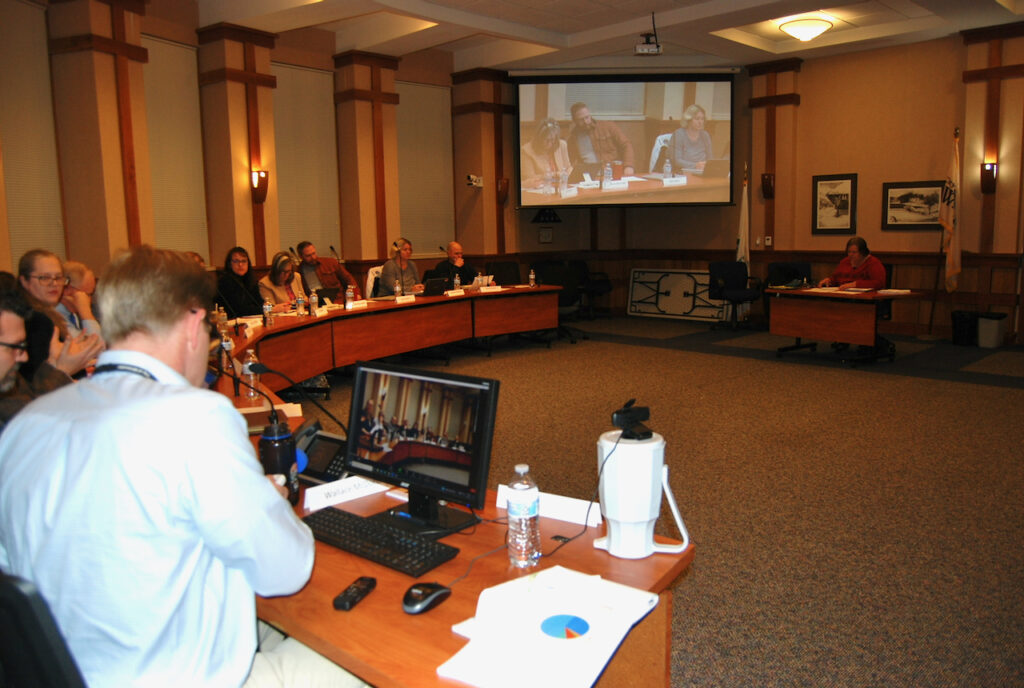
Members of the Whitewater Aquatic and Fitness Center Subcommittee, which includes elected officials from both the Whitewater Common Council and the Whitewater Unified School District Board of Education, along with supporting panel members, assemble to begin the process of forming an operating and lease agreement for the aquatic center. The facility has been operating for two years without a contract, city officials have said.
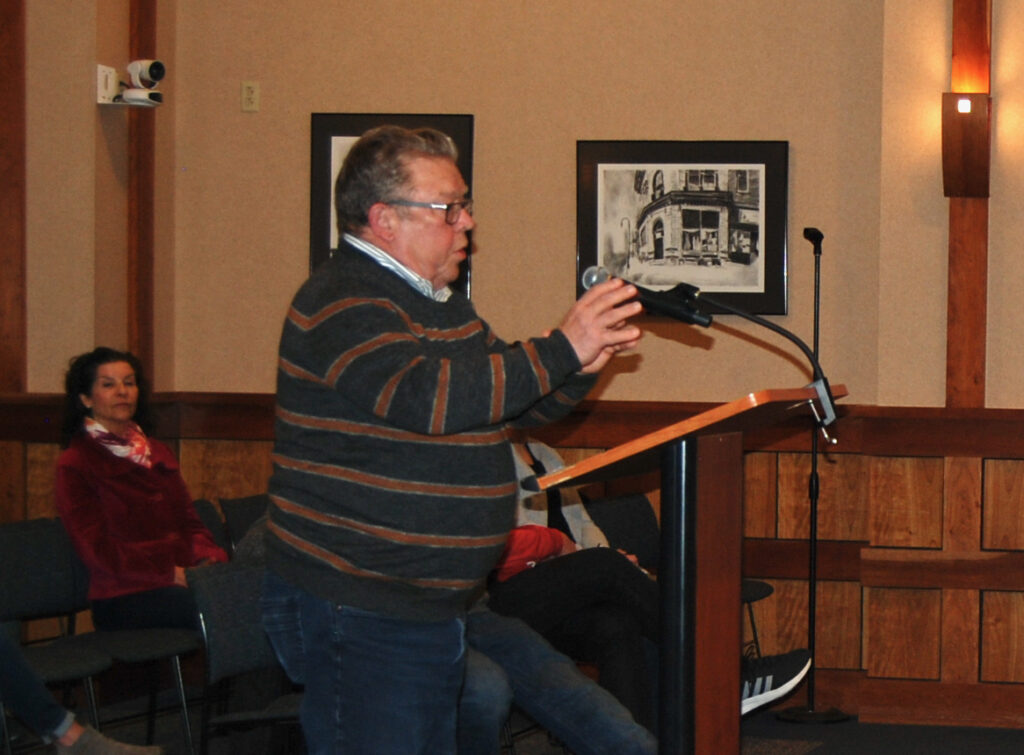
Whitewater resident Jeff Knight is among nine members of the public addressing members of the Whitewater Aquatic and Fitness Center Subcommittee Thursday. Knight, like the majority of the speakers, offered comments in favor of keeping the facility open.
Kim McDarison photos.
Weidl: Facts about city, library that ‘cannot be disputed’
(Originally published March 8, 2023.)
By John Weidl
I would like to share a several facts about the City of Whitewater and the Irving L. Young Memorial Library that cannot be disputed.
The City of Whitewater’s vision statement reads: Building upon our rich history, we will continue to be a welcoming, safe, and dynamic community. We will embrace the cultural and educational opportunities that the presence of a thriving University and an increasingly diverse population offers.
That is a fact and cannot be disputed.
Further, the City of Whitewater’s mission is to provide efficient and high-quality services which support living, learning, playing, and working in an exceptional community
That is also a fact and cannot be disputed.
Culture is the customs, arts, social institutions, and collective achievements of a particular nation, people, or other social group.
That definition is a fact and cannot be disputed. I hope you see where I am going with this.
Community is a group of people living in the same place or having a particular characteristic in common. Such as the scientific community, the business community, the student community, AND the LGBTQ+ community.
Ladies and gentlemen, friends, colleagues, and anyone reading this message, our community’s esteemed and trusted library director, Stacey, and her knowledgeable and inclusive staff ARE providing high quality services that provide cultural and educational opportunities for our increasingly diverse population – promoting living, learning, playing, working, and participating in our exceptional community.
Those are facts and they/them cannot and will not be disputed.
Editor’s note: John Weidl is the Whitewater city manager.
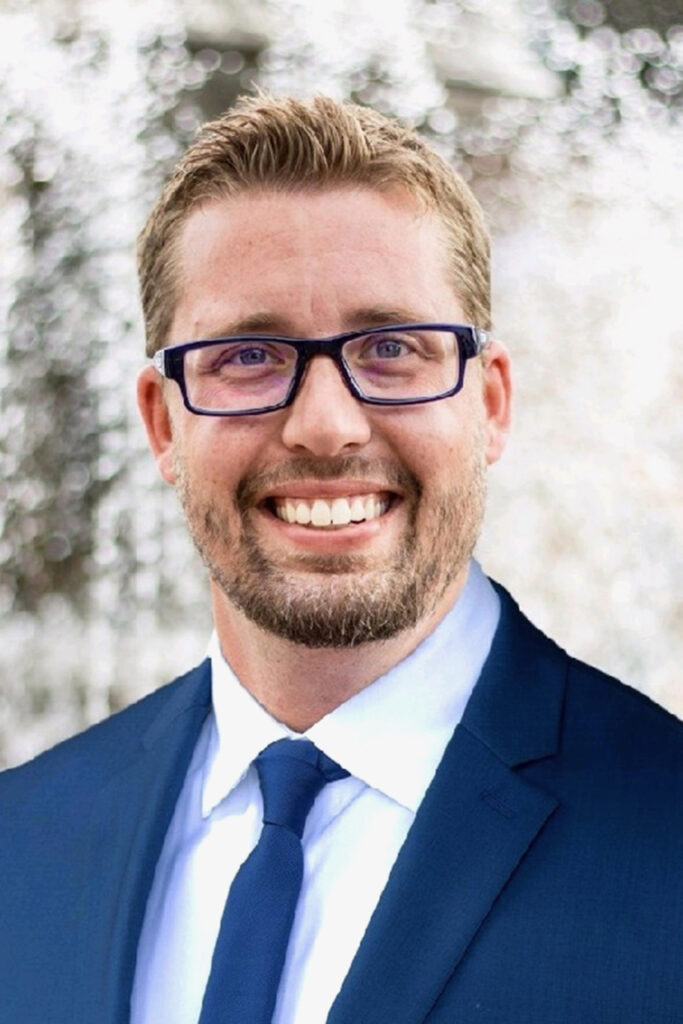
John Weidl
.
Whitewater: Public art project underway; boards available for pickup
(Originally published March 10, 2023.)
By Kim McDarison
A Whitewater public art project is underway featuring boards that area artists are invited to turn into barn squares.
According to Ashe McDarison, manager of the Whitewater Arts Alliance, the project is offered annually and has, in the past, featured such items as birdhouses, chairs and plywood scrolls, among other items and plywood cutouts, for decoration by area participants. The items are then hung throughout the summer months from lampposts within the city’s downtown.
Those interested in participating may arrive at either the Whitewater Cultural Arts Center, 402 W. Main St., Whitewater, or the Whitewater Area Chamber of Commerce office, 150 W. Main St., to register for participation in the project and pick up a 2- by 4-foot plywood board.
McDarison noted that a board can be purchased for $10 in person at either location or can be purchased online for $12, and picked up at either location.
Monies collected from board sales are used to support the cost of the materials, ze said.
In a recent interview, project chairperson Mary Nevicosi said boards were not cut into squares, but instead were cut into the traditionally sized boards used for the annual project.
Artists can use the additional space to dedicate the work to someone, or personalize the board in some way, or sign their name to their art. “Or do two squares,” she said, adding that artists are at liberty to decide how to use their real estate.
McDarison said boards should be decorated on both sides and artists can use a wide range of mediums and materials to cover their boards, however finished boards cannot weigh more than 20 pounds. Each board also must be “clear-coated” to protect the images from the weather, McDarison noted, adding that a single board also can be the work of a group of people.
Artists are encouraged to make their boards creative, whimsical, unique and quirky, McDarison said, but are asked to avoid company logos, advertising, and any depictions of messages that offer religious or social disrespect. The Whitewater Arts Alliance reserves the right to make final decisions on any boards offered for inclusion within the public art project, ze stated.
Finished boards must be returned to the Whitewater Arts Alliance or the Whitewater Area Chamber of Commerce by April 15, McDarison said.
For more information about the Whitewater Arts Alliance, including its hours of operation; the Whitewater Cultural Arts Center, and the 2023 Public Art Project, visit the alliance’s website: https://www.whitewaterarts.org.
For more information about the Whitewater Area Chamber of Commerce, including its hours of operation, visit its website: https://www.whitewaterchamber.com.
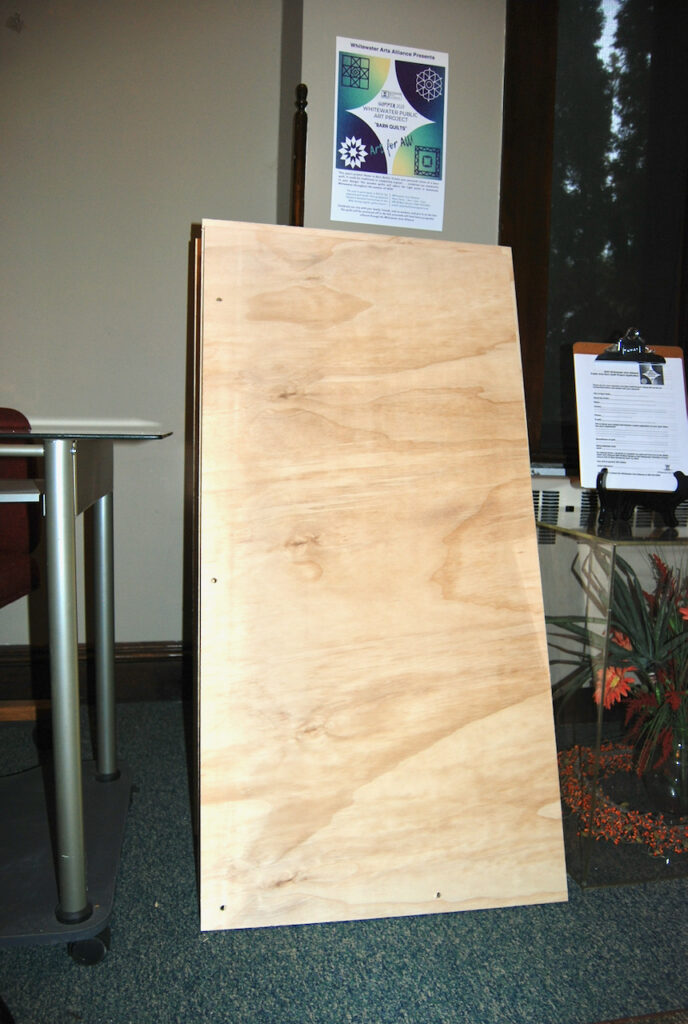
Precut boards are on hand at the Whitewater Cultural Arts Center. The boards are available for pickup by those who would like to participate in this year’s public art project. The theme this year is barn squares. Kim McDarison photo.
Weidl: ‘Integrity first, service before self, excellence in all we do’
(Originally published March 12, 2023.)
Editor’s note: Following is commentary submitted for publication by Whitewater City Manager John Weidl.
Integrity first, service before self, excellence in all we do. These are the core values that drive me as a public servant with almost 25 years serving in the public, non-profit, military, and educational sectors.
Integrity first. This means we do what is right even when no one is watching. Whether it is being where we say we will, even if no one is there to clock us in, or it is doing the things we will say we will do, even when the position’s discretion and autonomy provides us the opportunity to do otherwise. Having integrity means the community can count on us to respond when their needs arise, rely on us to follow through, and despite any disagreements, people will continue reaching out to us because they know we prioritize our oath to serve the community above all else.
This also means we do not distort the truth, not about our successes, our failures, where things stand, other people in the organization or community, or to otherwise improve our own position – not with spoken word, not through email, not through others, and not online. We do not lie to achieve outcomes, even if the outcome itself achieves positive results. This also means we do not trade in gossip or rumors and our integrity requires we remain professional even in the face of unprofessional people and conversations. We will not attack someone personally for doing what they are asked to do professionally. Our strategic partners will know that where we stand on an issue is not based on where we sit with respect to any spectrum of beliefs.
Service before self. This means we put the needs of others first – our increasingly diverse community, our coworkers, our customers, our constituents, and everyone else who relies on the city and its services each and every day. We will not use the foundations of our position and our authority or power to further ideas and agendas that are self-serving or seek to bring harm to others or the community. We serve all others equally, without fear of reprisal. For those that would seek to admonish us for this commitment, we continue to serve with the same professionalism and diligence for you as we serve all.
While serving others before ourselves, we will remain mindful of the great responsibility that is given to the city government, as an organization, and to us as its stewards, to create policies and programs that provide essential community and capacity building services. We will continue to build and expand services that reflect the changing nature of the way people live, work, shop, and play in Whitewater and across the region. This includes ensuring equal access to public spaces that promote educational and cultural opportunities supporting diverse languages, cultures, and yes, viewpoints.
Excellence in all we do. Blending our integrity and our service together, we do that in pursuit of truly excellent government and governance. We will be excellent in our own actions first and we will seek to help those around us achieve excellence as well. We will be excellent in our desire to provide transparent services and operations. We will be excellent in pursuit of the outcomes of the city’s strategic plan. We will be excellent incorporating input that represent a cross-section of the community and our desire to continue to bring residents, employees, business owners, the school district, and the university into the decision-making and communications process.
We will have tough conversations because avoiding them is a failure to our community and the progress it has demanded we achieve. We will use community input gathered in an open, transparent and respectful manner. We will stretch for transformational ideas and goals because nothing worth doing comes at zero cost. We will use our powers to uplift and build instead of destroying.
In short, integrity first, service before self, and excellence in all we do. Those are the values I ask that you incorporate into your thinking and being because it will lead to the betterment of our entire community.
John Weidl
Whitewater City Manager

John Weidl
Sixty attendees hold candlelight vigil to mourn baby’s death
(Originally published March 12, 2023.)
By Kim McDarison
An estimated 60 community members gathered in Whitewater Saturday to hold a candlelight vigil to mourn the passing of a baby found dead in a field one week earlier.
According to information released by the Whitewater Police Department, the baby’s body was found behind the Twin Oaks Mobile Home Park, in the 700 block of North Tratt St., Saturday, March 4, at 11:12 a.m.
Police described the baby as “newborn.”
Police have opened an investigation into the incident and have asked anyone with information to contact them.
Those in attendance on Saturday gathered near a memorial site, marked by a wooden cross, printed with the initials “RIP.”
While offerings, such as toys and flowers were earlier placed near the memorial, some visitors to the site Saturday added similar offerings and candles before joining with others who stood in observance of the baby’s passing by candlelight.
A Fort Atkinson Online freelance photographer described the event as “very subdued.”
Lasting approximately 15 minutes, the full observance included a prayer offered by Kevin Tranel, a pastor at The Chapel in Whitewater.
The observance next offered several selections of recorded music, including an instrumental rendition of “Amazing Grace.”
The observance closed with a prayer spoken in both English and Spanish offered by Pedro Lara.
A news release from the Whitewater Police Department, requesting information from the public about the baby and the circumstances under which it was placed in the field, and sharing the department’s contact information, is here: https://fortatkinsononline.com/whitewater-police-ask-public-for-information-regarding-newborn-found-dead-in-a-field-spanish-translation-included/.
Freelance photographer Tom Ganser contributed information to this story.
Photos from the observance follow.

A monument, erected in Whitewater in a field where a baby’s body was found earlier this month, continues to gather offerings such as toys, flowers and candles. The monument served Saturday as the gathering spot for mourners who held a candlelight vigil and observance for the child.
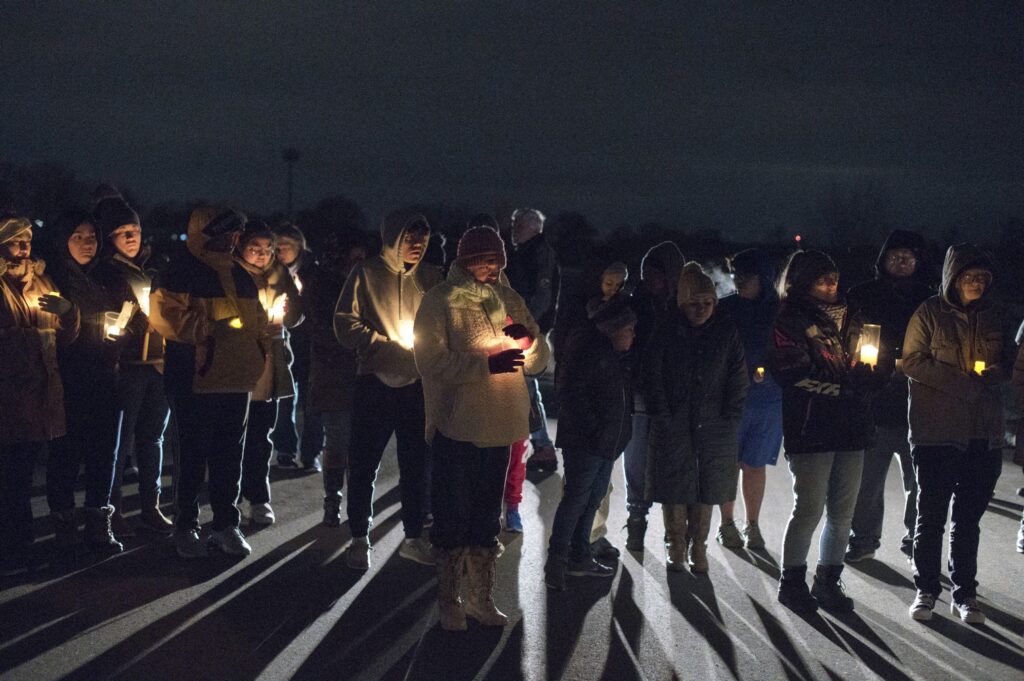
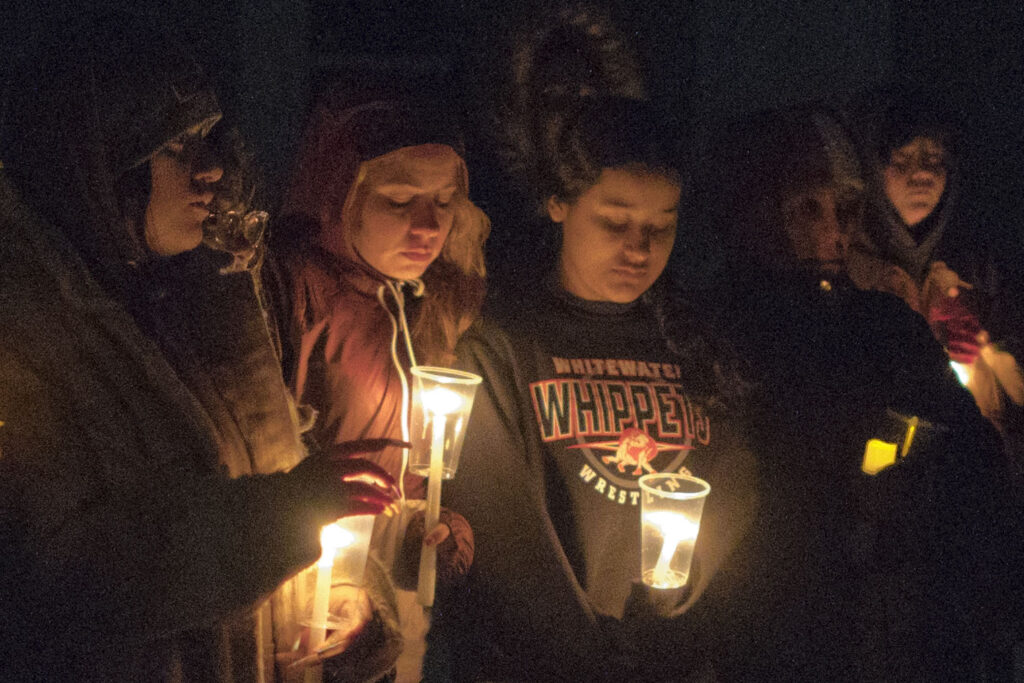
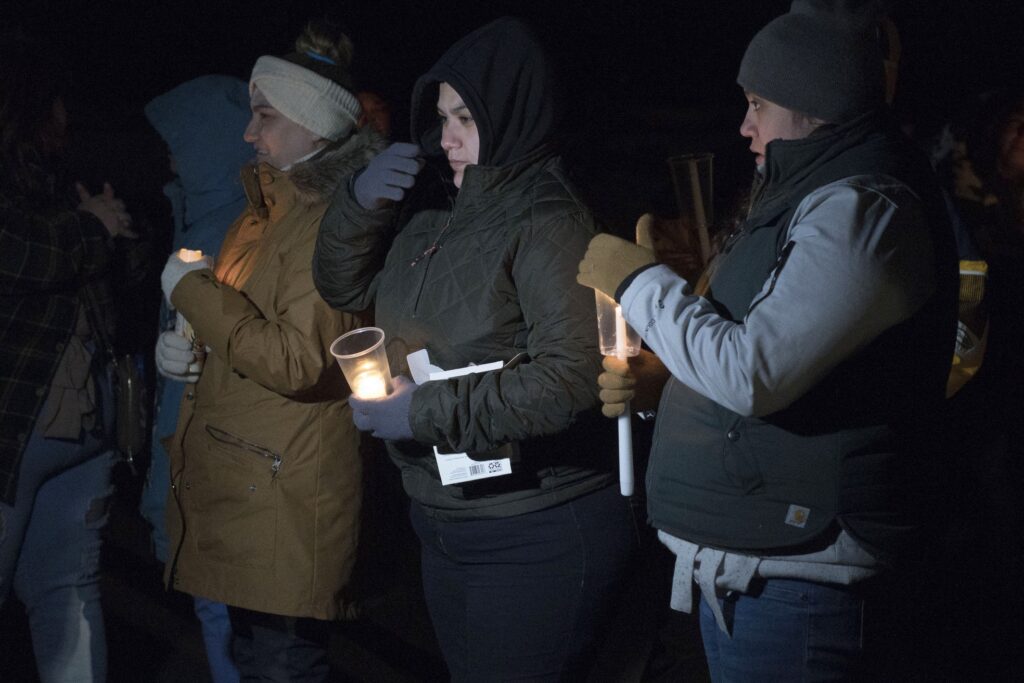
Three photos above: Mourners hold a candlelight vigil in remembrance of a baby found dead in a field in Whitewater earlier this month.
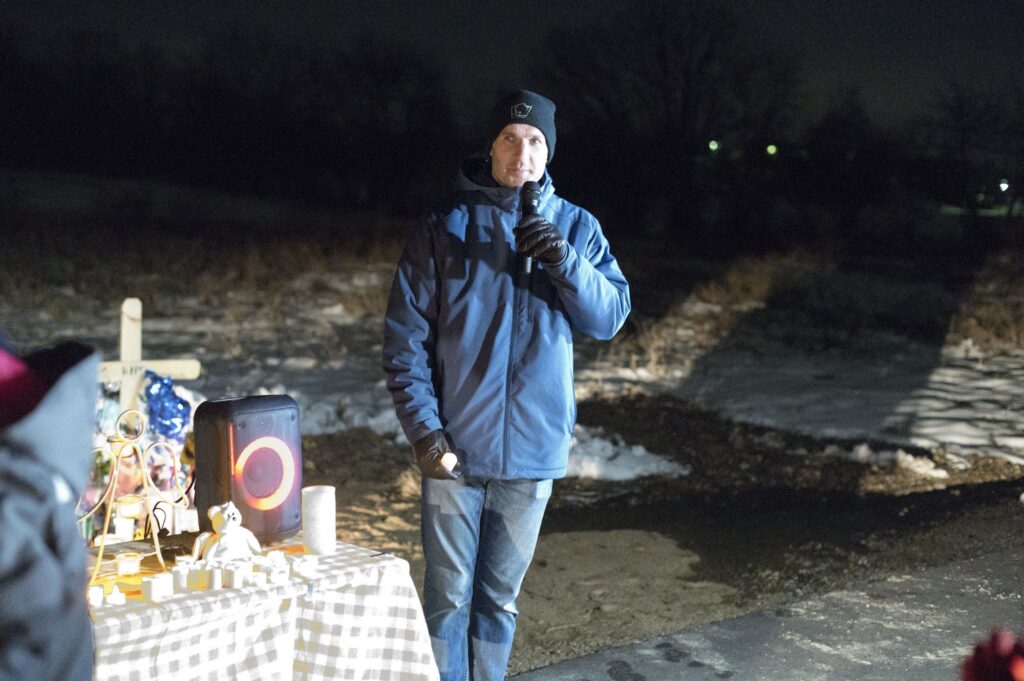
Pastor Kevin Tranel, of The Chapel in Whitewater, offers a prayer during the vigil.
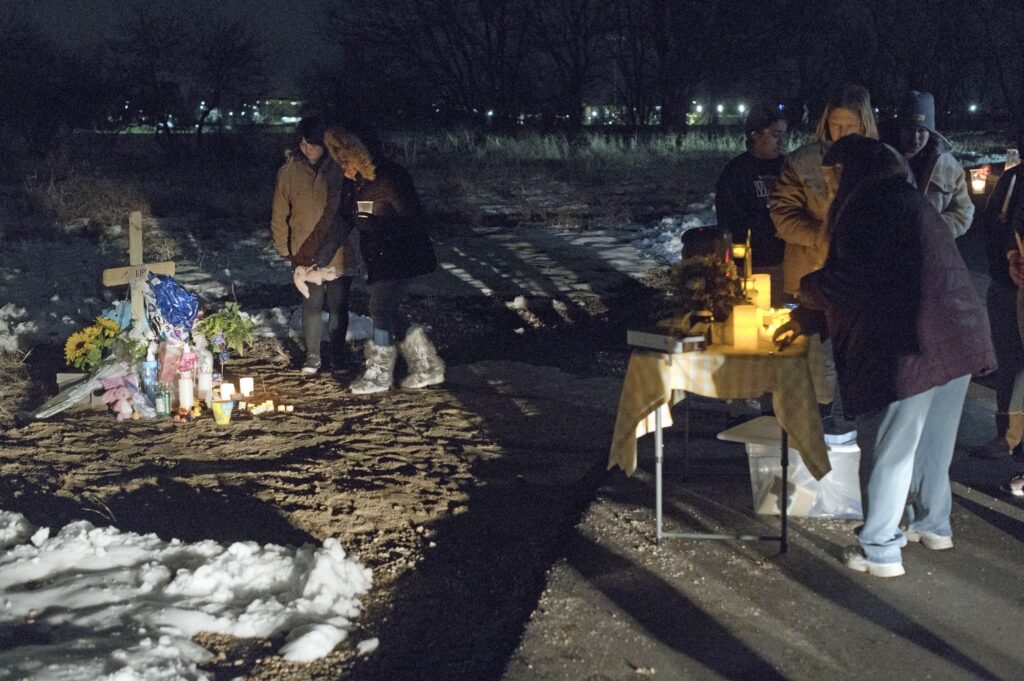
Attendees arriving to participate in the vigil place offerings at a monument erected in a field where the baby’s body was found.
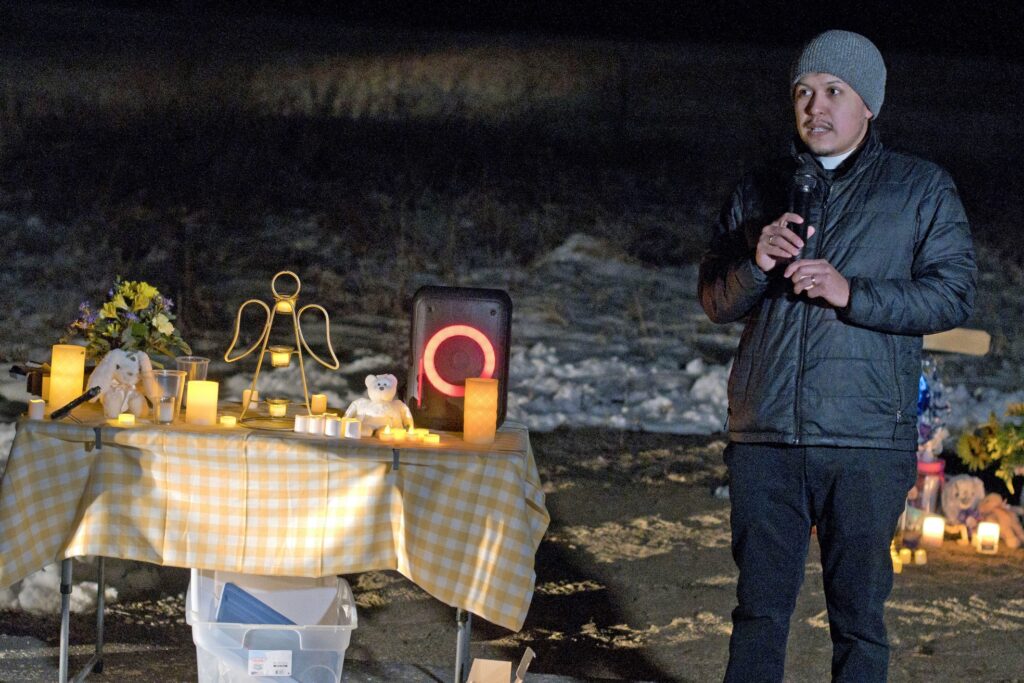
Pedro Lara offers a prayer spoken in both English and Spanish during a candlelight vigil held Saturday.
Tom Ganser photos.
Whitewater: Police seek help identifying parents of newborn found dead in field
(Originally published March 13, 2023.)
Editor’s note: The Whitewater Police Department has released the following details regarding a newborn baby found dead in a field earlier this month.
The following information is being released by the Whitewater Police Department to inform the public of the status of this ongoing investigation. The newborn found on March 4, 2023 is an unidentified male. The deceased newborn was located in a plastic bag inside a cardboard box, wrapped in a light-colored shirt and wearing no additional clothing. It is believed that the newborn was placed in the field less than 48 hours before he was located. The Police Department is seeking any information related to the circumstances of the newborn’s death, and any information that would help to identify the mother or father. The Police Department is urging community members with any information to contact 262-473-0555 option #4, or contact our Detective Bureau directly at jbrock@whitewater-wi.gov (Detective Justin Brock) and aheilberger@whitewater-wi.gov (Detective Anthony Heilberger). Anonymous tips may also be shared using P3Tips.com.
An earlier story about the incident is here: https://fortatkinsononline.com/whitewater-police-investigate-newborn-found-deceased/.
La policía de Whitewater investiga el hallazgo de un recién nacido fallecido – ACTUALIZACIÓN
Whitewater, WI – 13 de marzo de 2023 – La siguiente información está siendo publicada por el Departamento de Policía de Whitewater para informar al público sobre el estado de esta investigación en curso. El recién nacido encontrado el 4 de marzo de 2023 es un varón no identificado. El recién nacido fallecido fue localizado en una bolsa de plástico dentro de una caja de cartón, envuelto en una camisa de color claro y sin ropa adicional. Se cree que el recién nacido fue colocado en el campo menos de 48 horas antes de ser hallado. El Departamento de Policía está buscando cualquier información relacionada con las circunstancias de la muerte del recién nacido, así como cualquier información que pueda ayudar a identificar a la madre o al padre. El Departamento de Policía invita a los miembros de la comunidad que tengan alguna información a que se pongan en contacto con el 262-473-0555 opción no 4, o directamente con nuestra Oficina de Detectives en jbrock@whitewater-wi.gov (Detective Justin Brock) y aheilberger@whitewater-wi.gov(Detective Anthony Heilberger). Para compartir información en español por favor envie correo electrónico al oficial Valadez a svaladez@whitewater-wi.gov. Los reportes anónimos también pueden compartirse a través de P3Tips.com.

A memorial stands in a field where a deceased unidentified newborn male was found by police Saturday, March 4. File photo/Tom Ganser.
Whitewater: School board candidates weigh in during forum
(Originally published March 14, 2023.)
By Chris Spangler
Inclusivity, community input and boosting test scores were among the topics covered during a Whitewater Unified School District Board of Education candidate forum Saturday.
Six candidates — Incumbent Thayer Coburn, Stephanie Hicks, Christy Linse, Joseph Kromholz, Lisa Huempfner and Chuck Mills — are on the April 4 general election ballot, vying for three school board seats.
They were the top vote-getters emerging from a field of 11 in the February primary. A 12th candidate, Nathan Vander Pas, withdrew from the race, although his name appeared on the ballot.
Saturday’s candidates forum was held at the Whitewater Municipal Building and sponsored by the League of Women Voters-Whitewater Area.
Fifty-five people attended the forum, which was moderated by league member Lynn Binnie. Candidates were given two minutes for opening and closing remarks, as well as to answer the questions, all of which were submitted by audience members.
Questions and answers
Questions and candidates’ responses follow.
Q: Are you committed to a yearly survey of families, students, graduates, community residents, faculty and staff about what they see as major strengths and shortcomings of the district’s schools and are you committed to publicly sharing in the results?
Coburn
Coburn said that the short answer was yes.
“The long answer is there’s several different surveys,” he said, citing input from constituents, voters, residents and parents.
“Those surveys are kind of hard to glean usable data from. There’s a lot of anecdotal stuff comes through those surveys, and with our new administration, we haven’t been able to get in the rhythm of doing that, but I definitely support doing that on a regular basis and I will commit to doing that in my next term,” Coburn said.
He also noted that he would support a survey of staff, district employees and administrators.
“The district has embarked on professional development called professional learning communities … it’s a way of collaborating with teachers in like subject areas and like grades across the district, so (for example) you have fourth-grade teachers talking to each other in a way that they haven’t in the past,” Coburn said. “This … has a huge impact on employee satisfaction and, obviously, the biggest impact on student achievement.”
Coburn explained that teachers are surveyed at both the beginning and end of the school year to monitor growth and development, and those results will be shared with the board of education and public.
Hicks
Hicks said she is 100% in favor of doing yearly surveys.
“As far as the school board, we are voted in by our constituents. They deserve to have a voice and to make sure that those things are done — hopefully more than yearly, but at least yearly — so that we are able to take that information and formulate a strategic plan and start to prioritize the things that not only make our students successful, but our community successful,” she said. “You can’t have one without the other.”
She said she would have separate surveys for constituents and staff.
“The staff would be a little tricky,” she said. “We want to make sure that staff voices are heard and we want to make sure it’s unbiased for them to be able to freely and openly communicate some of the concerns that they have, so I think we would have to be able to come up with a platform where they are able to do that.”
Hicks pointed out that she is a teacher and it is not always comfortable to fill out a survey about an administrator or school board.
“So there has to be a way to make it feel as natural and comfortable as possible … Honesty is where it’s going to get us moving forward,” she said.
Hicks said it equally is important to survey the students.
“I think we don’t give them enough of a voice, and we have some amazing students and some students who are severely struggling and some students who are good at advocating. I think that sometimes we assume, but we don’t know (their views), so it would be really beneficial to get that feedback,” she said.
Mills
Mills said that he, too, supports surveys, but he would like to see more hands-on communication between teachers, the administration and the board. It should be “unrestricted, unintimidated, so that these ideas can be brought forward and used in a most efficient way.
“We’ve got a lot of resources out there, a lot of money being spent,” he said, adding, “There is a serious problem between the board, superintendent, administration and the teachers. I think we can do a lot better and a lot quicker. Surveys are good, but we need more hands-on when it comes to these issues and everything that is going on.”
Linse
Linse said she “absolutely” supports seeking input.
“We can’t change what we don’t know, so it’s important for all of us to get honest feedback from people,” she stated. “I can tell you that it’s not always easy to get up and speak in front of a group of people, whether that’s at a school board meeting or different meeting of the city, so if we we’re to give people a chance to share their thoughts in a survey-type forum, I think we would get more honest answers.”
Huempfner
Huempfner said that surveys can be a very valuable instrument by which to gather information.
“I think is very important for the school board, the superintendent and the leadership of the district to consider what the constituents want and are voicing,” she said. “I always think that those surveys need to be designed correctly. I’ve learned that sometimes there is a bias that is in surveys, so who creates those surveys is important.”
She continued: “I also think that, from what I’ve learned in the short time I’ve been running for school board, there’s also a lot of misinformation in the community and I think the results of surveys may have to be unpacked sometimes. It may be the job of the school board to explain to the community some things that the community may be misunderstanding.”
She agreed with Hicks that the students also should provide input, adding that she has learned a lot from her son, who graduated last June.
Kromholz
Kromholz responded that communication always is necessary.
“I’m an attorney. The only way you solve things is by talking to each other, and the community needs to have an open line of communication to the board. That said, we can’t trade in rumors. We have to trade in facts,” he said.
He said everything that can be disclosed, legally and ethically, should be disclosed.
“If we take surveys, if they’re properly designed, we should disclose that data because it strengthens everybody and that leads to good communication,” Kromholz explained. “If people want to trade in rumor, I’m not going to do that and I will be very blunt to tell people I don’t do that.”
He said context is important to the conversation.
“But I will always listen to the community, I will always listen to the parents. I think parents really see how their kids are doing. I think it is important for the board members to listen to the parents and do what they can in conjunction with the parents to make sure these kids are getting the best education possible in a safe environment,” he said.
Q: How do you plan to address low ACT scores and low-proficient scores in math and reading?
Hicks
Hicks said that student achievement should be a top priority in the school district.
“Last year, I think, in the area of reading, we had … 27% of students being able to read at proficient or advanced-proficient levels,” she said, adding that at the middle school, 24% of pupils were proficient or higher in math.
“Those are alarming rates,” she said. “Now, I do know that since COVID-19, yes, student achievement has dropped, but in the Whitewater school district alone, it has dropped significantly more than some of the surrounding areas,” Hicks continued. “I think that, if anything, that needs to be at the foremost front line of our next conversation of how are we are going to do that. And it’s not simply a discussion and it’s not simply ‘here are some ideas we’re going to do and this is what we’re going to tell our community.’ It’s how we’re going to do it.”
Hicks said the district needs a strategic plan on how it will address student achievement. In addition, the board must work diligently with the administration and curriculum instruction director.
“What are those pockets of students? Is it our curriculum? Is it the way we teach our curriculum? Is it that we don’t have a multi-tiered system when somebody isn’t getting it at the universal level, which means the way all instruction is being delivered? We have to have multi-tiered strategies and interventions in place,” she noted.
She emphasized that student achievement is not just a problem among the newcomer or lower socio-economic populations.
“I’m an educator, and we are a middle-class family, we are white and we still are having those difficulties,” Hicks said. “So we have to figure out what it is that we need to improve on. And that’s going to have to take a village; it is not going to take just one area.”
Mills
Mills said that he thinks some administrators and faculty are “distracted” by concerns about LGBTQ, suicide, critical race theory and identity issues, and the district needs to “get back to academics and reward the high achievers.
“We have to set goals for these children; we have to step back from some of these distractions. You’ve got to take a chance. If you’re advertising suicide (prevention on posters) all day long, that’s what they’re going to think of. Most of them would never think of it if they hadn’t had it plastered over every wall in the building. And if there is such a thing, then everyone knows what 911 is. The teachers and faculty are trained to support it, but we don’t have to reiterate it on a daily basis on every wall in the school,” Mills said.
He said he saw one poster, in the high school weight room, that celebrated achievement.
“Everything else was distracting and had no positive meaning to it,” Mills stated. “I think we need to take a little step back and concentrate on academics, take a chance. The kids will … get over it on their own. We don’t have to intervene on every little thing that goes wrong.”
Linse
Linse said that the proficiency scores in math and English Language Arts (ELA) are pretty low.
“I know other districts also to be hit, but ours are a little lower …,” she stated. “We probably have some additional challenges, and I think we’re trying to work toward them.”
Linse cited the i-Ready program at Whitewater Middle School.
“In the way it was described, it’s specific for math and reading and it works with each individual child to determine their needs and kind of personalizes their learning path and then it monitors their success,” she said.
At parent-teacher conferences, Linse said, she was pleased to see how her son, Thomas, is progressing.
“I would hope that if this new program is successful, then we will see all the kids bump up their scores, and if not, I guess the district might look at a different option. But I think we’re headed there,” Linse added.
Huempfner
Huempfner said it is no secret that the schools are not performing as they should.
“One of the things that I saw last year when I was looking at the initiative to get more multilingual specialists into the schools was the performance of ELLs (English Language Learners), and what it showed was they were right where they were supposed to be right through elementary school, but the minute they hit middle school, they dove down way below where they should be,” she said.
Huempfner said that No Child Left Behind “does not do justice to the school districts that have a large portion of ELLs and MLLs (Multilingual Learners), and we have a high poverty level in our district as well. I’m not trying to use those as excuses, but those are things we have to address. As a community, we need to support these families with multilingual learners and also our poverty families to help them do a better job.”
As a member of the Whitewater LEADS literacy committee, Huempfner attends school registration in an effort to get pupils signed up for Dolly Parton’s Imagination Library, which sends them free books on a regular basis.
“I think we need to extend our efforts — that’s more of a community effort — to help these kids before they get to school, but we also need to support the programming that helps these kids, who arrive in our community and have had almost zero education before that, to be able to get up to a higher level of performance,” she said.
Kromholz
Kromholz said the district needs to focus on assisting children wherever they need help.
“I don’t care what color they are, what problem they have or where they’re from, but if a kid needs focus on his studies, we’ve got to find a way (for the) kid to focus on his studies,” he said.
“When you disaggregate for our non-economically disadvantaged students to remain competitive within our peer group, who’s right in the middle on ACT scores, that doesn’t mean that that’s good; that just means we’re right in the middle. We can do better, but I agree we need a policy and a plan that says ‘let’s focus where we’re weak and let’s improve.’ It’s like any sports team or coach. If you’ve got a guy who can’t catch a football, you spend time with him so he can catch a football.”
Coburn
Coburn said that achievement won’t be improved by applying a bunch of Band-Aids.
“It needs to be done comprehensively as part of a program to make sure all the district’s resources are working in alignment toward the goal of maximizing learning,” he said.
He said the No. 1 way to improve student outcomes is to improve what is called collective teacher efficacy, Coburn explained.
“With the professional learning communities we’ve implemented this year, that allows collaboration time that’s focused on data and outcomes. We’ve gotten strategic about creating time for teachers to learn, collaborate and adjust our practices together to improve our outcomes,” he said. “So professional learning communities enable better coordination of curriculum …, which helps reduce the amount of doubling back and keeps everyone moving forward.”
He said that when pupils from the three elementary schools get to middle school, they often are learning things over again because they were taught subjects three different ways in elementary school. Professional learning communities help coordinate multilingual education efforts, and that will assist all students, not just non-native English speakers.
“It also facilitates attention to social and emotional learning considerations,” Coburn continued. “That helps children cope with the pressures that can make education challenging. LGBTQ kids, newcomers, even kids in poverty all bring a different set of challenges that need to be addressed before they can learn. If a child is fearful of discrimination or doesn’t feel physically safe in school or is worried about where his next meal is coming from, their achievement plummets and it drags down all the students around them. So I believe it’s not only our community’s moral obligation to help kids in crisis, but it also boosts achievement.”
Q: Would you support a dual-language program in schools and does our district and community have the resources to to put in dual-language and learning?
Mills
Mills asked whether this would be an elective or across-the-board program.
“I’m all for an elective program, but not a mandatory program,” he said. “We can’t even teach them to speak English and read and write English at a level that they’re supposed to, so taking on a second language as mandatory, there’s no way we could accomplish that.”
However, he supports this as an elective.
“I think that the overachievers should be integrated in with the Spanish-speaking or any other language and be given credit — high school credit, college credit … as an elective. I’m 100% behind that. But not as a mandatory. There’s just no way possible that would happen,” he said.
Mills said he visited the Lincoln Elementary School cafeteria and saw youngsters eating, having a good time and socializing.
“So … when they come into school, it’s a mind walking through the door. Not a color, not an identity, no matter how much money they have, what religion they are. I don’t care. It’s a mind walking through the door and they’re all the same. They’re all treated the same. Nobody’s treated better than others and nobody’s treated less,” Mills said. “It’s not that hard to do. We need to concentrate on academics and bringing the score up.”
Linse
Linse said she does not see dual-language learning as a priority right now.
“I wouldn’t be opposed to it if the district were in a different place as far as our academic scores and the resources we have available to us now. I see we’re lacking in both of those. If the majority of our kids are already below proficient in math and English Language Arts, I don’t think it is a good time to introduce a whole new curriculum model,” she said.
Linse noted that at the middle school, the 30% proficiency level does not align with it being just non-native English speakers.
“It’s more than that,” she said. “I also am concerned that if something like this were to be implemented, it might give some families a reason to choose to open-enroll out. And I don’t think we can afford to lose anymore families. That’s just going to cost the district more money.”
Linse noted that most of the students who have left Whitewater due to open enrollment have been going to Milton, Elkhorn and Fort Atkinson, and those districts do not have dual-language programs. Rather, the district should focus more on social-emotional and behavioral assistance, counseling and perhaps some mentoring.
“If this isn’t addressed first, kids are not going to learn in any language,” Linse concluded.
Huempfner
Huempfner noted that she has done a lot of research on a dual-language program and it is the No. 1 model of learning a language.
“But I think a lot of people feel it’s a subtractive method, that if somebody’s into a language, they’re not learning to read or they’re not learning math,” she explained. “The whole idea of dual-language learning is that students are learning content in two languages. They’re not missing out on content at all.”
She noted that in Tucson, Ariz., and Chicago, where she has resided, the schools that offered dual-language programs were in such high demand that children had to be registered before they were born to ensure a spot.
“It is shown that people who learn a second language do better on all cognitive level assessments. It grows your ability to think, and I’ve thought since I first moved here that this is the perfect place for dual-language because of our large ELL/ML population,” Huempfner said.
She acknowledged that undertaking a dual-language program takes time and is not done overnight. She also said that it typically is a student/parent’s choice and not mandatory.
Kromholz
Kromholz said he, too, is in favor of a dual-language program.
“We already have movement toward multilingual programs within the school,” he said. “I would point out that if you’ve never tried, you’re going to fail 100% of the time.”
He said he always has felt that not knowing a second language has been a big detriment in his life. However, his son is fluent in Spanish, and that has opened many doors for him.
He acknowledged that it takes several years to develop such programs.
“But if we never do it — if we only act out of fear — then we never achieve anything,” Kromholz said. “When I sat on the Governance Council at Lincoln School when it was a charter school, the kids who had the toughest problem with mathematics were the kids who came to us as English Language Learners, and when they got to the level of where word problems started to occur, usually in the third grade, their math scores started to drop off.
“So there are lots of ways to approach this problem, but I think we can strengthen our entire community and our entire student body and give them the great gift of learning two languages well, but it will take time,” he added.
Coburn
Coburn said that he is concerned about children facing challenges, and there is no bigger challenge than not speaking the language of instruction.
“Those children fall behind and those around them fall behind as well,” he said.
The incumbent noted that the district is anticipating 280 ELL newcomers at the end of this year.
“Dual-language almost is here already. We have had to hire new staff to handle this influx. We need instructors who can handle this population now and we’re already hiring those instructors,” Coburn said, noting that he speaks from a place of experience as a board member.
“Do we have the resources? Yes, we’re already showing we have the resources and we can address these issues by hiring the right people, by hiring the people who have dual-language abilities.”
He said there is no termination involved. Rather, when filling open positions, the district should emphasize dual-language abilities in the application and interview process to address the needs of the changing district.
Hicks
Hicks said she worked in the Delavan-Darien School District when it was starting a dual-language program.
“There are a lot of barriers to it. Now, I am not against it. I do think that there is a place for it. However, it is not a one-fit-all; it is not even a one-fit-all for our ML population,” she stated. “Some of the biggest barriers that we came up with when we first started down there was retaining teachers who are strong in teaching literacy, bilingual, and understand the process of becoming bilingual and biliterate. You can not just put any teacher in there or a teacher who teaches Spanish or knows Spanish into a bilingual program. You have to have the ability to teach and to understand how literacy and math work.”
She said teacher retention is a concern. The district has openings now for bilingual teachers, and they are very hard to come by.
“Again, I’m not against it; I think that there is room for it. One of the things that I do think that Delavan did a really good job of highlighting is the fact that there is a monolingual track and there is a bilingual track, which I think is good because it is not a one-fit-all for everyone. We have students who have many other barriers and struggles beyond just this. I mean, I would love every student to be bilingual, but I want them to be literate first. I want them to get in a classroom and know how to read and know how to write and get their needs met first.”
Q: Minority and LGBTQ students live in this community and deserve respect and to not feel ostracized. Can you commit to supporting all Whitewater students in making sure they have a voice and how would you work to make sure all students are accepted and supported?
Linse
Linse said that her answer seems like a “no-brainer.”
“I think all students should always be supported and feel welcomed by all the teachers, leadership, people in the community,” she stated. “I think that (discrimination) does happen. I would tell some people to maybe get off social media and ignore some of the things that are happening around (the country) because it is not the representation of the people in the schools. I know all the teachers we hire value and appreciate all of the kids, and that’s essential.”
Huempfner
Huempfner said inclusivity has to start early on.
“We need to be working with students — seeing in books and examples by the adults around them — that all people should be accepted. I think that when there are kids that are demonstrating needs in areas of feeling left out and marginalized, the schools need to identify those kids and try to get them support,” she said.
Teaching inclusivity from an early age and showing LGBTQ and minority students as a community are ways children can feel they belong, Huempfner said.
Kromholz
Kromholz said that bigotry is never acceptable, and he read the district’s current nondiscrimination policy.
“I will work to ensure that we have policies that support that policy and I will work to ensure that we have the services to support the kids in our community who, let’s be frank, are just trying to get through life at a very difficult time. I believe our LGBTQ community has been especially oppressed in this matter. And I will be always standing there with them,” he said.
Coburn
Coburn said he has demonstrated a commitment to all students during his tenure on the board and will continue to do so.
He recalled sitting in on the superintendent interviews a few years back, including that for Dr. Caroline Pate-Hefty, the successful candidate.
“The thing I remember most from those interviews was her emphasis on all learners. She said that enough that I remember it. She’s demonstrated that commitment to learners, regardless of race, language, ability, gender, any of those things, through policy, through practices, through support both official and unofficial of these marginalized communities,” he said.
Coburn added that he would continue to listen to the experts — the principals, administrators and faculty — to know what issues look like on the ground and how to respond.
Hicks
Hicks said she, too, would do all she could to support LGBTQ and other marginalized students.
“These are children 18 years and younger … coming to our educational institution desiring to learn,” she said. “(They have) the desire to learn, the desire to be included, the desire to make friends, and of course, we have to be able to support all realms, whatever it is in.”
Hicks emphasized that no matter students’ sexual preference, religion or race, they still are children.
“We have to be welcoming to all who enter our schools. We have no idea of what happens outside our walls — well, some we do — during the other 20 hours that they’re at home,” Hicks said.
She said the district must have policies in place that make sure that every student who walks through the door is safe and feels supported and welcome.
“Sometimes the only safe haven a child has is school, because when they leave that school, we have no idea what things they are facing,” she said, noting that many children face adult issues on a daily basis. “And so we have to make sure that there is at least one place those children feel safe.”
Hicks said the district must ensure it has the right practices in place, such as teaching character education and citizenship. When children start talking about race or sexuality, they need to know how to ask questions.
In addition, the district needs to have counseling and student services in place to assist those who are struggling, she said.
Mills
Mills said he does not believe in micromanaging “every single little aspect of every different group that attends the school.
“It’s easier just to promote the fact that we aren’t going to have anarchy in the school. (Students should be told) ‘we’re going to have law and order, and there will be people to answer to and you will be reprimanded,’” he said. “Mind you, you can’t stop all bullying; that’s impossible. But we’re all sitting in this room right now and we’re getting along (by following) the same rules.”
Mills said that students should know that no one will be more or less than anyone else and anybody who steps out of line will face consequences.
He added that coming to school should be the highlight of a student’s day. If a student is hungry, then the schools should have a food cart on hand when (they) get off the bus.
“Things are just way out of hand,” he said. “We can’t keep up with all of this. We’ve got to get back to academics. I keep reiterating myself. We have to have a model for teaching children. We are not their parents, their neighbors or their churches.”
Q: What is CRT (Critical Race Theory) to you and how does it differ from teaching the sometimes real and harsh truth of American history and what is your opinion of having CRT, woke and DEI (diversity/equity) in the Whitewater United School District schools?
Huempfner
Huempfner said that a couple weeks ago, her son asked her what CRT is, so they looked it up.
“Basically, my understanding of CRT is that it recognizes that there are things within the systems of our country, our society, our governance, that discriminate by race or ethnicity and that have done so historically,” she said, citing as an example, policies circa the 1930s against investing in districts in poverty.
“That right there puts those neighborhoods and communities at a disadvantage to move forward,” she said.
Gerrymandering is another example, she said, because “it divides up groups of people so that their vote doesn’t have any weight. And when their vote can’t have any weight, then the needs of their communities can’t get addressed. And so I do believe that’s something that should be taught at some level. It’s not trying to create a sense of privilege for one race; it’s recognizing that historically, there are things in place in our country that discriminate, like groups of people.”
Kromholz
Kromholz said that CRT is the technique that law schools use to see whether legislation has an adverse impact on different racial or ethnic groups. He said the 1994 crime bill did that with different sentencing for crack and cocaine violations.
“CRT is stylized today as fear … there seems to be a group of people who are upset that they can’t announce their bigotries anymore,” he said. “… My father worked for the civil rights movement in the 1960s. He registered people to vote, he believed in nonviolence, he took beatings as a result of that. He cared about people being treated equally. So it disheartens me a great deal when I hear arguments being made today that somehow we cannot have open discussions about race and why people should be treated equally and fairly.”
Kromholz said that the schools must teach history accurately, warts and all.
“Slavery happened. Jim Crow happened. The civil rights movement happened. We have to put an end to bigotry and we have to teach our kids about our history so we can eliminate this scourge,” he concluded.
Coburn
Coburn agreed that CRT is not a K-12 concept, and it never has come before the local school board as something a teacher wanted to teach or as a citizen concern.
“If anybody doesn’t like the way things are being taught, talk to the teacher first. You don’t have to bring it to the board necessarily. That’s not the best way to get the solution …,” he said.
Coburn said racial inequality and exclusion is a fact and students would be unprepared for the responsibility of democratic citizenship, especially in an increasingly diverse society, if they can’t have informed discussions about the meaning of race.
“I fully support age-appropriate, but uncomfortable, conversations in our classrooms, because that’s where education happens,” he said.
Hicks
Hicks agreed that CRT theory is a university concept and that many people don’t really even know what it is.
“But here’s what I do know: In school, history’s important. It has defined who we are. It has defined where we come (from) — the good, the bad, the ugly — and where we want to go,” she said. “I think that it has shown us things that (teach) who we want to be and don’t want to be.”
Age-appropriate discussions of race and history foster critical thinking and hopefully help students come up with their own ways of how they want to change it as they continue to grow and become adults, Hicks said.
She continued: “They are going to take our spots; we’re not going to be here forever. So it’s our opportunity now to be able to teach them, ‘yep, this is where we come (from), and yep, it hasn’t always looked pretty, but you know what? I know that we can do better than this, and this is how I’m going to do better. And it’s going to hopefully give me passion and drive to become that better person when I become an adult and I can teach others that.’”
Mills
Mills said there is “too much emphasis put on the race thing.”
He shared that he grew up in Detroit during some tumultuous times.
“I was eight when Dr. King was killed; it took the breath away from everyone. I went to a junior high where I was a minority — it was 10% white. I lived one block off the projects; my paper route was in the projects. And I don’t ever remember race being an issue. And they burned the town down around me. But with all my friends and classmates, I don’t remember race being an issue,” he said.
There was a pecking order, and “every now and then I’d get my butt beat, but color was never a factor,” Mills said. “… I know there’s some bad actors out there, but there’s bad actors everywhere, and we just have (to) learn to deal with this. It’s not as bad as everyone thinks. Everybody’s safe in Whitewater. We don’t have anybody running up and down the streets running for their lives because of their race. Nobody’s being disrespected, at least not out loud … because of their race.
“Again, we don’t need anarchy. We need law and order. Let these kids grow. Let the administration loose so they can teach these kids with all the talents that they have and let’s get back to academics,” he added.
Linse
Linse also agreed that CRT is more of a law school discussion. She said it is important to continue to teach youngsters about the nation’s history, race, injustices that have happened to people.
“We don’t do it to cast blame on one person. We do it to kind of highlight how far we’ve come and these are the things we’re working for to make it a better place,” she said.
Q: As a member of the school board, will you support a future referendum to exceed revenue limits and, if so, where would you direct the additional funding, and what will you do to address the rural community’s discontent with board spending habits and stop the 30-plus years of continuous referendums?
Kromholz
Kromholz pointed out that districts go to referendum because the state Legislature has not adequately provided funding. Until that changes, he will support operational referendums.
“What will they be covering and where will funds be directed? That depends on what the administration indicates we need to do. You have to work with our budgeting officer and you have follow the policy so we can provide the support that’s necessary for the kids,” he said.
Coburn
Coburn said Kromholz was right about the reasons for the increase in operational referendums, adding that there is a $7 billion state budget surplus and it would help if legislators would “loosen up” some of that money for schools.
“I was board president when we went through this last referendum and I fully supported that effort,” he said. “These are not handouts. These are questions that are considered very seriously by the board. We’re not just asking for money because we think we can get it; we’re asking for money because we need it.”
Had the most recent operational referendum failed, the board would have had to cut the budget by $4.4 million.
“We have a $25 million or so budget; that would have been a 17% or 18% cut in our services. We’re talking about bigger class sizes, loss of staff in support areas. The mind kind of boggles at what happens when you cut $4.4 million out of a budget that size,” Coburn said.
As for addressing rural residents’ dissatisfaction, he said there is a dissatisfaction with the schools in general. He encouraged constituents to ask questions of the board.
Hicks
Hicks said she always is in favor of a referendum when it is needed.
“I think the biggest thing to take away from that is what is needed and being able to prioritize what that is,” she said.
She said that honesty, transparency and educating constituents on the need for a referendum are paramount. And, she noted, programming comes with a price.
“I’m a taxpayer; I get it. It’s always hard when it comes to a referendum. But the biggest thing that makes it so muddy is that it’s not communicated enough or effectively enough that people can specifically see the breakdown of what it is and where that money is going,” Hicks said,” adding that there also must be follow-through, showing the public what is coming out of the investment.
Mills
Mills said he isn’t a money guy.
“I can promise you I won’t waste your money. And I can promise you … that it would not be misappropriated as it has been. We have resources for people to do finance; I will work closely with them to spend the money the best that we can,” he said.
“The referendum that we just passed doesn’t add up to a Friday night dinner for me and my wife. As long as it goes to good things, to teaching these kids, I’m all for it,” he added.
Mills acknowledged that the cost-of-living goes up and the economy is wild, “but as long as we do good things with the money, I don’t have a problem with it. As long as we’re good stewards of the tax money that’s given us to teach the children, and we use all the resources … Let’s just be good stewards of the money we’ve got and if we need more, let’s ask for more.”
Linse
Linse said she has both supported and opposed referendums throughout the years, and that she will support and push for a referendum if there is a need and the board has a clear vision of the money would cover.
“But then I would also expect to see the results,” she said. “Where a lot of contention in the community now is, (is that) we’ve had these referendums and they aren’t seeing the results that they are expecting. I think we need to do a little bit better there,” she said.
Concerning reaching out to the rural community, Linse said dissatisfaction is not just the townships, as there are people throughout the community who do not have children in the schools and want to see their taxes well spent.
She cited the aquatic center.
“I think people would want to see a referendum for that, even though it’s going to probably increase taxes. They don’t have kids in the district, but it’s a benefit to them, and I think there has to be a balance,” Linse said.
Huempfner
Huempfner said that healthy schools make a healthy community.
“That said, I am a taxpayer and I don’t have a huge pocketbook and I don’t like to see increases in my property taxes,” she said. “We have to, as a community, first put pressure on state legislators to do a better job of funding schools.”
This is a statewide problem, with many school districts holding operational referendums each year.
“But I think that is a sacrifice we have to make. If we want to have a strong community, we have to support the schools,” Huempfner said.
As for the rural community, she suggested using the surveys to connect referendum initiatives to what people want and hopefully quash some of the negativity around the referendums.
Closing remarks
Each candidate was given two minutes to provide opening and closing remarks. As the microphone setting initially made it difficult to clearly hear opening remarks by all of the six participants, only their closing remarks are being reported here.
Huempfner
Huempfner said the process for running for board of education has given her an opportunity to learn more about the community.
“I think there are a lot of good people in this community who want to see strong schools. I hope you see in me a candidate who really cares about all students. It’s true I’m a voice largely for the ELLs because that’s my background, but I come from a working-class family in Green Bay, Wis. Neither of my parents had a college education and I have a real understanding of working class values and those concerns,” she said.
Huempfner said she wants all students in the school district to have an opportunity to thrive, and she wants “to support school leadership and teachers to have the proper environment and resources they need to be successful in raising our school performance and making us proud of the very important job of our community, which is our schools.”
Linse
Linse said it is clear that the district is facing a lot of challenges. The areas she feels need to be focused on are academics, teacher retention and support, social and emotional support, open enrollment, more ELL support and financial responsibility.
“We have a strong foundation for a successful district. We’ve got excellent teachers, excellent students and a community that’s willing to help. But that doesn’t mean that the work is done. We need to continually work on this,” she said.
Linse said she is committed to seeing this vision through.
Mills
Mills said the district needs to build morale in the schools.
“We’ve got to pick it up. We’ve got to make people proud of what they’re doing. We’ve got to make people look forward to coming to work every day and teaching and learning. We need to reward the exceptional people — students, faculty, administration … We need to celebrate this,” he said.
Mills continued: “We need to get away from all these distractions. We have a lot of resources, a lot of good teachers, faculty and administration, and we need to get back to a model of simply educating. And let’s make it fun. Let’s not worry about micromanaging every little single thing that’s happening around us, or following a narrative, whether it be federal, union or whatever. It all comes down the pipeline and sounds the same in every community.
“Can we be the first ones to say ‘no, we don’t want to do it anymore?’ That’s kind of where I’m at with this thing. If we could all just get along and get back to teaching these kids, making them feel comfortable, we won’t have any problem” he concluded.
Hicks
Hicks called her candidacy for school board a “wild ride,” adding that it has given her time to reflect on who she is and who she is not.
“I’m not someone who’s trying to push one political side or another; this is and always should be a nonpartisan position. I’m also not somebody who has some hidden agenda or personal agenda to push as a school board member. To be honest, those partisan games by some here today embolden me to work even harder for the school district and for our students. These partisan games are sad, disheartening and, frankly, toxic when we look at our school board and community as a whole,” she said.
Hicks said it is the school board’s responsibility to always do right by students and make every decision student-entered.
“Now I am going to tell you what I am. I’m a community member for 23 years who’s seen this community and school board’s relationship dismantled, and I’m willing to step up to repair relationships get back where they need to be,” she said.
She also said she is a mother who, like every other family in the district, wants the best possible education for her child, and that starts with ensuring that the district is performing at nothing less than the highest standards.
In addition, Hicks is and has been a special education teacher for 20 years.
“I have spent my entire career advocating for children and their families. I am a person who is not afraid to ask hard questions, and there will be many, and demand clarification and not settle for anything less than the best. So if elected April 4, I vow that I will never lose sight of that,” Hicks concluded.
Coburn
Coburn said that he is offering steady, knowledgeable leadership in times of change.
“As an incumbent, I know full well that people are concerned about the district’s direction. I know we aren’t happy about our measures of achievement. The need for improvement forms everything I do and every vote I make,” he said.
Coburn noted that although he is a sitting board member, he does champion change.
“The things you hear about the district being in disarray are all symptoms, in my opinion, of one big change that had to happen before anything else: installing a more cohesive leadership structure so we can utilize our resources more efficiently to address our district’s needs,” he said.
In that process, Coburn noted, several staff members chose to leave and others were told they had to do things differently going forward.
“Fortunately, the district has retained lots of great administrators and staff through this change, and found new energized people to join them in addressing the issues that really matter: getting our children ready for an ever-changing world,” he said.
Coburn added that Whitewater has seen a culture change in recent years.
“The Whitewater Unified School District has laid a foundation of trust so our people can clearly and fearlessly respond to our district’s needs. I will continue to support efforts that work to support this culture and the better outcomes it encourages,” he concluded.
Kromholz
Kromholz thanked the 55 people for attending the forum.
“Abe Lincoln believed that persistence was perhaps the most necessary virtue, and I believe that that’s important for us to understand now,” he said. “We need to see the programs that we have ongoing and the structure that we have in place through. We shouldn’t be changing horses midstream. That’s how everyone ends up wet.”
He continued: “I believe that if we continue with the current programs in the school district, our students will receive a quality education that will enable them to be successful in whatever endeavor they choose to pursue. We have to demand that effort from our administrators … and I will work every day to ensure that every kid is treated properly and equally and that all the core values of this district are met.”
Additional information
Voters within the Whitewater Unified School District include residents living, in part or whole, within the city of Whitewater and the towns of Cold Spring, Koshkonong, Johnstown, LaGrange, Lima, Richmond, Sugar Creek and Whitewater.
Information received from each of 11 candidates who ran during the February primary election and responded to a Fort Atkinson Online candidates questionnaire is here: https://fortatkinsononline.com/whitewater-primary-voters-guide-eleven-school-board-candidates-share-views/. Information received from the six top primary election vote-getters who have advanced to the April general election ballot is included.
In addition, information released by the league notes that a forum, during which voters will have opportunity to meet two candidates running for the position of Whitewater municipal judge, will be held Sunday, March 19, at the Whitewater Municipal Building, at 1 p.m.
The candidates are incumbent Patrick Taylor and challenger Art Coleman.


Two photos above: Six candidates vying for three seats on the Whitewater Unified School District Board of Education answer questions posed during an in-person forum organized by the League of Women Voters-Whitewater Area. They are: Joseph Kromholz, at top, from left, Thayer Coburn, and Stephanie Hicks, followed by Chuck Mills, above, from left, Christy Linse and Lisa Huempfner.
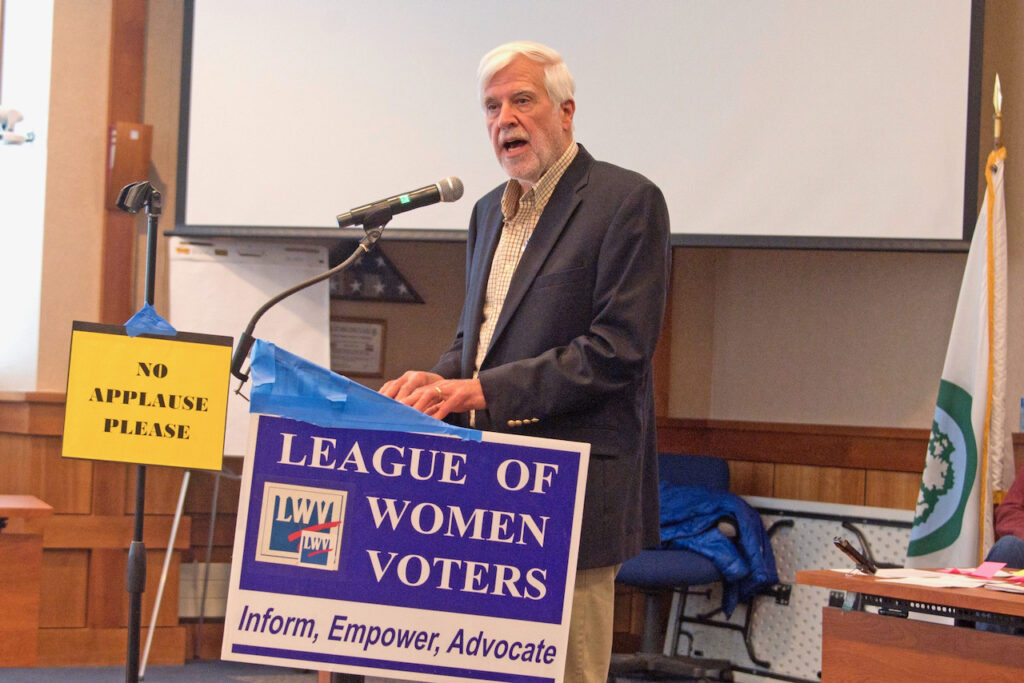
League of Women Voters-Whitewater Area member Lynn Binnie moderates Saturday’s event.
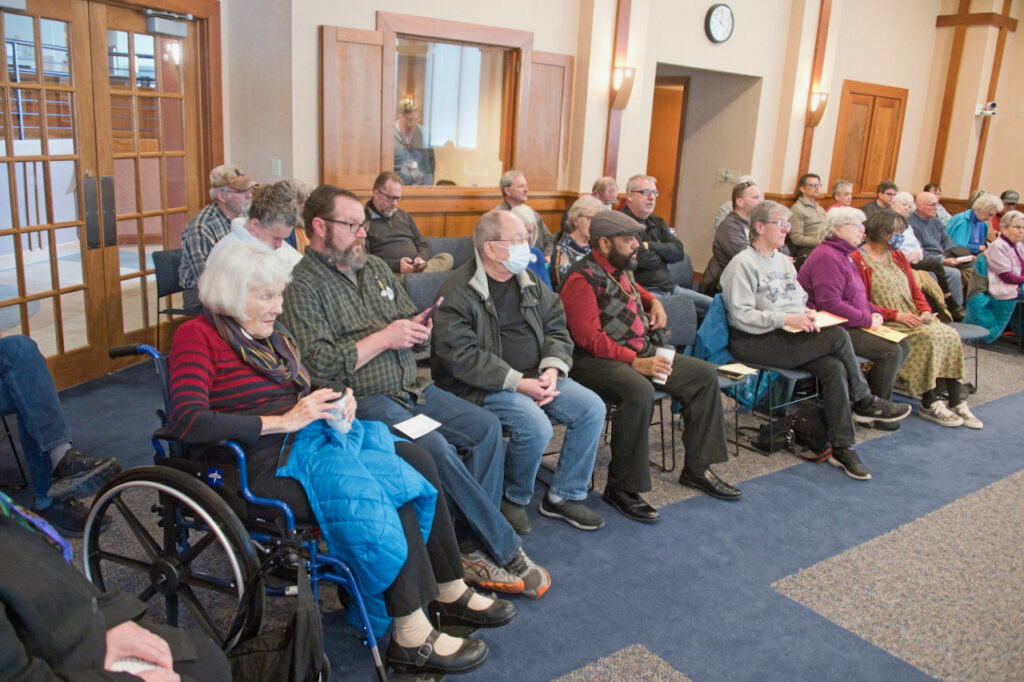
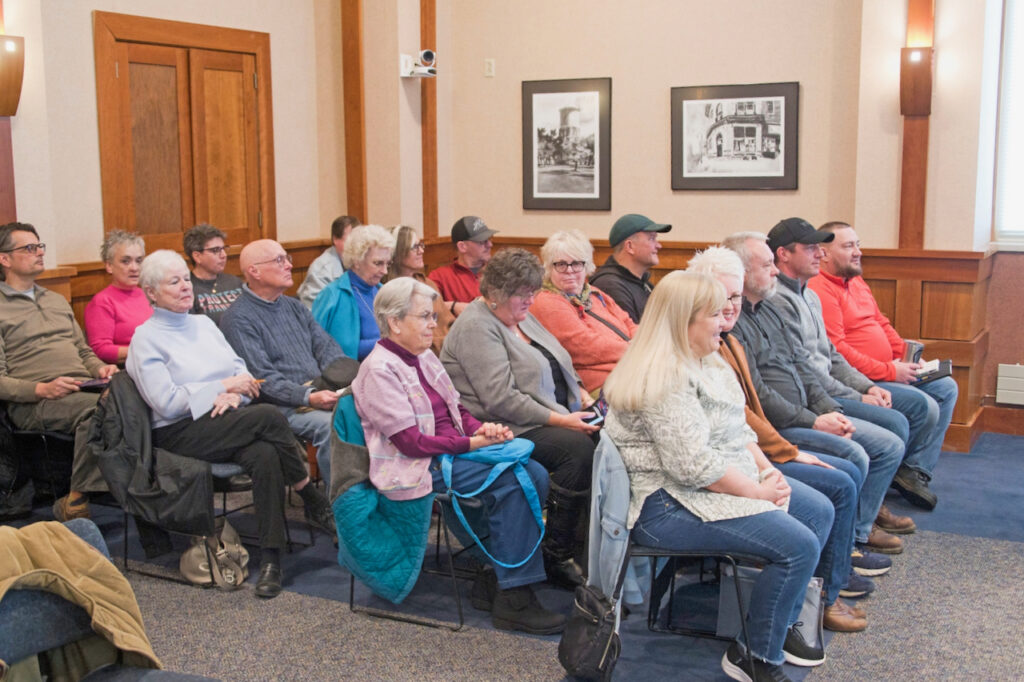
Two photos above: Some 55 community members attend a Whitewater Unified School District Board of Eduction in-person forum. The event was held at the Whitewater Municipal Building on Saturday.
Tom Ganser photos.
Goyke addresses Greater Whitewater Committee; discusses state budget, population trends
(Originally published March 16, 2023.)
By Kim McDarison
State Rep. Evan Goyke was a guest and speaker hosted by the Greater Whitewater Committee (GWC) during its monthly breakfast meeting.
The meeting was held Thursday, March 9, at 841 Brewhouse, Whitewater.
Goyke, who serves as the ranking Democrat on the State Legislature’s Joint Committee on Finance, offered information about the upcoming biennium state budget as proposed by Gov. Tony Evers, along with some of his impressions about the condition of the state’s future, citing among his concerns, trends showing a decline in the state’s population growth.
During the meeting, GWC President Jeff Knight told those in attendance that Sen. Howard Marklein (R-Spring Green), a co-chair of the Joint Committee on Finance, had served as keynote speaker during the group’s annual meeting held last month.
Introducing Goyke to a panel of about 20 people, Knight said the representative is from the Madison area, but lives today in Milwaukee. He attended Marquette University Law School, and previously served as an attorney in the Office of Wisconsin State Public Defender, and as an adjunct professor of law at Marquette. Along with the Joint Committee on Finance, Goyke serves on the following legislative committees: Joint Legislative Council, Joint Survey Committee on Tax Exemptions, Joint Review Committee on Criminal Penalties, and Committee on Corrections.
“Goyke will be providing an in-depth presentation on the state budget, and we will also be opening up the floor to discussion and further questions,” Knight said.
During his remarks, Goyke noted that he has served in the State Legislature for 11 years, but, he said, he would not seek reelection in 2024. Instead, he will be running for the position of municipal attorney with the city of Milwaukee, noting that he was eager to embrace a “public policy position that’s a little bit more hands-on and tangible.”
He added: “The Legislature is great. I absolutely love it, but I would often come home and my wife would ask me: ‘What did you do today?’ And I said, ‘you know, I went to meetings.’ And so sometimes it’s hard to see the fruits of our labor, because (it) can sometimes take years and years and years.”
Goyke said that during his presentation, he would touch upon several topics, including: the future of Winther Hall, a classroom building serving as “home,” according to the University of Wisconsin-Whitewater’s website, to the College of Education and Professional Studies; a “broader perspective” about his perception of the condition of Wisconsin, and issues related to funding, including school funding, municipal funding and housing initiatives.
Future of Winther Hall
Goyke said that he had visited Winther Hall and was in agreement with those who saw reason for the building to be included within the framework of future construction projects.
Referencing the last legislative session, he said: “I was surprised that the (Joint Finance) committee did not enumerate that project. It was recommended by the governor and then ultimately not recommended by the Legislature and as you all know, nothing happened. And now, we are in the opposite scenario, where the governor has not recommended enumerating and funding the project. I think, at this point with inflation, it’s a $76 million project … and the governor has instead recommended, I think, $500,000 in continuing planning cash to kind of keep the project alive.”
Offering what he said was a “tongue-in-cheek” explanation for the change in plans, he said “maybe the governor is playing reverse psychology, where last time because he recommended it and the Legislature was against it, and so maybe they will add it. If he’s not for it, they’ll be for it — sometimes that happens.”
Offering a second explanation, he said three projects within the UW System are included within the governor’s proposed capital budget. They include a health sciences building at UW-Milwaukee, Winther Hall, and a building on the UW-Stout campus.
In the governor’s budget, Goyke said, the projects are not slated within the next biennium for actual construction dollars.
“In the governor’s proposed capital budget, they viewed these three projects in the same way. And they base their decision on some UW System language … that they did not believe that the actual construction dollars would be spent during this biennium, and so the governor thought that enumerating the projects in the next biennium was more appropriate. So the UW-Milwaukee, Whitewater and Stout projects each received the continuing planning dollars in anticipation of enumeration in the future,” Goyke said.
Goyke said that the decision, in his view, was not a “denial of the value and the need,” but, “somewhere in the mechanics between system and the governor, there was, on these three projects, this decision was made.”
He suggested that the GWC continue to lobby for enumeration of the project within an upcoming budget.
“I think a project like Winther is not dead until it’s dead,” he said.
He added that within the governor’s proposed budget, some $3.2 billion has been earmarked to support a building portfolio, which Goyke said, was “more robust than in previous budgets.”
Building with cash
Goyke said the state has roughly a $7 billion surplus.
Within the governor’s proposals, $1.9 billion “in essence” has been set aside to cash finance building projects for which the state would normally bond and borrow,” he said.
“So $1.9 billion of cash into the capital budget does two things … for Wisconsin: One, it allows for a larger building program than we had before. The majority of those projects are within the UW System. There are non-UW System building projects. The Department of Corrections has a number of projects, as well as what we call non-state projects, and if you use $1.9 billion cash to build rather than borrow, that saves us about $800 million over the length of the borrowing. We generally borrow between 20- and 30-year bonds, so that $800 million is stretched out between the next 20 or 30 years,” Goyke said.
He added: “I actually think this is an area where the majority party in the Legislature will do something similar. I don’t know that $1.9 billion will be their number, but I do expect the Republican majority to use a sizable chunk of the surplus. They continually talk about one-time money being used for one-time purposes, and building projects are clearly one-time expenditures …,” he said.
Describing his predictions as “reading the tea leaves,” Goyke said he believed the state’s building budget would be somewhere between $2 billion and $2.3 billion, with about $1 billion worth of projects financed with cash.
Population trends
Goyke next turned his comments toward what he described as “scary trends” within Wisconsin showing decline in population growth in both rural and urban settings.
Citing the governor’s proposed budget, he said at least $1 billion has been set aside in various savings accounts.
The governor, he said proposes to put away $500,000 in “our ‘rainy day’ fund,” and a residual in another saving account, both of which would hold funds that would be invested to earn money.
“If you put $500 million away, you can expect about $20 million or so in investment returns, and so a billion for potential economic downturns. He’s got an income tax cut that functions like a tax credit. He doesn’t change the brackets or the standard deduction, he allows joint filers at $150,000 or less, single filers at $100,000 or less, to receive 10% of their tax liability paid back in the form of a credit. That costs about a billion dollars over the life of the budget, so that’s 2 plus 1 plus 1, so we’re at about $4 billion in the surplus, and then another big chunk goes into continuing the Medicaid program and K-12,” Goyke said.
Returning to the topic of population statistics, Goyke said that the state saw its slowest population growth as a percentage over the last decade in the history of the state, further defining that period as “since we’ve been counting.”
He noted that Wisconsin grew in population by 3.6% between 2010 and 2020, which was a slower rate than the national average for state growth, which, he said, was about 7%.
He said declines in growth rates similar to those in Wisconsin were found in northern and industrial states such as Pennsylvania, Michigan and Ohio.
“Illinois had a reduction in population, so we fared better in terms of population growth than our neighbors to the south,” he said.
Looking at raw numbers, Goyke said Wisconsin grew by roughly 200,000. Some 75,000 individuals counted within that growth were in Dane County.
“If you take Madison out, we are really close to treading water,” he said, adding that the biggest population loss was in Milwaukee County, where population declined by 20,000.
Among counties that experienced population growth, he named St. Croix, Eau Claire, and Brown. Looking more locally, he said Jefferson County was up by 1.5% or about 1,200 people, and Walworth was up by 4.5% or about 4,600 people.
“Walworth was among the higher growing counties in Wisconsin,” Goyke said.
He added: “I talk about this because we’re seeing rural shrinkage in population as well as some of the legacy industrial urban areas — Beloit, Janesville, Racine, Milwaukee — Shawano, Taylor, Richmond (counties), all population losses.”
Goyke said population statistics were of importance because in Wisconsin, funding for local services is tied to property taxation.
“If you are not growing, there is an impact on property value. Your home is worth what somebody is willing to pay for it, and if people are not moving to your community and buying property, there can be a stagnation and a decrease in property value.”
He described property value as “the largest revenue source for the services.”
He cited recent referendums approved by voters in both Whitewater and Fort Atkinson, as a “really good example of service costs going up and local revenues not going up, and needing to have a referendum and increase property tax to have an EMS service — professional 24/7 EMS service — as well as K-12 operation.”
He called trends in decreasing population growth and declining property values, leading to local revenue decreases “a spiral.”
He asked: “How do those local communities attract and retain new families if they, themselves, can’t provide the services that people rely on? There are … communities in declining population areas of rural Wisconsin that no longer have reliable EMS service. That very quickly becomes an unsustainable place to live as you age. If you are 80, and still in your home, and an ambulance can’t come get you, at a certain point, your family is going to make the decision for you that you can’t live there.”
Goyke said that in his Milwaukee community, similar trends exist. Citing the housing market crash of 2008 and 2009, he said his community was affected with a loss of some $4 billion in taxable property value.
Today, he said, “our property tax in the city of Milwaukee doesn’t pay for the police department. Our police department budget is $300 million, our tax levy is like $265 (million). And so we’re in big trouble. And we’ve shrunk our workforce for the city by over 1,000 employees over the last 10, 15 years.”
Declining resources affect the city’s ability to provide such serves as EMS, garbage and recycling pickup, and street repair, among others, Goyke said, adding: “As you can’t meet the demand, people leave.”
A new shared revenue relationship
“There needs to be a new relationship between local communities and the state of Wisconsin, Goyke said, adding that historically, the state helped fund services through a program called “shared revenue.”
According to Goyke, the program was created in 1911, when Wisconsin became the first state in the nation to adopt an income tax.
Since then, he said, “the share of our state budget that goes back to local communities has shrunk, and shrunk and shrunk. It’s about 5% of our state budget right now. Twenty years ago, 15 years ago, it was about 12%. Local governments have not gotten an increase in shared revenue in 20 years.”
Both parties have decreased shared revenue, he said.
“There are a number of communities in this state, in all corners of this state, that, under the current model, do not have the resources necessary to change the trajectory that they are experiencing,” he said.
Decreases in shared revenue bring “workforce implications,” Goyke said.
“If we are not growing and attracting working people, our birth rate has gone down, if we don’t have new arrivals to this country, to this state, we are in really big trouble. Also your general workforce issue, if you project these trends 10, 20 years, if it goes unabated, these challenges get much, much harder. We’re aging. That is, to me, a very scary situation.”
In response to the trends, Goyke said he believed both Republicans and Democrats in the Legislature will make “big changes” to the state’s shared revenue program this session.
“The governor’s proposal is to take 20% of the sales tax collected statewide — our statewide sales tax is 5% — and then there’s a 0.5% issue that all of the three counties around here, Walworth, Rock, and Jefferson, I think, all three have the 0.5% sales tax, but 5% statewide, so you can think of it as one penny of the five pennies on the dollar that the state collects will be set aside for shared revenue,” he explained.
He added: “Shared revenue total right now this year is about $900 million. The total statewide one penny of the sales tax would be about $1.5 billion. So that means dedicating that one penny would increase the pot available for shared revenue by $500 to $600 million.”
Within the governor’s proposed budget, he said, shared revenue would be distributed similarly to the way it is now, which would guarantee that no community would see a loss of shared revenue income and each would see an increase.
A structure provided by the governor would include two components: the first would include a fund into which 43.5% of the revenues would be placed, which Goyke said, would amount to about $250 million, which would be used to support police, fire and EMS expenses.
Another 55% would be used to provide “general aid,” through use of an equalization formula on a per capita property value basis, Goyke said.
He continued: “Right now with shared revenue, there’s nothing guaranteed, we pick a number. We can pick a higher number, we can pick a lower number. It becomes very, very hard to budget longterm for your community when every two-year cycle is so volatile. Two, it is a source of growth. Sales tax has grown over time, and generally, it follows inflation, obviously recessions can impact sales collections, but overall, it’s a more reliable growth model so that as local costs increase, and local governments need more money to operate, and continue to have the services, more revenue would automatically be put into that pot.”
K-12 funding
Goyke next cited an operational K-12 referendum which was approved by Whitewater Unified School District voters in November.
Having read some local coverage, he said, his understanding was that the referendum was driven by two factors: costs associated with funding special education and providing services to a growing diversified population, including costs associated with English language learning (ELL).
Looking at financing for special education and ELL students from a state perspective, he said: “Both of those pots have very low reimbursement rates from the state of Wisconsin, to you, as a school district.”
Additionally, he said, there is a growing number of communities that have higher populations requiring such services as free and reduced lunch, ELL, and special education, and, he added, “it is causing major budget crunches across the state.”
Referendums to fund K-12 activities have “spiked,” he said.
Said Goyke: “In my opinion, the single most important piece of the governor’s K-12 budget is the special education reimbursement increase.”
According to Goyke, the state uses a formula that returns 31 cents of every dollar spent on special education back to the district.
The federal government, through a process it calls “maintenance of effort,” Goyke said, requires that a school district cannot spend less on special education in a current budget year than it did the year before.
“It is a rational, important law to prevent school districts from not providing adequate services to kids that need it,” he said, but, he added, it places pressure on a district as it seeks to find dollars to fund its rising costs.
“As your special education costs go up, you pull money from your general education pot. And so you start putting pressure on things like extracurricular sports, language, art, music, etc. And you start to see those important cultural experiences that are really important to young people be reduced … because you have to meet this legal obligation,” he said.
The governor’s proposed budget increases the reimbursement rate for special education expenditures to 60 cents on the dollar in both years of the next biennium and going forward, Goyke said.
“That alone, when you put it over the entire state, is a billion dollars over two years; $450 million in year one, $550 million in year two. I’d say this is the most important change in K-12 funding and in this budget,” he noted.
Goyke said that there was some money available to reimburse districts for costs associated with ELL.
“I think the governor’s budget, it’s at $14, $15 million a year increase, the ELL services are similarly reimbursed, similarly way below cost. There’s a new pot of money going to literacy for English language learners,” he said.
Goyke said that the state’s immigrant community was a positive factor in helping to alleviate low-growth population trends. Citing trends in workforce development, he said, the immigrant community often fills jobs in tourism, hospitality and agriculture left unfilled by other members of the population.
“We’d be in big trouble without those folks,” he said.
“Now we have the obligation to help the kids and make sure that they are on a path to prosperity, and it starts with K-12, and it starts with these pots of money. I think they will go a long way to help districts like Whitewater, middle-sized districts, that have changing demographics, to meet the needs of those changing demographics,” he added.
Workforce housing
Addressing policies associated with housing, Goyke said that the governor’s proposal includes “$350 million invested, or proposed to be invested in housing in various different buckets.
“Some will be for what we now call ‘workforce housing,’ but, really, a nut that we need to crack, in my estimation, is how do you handle aging, single-family, low density housing?”
Goyke pointed to older “farmstead” homes found across Wisconsin, many of which, he said, “looked worse for wear.”
“Families have lived there for a very, very long time. The house now needs a lot of money, and when you couple what I’ve been talking about, population, and the soft housing market with homes that need a lot of renovation, you have a lot of properties that are underwater. And the private sector … they will not lend you $200,000 to buy a $100,000 home and spend $100,000 fixing it. It isn’t going to be worth $200,000 at the end of the day. You are not going to get a loan to do that,” Goyke said.
He talked about his own neighborhood in Milwaukee, where, he said, he used cash to buy a modestly-priced home. According to Goyke, his home was abandoned for a year before he purchased it, and abandoned homes in a neighborhood create situations where homes fall below “ultimate appraised value,” and buyers cannot get a traditional loan.
“I was told when I bought my house that one empty house on my block reduces the value for every other house by $7,000.
“What I’m saying is some of these communities, the private sector is designed in a way that without a subsidy, it’s going to be very hard to see the money necessary to do home renovation and restoration in a way that we keep the fabric of the communities the way they are now. That 80-year-old grandma is going to move out because there’s no EMS, (and) who’s going to buy her house?” he asked.
Goyke said he believed the public sector would need to “inject funds” into the private sector in a “tailored and narrow” way, directed to communities that did not have the growth projections or tools to return value to their taxable stock.
Questions
After Goyke’s presentation, GWC members and guests were offered an opportunity to ask questions.
Knight asked Goyke if he could talk further about the difference between one-time money and other “sustaining surplus money.”
Said Goyke: “Me, personally, I like the idea of putting one-time money into one-time expenses that eases the burden longterm. So I talked about that in the capital budget, and the opportunities that it presents to avoid borrowing longterm. It eases pressure on budgets. When we borrow … the line item in the last budget to pay down capital debt was $800 million. So reducing that is really important.”
Additionally, he said: “We saw a huge spike, there’s been — two things that are driving this surplus that, I think, go away. One is we saw a really big spike in corporate income tax collection. We armed the Department of Revenue with a whole town of auditors in recent budgets, and they went out and they audited, and they found a lot of revenue. There’s a point on the horizon where those kinds of new positions don’t come up with new money because there’s a finite number of corporate income tax filers in Wisconsin.
“The second piece, and this is now well over a billion and a half of the ($)7 (billion), when COVID struck, and this was under Trump, and continued under Biden, the federal government agreed to expand Medicaid coverage, and with it, the feds paid a bigger share of Medicaid; it’s about 60-40, and they decided, under what’s called an enhanced FMAT (Federal Medical Assistance Percentages) match, it was 66-34. The gap between the state paying 40% and 34% of Medicaid, which covers over a million people, is $1.5 billion over the last couple of years.
“So we saved the state money, our state money, because we didn’t have to spend as much on our chunk. That goes away this summer.”
Goyke said that while the governor has recommended that the state expand Medicaid, it has remained an ideological battle for the Republicans for four years.
“I do not see the majority party agreeing to expand Medicaid to cover able-bodied adults to 138% of the federal poverty guideline. If we did that, we would continue this enhanced federal match. It’s about $1.8 billion, I think, over the biennium that we would save. But I don’t think that’s going to happen,” he said.
Knight cited efforts underway by the GWC to change the state’s funding formula for general purpose revenue (GPR) to increase the UW-Whitewater’s share. When compared with the UW System campuses, according to Knight, UW-Whitewater is supported with the least amount of funding.
Additionally, he said: “Over the years, the UW campuses get so much back in the form of state support to the community — 34% of the property value.”
Knight talked about services like EMS that support the campuses.
“You can see, years ago, when you had a lot of employees working here, there’s a multiplier, so it’s a little easier for a community to adapt. But through the pandemic, with most of everything being shut down, you still have that ambulatory service without the people there to spend the money, so you got — it’s a more realized burden. So anything you can do to fix that, and that’s more of a longterm fix, because, I think there’s a number of campuses in the same boat as we are,” Knight said.
Said Goyke: “It’s interesting because it really affects towns that you might refer to as like a ‘college town,’ where the campus is a huge portion. River Falls, Platteville, there are debates about this in a different context in the city of Waupun. There’s a big prison right in the middle of downtown … so when a crime takes place, say one inmate hurts another inmate, often the … Dodge County Sheriff is called in to investigate. And the reimbursement for those services aren’t quite there.”
Goyke said there was an “interesting” conversation about: “What happens to your community when you’re home to a big state footprint?”
Whitewater City Manager John Weidl, offering some perspective, said: “To put that into (real value), the total value of municipal property that excludes the university, not land, just buildings, about $500 million. University is about $400 million and change, just building values, so if you just take away the value of the land that’s sitting underneath, whether it’s agricultural or commercial or industrial, we are about the same size in terms of property that sits within the city to … just have and be responsible for with service and response, and things like that. So we are almost equalized …”
Said Goyke: “My take on personal property tax is that the Legislature is so tired and annoyed they’re continuing to deal with this that everybody is ready to get to ‘yes.’ We put the money aside to make sure local governments — there’s $202 million sitting in a fund called the Joint Finance Supplement Account — just sitting there. It isn’t getting spent because the bill didn’t become law last session. I’m not in the direct middle of that conversation, but if I’m reading the tea leaves, then maybe they will take that up.”
Additionally Weidl asked: “You talked about the money for local governments being split into two pots, and one of those pots being for police, fire and EMS services. Municipalities that just went through a referendum, is there some sort of ‘hold harmless’ or are we getting set back as money is allocated because we just went through a heavy lift on our own against a community that hasn’t yet decided to go through or wasn’t able to go through that?”
Said Goyke: “I was describing the governor’s proposal. The leadership of the Legislature has indicated that they likely will not support all of what the governor has proposed. I have not heard anyone discussing a kind of ‘hold harmless’ or something that’s related to the timing of enacting your own property tax …”
Weidl asked Goyke if he knew what the formula might look like, asking: “Will we all be treated equally in that sense?”
Said Goyke: “What I’m hearing from the Republicans is that the pot of new money — that $500 million, whatever — that’s on top of shared revenue. I think there’s agreement that 1% or one penny of the sales tax dedicated to local government funding — there seems to be consensus that (it’s) an ok fit in everybody’s arena. It provides an increase, it’s sustainable. I am hearing more from the conservative side of less dollars for locals directly — so some for counties, some for locals, … I think the speaker, himself, is really interested in creating something, whispers are, through an innovation fund, where you could apply to the state for dollars. You guys are in a really interesting situation. I’m sure there are services where counties, for example, because you split so uniquely between three, sharing services becomes something that’s a challenge or could be something really cutting edge, where you kind of regionalize, and I think the speaker is envisioning a pot of money …
Said Weidl: “I think that’s totally fair. Walworth County, for example, has been talking about consolidation of some services since 2017, I found out. It hasn’t gone anywhere.”
Said Goyke: “You don’t have the money to do it, plan it even. How, in this era of tight local governments, how are you going to set aside the dollars necessary to either hire a consultant or to have a FTE (full time employee) do the work, to plan for something — so, I like the concept of, and have actually done legislation previously on the concept of incentivizing that type of shared services or collaborative operation or efficiencies or whatever, whether it’s, whether the speaker and I are in total agreement of what the details are, we’ll see. He and I don’t always align, so …”
GWC guest Joseph Kromholz asked: “You talk about the governor’s proposal, and what the majority in the Legislature wants to do. As far as education goes, as far as local money showing up, what do you handicap the odds of any of that money actually showing up here?”
Said Goyke: “I’m confident that the Republicans will not approve the governor’s budget as introduced. When this budget began, I was predicting that K-12 would become the most contentious and the most drawn out and difficult place to get to ‘yes.’
“Because the governor — the education governor — last couple of budgets, in terms of state investment, has not been as robust as he’s introduced. Meanwhile, you’ve got more global conservative movements — school board elections have become a little bit more contentious in different parts of the state. I thought there would be a big showdown. I have heard this week, and it’s just rumblings in the ether of the halls of the Capitol, but that’s the currency in which we trade, that the Republicans are going to put a number on K-12, an increased number. I don’t think it will be small. How that gets spread out is the question.”
He continued: They (Republicans) did a Blue Ribbon commission on school funding a number of years ago, and their own commission said that you’ve got to address this. And they’ve inched, inched, closer. I think they take a bigger step this year.
“What they haven’t really liked is putting money into a per-pupil increase. They don’t generally like putting money into the formula because there are equalization mechanisms that they don’t like. So I expect a per-pupil increase, I’d expect a special education increase, I know that for the intensely rurals you’ll see high cost transportation go up. I don’t expect a giant debate over expansion of the choice program because it’s kind of dead on arrival with the governor. So I think that won’t be the debate. It won’t be an ideological debate with education, it will just be a debate over how much …”
A meeting participant asked: “What about ELL?”
Said Goyke: “Tough sell.”
He described a meeting between several Republican lawmakers and a rural northern school district. He described the district as “rock red,” with large dairy and agriculture industries and an immigrant work force. He said he believed Republican lawmakers were learning from their constituents about needs, adding: “I think there’s more money going into it.”
Interview with FAO
After the meeting, Goyke granted Fort Atkinson Online a brief interview.
Similar to a question we posed to Marklein last month, Fort Atkinson Online shared with Goyke our understanding of discussions held at the local level — at school districts and within municipalities — during which officials note that they find themselves placed in a position where they must use one-time monies, such as those received through the Elementary and Secondary School Emergency Relief (ESSER) and American Rescue Plan Act of 2021 (ARPA) funds, to cover recurring or operational expenses. Pointing to reduced or withheld state aid, officials say the message from the State Legislature is to use the one-time money in lieu of state aid. Another alternative is asking constituencies for money to support recurring costs through the referendum process.
Said Goyke: “Running a referendum takes time and money. I was going to ask the group today: I wonder how much time and money was spent passing the Fort Atkinson EMS, fire, police referendum in April (2022), and Whitewater’s EMS or school referendum. Just think about how many professional people — city leaders, police, folks, civic leaders, took time and money out — I mean who made the yard signs that say ‘vote yes’?
“There is a cost to how we fund and rely on referendum.”
Even with those efforts, Goyke noted that the referendum was approved by voters in Fort Atkinson by a small margin, with 52% casting ballots in favor of the measure and 46% casting against.
Exploring potential uses for one-time money, we asked about the possibility of giving such resources to local governments for use as investment dollars, say, allowing them to begin a fund through which they could grow a one-time money allocation for future use.
Goyke likened the suggestion to an endowment.
He said: “This is one part of the strategy, is setting aside some money that could be invested that would cushion an economic downturn. Your point about COVID relief aid and its life expectancy approaching or its expiration approaching is very real. That is real for school districts, and for local governments, it’s real for healthcare providers and daycare providers. I mean there is a, what we sometimes refer to as an ‘unwinding.’ When the federal COVID emergency ends, and federal funds expire, you will have a number of different industries and organizations and entities really struggling to recalibrate, and school districts are maybe the tip of the spear, because they were given these one-time funds. They were used, they did their best to pivot and continue to educate over the last few years, but the idea that school districts are flush with cash because of that COVID relief money is dead wrong.”
In Fort Atkinson, we noted, the community has pushed back its plans to build a middle school by five years because the most recent capital referendum, brought before the voters in November, failed. We asked: Can one-time money be used to help districts with capital improvement projects?
Said Goyke: “Well, I think that the state’s role in especially local school construction and local government construction, on the capital side, has always been relatively minimal, because the local government and school districts have bonding authority and taxation authority. In my time on the Joint Finance Committee, we have not directly funded those individual programs, but that is not to say we couldn’t or that there couldn’t be a pot of one-time money available to districts that have capital needs.
“It’s not in the current proposed budget. I don’t know that it would be added. I just have not been a part of conversations; that idea has not percolated up to the channels of the State Legislature at this point.”
Recently, the word “broken” has been used by local leaders to describe the state’s shared revenue system. We asked if legislators, on both sides of the aisle, agreed with that assessment, or are there legislators who believe the system is working?
Said Goyke: “If you asked me this question four years ago, I would have said there are a group of legislators that do not think there’s a problem. I think today, that number is small or nonexistent. Where we disagree is the degree of the problem. I started working on local government funding in 2015 or 2016, because we had a fire station in my neighborhood close. And the city of Milwaukee is in such a precarious financial position, they have no choice but to — they’ve shrunk the fire department, they’ve shrunk the police department, they shrunk — as I said in my speech, there’ over 1,000 employees less, and that’s not a desire to defund the police or to defund the fire department, it’s a reality that there’s just not enough money to fund all the services. When I started that years ago, there was much less recognition of the problem. And today, I think it is a signature policy issue of this two-year legislative session.
“And what I mean by that is, if we are, as we approach, when voters go to the polls in November, 2024, one of the issues, whether it’s achieved or not, a success or failure of this Legislature, one of the major issues we should review is whether we fixed local government funding. Now, how we fix it, people will agree or disagree on the merits of that fix, but I guess my point to you today is, I think there’s a group of people willing to get to ‘yes.’ Enough recognize the problem is real, and immediate, urgent, and if you are to grade our ability in divided government to come together and get something done, local government funding should be one of those major issues that we are graded on.”
An earlier story about Sen. Marklein’s presentation last month before the Greater Whitewater Committee about the state budget is here: https://fortatkinsononline.com/state-budget-surplus-discussed-at-greater-whitewater-committee-annual-meeting/.
About the GWC
The GWC, as stated by the group in a recent news release, is an action-oriented group committed to working with citizens, elected officials, and policymakers to identify, craft and implement a pro-business agenda. Its goals are to advance the economic, educational, and social policies required to energize and secure the Whitewater area’s economic future, as well as protect Whitewater’s quality of life.
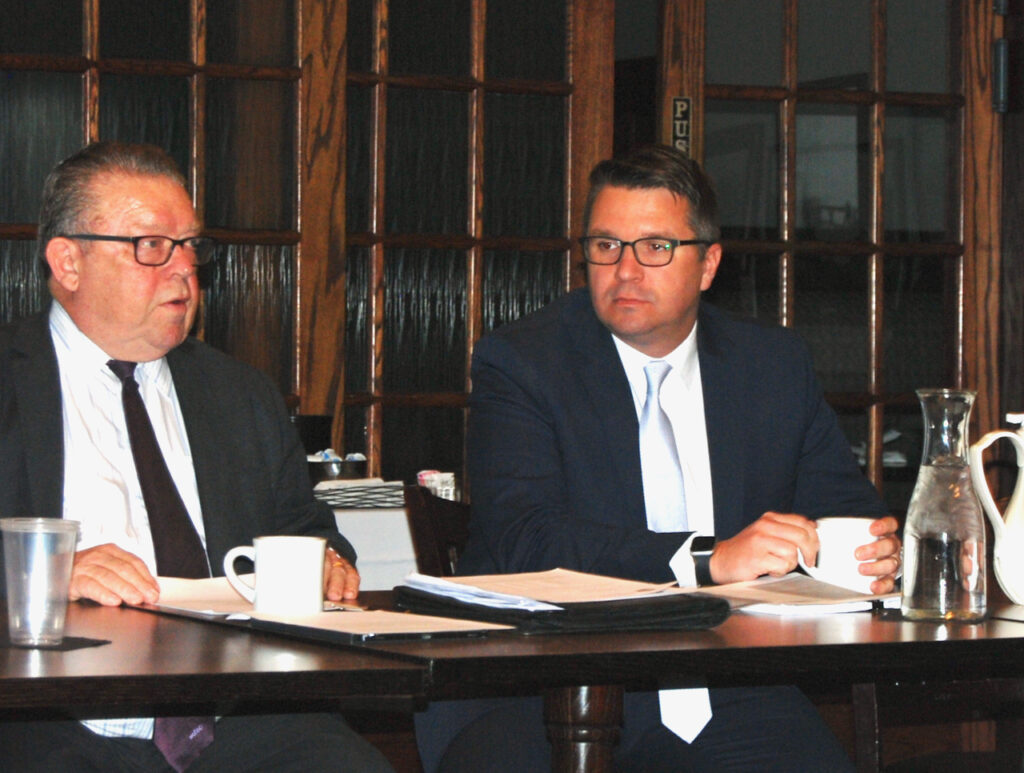
Rep. Evan Goyke, who serves as the ranking Democrat on the State Legislature’s Joint Committee on Finance, at right, addresses members of the Greater Whitewater Committee (GWC). He is seated next to GWC President Jeff Knight. The organization’s monthly breakfast meeting was held Thursday, March 9, in Whitewater. Kim McDarison photo.
Whitewater: Wisconsin Technology Council shares statewide venture capital investment trends
(Originally published March 19, 2023.)
By Kim McDarison
Statewide trends in early stage investing — along with money arriving into the state brought by venture capital investors — was a discussion topic recently at the Whitewater University Innovation Center.
Earlier this month some 50 people, many of whom were interested in opportunities for startup ventures as they seek seed money, gathered for a luncheon facilitated by the Wisconsin Technology Council, and its membership arm, the Tech Council Innovation Network (TCIN). The event was sponsored by the Innovation Center in Whitewater and We Energies, according to information released by the Wisconsin Technology Council.
According to the release, the Wisconsin Technology Council is an independent, nonprofit science and technology advisor to the governor and the Legislature. It operates through events, publications and outreach “that contribute to Wisconsin’s tech-based economy.”
Commentary written in January by Wisconsin Technology Council President Tom Still, who also served Thursday, March 9, as moderator of the panel discussion held in Whitewater, noted that the council is looking to create a “fund of funds,” proposing that the governor and the Legislature consider earmarking some $100 million from within the state’s $7.1 billion surplus for that purpose.
Within his commentary, Still described a public-private investment program called the Badger Fund of Funds, which, he wrote, was established by the governor and the Legislature in the mid-2010s, and serves as an umbrella for five early stage capital funds spread throughout the state. The fund, which was begun with $25 million, Still wrote, “spent the next few years matching” that amount “with twice the total in private dollars.” Investing began in the late 2010s and the fund, under rules set by the Legislature, can only invest in Wisconsin-based companies.
Funds within the Badger Fund of Funds include the Idea Fund of La Crosse, the Winnebago Seed Fund, the Gateway Capital Fund, the Winnow Fund, and the Rock River Fund.
Andy Walker, a partner with the Rock River Fund, was among panelist on March 9.
Within his commentary, Still wrote that the council is lobbying the Legislature for a larger fund of funds, writing: “More state investment in the early stage economy should be a part of the debate as lawmakers consider the next two-year state budget … to invest in larger increments than Badger was proposed two years ago.” He added: “The goal would be to attract more out-of-state investment and bigger rounds for emerging companies, an approach followed in some other states.”
A “round” is a term used to describe the investment process, during which funding is broken into specific stages, including “seed,” “Series A,” Series B” and “Series C.” Each round allows investors to gain equity or partial ownership of a company in exchange for capital.
A link to the full commentary written by Still in January is here: https://wisconsintechnologycouncil.com/insidewis-a-public-private-model-badger-fund-of-fund-is-performing-for-wisconsin/.
According to the Wisconsin Technology Council’s website, the TCIN is “dedicated to fostering innovation and entrepreneurship,” and works “in association with the Tech Council,” with “focus on the needs and challenges faced by new and growing technology-based businesses in Wisconsin.”
Joe Kremer, TCIN’s director, also was among panelists in Whitewater. He shared statistics about early stage investments made by venture capitalists in Wisconsin companies in 2022, which, he said, “will likely stand out as the state’s second-biggest year in dollar terms … exceeded only by the record year of 2021.”
Data shared by Kremer was developed by TCIN through information collected from various sources, he said. He cautioned luncheon attendees that the data was yet incomplete and would likely show larger gains as more information was gathered.
The panel also was joined by Whitewater area investor and First Citizens State Bank Chief Executive Officer Jim Caldwell, who was described by Still as having “a holding company that does some seed-stage investments.”
Caldwell said his saw his role more as an angel investor than venture capitalist.
Not just in Madison and Milwaukee
Within information provided by the Technology Council, Still was quoted as saying: “Investments by angel and venture capitalists don’t just occur in Madison and Milwaukee these days. We’re seeing interest statewide in early stage companies, especially in those regions where you might find a combination of talent, research and community support such as what exists in Whitewater.”
According to its website, Rock River Capital Partners describes itself as an organization that brings “a global perspective to the new Midwest opportunity through capital and connections to a global network.” Additionally noting that the company “exists to forward the ideas and hard work of the Midwest into great companies.”
Among those attending the luncheon were representatives from such institutions as the University of Wisconsin-Madison, UW-Whitewater, Merrill Lynch, Bank of American, Associated Bank, the Wisconsin Economic Development Corp. (WEDC), Walworth County Economic Development Alliance, Milwaukee Venture Partners, and WisPolitics.
Aided by a slide presentation titled: “Igniting Early State Investment — 2023 Wisconsin Portfolio,” Kremer noted that TCIN “provides services and resources to early stage investing and entrepreneurial communities, enumerating such concepts as deal flow, administration, education, networking events, and research.
TCIN does not operate a fund or make direct investments, he said.
“We are really in that middle, just trying to increase the supply of capital to all the entrepreneurs and trying to find creative ways to hook those two ends up between investors and entrepreneurs,” Kremer said.
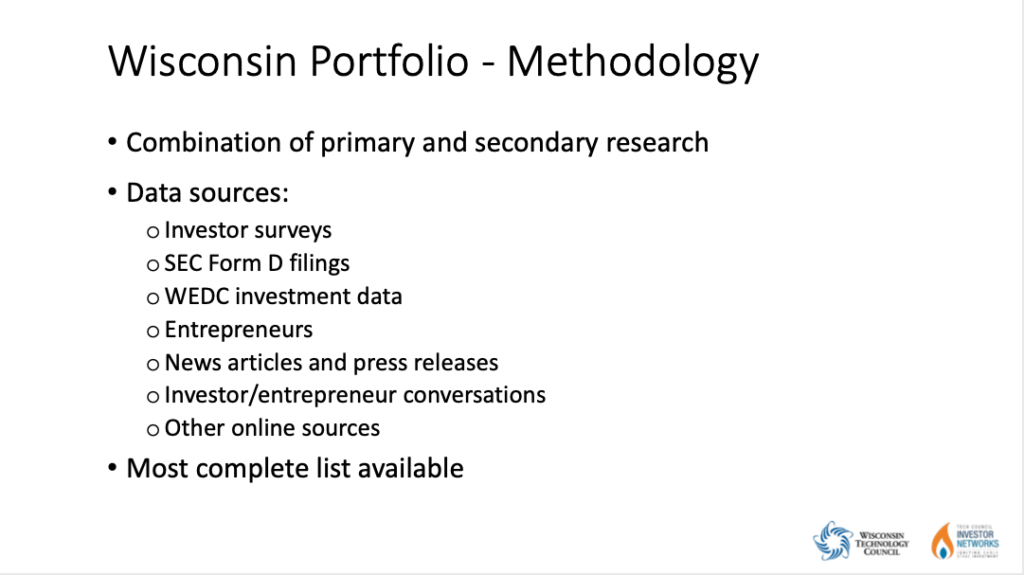
Pointing to the Wisconsin portfolio methodology, he said TCIN derives its research from such sources as investor surveys; SEC Form D filings, which is a requirement for investors, governing private placements of securities; WEDC investment data, entrepreneurs, news articles and press releases, investor/entrepreneur conversations, and other online sources.
Kremer stated: “The portfolio is something that we’ve been doing every year for a long time. In fact, I was thinking, the first time we did this, I think, was ’08. Just under $100 million is what we tracked.”

Annual investment trends
Sharing a graph reporting “annual trends,” which, he cautioned, had “incomplete data for 2022” and would likely, with more research, show trends with larger increases, he said that in 2011, across Wisconsin 76 “deals,” were made, bringing nearly $153 million in investment dollars to companies operating within the state. The number of deals climbed between 2013 and 2016 to 138, with approximately $276, million invested. Between 2017 and 2020, while the number of deals declined, reported at 114 in 2020, investment dollars rose to $484 million. The graph showed 2021 as a standout year, with deals climbing to 140, its highest number, bringing investment dollars of $869 million, also its highest number. In 2022, the graph noted 87 deals were made, bringing an investment of $620 million.
Looking more deeply into the numbers for 2022, he said: “We’ve seen $620 million in 87 deals, and that is coming from a whole different breadth of different companies all around the state, with a lot of differing, varying numbers around how much they are raising. From really small deals, I think our smallest is $25,000, to our largest, which was $240 million by Fetch (Rewards) last year. So we have really been doing an interesting job here, because if you look at where the overall numbers, these are the top 10 deals in Wisconsin for 2020, the top 10 deals raised just about $330 million. The following year, in ’21, there was about $580 million, and then this year (2022), it’s about $480 million, and we’re seeing this number continually grow, and that’s a real positive thing, because we are finding our entrepreneurs are graduating to larger and larger deals. They are bringing in larger rounds, like Fetch, at the $240 million (level). SHINE (Technologies) brought $80 million last year, Elephus (Biosciences) was at $40 million, and that’s a great thing.
“We want to see this continue to grow, because we really want to see a potential unicorn (a term meaning a startup company with a value of more than $1 billion) like Fetch, come up and grow, bring more money to the state, do more hiring, and really help our economy.”
Kremer said more venture capitalists from out of the state are starting to take an interest in Wisconsin-based businesses.
He added: “Back when we started the investor’s network, it was called the Wisconsin Angel Network … we had six investment firms in Wisconsin. We are up to 50. So in the last 20 years, there has just been a huge explosion, which is great. Now the story though, I do want to say, is we can’t take our foot off the pedal at this moment. We’ve got to keep pushing. Numbers are looking good. We’re having a great effect with all those programs that people have been working on around the state, but we can’t stop now. And so that’s one of the big reasons why we are pushing for a ‘fund of funds’ in our state, to bring more VC (venture capital) dollars.
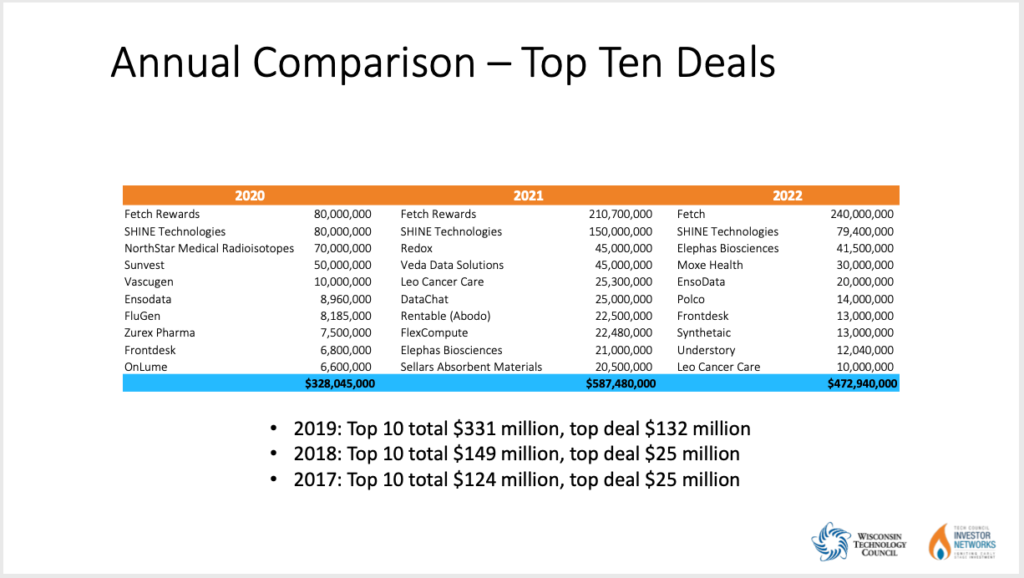
Kremer next shared an annual comparison, highlighting “top ten deals,” in 2020, 2021, and 2022.
Making the list in 2022 were: Fetch Rewards, SHINE Technologies, Elephas Biosciences, Moxe Health, EnsoData, Polco, Frontdesk, Synthetaic, Understory, and Leo Cancer Care. Collectively, the top deals received investment funds in 2022 of $473 million.
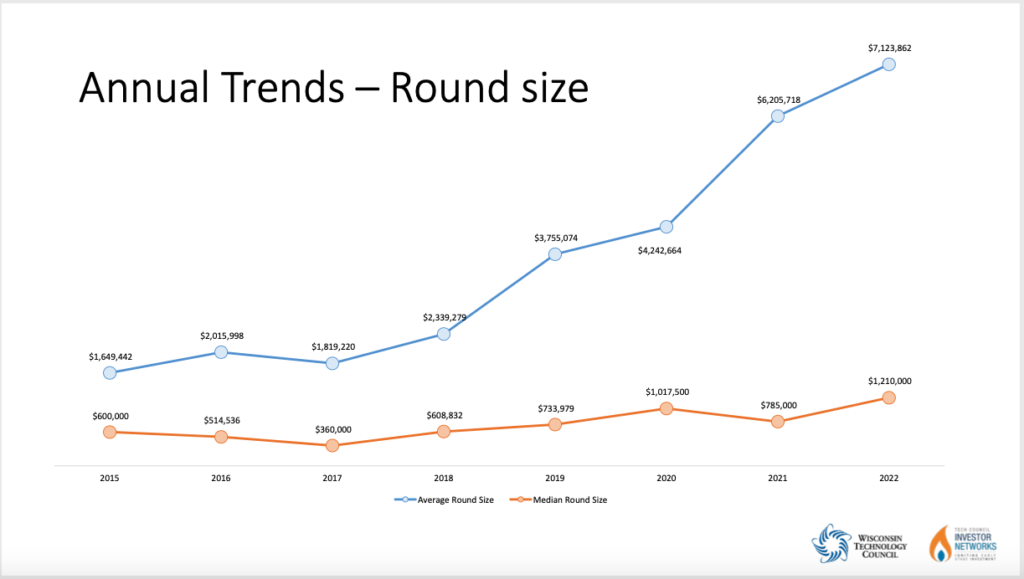
Another slide offered a graph showing the average- and median-sized round of investment funds received by deals between 2015 and 2022.
Average round sizes in 2015 were reported at $1.6 million, increasing over the years, with a slight dip in 2017 and again in 2020, to $7.1 million in 2022.
In 2015, the median round size was $600,000, advancing, with the same slight dip in 2017 and 2021, to $1.2 million.
Offering an explanation of the data, Kremer said: “This is just sort of an average, this is the mean and median size of deals. You can see the median, as we get those bigger and bigger deals, I mean if you are into stats just a little bit you know you have larger numbers at the top, and the median is going to keep going up, which it has been doing phenomenally. The thing that I really want to look at is the mean. What is the average investment round? Because we don’t want to see this get too high. Because the early companies that are just starting are going to have smaller rounds, so that if this starts creeping up too high, we are going to be seeing that a lot of the smaller companies aren’t bringing in those initial dollars.
“This graph tells like everything I need to know. Startups are getting the money at early stages and as they grow big, they are getting the larger rounds. So this is really good news for the state.”
Kremer said in Wisconsin, there is a “funding gap,” noting that for startups looking for rounds between $4 million and $10 million, “it’s almost a desert at times.” He added: “That’s a very hard rung to attract in this state at this moment. So that’s a big reason why we are pushing also for this fund of funds, so we can get some more early stage funds.”
Overall, he said, “numbers are looking fabulous.”
Deal making, success and risk
Next, Still introduced Walker, whom, he said, grew up in Stoughton and was involved as an investor through Rock River Capital at the ground level in the deal with Fetch Rewards.
Walker said a week after his fund put money into Fetch, the company’s executive officer quit, leaving Walker to run the company for six months, which, he said, he agreed to do in order to protect his investment.
“Then we encouraged some new investors to come in, and once we raised the first $4 million round then I exited the company,” Walker said.
Walker listed several other companies in which he invested, including a company that existed for 18 months, he said, before it grew to be worth $20 million and was sold to another company.
“It was a publicly traded company; it’s DXC now,” he said.
Additionally, he talked about a company which was funded by Drive Capital, which, he said, was the largest VC in the Midwest.
Walker said: “the company had four months of cash left and they asked me to step in … it was a great learning experience … we were able to sell the company to a private equity firm, but it was just a recovery of capital. We got everybody’s money back, but nobody made a return there.”
Walker talked about his experience working for the National Security Agency (NSA) where he learned about what he described as the “earlier version of data science.”
Walker said when he returned to Wisconsin, he noticed there were not employees available in the field of data science.
He worked with Marquette University to develop a program, describing the institution as “the first ones to jump on board, and I think they got other people to go.”
What’s happening in Whitewater?
Caldwell welcomed attendees to the Innovation Center.
“Being a Whitewater resident here, it’s wonderful to bring the Tech Council to our community and often times we think of Whitewater as the jewel that is kind of hidden. We’ve just got so many resources here at our fingertips that we’re so happy to really expose you to all of what we can do down here. We’ve got marketing, we’ve got legal, we’ve got accounting, we’ve got software, you know we’ve really got all of those supports,” he said.
He said a data science program was available through the UW-Whitewater business school, calling it “a huge success.”
Describing his holding company, Caldwell said: “Our involvement goes back to about the time this building was built … we noticed that, we got all of these supports and services here in this building, but we probably lack the gasoline, and that’s the money, the funding, to get these things launched. So it was with that thought in mind, we had a little excess of reserves in our parent company, holding company, and we said, well, maybe we can put some quiet, patient, we call it, capital into the mix here, and our scale of operation is, take about three zeros off, and that’s kind of where we’re at. We are kind of on the early, early stage — we really call ourselves angels, because … we are trying to take that initial — once the entrepreneur has got this idea, many times it’s funded with family, friends, mother-in-law, charge cards, whatever, so they bring the idea, and what we try to do is provide some capital to get that prototype done.”
Caldwell said his holding company typically offers seed money with rounds between $10,000 and $25,000.
Said Caldwell: “We use the Small Business Development Center (at UW-Whitewater) for feasibility kinds of things to get a little more understanding of the marketplace and so forth. We find that a lot of our time is coaching, quite frankly, because when you’re kind of coming out of the entrepreneurial program, even though you may have been in the business school and exposed to all of these things, the entrepreneur normally is quite focused on their idea and their project, and what we try to do is built a little bit into the business plan, kind of a PERT (Project Evaluation and Review Technique) chart to see how we can go from this stage to the next stage, put time frames in there, accomplishments, and try to put some discipline into the projects.”
What do angels do?
According to Still: “Most of the deals that we record, there are more deals that are angel than VC, by count, but the dollars (lean) heavily toward VC.”
Responding to a question posed by Still about the role in the marketplace played by angel investors, Kremer said: “I think what’s interesting is that we saw sort of a strain with the angel economy, because we didn’t have funds like Andy’s around. So they would make investments, and they would want to keep the investments rolling, so they had to go round after round. And it’s great now, as we are slowly building these early stage funds, that there’s a handoff. So we did build a really huge, really significant angel investment community. And that always created issues for some companies that were raising at $4 to $10 million, where that’s where you guys (VC investors) start coming in.”
Walker said his fund probably comes in earlier. He said one of his fund’s “best” deals “from a revenue perspective and just return on paper” was a Whitewater-based company.
“I do believe there was some local angel money that came into it. But a lot of this comes down to the size of the venture fund,” he said.
Walker described angel investors as providing a “smaller amount of money,” noting that “each check size is smaller, because you have to get at least 15 to 20 deals in a fund to kind of weather the storm. Assume a third go bankrupt, a third are going to do well, and a third you might get your money back. So to weather that, you need a nice portfolio.”
He said his fund holds $27 million.
“We write checks anywhere between $250,000 and $1.5 million, it just kind of depends on like the first round, it could be more in the middle, but when we talk about why it’s hard to raise $4 million rounds, and $10 million rounds, you would have to take Rock River Capital and make it a $250 million fund for us to be able to cover enough companies, 15-20 of them at those sorts of check sizes. So it doesn’t mean that we don’t participate in $4 million rounds, we do, but what we’ll do is roll out a $1.5 million check and we’ll set the terms, and then we spend a ton of time networking with venture capital firms around the country, and we have to encourage them to come into our deals. So it’s a back-and-forth like that,” he said.
He described the approach as “common,” saying that Rock River Capital did one deal on its own, adding: “and really wished we didn’t. What I’ve learned is if it goes really well, we’re going to need more money. If it goes really poorly, we’re going to need more money. So, I can’t really find a reason why I would want to do it myself.”
What types of companies are good prospects for VC funding?
Still asked Walker to describe the type of company for which he looks to become involved with funding.
Said Walker: “So this is the part that I think is really difficult to talk to people about, because there’s so many great companies out there, but the reality is only a small fraction are venture capital backable companies.”
For many companies, he said, a traditional financing arrangement through a bank is the best avenue for funding.
“For it to be a VC backable company, we’ve got to see a 10x return on our money. We’ve got to see market sizes that are just massive, because if you take a look at that — we’re going to lose … 100% of our money on the third, we’re going to lose some of our money on the next third, so the winners have got to be really big. Just for us to make — in general, our investors expect three times their money back. Whatever they put into our fund, they expect three times that back, so just think about how big our winners have to be if we kind of lost on the other ones.
“To be a venture backable company, essentially you have to be a company that can have massive scale and also be efficient with the capital. So companies that aren’t very efficient with capital are things like manufacturing and agriculture,” he said.
Walker said his wife’s family owns a manufacturing company which he described as a “very ‘CapEx’ heavy company.” The family invested $15 million in equipment, he said.
“A venture capital firm would never spend $15 million on equipment. It’s just not something that they do. So manufacturing and agriculture are very, very difficult to do as a VC backable company. Biotech, although it’s had some great returns, is also difficult, but it’s difficult for a different reason. Biotech is not capital efficient, which means it takes a lot of capital to achieve an outcome. To do that, you need a huge fund. So a $500 million biotech fund isn’t that big. Which is crazy, right? A lot of us think that sounds like a lot of money, but to truly do a biotech fund, I would want $1 billion to $2 billion to do it right,” he said, adding: “You have all the regulatory issues. But just the amount of capital it takes, to do things like any sort of therapeutic, it’s expensive.”
Walker said software companies are good candidates for VC funding because they are capital efficient. He described hardware companies as “ok,” but also “scary” because the process required building inventory and prototypes.
“There’s more there. So there are smaller segments that work for VC,” Walker said.
Citing opportunities in Whitewater, Caldwell said: “Following up on the software, most of our starts have been in more of the software. We don’t have engineering, we don’t have medical, so the ramp-up time is much shorter where you don’t have the clinical and all that you got to go through. The cost of startup is less, and probably the startup time is less.”
For more information about the Wisconsin Technology Council, visit its website: https://wisconsintechnologycouncil.com.
For more information about the Rock River Capital group, visit its website: https://www.rockrivercapital.com.
For more information about the Whitewater University Innovation Center, visit its website: https://whitewateruniversityinnovationcenter.org.
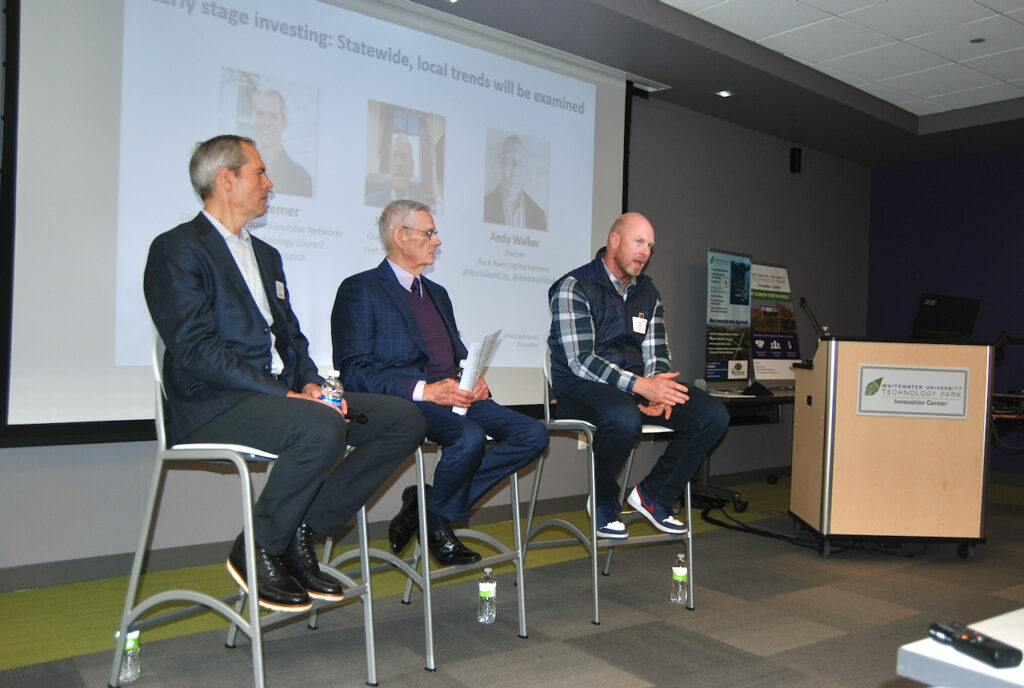
Madison-based Tech Council Innovation Network Director Joe Kremer, from left, First Citizens State Bank Chief Executive Officer and Whitewater resident Jim Caldwell, and Rock River Fund partner Andy Walker are panelists discussing statewide trends in early stage investing in Wisconsin. The panel assembled Thursday, March 9, at the Whitewater University Innovation Center to share stats, experiences and answer questions during a luncheon facilitated by the Wisconsin Technology Council, a nonprofit science and technology advisor to the governor and Legislature. The Wisconsin Technology Council is lobbying for $100 million to be placed in a venture capital “fund of funds” in response to the $7.1 billion dollar state surplus. Wisconsin Technology Council President Tom Still, not pictured, moderated the discussion. Kim McDarison photo.
Whitewater: Area residents organize ‘Save the Pool’ meeting
(Originally published March 20, 2023.)
Editor’s note: Organizers have announced that the “Save the Pool” meeting has been relocated to the Cravath Lakefront Community Center, 341 S. Fremont St., Whitewater.
By Kim McDarison
Several Whitewater area residents have organized under the titled: “Save the Pool,” according to information released by four of the group’s organizers.
According to the release, Cheri Zimdars, Guy Ledwell, Jeff Knight and Geoff Hale have invited residents to join them in an effort to “keep the public informed of the value of Whitewater’s beloved Aquatic and Fitness Center.”
The group has announced it will be holding a meeting, Wednesday, April 5, at 6 p.m., at the Cravath Lakefront Community Center, 341 S. Fremont St., Whitewater.
As stated in the release, those in attendance will learn about the center’s role, value and commitment to fitness and health in the Whitewater Community.
The group has further announced that it has purchased “Save the Aquatic Center” yard signs which will be distributed at the meeting.
Offering some history, the release noted that the aquatic center is run by the city of Whitewater and the Whitewater Unified School District, which has, in past years, joined through a contractual agreement to operate the facility.
As earlier reported by Fort Atkinson Online, according to city officials, the contract, which was discussed and approved in draft form by members of the Whitewater Common Council with some contingencies, was not signed by the school district when it came due for renewal two years ago.
A meeting of the Whitewater Aquatic and Fitness Subcommittee, which is comprised of representatives from both the Whitewater Common Council and the school board, met earlier this month to begin a negotiating process to develop a new contract. An earlier story about the meeting is here: https://fortatkinsononline.com/whitewater-aquatic-center-subcommittee-discusses-operations-finances/.
On Friday, according to an agenda posted on the city of Whitewater’s website, the subcommittee met in closed session, listing as the item to be discussed: “Suggested strategy and recommendations for city of Whitewater negotiations concerning the agreements with the Whitewater Unified School District related to the Whitewater Aquatic and Fitness Center.”
According to the closed-session agenda, the body did not plan to reconvene in open session. A link to the closed-session subcommittee meeting agenda is here: https://whitewater-wi.gov/AgendaCenter/ViewFile/Agenda/_03172023-1672.
Within their announcement, organizers of the Save the Pool meeting wrote: “It is hard to understand the standoff and how anyone would see this impasse as good stewardship of our valued facility.
“In light of the (COVID-19) pandemic, the pool was also required to shut down and many programs were not able to be offered, even after the facility reopened. Yet neither party used their COVID relief dollars to offset losses due to closure, nor have they applied for any COVID relief funding to make improvements to the facility.”
Additionally, the group noted that the open-session meeting held by the joint committee earlier this month did not use its allotted two-hour time period as noted on the meeting’s agenda.
City Manager John Weidl and Whitewater Unified School District Board of Education President Thayer Coburn, both responding recently by email, told Fort Atkinson Online that the meeting was concluded after its published agenda was completed.
Referencing the earlier open-session meeting, Save the Pool organizers noted in their release that: “the attendees were pleased they could voice their concerns, but were frustrated at the lack of clarity coming from the elected officials,” adding: “As such, this (Save the Pool) group is hoping to expedite the completion of a new operating agreement, educate the public, and help in any way they can to continue operating the aquatic center in its current state. The city and school district continue to meet behind closed doors, so this group is asking that they discuss their intentions with the public to cultivate transparency and a sense of urgency on this issue.”
During the open-session meeting of the joint committee, during time allotted for public comments, nine members came forward. Most, including Knight, Hale and Ledwell, voiced their support for keeping the aquatic center open.
Additionally, the release stated: “This (Save the Pool) group is encouraging the city and school board to apply for any grants, and to take a second look at how federal and state COVID dollars could have helped the WFAC with improvements and covering their losses during the shutdown.”
On Wednesday, the city released information noted that the Whitewater Aquatic and Fitness Center has begun offering 24-7 access for its members who are 18 and older.
Those interested in learning more about the Save the Pool meeting or would like to obtain a yard sign are encouraged to contact one of the group’s organizing members: Cheri Zimdars: zimdars@hotmail.com or 608-449-5150; Guy Ledwell: ledwellguy@gmail.com or 262-649-7040; Jeff Knight: jpk@knightpublicaffairs.com or 920-728-0662, and Geoff Hale: ghale@hometops.com or (920) 723-2387.
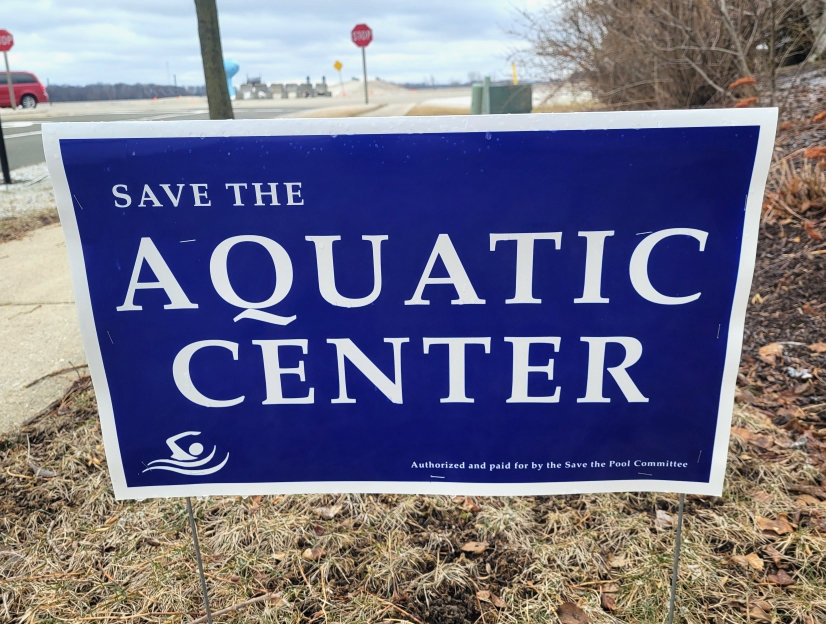
A “Save the Aquatic Center” yard sign is among items that will be made available during a “Save the Pool” meeting organized to take place in Whitewater Wednesday, April 5.
Whitewater: Municipal judge candidates respond to questionnaire
(Originally published March 21, 2023.)
Compiled by Kim McDarison
A spring general election will be held Tuesday, April 4. Residents within the city of Whitewater will find the names of two candidates running for the position of municipal judge. They are incumbent Patrick Taylor and challenger Art Coleman.
Fort Atkinson Online recently asked each candidate to respond to a short questionnaire. Candidates were asked to keep responses to four questions between 700 and 1,000 words.
Their responses follow.

Patrick E. Taylor
Age: 66
Address: 129 N. Esterly Ave.
Occupation: Judge, Lawyer, University Educator
Number of years resided in city: 6
Education: Batchelor of Arts (B.A.), Juris Doctorate (J.D.)
Civic and other organizational memberships:
- Whitewater City Governance: President, Board of Zoning Appeals; Secretary, Urban Forestry Commission; Member, Ethics Commission.
- President, Whitewater Kiwanis Breakfast Club.
- President, Board of Trustees First United Methodist Church.
- Lecturer in Business Law, Franklin University.
- Chair, UWW Phi Delta Theta Fraternity Chapter Advisory Board.
- Whitewater Grocery Cooperative, Finance and Legal Committee.
- Member, Wisconsin State Bar.
- Member, Walworth County Bar Association.
- Member, Wisconsin Municipal Judges’ Association.
- Volunteer Meals on Wheels Driver.
Political experience: Four years as Whitewater Municipal Judge.
What are your reasons for seeking this position?
I am deeply committed to our community and my work as judge adds important value to the general welfare. I hope to continue to use my unique skill, knowledge, and experience to positively influence the defendants in my courtroom and by doing so, improve the quality of life in our downtown and neighborhoods.
Each defendant has a unique situation requiring careful attention, understanding, problem-solving, and implementation of the most appropriate remedies the law will allow. Some may be one-time offenders, but others repeatedly make poor choices. For these defendants there will be increasing consequences coupled with an attempt to understand the causes of bad behavior and to educate and guide them to find a solution for correction.
I started several programs and procedures that have had a positive impact on defendants affording them the opportunity to become contributing citizens to a safer and stronger Whitewater. I will continue to grow this work in my second term of office.
What are the most pressing issues facing the position you seek?
There are a number of pressing issues, but the following are the most pressing:
School referrals of juveniles to my court are a last resort and by the time they come to me, many are a step away from entering the criminal justice system. Stopping this downward trajectory of our children is paramount.
As judge, I developed and implement a 360-degree approach by bringing together as many aspects of the youth’s life as possible including parents/guardians, school district administrators (including the school resource officer) and both county and university counseling services. All juvenile citations are mandatory appearances with parents. The courtroom is cleared, and we work one on one. School administrators now attend to inform me of the child’s history and parental involvement. We then all work together to identify “causes” of bad behavior and address those rather than simply the bad behavior itself. This requires an assessment of family dynamics. I then craft thoughtful consequences designed to educate and encourage good behaviors. I am extremely pleased to have begun a mental health program with the county for those families in need. This approach is working to get young peoples’ lives back on track.
Another significant pressing issue is working with and educating our increasing immigrant population. These folks have arrived in a place where they likely do not speak the language, do not understand the role of the police and processes, are distrustful and fearful of authority, feel powerless and believe they will not be heard. Initially, it is imperative to eliminate language barriers, and my court always has an interpreter. I carefully and respectfully explain the process, the basis for the citation, their rights, options, and potential consequences. I further explain potential consequences of repeat violations if the criminal courts become involved.
My obligation is to ensure “all” who come before me understand their situation so they can make informed decisions.
What unique perspective do you bring?
Prior to becoming judge, I was a trial lawyer for 35 years. This experience has not only been invaluable but necessary to every aspect of being an effective judge. I am licensed to practice law in Wisconsin, and I am a member of the Walworth County Bar Association and Wisconsin Municipal Judges’ Association. Throughout my lengthy career I have had thousands of court appearances before state and federal judges including dozens of trials. This extensive experience allows my courtroom to run effectively and efficiently. I have defended public entities including cities, police, school districts, universities, churches as well as individuals and companies in a wide variety of matters.
It’s imperative that a judge know how to find the applicable law, read and understand that law and correctly apply it to the particular circumstances. My vast experience as both judge and lawyer provides this ability. Without these skills, justice cannot be served.
As your municipal judge, I have presided over thousands of cases including hundreds involving juveniles and dozens of trials. I work with the city and defense attorneys, law enforcement, the school district, university, the county, and community, to craft fair and thoughtful dispositions to further reduce repeat offenders. I conduct indigency hearings, initial appearances, juvenile hearings, review pre-trail plea agreements, motions to reopen, and motions to exclude evidence, and conduct trials. Often warrants, capiases and commitments to jail must be ordered. Legal issues at trial often include complex Constitutional questions of Fourth Amendment search and seizure rights, operating a motor vehicle while impaired and its various elements and forms, nuances of landlord/tenant, theft, possession of drugs and drug paraphernalia law, among others. A judge must not only understand the law but know the rights of the parties and know the rules of evidence. Experience matters in the administration of justice.
My experience, knowledge and skill give me a unique perspective, and I am highly qualified to continue to work hard and serve our community as municipal judge for another term.
Any additional comments?
For me, it is important that elected officials are seen in the community, serve the community, and be an active part of the community. As you can see from my civic activities, I have been heavily involved in our community and doing what I can to lend my expertise and energies to help make our city a better place.
My priorities are to continue to operate the judicial branch of the city effectively and efficiently, administering community justice thoughtfully, fairly, and impartially, and reducing repeat offenders.
I am hopeful that after reading this you will agree I am the clear choice for your vote for reelection as municipal judge.
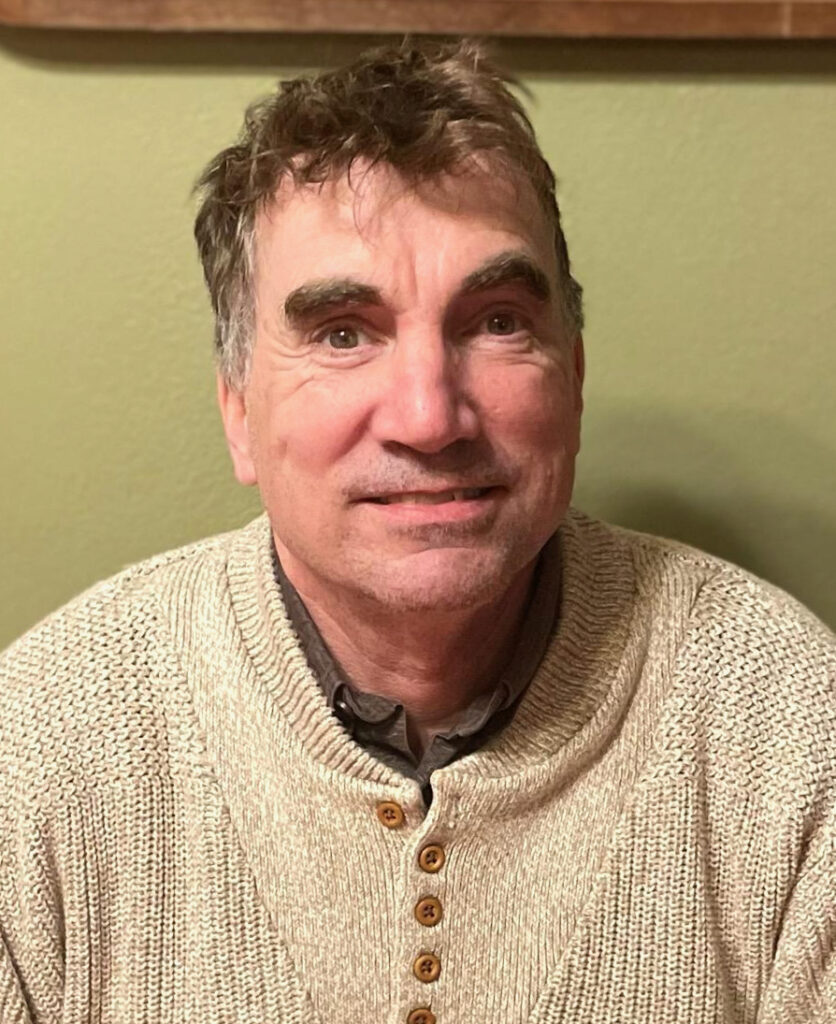
Art Coleman
Age: 55
Address: 403 S. Whiton St.
Occupation: Department of Corrections
Number of years resided in city: 19
Education: Graduate of UW-Whitewater
Civic and other organizational memberships: Proud to be supporting our kids in all they do, soccer, volleyball, gymnastics, plays, musicals, band, etc.
Political experience: none
What are your reasons for seeking this position?
I believe I am able to serve as judge with my 23-plus years experience working with the courts in Kenosha, Walworth, and Rock counties.
What are the most pressing issues facing the position you seek?
I have spoke with people in the community, and truancy seems to be an issue. I’d be working with the schools, police, and the city to seek a common sense approach to dealing with this issue
What unique perspective do you bring?
I grew up on a farm outside of Whitewater; I graduated from Whitewater schools, then from UW-Whitewater. My wife and I moved back here in 2004. Our kids are here, we have roots here.
Any additional comments?
None cited.
Whitewater Common Council Voters Guide: Three of four candidates running unopposed share views
(Originally published March 22, 2023.)
Compiled by Kim McDarison
A spring general election will be held Tuesday, April 4. Whitewater residents will find four candidates, each running unopposed within their aldermanic districts or at large, on the ballot.
Candidates include David Stone, who is running for an open seat in Aldermanic District 1. Incumbent Carol McCormick has indicated that she will not seek reelection. In Aldermanic District 3, incumbent Brienne Brown is running to retain her seat. Challenger Neil Hicks is running for an open seat in Aldermanic District 5. The district’s incumbent, Greg Majkrzak will not seek another term. Serving at-large, Lisa Dawsey Smith’s name is also on the ballot.
Fort Atkinson Online recently asked each of the candidates to provide some biographical information and fill out a short questionnaire. Candidates were asked to respond to four questions using a combined total of between 700 and 1,000 words.
Candidates were asked to submit a photo for publication.
Three of the four candidates — Brown, Hicks and Dawsey Smith — have responded to our request. Although Fort Atkinson Online made several attempts to reach Stone by email and phone, we did not receive a response from the candidate. Should Fort Atkinson Online receive questionnaire responses from the candidate, they will be published at that time.
Information provided by the three responding candidates follows.
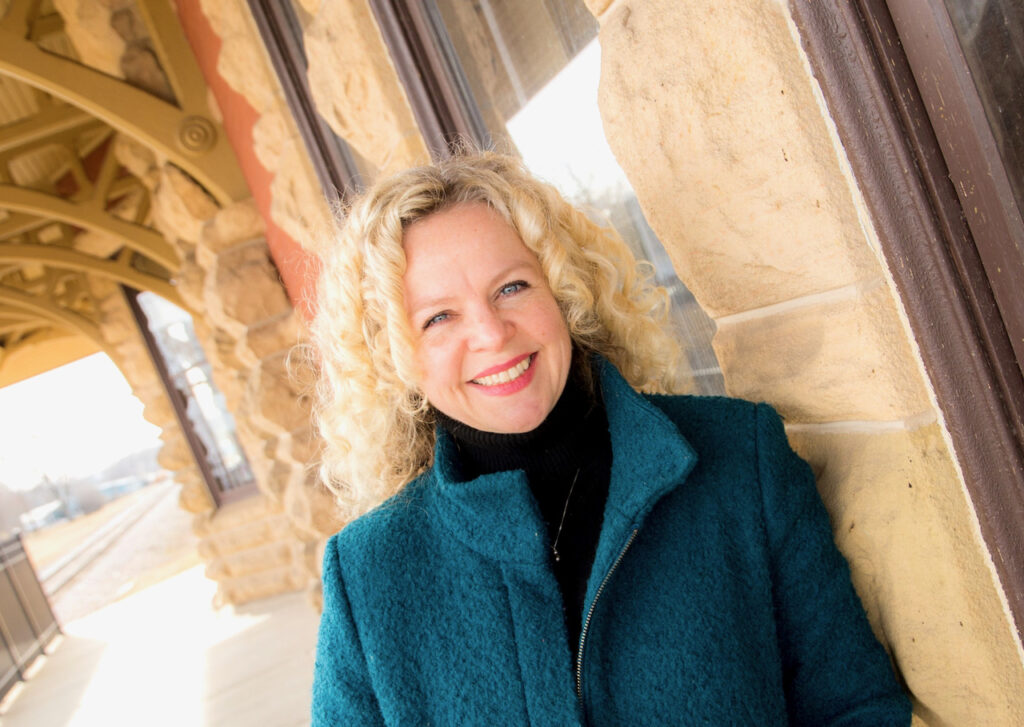
Brienne Brown
Age: 50
Address: 156b N. Fremont St.
Occupation: Grant Writer/UWW Instructor
Number of years resided in city: 11
Education: Bachelors in Journalism at the University of Texas at Austin
Civic and other organizational memberships: Library Board, Plan Board, Equal Opportunities Committee, League of Women Voters, Vice President of the Whitewater Grocery Cooperative
Political experience: I’m running for my 3rd term on Whitewater City Council.
What are your reasons for seeking this position?
I spent many years as a journalist and managing editor of a geopolitics firm called Strafor.com. This work involved analysis of budgets, looking at court documents, and understanding the underlying issues that affect communities and leaders. I like to research, I read fast, and I have the background to make informed decisions on complicated matters with an eye on long-term planning. I also spend a decade working in chronic disease epidemiology, which put me in a unique position of studying communities and coming up with plans for how to solve chronic community problems. I have been involved in Whitewater volunteerism (starting a makerspace, helping create the Tuesday farmers market, becoming a founding board member for the Whitewater Grocery Co.) since the day my family moved here. I love Whitewater with all my heart, and I want to help everyone thrive.
What are the most pressing issues facing the position you seek
We have a number of challenges, but our biggest are a housing crisis and a grocery store. There has been no new homebuilding for decades, which creates a cascade of problems. No new homes means that old homes are being assessed at higher values (higher taxes), even though they haven’t been updated. This creates a lot of old stock that is hard to sell, since the buyer will have to invest a ton to fix the house. Too many of our homes have been turned into rentals, which also increases the assessments of the available single family housing. We need to build, and we need to do it ASAP. We’re on the right path as a city to make this happen.
When a town doesn’t have a grocery store, all of the businesses suffer; people grocery shop outside of town and do the rest of their errands out of town as well. I’m a founding member of the Whitewater Grocery Cooperative. The experts told us that it would take 5-7 years to get organized and built, and we are in year 6. We just found a plot of land and a developer. We need to encourage our city to support a community-owned grocery store, which will add to the tax revenue and erase the designation of being a USDA Food Desert.
What unique perspective do you bring?
Though I call Whitewater my forever home, I was lucky to grow up a military kid and experience living in a number of cities and countries. I have spent a huge chunk of my life studying what cities do well and where they can improve. In fact, I studied city planning in college and utilized that information when working as a geopolitical editor. The geography of an area and how cities are built are some of the most important indicators underneath decision-making. I love being able to bring a well-traveled and educated opinion to Whitewater.
Any additional comments?
Cities don’t work in a vacuum. Shared revenue is an important thing to think about. Over the years, the state government has spent less and less money on public services. That includes sharing tax revenue with school districts and city government. As the amount of money from the state has diminished, our local schools and cities are doing more with less. Budgets tighten every year, and projects (like roads, building repair, and city services) get delayed more and more. I pay very close attention to what our Legislature is doing and whether or not it is meeting the demands of the local governments across Wisconsin. You can count on me to write the letters advocating for a better funded local government so that our citizens do not feel like they are being taxed twice for the same thing.

Neil Hicks
Age: 45
Address: 1254 Tower Hill Pass
Occupation: Telecommunication Technician at Alliant Energy
Number of years resided in city: 23 years
Education: Associates Degree in Electronic Engineering Technology from Herzing College (Wisconsin School of Electronics), 1999
Civic and other organizational memberships: Whitewater Middle School PTO Co-Treasurer
Political experience: Current Whitewater Planning Commission board member, previous Council Aldermanic District 5 candidate in 2021.
What are your reasons for seeking this position?
I look at neighboring communities and see tremendous growth and opportunity. When I look at Whitewater, I see many food choices, but no new business growth. We have lost too any jobs in the last few years in our city, and I want to help turn that around. I also want to get Whitewater back to being a welcoming city for all residents, visitors as well and commercial and industrial business. I want to see more fiscally conservative spending, cut out the waste and poor capital planning.
What are the most pressing issues facing the position you seek?
Retaining and attracting business to a city with a history of being anti-business. Hearing comments from local business owners about the red tape and difficulty they have opening or expanding their business in the city of Whitewater. We need to plan more for our future capital needs, to be sure not to overwhelm the residents when it comes to tax bills.
What unique perspective do you bring?
I work in a technical position that requires attention to detail; I feel that is the kind of detail needed to dig into problem and find proper solutions that will benefit all city residents. I have a can-do attitude, and I will not back down. I have no problem speaking out against bad policy and will be that lone ‘no’ vote when needed.
Any additional comments?
Although I do not have a candidate to run against, I do not take this position lightly. Anyone serving the public, should take it seriously and be proud of the work they do. As a council, we have many who report to us, but in the end, I report to my district and city’s constituents. I intend to make my constituents voices heard from my district and ensure our city will have the best run government for years to come.

Lisa Dawsey Smith
Age: 42
Address: 273 N. Fremont St.
Occupation: I’m fortunate to have the opportunity to be a homeschool parent. I retired from my career in management to do so.
Number of years resided in the city: 7.5
Education: I studied Computer Engineering at Clemson University
Civic and other organizational memberships: I am thankful for the opportunity to have volunteered for a number organizations and events in Whitewater since my family moved here including Downtown Whitewater, the Whitewater City Market, the Whitewater Area 4th of July Committee, the Whitewater Area Chamber of Commerce, the Whitewater Area League of Women Voters, the city’s Community Involvement and Cable TV Commission, the city’s Plan and Architectural Review Commission, UW-Whitewater’s Community Engagement Center Advisory Committee, among others.
Political experience: As mentioned above, I have served on city-appointed committees and am currently serving in my first term as a member of the Common Council.
What are your reasons for running for this position?
Running for an elected office is a way to serve the community my family and I have chosen as our home. I believe it is critical the decisions by an elected body be representative of the needs and voices of the community. I also recognize I am in a position where I am fortunate to have both the time and a willingness to do that.
What are the most pressing issues facing the position you seek?
Not unlike many communities in Wisconsin, Whitewater has a number of challenges either already at hand or looming in the near future. I will keep it to three to be respectful of the reader’s time. For any challenge we face as a community, we need to consider solutions for the short and long term. We cannot afford to be reactive (unprepared) for the challenges we face and should instead utilize our leadership opportunities to prepare proactive answers to these challenges.
First, we have housing needs within the city not unique to Whitewater. Unlike many communities, we have a unique opportunity in the ability to use an Affordable Housing extension of a retired Tax Increment Financing District. This will be a catalyst in beginning to address some of our housing issues. We need to make progress on that over the next 6-12 months as we are already falling behind other communities in the availability of our housing stock. We must also be attentive to the complexity of our housing issues outside the scope of what can be impacted by the Affordable Housing Extension fund.
Second, our community is experiencing a period of substantial change. Whitewater has had a rather unique demographic makeup for decades, but we are now experiencing changes unlike what we have seen in recent memory. We need to understand those changes and how they dictate changes to service delivery throughout all city-provided services. Of note, here are a couple of changes we are already navigating. We have an aging population who increasingly desires to age in place. We have an influx of newcomers who have unique challenges and needs. We have a university who has changed and will continue to change to remain competitive in their marketplace. These are important because we have to be committed to and consistently seek ways to maintain meaningful dialogue not only to understand our changing demographic but position ourselves to flourish as we navigate those changes.
Third, is growth. Is our community growing? Not from the perspective of simply our total number of residents, but are we attentive to growth in our tax base, growth for our small and large business community, and growth on other fronts? Growth is an important part of our city and it should be on the forefront of our discussions and planning over the short and long term. We also need to acknowledge that we are in competition with other communities for residents, businesses, students, and more. If we do not foster and maintain a growth mindset, we will find our community stagnant and falling behind our neighboring communities.
What unique perspective do you bring?
Pragmatism. As a community we cannot afford to waste time on anything other than finding practical solutions to the challenges and opportunities already at our doorstep or ahead of us in the future. We need to be honest about our problems, we need to have meaningful dialogue about our challenges, and then we just need to find practical ways to address them. It is the expectation that I have in my personal life, and it is one I believe we need as a community.
Any additional comments?
I look forward to the opportunity to continue to serve my community if reelected in April. Please don’t hesitate to reach out and be an active participant in the decisions the council will consider over the next year and longer, we need to hear from you to make the best decisions for the community. My contact information is available on the city website.
Whitewater, breaking: Person reported hanging from bridge; public asked to avoid area
(Originally published March 26, 2023.)
By Kim McDarison
Whitewater Police Chief Dan Meyer has confirmed that an individual has been found in Whitewater hanging from a bridge.
Additionally, Meyer confirmed that the medical examiner’s office has been called.
Meyer made the confirmation by email at 1:25 p.m. Sunday.
Reports released by both the Walworth County Scanner Updates and the Jefferson County Scanner Facebook pages are advising that allegedly an individual is hanging from a bridge near the intersection of Main Street and Jefferson Street in the downtown area of Whitewater.
Both scanner pages are reporting that the public is being asked to avoid the area to allow EMS and law enforcement agencies to do their work.
The reports were posted around noon Sunday.
This story will be updated as information becomes available.

File photo.
Whitewater: Body recovered from Main Street Bridge
(Originally published March 27, 2023.)
Editor’s note: The following information has been released by the Whitewater Police Department.
On Sunday, March 26, 2023, at 11:21 am, Whitewater Police, Fire and EMS, responded to the Main Street bridge in the 100 block of W. Main St. for a deceased male found suspended from the bridge. The male was identified as 47-year-old, Cameron Bicknell, of Whitewater. Based on the investigation, this was determined to be a suicide that occurred late in the day on Saturday, March 25 . The Walworth County Medical Examiner was called to the scene to assist in the death investigation, and an autopsy has been scheduled. We offer our sincere condolences to those who knew Mr. Bicknell.
We want to ensure our residents are aware of the crisis resources available in the community. There is immediate access to the Suicide and Crisis Lifeline by dialing 988. Additionally, Walworth County residents can connect with Walworth County Crisis resources at 262-741-3200, and Jefferson County residents can connect with Jefferson County Crisis resources at 920-674-3105. Finally, anyone in crisis can get connected to services by contacting the Whitewater Police Department at 262-473-0555 or by calling 911.

File photo.
Whitewater woman arrested in connection with deceased newborn
(Originally published March 27, 2023.)
Editor’s note: The following information has been released by the Whitewater Police Department.
Whitewater, WI – March 27, 2023 – On Friday, March 24, 2023, Whitewater Police arrested a 39-year-old Whitewater woman, believed to be the mother of the deceased newborn. The suspect is currently confined in the Jefferson County Jail. This case continues to be investigated, but the following charges are being forwarded to the Jefferson County District Attorney’s Office at this time: Wis. Stat. 948.23(2) – Concealing Death of a Child and Wis. Stat. 946.41 – Resisting or Obstructing Officer. It should be noted that additional charges, or modifications to these charges, may follow based on the continuing investigation. We thank the Wisconsin Department of Justice – Division of Criminal Investigation for their investigative assistance in this case. Due to the fact that this case is ongoing, no additional details will be provided at this time.

File photo.
Whitewater woman charged with neglecting a child resulting in death
(Originally published March 28, 2023.)
By Kim McDarison
A Whitewater woman has been charged with neglecting a child resulting in death and moving, hiding or burying a corpse of a child in connection with a body of a baby found in a field earlier this month.
Santos Asucena Caseres Cruz, 39, was arrested Friday, March 24, and taken into custody by the Whitewater Police Department and confined in the Jefferson County Jail.
According to information released by the Whitewater Police Department, charges of concealing death of a child and resisting or obstructing officers were forwarded to the Jefferson County District Attorney’s office.
Additionally, information released by the Whitewater Police Department alleges that Caseres Cruz is the deceased child’s mother.
Charges filed against Caseres Cruz allege her involvement in the placement of a body, described by police as that of a newborn baby. The body was discovered by police on the morning of March 4, in a field behind the Twin Oaks Mobile Home Park on Tratt Street, in Whitewater.
According to information released by the Whitewater Police Department, the body was male, and discovered in a plastic bag, inside a cardboard box. The body was wrapped in a light-colored shirt. Police noted that they believed the body had been placed in the field less than 48 hours before it was located.
According to the Wisconsin Circuit Court Access website, a Class D felony charge of neglecting a child with a consequence of death and a Class F felony charge of moving, hiding or burying a corpse of a child were filed Tuesday by the office of Jefferson County District Attorney Monica Hall.
Caseres Cruz appeared before Jefferson County Circuit Court Judge William F. Hue via video conference at which time a cash bond of $10,000 was set with the conditions that the defendant surrender any passport, not leave Jefferson County, and report and comply with a GPS monitoring program administered by Wisconsin Community Services.
According to court documents, the defendant would be released from custody “on GPS monitoring only.”
Caseres Cruz will next appear in court for a preliminary hearing scheduled for Tuesday, April 4, at 9 a.m.
As defined by Wisconsin state statutes, a Class D felony carries a maximum penalty of 25 years in prison or a fine of up to $100,000.
A Class F felony carries a maximum penalty of 12.5 years in prison or a fine up to $25,000.

File photo.
Criminal complaint: Medical examiner ‘not able to determine cause of death’ in case of baby found in field
(Originally published March 29, 2023.)
By Kim McDarison
Information found within a criminal complaint filed by the Whitewater Police Department Tuesday notes that the Medical Examiner’s Office in Milwaukee was “not able to determine a cause of death” regarding the body of an infant found in Whitewater.
A story about charges filed against Whitewater resident Santos Asucena Caseres Cruz, who is alleged to be the child’s mother, is here: https://fortatkinsononline.com/whitewater-woman-charged-with-neglecting-a-child-resulting-in-death/.
The criminal complaint, which brings charges against Caseres Cruz of neglecting a child with a consequence of death and move, hide, bury a corpse of a child, alleges that the defendant “did negligently fail to provide necessary care so as to seriously endanger the physical, mental and emotional health of a child, and the child suffered death as a consequence.” The action constitutes a Class D felony.
Additionally, the complaint alleges that the defendant near the date of March 4, which is when the body was discovered, without legal authority, moved, hid or buried the corpse, which constitutes a Class F felony.
Information submitted by the Whitewater Police Department states that the body was found near the Twin Oaks Trailer Park in Whitewater, within a portion of the city which is located in Jefferson County, at 11:11 a.m.
The body was found in a cardboard box approximately five yards off of the roadway at the far end of the mobil home park, according to the complaint.
The complaint notes that the individuals who called the police using 911 said they found the body in a field near the trailer park at approximately 11:05 a.m., after they carried the box toward the road and looked inside.
A Whitewater police detective said he arrived at the scene around 12:15 p.m. and noted that the infant was wrapped in a blood-stained shirt, with the umbilical cord still attached, and the placenta was found in a separate garbage bag.
The body was taken to the Milwaukee Medical Examiner’s office. Whitewater detectives also received photographs from the Wisconsin State Crime Lab resulting from forensic imaging of the shipping label on the cardboard box in which the infant was found. The address led police to an individual described as “Witness 1.”
As described within the complaint, conversations with Witness 1 led police to Caseres Cruz.
Police interviewed Caseres Cruz on March 24, according to the complaint, at which time she told police she was not pregnant and had not concealed a newborn in a field. The defendant consented to a buccal swab and to allowing law enforcement to search her residence and car.
During the search of the defendants car, law enforcement agents found articles similar to those in which the baby’s body was found.
Caseres Cruz was arrested on March 24.
Conversations held with an individual identified as Witness 2 led police to the understanding that in late January, the defendant was suffering from stomach pain and possibly hemorrhaging.
According to the complaint, the defendant, in a subsequent interview, told police that she was previously pregnant and had experienced stomach pain on January 27 at approximately 6 p.m., which, the complaint stated, “was a few days away from her due date and she believed she was going to give birth.”
She did not tell her children about her circumstances because, the complaint stated: “she did not want to lose contact with them because she was pregnant with a different man than their father.”
After laying in the bathtub and laboring for about an hour, the defendant said she gave birth to a boy, the complaint noted, adding that when the child was born, he was not breathing or moving. The defendant said he did not cry and she believed he was dead, the complaint indicated.
According to the complaint, the defendant told police that she “continually checked to see if the baby was breathing, but never felt him move or breathe.”
Police indicated that her statement was “modified,” alleging that the defendant has earlier said that she knew the baby was alive when he was born, but was possibly choking.
After the baby was born, he started “getting purple,” the defendant told police, according to the complaint. As the night went on, the release continued, the baby’s arms and hands also turned purple.
According to the complaint, the defendant told police that she did not call 911 because she was scared her children would find out that she had been pregnant.
The complaint states: “The defendant said approximately half an hour after she gave birth and set the baby under the sink in the plastic bag, her other children were asleep and quiet. She retrieved the baby from inside the cabinet, wrapped the baby in a pink sweatshirt and put the baby inside a cardboard box. She placed the box on her bed and cried all night.”
At approximately 4:30 a.m., the complaint reported, the defendant removed the baby from the bag, cut the umbilical cord to separate the baby from the placenta and placed the baby in a black garbage bag. At approximately 5 a.m., she drove to the field near the trailer park and left the baby behind.
“She said she checked on the box every day and cried,” according to the complaint.
Caseres Cruz, who appeared in Jefferson County Circuit Court Tuesday by video conference from the Jefferson County Jail, will next appear in court for a preliminary hearing scheduled for Tuesday, April 4, at 9 a.m.
The full criminal complaint is here: http://fortatkinsononline.com/wp-content/uploads/2023/03/Complaint-Criminal_2-Caseres-Cruz-Santos-Asucena-2023CF000114-Caseres-Cruz-Santos-Asucena_3049727_1.pdf.

File photo.
Pouring iron: Whitewater’s Wisconsin Makers group to host tile-making event
(Originally published March 31, 2023.)
By Kim McDarison
In 2016, when Pete Spangler, then a Fort Atkinson resident and president of the nonprofit group Wisconsin Makers, Inc., purchased the former Whitewater Register newspaper building on Clay street in Whitewater, he had a vision of turning the building into a place where inventors, tinkerers and crafters could come together, use equipment provided by the organization, and envision and make things.
The experience was meant to use a “collaborative and educational approach to creativity,” according to information found on the Wisconsin Makers website.
Responding to questions about the Wisconsin Makers concept in 2017, Pete said that after he established the workshop, he met with University of Wisconsin-Whitewater Art Department metal studio instructor and co-owner of Wisconsin-based Cowyard Studio Teresa “Tree” Lind and together, in 2016, they organized an iron pour.
The event brought students and community members together to explore the creative process of making a one-of-a-kind iron tile from scrap cast iron materials.
Since that inception, the Wisconsin Makers spring iron pour has become an annual event — albeit with a pause taken in 2020 and 2021 as a COVID-19 precaution — attracting in some years, according to its organizers, as many as 100 participants and spectators to the day-long activity.
Making a tile
For those interested in making a tile, the process begins with a 5- by 5- by 1-inch block, which combines sand with a binding agent. The block is designed to allow an artist to easily scratch a design that can next be filled with molten iron.
To create the molten iron, Lind, throughout the year, collects discarded items made of cast iron that can be cut into what she described as “Dorito-sized” chips. The chips are next loaded into a specialized melting device called a cupola furnace.
As the iron melts, it is removed from the furnace and transported by a two-man team in a device called a crucible, and poured into the individual molds.
The full iron pour process requires the assemblage of an iron pour team which, in past years, has been comprised of as many as 10 members. Team members include Lind’s fellow artist friends, University of Wisconsin-Whitewater metal studio students, and graduates and past students involved with the UW-Whitewater metal studio program. Clad in specialized gear to protect them from the heat, team members load the cupola, fill the crucible, and move the iron between rows of waiting scratch molds into which they pour the molten material.
After the iron cools in the molds, members of the team remove the tiles from each mold, set them aside for further cooling, and, once they are cool enough to touch, grind away rough edges before presenting them to their creators.
Individuals of all ages and artistic abilities, who are cordoned for safety from the active pour area, eagerly await completion of the process and the presentation of their piece.
During the process, team members, many of whom have participated in other iron pours, gain experience in learning about the different jobs assigned to members of an iron pour team.
The captivating and fiery process has annually attracted large groups of participants and spectators, organizers have said, many of whom stay for the day, visit with fellow participants and tour the Wisconsin Makers facility.
The day is complete with food available for purchase.
Pete died in March of 2022. That year, the event was organized by Wisconsin Makers, Inc., members and Pete’s wife, Chris, and was attended by members of the Spangler family.
The event will once again take place Saturday, April 15, at the Wisconsin Makers building, 200 E. Clay St., Whitewater, with activities beginning at 9 a.m.
A shop teacher’s vision
Offering insight, in 2017, into his makerspace vision, Pete said things fell together when he and Chris purchased the 5,000-square-foot building, which they dubbed the “Whitewater Manufactory.”
Before the couple purchased the building, Pete said he was already working with the makerspace concept from a location on Bluff Road in Whitewater.
Offering some history about the Clay Street building, he said it had formerly served as the headquarters of the city’s newspaper, the Whitewater Register, which was then locally owned. The paper was later purchased by Southern Lakes Publishing, which, today, has headquarters in Delavan.
Pete said that the interior of the building had been remodeled to include office and warehouse space some 18 years prior to 2017, noting that the structure was built in 1975.
Recalling his own life’s journey, in 2017, Pete said he had retired from his career two years earlier, which had included time spent as a high school shop, engineering and tech program teacher, and began operating the makerspace program in Whitewater.
According to his obituary, Pete earned a bachelor’s degree in technology education with an emphasis on metals from the University of Wisconsin-Platteville in 1979 and later a master’s degree from UW-Stout in Menomonie. He also was a licensed journeyman/master machinist and tool-and-diemaker and was certified in quality engineering and assurance.
As a teacher, early in his career, he taught metals at Mayville High School, and, during the 1990s, after exploring work as a machinist, he returned to teaching for 18 years, during which time he spent eight years teaching technology and engineering, overseeing the student apprenticeship program and advising the FIRST Robotics team at Mukwonago High School.
Additionally, his obituary noted, he taught at Jefferson, Lake Mills and Beloit high schools, and was a full-time metals instructor for two years at Waukesha County Technical College in Pewaukee and a part-time instructor at Madison Area Technical College in Fort Atkinson.
With the purchase of the building on Clay Street, Pete said, for him: “Things just fell into place.”
In 2016, when the Spanglers took possession of the building, he noted, the place was in “bad condition.”
While the newspaper no longer operated from the location, Pete said the building was never abandoned.
“There was always something going on it here,” he added.
By 2017, Pete had filled the space with myriad equipment which he said he hoped would inspire creators to become members of the makerspace, a place where they could meet other members and work to develop their business and hobbyist ideas.
During the iron pour held in 2017, Pete enthusiastically greeting members of the public as they wandered through the various shops within the building and learned about the makerspace concept and equipment.
Describing the concept, Pete said a makerspace was “a grassroots movement,” which, he noted, “was unusual” for a smaller city like Whitewater.
Still, he said, he was committed to the project, stating: “I live and die for equipment.”
Schedule of events
This year, iron pour event-goers arriving at 9 a.m. can begin the day by making a scratch block.
According to information released by the Wisconsin Makers organization, the per-person cost for members of the general public to obtain a block is $25; a cost for Wisconsin Makers members is $15. Blocks are available on a first-come, first-served basis.
Artists must complete their blocks by 11:15 a.m.
Blocks will next be assembled for pouring, which will commence at noon.
Artists can anticipate receiving their finished tiles by mid-afternoon, the release stated.
Scratch mold workshop
In addition, a workshop will be available for those interested in creating their scratch mold in advance of the iron pour.
The workshop will be held Friday, April 7, from 4:30 to 8 p.m., at the makerspace building on Clay Street.
Artists also may purchase a block at the workshop and work on it at home.
About Wisconsin Makers
According to information released by the organization, Wisconsin Makers is a nonprofit regional “makerspace,” defined as a community workshop, offering an affordable, collaborative and educational environment that inspires people of all ages to become innovators by unlocking their skills through continual experimentation and training. Work areas/equipment include: 3-D printing, laser engraving, machining, welding/fabrication, electronics, blacksmithing, woodworking, ceramics/pottery, jewelry making, arts/crafts, quilting/fabric arts, and matting/framing, among others.
For more information on the iron pour or scratch mold workshop, or to learn about the makerspace or memberships, visit the organization’s website: http://wisconsinmakers.org or contact Wisconsin Makers President Al Jewer by phone: 630-430-9498.

Members of the iron pour team fill molds with liquid iron. File photo/Kim McDarison.
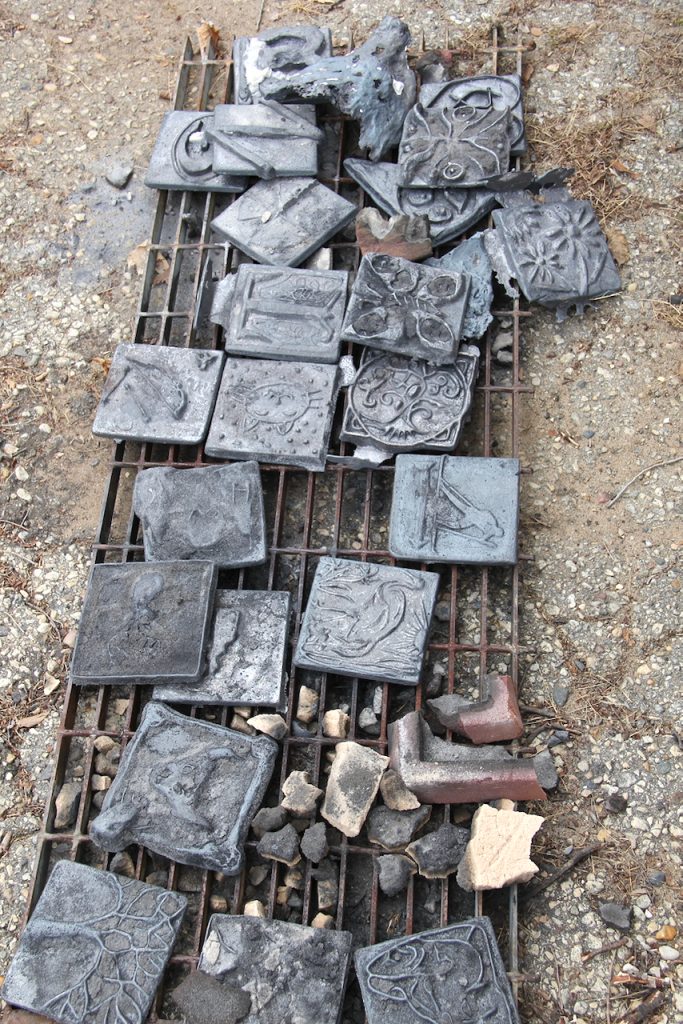
Tiles made by iron pour participants in 2017 wait to cool. The tiles will next receive a wire brushing and edges will undergo grinding by team members to remove sharp edges before they are presented to their creators. Contributed photo.
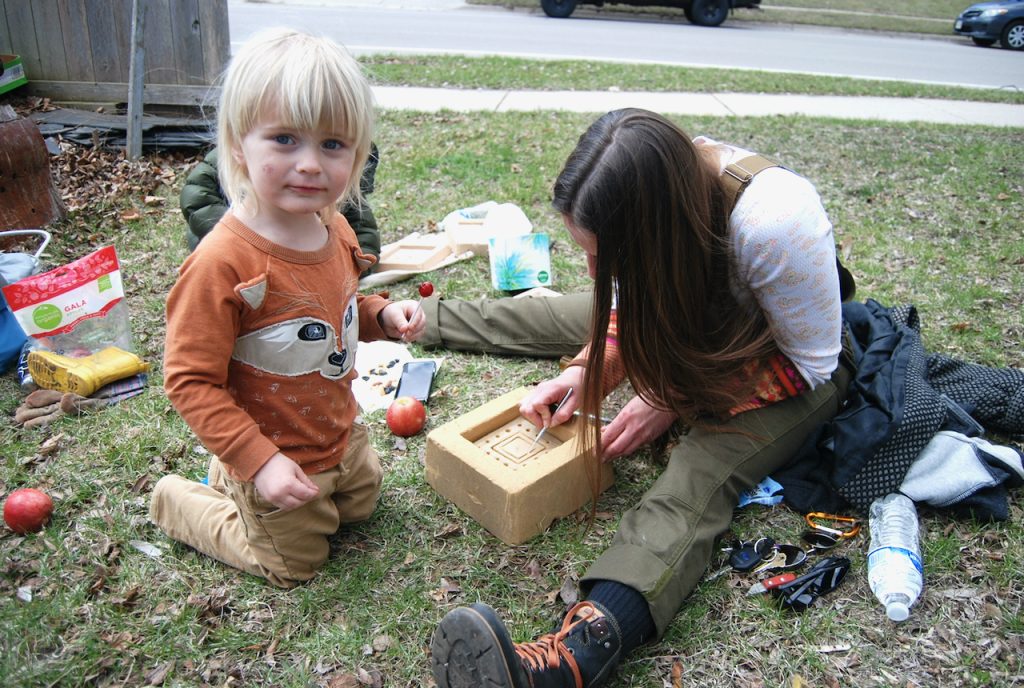
A mother and child work on their scratch block during a previously held iron pour. Kim McDarison photo.
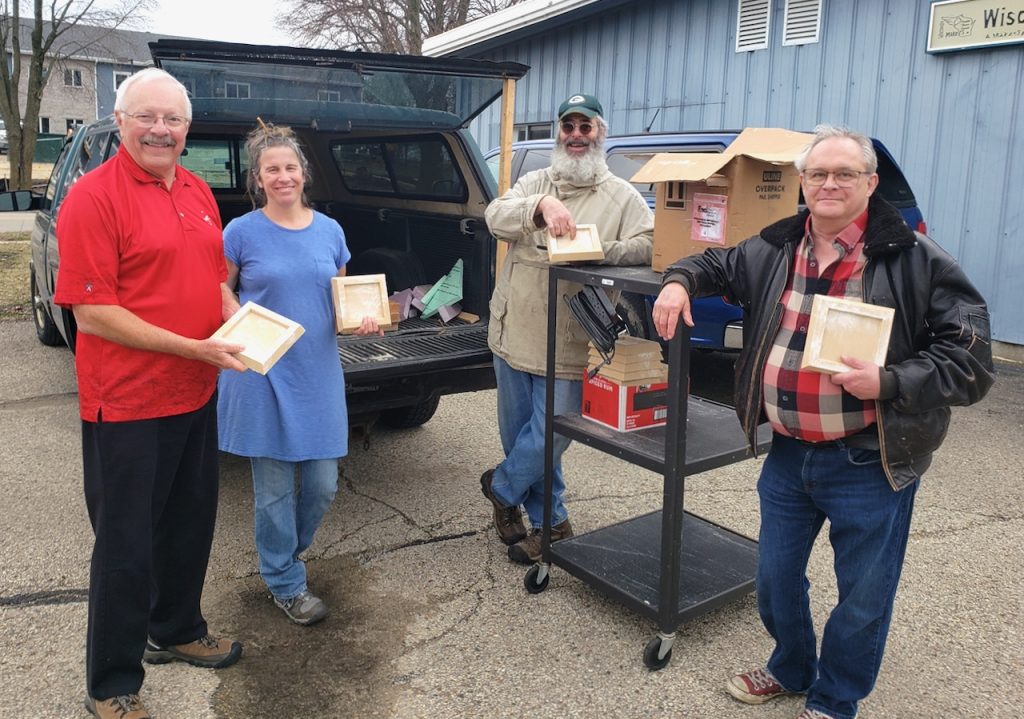
Wisconsin Makers Treasurer Ron Binning, from left; Teresa “Tree” Lind, art lecturer at the University of Wisconsin-Whitewater and iron pour team leader and organizer of the Sixth Annual Spring Iron Pour; Wisconsin Makers member Kent Taylor, and Wisconsin Makers President Al Jewer unload scratch blocks in advance of a workshop scheduled for Friday, April 7, at the makerspace, 200 E. Clay St., Whitewater. Contributed photo.
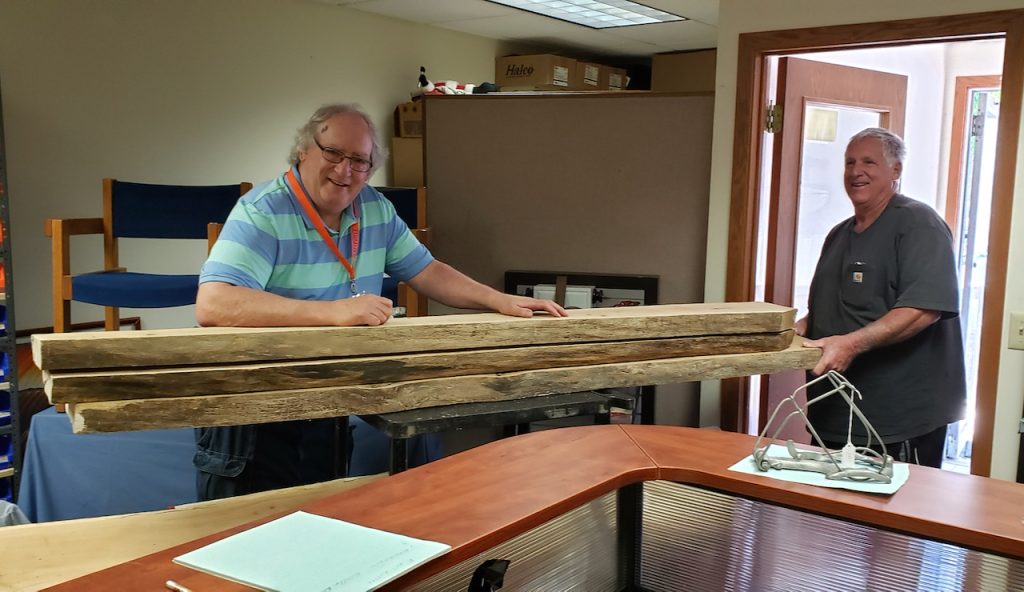
The late Pete Spangler, at left, helps load wood collected at the Wisconsin Makers building in Whitewater. Contributed photo.
UW System approves resident undergraduate tuition increase; says first in 10 years
(Originally published April 2, 2023.)
The University of Wisconsin Board of Regents approved Thursday a tuition and fee increased that will affect UW System students, including resident undergraduate students, systemwide.
According to information released Thursday by the system, the increase is the first made to resident graduate tuitions and fees over the last 10 years.
Systemwide, students will begin paying the increased tuition rates and fees beginning with the 2023-24 school year.
The recommendation to increase the rates and fees was announced in a news release on March 17 by University of Wisconsin System President Jay Rothman.
According to the earlier release, the average 5% increase in resident undergraduate tuition and fees proposal was brought before the Assembly Committee on Colleges and Universities, at which time members learned that, under the proposed plan, the exact increase would vary at each of the 13 UW System universities.
“Overall, the increase in cost of attendance for resident undergraduates would average 4.2% across the UW System when room and board is included,” the release stated.
According to information Released Thursday, “the approved recommendation provides for adjustments in tuition and segregated fees that vary by university, but average 4.9% — or $404 — for resident undergraduates.
“Accounting for an average 3.5% increase in room and board rates, the average increase to the overall total cost of attendance for Wisconsin resident undergraduate students at the four-year campuses would be 4.2% — or $706.”
In making the recommendation, according to the release, Rothman told Regents the system is guided by two priorities: “to remain affordable for students and to continue to deliver an outstanding educational experience in a financial sustainable manner, and that maintaining longterm financial viability requires both securing additional revenue as well as strict expense management.”
Within the release, Regent Scott Beightol, chairman of the Business and Finance Committee, noted that “several universities also propose to increase program-specific differentials in certain fields of study.”
Identified programs had several factors in common, the chairman noted, according to the release, including: a high cost to deliver; a high demand from prospective students, but with a lack of resources to expand enrollment, and graduates from the programs are in high demand by employers. Such programs were identified as nursing, computer science and engineering.
He noted, the release stated, that tuition rates for resident students have “been held flat” over the last 10 years while inflation has increased.
Additionally, Beightol reportedly noted within the release that the system’s “GPR tuition and auxiliary fund balances” even with the approved increase, were still projected to decrease. The system has plans to continue to look at “operational expenses and drive efficiencies,” he said.
“It is also essential for us as regents to be responsible stewards of the value of a UW education, which means we must be mindful of both the affordability and the quality we offer to students,” Beightol was quoted as saying in the release.
A link to the “Fiscal Year 2023-24 Tuition and Auxiliary Rate Recommendations” report produced by the Board of Regents’ Business and Finance Committee,” and included within the news release on March 30 is here: http://fortatkinsononline.com/wp-content/uploads/2023/04/Item-9.-2023-24-Recommendation-of-Tuition-and-Auxiliary-Rates-FINAL.pdf.
Proposed plan outlined March 17
Within the March 17 release, Rothman said: “We are an incredible value compared to our peers, and we know that an investment in higher education pays off in the long run with higher earnings and more career mobility. The strength of the UW System rests in the quality of education it provides to its students, and that is done through sound investment.”
The release noted that “a UW System affordability review in August found that a University of Wisconsin System education is affordable for most students, including in comparison to national averages, peers, and other Midwestern universities.”
Within the release, Rothman noted: “It is unsustainable to continue a decade-long tuition freeze, even as costs have increased and inflation has accelerated. This modest tuition increase will help our universities continue to provide students with a world-class education, produce the talent that makes Wisconsin’s workforce succeed, and spark innovation and vitality in our communities.”
As provided within the March 13 release, the proposed resident undergraduate tuition and fees for each university in 2023-24 are as follows:
• UW-Eau Claire: $9,137
• UW-Green Bay: $8,342
• UW-La Crosse: $9,477
• UW-Madison: $11,215
• UW-Milwaukee: $10,020
• UW Oshkosh: $8,258
• UW-Parkside: $7,855
• UW-Platteville: $8,096
• UW-River Falls: $8,425
• UW-Stevens Point: $8,674
• UW-Stout: $8,888
• UW-Superior: $8,487
• UW-Whitewater: $8,044
A link to the full UW System release on March 30 is here: https://www.wisconsin.edu/news/archive/regents-approve-first-tuition-increase-in-10-years-for-resident-undergraduates-day-1-news-summary/.

UW-Whitewater, file photo/Kim McDarison
‘Hate bias form’ to come before Whitewater’s Equal Opportunities Commission Monday
(Originally published April 2, 2023.)
By Kim McDarison
The fate of a proposed “hate bias form” and its associated procedure will be discussed during a meeting of the Whitewater Equal Opportunities Commission, according to the meeting’s agenda which has been posted to the city’s website.
The meeting will be held virtually Monday, April 3, at 5 p.m. Those interested in attending are invited to join the meeting using the “goto.com” platform. Instructions to download the app and join the meeting are included on the agenda, found here: https://whitewater-wi.gov/AgendaCenter/ViewFile/Agenda/_04032023-1679?html=true.
According to a memo found within the meeting packet from Whitewater City Manager John Weidl, the city’s staff is recommending to the commission that it not develop a form designed to formalize complaints of “hate bias” or any associated processes that would involve city staff.
Instead, the memo recommends that staff develop a “resource,” and “make clear that the police department will investigate criminal complaints.”
The memo states: “Do not ask staff to investigate and make findings regarding non-criminal complaints.”
Within his memo, Weidl noted that staff had considered “the suggestion” that the city approve a form for reporting and processing actions falling under the heading of “hate bias.”
Additionally, he wrote: “While the staff strongly supports the goals and principals of such a process, we as a group do not recommend that a process be implemented in the city,” further writing that the staff had consulted with the city’s attorney and police chief to formulate a recommendation against instituting a form and process.
He cited staff’s concern that non-police staff did not have the expertise required to investigate, and make findings and decisions regarding “these types of complaints.”
Weidl wrote: “This process could include interpreting complex statutes and codes and applying them to the facts and also involve other difficult analysis and decisions. Because a city staff ‘violation’ finding could have a serious effect on an individual’s reputation and employment opportunities etc., it would be necessary to have proper due process in place which should include a hearing type opportunity, which would require notice and the right to be heard.”
He pointed to such remedies as “a judicial trial proceeding” as a better avenue to ensure “due process.”
Additionally, he noted, “There are various federal and state laws protecting individuals from this type of conduct and there are agencies that are trained to investigate and process offenses.”
Weidl stated that staff was suggesting as an alternative approach that the Equal Opportunity Commission develop an information resource that could be made available to those who believed themselves to be a victim of a crime, discrimination or other “improper conduct.”
Within the meeting packet, an example of a form is provided, and states: “This form is to be used for reporting hate crimes, hate speech, bullying, unethical or discriminatory behavior occurring within the city of Whitewater by visitors, community members or city employees.”
The form offers check-boxes for the “nature of alleged bias,” including: age, disability, gender, marital status, national origin, parental status, pregnancy, race or color, religion, sexual orientation, and veteran status, among others.
A proposed process for receiving such complaints is also provided.
The full memo, example form and proposed process are here: http://fortatkinsononline.com/wp-content/uploads/2023/04/httpswww.whitewater-wi.govDocumentCenterView3467EOC-Agenda-Item-Hate-Bias-FormbidId.pdf.

Whitewater Municipal Building, file photo/Kim McDarison.
Lines, sometimes 20 voters deep, moved through Whitewater’s polling place Tuesday
(Originally published April 4, 2023.)
By Kim McDarison
Steady lines of traffic, sometimes as many as 20 voters deep, moved across the gymnasium floor Tuesday at the downtown Armory building, the city of Whitewater’s only polling place.
Around 4:30 p.m., Whitewater City Clerk Michele Smith said voter traffic moving through the polls was more than she expected as compared to a typical spring election.
While other ballot issues, such as a race to fill three seats on the Whitewater Unified School District Board of Education, were of interest to voters, she believed the race to fill an open seat on the Wisconsin Supreme Court was a factor which was contributing to the increased traffic.
She described traffic at the polls as “steady” throughout the morning and early afternoon, with a spike coming around 2:30 p.m., noting that the spike was particularly noticeable in lines serving wards within the city where University of Wisconsin-Whitewater students lived. In particular, she said, they are Wards 9 and 10 in the Walworth County portion of the city and Ward 13 in the Jefferson County portion of the city.
One of six polling site chiefs, Kay Sparling, said that even with the lines, she observed that everything was going smoothly and poll workers were able to keep lines moving swiftly.
Smith said that about 700 absentee ballots had been returned to the polling place Tuesday. The city issued more than 700, she said. Most had been returned by 4:30 p.m., but some continued to trickle in.
She, too, noting that things were running smoothly thanks to a full staff of 32 poll workers who were manning shifts throughout the day.
Looking at numbers, Smith said there are some 6,042 registered voters in the city of Whitewater. A breakdown is as follows: in Wards 11, 12 and 13, which reside in Jefferson County, some 1,157 voters are registered; in Wards 6, 7, and 8, some 1,469 voters are registered; in Wards 4, 5, 9 and 10, some 1,909 voters are registered, and in Wards 1, 2 and 3, some 1,507 voters are registered.
By 4:30, she said, some 2,128 voters, or 35% of those registered, had cast their ballots.
Lines at 4:30 p.m. continued to wind across the gymnasium and into the vestibule where poll greeter Jeanine Fassl, looked up the names of each voter and directed them to the appropriate line.
Looking at trends, Smith said that older voters, defining them as age 50 and older, have continued to vote using absentee ballots. The trend began during the COVID-19 pandemic, and within that age group, she said, the number of people requesting absentee ballots is increasing.
Smith, who will be retiring next week after 29 years serving as the Whitewater city clerk, said that over the course of her career, the largest voter turnout she’d experienced in Whitewater was in November of 2008 when Barack Obama ran for his first term as president.
In 2008, voter turnout was high, she said, noting that more than 7,000 ballots were cast by city of Whitewater voters in that election.
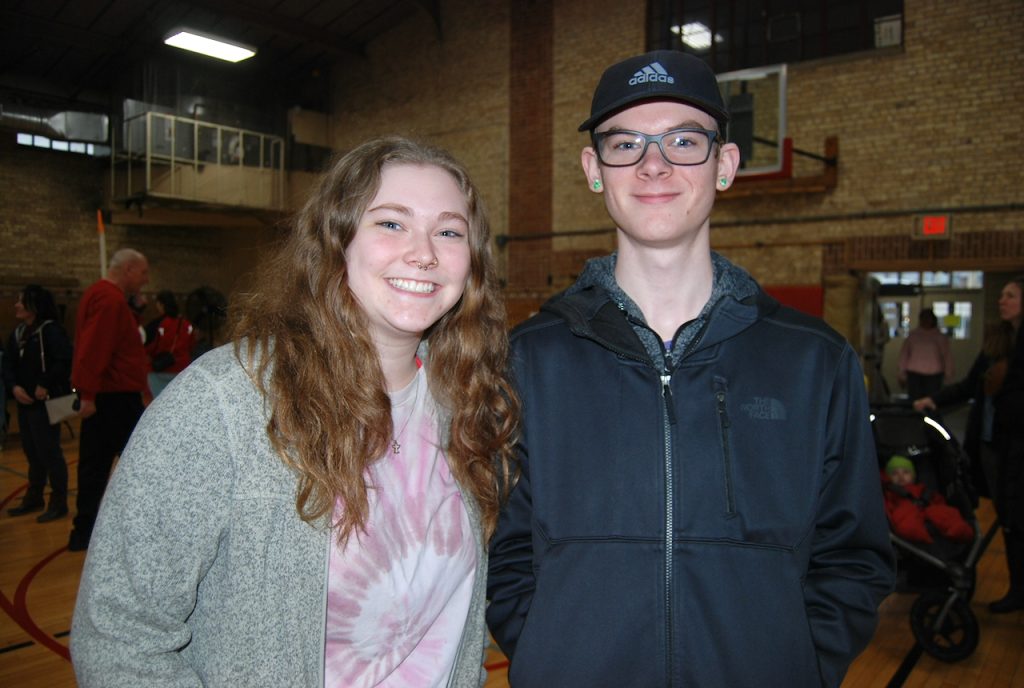
Christine Geiger, at left, and Tyler Smith, both University of Wisconsin-Whitewater sophomores, wait in line Tuesday afternoon to vote. Geiger is from Waunakee and Smith is from Janesville. Geiger said she was mainly interested in casting her vote for a Wisconsin Supreme Court justice candidate, while Smith said he had done some reading in preparation of voting for candidates running for seats on local boards.
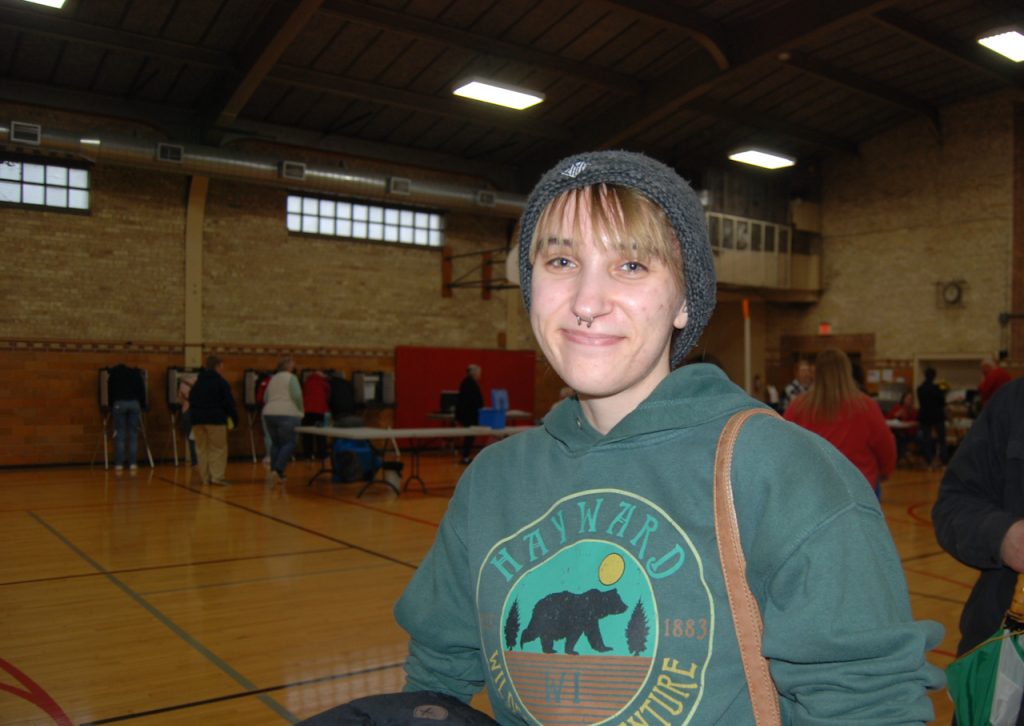
Waiting in line at the polls Tuesday afternoon, Jessica Grunewald, a UW-Whitewater junior from Sun Prairie, said she was mostly interested in the race to fill the Wisconsin Supreme Court justice seat, but she would vote for candidates in local races if she recognized any names.
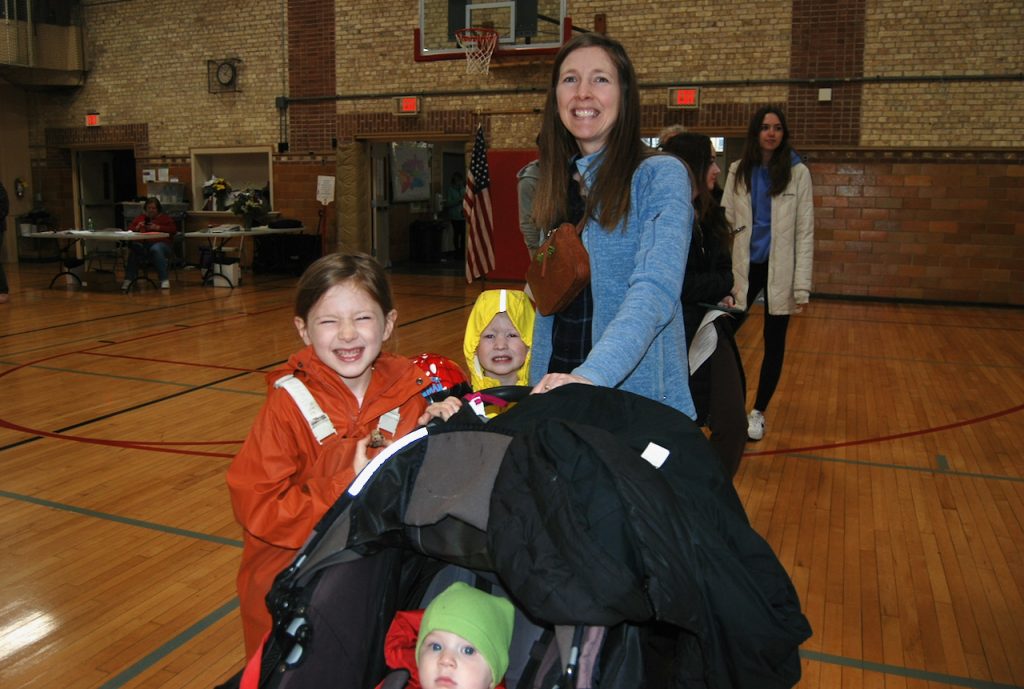
Waiting in line with her four children, ages 7 to 11, Karen Notstad said she homeschools her children but was still interested in all the races on the ballot. She said she was a math teacher for 10 years, and while she was educated about the local candidates, she believed the race for the Wisconsin Supreme Court justice seat was the most important on Tuesday’s ballot.
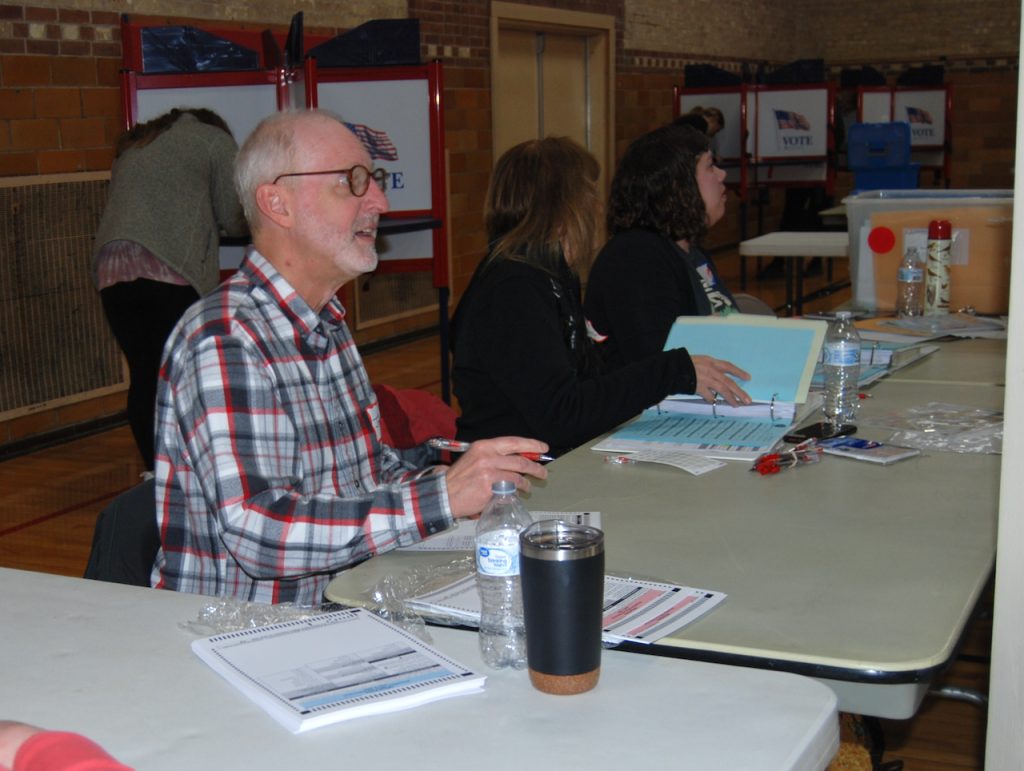
Poll workers Jim Olm, from left, Carolyn Behrens, and a poll chief Carrie Oster greet voters standing, sometimes as many as 20 deep, in the line for the city’s Wards 4, 5, 9 and 10. Wards 9 and 10 contain a large number of student housing units, City Clerk Michele Smith said.
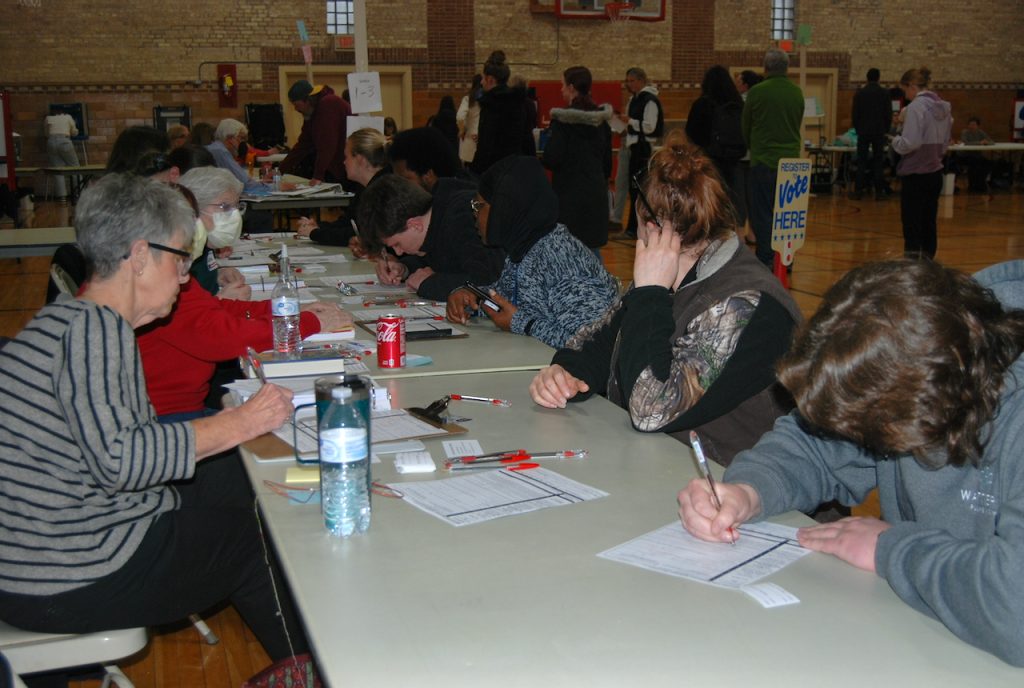
A table where poll workers help myriad voters register is in full swing Tuesday afternoon.
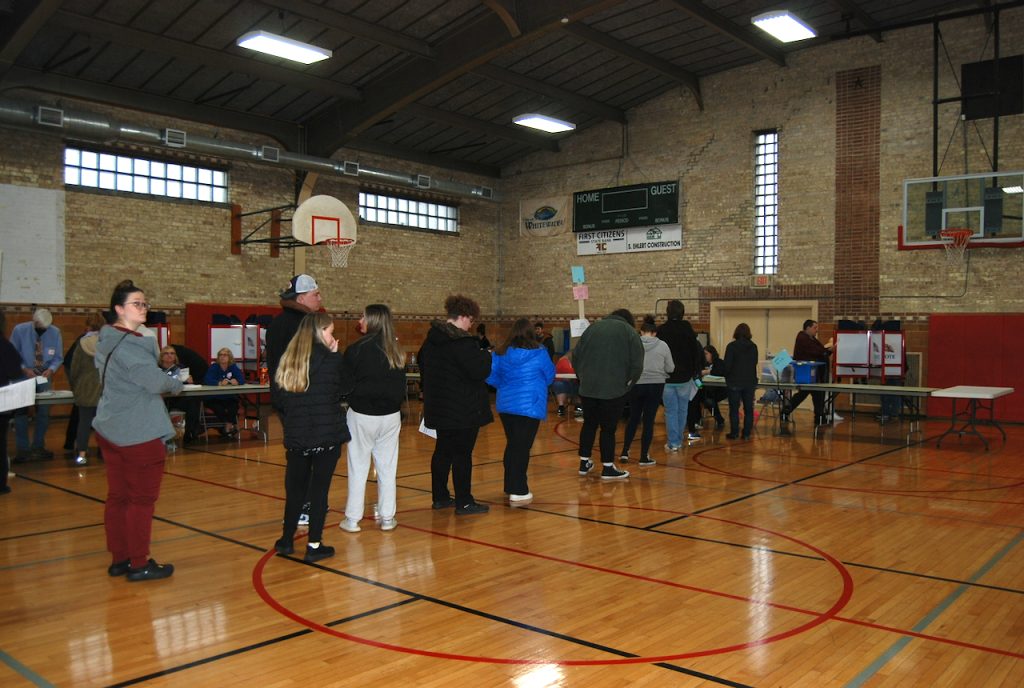
A line stretches across the gymnasium floor in the downtown Armory building which served Tuesday as the city of Whitewater’s only polling place.
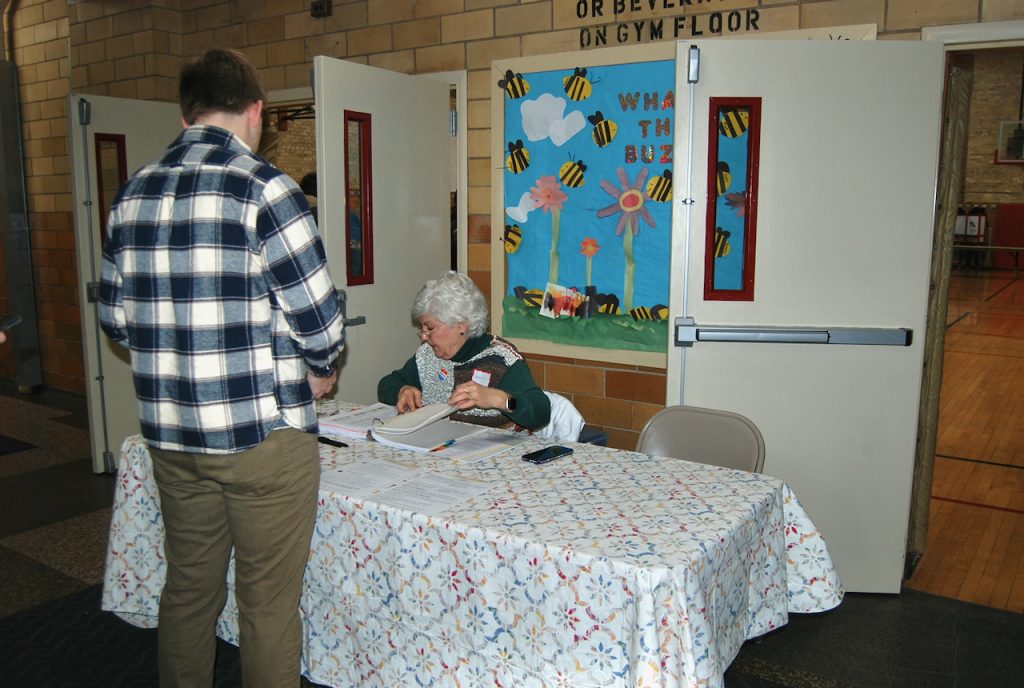
Whitewater polling place greeter Jeanine Fassl helps a voter determine his ward.

Whitewater City Clerk Michele Smith, at left, and poll chief Kay Sparling take a moment to reflect on Tuesday’s election and elections past. After serving as city clerk for 29 years, Smith will be retiring next week.
Kim McDarison photos.
Hicks, Linse, Huempfner win Whitewater school board seats
(Originally published April 4, 2023.)
By Kim McDarison
Three women running among a field of six candidates for seats on the Whitewater Unified School District Board of Education have emerged victoriously according to unofficial election results posted Tuesday by clerks in Walworth, Jefferson and Rock counties.
Stephanie Hicks, Christy Linse and Lisa Huempfner will each serve three-year, at-large terms beginning later this month.
Tallies reported Tuesday indicate that Hicks emerged as the top vote-getter, garnering 2,375 votes, followed by Linse, with 2,119 votes, and Huempfner with 1,952.
Garnering 1,926 votes, incumbent Thayer Coburn lost one of the top three spots required to win a seat by a margin of 26 votes.
Two other candidates, Joseph Kromholz and Chuck Mills, received 1,655 and 1,602 votes respectively.
The Whitewater Unified School District includes voters living in the following municipalities: In Jefferson County, precincts include the towns of Cold Springs, Ward 1; Koshkonong, Wards 1-6; and city of Whitewater Wards 11-13. In Rock County, voters within the district are found in the towns of Johnstown and Lima. In Walworth County, district voters reside in the city of Whitewater, Wards 1-10, and the towns of LaGrange, Wards 1-3; Richmond, Wards 1-3; Sugar Creek, Wards 1-7, and Whitewater, Wards 1-3.

Stephanie Hicks

Christy Linse

Lisa Huempfner
Two incumbents, two newcomers win seats on the Whitewater Common Council; Taylor returns to bench
(Originally published April 6, 2023.)
By Kim McDarison
Voters in the city of Whitewater Tuesday cast ballots in favor of four city council candidates, three of whom were running unopposed in their respective aldermanic districts, and one running unopposed for a seat held at-large.
In Aldermanic District 1, including Wards 1-3, newcomer David Stone has won the open seat. Incumbent Carol McCormick announced early in the campaign season that she would not seek reelection. Stone received 515 votes from Walworth County voters living within his aldermanic district. Fourteen constituents cast their votes for a write-in candidate.
In Aldermanic District 3, including Wards 4 and 5, incumbent Brienne Brown will be returning for another term. She garnered 407 votes from constituents within her district, with five constituents voting for a write-in candidate.
In Aldermanic District 5, which includes Wards 11-13, all of which reside in the Jefferson County portion of the city, newcomer Neil Hicks won the open seat. Incumbent Gregory Majkrzak did not seek reelection. Hicks earned 286 votes. Seven write-in votes also were cast.
Running to retain an at-large seat, incumbent Lisa Dawsey Smith earned 1,984 votes from constituents living within the city.
In the Jefferson County portion of the city, 296 votes were cast in favor of Dawsey Smith. Additionally, five write-in votes were cast. In the Walworth County portion of the city, 1,688 votes were cast in favor of Dawsey Smith, with 30 constituents voting for a write-in candidate.
Municipal judge race
In addition, in a race between incumbent municipal Judge Patrick Taylor and challenger Art Coleman, Taylor emerged as the top vote-getter, earning 1,494 votes from constituents citywide to Coleman’s 789.
Council sets Whitewater Aquatic Center contractual negotiation goals
(Originally published April 7, 2023.)
By Kim McDarison
The Whitewater Common Council Thursday after deliberating in closed session made public several goals which, City Manager John Weidl said, will be offered to the Whitewater Aquatic and Fitness Center Subcommittee to guide the group forward as it works toward a new operating and lease agreement for the Whitewater Aquatic and Fitness Center.
The subcommittee is comprised of elected officials from both the Whitewater Common Council and the Whitewater Unified School District Board of Education.
The group’s next meeting will be held Tuesday, April 11, at 6 p.m., at the Whitewater Municipal Building, 312 W. Whitewater St., Whitewater.
The center, which had formerly operated through a contractual agreement made between the city and the school district, has been operating without an agreement in place since 2021, after a contract that was approved by the city council remained unsigned by school district officials, according to documents provided by the city early last month.
A meeting of the Whitewater Aquatic and Fitness Center Subcommittee also was held early last month, at which time several members of the public spoke in favor of keeping the aquatic center, and all its amenities, including the leisure pool, lap pool and fitness center, open and available to the community.
While the meeting was slated to last for two hours, it instead convened for approximately one hour, ending shortly after the residents spoke, with little engagement from members of the subcommittee.
Responding in March to questions about the length of the meeting, representatives from the city and the school district both noted that the meeting concluded after its public agenda completed.
A closed-session meeting of subcommittee members appointed by the city council to represent the city was held March 17, for the purpose, according to the meeting’s agenda, of discussing “suggested strategy and recommendations for the city of Whitewater negotiations concerning the agreements with the Whitewater Unified School District related to the Whitewater Aquatic and Fitness Center.”
In response to the public and closed session meetings, community members organized and attended on Wednesday a meeting to “save the pool.”
In a news release, Save the Pool organizers — including Cheri Zimdars, Guy Ledwell, Jeff Knight and Geoff Hale — said a goal of the meeting was to “keep the public informed of the value of Whitewater’s beloved aquatic and fitness center.”
The group offered criticism of the process which had allowed the center’s operational and lease agreement to lapse, and the lack of engagement by subcommittee members during the earlier held open-session meeting, further noting within its release: “It is hard to understand the standoff and how anyone would see this impasse as good stewardship of our valued facility.”
The “Save the Pool” meeting was attended by some 25 people, including several members of the subcommittee, Weidl and school district Superintendent Caroline Pate-Hefty.
A story about the Save the Pool meeting is here: https://fortatkinsononline.com/save-the-pool-community-members-assemble-regarding-aquatic-center-negotiations/.
On Thursday, after reconvening in open session, council voted unanimously to adopt a “position” to guide actions regarding future negotiations within the subcommittee.
Councilman Jim Allen read a statement enumerating guidelines which, collectively, comprise the council’s position.
Allen read:
• We believe in the importance of the facility as it exists to the city, school district and community including the fitness center, lap pool and leisure pool.
• The facility is a value to the school, city, and surrounding region as a joint venture that is supported by the financial contributions by city and school district resources along with financial support from membership, program revenues and community contributions.
• We acknowledge opportunities for continuous improvement for facility and operational needs and are committed to these improvements, including membership growth, facility updates and visibility within the region.
• We are committed to communicating and partnering with the school district to provide for operational and capital financing that allows both entities to provide excellent service.
• It is the goal of this body to continue our partnership and accomplish our shared goals without going to referendum.
• Both the city and school district have contractual obligations under previous and ongoing agreements that must be honored to resolve the accumulated deficit.
Concerns about unpublished meetings
In addition, during Thursday’s meeting, Knight, speaking during public comments, cited a meeting about which he had become aware involving at least two elected officials and several members of city staff which had not been brought to the attention of the public through the public meeting notification process.
He said that the meeting, as he understood it, was attended by some members of the aquatic center subcommittee and not others.
He said information about the creation of a five-member committee that was slated to meet regarding the aquatic center was available in minutes following a Parks and Recreation meeting, and was approved by members of council during a meeting held by that body on Jan. 17.
He asked council and its staff to provide him with documentation from the meeting, including an agenda, minutes and any handouts that might have been provided to the five-member group.
Said Knight: “The reason I’m here tonight is I would like somebody to tell me who did attend from the city … (and) I’d be very interested to know why it wasn’t published and made available with an agenda, and a record, and I would like to know the results of the meeting. What was the agenda and what was the takeaway?
“I definitely would be interested why the two members of the city council that are on the (Whitewater Aquatic and Fitness Center Subcommittee) were not part of it when everybody else was, and what good could be made out of a meeting between the city and the school district that excludes the community when everybody is already worried about all the closed sessions that occurred? I just want to encourage you, that you come out from behind closed doors, and engage everybody in the community, and give us an opportunity to have a voice.”
Responding to Knight’s concerns in a followup interview with Fort Atkinson Online held after the close of Thursday’s meeting, Weidl said that the meeting referenced by Knight was requested by city staff for the purpose of better organizing future meetings of the subcommittee and did not include enough elected officials to constitute a quorum.
“For the purposes of creating a committee, staff don’t count towards a quorum. They can’t, otherwise staff wouldn’t be able to work together without violating a walking quorum,” Weidl said.
Regarding the staff meeting held to better structure future subcommittee meetings, he said, at least two of the three elected officials serving on the subcommittee from the city would have needed to be in attendance to meet the requirements of a public meeting. Only one elected official from the city, Council President Lisa Dawsey Smith, was in attendance at the meeting referenced by Knight, he said.
A second elected official, Whitewater Unified School District Board of Eduction President Thayer Coburn, a single elected official from the school board, was also in attendance, he said.
Said Weidl: “While I do understand that the community desires for openness and transparency, we’ve also got to balance that with the fact we are negotiating a contract with the school district, and, to be perfectly honest, the meeting Jeff (Knight) was talking about was an internal discussion about how the agenda-setting and processes would be handled for future meetings going forward, as it is two organizations working together.
“It was really the nuts and bolts of who’s leading the meeting. We’ve suggested taking turns. And then the second main thing we clarified, and again, this wasn’t a public meeting, this was a staff meeting with a total of two elected officials — one from the school, one from the city. We talked about ensuring that our agendas are exactly the same, because that didn’t happen for the first meeting, and we talked about ensuring that all of the elected officials receive all of the documents provided by both organizations before the meeting, because that also didn’t happen … The meeting Jeff talked about — and I thank him for making sure we are doing things appropriately — wasn’t a public meeting, didn’t have to be registered as a public meeting, and again, staff don’t count as quorum towards the body as we’re not voting.”
The two board presidents attended the meeting, Weidl said, “to allow them an opportunity to discuss how they intend to run the meeting, as they are both, it was kind of, you were at the first meeting, it didn’t go very well. We received criticism and that’s fair. This was our attempt internally as staff to address that criticism to ensure that our meetings, moving forward, are more productive.”
Weidl said three staff members from each organization, the city and the school district, also were in attendance. From the city side, he said, staff members included himself, Finance Director Steve Hatton, and Parks and Recreation Director Eric Boettcher. On the school district side, Pate-Hefty and two other members were in attendance, he added.
Referencing developments made public during Thursday’s council meeting, Weidl said: “What I’m hoping you saw tonight, you know the subcommittee did meet (on March 17) in closed session, they had discussions, those were carried forward here tonight, and there was a closed-session discussion, however, the council came out of closed session and made all of their decisions in open session, publicly, and read verbatim their positions for the community to understand. So, I just ask for a little bit of grace, and allow the common council to do their job, which is sometimes needing to get behind closed doors and talk about what is the best way to ensure we maintain this facility for the entire community, but every decision has to be announced in open session. And I hope, by the addition of the open session tonight, we again demonstrated that, we are not perfect, but we are listening, and we will respond, and we will continue to take actions that increase our transparency and our communication with the public.”
An earlier story about the Aquatic Center Subcommittee meeting held in March is here: https://fortatkinsononline.com/whitewater-aquatic-center-subcommittee-discusses-operations-finances/.

Members of the Whitewater Common Council convene Thursday in open session. The meeting included a closed-session portion during which “positions” the council plans to take during its negotiations through the Whitewater Aquatic and Fitness Center Subcommittee were discussed. Upon reconvening in open session, the positions were read publicly by Councilman Jim Allen. Thursday’s meeting was the last to include attendance by council members Carol McCormick and Gregory Majkrzak. Both incumbents chose against seeking reelection during the spring general election held Tuesday. Kim McDarison photo.
‘Save the Pool’: community members assemble regarding Aquatic Center negotiations
(Originally published April 8, 2023.)
By Kim McDarison
Some 25 community members arrived at the Cravath Lakefront Community Building Wednesday to throw their support behind an effort to “Save the Pool,” which is the name associated with a group of Whitewater residents who have organized to embrace that initiative.
According to group organizers, including Cheri Zimdars, Guy Ledwell, Jeff Knight and Geoff Hale, the group is looking to inform community members about recent undertakings by the city of Whitewater and Whitewater Unified School District officials to negotiate an agreement governing the operation and leasing arrangement of the Whitewater Aquatic and Fitness Center. The two organizations have jointly supported the center through contractual agreements since its inception in 2001.
Negotiations to arrive at an agreement between the two bodies began last month with the assemblage of the Whitewater Aquatic and Fitness Center Subcommittee. The group includes three elected officials from each body and is supported by members from each body’s staff.
A need to negotiate an agreement was announced by city officials last month after it was made know publicly by city officials that a contract approved in 2021 by the Whitewater Common Council had remained unsigned by school district officials. The aquatic center has since operated without an approved agreement.
Also in attendance Wednesday were Whitewater City Manager John Weidl, Whitewater Unified School District Superintendent Caroline Pate-Hefty, Whitewater Unified School District Board of Eduction members and members of the Aquatic and Fitness Center Subcommittee Jen Kienbaum and Larry Kachel, and newly elected school board members Christy Linse and Stephanie Hicks, along with newly elected council member Neil Hicks.
Statements from organizers
Knight opened the meeting by telling those in attendance that he and his wife were members of the aquatic center, and that he had been hearing bits of information, saying: “I became concerned about it.”
He introduced two group organizers who were in attendance during the meeting, including Hale and Zimdars. Ledwell, he said, was unable to attend.
Knight said a notice was sent out to community members about the meeting based on “a need to bring a bigger group together to save the pool.”
Offering some history, Knight said that early agreements between the city and school district to operate the pool called for each entity to contribute $75,000 annually. At that time, he said, a board was overseeing the facility. He cited a clause within an early agreement, which, he said, was an “inflationary component,” and, he claimed, “it never got exercised.”
In those years, he said, he was a member of the aquatic center board, and he was among members who pushed to see the inflationary component exercised, which, he said, raised the contribution made by each entity to $78,000.
“If the inflationary incremented was instituted through the entire term of the agreement, just on the inflationary increment, there would have been close to $400,000, and I think that’s something important for everybody to know,” Knight said.
Knight said through conversations with council and school board members he had come to understand that no federal COVID relief funds had been used during the time of the pandemic to aid the aquatic center as it struggled during and after the pandemic shutdown.
“I think the aquatic center was definitely hit by COVID pretty heavily and had to shut down. At least they did one thing and they kept the lap pool kind of going by reservation, so there was some access, but that was very limited and I don’t think that produced a lot of revenue,” he said.
Knight said he believed there may have been missed opportunities by the two entities to engage in grant writing, citing “bipartisan infrastructure money,” which, he said, had been made available through grants, that might have been used to address HVAC equipment and boiler maintenance issues.
He expressed his frustration that the agreement between the city and the school district had remained unsigned for two years.
“I don’t think that’s a very good demonstration of leadership or management,” he said.
As negotiations progressed, he said, he called for more transparency and inclusion of the public in decision-making.
Knight next introduced Zimdars, who, he said, is the head coach of the J-Hawks swim club.
“I’m obviously involved because my life surrounds a swimming pool, and I mean my whole life has pretty much been around a swimming pool,” Zimdars said.
As a swim coach and member of the aquatic center, she said, she saw on a daily basis the importance of the aquatic center to community members of all ages.
“I’m watching kids learn to swim, I’m watching senior citizens in all different programming in the facility. This is something that truly is a community facility,” she said.
Zimdars noted that she had become aware through conversations on Facebook that people within the community were not aware that the center was operated by the city. Some thought it was privately run, she said.
She said she saw an advantage in making a broader spectrum of people aware of the facility’s year-round attributes, and advocated for the city and school district to “work together” to ensure that “the entire thing,” including “both bodies of water,” would remain available for all age groups.
Addressing attendees, Hale said he has never used the aquatic center, but still saw it as “the most valuable gym that this community is holding onto right now.”
Hale called the lapse in the facility’s operating agreement a “fiscal irresponsibility,” on the part of the city and school district, and a “betrayal of the community trust from the standpoint of not making it a 100% effort on everybody’s part,” including, he said, “from the standpoint of the $2 million in COVID relief money that we got in Whitewater for our school system that could have been put towards this and was thrown at a failing sports program.”
Knight said that community members in attendance in March during the first meeting of the aquatic center subcommittee were, from his perspective, disappointed.
He noted that an agenda for the meeting was set for two hours, but after nine members of the public spoke, the meeting was concluded early, and none of the subcommittee members offered comments.
“So most of the people that came there to speak walked away even more frustrated because there’s no sense that there’s any light at the end of the tunnel if we don’t keep pushing,” he said.
Comments from guests invited by organizers
Knight next introduced a community members seated among attendees, Bob McCullough, whom, he said, could offer insight into aquatic center history because his wife, Sharon, was among members of the SWIM (Setting Whitewater in Motion) committee that formed to bring the facility to fruition.
McCullough said his wife was unable to attend the meeting, but related to him that the SWIM group, sometime in the early 1990s, commissioned through a Colorado-based company a feasibility study, and while he was unable to obtain a copy, he was able to recall that the study indicated that the leisure pool area of the aquatic center was identified as the space that would generate 70-80% of the facility’s revenue. As a matter of revenues, he said, the leisure pool was “kind of the driver of the thing.”
Hale said he thought the aquatic center was under marketed, adding that he believed marketing the facility to other communities within a 20-mile radius would increase its revenues.
A resident said they moved into the community three years ago and had recently joined the center.
She said she only learned about the center through word of mouth, otherwise, she would not have known the facility was available.
Several in attendance agreed that an increase in marketing would help grow revenues for the facility.
Also seated among attendees and asked by Knight to address the group, Ron Binning said he was among founding members of a group called “Friends of the Aquatic Center.”
Binning described the group as some 30 to 40 members strong, but, he said, it had stopped meeting during the COVID pandemic.
He said he was motivated to become involved with the aquatic center because, as a kid growing up on a farm, he had limited opportunities to learn how to swim. When he was 5, he said, he nearly drowned in Lake Michigan, noting that he was saved by a neighbor.
He said the friends group collects funds which it donates to individuals identified through the school district who could use help affording swimming lessons.
“Through the pandemic, we kept funneling money for lessons, and we have $11,000 probably in the bank just for lessons,” Binning said.
He said the group also has used its funding to purchase AED machines for use at the center.
Of the friends group, Binning said: “We would support anything that can get the two sides together to make this a facility that — all of us are proud of it — we just need the two sides to get together to figure out what’s the course of action moving forward.”
In hindsight, he said, he thought an effort should have been made to create a “side fund” to “perpetuate the equipment that is going to fail.”
Binning said he thought those who worked to bring the aquatic center to fruition were “ecstatic” about getting the job done, and an effort to create a fund to support maintenance of the facility “just slipped through the cracks.
“But maybe now is the time to do that.”
He cited a lack of shared revenue from the state in recent years, making it harder for entities like the city and district to afford needs associated with amenities like the aquatic center.
Offering a solution, he said: “We create the effort to raise a side fund that will perpetuate, without sucking more money from the city and school district. They still need to contribute, but maybe we can create a side fund that has that rainy day fund.”
Knight called the idea, “a worthy effort.”
Citing some drowning statistics, Knight called learning to swim “as much of a life skill as reading.”
Comments from attendees
The meeting was next opened for comments from members of the audience.
One commenter noted that people often came from great distances to the aquatic center because they did not have similar facilities available in their communities.
She was aware of several people who came from Janesville, she said.
Another person commented that swimming lessons offered to high school students are taking place within the aquatic center. She said: “the school district is using the aquatic center.”
Also discussed was a discontinuation within the high school of a class offered in lifesaving. The discontinuation of the class has had an impact on the center’s ability to hire lifeguards, Knight said.
Knight noted that he believed the school district was getting “a very good deal” by sharing the aquatic center with the community.
He said the expense associated with an aquatic facility would be higher if the district had to “stand alone by themselves.”
Zimdars said the school district offers summer school swimming lessons at the aquatic center.
She advocated for more opportunities for swimming lessons for children “because you want all kids to be safe in the water,” she said.
An audience member said she had heard rumors that the school district’s superintendent was looking at aquatic center space for use as school administrative offices.
Kienbaum responded, saying, “no, that’s a rumor.”
Pate-Hefty also said the information was untrue.
The commenter continued: “I’ve heard it a lot that the school district is not supporting this. Nor is the — I don’t want to call him the mayor, but whatever, he, too, is not necessarily on board for this, so, you know, we’ve arrived at this place, but was it because we were short on members? Was it because we ran out of money?”
“COVID was the killer,” Hale said.
The group discussed staffing at the center, with Knight and Zimdars noting that there were some issues with finding enough lifeguards to maintain a full schedule.
Zimdars said that the center has been hiring people 55 and older who have undergone a two-year lifeguard certification process.
City manager, school superintendent statements
During the discussion, both Weidl, the Whitewater city manager, and Pate-Hefty, the school district superintendent, were offered an opportunity to address the group.
“First of all, I really wouldn’t worry. We are going to get an agreement done,” Weidl said.
He noted that members of both boards, the city council and the school board, “have said they want an agreement done.
“Having said that, it takes a little time, just like any tenant-landlord relationship, you need to have a length, you need to have an amount we pay for that space.”
He said determining responsibilities associated with equipment repair and maintenance also were part of the negotiation.
“I don’t think any of the levels of service have changed, and, in fact, in many ways, they are improving,” he said, adding: “the city is still paying the bills, still paying all the staff, we are absorbing all the costs.”
he said he was supportive of the fund proposed by Binning, which, he said, he realized would not help with larger costs, like roof repairs, but could certainly help with smaller costs.
Citing as an example, he said, on the city’s “want list” the fund might be used to pay for an electronic sign.
“Having that would be one of the ways we could address our marketability and our outreach,” Weidl said.
Said Weidl: “Fundamentally, the bills are getting paid, the staff are there, and we are working on continuing to hire. We are going to get an agreement done. There’s just some big issues hanging out there. There were cost overruns during COVID, the city still had to pay bills. So they got paid, it’s sitting as a liability on our books, it’s a few hundred thousand dollars. We could just write it off, but we have the taxpayers to keep in mind. So I think, justifiably, we have to ask and figure out a responsible way to make sure we are handling that liability, and, at the same time, we have to make sure we don’t end up in the same spot in five years.”
He said memberships are up, revenues are up and social media is up.
“Things are headed in the right direction, but it’s not going to take six weeks. It’s going to take six months, as we try to work all this into our budget cycle,” he added.
Addressing the group, Pate-Hefty said: “I want to take the opportunity, if you were following the news last night, referendums for schools across the state failed, Elkhorn, Fort (Atkinson), Milton lost a referendum.”
She said she was “tremendously thankful” that the Whitewater community supported its schools.
“I would just really encourage that some of those referendums failed because of divisiveness, and I think I want to commend John (Weidl),” she said, adding that both she and the city manager had “done a lot of work.”
Both were working with their boards to create “affirmation statements,” which, she added, “really just means that we are both committed to this process. The whole thought of saving our pool, we want to save the pool. We just, again, it’s going to take time to get there.”
Of Weidl, she said, “he has been the first city manager that’s been willing to work through this process, and I’m very impressed with the accountability that he’s had, and willingness to come work through each of these steps; This is not easy.”
She asked Save the Pool meeting attendees to help the process by supporting the efforts underway.
Pate-Hefty continued: “Hopefully, you saw in your tax bills that your taxes went down this year. We promised that to our community.”
To maintain that promise, she said, the district needed to be careful in the commitments that it makes when it signs a five- or 10-year agreement.
“And I don’t want to do that with the divisiveness of saying, ‘ok, well, then we don’t have other beautiful facilities as well.’ We want all of our facilities to be beautiful for all of our students and our community,” she said.
Addressing comments about the district’s summer school program, she said 700 kids participated last year, and 300 kids participated in the swimming component. Summer school is offered to students districtwide free of charge, she said.
Addressing the two administrators, Knight said he had been in contact with members of both boards, describing them as friends, but, he said, “I don’t feel they are doing their job.
“We can say how everything is starting to come together, and we are thinking about this now, but that agreement lapsed two years ago.”
He added: “If you want me to stop pushing, let’s start getting it done.”
Knight said he would keep pushing, and encouraged those in attendance to keep reaching out to the elected officials, to bring an agreement forward.
An earlier story about the first aquatic center subcommittee meeting held in March is here: https://fortatkinsononline.com/whitewater-aquatic-center-subcommittee-discusses-operations-finances/.
An earlier story outlining the Whitewater Common Council’s position regarding negotiations underway within the subcommittee is here: https://fortatkinsononline.com/council-sets-whitewater-aquatic-center-contractual-negotiation-goals/.
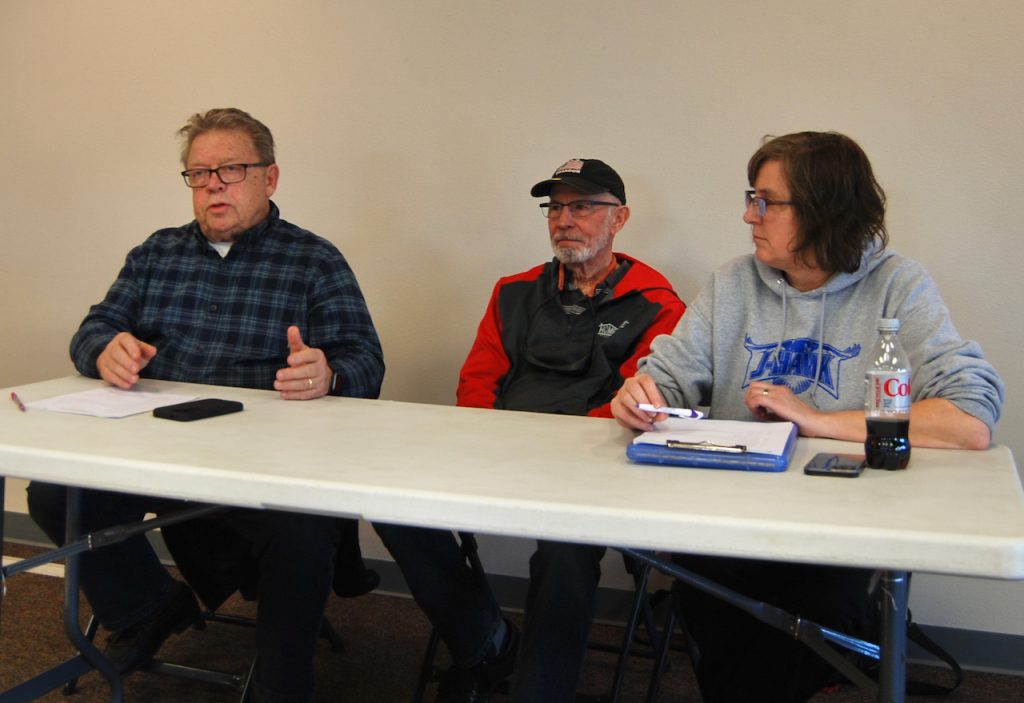
“Save the Pool” meeting organizers Jeff Knight, from left, Geoff Hale, and Cheri Zimdars offer information and field questions regarding public engagement as the Whitewater Aquatic and Fitness Center Subcommittee works through a negotiation process to create an operating and lease agreement for the facility. A fourth organizer of the Save the Pool meeting, Guy Ledwell, was not in attendance. The Whitewater Aquatic and Fitness Center Subcommittee will next meet Tuesday, April 11, at 6 p.m., at the Whitewater Municipal Building, 312 W. Whitewater St., Whitewater. The meeting is open to the public.

One of several “Save the Pool” meeting organizers, Jeff Knight addresses attendees.

Approximately 25 community members gather for the “Save the Pool” meeting held Wednesday in the Cravath Lakefront Community Building, Whitewater.
Kim McDarison photos.
ALDI Grocery Store coming to Whitewater, city officials say
(Originally published April 11, 2023.)
Whitewater city officials in a statement released Tuesday said that plans have been submitted by ALDI to bring a 20,000-square-foot grocery store to Whitewater.
According to information released by city officials, a proposed location for the store is on the city’s west side in the Hawk Bowl and Hawk Bowl Apartments buildings, 1380 and 1398 West Main St.
“The property is zoned B-1 and does not need to be rezoned. The Pinnacle Engineering Group in Brookfield, which is working on behalf of ALDI, submitted plans for a grocery store on the site on (Monday) April 10,” the release stated, adding that the developer is proposing to demolish existing structures and clean the site up, install stormwater and other utilities, and create two developable pads. The eastern pad will result in the ALDI store and, as proposed, the other developed pad on the west side will be retained by the original property owners for future development opportunities.
Offering information about process, the release noted that the city’s Plan and Architectural Review Commission (PARC) will next review the submitted site plan and make its recommendation on Monday, May 8.
According to the release, “the site plan review is the only procedural matter ALDI must go through to receive clearance to build.”
“During site plan review, members of the Plan Commission will examine the proposed building for architectural integrity,” Chris Bennett, Whitewater ’s neighborhood services director, was quoted as saying in the release, adding that the commission also will look at the plan in terms of proposed landscaping, traffic, lighting, parking, street access and other factors, to make sure they are in alignment with city ordinances.
Once the site plan receives approval from the commission, ALDI representatives will next apply for building permits, the release continued.
In addition, the release noted, city staff will work with the developer to “outline an agreement to resolve the environmental contamination (asbestos) and redevelopment of the site.”
The agreement is anticipated to come before the Whitewater Common Council for approval in May or June, the release stated.
City staff will continue to work with the developer throughout the process to ensure construction adheres to engineering and public works codes, the release stated, adding that the grocery company’s plans are available for review on the Whitewater Municipal Building’s second floor at the public works/neighborhood services counter.
“Bringing a grocery store into town is long overdue. It is exciting to see it finally happening in Whitewater. A devoted standalone grocery store will be an asset to the community,” Bennett said within the release.
Also quoted within the release, Whitewater City Manager John Weidl said: “Staff is unanimously supportive of this project for its immediate impact providing vital access to affordable food and long-term investment in the new tax base and jobs for the community.”
About ALDI
According to the release, since 1976, ALDI’s number one priority has been to deliver great quality food at the lowest possible prices. ALDI is committed to making a difference in the communities it serves by offering market-leading wages and benefits for employees, using environmentally friendly building materials and stores to promote sustainability, and giving back to the community through product and financial donations.

A graphic shared by the city of Whitewater offers a glimpse of the site plan submitted by ALDI. According to information released by city officials Tuesday, the full plan is available for viewing at the city’s municipal building, 312 W. Whitewater St., Whitewater.
Whitewater High School tech ed automotive students receive ASE certifications
(Originally published April 12, 2023.)
By Kim McDarison
Wednesday morning at the Whitewater High School was a special day for eight tech ed students taking automotive classes.
Their teacher, Justin Buntrock, said the students, all of whom had passed an examination certifying them in various aspects of automotive service and repair, were the recipients of specially purchased customized mechanic shop shirts, each sporting the name of the student, the “Whitewater automotive” program logo, and an ASE (National Institute for Automotive Service Excellence) patch.
The shirts, which were distributed to the students Wednesday morning, served as an incentive to encourage them to take the certification exams, Buntrock said.
Whitewater High School Principal Brent Mansky came up with the idea, Buntrock noted, adding that the opportunity to earn the shirts was well-received by his automotive students, who viewed them as a source of program and school pride.
The value to ASE certification
According to Buntrock, eight of his students had each taken and passed one of two exams in December.
Students in his “Automotive 1” class, including Nolan Legge, Gavan LaFlash, Nate Holden, AJ Canipe and Logan Voegeli, took and passed an exam to certify them in the service and maintenance of brakes. Taking the Automotives 1 class and passing the brake-related ASE exam were the two requirements for certification.
Students in his “Automotives 2” class, including Scotty Krebbs, Justin Johnson and Jacob Raglin, had previously taken Automotives 1, and last semester, they took and passed an ASE exam in “MLR,” or maintenance and light repair, Buntrock said, describing the exam taken by students in Automotives 2 as “more rigorous.”
Students who take the automotive classes offered at the Whitewater High School learn auto mechanics and shop-based skills, Buntrock said.
“The ASE certification is a nationally recognized certification and an industry standard for most mechanics in the industry,” Buntrock noted in a recent email.
He described the exams taken by his students as “very content heavy on theory and automotive repair skills and knowledge.”
Buntrock said he steers his students toward achieving the ASE certifications because, “it’s just a really good opportunity to get a foot in the door to start a career in the automotive field,” further describing the certifications as “a good resume builder.”
Among the students who take his classes, he said, “some will go into the workforce or will go to school for an automotive career, and the ASE certification is an almost guaranteed in.”
Still, he said, not every student who takes automotive classes is planning a career in the industry, but those who take his classes and earn certification will have opportunities to save money because they will be able to perform some of their own work on their vehicles.
“It benefits them in real-world life,” he said, adding that he likes to say: “life skills and career readiness.”
The ASE provides both, he said.
While all of his students are given an opportunity to take the ASE exams, not everyone passes them, he stated.
This year, in his Automotives 1 class, 11 students took the brakes exam and five achieved certification.
In his Automotives 2 class, six students took the MLR exam and three achieved certification.
Students can try again anytime before June, he said.
Some students are drawn to the certification opportunities because they are likely considering a career in the field or have automotive backgrounds in their families.
It’s a history that Buntrock shares.
A new automotive teacher
Buntrock joined the Whitewater High School staff at the beginning of this school year. Prior to that, he said, he served for five years as an automotive shop teacher at the Fort Atkinson High School.
He made the move because he saw an opportunity to become involved with program development, which, he said, offered some rewarding challenges, and the school had a larger automotive shop.
While serving in the School District of Fort Atkinson and in an earlier interview with Fort Atkinson Online, Buntrock said his interest in the automotive industry was nurtured by his father, whom, he said, wanted he and his brother to have self-sufficiency when it came to their vehicles.
“My old man was a mechanic for about 15 years before I was born … He taught me about mechanics,” Buntrock said in the earlier interview.
Buntrock said his brother chose a career in the automotive field, but he, after attending the University of Wisconsin-Platteville, was drawn to teaching.
As an automotive instructor, he said, he found a way to use both sets of skills.
As a teacher, he noted, he finds helping students develop a career path equally as inspiring as giving them the ability to become self-reliant.
Supporting the tech ed program
Along with supporting his students, Buntrock said he wanted to embrace an opportunity to develop tech ed programming.
Within the Whitewater Unified School District, he said, he was impressed by the level of support for the tech ed program, and for embracing opportunities brought through the ASE certification process, which, he noted, can help support his automotive classroom budget.
He made reference to the “Carl D. Perkins: Strengthening CTE (career and technical education) for the 21st Century Act,” which, according to information found on the Wisconsin Department of Public Instruction (DPI) website, was re-enacted in 2018 and set in motion in 2019 to serve as a mechanism used to establish regional pathways, increase the rigor of work-based programs, improve student performance through focused activities and support, and expand nontraditional occupations, among other goals. The federal program is grant-based and facilitated at the state level.
Buntrock described opportunities made available through the program as “substantial.”
Information about the program as presented on the DPI website is here: https://dpi.wi.gov/cte/carl-perkins.
Buntrock said his building principal saw an increase in opportunities brought by the ASE certification program and offered his support to the tech ed program through development of the customized shirts.
Additional collaboration was established at the high school when members from the school’s home economics department were tapped to sew the ASE patch onto each recipient’s shirt.
The shirts worked well as an incentivizing tool because each student saw it as school memorabilia, Buntrock said, adding that when Mansky suggested the idea, he thought it was “wild and cool.”
Growing the program
Looking at the success of the high school’s tech ed program over the last year, Buntrock said he arrived at a time of change, and while a foundation was in place, he saw room for growth.
He works within the tech ed department with fellow tech ed teacher Mason Pautsch, who joined the high school staff during the 2020-21 school year and teaches woods and construction, Buntrock noted.
As a teacher who is new in the district, Buntrock said he has spent time building relationships and rapport with his students, and he and Pautsch have worked together to grow the department into a place through which they can “give our students the best learning opportunities we can.
“We are on the right track,” he said.
Within the tech ed environment they have collectively envisioned, Buntrock said, the focus is on safety, while offering a “creative, career-oriented and life-skills-oriented area for growth.”
This year, Buntrock engaged with nearly 100 students through such course offerings as Automotives 1 and 2, Metals 1 and 2, and a class about “car care,” he said.
Next year, there will be some additional course offerings, including Advanced Auto and a class called “small engines,” among others.
As he looks toward the future of the Whitewater High School tech ed department, he said: “I’m most excited about the opportunities I know I can provide my students through the support of the administration and the district.”
Now, almost a year in, he said, he feels connected to his students.
“Everything feels good, and strong,” he said.

Whitewater High School Automotive 1 and 2 students AJ Canipe, from left, Jacob Raglin, Logan Voegeli, Nolan Legge, Nate Holden, Justin Johnson, Gavan LaFlash, Scotty Krebs, and tech ed automotive teacher Justin Buntrock gather in the automotive shop after the students receive their customized mechanic shop shirts. The shirts were presented Wednesday to eight students who in December achieved ASE certification.

Certificates, indicating that several students have passed their respective ASE exams and achieved certification, hang on a tech ed classroom wall.
Kim McDarison photos.
45 days in, UW-Whitewater chancellor offers impressions, plans
(Originally published April 16, 2023.)
By Kim McDarison
A large man with a warm smile, Chancellor Corey King wasted no time Thursday engaging with his audience as he introduced himself to members of the Greater Whitewater Committee (GWC) during the group’s monthly meeting.
Rounding the meeting table, he offered a University of Wisconsin-Whitewater refrigerator magnet to all those in attendance and a UW-Whitewater bumper sticker to anyone who was a member of the school’s alumni.
Returning to his seat, he centered his comments on the university’s condition and future, touching on such topics as the institution’s developing five-year strategic plan, challenges brought both to the UW-Whitewater and UW system by declining enrollments, and plans to further embrace concepts of inclusivity, equity and diversity, among others.
Sharing some biographical information about King, GWC member Jeff Knight noted that the 18th chancellor of UW-Whitewater has previously serviced as vice chancellor for Inclusivity and Student Affairs at UW-Green Bay; vice president for Enrollment Management and Student Financial Services at Bethune-Cookman University, Florida; vice president for Student Affairs and Enrollment Management at Florida Atlantic University, and has led the Council for Student Affairs of the State University System of Florida. King also has held leadership positions at East Carolina University, Wheeling Jesuit University, and the University of Florida.
King opened his presentation by telling committee members that Whitewater was the first place in his 30-year career in higher education where he had received such a full and warm welcome. He said he receiving flowers, candy and cards from members of the community.
The reception brought him a feeling of “genuine love,” he said.
King said he is closing on a home he has purchased in Whitewater at the end of this month.
Thursday marked his 45th day serving as the chancellor at UW-Whitewater, and in that time, he said, “a lot has gone on.” he stated that he had attended some 175 meetings and programs.
Offering some personal information, King said he liked to bake, adding that he had shared that information in an introductory email he sent to the university’s broader community. In return, he said, he received nearly 100 recipes, each with a story, adding that they brought an insightful weekend of reading.
In his role as chancellor, King enumerated his most immediate priorities, including the development of a 2023-2028 five-year strategic plan for the university, which, he said, would focus on the university’s commitment to academic excellence, with a continued goal of making UW-Whitewater a university of distinction, with further focus on “collaboration and co-curricular experiences outside of the classroom,” along with a commitment to diversity, equity and inclusivity.
In addition, he said, a goal is to focus on cultural collaboration, which, he said, would include: “talking about how we, as an institution, can move beyond our silos to really look at how we can collaborate.”
He offered his thanks to former interim Chancellor John Chenoweth, saying: “I just want to applaud him. He has been a yeoman in this process and has guided me in this transition and is now serving gracefully as our provost.”
King said Chenoweth was instrumental in guiding the university’s strategic plan, assisted by some 40-50 people whom he described as “engaged in the process, so it’s university-wide.”
King next cited the university’s commitment to diversity, equity and inclusion, saying: “The university does an incredible job in terms of our colleges, departments and offices in this space. We are just reimagining what that looks like at the university level. So, for me, when you talk about diversity, and you talk about equity and inclusion, I am reimagining the university to really try and focus on inclusivity, and inclusivity, to me, means you’re not just talking about race, and gender, and special orientations or sexual preference, we are talking about students or staff and faculty … to be a Democrat or Republican or Independent, regardless of your walk of life, to be able to share your ideas in the spirit of understanding in mutual agreement, and when I say mutual agreement, there are three ways to agree, right? No. 1: you agree to agree; No. 2: we agree to disagree, and No. 3: we agree that we need to learn more, right? We need to understand. So we want to create that type of environment and we need to have that type of conversation.”
King next talked about enrollment.
“We are challenged by our enrollment, and, again, I don’t want to minimize that we are at a stage where all of our institutions in the UW system are being challenged by enrollments,” he said.
Citing numbers developed using “Fall Semester 10th Day Enrollment” headcount, King said there has been a decline in full-time enrollments.
A chart, shared by King, showed that enrollments, beginning in the 2013-14 school year, were at 12,015, and showed gains over the years to 13,059, achieved during the 2018-19 school year, but enrollments have since dropped annually, and were calculated at 11,087 during this, the 2022-23 school year.
Looking at the declines, King said: “We have to be more assertive and more aggressive in terms of the markets in which we go after, and how we develop a program, and how we create pathways for enrollment growth, not only as traditional, but also in online services, adult learners, transfer students, these multiple pathways.”
Additionally, King said, the university needed to focus on “our freshmen and sophomore experience.”
Traditionally, a focus had been placed on the freshmen experience, but, he said, focus needed to extend into the sophomore experience as well.
“We find that students will stay once they get into their junior year and begin that capstone experience,” he said.
Finances, too, were among topics of focus, King said.
“We are facing a structural deficit, but it’s a structural budget deficit,” he said, adding, it was “not necessarily a structural expense deficit.”
Said King: “That means that we got to get in front of the budget to see where we are budgeting, and what those opportunities are. I don’t want to use the word ‘cut,’ I want to use the words ‘continuous improvement,’ because whether you have one million dollars or whether you have one dollar, you should always be spending that money efficiently and effectively. So let’s talk about continuous improvement.”
King counted “community-campus engagement” among his priorities, saying that he wanted to engage with the campus and the community “to listen, and to hear the love, the passion, the growth … for the institution.”
Citing his belief is shared governance, he said the concept was strengthened on campus through its cabinet, administrative councils, student governments, and university support and academic staff, and their participation in community boards and governance groups.
King also spoke about investments made through the identification of niche opportunities at the university’s Rock County campus. He pointed to a developing nursing program offered at the Rock County campus as an example.
Information technology also is among ideas in need of investment, he said.
“Our infrastructure, how we have a platform for technology on our campus is important. We have to make sure that our technology keeps up with the 21st Century and beyond — especially with our young students and, of course, for our faculty and staff in their work, and so, we’ve begun to now reimagine our information technology space, and think about it in terms of innovation, transformation and compliance,” he said.
Questions from GWC members
During the meeting, King fielded questions from committee members.
Knight, revisiting enrollment numbers, asked about future projections.
King said five years ago, enrollments were at approximately 12,400 students. Today, some 11,100 students are enrolled. Still, he said, other statistics indicate that the numbers are poised to increase, noting that university applications are increasing, as are applicants who are being admitted, and, he said, two “touch points,” also used as enrollment indicators, such as the number of signups for orientation programing and student housing, are both on the rise.
GWC member Larry Kachel asked if numbers could be defined in terms of undergraduate and graduate enrollments.
He said he believed undergraduates were more likely to be studying at the university in person while graduate students often used online options.
King said that of the 11,100 enrollments he spoke about earlier, approximately 9,000 represented undergraduate students and about 2,000 represented graduate students.
A committee member, citing the new nursing program offered at the Rock County campus, asked when the chancellor predicted it could be expanded.
Said King: “We are not there yet. We’ve got about 20 to 25 students who have raised their hand. Fourteen have pushed the button.”
Knight asked about a potential to engage with state legislators about securing money in the upcoming two-year state budget cycle to address proposed renovations of Winther Hall, an aging classroom building on the Whitewater campus.
Knight said he had learned that discussions had taken place among state representatives noting that the university was not yet ready to receive funding to proceed with a construction project.
“What do you know about this whole process?” he asked.
Said King: “That has been on the top of my agenda. I’m just going to be honest and authentic. We know what needs to be done.”
King described the building as in “horrible shape,” noting that students in wheelchairs “can’t get in and out of the place,” further describing students assisting fellow students in wheelchairs by carrying them out of the building when a fire alarm is activated.
King said he believed there was support among legislators for the project, which is projected to cost $80 million.
He said he believed some “miscommunication” regarding the university’s readiness to begin construction on the project has slowed the process.
Said King: “We have begun the design phase, we have the money, $2 million, for that to happen. So we are at a point now where we are ready to go to the next level in that design phase in order to have shovels in the ground by May of 2026. If we don’t get funding in this biennium, that won’t happen. It will push the project out by another two years to probably 2028. So, for us, we’ve tried to clarify the misunderstanding that we are not ready. We’re ready.”
Responding to additional questions about enrollment, King said he was excited about a new initiative called “direct admit,” which, he said, could potentially be offered to Whitewater High School students and “would remove the barriers of all of the processes to get into the institution.”
He added that discussions were planned for that same day to discuss the program with the superintendent of the Whitewater Unified School District.
Looking ahead, King said the university would be moving beyond traditional enrollments.
“We already know those numbers are going to decline,” he said, noting that other opportunities for enrollment are under development and would include building pathways for adult learners and transfer students, and an expansion of the university’s online presence.
“The focus, of course, is having the traditional students come, but with the knowledge that the number is going to decline and there’s nothing we can do about it; we’ve got to begin to think about those other pathways that speak to our enrollment and headcount,” he said.
Interview with Fort Atkinson Online
Responding to questions asked by Fort Atkinson Online, King said that he viewed the recently approved tuition hike affecting campuses across the UW system, including UW-Whitewater, as a benefit, noting that even with the modest tuition increase, UW-Whitewater remains the most affordable institution within the system.
He noted that the increase will be used to enhance the quality of education for the university’s students, making them more marketable upon their graduation from the institution. King called the increase a “win-win.”
Continuing the discussion about prioritizing increasing enrollments, and responding to questions about online learners, King said the program would be reimagined to attract adult learners, noting that the program could help alleviate barriers associated with work schedules and family obligations. These are students who may like to come back to school, but are not in a position to be in a classroom all day and every day, he said.
He said the program would be less focused on traditional students who would benefit from in-person learning and living on or off campus.
“We definitely want to continue to pipeline traditional students and bring more students in. Right now, we are on track to increase our enrollment in that space for fall 2023,” he said.
Looking more closely at the future of the Rock County campus, King said that the two campuses, Rock County and Whitewater, have a structure that is congruent.
“The leader at the Rock County campus is one of our deans of integrated study, and so that person is a part of the academic portfolio of our university and also sits on the chancellor’s cabinet. So that shows the importance of that campus to us. What we have to do, I believe, is to find it a niche: What are those unique academic programs and offerings that we can provide in that community that speaks to its growth and to whatever the market demands and all the needs?” King said, adding that recently a nursing program was identified and developed as part of the niche strategy.
“I do believe that we will find other niches as we do a self-assessment of that campus as part of our strategic plan,” he said.
Looking at financial changes on campus, and responding to questions regarding community engagement and programming, King said he was aware of challenges related to the Young Auditorium.
He said the challenge for Young Auditorium was “getting back to a robust performance, performance art schedule. I am a champion of that space. I’ve actually been to a concert and so, for me, I do agree that performing art, athletics, those types of venues are imperative to our community engagement, you know especially with our alumni, our parents, our friends, community stakeholders. I do not see our financial challenges impeding upon our continued commitment to community engagement. What I do see is we have to focus on continuous improvement, we have to focus on enrollment growth, and we have to focus on creating more pathways for revenue to continue to do what we do in alignment with our mission,” he said.
Elaborating on “direct admit,” King said the concept was a systemwide conversation, so it could one day be offered at multiple high schools, but, he said, as discussions began at the university level, looking at ways to roll the program out, there was a desire to try a pilot program.
King said the university has traditionally and continues to draw many of its students from the northern Illinois and Milwaukee markets.
He said students who grow up in Milwaukee are often looking for a new experience when it comes time for college. Whitewater offers the advantage of being “out of town,” but still close enough to stay connected to family.
“I believe we just have to be more assertive and more intrusive in terms of sharing the value of a UW-Whitewater education.”
King said that might entail billboard advertising and even a Whitewater bus.
Additionally, he said, the university will embrace marketing efforts to appeal to students in Whitewater and the surrounding region.
Whether a student is looking for a new experience away from home, or would like to stay nearby, but live on their own, King said Whitewater offers a quality education with a “great on-campus experience,” and, he said, “a lot of our housing and apartments that are off campus are literally right next door.”
King said the majority of the students at UW-Whitewater live off campus. He said nearly 4,000 live on campus, leaving some 7,000 to 8,000 students who commute. The number includes students living off campus in the city of Whitewater.
“The way the campus is set up, the community and the campus are one. For me, you can go two steps to the left, right, up or down, and you step into the community. And so there is this integration that you, to a point, this is my opinion, to a point that you really almost can’t tell the difference between where the university stops or begins, and I like that,” King said.
Offering some information about himself, King said he is a native of Florida. He said he chose to pursue a career path that led him to Wisconsin for two reasons: the weather and the Wisconsin Idea.
King described summers in Florida as too hot and humid for his liking. He likes the walkability of Wisconsin in the warm-weather months, he said.
Describing the Wisconsin Idea, he said, “That idea is that colleges and universities in the UW system, one of our primary missions is to be an impact, problem solver, critical thinker to our communities and our region. And the fact that UW-Whitewater has a half a billion dollar economic impact — $500 million of economic impact to the community — that speaks volumes to our mission and who we are as an institution. I mean the fact that we are the largest producer of teachers in the state, speaks to that, and 82% of our graduates in that space stay in Wisconsin. Fifty percent of them not only stay in Wisconsin but they work in rural areas, which is important to who we are and our mission. We have the number one college of business in the state; we have faculty members who are experts in their content disciplinary fields, and the best part, I tell you, we have a large majority of faculty and staff who are alumni of the institution, so there’s a genuine love for this place, and commitment to this place, that’s beyond — for many of them, it’s not a job, it’s a way of life — and I love it.”
King said as a young man, he wanted to be a professional football player, and not for love of the game, he said, but because he wanted to make a million dollars.
“That was the name of the game,” he said, but, he noted, “I had a couple of mentors along the way who really guided me to say, money is important, but at the end of the day, how do you feel about what you’ve done that day?”
While he realized a career in education might not bring him monetary riches, he found riches, he said, “in terms of the intrinsic values and the feelings and the impact that I have, I go home satisfied.”
Looking at the work ahead, King said it was important to him that he is able to help students find holistic growth and upward social mobility.
“We want to make sure that when they depart, they have opportunities that their parents and grandparents didn’t have,” he said.
A first-generation college student, King said he grew up in “a poor home.”
After he graduated and started his own family, he was able to help his mother.
“I was able to pay her utility bill because of social mobility, because of going to college and the opportunities that my parents did not have, that I was afforded, and so I was able — and we want our students to do it as well — I was able to reach back and bring forward,” he said.
As a third goal, King said: “I want to create an environment for the university that talks to inclusivity. We have to be a place where we are sharing freedom of ideas, expressions, opinions, listening to each other, and either agreeing to agree, agreeing to disagree, or agreeing that we both need to learn more in that space.”
Additionally, King, who is the father of two adult-aged children, said he loves to bake and play golf, and described himself as a man of strong faith.
“And I do believe in giving back,” he said.
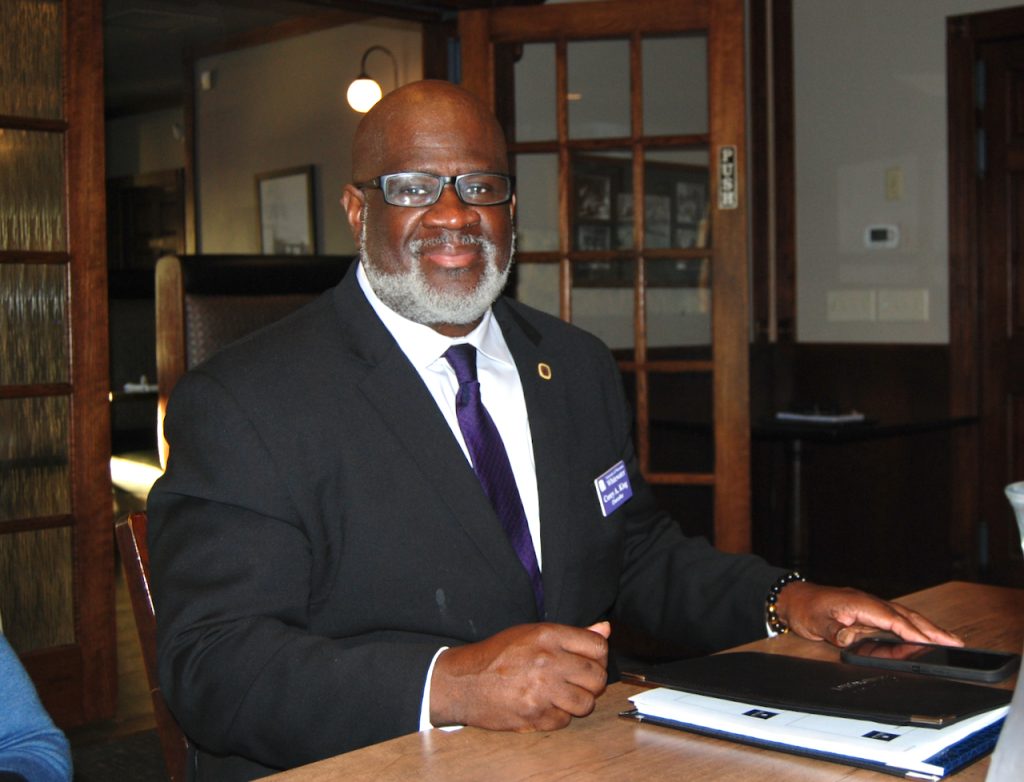
University of Wisconsin-Whitewater’s 18th Chancellor Corey King prepares Thursday to address members of the Greater Whitewater Committee. Kim McDarison photo.
Iron to art
(Originally published April 17, 2023.)
By Kim McDarison
Some 20 people gathered Saturday at the Wisconsin Makers building in Whitewater to watch an annual event: a team of iron workers clad in protective clothing and face shields turning iron into art.
The event, known to its regular participants as “the iron pour,” is in its sixth year at the Wisconsin Makers building and in its second as a memorial to the late Pete Spangler, a former Fort Atkinson resident and a founding member of the nonprofit makers group in Whitewater.
Al Jewer, president of Wisconsin Makers, Inc., said the day began Saturday morning as pour participants arrived to purchase and make scratch block molds. The sand-based 5- by 5-inch blocks are soft enough to received a hand-scratched design, but strong enough to contain molten iron until it solidifies into a tile. The blocks are next broken apart and the tile is set aside to cool. The process completes when a member of the pour team smooths away rough edges with a wire brush and presents the tile to its artist.
On Saturday, the pour team estimated it filled with iron some 25 scratch blocks and six molds brought by members of the team.
Led by University of Wisconsin-Whitewater Art Department metal studio instructor and co-owner of Wisconsin-based Cowyard Studio Teresa “Tree” Lind, this year’s five-member team was composed of Mary Abbott, a volunteer agent who serves in the sculpture studio at UW-Whitewater, alumnae Taylor McDarison and Bee Krueger, and Gregory Brulla, a seasoned pour team member and friend of Lind’s. All of the members of this year’s pour crew have assembled as team members at previously held Whitewater pours.
As the team worked to transport molten iron from the furnace to the molds, eager artists and spectators photographed the process and enjoyed brats and snacks which were made available for purchase by the makers group.
Jewer explained that proceeds from the event would be used to fund the group’s ongoing projects, such as a free art class offered each Thursday to members of the community.
The group also is actively seeking new members, he said. Those who join the Wisconsin Makers group have access to the building’s full array of shops and equipment, ranging from woodworking, to weaving, to 3D printing, Jewer said.
During the event, Lind shared with the assembled group some information about the iron pouring process. Lind noted that “Dorito-sized” pieces of iron are loaded into a specialized furnace called a cupola. When loading the cupola, she said, the ideal recipe is about 20 pounds of iron layered with three pounds of coke, a specialized porous coal-based compound with a high carbon content and few impurities. The material is used to help the cupola burn at a high temperature without transferring impurities into the molten iron.
When ready, the molten iron is transported by a two-man team using a device called a crucible. Iron that is poured into molds is kept free of slag by a third crew member using a device called a skimmer. Slag is a term for impurities created by iron, coke and fluxing agents that pool on top of the molten iron.
This year, Jewer said, he was impressed by the designs artists scratched into their blocks, with some, including his son, Willy, experimenting with laser engraving tools.
One artist made his design using a CNC or computer numerical controlled router, he said.
Pour participants crafted a broad array of designs. Isabella Valdez, a college student from Albuquerque, N. Mex., said her design included a “schwa” which, she said, is the phoneme for the letter “A.” She arrived at the pour with Madison resident Kyle Mayer. He made a spider, he said.
Beloit resident and the director of Studio 84 in Whitewater Ben Kelly said he made a design that incorporated the initial of his last name with the year in which he purchased his home.
Another artist, Bill Brulla, said he did not make a tile. He is a participant in the Thursday art class offered at the makers building, he said, adding that he came to see what the pour was all about and work on his drawing skills.
After watching the team work, Brulla said it was “amazing to think about what they are doing. It’s a technique that people used to do, but you don’t hear about it anymore.”
Jewer said discovery, curiosity and experimentation is what the Wisconsin Makers group is all about.
During the COVID-19 pandemic shutdown the group lost a lot of its members, he said. Since then, membership has begun to rebound. The building also has been reconfigured to engage makers with multiple inviting and well-equipped work spaces.
Jewer said that while the annual iron pour had over the years become a treasured tradition, with Spangler’s passing, it has gained a deeper significance.
“It was Pete’s favorite event,” he said, adding that last year, when he died, “he just barely missed that one. He would have been thrilled to know that it has continued on and is gaining strength,” he said
An earlier story about Wisconsin Makers, Inc., Spangler’s contributions to the nonprofit organization and the annual iron pour is here: https://fortatkinsononline.com/pouring-iron-whitewaters-wisconsin-makers-group-to-host-tile-making-event/.
Photos from the event follow.
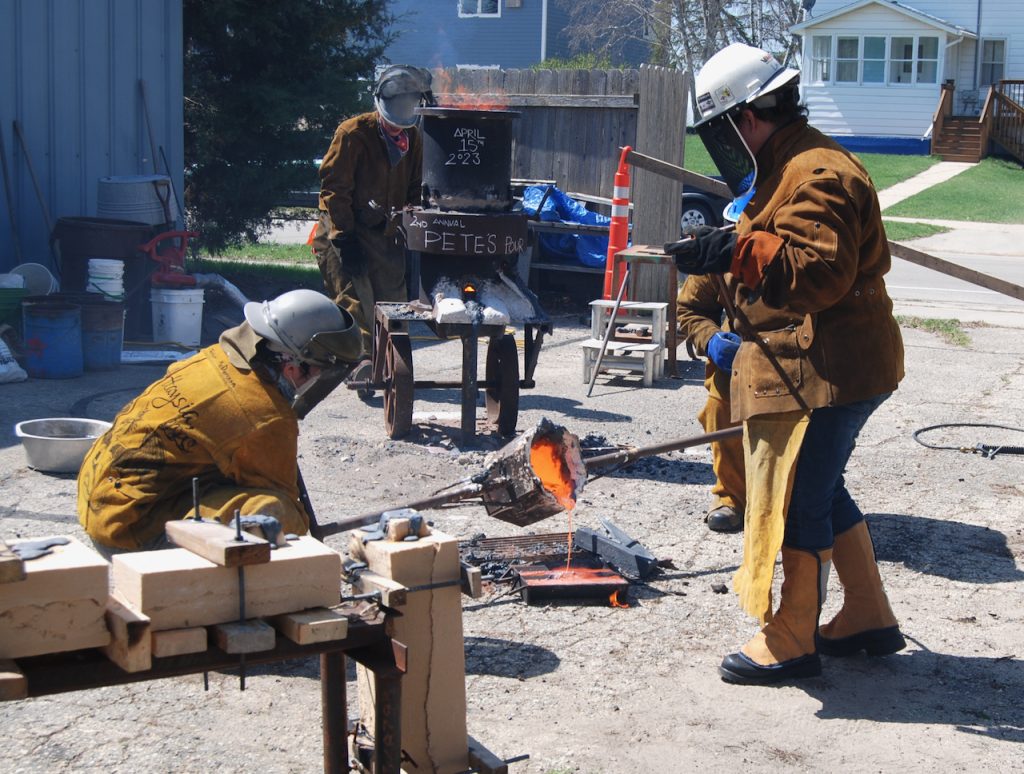
Taylor McDarison, from left, Gregory Brulla. Bee Krueger and Mary Abbott work together as a team to make and pour molten iron into a mold.
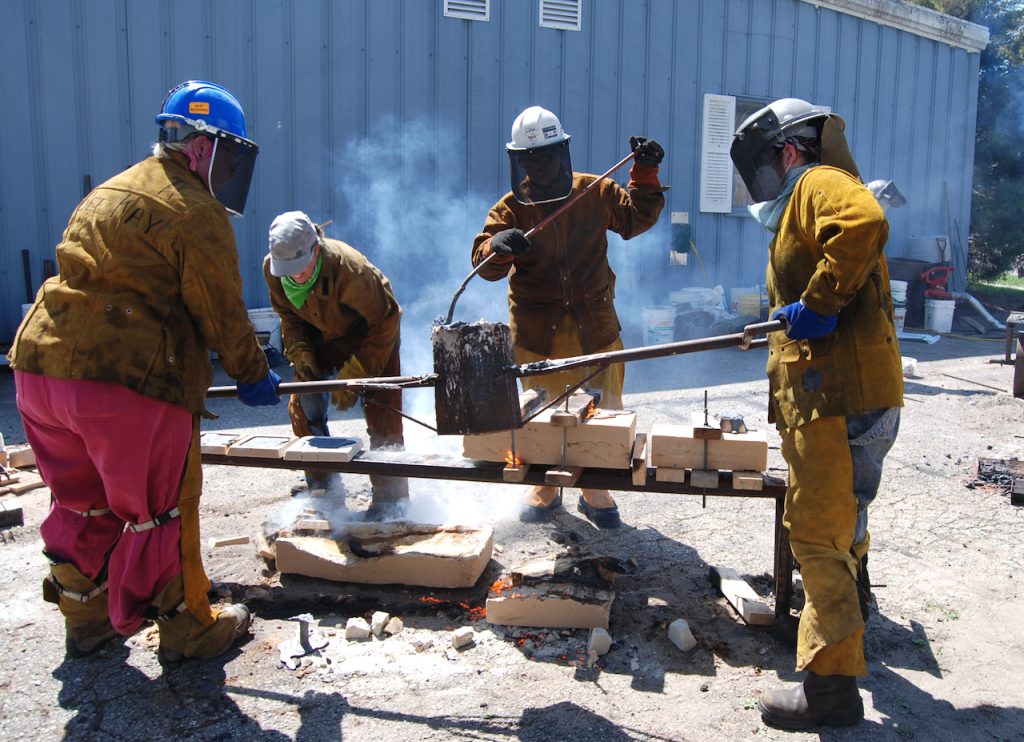
Bee Krueger, at left, and Taylor McDarison, at right, maneuver a crucible filled with molten iron. Mary Abbott, at center, assists with a skimmer. Pour team leader Theresa Lind removes scratch block molds that have already been poured.

University of Wisconsin-Whitewater Art Department metal studio instructor and co-owner of Wisconsin-based Cowyard Studio Teresa “Tree” Lind shares with event-goers the process used to melt and pour iron.
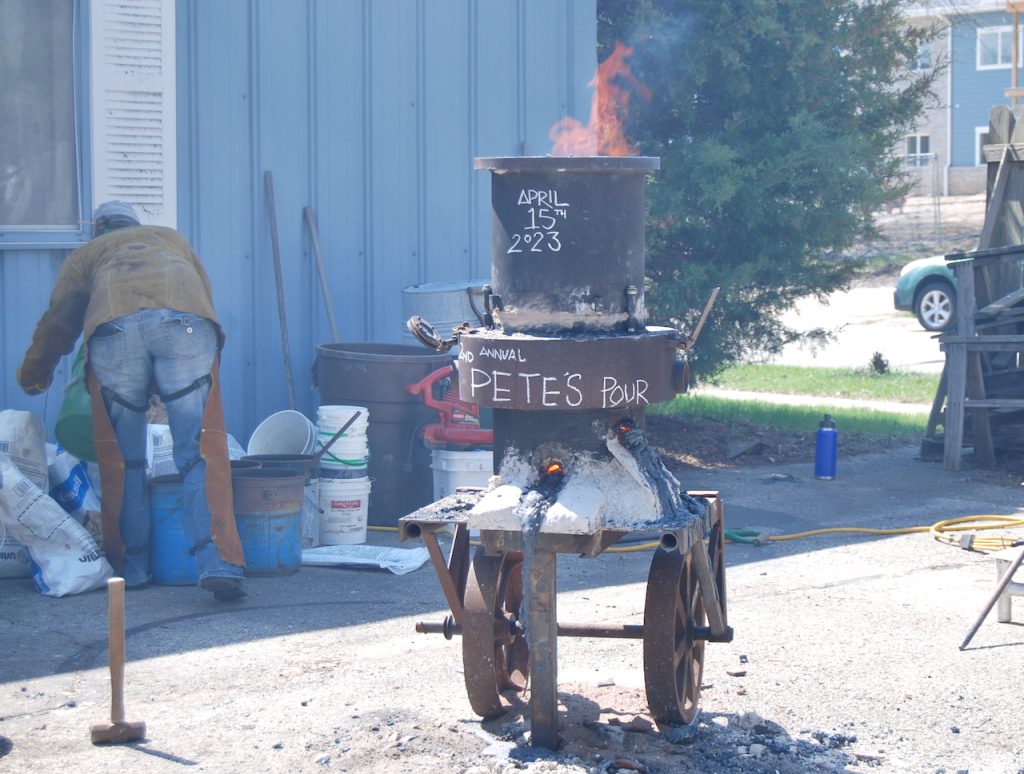
A cupola, a special furnace used to melt iron, is layered with pieces of iron and a porous coal-based compound called coke. The coke helps the furnace burn hot enough to melt the iron. The cupola bore the words “Pete’s Pour,” Saturday in recognition of the second annual memorial pour in remembrance of the late Pete Spangler, a Fort Atkinson resident who was among founders of the Wisconsin Makers, Inc., in Whitewater.

Iron tiles are broken free from their molds and left on a rack to cool.
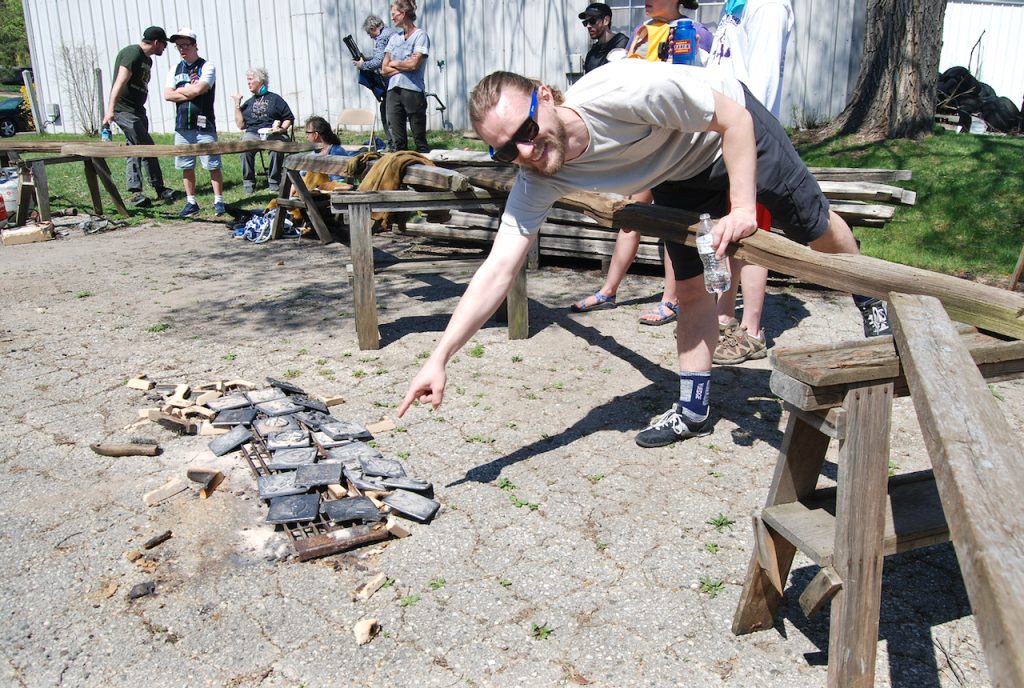
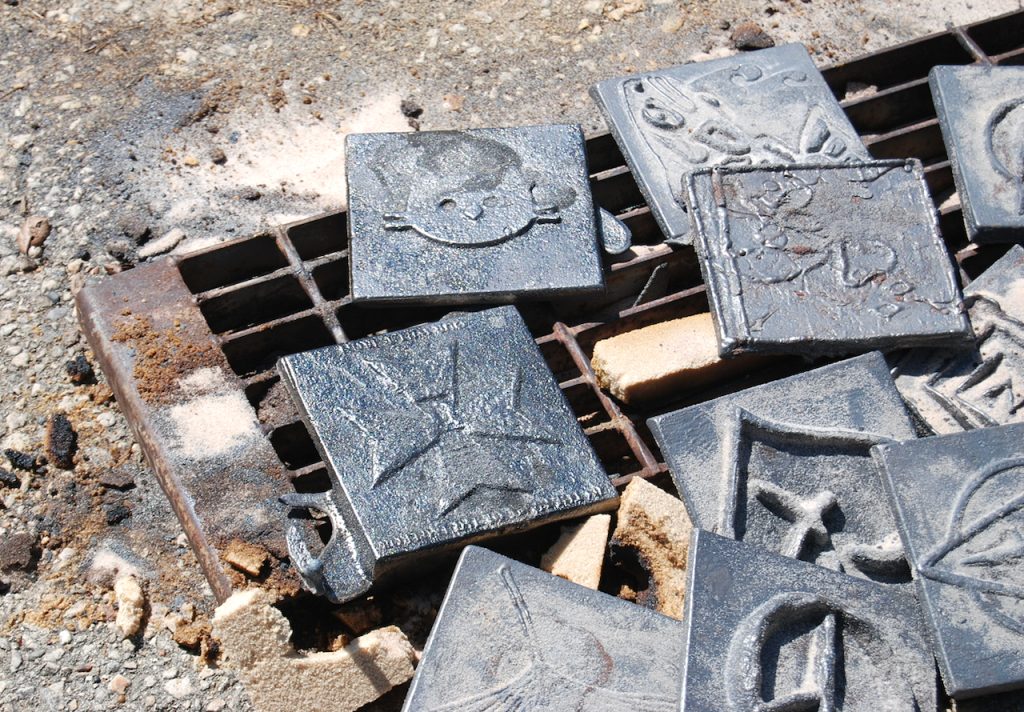
Two photos above: At top, iron pour participant Willy Jewer, Madison, points to his tile as it cools; above, Jewer’s tile, shown center left, carries a symbol from a tabletop game called Warhammer 40,000. Jewer said he used a laser engraving tool, an X-Acto blade and a screwdriver to etch his design into his sand block mold.
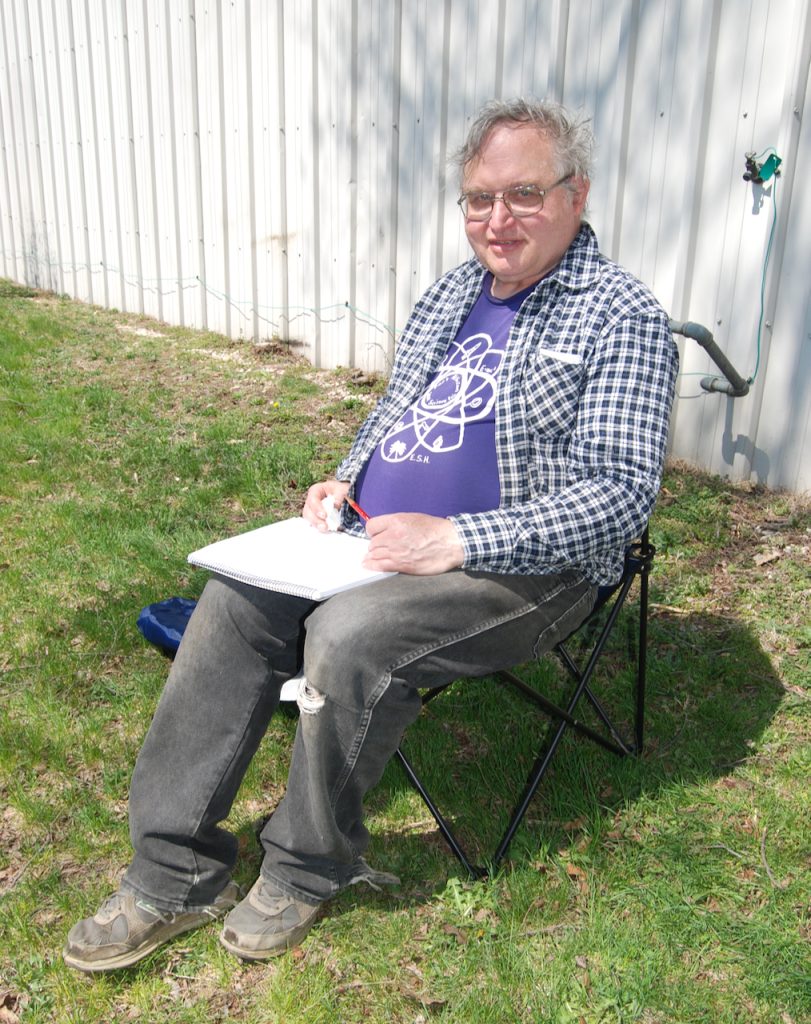
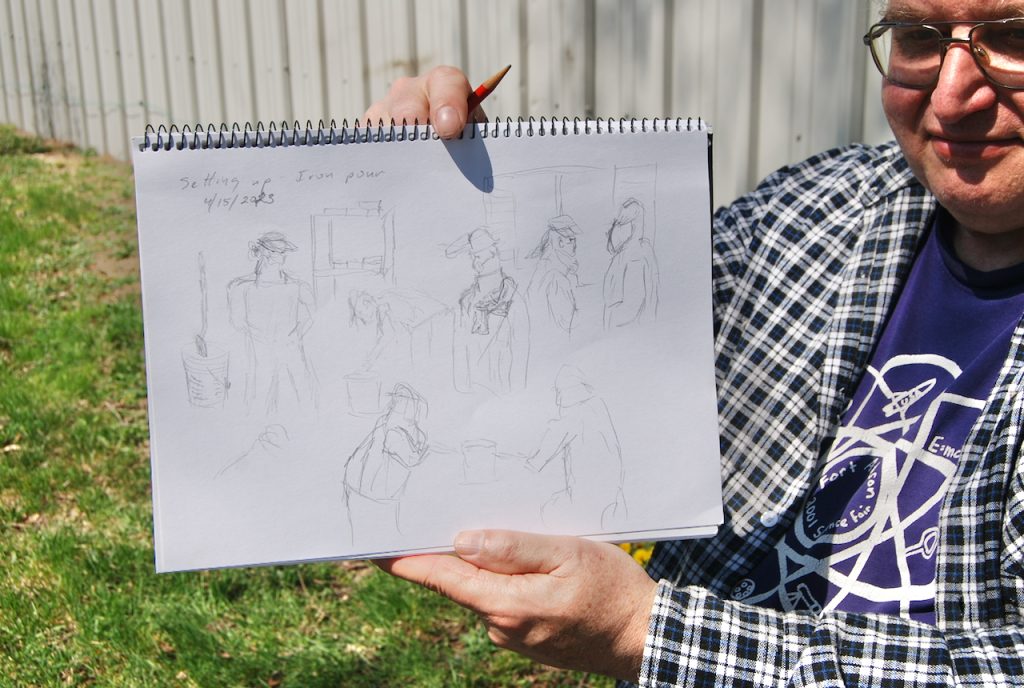
Two photos above: At top, Fort Atkinson resident Bill Brulla sketches iron pour team members Saturday. Brulla said that while he did not make a tile, he was interested to watch the pour and practice his drawing techniques. He is a participate during the drawing classes held at the Wisconsin Makers building each Thursday; above, Brulla displays his sketches.

Wisconsin Makers, Inc., President Al Jewer, at left, enjoys the weather while Wisconsin Makers member Kent Taylor serves brats to a patron. Taylor’s friend, Denise Truitt, not pictured, helped cook the brats. All three individuals are from Milton.
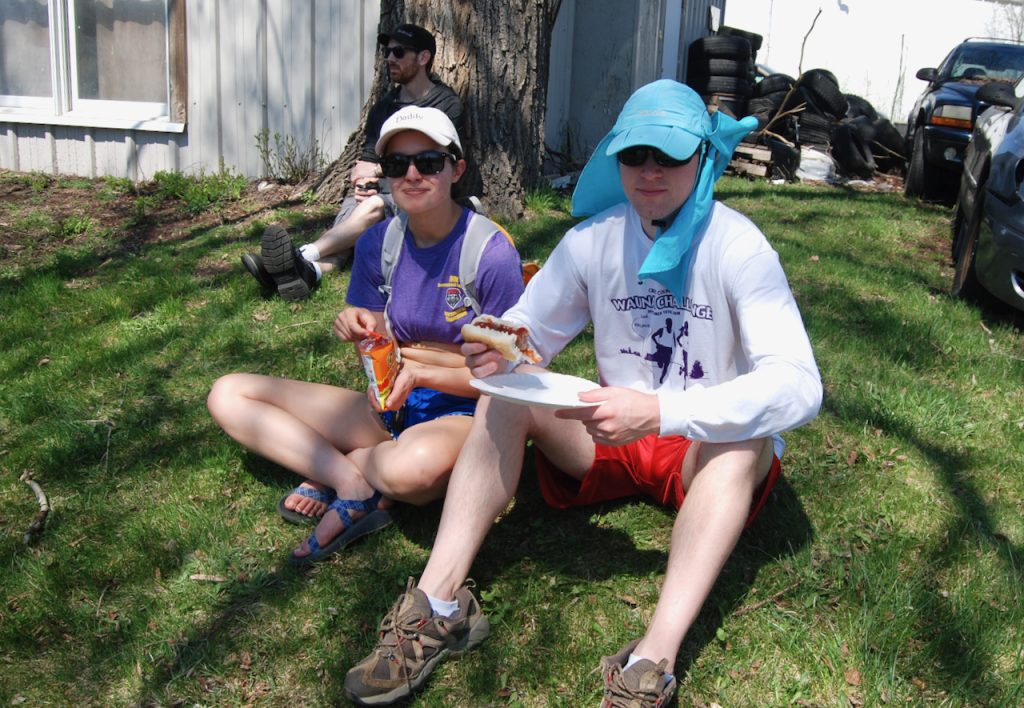
Isabella Valdez, a student from Albuquerque, N. Mex., and Kyle Mayer, Madison, enjoy a snack while they wait for their scratch block mold tiles to cool. Valdez made a “schwa” which, she said is the phoneme for the letter “A.” Mayer said he made a spider.
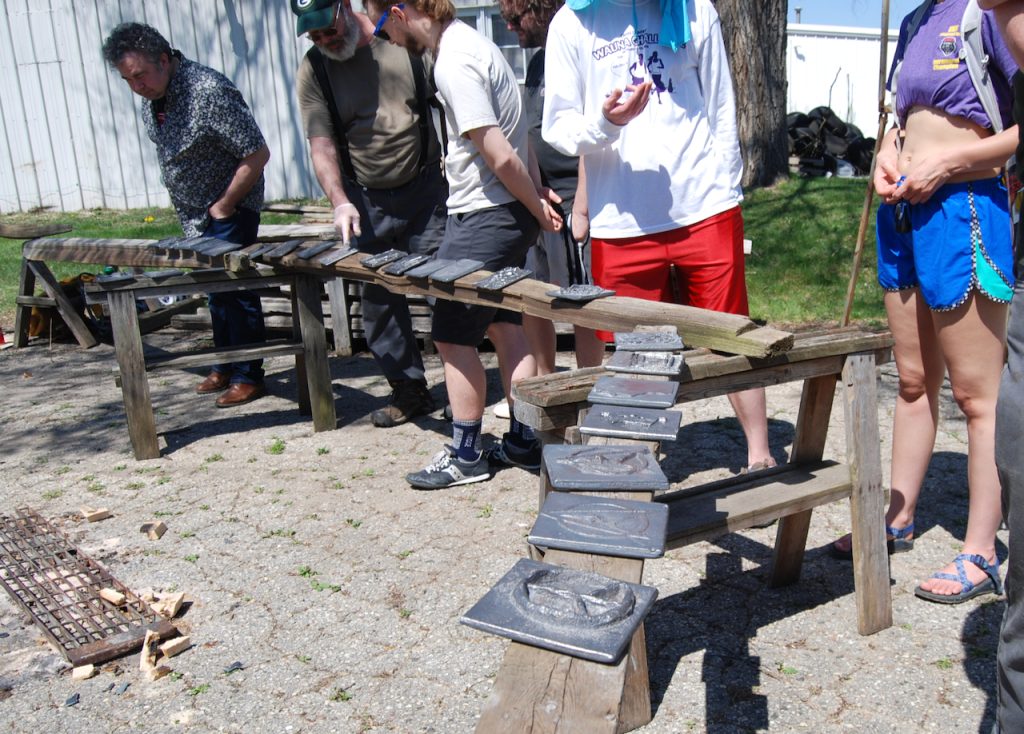
Cooled and wire-brushed tiles are made available to their owners.
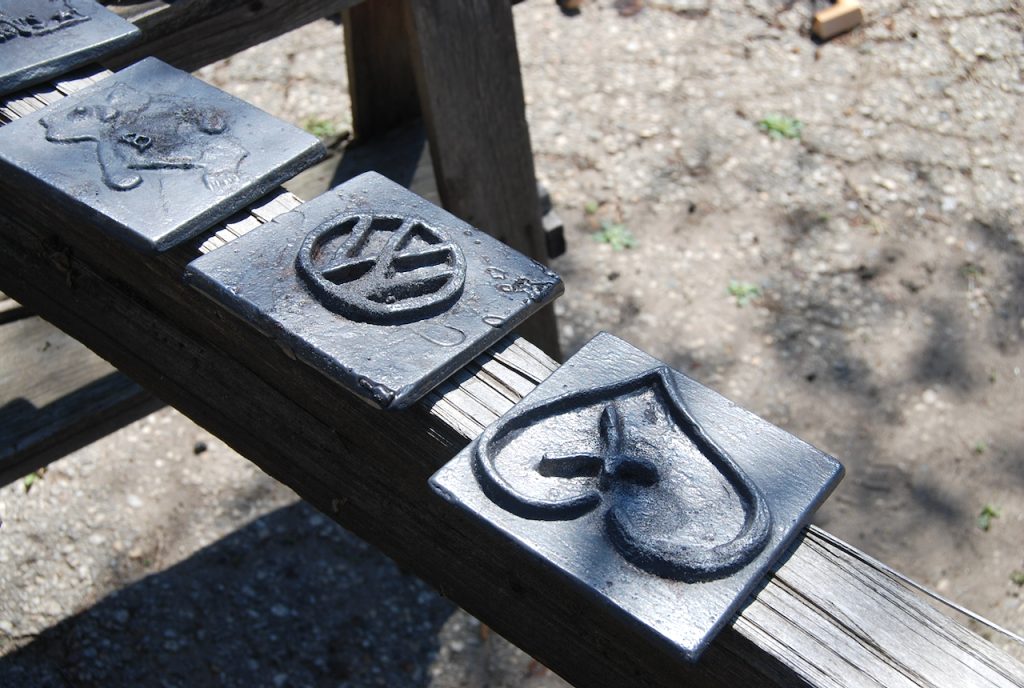
Tiles sport symbols and designs turning iron into art.

Iron pour crew member Gregory Brulla, at left, presents Beloit resident and director of Studio 84 in Whitewater Ben Kelly with his tile.
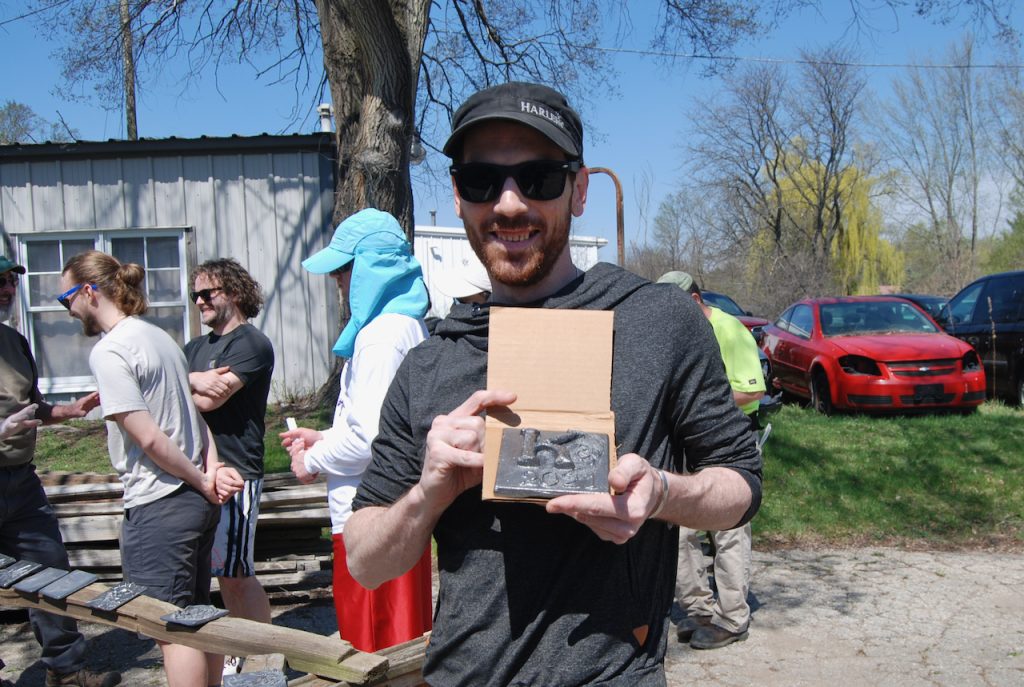
Beloit resident Ben Kelly displays his tile. The design incorporates the initial of his last name and the year in which he purchased his home, he said.
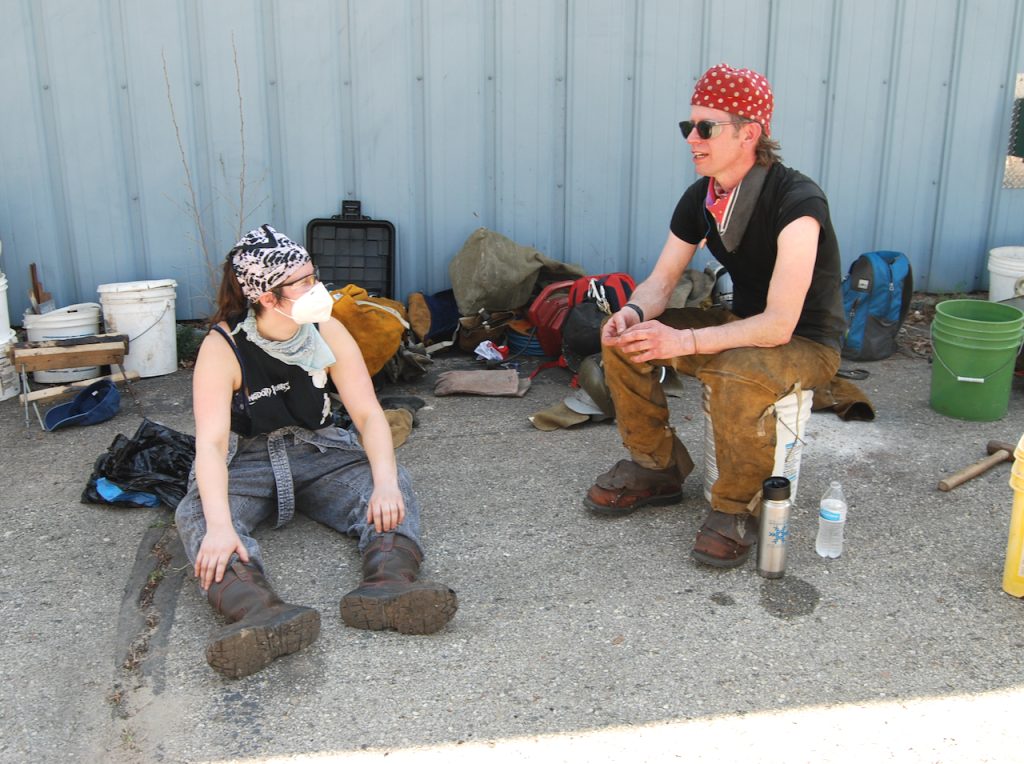
Pour team members Taylor McDarison, at left, and Gregory Brulla take a break while they wait for scratch block mold tiles to cool.

A 3D scanner is on display inside the Wisconsin Makers building. The device is one of many available for use by Wisconsin Makers, Inc., members.
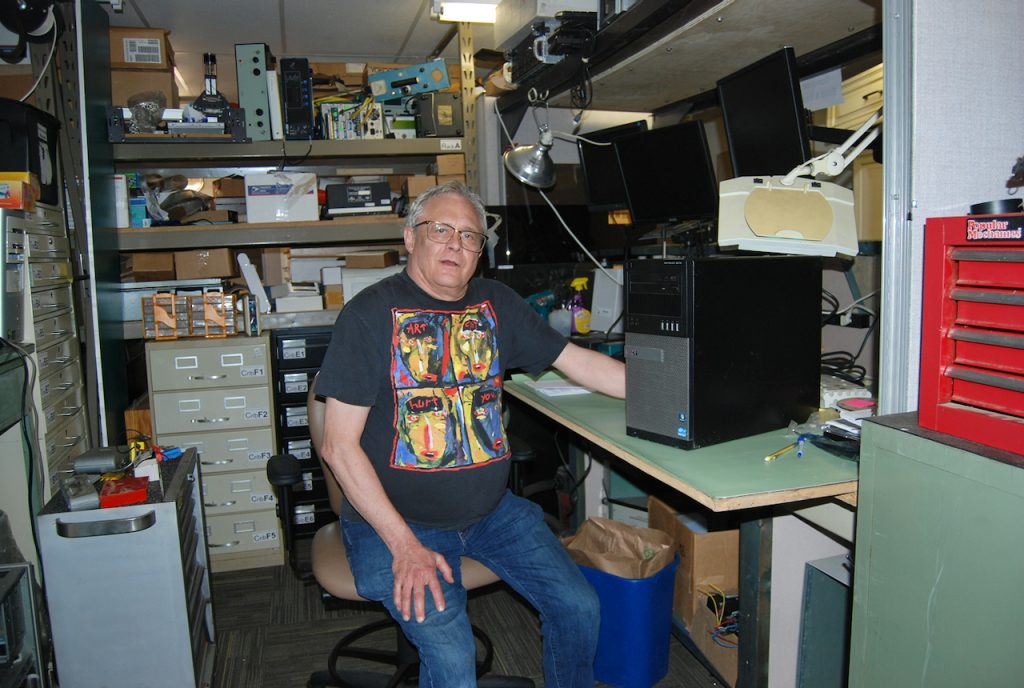
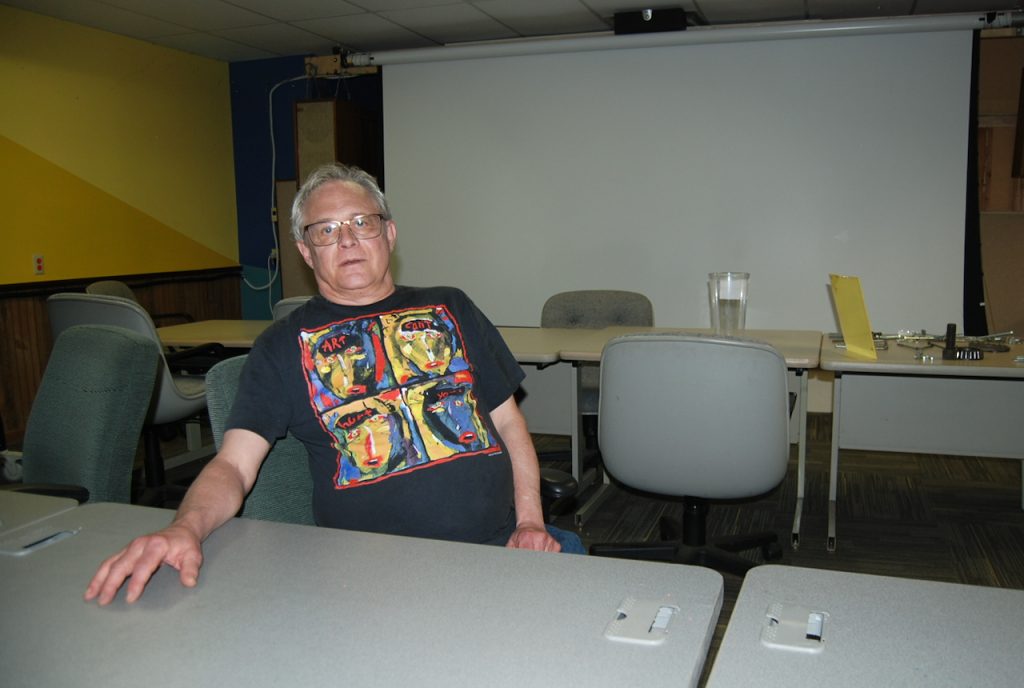
Two photos above: Al Jewer, president of Wisconsin Makers, Inc., offers a tour of several spaces inside the makers building, including the computer space, shown at top, which is adjacent to the electronics area, and a large gathering space, shown above, used by participants in an art class which meets each Thursday. Other spaces within the building include the woodworking area, machine shop, a textile space complete with looms for weaving, and a space which houses four 3D printers and a resin printer. To learn more about Wisconsin Makers, Inc., its equipment and membership, visit its Facebook page: https://www.facebook.com/wisconsinmakers/.
Kim McDarison photos.
Starbucks proposes plans to build in Whitewater, city officials say
(Originally published April 19, 2023.)
Starbucks may soon come to Whitewater, according to Whitewater city officials.
Information released to the media Wednesday indicates that the company has submitted its plans to build a coffee shop, including drive-through access, on the city’s west side.
According to information released by the city, plans call for an existing Quick Lube building, 1280 W. Main St., to be razed, leaving space for Fond Du Lac-based Excel Engineering, to construct the new coffee shop.
Within their release, city officials described “next steps” to bring the project to fruition, including a review of the submitted site plan, along with a request for a conditional use permit, both of which are anticipated to be brought before the city’s Plan and Architectural Review Commission in May.
The proposed site is zoned B-1 and will require a conditional use permit to accommodate the drive-through feature, the release noted.
As outlined within the release, during the site plan review process, members of the Plan Commission will examine the proposed building for architectural integrity and ensure that landscaping, traffic, lighting, parking, street access and other factors are in accordance with city ordinances. Additionally, the commission will consider other aspects of the project, including investments made to avoid potential nuisance complaints, and make confirmations that the project is in alignment with the city’s comprehensive plan.
“Notwithstanding the technical and legislative details of the site approval and conditional use approval process, this redevelopment opportunity represents another concrete, positive step forward for this community,” City Manager John Weidl was quoted as saying in the release.
Wield said investments within the community help to attract others who also might like to invest.
“The city will continue to support and, where possible, invest in opportunities that create housing, jobs, and bring new businesses to the city. Starbucks is a welcome addition to that tapestry,” he stated within the release.

A graphic prepared by city officials offers a glimpse of a site plan proposed by Starbucks for Whitewater’s west side. The site plan is anticipated to come before the city’s Plan Commission in May.
Whitewater: Committee returns ‘hate bias’ form to staff seeking further recommendations
(Originally published April 22, 2023.)
By Kim McDarison
Members of the Whitewater Equal Opportunities Commission, meeting virtually Monday, April 3, opted to return a proposed “hate bias form” and its associated procedure to city staff for further recommendations.
The proposal is anticipated to appear on the commission’s next agenda, commission chairwoman and Whitewater Common Council member Brienne Brown told Fort Atkinson Online recently.
Responding to questions by phone, Brown said commission members did not vote on the proposal following a suggestion made by then-commissioner and Common Council member Jill Gerber, who said she thought that a final recommendation to council from the commission would best come after any new commission and council members were seated, pending the outcome of the April 4 election.
Information provided within a memo from City Manager John Weidl offered a recommendation from city staff that the form and process not receive approval from the commission for recommendation to council, citing a lack of expertise held by city staff to make findings regarding hate bias complaints.
In his memo, Weidl wrote: “We do not believe our city non-police staff has the expertise to investigate and make findings and decisions on these types of complaints. This process could include interpreting complex statutes and codes, and apply them to facts, and also involve other difficult analysis and decisions.”
Would city staff make a “violation” finding, he noted, it “could have a serious effect on an individual’s reputation and employment opportunities.”
He cited a need for “due process” in such matters, which, he wrote, “should include a hearing type opportunity which would require notice and the right to be heard. This is often like a judicial trial proceeding.”
He stated that the proposed draft before the commission lacked “the type of specific process that would be needed to provide this due process.”
Brown said that during the meeting, the commission, following Weidl’s recommendation, requested that the form and process be returned to staff to develop further recommendations, and asked that both items be returned before the commission on a future agenda.
According to Brown, staff was asked to pursue the assemblage of helpful documents that could be made available to people who felt they may have been wronged, answering such questions as: Who do they go to next?
Prior to April 18, along with Brown, members serving on the commission included: Gerber, Maryann Zimmerman and Terilyn Robles. Each of the members represent a faction of the community, Brown said, adding that she and Gerber (prior to April 18) are council representatives, Zimmerman is a citizen member, according to the city’s website, and Robles represents the Whitewater Unified School District.
On Tuesday, April 18, following the installment of new council members who were elected April 4, council appointed two representatives to the commission. They are: Brown and councilman Lukas Schreiber, who replaced Gerber on the commission. Gerber continues in her role as common council member.
Information on the city’s website notes that the commission was formed to “improve the quality of life in Whitewater by the elimination of racism and other forms of discrimination in the Whitewater community.”
The commission is composed of “five or six citizen members” and “one or two common council members,” the website states. To date, three citizen member seats remain unfilled.
The commission meets virtually on the first Monday of each month at 5 p.m., as stated on the city’s website.
Offering some history, Brown said that the proposal to create a form and process to address hate bias complaints was initiated by former Whitewater Police Chief Aaron Raap, who asked the commission to consider the proposal following what Brown described as several Black Lives Matter protests which had occurred within the city. Those engaged with Black Lives Matter shared concerns which alleged that the Whitewater Police Department was unfairly targeting Black individuals who may have been college students or visiting the area from Milwaukee, she said.
Brown said the form and process were proposed by Raap and considered by the commission as a means by which to show the community that officials were understanding of concerns brought by citizens.
“We wanted to show that we were listening,” she said.
As the commission considered the matter, she said, commissioners determined that the proposal was developed following incidences that were alleged to have occurred “four years ago.”
Since then, Brown said, the police department had undergone training and she believed such concerns were “not a problem now.”
“This has gone through a modification process and it came from some students at the university and Chief Raap,” Brown said.
Raap, who was hired by the city as its police chief in 2018, resigned and retired from his position in June of last year.
Dan Meyer was named Whitewater police chief in August, 2022.

Whitewater Municipal Building, file photo/Kim McDarison.
Aquatic center subcommittee considers $5 million in improvements; non-binding referendum
(Originally published April 23, 2023.)
By Kim McDarison
The Whitewater Aquatic and Fitness Center Subcommittee held its second meeting, Tuesday, April 11, during which each entity that comprises the group — the city of Whitewater and the Whitewater Unified School District — offered considerations from which a contractual negotiation between them might mutually be forged.
A previous contract between the two entities lapsed in 2021.
April 11 marked the second meeting of the subcommittee. A first meeting was held in March.
Among items discussed this month was a report compiled by J.P. Cullen in February at the school district’s request, enumerating some $5 million worth of facility and equipment improvements which, according to school district subcommittee representatives, could be completed within the next five years.
In addition, representatives from the school district expressed a desire to bring costs — including those associated with an existing shortfall, annual operational expenditures, and any agreed upon capital improvements — before its electorate through use of a non-binding referendum question, citing a need to raise taxes to meet any expenses for which it might become responsible, regarding a contractual agreement with the city.
Subcommittee members discussed the potential opportunities for ballot placement of a referendum question, with Whitewater City Manager John Weidl noting that the soonest opportunity would be presented in April of next year.
City council subcommittee representatives expressed a desire to see a lease and operational agreement between the two entities signed sooner, perhaps, subcommittee member Jim Allen said, as early as this fall.
No formal action was taken during the meeting. Instead subcommittee members discussed the capital improvements document as developed by J.P. Cullen and presented by the school district, and identified information needed to continue the process during their next meeting scheduled for May 11.
School district subcommittee representative Larry Kachel was not in attendance during the April meeting.
In an interview with Fort Atkinson Online, Kachel noted that he had resigned his seat on the subcommittee, citing his strong support for the aquatic center, which, he said, could potentially influence his ability to negotiate on the district’s behalf.
School board member Miguel Aranda served as a subcommittee representative during the April meeting.
Also during the meeting, school district Superintendent Caroline Pate-Hefty said that on Monday, the district’s board of education will meet, install new board members and assign committee placements.
School board President Thayer Coburn, who is a member of the subcommittee, did not win reelection in April. His seat on the subcommittee is among those that will be reassigned.
On Tuesday, April 18, newly elected Whitewater Common Council members took the oath of office. Council members each were assigned committee responsibilities, however changes to the subcommittee were not discussed. Subcommittee representatives from the city are Lisa Dawsey Smith, Jill Gerber and Allen who serves as committee chairman. Allen also was elected city council president during Tuesday’s common council meeting.
Increases in annual operational commitments, deficit
Negotiations during the April 11 subcommittee meeting began with language identified by Coburn within the aquatic center’s 2016 contract, which expired in 2021, and was the last one signed by both parties.
During the subcommittee’s March meeting, city officials made two presentations, including a history and overview of the operations and finances of the aquatic center facility.
Within a financial presentation, the city’s Finance Director Steve Hatton noted that in 2022, the city had continued to pay operational expenses even as the facility operated at a revenue loss of $11,598. He cited the COVID shutdown as a contributing factor in revenue losses.
Additionally, the city’s Parks and Recreation Director Eric Boettcher said that over a seven-year period, between 2016 and 2022, the city had made improvements to the center coming at a cost of $395,613.
Boettcher said contributions made by both entities over the years had increased.
Between the time that the facility opened, in 2001, and 2016, he said, each entity, the school district and the city, paid an annual fixed amount of $75,000 toward the functions of the facility.
Beginning in the summer of 2016, he noted, payments from both entities increased to $128,000, with $78,000 spent on operational expenses and $50,000 earmarked to fund capital expenditures.
In 2021, Boettcher noted, with the city and the district being equally responsible for any shortfalls in revenue, the annual support increased by $50,000, for an annual total payment provided by each entity of $178,000.
Hatton said a “mismatched” timing in payments, which each entity was responsible to share, beginning in 2021, began to differentiate and show a shortfall, creating an operating deficit.
The mismatch, both groups agreed, was created by a difference in each entity’s fiscal year.
While the city operates fiscally on a calendar year, the school district’s fiscal year runs from July through June.
According to Hatton, and as shared with the group in March, contributions “weren’t equally paced any longer” and “at the close of 2021, … the acquired deficit since 2016 is $413,000. Once you add the 2022 deficit, we are talking $425,000 on a combined basis,” he said.
Following a shared approach, each entity is responsible for half of the identified deficit.
A story about the first subcommittee meeting, including a breakdown of operating costs and capital expenditures, as provided by the city, is here: https://fortatkinsononline.com/whitewater-aquatic-center-subcommittee-discusses-operations-finances/.
During the April 11 meeting, Coburn noted that there had been discussions within the community that the school district was delinquent regarding its contractual payments.
He said that while the agreement signed between the two entities in 2016 had offered discussion about contributions, it did not address the increases. A subsequent contract between the two entities was never signed.
In the draft contract, dated 2021, the two entities were responsible for splitting expenses, with the school district paying $145,500 for the period of July 1, 2021, to June 30, 2022, and $170,500 for the period of July 1, 2022 to June 30, 2023, and each remaining fiscal year covered by the agreement, and the city was responsible for contributions in the amount of $153,000 for the 2021 calendar year, and $178,000 for each remaining year of the contract.
“So the difference there is just because the district’s fiscal year is July through June,” Coburn said, further noting that the contract stipulated that the amounts contributed by each party could be adjusted on an annual basis if mutually agreed upon by the parties.
Coburn said that over the course of the last three years, he was unaware of the district receiving a specific request for money associated with shortfalls.
Coburn said that in 2016, the district signed a contract making it responsible for half of the shortfall, and while he said he was not philosophically in agreement that the district should be responsible for operational shortfalls, because, he said, it was not involved with day-to-day operations, it was the contract the district signed, and therefore the one by which it should abide, he noted.
“But there needs to be some kind of mechanism for that payment to happen,” he said, adding: “I would recommend, going forward, that there would be some kind of mechanism to ensure that that payment actually does happen and that we don’t get into the situation where the district is considered to be in the arrears or delinquent.”
Hatton said discussions about payments with the district regarding the developing shortfalls were held with previous school district administrations who expressed an interest in covering the shortfalls, which, he said, were accumulated year to year, by making “higher payments and contributions in the future versus a catchup payment.”
“So we weren’t expected to make those payments, is that what I’m hearing?” Coburn asked.
Hatton said the pervious administration had expressed an interest in making higher contributions in the future over time rather than having a bill or paying a lump sum payment to return the aquatic center to solvency.
“And that was the basis and the reason why the draft ’21 agreement to replace the expiring ’16 agreement had higher levels of contribution as they built over time,” Hatton said.
Generating revenue
Pate-Hefty noted that a section in the contract stipulated that the city’s Park Board was responsible for operating the aquatic center “in a way that generates sufficient revenue.”
She added: “I do think that that has to be part of the discussion … I don’t mean that in a pointing fingers direction, because if that’s not something that is reasonable, then I think we need to design a plan in a way that is reasonable. Because the answer can’t be we continue to go to the school district because they are able to levy, because one of the things that our board did say is that they feel strongly that we have promised our taxpayers that we would not increase our taxes. So, when we say, again, we are talking about all these back payments, and what needs to be owed, what is the plan to assure that that doesn’t continue to be the way that we practice?”
Allen suggested that the subcommittee consider creating a new governing board for the aquatic center which could include one member from the city council, one member from the school district, and three members from the public, with each of the three having a particular set of expertise, including “swimming pool experience, somebody with fitness experience, and maybe somebody with marketing experience.”
When the facility was “up and going,” he said, he believed financially it was close to breaking even.
Weidl said be believed the pool’s best year was in 2019, when, he said, “we operated at a deficit of $11,000.”
Dawsey Smith requested that city staff explore state-imposed legal requirements, identifying parks and recreation boards as oversight agencies regarding public amenities, before further exploring the option.
Weidl said he recognized there was a desire to provide more school district and community involvement.
He said he would pursue finding a legal opinion.
Gerber said there already was district representation on the Park Board and residents can attend meetings. Considering the proposed change in the structure, she asked: “How is that going to be different?”
The ‘Cullen report’
Subcommittee members next turned their attention to the report requested by the school district from J.P. Cullen, which itemized a series of improvements that could be made to the facility over the next five years, coming with a total price tag of $5.1 million.
The full itemized report is here: https://www.whitewater-wi.gov/AgendaCenter/ViewFile/Item/7281?fileID=28796.
According to the report, the $5.1 million would include labor, materials and equipment to address several aspects of the facility, including, within the lap pool and the waterpark, the replacement of existing equipment, the building’s roof, exterior building facade and maintenance repairs, exit door maintenance and repairs, the replacement of rusted interior door frames, refinishing the pool floors, replacing the acoustical ceilings, repairing leaking values at the perimeter walls, updating locker room benches, cleaning and patching grout at the pool decks, making upgrades to the HVAC system, and upgrades to lighting.
After receiving the report, Allen asked: “Where did this originate? Did the school board ask for this report?”
Pate-Hefty responded, saying: “It was actually just done mutually, in a discussion, so we had some kind of starting point when we started this process. This is an involved quote. Cullen is a pretty significant school provider that was a part of building the pool in its initial stages, so they were just a starting point so we had some kind of understanding of what numbers we might be looking at for improvements.”
Offering an overview of the report, the district’s Director of Building and Grounds David Friend said that he had “reached out to Cullen and asked them to do an evaluation of the facility.”
Friend said he asked the company to look at the facility to identify needs to be addressed within the next five years.
“These are the budget numbers. It needs to be fine tuned obviously. There could be savings realized from doing both the waterpark and the lap pool at the same time,” he said. He described the $5 million as a “decent budget amount.”
Said Friend: “Based on this report, and just evaluating the facility myself, we’re going to have to figure out how we are going to come up with the money and how soon you want to come up with it.”
He suggested subcommittee members could consider approving projects worth $1 million for each of five years, or “tackle it all together.”
Offering comments from the public podium, Whitewater resident and an organizer of a community-based group called, “Save the Pool,” Geoff Hale suggested that the subcommittee speak with another Save the Pool organizer and area resident Guy Ledwell.
“He knows that pool inside and out, he knows all the functioning workings, about the boilers, and everything, and he’ll be a straight shooter from the standpoint of what has to be done and what doesn’t have to be done,” Hale said.
Hale asked if any of the work could be contracted out to someone local.
Friend said the subcommittee could entertain multiple quotes.
Dawsey Smith said she thought the subcommittee needed to consider a “more granular discussion” about which items were most needed on the list, and who would be responsible for paying for the identified improvements.
“Clearly, as you move through the different pieces of the puzzle, there may be a different burden on one entity over the other with the cost of maintenance longterm,” she said.
Pate-Hefty said that from the district’s perspective, the improvements listed in the Cullen report could be made, give or take, within the next five years. That brought the cost to $1 million each year to continue to update the facility.
Friend noted, that would costs be shared, each entity would be responsible for $500,000 over each of the five years.
Weidl talked about the length of the lease agreement that might be forged between the two entities, noting that some of the items on the Cullen list could have a life of perhaps 20 years. He suggested that the length and structure of a new lease should go beyond the traditional five-year period to acknowledge the city’s longterm investment.
“I could understand there being some future concern on behalf of the council going, ‘well, we are on a five-year plan, with a five-year lease, to put in equipment that will last much longer than that,’ and I don’t think that represents a concern other than we really do want to make sure, as any tenant would, that the amount we are putting in reflects also the length of service we are getting out of the equipment, which can be done very easily using a depreciated model,” he said.
Allen, Dawsey Smith, and Coburn said they would be in support of a lease period that was longer than five years.
Speaking from the public podium: Ledwell said he was aware of costs associated with items on the Cullen report’s list.
He suggested there could be a cost savings if the city or school district was able to do some of the installation work themselves.
He told subcommittee members that he thought some of the prices were high, calling them a good representation of a “worst-case scenario.”
“I guess what I’m saying is that there’s adequate money for everything in here,” he said.
Looking at the life of certain pieces of equipment, he said a “rule of thumb” was between 10 and 15 years.
Referencing equipment in the aquatic center, he said, “There isn’t anything in that room that probably has a life expectancy of 20 years right now, not to say it won’t last 20 years, but nobody would put a life expectancy of 20 years on it. A lot closer rule of thumb might be 12.”
Dawsey Smith asked the subcommittee to allow the city time to “confer on the items listed in the quote,” adding that she was not necessarily looking at the individual costs of each item, but she was more interested in looking at the necessity of each item and developing a “horizon of repair needs.”
Pate-Hefty said the district would be willing to “sit down and look through that.”
Dawsey Smith said that a quote, which might be more representative of the time in which the future work would be contracted, also might be valuable.
“We have a quote in front of us that may or may not be accurate at the time that the work needs to be done. It would be more productive for us to have just an agreed upon list of facility needs in general,” Dawsey Smith said.
Weidl outlined a traditional request for proposals process used by municipalities.
“If it were solely a city project, what we would be doing is a request for proposals. We would have all of these projects on a list and we would be asking companies to respond within a timeline, and typically, all of those are opened in a public setting at the same time.
“Now that’s a longer process than getting down to what we might need to use for a contract. Generally that’s the form we follow in local government,” he said.
Allen suggested that the group might confer with Ledwell, saying: “We are all very lucky to have his expertise right here in Whitewater.”
Solvency, taxes, non-binding referendum
Looking at the deficit that has accrued, Gerber asked Hatton for how long the city could continue to carry that debt.
Said Hatton: “Within the city’s treasury we have the ability to carry this debt, but it’s not ideal. Ideally we would have had an annual payment so that this remains solvent at the close of any fiscal year.
“That hadn’t been done, and from previous conversations with the district, the preference was just to increase payments over time, not to make a lump sum payment to bring it back to a zero balance as it had annual operating deficits,” he said, adding: “The clear preference would be pay it back to a zero fund balance by both parties and then address it year-to-years so it doesn’t accumulate into something sizable.”
Allen asked if both sides would be interested in going back to a zero fund balance.
Whitewater Unified School District Director of Business Services Ben Prather said that the district would need to increase taxes paid by its constituents to return the fund to a zero balance.
“The only way we pay for this is by increasing Fund 80, which is on top of the tax levy. So taxes would be going up if we were to pay off this large sum. I think probably that’s why the strategy was to chip away at it. My challenge with that strategy is we didn’t know what deficit we were going to walk into the following year, (and) the following year, it was kind of just guessing at how much we are going to increase, and hopefully that was more than what that year’s deficit addition would be. From my perspective, presenting this to the school district, I would be uncomfortable raising taxes without getting feedback from the community,” he said.
Said Weidl: “On the city side, our fund balance would most likely take care of it and then we would move on and decide how we would deal with any annual contributions of the new contract holistically moving forward.”
He added: “We are fortunate enough to have a no lower than 20% fund balance as policy requires, and that would be something we think about. Now certainly we could go about it another way. We do, on the city side, have an option to come to zero on the fund balance ledger without directly increasing taxes year-over-year.”
When asked about information that might help the district make negotiating decisions, Prather said a big help for him would be an understanding of costs.
“I think we went to an outside firm like Cullen to understand, you know, how much are we going to bite off here? So we can actually budget and plan for, and know, what’s going to be doable … it wasn’t to undercut anyone, it was just like, ‘let’s get an idea where we are at,’” he said.
He said having an idea about maintenance costs over a 5- and 10-year period would be helpful.
Addressing Boettcher, he said: “I know COVID kind of threw up membership, a lot, Eric, and so it’s hard to have a consistent projection of where we are going to be in three years, and how many memberships we are going to sell, but that kind of business plan would also be helpful.”
Pate-Hefty said that even though the community did not use ESSER funds to pay for the district’s field, it did use monies from the district’s fund balance.
“We’ve been really proud that we can offer those fields for a variety of reasons, including things that are for instructional purposes, and yet our board has taken a lot of flack for that. And so that’s a balance that we’re now making a decision about,” she said, noting that she believed board members would need to ask: “Does our community value in the same way updating our facilities? And so I think that that’s something that really pushes us to say, and not that we don’t want to, but: Do we need to go to our community to ask this question?”
She said lessons learned with the money spend on the fields, even though it did not raise taxes, has created some “reluctancy” on the part of the school board to spend money that will increase taxpayer dollars.
Looking at funding for the aquatic center from the school district side, Prather said: “This would be coming out of our Fund 80. So, as a cost, increments would increase generally over time given inflation, all of those things, it would be directly on the tax bill.”
He said he thought placing a non-binding referendum question on a future ballot to ask the taxpayers if they would support the increase, had “merit.”
“I would have, in principle, I would have a lot more ease if we did ask our community before we saw taxes increase,” he added.
Weidl pointed out that the next opportunity to have a referendum placed on a ballot is April of 2024.
Gerber noted that if the subcommittee waited for the results of a non-binding referendum, a contract for the aquatic center might not be negotiated for another year.
Pate-Hefty said the school board promised its constituents it would not raise taxes. She described herself and Coburn as “the face” of that promise.
She said the non-binding referendum question would allow them an opportunity to ask taxpayers for the increase and explain why it’s needed.
Gerber asked if the district was willing to sign a contract with the city before it went to referendum.
Said Prather: “I think it is reasonable to build a bridge if we need to to April (2024). Citing the two years that the entities have already operated without a contract, he said, “I think it would be reasonable to limp along, for a lack of a better term, to get us through, and then that would also give the body enough time to really hatch out a well-defined contract.”
Additionally, the group discussed hiring a facilitator to help it complete the negotiation process.
Members agreed pursuing a facilitator was premature.

Members of the Whitewater Aquatic and Fitness Center Subcommittee, including city council representative and subcommittee chair Jim Allen, from left, city councilwoman Jill Gerber, city councilwoman Lisa Dawsey Smith, school board president Thayer Coburn, school district Superintendent Caroline Pate-Hefty, school board member Miguel Aranda, school board member Jen Kienbaum, school district Facilities and Grounds Director David Friend and school district Finance Director Ben Prather, meet on April 11. Also present, but not pictured, were City Manager John Weidl, and city staff members Director of Parks and Recreation Eric Boettcher, and Director of Finance Steve Hatton. The next subcommittee meeting will be held May 11. Weidl announced Tuesday during the Whitewater City Council meeting that Hatton has offered his resignation and has accepted a job with Sheboygan County. Screen shot photo.
Commentary: Co-op and affordable corporate grocer: ‘there is plenty of room’
(Originally published April 25, 2023.)
By Brienne Diebolt-Brown
Whitewater Grocery Co. incorporated in 2017 after our only grocery store closed. Local leaders had numerous talks with corporate and family-owned grocery stores and came from those meetings with the message that Whitewater wasn’t worth the investment. And we knew we could prove them wrong!
We are thrilled that together we have drummed up enough excitement to entice Aldi to take another look at our wonderful city. It’s a win for our entire community! This wouldn’t have happened without all of our hard work and the investment of almost 900 store owners. It won’t stop us from continuing our efforts to create a community-owned grocery store that supports local vendors and farmers as well as the rest of Whitewater’s merchants.
Our local leaders knew that the community could support a grocery store, and the Whitewater Grocery Co.’s board of directors did the research to find out how to do it. The GroCo’s mission has always been to bring fresh, affordable, and local food options to town. We have worked with national experts for six years to research the needs and the buying capacity of Whitewater. We have paid for four market studies as the retail market has changed. And, we recently received a $46,300 feasibility grant from the Wisconsin Economic Development Corporation to solve the problem of Whitewater’s East Side USDA food desert.
Back in February, the Community Development Authority (CDA) voted to buy land near downtown Whitewater with the intention of locating Whitewater Grocery Co. along with at least one other local business in a new building on that land. The city is still a partner in this endeavor. Developing this piece of land on the east side of downtown will wipe the USDA (United States Department of Agriculture) Food Desert designation off the map and create an anchor store to help revitalize downtown businesses. We are tentatively looking at June 2024 as the day we break ground.
Whitewater Grocery Co. is continuing to work with the City of Whitewater, the CDA, and our own feasibility firm to bring that vision to life. In the last month, we updated our own market study with the addition of an Aldi, and the market looks good. There is plenty of room for an affordable corporate grocer (that does not specialize in local and organic) on the west side of town, and a locally-owned, affordable grocer that will sell natural and organic food (with a focus on local producers and great customer service) closer to the east side of town.
As the saying goes, “A rising tide lifts all boats.” Whitewater is a vibrant community and we know our town will benefit from a centrally located grocer with a focus on local foods.
Be on the lookout for a call of support when the City of Whitewater announces their agenda to vote on TID financing for our future store.
Brienne Diebolt-Brown is a member of the Whitewater Grocery Co. or “GroCo” co-op board of directors, and a member of the Whitewater Common Council.

Brienne Diebolt-Brown, file photo/Kim McDarison.
Generac Welcome and Eduction Center dedication to be held Friday
(Originally published April 27, 2023.)
The Whitewater Parks and Recreation Department and the Whitewater Urban Forestry Commission have announced that they will jointly be participating in an Arbor Day celebration, which will include a dedication of the Generac Welcome and Education Center. The pavilion was recently erected as part of an arboretum project in the city’s Starin Park.
The dedication ceremony will be held in the park, 504 W. Starin Rd., Friday, April 28, at 10 a.m.
The ceremony will include remarks offered by several city officials, including City Manager John Weidl, Whitewater Urban Forestry Commissioner Jim Nies, the city’s Parks and Recreation Department Director Eric Boettcher, as well as a representative from Generac Power Systems, the organization after which the structure is named. A ribbon-cutting ceremony will be held around 10:20 a.m.
Refreshments will be offered during the event, according to information released by city officials.
As stated within the release, Starin Park’s Generac Welcome and Education Center pavilion provides nearly 300 square feet of covered outdoor space in which workshops and classroom activities can be held.
“The educational programs will connect youth to nature and teach the fundamentals of stewardship and ecology,” the release noted.
“The new Generac Welcome and Education Center will increasingly become the gateway to the Arboretum at Starin Park. Individual visits and a variety of educational activities will all start here,” Nies was quoted as saying in the release.
Generac Power Systems provided grant funds to purchase materials to build the structure, along with employee volunteers to help erect it in the park, the release noted.
Generac employee volunteers included Adam Cook, Paul Taylor and Joel Hirschfeld, according to information provided by the company.
“In many ways, trees are infrastructure too. They have a life cycle, they have maintenance and replacement cost, and they are critical to the health of any community,” Weidl started within the release.
According to the release, the arboretum project in Starin Park has been an ongoing undertaking by the Whitewater Urban Forestry Commission, which is a permanent subcommittee of the Whitewater Parks and Recreation Department. The project works to restore the beauty, health and diversity of the woodlands in Starin Park, while enhancing its role as a vital natural sanctuary and educational space.
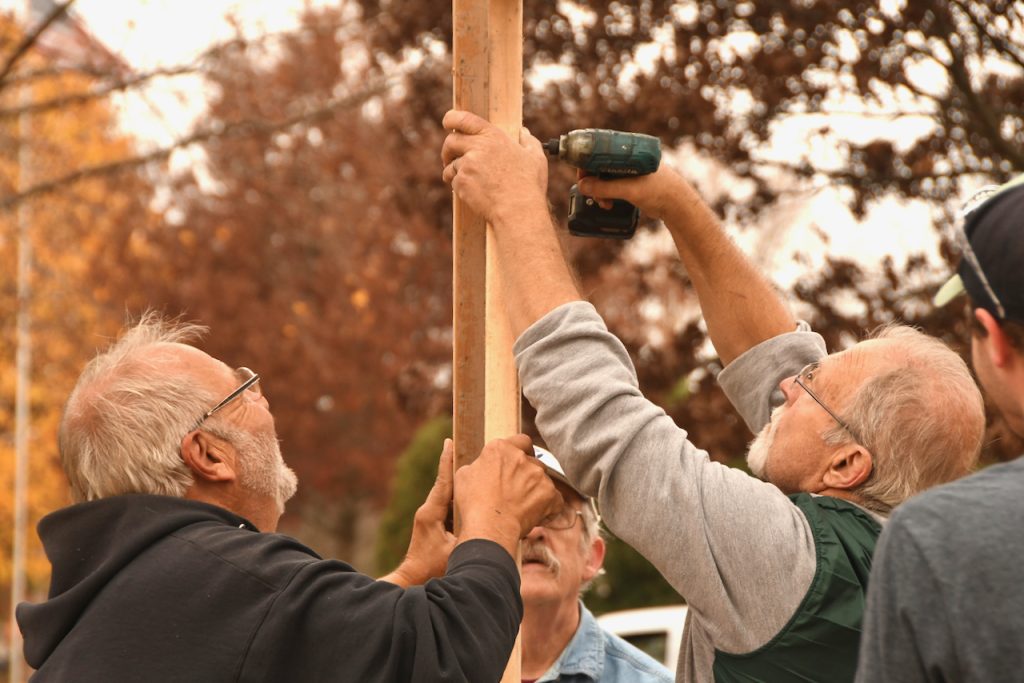
Whitewater residents Rick Fassl, at left, and Al Stanek, at right, hold an upright piece of a pavilion structure. The pavilion was recently under construction in Whitewater’s Starin Park. A dedication ceremony for the project, dubbed the “Generac Welcome and Education Center,” will be held Friday.
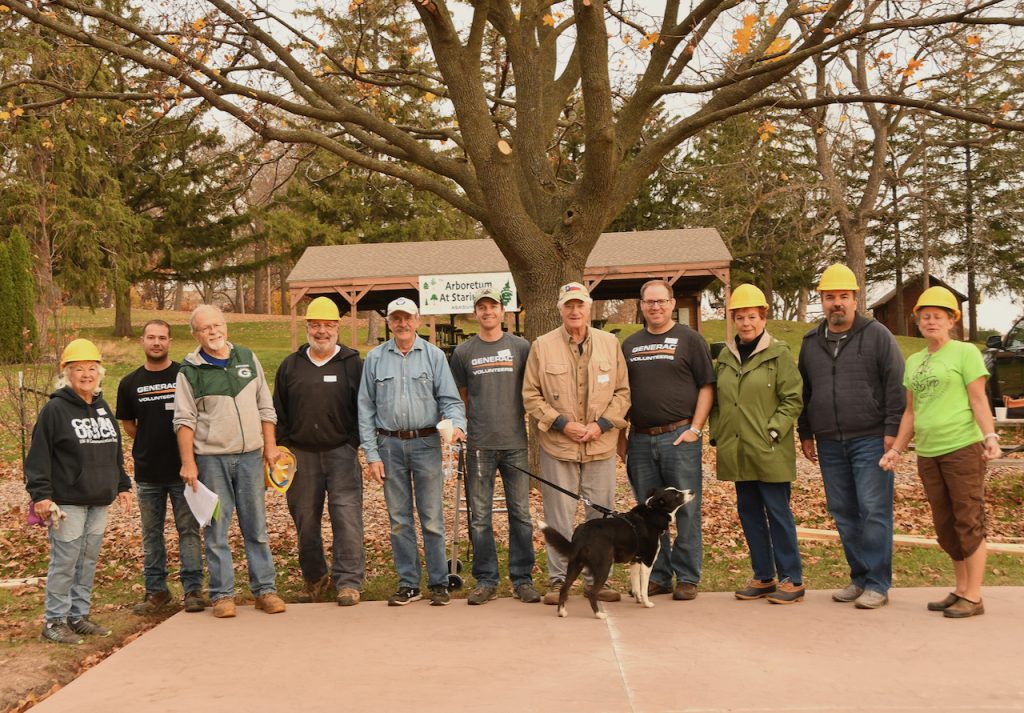
A team assembles to build the Generac Welcome and Education Center in Starin Park. They are: Jeanine Fassl, from left, Generac employee volunteer Adam Cook, Al Stanek, Rick Fassl, Dave Linton, Generac employee volunteer Paul Taylor, Whitewater Urban Forestry Commissioner Jim Nies, Generac employee volunteer Joel Hirschfeld, then-Whitewater Common Council member Carol McCormick, Whitewater Parks and Recreation Director Eric Boettcher, and Sherry Stanek.
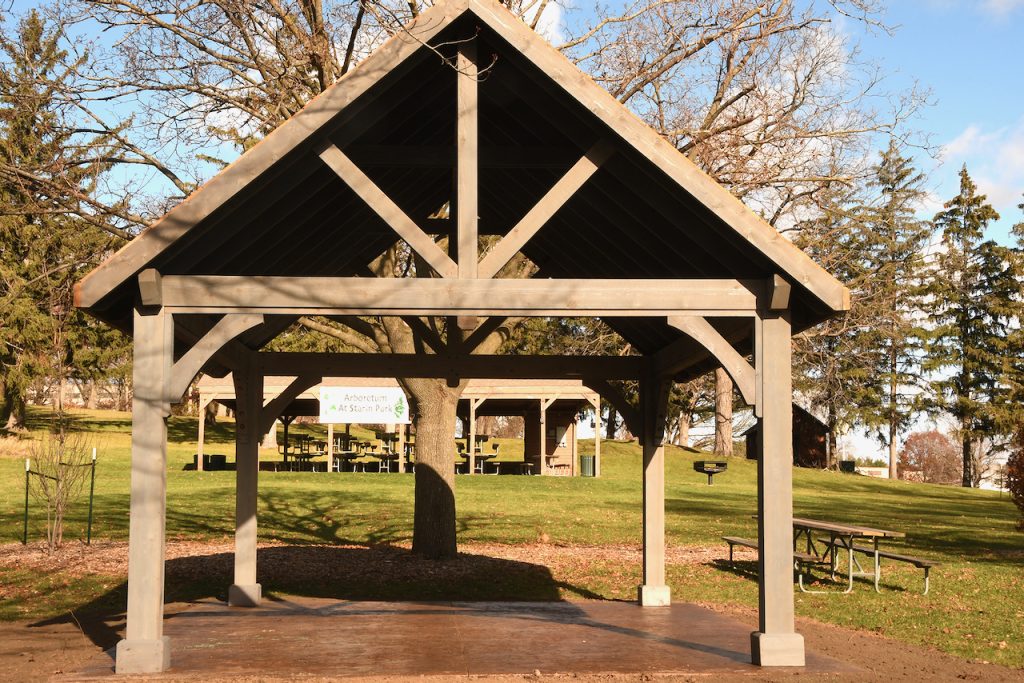
The completed Generac Welcome and Education Center stands in Starin Park. A dedication of the space, along with a ribbon-cutting ceremony, will be held Friday.
Contributed photos.
Five-day Fourth of July Festival: Downtown Whitewater previews 2023 activities, and some nostalgia
(Originally published May 1, 2023.)
By Kim McDarison
While the Whitewater Fourth of July celebration has a long history, reaching back to a time when events were held in the city’s Starin Park, the extended-weekend-long festivity moved to its downtown location, in Cravath Lakefront Park, in 2000, Jean Mills, a Whitewater resident and then-Fourth of July Committee member, told Fort Atkinson Online.
This reporter, then-editor of the Whitewater Register, remembered writing in 2004 about the event. Rummaging through old newspapers long ago saved in a dust-glazed tote, a familiar photograph of a colorful dragon-headed carnival ride emerged, along with a front-page headline, noting that in that year, the three-day celebration would commence Friday, July 2, with what has today become a festival staple: a carnival. Rides were scheduled to begin operation at 5 p.m. and run until midnight.
The theme that year was “America Standing Together,” and the full slate of that Friday’s events, along with the carnival, included music performed by “JP and the Cats,” and a beer garden. Saturday brought extended carnival hours, running from noon to midnight, and a presentation made by the Minneiska Ski Team which performed in Cravath Lake, along with tents filled with crafts, a “Care for Critters” bird show sponsored by the Milwaukee County Zoo, a “Battle of the Bands,” and a nighttime fireworks display. Sunday saw a parade, a second show by the ski team and a car show, along with a “Discover World Science” program sponsored by a Milwaukee-based museum, and fireworks, commencing for a second night. Music was performed by the Vern Meisner Band.
A bevy of business sponsors and community volunteers offered various supports to make it all possible.
Then in its infancy, the downtown location emerged as the cradle of tradition.
Rummaging a little further, there came a second find: a video made in 2013 of the Whitewater Fourth of July fireworks display. The recording produced images of mortars pumping pyrotechnics over Cravath Lake to the delight of a full and cheering crowd.
Last week, Downtown Whitewater, Inc., the organizers of the Whitewater Fourth of July Festival, released a partial schedule of events planned for this year’s upcoming celebration, and while some names have changed, the overall structure of the observance continues.
This year, according to the Downtown Whitewater Fourth of July website, five days of festivities begin Friday, June 30, and while daily schedules have not yet been published, organizers noted in a recent news release that carnival rides will once again be presented by Chrisman Amusements, which, Mills said, is the organization that has been bringing the rides to Whitewater since 2000.
According to Downtown Whitewater member Lisa Dawsey Smith, the festival has run between three and five days annually depending upon where the Friday before July 4th falls.
This year, the full festival will run from Friday, June 30, until Tuesday July 4.
“We always try to include a Friday acknowledging that some members of our community desire that,” Dawsey Smith said, adding that this year’s event-goers can expect to find carnival rides operating each of the five days.
Aside from the carnival rides, she said, the rest of the festival is run by volunteers. On Monday, while carnival rides will be available, other elements of the festival will not be, including civic food vendors, live music performers, or other activities.
Monday’s schedule is less full because some volunteers will need to work, and the Whitewater Unified School District is scheduled to begin summer school classes, Dawsey Smith noted.
Also, she said, some of Friday’s activities and entertainment acts are still being determined. As the full five-day schedule develops, including specifics, such as times and locations, information will be added to the Discover Whitewater Fourth of July website: whitewater4th.com.
On Saturday, July 1, the traditional car show will be held from 2 to 7 p.m., and there will be live music during the day. Fireworks will be presented Saturday night at 10 p.m.
Sunday, July 2, is “Family Day,” which is sponsored by Generac Power Systems, and will include a free petting zoo, complete with pony and camel rides. The petting zoo will be open between noon and 4 p.m., Dawsey Smith noted.
Also on Sunday, the annual Miss Whitewater Pageant will be held at 4 p.m., and food vendors will remain open until 6 p.m., Dawsey Smith said.
On Tuesday, July 4, there will be a full day of events, beginning with the Whippet City Mile run which is followed by the parade. Live music will be available throughout the afternoon, along with food vendors, and a fireworks display scheduled for 10 p.m.
This year, according to a recent Discover Whitewater news release, live music at the Cravath Lakefront Amphitheater includes a variety of local and regional performances concluding with the return of “The Britins, a Beatles Tribute Band,” as Tuesday’s headliner.
Organizers are looking for support through donations and volunteerism. Those interested in learning more about making a donation or signing up as a volunteer are encouraged to join the festival’s upcoming open-house-style committee meeting, Thursday, May 4, from 5 to 7 p.m. The meeting will be held at the offices of Downtown Whitewater, Inc., 150 W. Main St., Whitewater.
Those with questions or who have an interest in volunteering also may contact organizers through email: director@downtownwhitewater.com.
Those interested in making a donation are asked to find additional information on the organization’s website where they also can become a “Friend of the Fourth” member.
Those interested in participating in this year’s Fourth of July parade are asked to register online using the following link: https://forms.gle/TsNTBuzsbwKAquD78.
According to information released by Downtown Whitewater, partner organizations helping to make this year’s festival a success, include: the city of Whitewater, Whitewater Lions Club, Whitewater Area Regional Ministries PrimeTime High School Youth Group, Whitewater First United Methodist Church, Christo la Roca, Knights of Columbus, St. Patrick Catholic Church, Whitewater Family Church, the Whitewater Area Chamber of Commerce, and First Citizens State Bank.
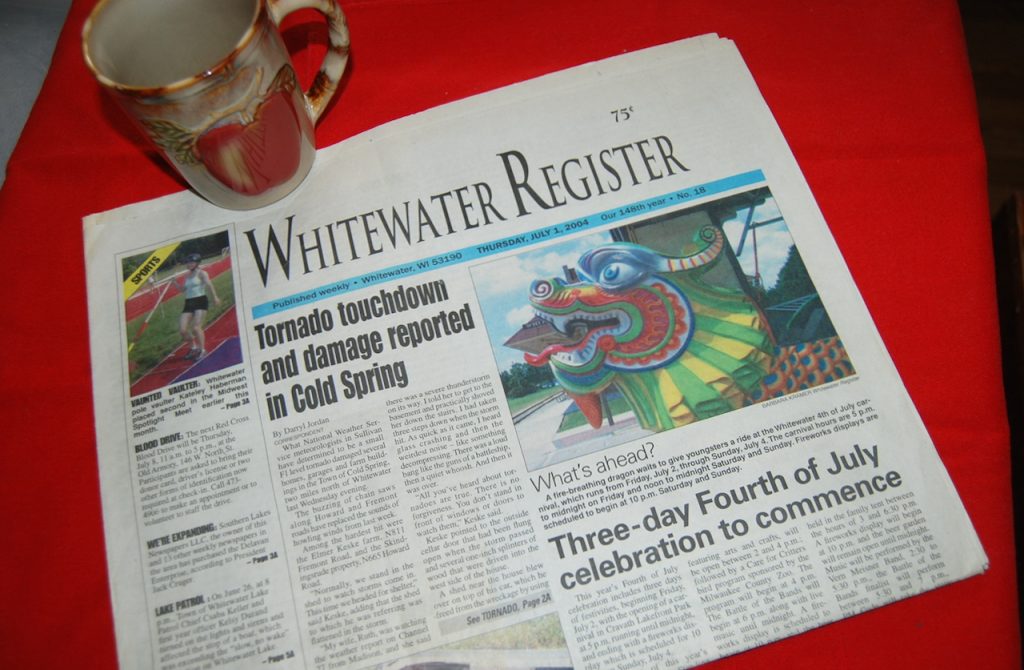
A 2004 copy of the Whitewater Register alerts readers to a three-day Fourth of July celebration. The event, which has since found its traditional home in Cravath Lakefront Park, was moved to the location four years earlier. Prior to 2000, the event was held in the city’s Starin Park. Kim McDarison photo.

A character, flanked by golf carts, makes its way down Whitewater’s Main Street. The 2022 parade entry was supplied by Willow Brook Golf Course, Whitewater. The group took third place, competing last year in the business and commercial floats category. File photo/Kim McDarison.
Click on the arrow above to watch a video of fireworks displayed over Cravath Lake as part of a Fourth of July celebration held in 2013. Kim McDarison video.
Lake restoration project continues with cattail abatement plans, city officials say
(Originally published May 1, 2023.)
By Kim McDarison
Cattail abatement will soon be slated as a next step in the city of Whitewater’s Cravath and Trippe lakes restoration project.
According to Whitewater City Manager John Weidl and Whitewater Parks and Recreation Director Eric Boettcher, the city plans to apply to the Wisconsin Department of Natural Resources (DNR) for two permits, one for each lake, to clear cattails along designated portions of shoreline.
The work is anticipated to begin late May or early June, both city official said.
The public was last updated about the project in October, during a public meeting led by Weidl, Boettcher and DNR biologist Heidi Bunk.
An earlier story about the update held in October is here: https://fortatkinsononline.com/whitewater-city-dnr-share-continued-restoration-plans-for-trippe-cravath-lakes/.
A project, focused on the restoration of both lakes, began in 2019. Some $1.5 million in costs to date have been associated with the project.
City officials told Fort Atkinson Online recently that the restoration process is nearly 80% complete, with a final phase, which could take as many as two to three years to complete, focusing on removing some shoreline cattails.
Once permits are obtained from the DNR, both officials said, a designated swath of shoreline, which could be up to 40-feet wide, with a length along each lake’s shoreline that is yet to be determined, is anticipated to take place this spring, and possibly again in 2024, and 2025.
An estimated cost to remove cattails this year is $50,000.
Following the removal of cattails, as authorized by the DNR, the city will enter into a lake maintenance phase, which could begin as earlier as 2024, Weidl said.
According to Boettcher, weather hindered the city’s winter plans to burn some vegetation on top of lake ice.
“We had that arranged with a contractor to come in, and unfortunately, this winter was very mild, so they never had the thickness of ice we needed, and then when we did have some nice cold weather, then we had a ton of snow, which added more moisture, so we made every attempt, but it was never possible due to other conditions,” Boettcher said.
“It needs to be cold, and we need to have an absence of accumulation and projected accumulation,” Weidl said.
The purpose of burning vegetation above the ice was to reduce the amount of debris left behind after plants died off, Boettcher said, adding that as the lake’s water levels rose last year, cattails were anticipated to naturally expire.
Cattails along the shorelines of the lakes were in 2 to 4 feet of water, he said, noting that the plants can’t survive in water that deep.
“So they will die off. When they die off, we wanted to eliminate the debris from the die-off,” Boettcher said.
“What’s happening with the water rising — this is all projected to happen, and part of this is out of our control — the higher the water level rises this year, the better it is for people who would prefer less cattails,” Weidl said.
How many cattails the city can remove this year is determined by the DNR, he added.
Permits will allow the city to cut cattails in “a very specific area,” he said.
Boettcher said the city will be requesting permits to remove cattails from shoreline areas in front of the city’s parks, adding that one permit would focus on an area in front of Cravath Lakefront Park and a second would focus on an area in front of Trippe Park and the Clay Street Nature Park.
To date, he said, he has requested quotes from contractors who can do the work. Once the quote are available, the city will make its request and initiate the permitting process.
A “Cattail cutting and removal update” has been placed on the Whitewater Common Council’s next meeting agenda, scheduled for Tuesday.
Weidl said the removal of cattails became a city focus after the public update held last October.
During that meeting, he said: “The number one thing that came up was focusing on cattails in public areas.”
Boettcher said that the city has the ability to apply for permits that affect properties it owns.
“I can do our property, and in front of our park areas, because those permits follow the landowner,” Boettcher stated, adding that the DNR determines for each permitted property how far along the shoreline a 30- to 40-foot “pathway” can be cut.
Boettcher noted that while earlier in the project, the city considered a chemical treatment as a tool for weed abatement, the process was never used.
‘We are all about filling the lake’
Chemical treatment is only an option when the lakes are drained, Weidl said, which, he added, “would not happen anytime in the near future.
“We are all about filling the lake.”
He added that a consistently high water level will bring the result regarding cattails that he believes most residents are hoping to see.
Weidl said this year, plans call for the lakes to continue to fill with water, and for the city to make a plan to manage species as indicated by the DNR. Once permits are secured and cutting takes place this year, the next step would involve a period he described as “wait and see,” the results of which would determine steps that might need to be taken in 2024 and 2025.
Boettcher said he anticipated a visit will be made to the lakes by Bunk sometime before June.
“A lot of this is also kind of waiting to see what’s going to happen, because we’re not sure how much is going to die off and how much will stay. So it’s an ongoing process to make sure that the future plans we have are eliminating issues we are seeing as they happen,” he stated.
Building water depth, clarity
Boettcher and Weidl both pointed to the importance of the navigation channels which were created by the city’s dredging project, which began in 2021 and and completed in March of 2022.
Navigation channels keep water moving through the lakes, which, in turn, keeps sediment from building on the lake beds, Boettcher said.
The channels are meant to keep the lakes from losing depth, Weidl said, adding “It’s working.”
Both the city and the DNR will continue to verify that result, Weidl added.
“All of our initial visual inspections of what’s happening demonstrates that its working, and it’s more than the lake maintaining its depth, and the DNR will certainly be able to talk about that when they get here.
“The sediment is washing out. If you go to the exit points, it’s happening like it’s supposed to. Not withstanding, I understand people are frustrated with the cattails,” he said.
Boettcher said plans called for the navigation channels in each lake to maintain a depth of five or six feet.
Weidl said a goal is to maintain that target depth “for as long as possible.”
Boettcher said the project also has worked to restore lake health.
“We gained water clarity through this project, a cleaner lake, and a more recreational use lake that has a navigation channel that you can actually paddle, canoe or take a smaller fishing boat in,” he said, adding that last fall, he was able to travel by boat across the lakes as far as Highway 12.
“We were never able to do that before this project. You had water clarity five to six feet down,” he noted.
Before the city undertook the restoration project, Boettcher said the waterway was overgrown with vegetation.
“And that’s probably another reason why DNR won’t allow us to get rid of all the cattails is because cattails actually help take up some of that nutrition, otherwise if you didn’t have those, you would have overgrowing plants again in the lake,” he said.
Fish, waterfowl, recreation
As water levels rise, fish have been returned to the lakes, Boettcher said.
Some have returned naturally by swimming into the waterbodies, which are fed by both Whitewater and Spring Brook creeks.
In addition, Boettcher noted, the city has restocked perch.
“The DNR stocked northern (pike). We don’t stock the bigger fish. The DNR actually stocks the bigger fish. We do more of the bluegill, crappie and then some feeder fish,” he said.
Plans call for the city to continue to restock fish each fall over the next few years, he said.
“It’s just a ramp up for now, for the next year or two, and then we will see what happens,” he added.
Carp eradication was not performed in the lakes.
“It’s an open-water system, so as soon as you remove them, they just come in from upstream. When we looked at removing carp, they (DNR) said we could remove carp, but it was not worth the money because they would be back in six months,” Boettcher said.
A waterfowl management system also will be returning to the lakes, Boettcher said.
“Before the drawdown, we had a hunting program, and that will be coming back this fall. So the city gives out permits to residents who want to hunt on Trippe and Cravath lakes. They can hunt waterfowl,” he noted.
Boettcher said the city offers a limited number of permits that can be used during the DNR’s waterfowl hunting seasons.
A list of hunting seasons for migratory birds, as found on the DNR’s website it here: https://dnr.wisconsin.gov/topic/hunt/dates.
Those interested in obtaining a permit are encouraged to contact Boettcher.
With continued restoration, both officials said, the lake will better suit its intended no-wake recreational use.
Project history, looking ahead
Boettcher, during his presentation offered last fall, noted that the lake projects began July 8, 2019, with Cravath Lake having been drawn down fully after the first season. Siphons added over the spillway in the summer of 2020 enabled the continuous drawdown of Trippe Lake during the following year. Both drawdowns were complete in August 2021. Dredging took place between Jan. 12 and Feb. 27, 2022.
Both lakes were refilled last spring, he said, adding that by the end of August, the lakes were close to being refilled, however, a statewide drought last summer kept the water levels a little below normal.
Weidl described the project as a multiyear journey which is nearing its completion.
“We have to finalize a strategy with the DNR for vegetation management and we have to continue on a path for restocking, and both of those, we knew, were going to take more than one year. We are in year one of something that is going to take either two or three years,” he said, noting that the lakes, after the cattail abatement takes place and maintenance plans commence, will resemble the “version of success that we are going to have at that point in time.”
By the end of 2025, he said, he believed the lakes will closely resemble what most people hoped would be achieved.
“I understand where people want to end up. We are going to continue trying to get there with them. The DNR, they are truly not trying to be a road block. They want what we want, which is a waterway, a navigable waterway, first of all, that’s an important word, a navigable waterway, that is biologically healthy and can be used recreationally for the community. And we want that to be able to last for a significant amount of time.”
Financially, he said, with 80% of the project completed, expenses would no longer be in the hundreds of thousands, but more likely in the tens of thousands, followed by annual maintenance amounts of between $15,000 and $20,000, which, he said, the city has included in its budgeting process.
Said Weidl: “The lake has had an annual maintenance budget for years. It will continue to have it. What I will suggest is that probably what it’s been used for is going to change. Instead of trying to deal with vegetation growth, which was becoming a challenge, we are hoping that’s done and we can change that to cattail management … but that’s generally the path we are on. We have a maintenance budget and it just needs to shift over the next couple of years towards whatever the new goals are.”
Weidl said there was a good likelihood that the lakes would one day require maintenance in the form of dredging.
“I’m hoping that’s a 20-year horizon. It’s going to come down to maintenance. My guess is we will start tracking annually depth changes and we are going to have several year’s warning,” he said, adding that a plan would be to “not let things get out of hand,” focusing on “smaller reconstruction projects,” and “making sure we are investing more time consistently, so you try and avoid the giant lump sum expense.”
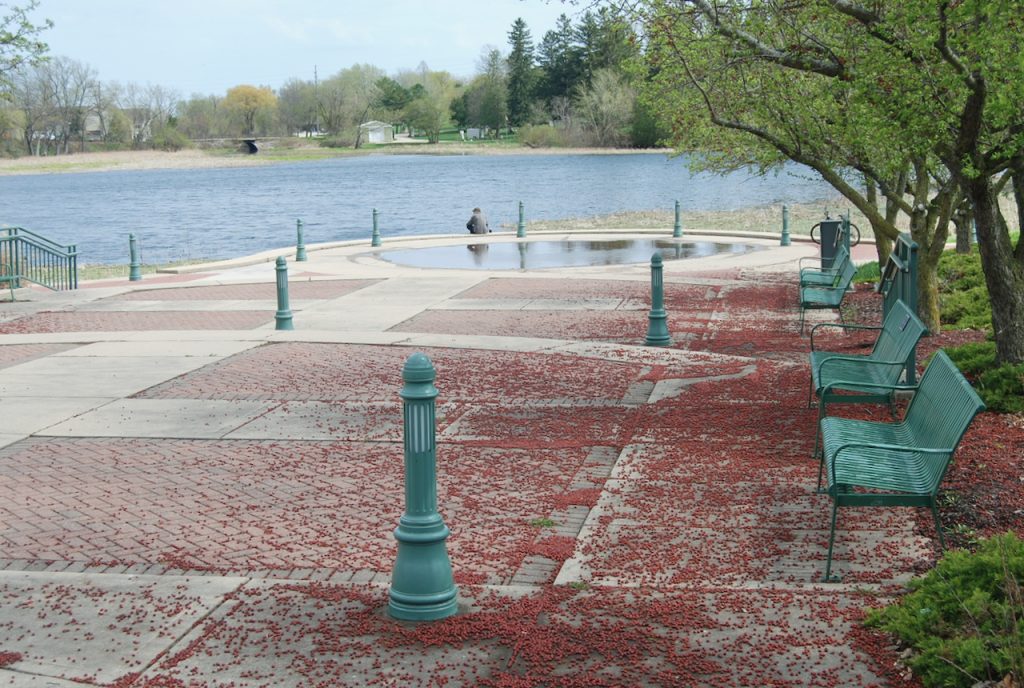
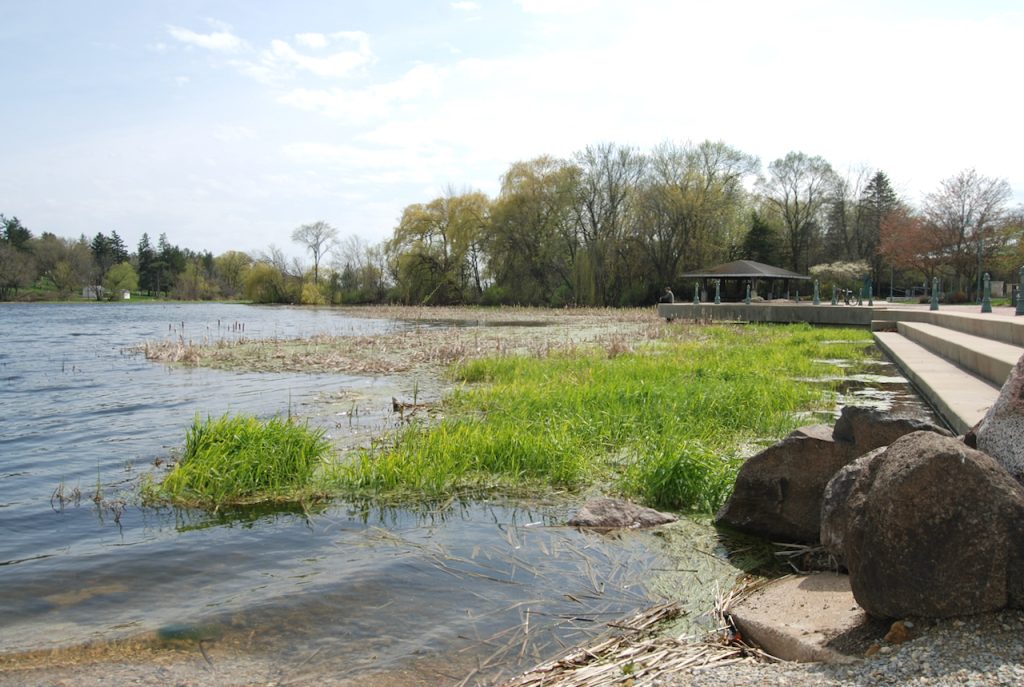
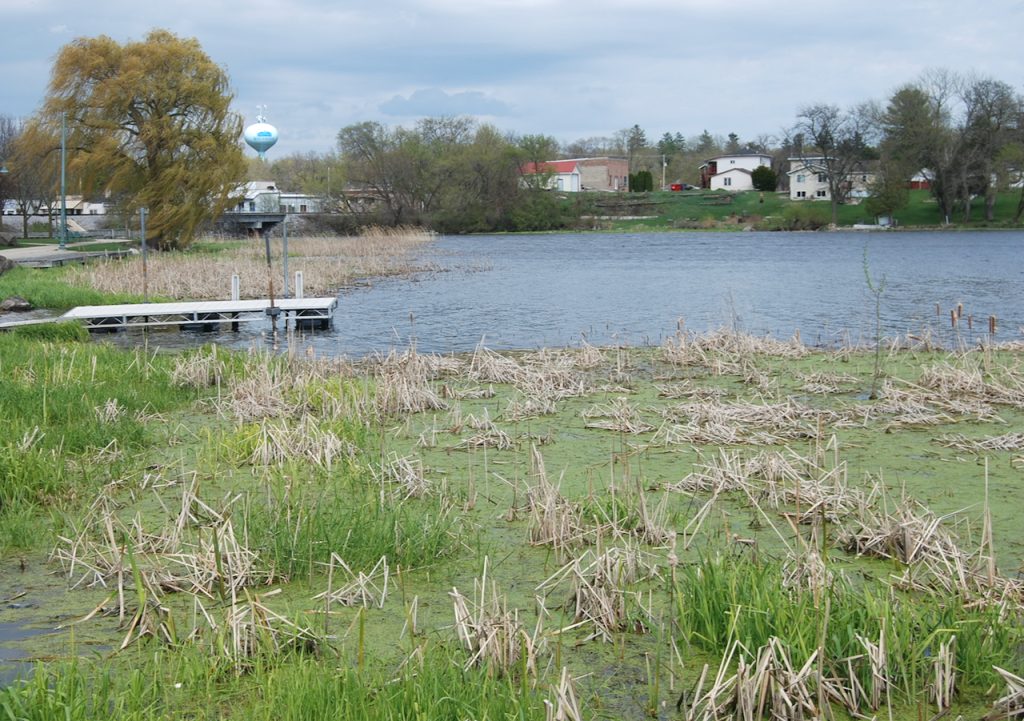
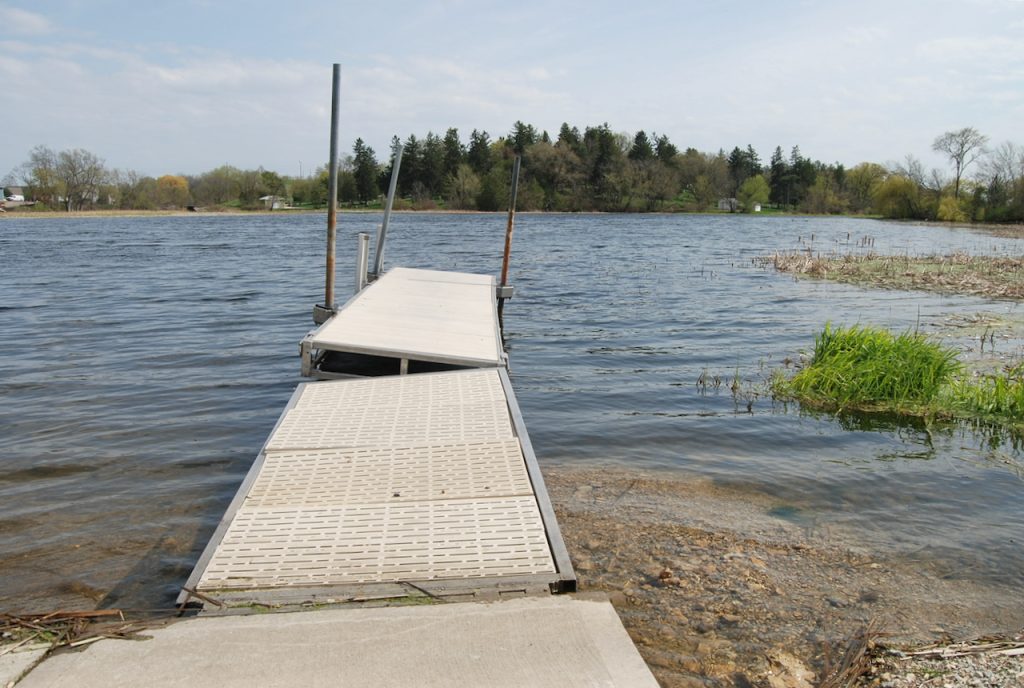
Four photos above: Various views of Cravath Lake from the shoreline in Cravath Lakefront Park show water levels are rising. City officials say cattail abatement is the next step associated with the multiyear lake restoration process. A permit to cut cattails along a yet to be determined portion of shoreline on both Cravath and Trippe lakes is anticipated to be executed sometime in May or June. Kim McDarison photos.

An ornamental concrete shoreline denotes where Whitewater’s downtown Cravath Lakefront Park once met with the water of Cravath Lake. A sea of seven-foot-tall plants engulfed the promenade in September of 2021. File photo/Kim McDarison.
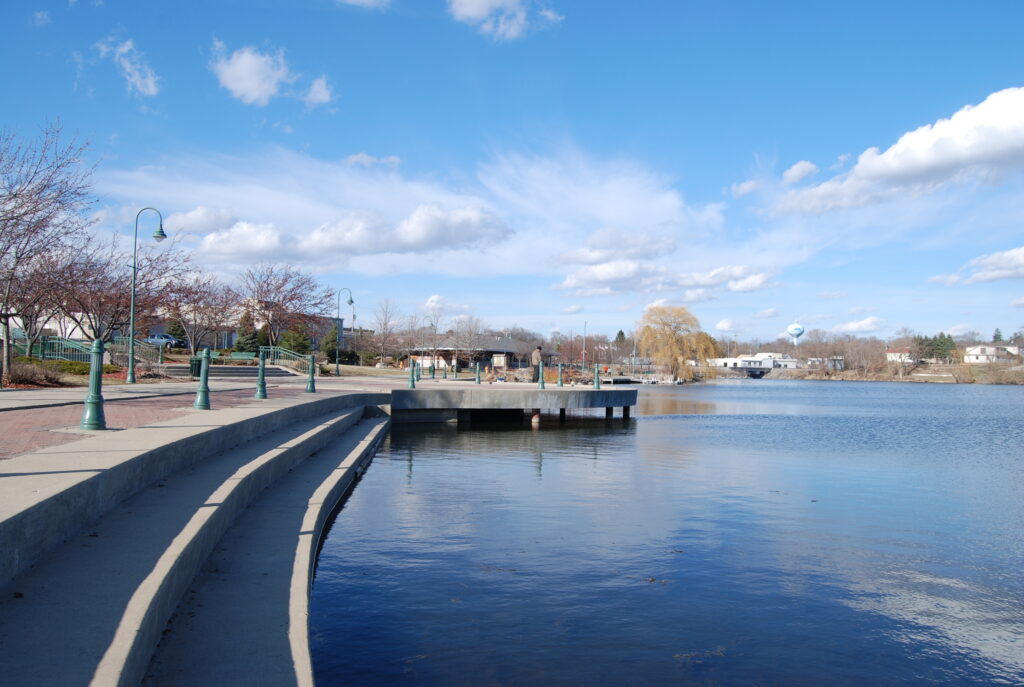
A view of Cravath Lake in the spring of 2015. Planning for a multiyear lake restoration project began in 2017, with restoration beginning in 2019. File photo/Kim McDarison.
Whitewater opens city-owned roads for all-terrain, utility-task vehicle use
(Originally published May 4, 2023.)
Whitewater city officials have announced that city-owned roads, unless posted otherwise, are open to all-terrain vehicle (ATV) and utility-task vehicle (UTV) traffic.
An ordinance approved by the Whitewater Common Council, opening the roads to ATV and UTV use, applies to city-owned roads within both Walworth and Jefferson counties, according to the release.
According to information on the city’s website, an ordinance approving use of ATVs and UTVs on city-owned streets in Jefferson County was approved in November of 2021. An ordinance approving ATV and UTV use on all city streets, including those located in both Jefferson and Walworth counties, was approved in March.
Before the ordinance could be placed into effect, the ordinance required the installation of street signs.
According to information released Thursday by city officials, the ordinance became effective on Thursday. A map, as provided on the city’s website, showing roads within the city that are open to ATV and UTV use is here: https://whitewaterwi.org/gis/2023/ATV_UTVRoutes2023.pdf.
While most streets within the city of Whitewater are approved for ATV and UTV use, the release notes that streets around the University of Wisconsin-Whitewater campus, which are considered “non-city” streets, are among those that prohibit ATV and UTV use.
ATV/UTV riders are required to abide by applicable city regulations and Wisconsin Department of Natural Resources (DNR) laws, the release stated.
Regulations and laws will be enforced by all law enforcement agencies working within the city, including the Whitewater Police Department, including the issuance of citations under Wisconsin State Statute section 66.0113, according to language within the ordinance. The full statute is here: https://docs.legis.wisconsin.gov/statutes/statutes/66/i/0113. Additionally, language within the ordinance states the following: “penalties set forth in section 23.33 (13)(a) Wis. Stats., are adopted and incorporated by reference herein.”
Language within section 23.33(13)(a) outlines circumstances under which forfeitures of $250, $500, and $1,000 could be applicable.
As provided within the release, a list of city and state regulations follows:
• ATVs/UTVs shall be operated on the paved surface on the extreme right side of the roadway.
• ATVs/UTVs may be operated on paved surfaces only, unless yielding the right of way.
• ATV/UTV operators are required to have applicable liability insurance.
• ATVs/UTVs shall not be operated at a speed greater than the posted speed limits.
• ATVs/UTVs may not be operated on any city street without fully functional headlights, taillights and brake lights.
• ATVs/UTVs may not be operated on any city street between the hours of 10:00 p.m. and 5:00 a.m.
• No person may operate an ATV/UTV on any city street without a valid driver’s license and shall display the license on demand from any law enforcement officer or official as defined by state statutes.
• The operation of an ATV/UTV shall be limited to traveling on a direct route from the initial starting point to a specific destination in the city. Operating ATV/UTV vehicles on city streets for other purposes is prohibited.
• ATV/UTV operators shall slow to a speed of 10 miles per hour or less and yield the right-of-way when traveling within 100 feet of a person who is not on an ATV/UTV, a snowmobile or a motorcycle.
• ATV/UTV owners may not authorize any person to operate an ATV/UTV if the person is prohibited from operating an ATV/UTV as defined by state statutes, incapable of operating the vehicle because of a physical or mental disability or under the influence of fermented malt beverages, intoxicating liquor or controlled substances.
• All ATV/UTV operators and passengers under the age of 18 are required to wear a minimum Department of Transportation standard ATV or motorcycle helmet with the chin strap properly fastened.
For more information regarding DNR regulations, visit: https://dnr.wisconsin.gov/topic/ATV/Regulations.
The full ordinance approved by the Whitewater Common Council in March is here: https://www.whitewater-wi.gov/DocumentCenter/View/3505/1145-Allowing-the-Operation-of-ATV-UTV-on-City-of-Whitewater-Streets.

Whitewater Municipal Building, file photo/Kim McDarison.
Whitewater Fire and Rescue holds pinning ceremony
(Originally published May 5, 2023.)
By Kim McDarison
Some 25 fire and emergency medical personnel were sworn in Thursday as members of the Whitewater Fire and EMS Department during a badge pinning ceremony.
Nearly 100 family members and friends arrived at the Whitewater Fire Department garage to watch the emergency personnel officially become members of the department, which transitioned from a volunteer department, operating as a separate entity from the city, to a city-run department in July of last year.
In total, 43 fire and EMS personnel were recently sworn in and pinned, Whitewater EMS Chief Jason Dean noted, but not all of them were able to be present during Thursday’s ceremony. Those unable to attend were sworn in and pinned at different settings, he said.
Whitewater City Councilwoman Lisa Dawsey Smith, Whitewater City Manager John Weidl, Whitewater Fire Chief Kelly Freeman and former Assistant Fire Chief Bob Gabbey each delivered remarks during the ceremony.
Also in attendance were State Sen. Steve Nass and State Rep. Ellen Schutt, along with Whitewater Common Councilwoman Brienne Diebolt Brown and Whitewater Common Councilman Jim Allen.
Addressing the assembled department personnel, Dawsey Smith said: ”The decision to serve your community is one deserving of honor. I am truly humbled even just to be here to witness this ceremony … Gone are the days when, to be a firefighter, you need only be willing to show up. Thank you for choosing to commit to the education and training that you have completed and that are ever-present in your ongoing service. There is someone whom I respect very much who told me once that he was just a firefighter, or something to that effect. I corrected him because that couldn’t be further from the truth. So this evening, I thank you all for being the highly trained, highly skilled, professional group that you are.”
Dawsey Smith noted that firefighting comes with larger responsibilities than simply fighting fires, saying: “You provide the primary response that handles fires, emergency and tactical medical service, several rescue disciplines, hazardous material response, mass casualty response, community risk reduction, and severe weather responses. Please know that your service is seen, highly valued, and that while your uniform does not include a superhero cape, you are real life superheroes to many.”
Wield, too, thanked fire and EMS personnel.
In a followup statement offered Friday to Fort Atkinson Online, Weidl said that he wanted “most importantly,” to thank the men and women who serve on the city’s fire and EMS department, along with their families.
“Both the nature of the job and the working conditions are a stressor on the employee and their loved ones at home who also support and suffer with us for the sake of keeping the community safe. Moving forward, we have a well-funded department with very competitive wages and highly trained staff. Response times have improved dramatically over the last several months and will continue to do so. Bottom line, we are all grateful to Chief Freeman, his leadership staff, and the men and women who are now serving 24 hours a day, seven days a week, 365 days a year to provide fire and emergency medical services to our community and surrounding area.”
Within his address, Gabbey shared department history, beginning in 1871, when the village of Whitewater passed an ordinance to create the department and organized it as a volunteer operation. The department began as a “bucket brigade and in 1889 moved to hand-drawn carts,” he said.
By 1915, motorized trucks arrived and the department moved into its first home, which, according to Gabbey, was a “small brick building located near the mill pond where members would pump water to the fire hydrants located in the business district.”
Some 100 volunteers manned two companies within the department, which later evolved into four companies. The department moved to a location at the then-city hall in 1900, he added.
During his remarks, Freeman spoke about more recent events, noting that between 2014 and 2015, city officials noticed that they faced “a unique situation. They essentially had two fire departments under the same roof and wanted to combine them and make one department.
“The city fire department owned the red trucks and the rural department owned the yellow trucks. Over the course of the next 18 months or so, Whitewater Fire Department, Inc., was formed in August of 2016. Whitewater Fire Department, Inc., was a standalone department that contracted with the city and surrounding townships for service.”
New challenges faced the department in 2021, he said, citing an increased number of calls for service while available manpower supplied through paid on call staff members was decreasing.
Other departments across the state grappled with similar sets of circumstance, he said.
A solution was found in 2022, when the decision was made to create a municipal department which is in operation today and known as Whitewater Fire and EMS.
Said Kelly: “We are here to appreciate what those before us have done. We are also here to build on the foundation set before us. I will ask the question to the department staff: Are we going to be a good fire department? I believe we are, but we are all going to have to continue to work hard and train to remain good. I’m not just talking about knowing the greatest life-saving techniques for prehospital care, knowing the quickest patient removal from an automobile accident or performing the most advanced and aggressive search to remove victims from a burning building. I’m also talking about working hard, training and continuing to be good, genuine people as well.”
The move in house
City officials, offering information last July about the need to transition from an independent volunteer department to one operated by the city, noted that the move to bring fire and EMS services in house was made to help alleviate increasing difficulties with staffing faced by the department when using a paid-on-call model.
Plans associated with bringing the department in house called for the use of a paid-on-premises model, which would improve the department’s response times and its ability to recruit manpower, Then-Whitewater Director of Finance Steve Hatton said.
The new model would also provide department employees with health and retirement benefits and produce a schedule with more reliable hours, he added.
As part of the transitional agreement, the Whitewater Fire Department, Inc., or WFD, Inc., which was the city’s former independent fire department, was preserved to function as a fundraising organization for the department and would maintain a fund balance to help support services and pay for capital costs associated with purchasing and replacing equipment.
The department services the city of Whitewater and the towns, in part or whole, of Whitewater, Cold Spring, Koshkonong, Richmond, Lima and Johnstown.
An earlier story about the formation of the in-house department is here: https://fortatkinsononline.com/whitewater-council-approves-bringing-fire-department-in-house-explores-november-ballot-referendum/.
A full list of department personnel includes: Officers, along with Freeman and Dean, Ryan Dion, Joe Uselding, Christ Christon, Andrew Beckman, Carl Strait, Kyle Strait, Dustin Tomlinson, Marshall Lewis, and Jacob Maas; full-time “Shift A” personnel: Benjamin Kastern, Alana Kolesar, Sylvia Netemeyer, and Riley Walters; “Shift B” personnel: Crystal Griffin, Amanda Kraayvanger, Sean Oflanagan, and Alexander Rohde; “Shift C” personnel: Ashley Dodd, Mikayla Fehl, Tanner Stark, and Carl Strait; payed on call firefighters: Josh Benes, Johnathan Brock, Joey Marx, Terry Phelps, and Justin Sachse; paid on call EMS: Brody Fielder, Kristen Lewis, Renee Monestero, Jenna Poole, Samantha Reher, Garrett Rieger, James Rodgers, Nikki Rowland, Shannon Schepp, Jazmine Tomlinson, DaKota White, and Steven Witt, and paid on call firefighters and EMS: Eduardo Bayona Tavara, Reichert, and Melanie Taylor.
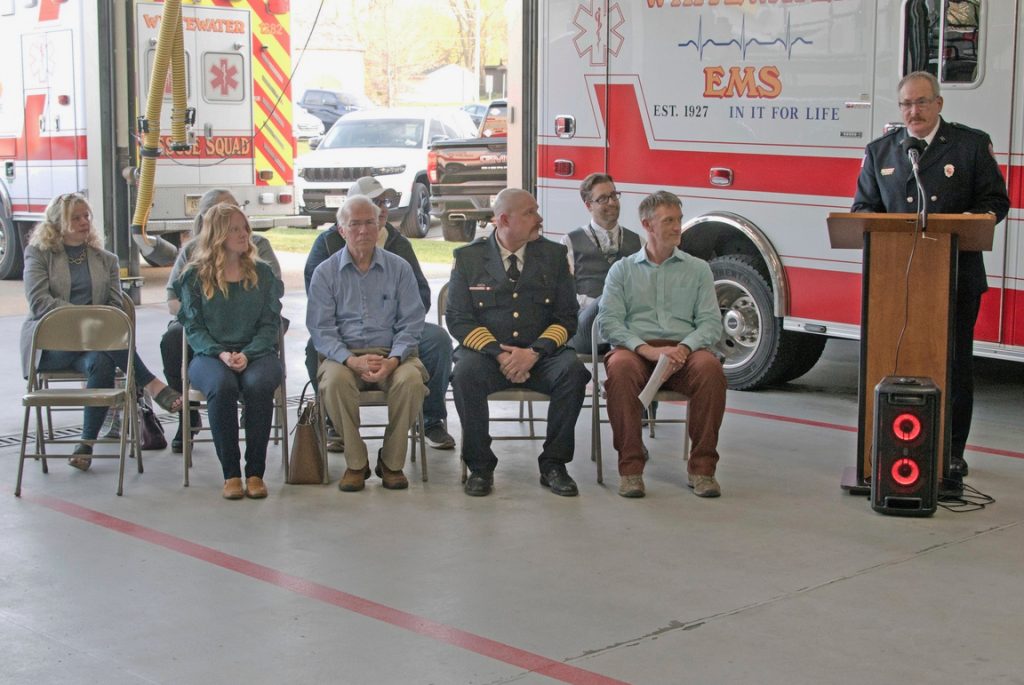
Whitewater Common Councilwoman Brienne Diebolt Brown, from left, Councilwoman Lisa Dawsey Smith, State Rep. Ellen Schutt, State Sen. Steve Nass, Councilman Jim Allen, Whitewater Fire Chief Kelly Freeman, City Manager John Weidl, Whitewater interim City Clerk Jeremiah Thomas, and, at the podium, former Assistant Fire Chief Bob Gabbey are among speakers and special guests attending Thursday’s Whitewater Fire and EMS Department pinning ceremony.

Some 100 family members and friends arrive at the Whitewater firehouse to witness the pinning ceremony.
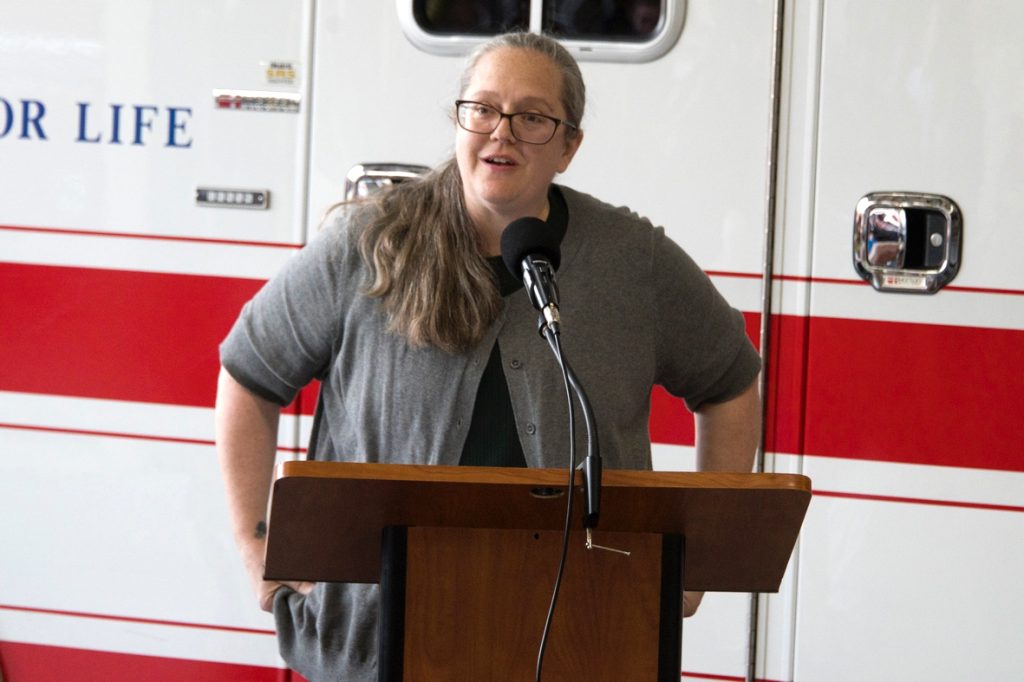
Whitewater Common Council member Lisa Dawsey Smith delivers remarks.
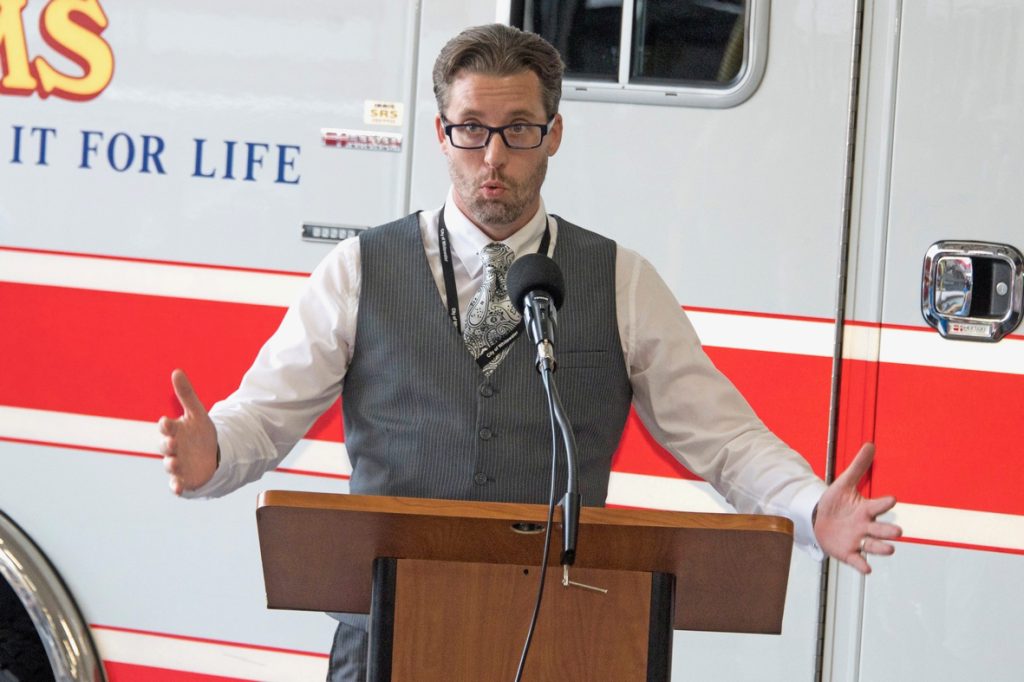
Whitewater City Manager John Weidl delivers remarks.
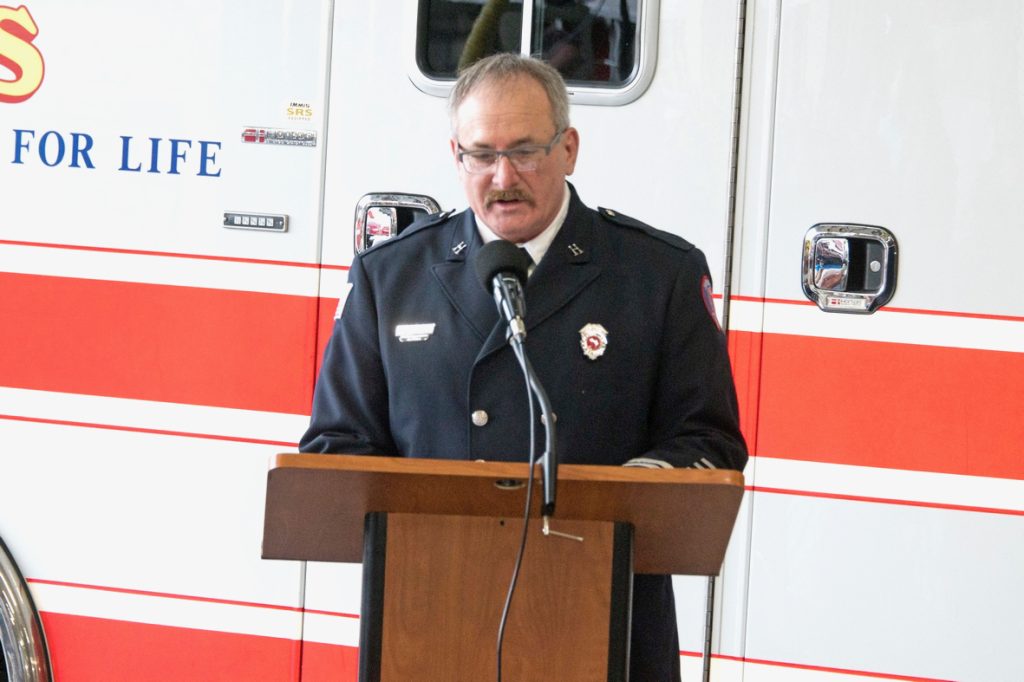
Former Whitewater Fire Department Assistant Chief Bob Gabbey delivers remarks.

Whitewater Fire Chief Kelly Freeman is pinned by his daughter Kendyl.

Whitewater Fire and EMS officers Ryan Dion, from left, Joe Uselding, and Jason Dean are sworn in by interim Whitewater City Clerk Jeremiah Thomas.
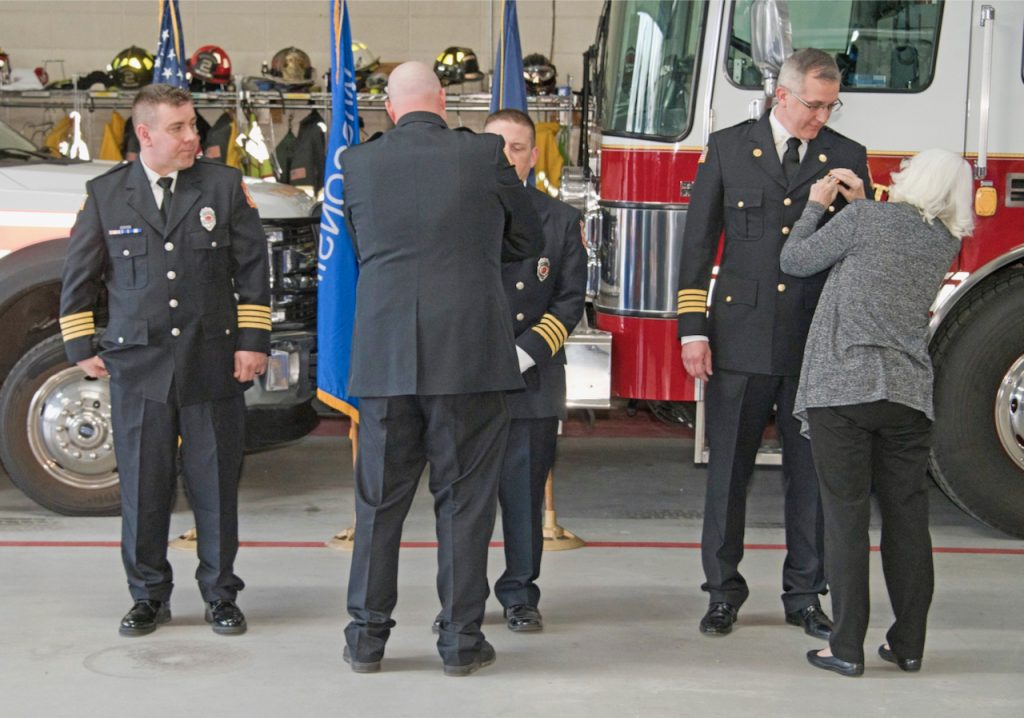
Whitewater Fire and EMS officers, including Ryan Dion, at left, receive pins. At center, Joe Uselding is pinned by Whitewater Fire Chief Kelly Freeman, followed by EMS Chief Jason Dean who is being pinned by a family member.
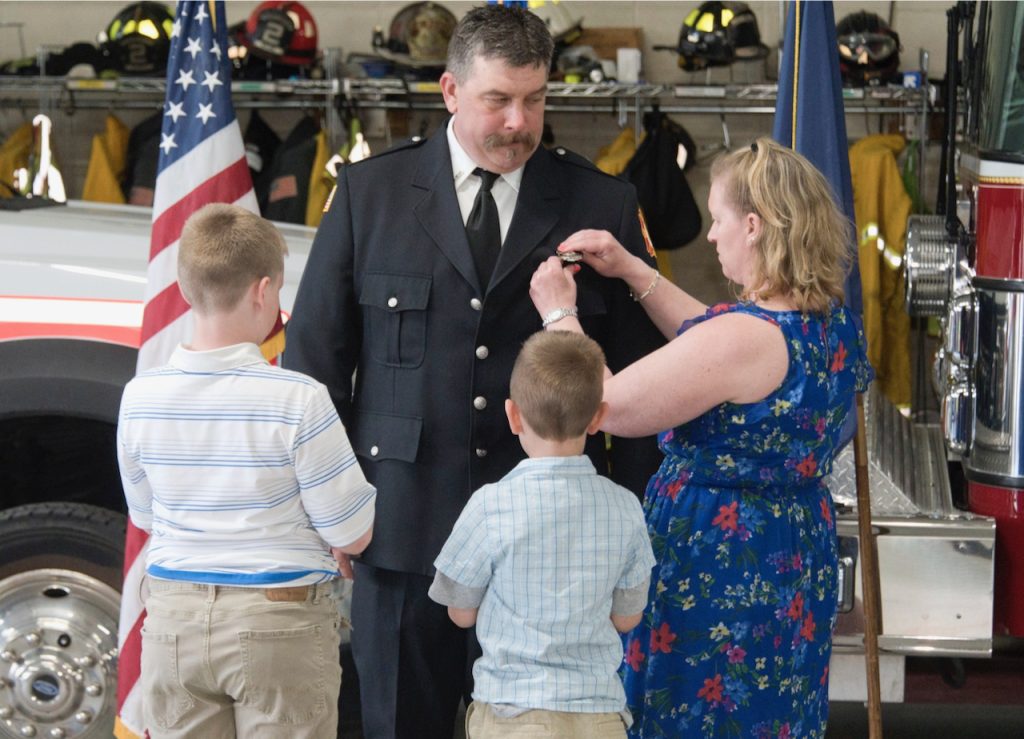
Whitewater Fire and EMS officer Andrew Beckman is pinned by his wife, Jennifer, and the couple’s two sons.
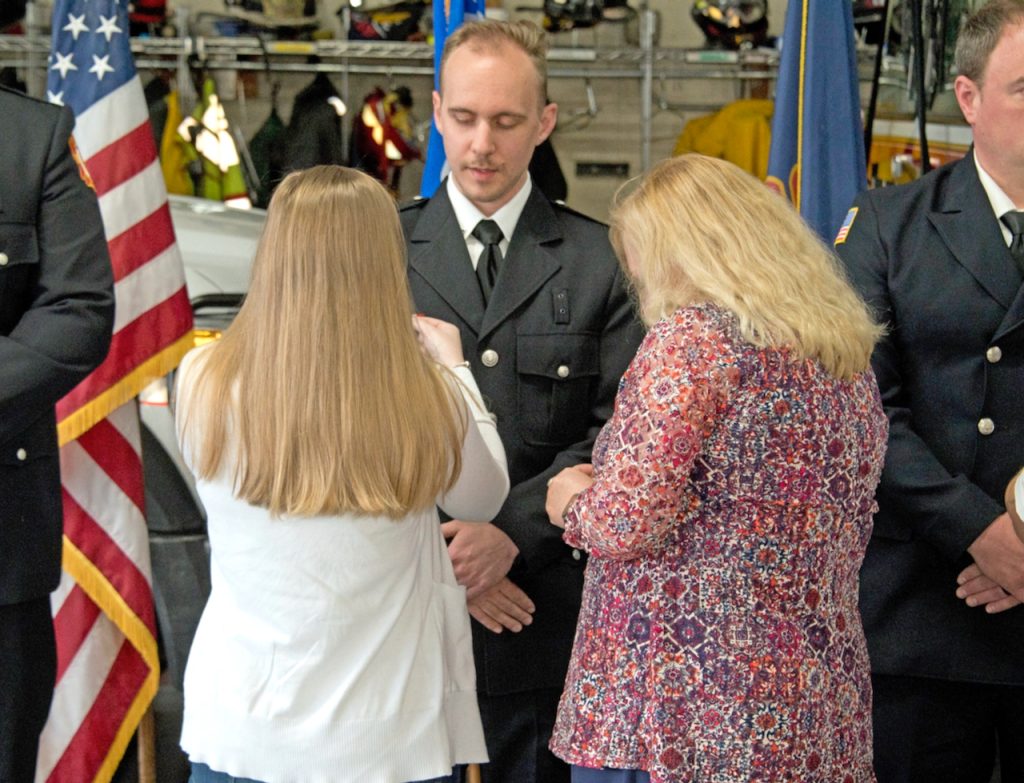
Whitewater Fire and EMS officer Carl Strait is pinned by family members.
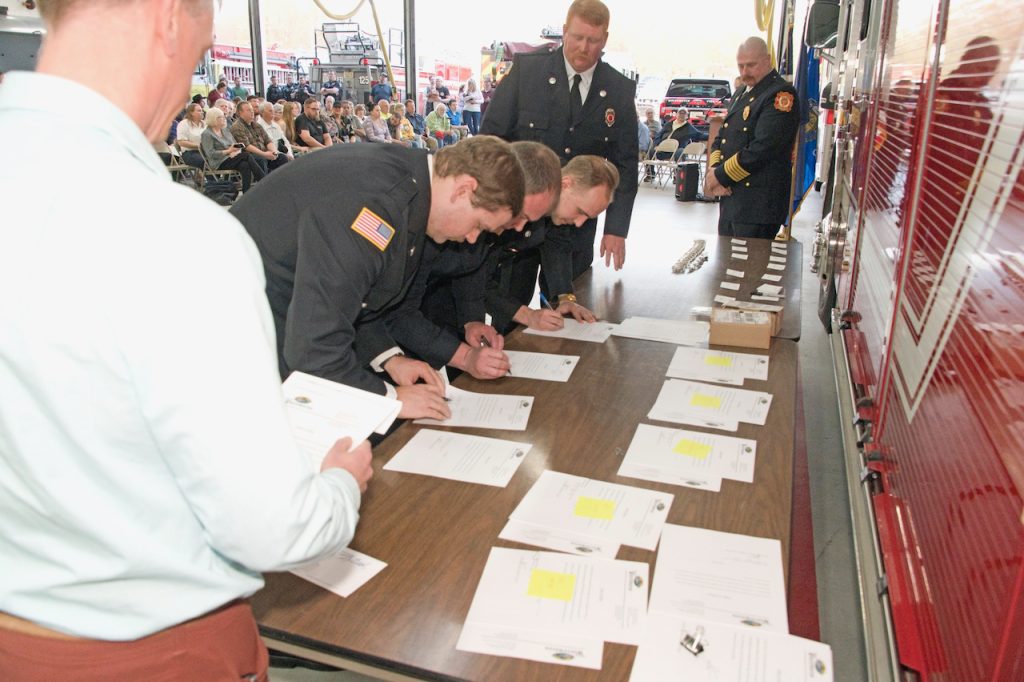
Whitewater Fire and EMS lieutenants sign oaths of office. They are Dustin Tomlinson, from left, Marshall Lewis, Carl Strait, Jacob Maas, and
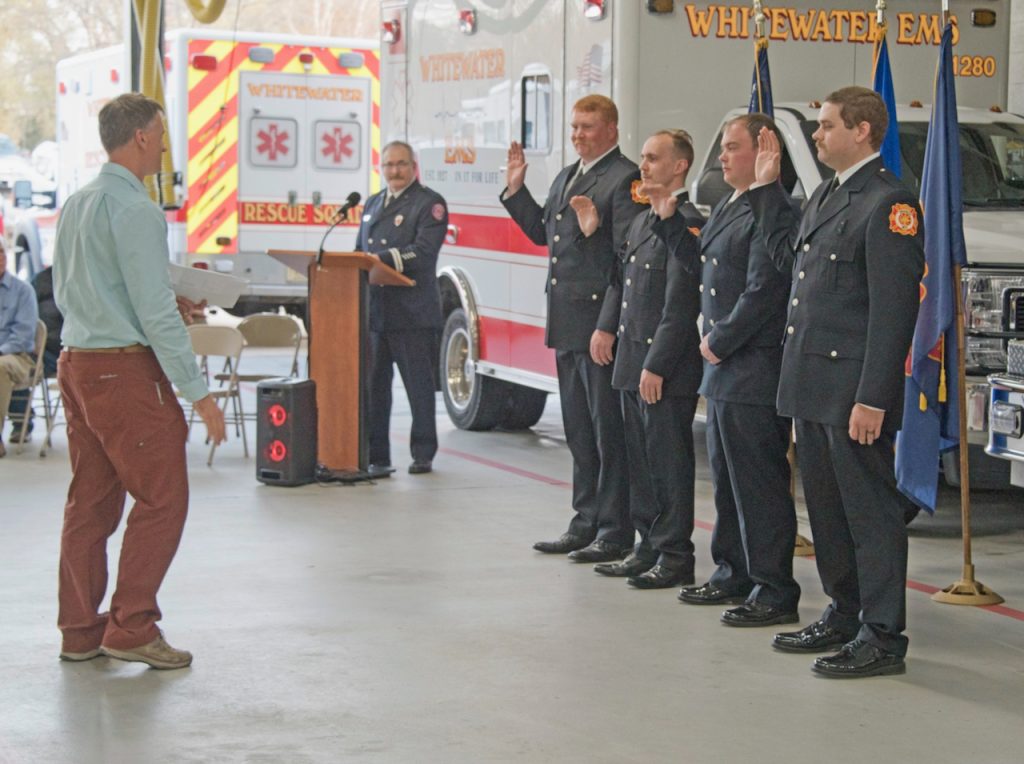
Whitewater Fire and EMS lieutenants take the oath of office. They are Jacob Maas, from left, Carl Strait, Marshall Lewis and Dustin Tomlinson.
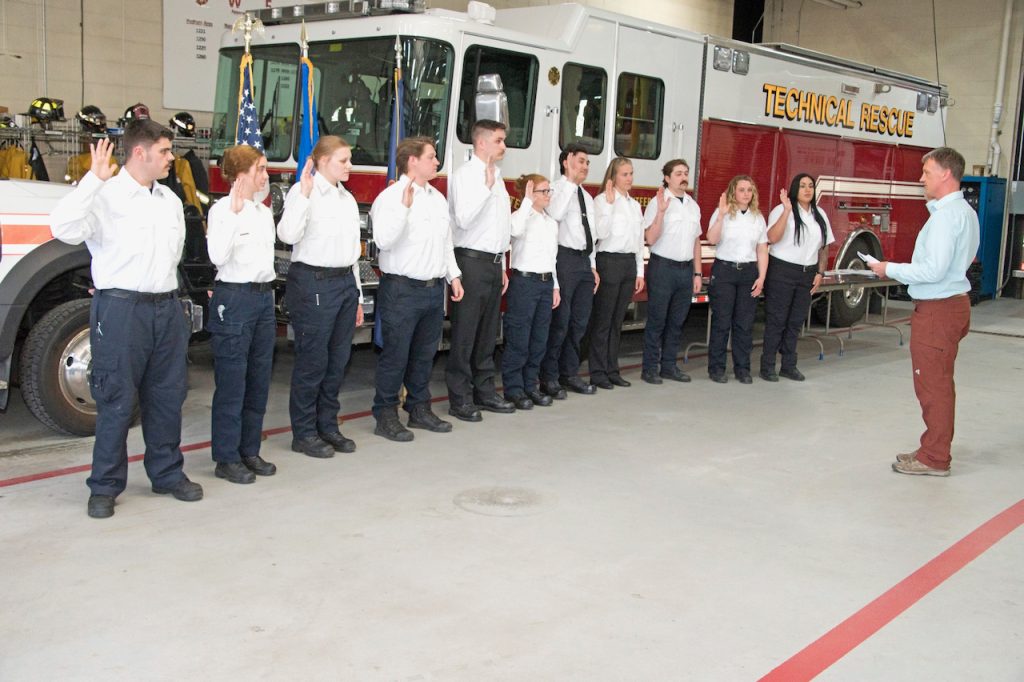
A group of full-time firefighters and EMTs take the oath of office. They are, not in pictured order, Benjamin Kastern, Alana Kolesar, Sylvia Netemeyer, Riley Walters, Crystal Griffin, Amanda Kraayvanger, Sean Oflanagan, Alexander Rohde, Ashley Dodd, Mikayla Fehl, and Tanner Stark. The group is complete with Carl Strait, who is not pictured.
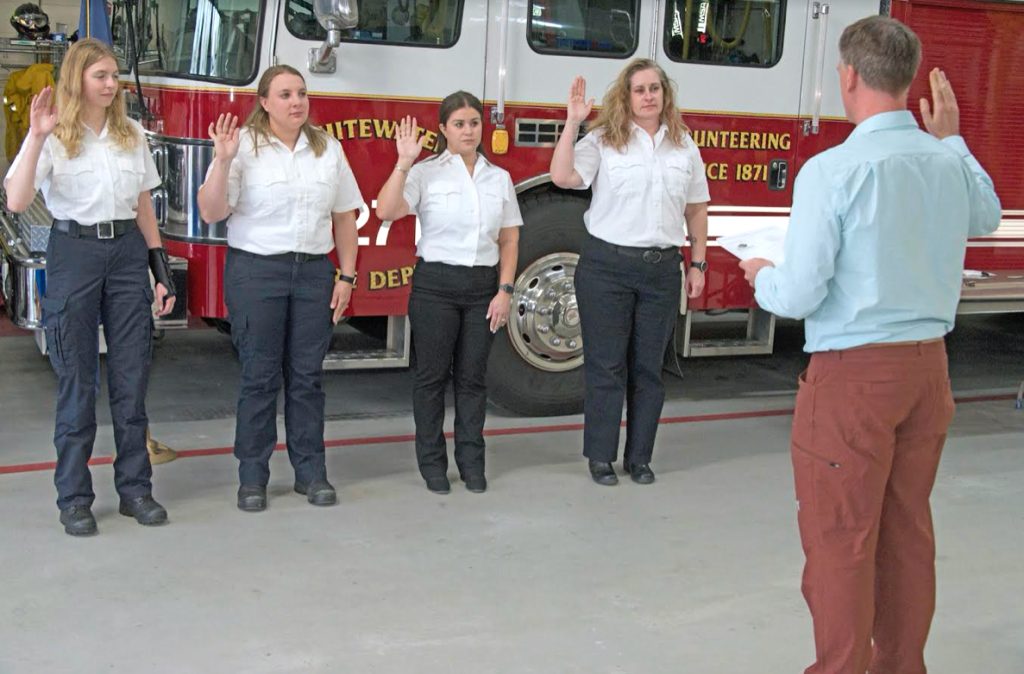
Members of the EMS staff, including Jenna Poole, from left, Jazmine Tomlinson, Kristen Lewis and Renee Monestero take the oath of office.
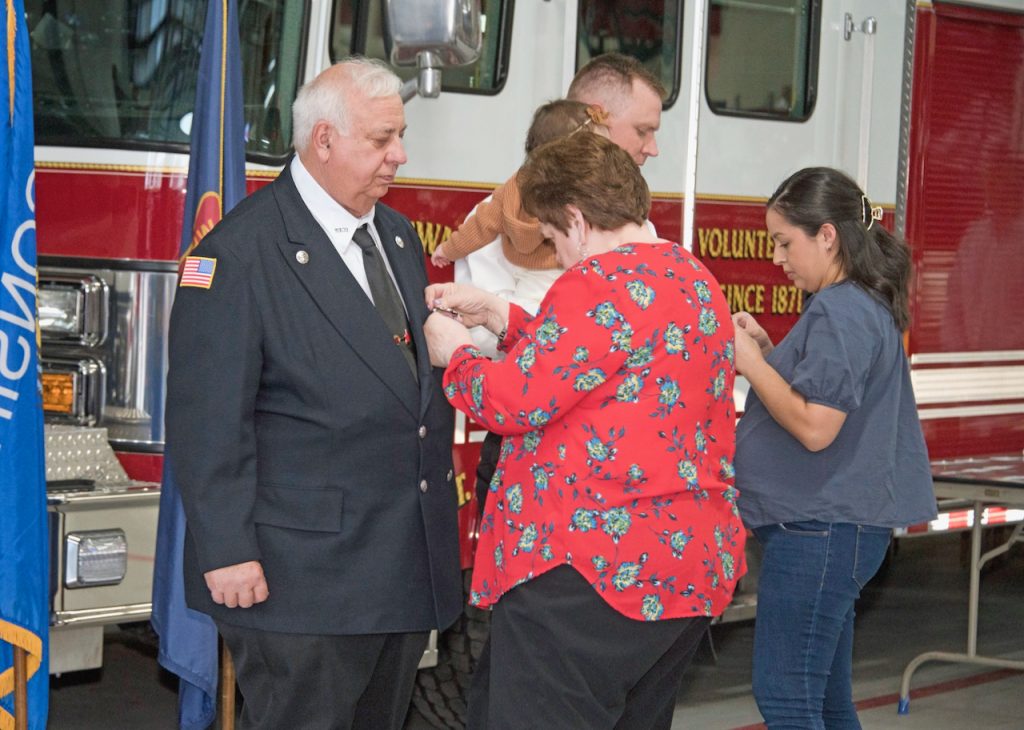
Paid on call firefighter Terry Phelps, at left is pinned by his wife, Sandy. In July, he will have served the department for 50 years, Chief Kelly Freeman said. Also pictured is paid on call firefighter Jonathan Brock, who is holding his daughter and being pinned by a family member.
Tom Ganser photos.
Officials share proposals in advance of upcoming aquatic center subcommittee meeting
(Originally published May 8, 2023.)
By Kim McDarison
City of Whitewater and Whitewater Unified School District officials have drafted proposals for future operations of the Whitewater Aquatic and Fitness Center, with a wide gap in terms offered between the two negotiating parties.
The two proposals are anticipated to come before the Whitewater Aquatic and Fitness Center Subcommittee during its next meeting, which will be held Thursday, May 11.
The subcommittee held its first meeting to negotiate a new contract between the city and district in March. A second meeting was held in April.
Two proposals
According to information shared with Fort Atkinson Online, city officials have proposed a 15-year agreement, which, Whitewater City Manager John Weidl stated in a recent email, “closely resembled the preexisting arrangement.”
The city and the district have operated the facility jointly through several negotiated contracts between 2001 and 2021, after which a contract, drafted by the city in 2021, went unsigned by the district. Earlier contracts between the city and the district shared the facility’s expenses equally between the two parties.
According to information shared by Weidl, the city’s proposed document stipulates that each organization — the city and the school district — would contribute $219,000 toward the facility’s expenses, which would require each organization to borrow or otherwise identify and earmark monies for capital equipment at a rate of $70,000 per year.
“The operational contribution is indexed at 3% per year,” Weidl noted, adding: “All of our budget assumptions moving forward have assumed increases for member growth at 5% per year and increases to membership fees per year at 3%.”
According to Weidl, the school district has proposed a contractual agreement which would be in effect for the next one to three years, and requires the city to absorb the facility’s operational costs in full. The proposed document stipulates that the school district would only assume responsibility for any borrowings associated with maintaining the facility.
Weidl noted that the district has offered to provide a $7,500 fee for its use of the facility for athletic and summer programming, but, he stated, the district’s usage of the facility creates costs of approximately $60,000.
“Their volume alone necessitates having the entire pool heated 365 days a year, which carries additional costs,” he wrote in an email to Fort Atkinson Online.
He cited summer programming, swim lessons, and high school athletics as among activities that place “a huge burden on the facility in a way that eats into the facility’s ability to raise revenue from other programming at this time.”
A proposal comparison, as shared with Fort Atkinson Online by the school district, notes that the proposed 1- to 3-year contract can be achieved without going to a referendum, further proposing that the district become responsible for maintenance, including: maintaining the building’s envelope, defined as roofs, windows, doors and masonry, along with the facility’s parking lots, HVAC, lighting, fire alarm systems and the pool floor. The proposal makes the city responsible for all of the facility’s operating costs, including utilities, pool chemicals, play structures and fitness equipment.
The district also proposes that it keep an annual budget of $250,000 in its Fund 80, a fund designated to cover district-supported community programming, for capital improvement expenditures and provide the city with a rental fee of $7,500, with those monies meant to cover the costs of summer school and the “swim season.”
Under a heading titled: “Deficit,” the district notes that, under the city’s plan, each entity would be held accountable for $222,008. The district is instead proposing that it be held accountable for $150,000 and the city would pay $300,000.
Horizon of repair needs
During the subcommittee’s last meeting, held April 11, the district introduced a document prepared at its request by J.P. Cullen, outlining some $5 million in capital improvements that could be made over a five-year period.
During the meeting, subcommittee member and city representative Lisa Dawsey Smith asked city staff to review the report and create a capital improvements “horizon of repair needs,” detailing more granularly which items on the J.P. Cullen report required prioritization.
Looking more broadly at the report, and assuming all the items would be required within a five-year window, the district’s Director of Buildings and Grounds David Friend, noted that expenses might be spread out over the five years at a cost of $1 million per year, with each entity, the district and the city, responsible for half, or $500,000 annually.
The full itemized report from J.P. Cullen is here: https://www.whitewater-wi.gov/AgendaCenter/ViewFile/Item/7281?fileID=28796.
A story about the April meeting of the subcommittee is here: https://fortatkinsononline.com/aquatic-center-subcommittee-considers-5-million-in-improvements-non-binding-referendum/.
In a recent email, Weidl wrote that the city, when looking at capital improvements, “has consistently said it will cost $140,000 per year and hasn’t changed its math.”
He expressed concern over the “mathematical discrepancies.”
Two options from a city perspective
In a memo from Weidl to Whitewater Parks and Recreation Director Eric Boettcher, a comparison between the two proposed contracts was outlined. Making comparisons over a three-year period, Weidl wrote that the option proposed by the city assumes an expense growth rate of 3% each year within a three-year period, a monthly membership rate growth of 3% each year, and a total membership growth of 5% in 2024 and 2025, and 3% in 2026.
Within the memo, “Option A,” which is denoted as the district’s recommended option, identifies the district as the lessor/operator, and makes the district responsible for “all capital improvements amounting to $250,000 per year,” as estimated by the district. Weidl noted in the memo that the city’s estimates for capital improvements is $140,000 per year. The district, within Option A, would contribute an additional $7,500 to fund school use of the aquatic center. The city would be responsible for covering costs associated with all other operational expenses, including utilities and chemicals. In the memo, Weidl noted that, would the city continue to contribute $128,000 toward operating expenses each year, operating shortfalls would occur as follows: $301,267 in 2024, $288,306 in 2025, and $282,910 in 2026.
As outlined in the memo, using “Option B,” which is denoted as the “previous agreement format of (a) 50/50 split,” each of the two entities, the district and the city, would be responsible for a payment to support operational costs of $219,000 in 2024, with that number increasing in subsequent years by an inflation rate of 3%. A total payment of $140,000, which would be split between each entity, would be placed in a capital improvements fund, which, the memo noted, is detailed in the city’s Capital Improvement Plan (CIP). According to the memo, “this would amount to an estimated surplus of $1,233 in 2024, $23,394 in 2025, and $38,190 in 2026.
Looking at a balance sheet generated by the city and using figures from Option A, under a heading of Aquatic Center — other financial sources, the district would contribute $7,500 and the city would contribute $128,000, for a total of $135,000. When added to such revenue sources as memberships, day passes, classes, room and facility space rentals, and income generated from the concession stand, gift certificates and donations, among others, the facility’s total operational revenue in 2024 is $551,203.
On the expense side of the balance sheet, in 2024, total operating expenses are calculated at $852,470, leaving an operating deficit in 2024 of $301,267.
A capital revenues and expenses balance sheet developed over a six-year period, 2021 to 2026, shows that in 2021, with each entity contributing $50,000, the facility had revenues of $100,000 and expenditures of $9,990, leaving a balance of $90,010; in 2022, with each entity contributed $50,000, the facility showed revenues of $100,000, and expenditures of $18,275, leaving a balance of $81,725; in 2023, the balance sheet shows a revised budget, with each entity contributed $50,000 for a total of $100,000, with no money spent on improvements this year, according to the document. In the years 2024 through 2026, the document shows revenues to be contributed by the school district in an amount between $140,000 and $148,526, with no improvements identified.
Looking at Option B, each entity would be expected to contribute $219,000 toward the operational expenses of the facility, bringing a total amount through “other financial sources” of $438,000, which, along with revenues brought from such sources as memberships, day passes, classes, room and facility space rentals, and income generated from the concession stand, gift certificates and donations, among others, would provide a total operating budget in 2024 of $853,703.
In 2024, on the expense side of the budget, total expenditure are calculated at $852,470, leaving a balance of $1,233.
A capital revenues and expenses balance sheet developed over a six-year period, 2021 to 2026, shows the same revenues and expenses, between 2021 and 2023, as the document developed in Option A. Continuing with the 50/50 split concept, in 2024, each entity would be responsible for a contribution of $70,000, creating total revenues of $140,000. Contributions made by each entity would increase to $72,100 in 2025, and $74,263, in 2026.
The full balance sheet from the city’s Fund 247, the Aquatic Center Special Revenue Fund,” is here: http://fortatkinsononline.com/wp-content/uploads/2023/05/Memo-WAFC-Options-A-and-B-1.pdf.
An equipment list and replacement plan, as developed by the city, also has been shared with Fort Atkinson Online. A link to the list is here: http://fortatkinsononline.com/wp-content/uploads/2023/05/Citys-equipment-list-.pdf.
The city also has generated a “Whitewater School District Facility Use Summary,” which, Weidl noted, shows a breakdown of operating expenses associated with facility use by the school district.
According to the document, some $63,133 in district programming expenses is attributed to “facility costs,” represented in 660.5 hours at a cost of $50 per hour, for a total of $33,025, and “staffing costs,” coming at a cost of $30,108.
The document further outlines costs associated with summer swimming lessons, attributing costs of $40 to each of 215 children who use the program, for a total cost of $8,520 for the district’s swim program. Costs associated with the program’s staffing include monies paid for lifeguards and instructors.
Also itemized within the document are costs associated with the district’s swim team pool use.
The full itemized document as presented by the city is here: http://fortatkinsononline.com/wp-content/uploads/2023/05/WUSD-Facility-Use-Summary.pdf.
A shift in funding allocations
In August of 2022, the school board received, during its regularly scheduled meeting, a preliminary budget presentation from the district’s Director of Business Services Ben Prather.
Aided by slides, Prather noted that the August budget was preliminary and would likely be revised in October, after the district received its levy certification from the state.
Offering a slide, Prather, defining highlights, cited the district’s Fund 39 debt.
“That has dropped about $2 million from our last levy, so that’s from our debt defeasance,” he said.
Prather noted that the district had been “putting money away” into its Fund 41, with the goal of repairing “aging buildings.”
Additionally, he cited the district’s Fund 80, which is used to fund community-based programming, including the aquatic center, he said.
Looking at expenses identified within the preliminary budget in Fund 80, Prather said: “The big jump is the aquatic fitness center. There is a lot of big costs, we had C.G. Schmidt audit this back in January and they quoted about $2 million in expenses that we maintenance. I thought this was an opportunity for us to be able to be prepared for when our boilers break, when our HVAC does shut down, and when we need to replace the aquatic center pool surface, which has been quoted as, since they drained it, needs maintenance and repair, so this is what Fund 80 looks like.”
The slide showed an allocation of approximately $1.3 million for aquatic center expenses.
After the presentation, board member Larry Kachel said: “You’re saying you are going to need $1.3 million in the Fund 80 designated for the aquatic and fitness center.” He asked: “That money would come from where?”
Prather responded, saying: “That’s built into the levy.”
Prather said the district would plan to pay approximately $7,000 for pool use by the swim team. He cited a figure of $130,000 as an ongoing obligation to the pool.
Kachel noted that he believed the district’s obligation to the aquatic center would be increasing. He cited a figure of $178,000. He asked if that money would come from Fund 80.
Prather said it would.
Citing the C.G. Schmidt report, Kachel asked: “And then $2 million is assumed to be a split on the cost between the city and the school district?”
Prather said a meeting was planned between the city and the district to discuss that number, noting his proposed budget was “very preliminary.” He added: “This is assuming that we’re prepared for a rainy day that’s coming, because there is maintenance that is especially needed.”
Kachel asked if the building’s roof was included in the preliminary numbers.
Prather said that he was estimating roof repairs at $200,000, and was advised by Friend that the expense was “something that the city expects the school district to pick up.”
Board member Maryann Zimmerman expressed concern about costs associated with the pool, calling the aquatic center a “money dump.”
She suggested the district might look into another organization, such as the YMCA, to operate the facility.
“The city doesn’t know how to do a pool, we probably — its too much for us. It’s a lot of money,” she said.
Additionally, she asked if the board could request from the city to see its books, asking: “How much are they making? Like has anyone seen their books? Can we see their books?”
She described information shared with the board about the aquatic center’s operational income as “kind of nebulous.”
“I know the community needs it and the community wants it, but it kind of looks like it’s falling to the school district to pay for this and it’s a lot of money on top of like everything else,” she said.
Said Prather: “I think some of the issues were inherited from when this partnership (with the city) began in 2016, but they do have operational budgets that we can get our hands on and share with the board, absolutely. Again, this is just a preliminary look; this is just ideas that, that hey, these are some liabilities that maybe we can tackle or at least be prepared to tackle. So we are not committing anything, we’re going to revise this whole budget come October, we’re going to have a lot more discussion, but that was something that was outlined, and I thought, hey, maybe the district needs to be prepared.”
Then-board member Steve Ryan, who also was a member of the city’s Parks and Recreation committee which operates the pool, said that while he agreed with Zimmerman that the preliminary budget showed figures that were “hard to look at,” he said upcoming maintenance expenses could be attributed to the building’s age, adding that the building was 24 years old.
“We own it and the city runs it. We are in cooperation,” he said.
He noted that some of the building’s equipment, like boilers, was reaching the end of its lifespan.
Last October, the board approved its revised budget.
During his October budget presentation, Prather showed a slide noting that the total allocation of funding in Fund 80 was $318,000. A breakdown of monies allocated for items within Fund 80 was not provided.
Said Prather: “Fund 80, that’s anything that involves the community, so that’s the aquatic center, middle school athletics — we are opening it up to all families — homeschooling in the district, our EL programs for adults after school.”
Prather said the budget would require a total levy of $16.9 million, which he described as a reduction of more than $1.2 million from the previous year’s levy.
“One other thing to really highlight is the overall ask from the school district’s portion of the levy went down $1.2 million. Part of that was debt defeasance, so the district’s ask is less than the overall levy, that’s why it went down,” he said, adding: “We can say with confidence that we are asking the taxpayers for $1 million less than what we did last fall.”
Comments from residents
During the board’s most recent meeting, held April 24, Kachel, who was elected school board president, stated that he was officially stepping down from the Whitewater Aquatic and Fitness Center Subcommittee and noted that board member Miguel Aranda was officially taking his place. Aranda was seated among subcommittee members representing the school board during the subcommittee’s meeting held in April. School Board member Lisa Huempfner also was appointed to the subcommittee. She will be filling the seat vacated by former board member Thayer Coburn.
During public comments, several community members came forward, including Geoff Hale and Guy Ledwell, both of whom are organizing members of a community group called “Save the Pool,” which was formed after the first meeting of the subcommittee held in March.
A link to a story about the group, and its first meeting, held in April, is here: https://fortatkinsononline.com/save-the-pool-community-members-assemble-regarding-aquatic-center-negotiations/.
Hale also read comments provided by Jeff Knight, another organizing member of the Save the Pool group, who, Hale said, was unable to attend the meeting.
Addressing school board members, Hale said his topic of discussion was ESSER funds, which he described as monies received by school districts through a federal program called Elementary Secondary School Emergency Relief. The program was formed to help school districts statewide with funding options during the COVID-19 pandemic.
Said Hale: “If it smells fishy, if it sounds foolish, if it looks foreign, it’s likely foreign, foolish and fishy. It’s likely you might be getting scammed. Time and again requests from concerned citizens to disclose how our ESSER funds were used have been repeatedly stonewalled by our superintendent.”
Hale asked the board to provide an accounting of how the district’s ESSER monies were spent.
“We ask for transparency and full disclosure for how the ESSER monies were utilized,” he said.
He called the district’s sports program “failing,” adding that, “Great sports teams are built from great leadership and inspirational coaching.”
He suggested that the district should consider looking to members of the public who were not necessarily members of the district’s staff to secure “fantastic coaches to help us excel in sports.”
He next read a statement from Knight, the full text of which has been shared with Fort Atkinson Online.
Within his statement, Knight said he was commenting as a member of the Save the Pool group. He, too, asked for a better understanding from the district about its use of its ESSER funds, and information about how it might spend any remaining ESSER dollars. He requested that the board consider allocated some portion of any remaining ESSER fund to pay for equipment at the aquatic center.
In his statement, Knight wrote: “My second focus would be on the preliminary budget number published in your August 2022 agenda showing $1,365,475 for the WAFC. What was really difficult for me as I was going through your official minutes was to understand how all that proposed allocation disappeared. It would be helpful for everyone in the community if the school board could explain their action so we could better understand why that was done.”
Ledwell, too, asked for information showing how the district’s ESSER funds were allocated, asking the district to provide information “at a somewhat granular level, not generalizations,” along with an accounting of any future uses for any remaining funds.
Said Ledwell: “Another something else that I don’t quite understand, I was looking at the budget for 2022-23, and I saw like $1.3 million in there, is what I saw for the aquatic center, and I was wondering where that went to or how that might have been spent or used?”
School district resident Mark Maas, too, asked about the ESSER funds and the approximately $1.3 million that had been previously proposed by the district to support the pool. He encouraged the board to consider grant writing for pool funding, and said he would ask city officials to consider the option as well.
In a recent telephone interview, Kachel said monies moved from the district’s Fund 80 were used to pay down debt service.
Among monies remaining in the fund, he said $178,000 was earmarked for the pool, with the remaining funds required to cover costs associated with other Fund 80 expenses.

A comparison, offered above, of the two aquatic center proposals as produced by Whitewater City Manager John Weidl.

A comparison, offered above, of the two aquatic center proposals as produced by the Whitewater Unified School District.

Two slides above, as shared during a presentation in August made to the Whitewater Unified School District Board of Education by Director of Business Services Ben Prather, show the full 2022-23 preliminary budget of $40.4 million, at top, including a proposed allocation of $1.5 million within the district’s Fund 80. A second slide, also shared in August, shows the breakdown of allocations within Fund 80, including approximately $1.3 million for the aquatic and fitness center.

A slide, above, shows funds of $318,000 placed in Fund 80 as part of the district’s revised budget approved by the board last November. According to School Board President Larry Kachel, funds previously placed in Fund 80 in August were instead used for debt defeasance, which enabled the district to reduce its taxpayer levy by $1 million.
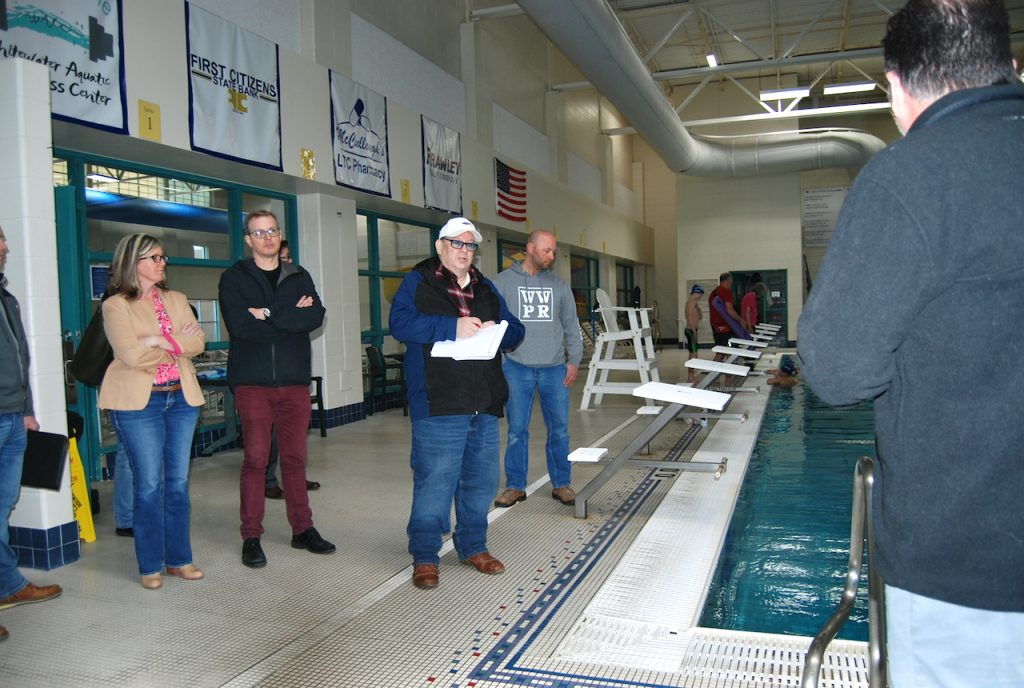
City of Whitewater and Whitewater Unified School District officials, many of whom also are members of the Whitewater Aquatic and Fitness Center Joint Subcommittee, tour the facility. The tour was held in February. A first meeting of the subcommittee was held in March. A third meeting will be Held Thursday, May 11, at the Whitewater Municipal Building. Kim McDarison photo.
Eighty ‘Extraordinary Women’ attend library fundraising kickoff event
(Originally published May 11, 2023.)
Editor’s note: Irvin L. Young Memorial Library Director Stacey Lunsford has contacted Fort Atkinson Online stating that the cost of the total library project has been increased to $6 million “due to inflation.”
By Kim McDarison
A fundraising campaign to help raise money for improvements to the Irvin L. Young Memorial Library, Whitewater, began with a kickoff event held Saturday, according to event organizers.
The campaign, titled: “100 Extraordinary Women,” began with a luncheon which was attended by approximately 80 women, according to information released by organizers, although fundraising efforts, thus far, have been supported by 129 women, each of whom have contributed at least $1,000, the release noted.
Saturday’s luncheon, which also served as an opportunity to thank the women for their support, was sponsored by First Citizens State Bank, and held at the Community Engagement Center, Whitewater.
Attendees were invited to wear a hat in honor of Kentucky Derby Day. The race, which is run by 3-year-old Thoroughbred horses, is in its 149th year, and also began Saturday, in Louisville, Ky.
According to the release, a goal set for the 100 women fundraising campaign was $100,000, which, the release reported, has, thus far been surpassed by contributions of $50,000.
“The funds used from that portion of the fundraising campaign will be used to create a beautiful outdoor space with seating areas, WIFI, solar lights and other amenities,” the release stated.
The 100 Extraordinary Women campaign is connected to a larger campaign to raise $2.25 million to fund renovations at the public library in Whitewater, the release added.
According to campaign organizers, $1.8 million has been raised thus far. A campaign to raise $450,000 is still underway.
As stated within the release and according to Irvin L. Young Memorial Library Director Stacey Lunsford, renovations planned for the library will focus on “the top three areas” that have been identified by community members as “needed.”
They include an expansion of early learning areas, gathering spaces, and the library’s Makerspace area.
Within the release, learning areas are described as spaces that will include play centers and areas where children can gather. Adult-focused gathering spaces will include areas where visitors to the library can learn from one-another. Plans include larger meeting rooms with collapsable walls.
A larger Makerspace will be able to accommodate such tools as a 3-D printer, sewing machine, and a laser dye cut machine, among others, the release stated.
As outlined during a Whitewater Common Council meeting held in 2021, the full project proposal comes with a price tag of $5 million, with the city council approving, in December of 2021, a resolution stating its intent to contribute $3 million to the project, with the stipulation that the library board can obtain the remaining $2 million.
Monies to fulfill the city’s contribution will be included in its 2024 budget, officials said in 2021.
The full proposal includes a 7,000-square-foot addition to the library with renovations made to the existing building.
An earlier story, outlining the library’s full $5 million expansion and renovation project, is here: https://fortatkinsononline.com/whitewater-city-commits-3-million-towards-5-million-library-renovation-project/.
Those interested in learning more about fundraising campaigns underway to support the library, including joining the 100 Extraordinary Women group, can contact Lunsford by phone: 262-473-0530.
Donations also can be made through the Whitewater Community Foundation. Donations should be directed to the attention of the Irvin L. Young Memorial Library, P.O. Box 428, Whitewater WI 53190.
The Irvin L. Young Memorial Library, 431 West Center St., is free and open to the public Mondays through Thursdays, 9 a.m. to 8:30 p.m.; Fridays, 9 a.m. to 5:30 p.m., and Saturdays: 9 a.m. to 3 p.m. The facility is closed on Sundays.
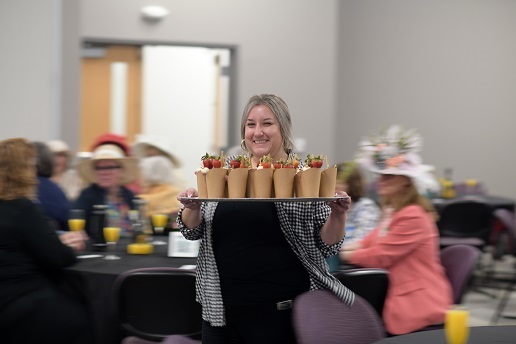
A representative from Annie’s Burger Town offers beverages during the “100 Extraordinary Women” event. The luncheon, which was attended by some 80 women, kicked off a fundraising effort in support of renovations at the Irvin L. Young Memorial Library, Whitewater. The event also served to thank the women, each of whom had donated $1,000 to the project.
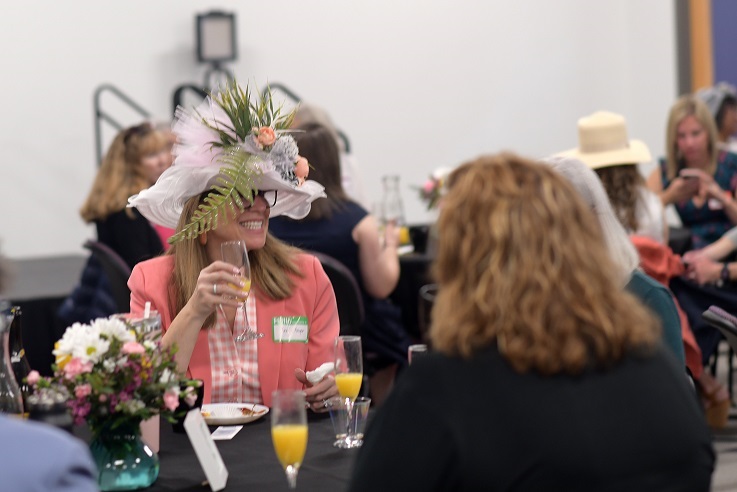
Karen Mayer, sporting a hat of her own creation, enjoys the luncheon event. Event-goers were invited to wear hats in recognition of the 149th Kentucky Derby, which also was underway, albeit in Louisville, Ky., on Saturday.

Kat Mawhinney, at center, and Therese Kennedy, at right, are among guests in attendance Saturday.
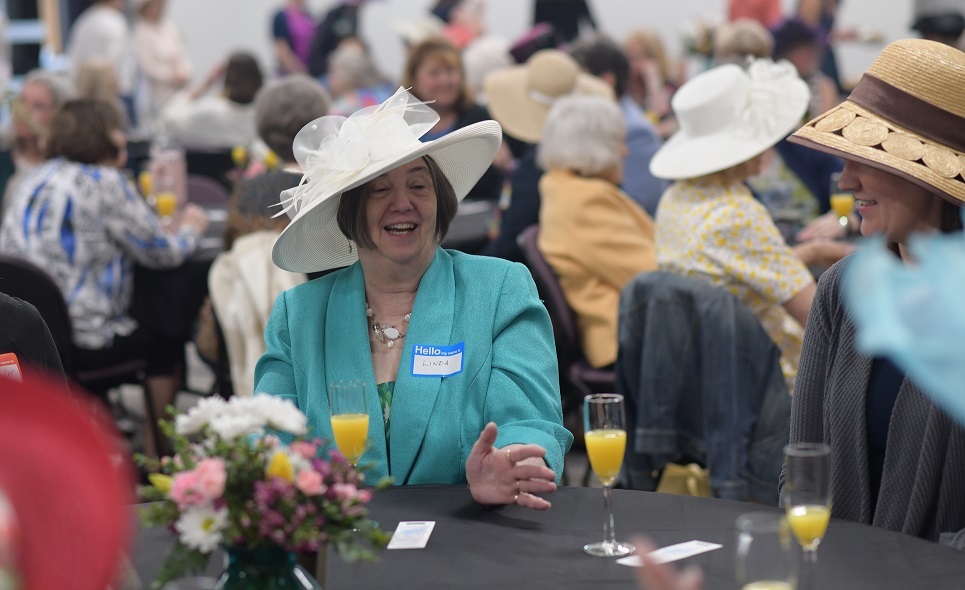
Donning a festive hat, Linda Robinson is among 80 women attending the event.
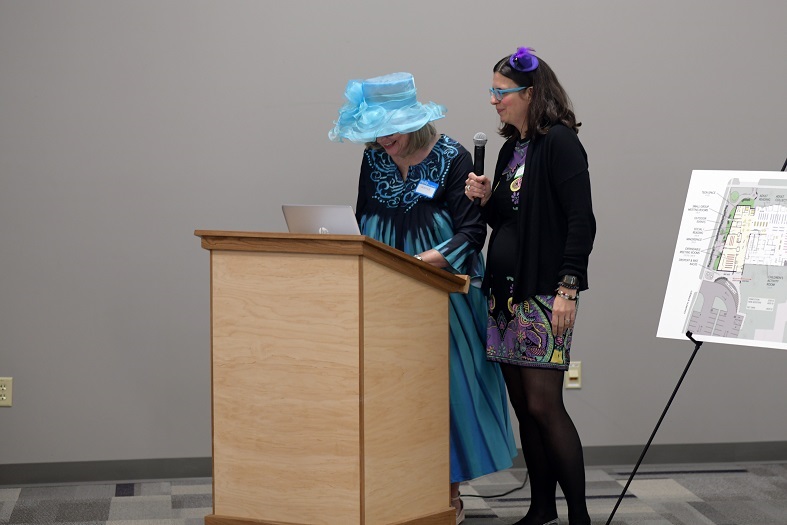
Fundraising committee members Gayle Stettler, from left, and Kelly Davis arrive at the podium to begin the event’s presentation.
Photos courtesy of the 100 Extraordinary Women fundraising committee/Zachary Popke.

A graphic, above, shows an artist’s rendition of interior renovations planned for the library as part of a $5 million renovation and addition proposal. A story about the proposed project, including financing and fundraising plans, is here: https://fortatkinsononline.com/whitewater-city-commits-3-million-towards-5-million-library-renovation-project/. Contributed graphic.
Whitewater PD: Fort Community Credit Union robbery under investigation
(Originally published May 12, 2023.)
The Whitewater Police Department has received a report of a robbery at the Fort Community Credit Union (FCCU) at 203 E. Milwaukee St. in Whitewater, according to information released by Whitewater Police Chief Dan Meyer.
The report was received by police Friday at 3:29 p.m., the release noted.
As stated in the release, officers were immediately dispatched. Through subsequent investigation, officers determined that at approximately 3:11 p.m., a male suspect entered FCCU wearing sunglasses, a black medical mask, a gray zip-up hoodie over a bright yellow shirt with dark lettering beginning with the letter “Y” that was larger than the rest of the lettering on the upper chest, and dark cargo pants.
The suspect was carrying a fabric lunch tote and wearing a single glove. The suspect is a white male, approximately six feet tall, with a slender build, according to the release.
The suspect approached the counter with a note demanding money. No weapon was shown or implied. The suspect was given an undisclosed amount of money and left FCCU at approximately 3:14 p.m. in what is reported to be a dark hatchback vehicle with white stripes, possibly a newer model Mini Cooper.
Whitewater Police are seeking any information that may assist in the investigation. Anyone with information is asked to contact the Whitewater Police Department at 262-473-0555 option #4. Anonymous tips may also be shared using P3Tips.com.



Three photos above: Photos show an individual, described by the Whitewater Police Department as male, wearing sunglasses, a black medical mask, a gray zip-up hoodie over a bright yellow shirt with dark lettering beginning with the letter “Y” that was larger than the rest of the lettering on the upper chest, and dark cargo pants. Police are seeking help from the public in identifying the individual. Contributed photos.
Mother of baby found dead in Whitewater field to stand trial
(Originally published May 12, 2023.)
By Kim McDarison
Santos Asucena Caseres Cruz, a 39-year-old Whitewater woman accused of neglecting a child with a consequence of death, will be held over for trial, according to information released Friday on the Wisconsin Circuit Court Access Website.
Caseres Cruz, along with her attorney Jeffrey De La Rosa, appeared Friday before Jefferson County Circuit Court Judge William F. Hue.
During the preliminary hearing, Whitewater Police Detective Anthony Heilberger testified and was examined and cross examined by both Caseres Cruz’s attorney and Jefferson County District Attorney Monica Hall.
According to the criminal complaint filed with the Jefferson County District Attorney’s office on March 28, Heilberger, on March 3, attended an autopsy of the infant’s body performed by the Milwaukee Medical Examiner’s Office.
On March 23, Heilberger received photographs from the Wisconsin State Crime Lab, resulting in forensic imaging of a shipping label, which led detectives to Caseres Cruz.
Heilberger was among detectives present during an interview of Caseres Cruz prior to her arrest, the criminal complaint states. He also is identified in the criminal complaint as having interview at least one witness associated with the case.
After hearing arguments given by counsel, the court found probable cause to bind Caseres Cruz over for trial during which time she will face a Felony D count of neglecting a child with a consequence of death and a Felony F count of moving, hiding or burying a corpse of a child.
As defined by Wisconsin state statutes, a Class D felony carries a maximum penalty of 25 years in prison or a fine of up to $100,000. A Class F felony carries a maximum penalty of 12.5 years in prison or a fine up to $25,000.
Also during the preliminary hearing, the court set an arraignment date of June 15, with the defendant appearing in court at 2 p.m.
The court continued bond as previously set.
Appearing before Judge Hue via video conference on March 28, a cash bond of $10,000 was set with the conditions that the defendant surrender any passport, not leave Jefferson County, and report and comply with a GPS monitoring program administered by Wisconsin Community Services.
According to court documents, the defendant would be released from custody “on GPS monitoring only.”
Caseres Cruz was taken into custody by the Whitewater Police Department in March after which she was confined in the Jefferson County Jail.
According to information released by the Whitewater Police Department, charges of concealing death of a child and resisting or obstructing officers were forwarded to the Jefferson County District Attorney’s office.
Charges filed against Caseres Cruz allege her involvement in the placement of a body, described by police as that of a newborn baby. The body was discovered by police on the morning of March 4, in a field behind the Twin Oaks Mobile Home Park on Tratt Street, in Whitewater.
The Whitewater Police Department, offering information in March, noted that the body was male, and discovered in a plastic bag, inside a cardboard box. The body was wrapped in a light-colored shirt.
According to the criminal complaint, Caseres Cruz is alleged to have given birth to the baby at home in a bathtub. The complaint further alleges that Caseres Cruz was of the belief that the baby, when born, was not breathing, and she therefore believed it was dead.
Police indicated, within the complaint, that her statement was “modified,” alleging that the defendant had earlier said that she knew the baby was alive when he was born, but was possibly choking.
After the baby was born, he started “getting purple,” the defendant told police, according to the complaint. As the night went on, the complaint continued, the baby’s arms and hands also turned purple.
According to the complaint, the defendant told police that she did not call 911 because she was scared her children would find out that she had been pregnant.
The complaint states: “The defendant said approximately half an hour after she gave birth and set the baby under the sink in the plastic bag, her other children were asleep and quiet. She retrieved the baby from inside the cabinet, wrapped the baby in a pink sweatshirt and put the baby inside a cardboard box. She placed the box on her bed and cried all night.”
At approximately 4:30 a.m., the complaint reported, the defendant removed the baby from the bag, cut the umbilical cord to separate the baby from the placenta and placed the baby in a black garbage bag. At approximately 5 a.m., she drove to the field near the Tratt Street Twin Oaks Mobil Home Park and left the baby behind.
“She said she checked on the box every day and cried,” according to the complaint.
A candlelight vigil in the baby’s memory was held by members of the Whitewater community in March.
The baby, who came to be called “Baby Oak,” was buried in April in Whitewater’s Hillside Cemetery, according to police.
The full criminal complaint alleging charges against Caseres Cruz is here: http://fortatkinsononline.com/wp-content/uploads/2023/03/Complaint-Criminal_2-Caseres-Cruz-Santos-Asucena-2023CF000114-Caseres-Cruz-Santos-Asucena_3049727_1.pdf.
An earlier story detailing the arrest of Caseres Cruz is here: https://fortatkinsononline.com/whitewater-woman-charged-with-neglecting-a-child-resulting-in-death/.
An earlier story about the candlelight vigil held in the baby’s memory is here: https://fortatkinsononline.com/sixty-attendees-hold-candlelight-vigil-to-mourn-babys-death/.

File photo.
Singer named Greater Whitewater Committee chairperson
(Originally published May 12, 2023.)
The Greater Whitewater Committee (GWC) earlier this month announced that Crystal Singer has been installed as the chairperson of the organization.
Singer follows outgoing chairman Larry Kachel who announced earlier this year that he would be stepping down from the role.
GWC President Jeff Knight, within the release, noted that Singer is a founding member of the organization, describing her as “a strong supporter of everything we do.”
Additionally Knight was quoted as saying in the release: “While Larry will be missed, we understand that his commitments to the school board and his business are important to him. Crystal is immensely qualified to take over this role, and we are excited to see what we can accomplish under her leadership.”
Kachel was installed last month as president of the Whitewater Unified School District Board of Education.
As noted in the release, Singer is the CEO of Whitewater Manufacturing, a fourth-generation, female-owned business. A company goal includes maintaining continuous improvement practices and procedures that enable it to meet and exceed customer expectations within the community.
Additionally, the release stated, Singer is active in the Whitewater community, serving on many boards as well as the GWC.
“I am very fortunate to follow in the footsteps of Larry Kachel, who has done an amazing job over the past 10 years. He cares so much about this community, and I certainly have big shoes to fill. I wish Larry the best in his endeavors, and hope to demonstrate the same level of effective leadership as I take on this role,” Singer was quoted as saying in the release.
As a member of the GWC, Singer has served as treasurer. Whitewater Manufacturing has served in an ongoing capacity as a title sponsor of the GWC’s Discover Whitewater Series half marathon and 5k event each fall, the release noted.
About the GWC
According to the release, the GWC is an action-oriented group committed to working with citizens, elected officials, and policy makers to identify, craft, and implement a pro-business agenda. Its goals are to advance the economic, educational, and social policies required to energize and secure the Whitewater area’s economic future, as well as protect Whitewater’s quality of life.
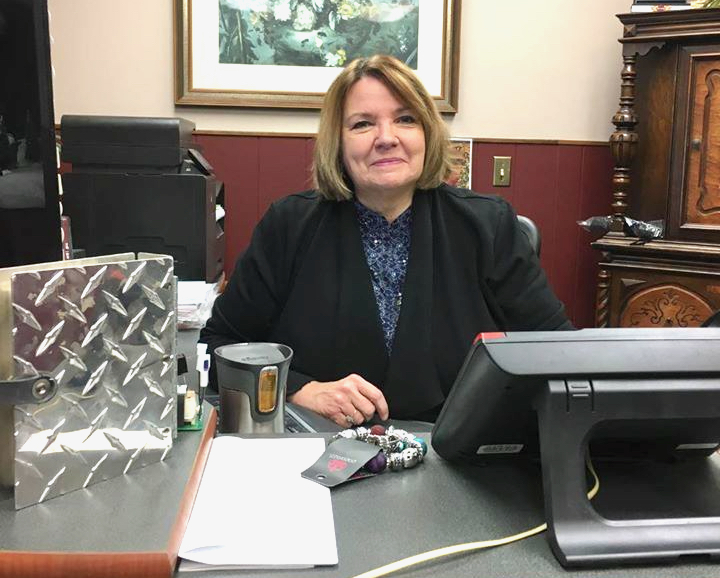
Crystal Singer, contributed photo.
‘Save the Pool’ community group slates next meeting
(Originally published May 13, 2023.)
A meeting in May has been slated by the “Save the Pool” group, a community-led, informal committee formed, according to its organizers, to “keep the public informed of the value of Whitewater’s beloved Aquatic and Fitness Center.”
The group held its initial meeting in April.
An earlier story published by Fort Atkinson Online about the group’s April meeting is here: https://fortatkinsononline.com/save-the-pool-community-members-assemble-regarding-aquatic-center-negotiations/.
The group’s next meeting will be held Wednesday, May 17, at 6 p.m., at the Cravath Lakefront Community Center, 341 S. Fremont St., Whitewater.
According to information released by committee organizers, the meeting will focus on “issues raised” during the most recent meeting of the Whitewater Aquatic and Fitness Center Subcommittee, which was held Thursday in the council chambers of the Whitewater Municipal Building.
The subcommittee is composed of representatives from the two negotiating bodies, the Whitewater Unified School District and the Whitewater city government.
The group is charged with negotiating a lease and operating agreement between the two parties.
Within the release, Save the Pool organizing member Jeff Knight described the two negotiating parties as “(further) apart than ever,” adding: “it is urgent for people to come to our meeting to hear the issues that were raised and to advocate for an adequate solution.”
For more information about the community-led committee, visit its Facebook page.
To learn more about becoming a Save the Pool member, contact one of the following organizing members: Cheri Zimdars: zimdars@hotmail.com or 608-449-5150, Guy Ledwell: ledwellguy@gmail.com or 262-649-7040, Knight: jpk@knightpublicaffairs.com or 920-728-0662, and Geoff Hale: ghale@hometops.com or 920-723-2387.

“Save the Pool” meeting organizers Jeff Knight, from left, Geoff Hale, and Cheri Zimdars offer information and field questions during a meeting of the community-led group held in April. The meeting focused on public engagement as the Whitewater Aquatic and Fitness Center Subcommittee works through a negotiation process to create an operating and lease agreement for the facility. The Save the Pool group’s next meeting will be held Wednesday, May 17, at the Cravath Lakefront Community Center, Whitewater. File photo/Kim McDarison.
WUSD offers statement regarding Whitewater Aquatic and Fitness Center negotiations; City offers response
(Originally published May 15, 2023.)
Editor’s note: The following statement, regarding Whitewater Aquatic and Fitness Center contractual negotiations, dated Friday, May 12, has been released by the Whitewater Unified School District’s superintendent’s office. The statement is followed by one released on Monday, May 15, in reply by the Whitewater city manager’s office.
From the Whitewater Unified School District’s superintendent’s office:
Last evening, the Whitewater Aquatic and Fitness Center negotiations of The Whitewater Unified School District (WUSD) met with the city of Whitewater committee to continue negotiating the joint agreement that operates the aquatic center facility. The WUSD committee communicated that they value and support the community pool and facility and are committed to coming to an agreement. However, the School Board aims to find a solution that focuses on the facility maintenance and capital planning rather than the operation of an aquatic facility and fitness center business.
WUSD committed to paying half, $220,000, of the previously accumulated operational deficit from the aquatic center in order to clear the financial path of negotiations. However, that commitment came with the caveat that the district does not want to continue to be responsible for the operations or future accumulation of debt based on the operation of the business inside of the facility moving forward.
“The education of our students must be the top priority when making financial decisions moving forward. We are not in the business of running a recreational pool and fitness center,” stated the committee chair for WUSD, board member Jennifer Kienbaum. Historically, WUSD utilizes the lap pool for swim team and swim lessons, not the recreational pool or the fitness center.
The City of Whitewater’s full contract budget request from WUSD of $4.3 million over a 15-year contract is the equivalent of 4.5 full-time teacher salaries and benefits over a 15-year period. The WUSD committee stated that it would not commit to a time period that extensive until the city is able to demonstrate a successful business plan inside the facility that does not depend on the WUSD contribution to simply run their business.
Finally, WUSD made its intentions clear that WUSD was proposing, due to our size, staffing and the building’s connection to our facilities, to take over the maintenance of the aquatic center facility moving forward. This is a substantial commitment, however, it is critical that our facilities are well cared for. This would make for a more traditional lessor/lessee agreement and clarify the city/school district partnership. WUSD owns and maintains the building and would like our staff who are familiar with it, to do the upkeep and maintenance. This will require continued discussion on rental costs to utilize the pool. Negotiations are planned to resume on Wednesday, June 14, 2023.
From the Whitewater city manager’s office:
Paying for obligations under a previously signed to and agreed upon contract was a good first step for WUSD to demonstrate commitment to doing the things it says it will do. Second and third on that list comes paying their fair share of the usage demand, which totals almost $70,000 a year and taking on the maintenance and chemical costs associated with the pools too, if WUSD intends to take care of all the facilities and maintenance as they proposed. Otherwise, this proposal aligns with previous WUSD proposals in that it is neither equitable nor accounts for WUSD’s demand on the facilities – creating a funding shortfall.
In short, WUSD is still proposing to use only deficit financing to sidestep the operational costs of their usage and the current proposal threatens the operational integrity of the entire facility for the community and surrounding area. As I said before, following through on prior obligations was a nice, and very basic, first step among many more needed for the school district to provide the transparency, honesty, and commitment to partnership that is required to successfully run the Whitewater Aquatic and Fitness Center.
On Tuesday, the staff and elected officials will have to take a hard look at the future of the facility’s current hours and daily operations in light of the shortfall in funding offered by WUSD at this time. How WUSD can try and spin fulfilling basic contractual obligations into some sort of positive step while they have turned the faucet off on any operational funding for their usage is beyond me.
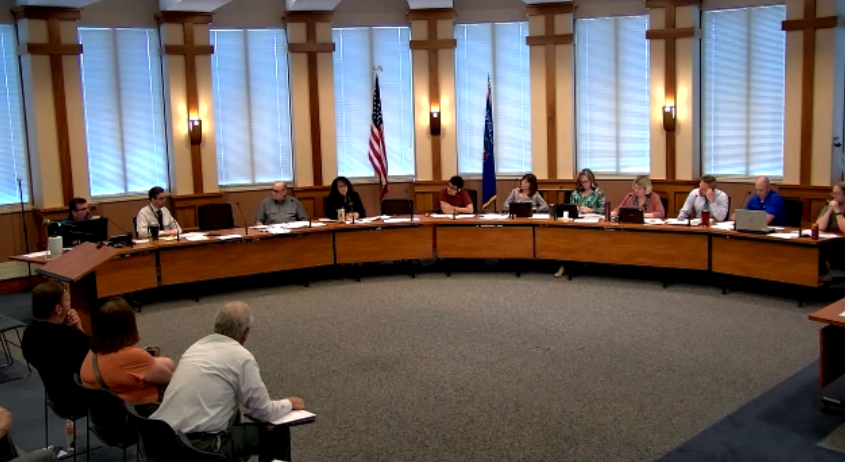
The Whitewater Aquatic and Fitness Center Joint Subcommittee discusses contracts submitted by each of the negotiating parties: the Whitewater Unified School District and the Whitewater Common Council. The meeting was held Thursday. The next meeting of the subcommittee is scheduled for June 14, at 6 p.m., in the library at the Whitewater High School. Screen shot photo.
Aquatic center subcommittee debates merits of contractual proposals; city to extend new draft
(Originally published May 18, 2023.)
By Kim McDarison
A meeting of the Whitewater Aquatic and Fitness Center Subcommittee was held last Thursday, during which the two negotiating parties, the city of Whitewater and the Whitewater Unified School District, debated the merits of operating and lease agreements for the facility as proposed by each party.
During the meeting, the city offered its proposal, outlining a 15-year length of contract, with a split obligation between the two parties for center-related expenses. The proposed agreement stipulated that each party would contribute $219,000 toward annual facility-related expenses, with $70,000 of those funds earmarked for capital expenditures. Operational expenditures would increase annually by 3% to adjust for inflation. The proposed contract further carried a split obligation to pay for the facility’s existing accumulated debt, with each entity becoming responsible for a payment of $222,000.
The school district proposed a 1- to 3-year length of contract, with the organization assuming no responsibility — beyond the payment of a $7,500 fee for pool use by the school’s athletic department and summer programming — for operational expenses, but taking full responsibility for maintenance and capital improvements made to the facility up to $250,000, an amount which the district proposed to make available through its “Fund 80,” which is dedicated to community-oriented expenditures. The district, within its written proposal, further offered to assume responsibility for one-third of the facility’s existing debt, in an amount of $150,000.
During the subcommittee meeting, Whitewater Unified School District Board of Education and subcommittee member, Jen Kienbaum said the board had met the night before the subcommittee’s meeting and would agree to pay half of the facility’s existing operational deficit, but did not want any further financial obligation associated with the facility’s day-to-day operational expenditures.
After a period of discussion, the parties agreed to consider making changes to each proposal and return for renewed discussion during the subcommittee’s next meeting, which will be held Wednesday, June 14, at 6 p.m., in the Whitewater High School library.
An earlier story, including the introduction of the two proposals to the public, is here: https://fortatkinsononline.com/officials-share-proposals-in-advance-of-upcoming-aquatic-center-subcommittee-meeting/.
During Tuesday’s regular meeting of the Whitewater Common Council, the body reconvened from a closed session meeting during which the proposed aquatic center contractual agreements with the school district were discussed.
After reconvening in open session, council members instructed City Manager John Weidl to “deliver a draft proposal for a four-year operating agreement, with … split operations and capital (cost obligations), and removing future deficit responsibility for the school district.”
The measure received unanimous approval from the city council.
Subcommittee meeting discussion
During the subcommittee’s Thursday, May 11, meeting, each negotiating party offered a critique of the proposed operating and lease agreement offered by the opposing entity.
Opening the discussion, Weidl said that the proposal submitted by the city was meant to serve as a “talking point” to begin negotiations with the school district.
Kienbaum noted that the school board, in a meeting held the night before, had agreed it would be willing to split the costs of the more than $400,000, which had earlier been identified by the city as an operational deficit that had occurred in previous years, and was being carried on the city’s books.
Presenting the district’s overall position, Kienbaum said: “We, as a school board, are in the business of servicing the children, from an educational standpoint, within this district, and we do not want to be part of the operations of the facility. We want to maintain the maintenance of the facility itself — the roof, floors, HVAC, boilers, things like that — but we actually do not want to be involved in the operational piece of it. The reason behind that is that we’re not involved in the day-to-day decision-making abilities, but yet we are responsible for deficits when incurred.”
Citing the difference in the proposed length of contract offered by each entity — the city looking for a 15-year contract and the district offering a range of between one and three, she said: “The reason being for that is in three years, we feel that we could audit what’s been going on and, if need be, adjust these expenses paid on behalf of the district. For example, for using the facility, or making changes to the agreement at that period of time.”
Subcommittee member and Whitewater Common Council President Jim Allen suggested that even with a longer length of contract, either side could ask to revisit the agreement and make changes.
Kienbaum said that the longer contract likely would have held more value for the city if it were responsible for capital improvements and maintenance, but the district’s proposal removed that obligation from the city, offering the possibility, from the school board’s perspective, she said, that “a smaller timeframe may be acceptable.”
City councilwoman and subcommittee member Jill Gerber thanked the board for its willingness to share in half of the expense of the accrued deficit.
Looking more specifically at the district’s proposal, titled: “Option A,” in packeted materials shared with the subcommittee, she said: “If you look at the bottom line number, it’s just not feasible for the city end, I think, to hold all that.”
Gerber said she did not agree with the district’s position that it did not have involvement with day-to-day decision-making affecting the facility.
She said: “I do feel you do have a say in what happens to us operationally with A: how the equipment’s maintained, when you maintain it, which could affect our operations, (and) B: you’ve cut the concessions, or the ability for them, which cut about $30,000 out of our operating costs by not allowing the kids to go there.
“You also, if you look at our hours, you occupy 600 hours, and not 400 hours, of our pool time, which also affects us in selling memberships and the ability to be open to the public. So even though you are directly not having a say in it, your decisions you make as a school board, or as a school, are affecting what we can bring in operationally.”
Gerber advocated for the district to become “more invested into the operations, whether that be some form of money, or some compromise of the money, but your decisions that you are making are affecting our operating, and we can’t survive unless you are in there with us.”
Whitewater Unified School District Superintendent Caroline Pate-Hefty questioned whether $30,000 attributed to concessions sold at the aquatic center was an accurate number.
Gerber noted that it was a number she had “heard,” but could not say it was “exact.”
Weidl said he would look for an exact figure. He asked the panel to consider the value of concession sales as a contributing budgetary factor rather than “get into the weeds” of an exact number.
He agreed with Gerber that the district’s use of the aquatic facility impacted the city’s ability to manage its use and costs.
Kienbaum said she agreed the district’s use of the facility brought impacts, adding: “I would agree that the $7,500 is a low-ball number, but we’d also like to take into consideration, too, that if we are getting charged for usage — we do have a policy, policy 830, which allows the city to utilize our facilities for aftercare programs for Park and Rec, and we don’t charge for that as well — so I think even though we are talking about the pool here, I think in the grand scheme of things, you know, there are services that go back and forth that there’s an expense allocated to, that maybe we don’t charge for as well. So I would like that just to be taken into consideration when assessing fees towards us.”
Said Pate-Hefty: “I think that’s a critical example of some of the differences in the types of businesses that we run. We are in the business of kids. And the reason we made the decision not to allow children to come to lunch — come around the building — is because we had significant attendance issues connected with it in our data.”
She cited incidences of vaping associated with students accessing parts of the high school and its grounds where they were unsupervised.
“In the kid business that we’re in, it doesn’t connect to a financial dollar amount. Right? I highly question there was really $30,000 of snacks and nachos purchased, I’m guessing that’s a higher food budget,” she said, adding that if $30,000 was a representation of dollars lost from students no longer accessing the aquatic center concession area for lunch, “we have a real problem … because we’re certainly not making $30,000 now that we are limiting them from coming over to you.”
She cited financial gains as opposed to safety concerns as “an example of us being in very different ends of things, and why it’s difficult for us to run a business together.”
She said the example made clear why the board thought the city would be better off running its own business while the district assume responsibility for caring for the building, which, she said, was something that the district does “really well, because we have a lot of those facilities.”
Allen asked if high school students were allowed to go off campus for lunch.
Pate-Hefty said they were not.
“It’s a safety issue,” she said, adding: “We cannot provide supervision to go through the pool area; there’s hallways and access where you cannot provide supervision.”
Citing the differing goals of the city and school district, as outlined by Pate-Hefty, Gerber said: “that’s maybe the problem in the way the aquatic center was set up to begin with, but we are trying to compromise there, but maybe the compromise … maybe that $7,500 needs to change to make it more doable. If you look at the sheet that was handed out with (the district’s) facility use, I don’t know, but we’re coming out more closer to $63,000.”
Kienbaum said she could bring the $63,000 expenditure number, which the city has identified as the cost associated with the district’s athletic and summertime programming use of the facility, back to the board for further discussion.
Pate-Hefty said the district also would need to verify the number, noting that, after reviewing information with the district’s athletic director, she was “not sure that we agree with all the hours that are posted on here.”
Allen said he though it was important that both the city and the district participate in capital improvement-related discussions.
“I think it needs to be shared,” he said.
Subcommittee members discussed adjusting a future contract’s length of term to a timeframe between three and 15 years.
Allen suggested that the city might consider 10 years.
Said Kienbaum: “Based on where we were prior, and where we’d like to go, (the board was) looking for a little bit shorter timeline, to make sure that this new arrangement does, indeed, work.”
She said she could see the board agreeing to a five-year contract, but not accepting terms of 10 years.
“We have turnover in school funding that changes on an annual basis for us, so we want to make sure that we are able to follow through on our commitments,” she said.
Allen suggested drafting a 10-year contract with a clause to revisit it in five years. He said a longer contract helps the city with its budgeting processes.
Pate-Hefty advocated for a clause to revisit in five years, with the added contingency that if the city was operating at a deficit, the contract would be revisited in three years.
Weidl asked for clarification concerning deficits.
Said Pate-Hefty: “If the budget looks like it has, and you are continuing to ask us to pay half of your operational deficit …”
Weidl asked if the superintendent was offering to pay for operational costs.
She said she was not, but was instead reacting to the current process regarding operating deficits.
Relative to operational deficit payments, she said: “We are not interested in continuing to do that. And so if that’s what continues to happen, that you have an operational deficit, that, in three years, we want to revisit. I’m asking if that would be an option.”
Weidl said he could not respond to questions about future deficits, saying: “I still think we’re stuck on — the whole thing doesn’t float if we can’t get the $63,000.”
Weidl said he would next work to prepare a draft budget to present to the city council during an upcoming council meeting which included a closed session to discuss aquatic center contractual negotiations.
The meeting was held Tuesday.
Looking beyond Tuesday’s council meeting, Weidl said: “We will share with you what the structure looks like with that number ($63,000) plugged in. And it leaves a multi-hundred thousand dollar deficit to operations. So I will share that information, but I think it’s critical we — talk about terms all you want, but if we can’t get past the first fiscal year — so, I don’t know. Don’t ask me for my permission on the three years or anything about deficits. I just wanted to clarify what you were saying.”
Approaching the podium from the audience, Whitewater resident and organizing member of the “Save the Pool” community group, which formed, according to its organizers to keep the public informed about the future of the aquatic center and contractual negotiations, Geoff Hale said: “It seems like this whole entire battle the city has come forward in leaps and bounds and the school side has not. This is a longterm facility. You’ve got to have a longterm commitment to make this work, and it’s time for the school board to step up and make it happen.”
Allen pointed to the board’s willingness to split the cost of the existing deficit, noting that he wanted to “give them credit where credit is due.”
Whitewater resident and Save the Pool organizer Jeff Knight noted that the district has two representatives on the city’s Parks and Recreation committee that oversees aquatic center operations.
Weidl said that he would use the $63,000 figure to create a budget, anticipating that the exercise would produce an operating deficit. He would next look at the existing pool expenditures to make appropriate cuts to close the gap.
Pate-Hefty sought to clarify that the $63,000 was being used in replacement of the district’s proposed $7,500 figure.
City officials agreed that it was.
Weidl cited costs associated with operating the pool and paying for chemicals 363 days a year as “fixed.” To close the gap, he said, he would look at reducing the pool’s hours of operation. He noted that closing the pool one day a week could save the city as much as $50,000, further noting that the pool received the least amount of use on Tuesdays. Another remedy might be to close the pool for two hours on each of the seven days it is open, he said.
He also cited a position, titled: parks programmer, for which the city had budgeted, but would no longer plan to fill. He said the move could reduce the city’s budget by an additional $50,000.
Whitewater Unified School District Buildings and Grounds Director David Friend suggested that the school district might absorb the cost of hiring its own lifeguards during its pool-related activities.
City councilwoman and subcommittee member Lisa Dawsey-Smith suggested the city check with its insurance carrier before agreeing to changes affecting lifeguards.
Considering the costs associated with operating the aquatic center, and incorporating a contribution from the district of $63,000, Weidl said the city’s contribution “roughly” would become $272,000. The city currently contributes $128,000 towards the operation of the aquatic center.
He said the model, which he posed as an exercise to help subcommittee members better understand the breakdown of costs, would include the district becoming responsible for capital expenditures, and the city becoming responsible for any operational deficits.
To make that model work, Weidl said: “I would have to find that in the general fund. This would be cuts from elsewhere.”
Kienbaum asked if the city was planning to consider increasing its marketing efforts to bring in more members and sell more services such as birthday party packages.
Weidl said the city would present a marketing plan during the next subcommittee meeting, adding that in looking recently at the numbers, the city would need to add 282 new members, further describing them as members that “kept paying and never left,” saying that under that scenario, the aquatic center would “cash flow.”
“We would have to increase the marketshare by 45% essentially,” he said, adding, “I’m not trying to throw a lot of math at you, but I am trying to say it’s going to take more than two years.
“Without you guys helping on this, the whole castle gets washed away.”
Position statements
Following the May 11 subcommittee meeting, each entity, the school district and the city, released position statements to the media.
A link to the statements is here: https://fortatkinsononline.com/wusd-offers-statement-regarding-whitewater-aquatic-and-fitness-center-negotiations-city-offers-response/.

Members of the Whitewater Aquatic and Fitness Center Subcommittee meet last Thursday to discuss proposed operating and lease agreements submitted by both negotiating parties: the Whitewater Unified School District and the city of Whitewater. Members of the subcommittee, not in pictured order, include, representing the city, council members Jim Allen, Jill Gerber and Lisa Dawsey-Smith; representing the school district, board of eduction members Miguel Aranda, Lisa Huempfner and Jen Kienbaum. Serving in support of the elected officials are Whitewater City Manager John Weidl, Whitewater Parks and Recreation Director Eric Boettcher, Whitewater Unified School District Superintendent Caroline Pate-Hefty, district Director of Business Services Ben Prather and district Director of Buildings and Grounds David Friend. Screen shot photo.
Whitewater PD arrests suspect in connection with Marathon Gas Station robbery
(Originally published May 19, 2023.)
Editor’s note: the following information as been released by the Whitewater Police Department.
Correction: The Whitewater Police Department has updated its press release, noting that the “former Marathon Gas Station” is today operated as a BP. The department regrets the error.
On Friday, May 19, 2023, at 6:07 a.m., Whitewater Police received a report of a robbery at the Marathon Gas Station at 1138 W. Main St. in the city of Whitewater. The suspect displayed an object believed to be a weapon and forced the employee to open the cash register. The suspect then stole the money from the register. Officers were immediately dispatched, and were able to identify the individual observed on surveillance footage through previous contact.
Officers attempted to locate the male suspect, a 68-year-old Whitewater resident, at his home. The suspect was not found initially, but was later reported to be in the area. At approximately 8:03 a.m., officers located the male near his residence. The suspect fled on foot and resisted officers’ attempts to take him into custody. Officers successfully deployed a taser and safely arrested the male. The majority of the money reported stolen in the robbery was recovered. The male was subsequently confined at the Walworth County Jail. Charges for Robbery (Wis. Stat. 943.32(1)(b), two counts of Resisting Officer (Wis. Stat. 946.41(1)), and Disorderly Conduct (Wis. Stat. 947.01(1)) will be forwarded to the Walworth County District Attorney’s Office.
The Whitewater Police Department would like to thank those members of the community who provided information that assisted in the efforts to take the suspect into custody.

Whitewater police, file photo.
Whitewater gas station robbery suspect to face one felony, five misdemeanor counts
(Originally published May 23, 2023.)
By Kim McDarison
A Whitewater man has been charged with one felony count of armed robbery with a threat of force and five misdemeanor counts, ranging from resisting arrest to possession of cocaine, according to information released through the Wisconsin Circuit Count Access website.
Willie Hearn III, who was taken into custody Friday, appeared the same day by video conference before Walworth County Circuit Court Judge Daniel Johnson for a bail/bond hearing.
Hearn, 68, was arrested by members of the Whitewater Police Department Friday morning for his alleged connection with a robbery at the BP Gas Station 1138 W. Main St., Whitewater.
Representing the state, Walworth County Assistant District Attorney Andrew Hermann also appeared in court Friday.
According to court documents, the court inquired if the victim wished to be heard, further noting that no statement was made.
Hearn was referred to the state public defender’s office and a cash bond of $25,000 was set, with a notation that the bond would be revisited at the next hearing, which is scheduled for Wednesday at 1:15 p.m.
The court instructed that the defendant will not have any contact or attempt to contact any victims associated with the case and will avoid their residence, place of employment, or any place they are located.
Only the defendant’s attorney may contact the victims on the defendant’s behalf.
The defendant was further prohibited from contacting the victims by mail, telephone, electronic device or through a third party.
A location from which the defendant is prohibited is listed in the document as “Raceway Foodway” in Whitewater.
Information online identifies the company at the listed address as Raceway Food Mart. The location is a convenience store and BP gas station.
The defendant was ordered to personally ensure that payments are made under any order for income withholding if the court appoints an attorney for the defendant.
In addition, the website reports that on Monday a cash bond was signed with the court.
Hearn faces the following charges: a felony C count of armed robbery with threat of force, two misdemeanor A counts of resisting or obstructing an officer, a misdemeanor B count of disorderly conduct, and two misdemeanor U counts, including possession of cocaine and possession of drug paraphernalia.
In Wisconsin, a Class C felony is punishable by up to 40 years of confinement, a $100,000 fine or both. A Class A misdemeanor can carry a fine of up to $10,000, up to nine month of confinement or both. A Class B misdemeanor can carry a fine up to $1,000 and up to 90 days of confinement. A Class U misdemeanor can carry a fine up to $1,000 and up to six months of confinement.
An earlier story about the BP station robbery in Whitewater is here: https://fortatkinsononline.com/whitewater-pd-arrests-suspect-in-connection-with-marathon-gas-station-robbery/.

File photo.
City releases aquatic center costs, concessions revenues; considers fitness center only lease
(Originally published May 24, 2023.)
By Kim McDarison
Revenues associated with concessions sold at the Whitewater Aquatic and Fitness Center have decreased between the 2021-22 and 2022-23 school year by 51%, according to information released Tuesday by Whitewater city officials.
Revenues associated with concessions sales at the aquatic center, and costs associated with keeping the facility open, have been developed in advance of the next Whitewater Aquatic and Fitness Center Subcommittee meeting, and shared with members of the Whitewater Common Council and the Whitewater Unified School District, according to a memo from Whitewater City Manager John Weidl.
The next subcommittee meeting will be held Wednesday, June 14, at 6 p.m., in the Whitewater High School library, 534 S. Elizabeth St., Whitewater.
Members of the subcommittee, composed of members of the Whitewater Unified School District Board of Education and the Whitewater Common Council, expressed interest in learning details about aquatic center concessions sales during their last meeting, held May 11.
The two parties have been engaged in an ongoing negotiating process to determine obligations that each party will assume associated with continued operations and a leasing agreement of the aquatic and fitness center since March.
The aquatic center has been operating without a lease agreement between the two parties — the district, which owns the facility, and the city, which leases and operates it — since 2021. A former agreement, through which the two parties split the operating and capital improvement costs associated with the facility, had been in place, prior to 2021, since 2016.
A drop in concessions sales
During the May meeting, Whitewater Common Council and subcommittee member Jill Gerber said a decision made by the district disallowing high school students to visit the center at lunchtime “cut about $30,000 out of our operating costs.”
In response to the claim, Whitewater Unified School District Superintendent Caroline Pate-Hefty questioned whether $30,000 attributed to concessions sold at the aquatic center was an accurate number.
Gerber noted that it was a number she had “heard,” but could not say it was “exact.”
Within his memo shared Tuesday, Weidl offered an eight-month, September through April, look at concessions revenues at the center for each of seven years, between 2017 and 2023.
Looking more broadly, comparing concessions revenues made during the 2018-19 school year with those made during the 2022-23 school year, Weidl said concessions revenues decreased by 79%.
In actual numbers, according to the memo, in 2018-19, which is notated as a “pre-COVID” year, the aquatic center made $44,338 in concessions sales. This year, 2022-23, which is notated as a year during which the district placed restrictions disallowing students to visit the center during lunchtime, concessions sales total $9,224.
Looking at the full seven-year period, a chart within the memo notes that, in 2017, concessions sales totaled $51,385; in 2018, they totaled $54,069; in 2019, they totaled $56,441; in 2020, notated as a year that was affected by COVID, they totaled $13,214; in 2021, sales came in at $10,669; in 2022, notated as the year in which the district’s schools reopened after closing as a COVID-19 precaution, sales totaled $20,771, and in 2023, with sales calculated between January and April, the total is $4,846.
Estimated pool costs
Also discussed during the May 11 meeting was the cost associated with programming at the aquatic center run by the city and school district.
Operating and lease agreement proposals submitted in May by each negotiating entity, the city and district, offered figures which, according to each party, represents what each party should pay towards operating and capital improvement costs associated with the aquatic facility.
In May, the city proposed continuing an earlier agreement, which split the costs of facility-related expenses between the two parties, for a period of 15 years, with each entity contributing $219,000 annually. The proposal stipulated that $70,000 also would be contributed by each party for the proposed costs of capital expenditures and maintenance.
Within the district’s proposal, a fee of $7,500 was proposed to be paid by the district annually to the city to cover operating expenses associated with the district’s use of the pool, outlined as athletic and summer school programming. In addition, the district proposed that it would become responsible for all of the facility’s capital and maintenance costs, and it would make available for that purpose $250,000 by placing those dollars in its Fund 80 account, used for community programming-related expenditures. The district proposed entering into a contract with the city for a period of 1-3 years.
Before and during the May meeting, city officials have said that the annual cost associated with the district’s pool use is about $63,000.
During the May meeting, Pate-Hefty said that the district had shared with its athletic director information provided by the city showing the number of hours the city estimated that the district was using for pool programming.
Responding to the estimates, she said the athletic director was “not sure we agree with all the hours that are posted here.”
She said she would need to verify the $63,000 figure.
Charts, showing cost estimates for pool operations, were included Tuesday in a memo released by Weidl to the negotiating parties and Fort Atkinson Online.
In his memo, Weidl wrote: “Heating the pool water and powering the mechanical room are the most significant costs to the facility.”
According to a chart, labeled “Estimated Pool Costs,” in 2022, costs were as follows: Water, $27,530; chemicals, $29,889; electric, totaling at $82,711, with $74,440 attributable to pool costs, and gas, totaling at $74,816, with $71,075 attributable to pool costs.
Looking at a breakdown by center amenity, the chart noted that the 8,000-square-foot leisure pool holds 75,000 gallons of water and the 9,000-square-foot lap pool holds 250,000 gallons of water. The fitness area is 4,500 square feet.
Water and chemical costs, and an annual chemical contract, costing more than $50,000, were shared between the two pools, with 23% of those costs attributed to the leisure pool and 77% attributed to the lap pool.
The fitness center shared in costs associated with electricity and gas, with its total impact on utilities listed at $12,011.
Total utility costs associated with both the leisure and lap pools were estimated at $260,353.
According to the memo, would the district become responsible for operating the lap pool and providing the required staffing, based on its current programming levels, it would face operating costs of approximately $230,000 annually. Looking more closely at costs, the city estimates that the lap pool utilities would come at an annual cost of $200,472, staffing would cost $30,000 and, using the city’s capital improvement plan (CIP), annual investments and maintenance costs would add $140,000, for a total annual operations and maintenance cost of $370,000.
Would the district opt to continue with a partnership with the city, using a shared distribution of costs model, each entity would pay $219,000 in annual operating costs and $70,000 in annual capital and maintenance costs, bringing the total annual operating and capital costs for each entity to $289,000, which, would be less expensive for the district, the memo argued.
The memo noted that the full annual cost to continue providing the Aquatic and Fitness Center as a community and district asset, including each entity’s full annual contribution, would the parties choose to continue their partnership, is $578,000.
The memo concluded by stating: “Based on the provided city staff research, continuing the partnership as proposed by the City of Whitewater Common Council results in a decreased cost of operations for the WUSD as opposed to WUSD running the lap pool for their usage alone, without the benefit of the existing partnership.”
City to consider fitness center only lease option
Within an earlier email to Fort Atkinson Online, Weidl wrote: “Staff is also working internally on a proposal that would only lease the space, at market rate or $15 a square foot, for the fitness center, spin and aerobic classes, and corresponding non-pool related amenities.”
The city manager noted that in that situation, the Whitewater Aquatic and Fitness Center, or WAFC, would be called the Whitewater Fitness Center, or WFC.
Would the city lease just the fitness center, it would continue to offer an “aerobic and anaerobic experience that will retain the 24-hour fitness component, spin and other fitness classes, as well as a revamped focus on wellness and nutrition,” the email stated.
Additionally, Weidl wrote: “In this situation the WUSD will be free to run their swimming class and athletics free from city operations and they can staff and fund that operation on their own. And in this situation, they would have a stream of revenue (from) the city in terms of a market rate lease agreement on the space we’re renting for the WFC.”
An earlier story during which the subcommittee discussed each negotiating entity’s lease and operating agreement proposal for the Whitewater Aquatic and Fitness Center is here: https://fortatkinsononline.com/aquatic-center-subcommittee-debates-merits-of-contractual-proposals-city-to-extend-new-draft/.
An earlier story with documents as shared by each negotiating party outlining their proposals is here: https://fortatkinsononline.com/officials-share-proposals-in-advance-of-upcoming-aquatic-center-subcommittee-meeting/.
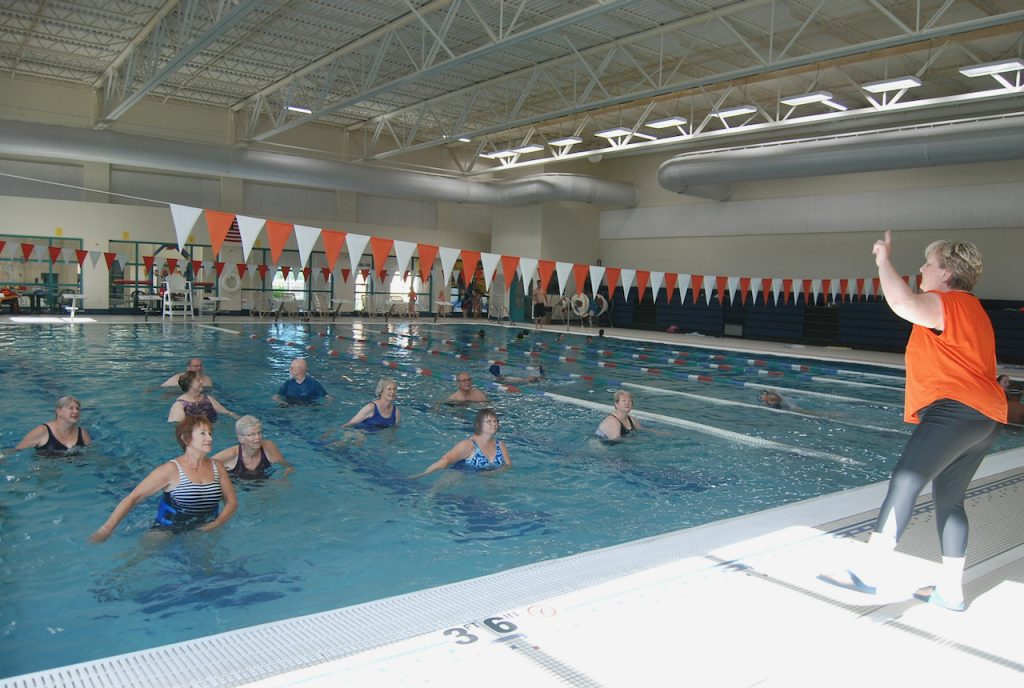

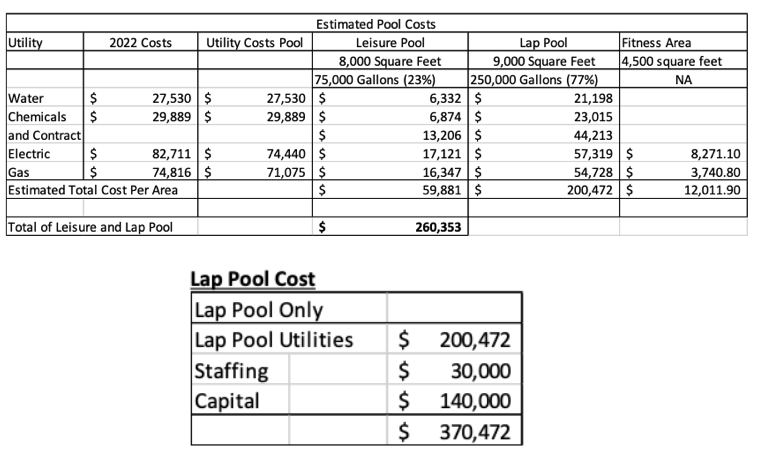
Weidl: City committed to Aquatic and Fitness Center; 2023 funding levels required to avoid cuts
(Originally published May 27, 2023.)
Editor’s note: The following commentary has been offered for publication by Whitewater City Manager John Weidl. The commentary was shared as a memo to the city’s common council and staff and titled: “Friday Food for Thought.”
Summary: The City Council and staff are committed to maintaining the Whitewater Aquatic and Fitness Center (WAFC) in its current state by providing additional funding for operations and capital maintenance for the next four years. City Council has asked the Whitewater Unified School District (WUSD) as partners to do the same. Maintaining service levels is the best way to increase memberships and reduce future costs for both organizations – not cutting staffing and services. However, the financial realty of the WUSD offer requires that cuts be seriously considered. I certainly understand and appreciate concerns from the community regarding the status of the WAFC operations and its future. To that end, I will to lay out several points that should help us understand the difference and impacts between the City of Whitewater’s funding proposal for the WAFC and the one provided by Whitewater Unified School District (WUSD).
Through 2022, both organizations have been contributing approximately $178,000 annually to the operations and maintenance of the WAFC.
Last week, the City Council proposed to increase its operational contribution by 23% to $219,000 annually, and continue funding half of all capital costs through 2027 through a 4-year lease agreement. The City Council also guaranteed that WUSD would not beheld liable for any budget overages if they agreed. This offer maintains service and stabilizes risk.
WUSD proposed to cut operational contributions by 96% to $7,500 per year, reducing contributions $170,500 annually. WUSD would fund all capital costs in their proposal. Conversely, WUSD would have to expend $230,000 operationally, plus capital costs, to maintain and staff the lap pool alone for its use without the benefit of the City’s partnership.
The City contribution level proposal is based on the true cost of operations and replacement as the WAFC is currently structured and staffed. Added to this is proposal is a 3% annual increase in contributions, a 3% increase in membership fees to WAFC members, and a 5% projected increase in total annual memberships.
The City Council strongly believes that to increase memberships and improve the WAFC, the City and WUSD need to put together an agreement for mutual gain that does not cut staffing or services. Both organizations need to support the WAFC for the benefit of students, residents, and surrounding region.
In real world terms: what would you do if your roommate/partner wanted to pay $75 on a house that cost $4,400 a month to rent after splitting the bills the previous 5 years? Would you let it eat into your emergency savings to the point where you had to think about selling your car and getting rid of your cat just to pay the bills each month? Would you at least change your Netflix password? I’m guessing most of us would probably start trying to find a new roommate or a new place to live as opposed to paying that much more than your fair share.
Remember, WUSD and the City both put up $178,000 in cash this year towards the WAFC. WUSD proposed to reduce that by 96% to $7,500. The City is offering to increase its contributions, not reduce, to maintain the integrity of the service and provide a pathway for improvement. If WUDS simply restarted negotiations at the existing 2023 funding level with a moderate escalator and a reasonable budget for capital costs, we’d be on a path to success.
Bottom line, if the City and school district do not reach a lease and operating agreement that funds the WAFC at a level that is at least as much as 2023, there will be no choice but to cut hours, cut staffing, or otherwise rearrange or eliminate parts of the operation to balance.

Weidl: Urgent housing needed for displaced Hawk Alley Apartments tenants
(Originally published May 30, 2023.)
Editor’s note: The following request for housing has been submitted for publication by Whitewater City Manager John Weidl.
I have been working with a group of community members, including employees of the school district, university, and the League of Women Voters, who have been trying to secure rental housing for the tenants who are living in the Hawk Alley Apartments. Direct contact with the ownership group of the apartments indicates that the tenants were asked to vacate the premises in April and the deadline of June 30th is approaching. Several have found other places to live, but tenants from approximately 15 units are still in need of housing. Of these tenants, two consist of families with school‐aged children. These two families are our highest priority.
In partnership with the city, the community group has talked to the four local hotels seeking long‐term stay arrangements at reduce prices. The least expensive option is $2,300 per month. The group has also looked into services from the Bethel House and Salvation Army. The group has even investigated whether space is available at the university and Fairhaven. While there is the potential for funding, the need is really in terms of available space in Whitewater. At this time, we are still seeking housing.
Because of the urgency of the situation, we ask the members of the Whitewater Rental Association or anyone in the community to contact the city manager at citymanager@whitewater‐wi.gov if you have immediate housing availability for these families.

UW-Whitewater, city to host 2023 Special Olympics Summer Games
(Originally published May 30, 2023.)
City of Whitewater officials have announced that the city, along with the University of Wisconsin-Whitewater, will be hosting the 2023 Special Olympics Summer Games.
According to information released by city officials, the games will be held June 8 through 10 on the UW-Whitewater campus.
More than 1,400 athletes from across the state will compete in track and field, cornhole, powerlifting, tennis, and soccer, the release stated.
Special Olympics, according to the release, is a global movement that “unleashes the human spirit through the transformative power and joy of sports. It empowers individuals with intellectual disabilities to become accepted and valued members of their communities, leading to a more respectful and inclusive society for all. Using sports as the catalyst as well as programming around health and education, Special Olympics works to end inactivity, injustice and intolerance.”
“The city of Whitewater couldn’t be happier to do our part supporting the 2023 Special Olympic games taking place in our community. It’s fitting that such a diverse and inclusive event be hosted in such a diverse and inclusive community,” Whitewater City Manager John Weidl was quoted a saying in the release.
Among activities associated with this year’s event are a parade of athletes and an opening ceremony, and the final leg of the “Law Enforcement Torch Run®,” the release stated.
Event-goers are encouraged to watch the games from “the stands” and volunteer, the release noted.
The Law Enforcement Torch Run has a stated mission of bringing awareness to the games and help raise funds to support them. The group has raised more than $600 million in support of Special Olympics since its formation in 1981. The grassroots fundraising movement began in Kansas according to online information.
For more about the Law Enforcement Torch Run, including how to participate and donate, visit the group’s website: https://www.specialolympics.org/get-involved/partners-of-the-movement/government-ngo-partners/law-enforcement-torch-run.
Registration and participation in the event is free, according to information released by city officials.
The Law Enforcement Torch Run will be held Thursday, June 8. Participants are asked to gather in Cravath Lakefront Park at 5 p.m. The run is set to begin at 5:30 p.m., with participants anticipated to reach Perkins Stadium, on the UW-Whitewater campus, at 6 p.m.
For information about the games, as provided on the UW-Whitewater website, visit: https://www.uww.edu/news/archive/2022-12-special-olympics.
For information about volunteering, as provided on the UW-Whitewater website, visit: https://www.cervistech.com/acts/console.php?console_id=0392&console_type=cookie&redirect_token=u43BZZLVjeb4a9JITLsP0w==:VJnSmsUDVC63PxOgnjLafdnN8e+9af88d80Ct114v6EwDuWUZ4nrXEqh7KFa6Z01&ht=1.
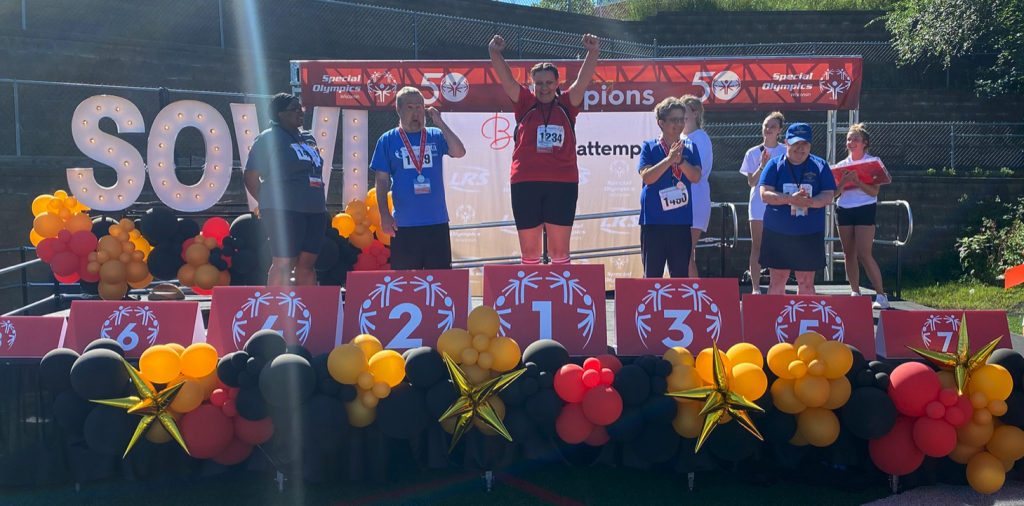
Local musician Steve Meisner, 62, dies following cancer diagnosis
(Originally published June 2, 2023.)
By Kim McDarison
Information released on a website announcing upcoming performances of local polka band musician Steve Meisner noted that on Thursday the artist died following a diagnosis of stage IV cancer.
According to the website, Meisner’s illness was brief.
He last performed on stage on May 21, the website reports, and learned the following week that his cancer was appearing in multiple locations.
The account notes that Meisner and his family were “shocked” by the diagnosis and before “meaningful treatment could be considered,” the website read, the artist had “peacefully passed away in Meriter Hospital in Madison.”
His wife, Barb, of 38 years, was by his side, along with his daughters, Whitney and Lindsey, and his son, Austin, the website noted.
“One thing everyone feels is certain is Steve would want the show to go on. The Meisner Band has many performances scheduled throughout the rest of 2023. Core Meisner Band members have committed to working with the many events and venues to fulfill these engagements as requested,” the website read.
The family has asked for privacy, according to the website.
According to information on the Nitardy Funeral Homes website, under the heading of “Obituary of Steven Alan Meisner,” the funeral home has announced that a celebration of Steve’s life will be held at a future date which is yet to be determined. An obituary will follow, the website notes. The death notice offers instructions for sending flowers to the family or to plant a tree in memory of Meisner.
For more information, visit the Nitardy website: https://nitardyfuneralhome.com/tribute/details/319479/Steven-Meisner/obituary.html#content-start.
To receive updates through the Meisner Band website, visit: http://www.stevemeisner.com.
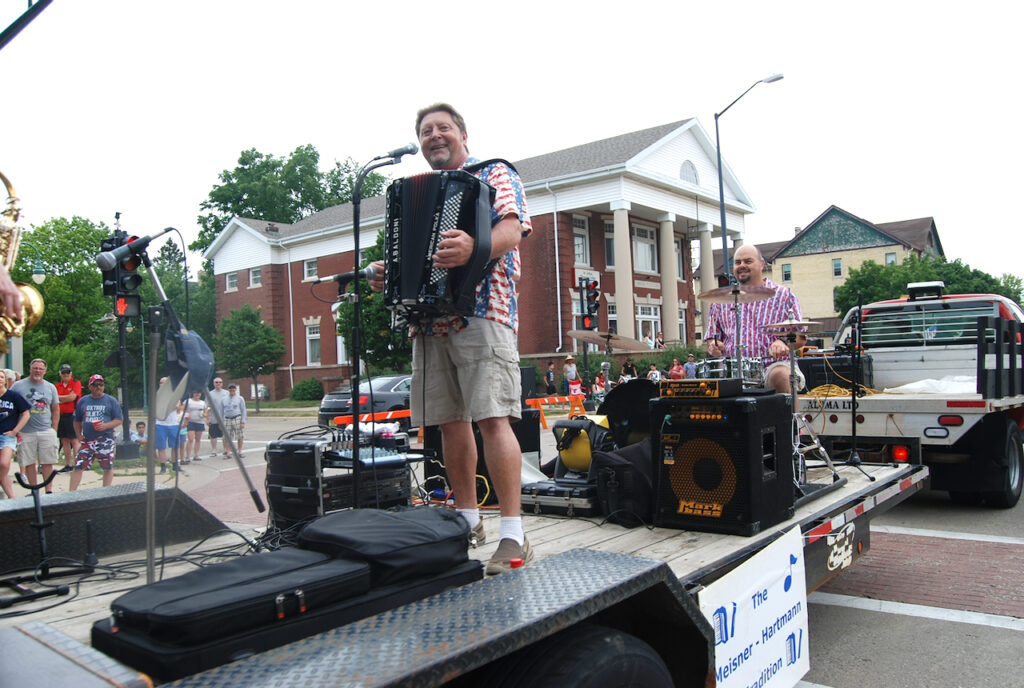
Steve Meisner, riding a float called “The Meisner-Hartmann Tradition,” performs for the crowd. The photo was captured by FAO photographer Kim McDarison during the 2022 Whitewater Fourth of July parade.
Whitewater Unified School District holds 2023 Retirement Dinner
(Originally published June 2, 2023.)
By Kim McDarison
Six retiring members of the Whitewater Unified School District, including five members of the district’s certified staff and a support staff member, were received Thursday by well-wishers and presented with certificates in recognition of their service.
Also recognized were two board members each of whom had completed a final term in office in April.
The program, which included dinner and celebratory cake, was held at the Willow Brook Golf Course clubhouse, Whitewater.
Along with the retirees, among the 80 in attendance were family members, friends, board of education members and colleagues.
Retirees and their guests were treated to a reception, followed by a program, during which four of the district’s five principals each presented a certificate of appreciation to retirees from within their respective buildings, and an additional token of appreciation in the form of a commemorative clock. Certificates were signed by the Wisconsin Department of Public Instruction Superintendent Jill K. Underly.
Exiting school board members received a certificate of commendation signed by Wisconsin Association of School Boards President Rosanne Hahn and the organization’s executive director John Ashley, and a commemorative clock.
Those honored Thursday included Whitewater High School head cook Patty Germundson, who, according to the dinner’s printed program, has served within the district for 28 years; Washington Elementary School teachers Carol Weisbrod, serving 32 years and most recently teaching fifth grade, and Pamela Dennis, serving 26 years teaching multilingual learners; Diana Callope, serving 31 years as a Whitewater Middle School math teacher; Christine Hayes, serving 35 years as a Lincoln Elementary School music teacher, and Kelly Seichter, serving 13 years as the district’s director of instruction and curriculum.
Exiting board of eduction members, having completed terms in April, included Steve Ryan, who, according to the event program, served on the board for 12 years, between 2011 and 2023, and Casey Judd, who served on the board for 13 years, between 2010 and 2023.
In addition, retirees acknowledged in the printed program, but not in attendance Thursday, included district support staff members Carol Kuchan, serving 21 years at the Whitewater Middle School as a custodian, and Gary Hookstead, serving 26 years as a Whitewater High School study hall paraprofessional.
Also honored during Thursday’s event was the late Kelley Marotta, a Washington Elementary School kindergarten teacher who served within the district for 31 years. Marotta died, according to her obituary, “following a brief illness,” in April. She was 56. The Janesville resident and University of Wisconsin-Whitewater graduate was remembered within Thursday’s program as a “kind, caring and patient” individual, who, as a bilingual speaker, worked with many of the district’s multilingual students.
Opening the program and arriving at the podium, Whitewater Unified School District Superintendent Caroline Pate-Hefty introduced exiting school board member Steve Ryan.
She thanked him for his service within the district.
Responding to an audience member’s question, Ryan, a former Whitewater Middle School principal, said he had served within the field of public educational for 54 years, with 29 of them served in Whitewater.
Whitewater Unified School District Board of Education President Larry Kachel next arrived at the podium to introduce exiting board member Casey Judd.
“(Former school board member) Thayer (Coburn), Steve (Ryan) and I made it through Act 10 and COVID,” Judd told attendees after receiving his tokens of appreciation from Kachel.
From the podium, Whitewater High School Principal Brent Mansky introduced Whitewater High School head cook Patty Germundson, who gave thanks for her tokens of appreciation.
Washington Elementary School Principal Tom Grosinske introduced several retirees, beginning with the late Kelley Marotta, whom he described as “beloved by students and staff alike, and was well-known for her positive personality and absolute dedication to her students.”
Marotta passed away unexpectedly resulting from a “heart event,” Grosinske said.
He noted that a butterfly garden at Washington Elementary School undergoing a revitalization has been dedicated to the teacher, and is now known as the Kelley Marotta Pollination Garden.
He next invited Carol Weisbrod to the podium, noting that she has taught, over the course of her career, grades 3-6, serving at both Lincoln and Washington elementary schools.
He described her as “fun, witty, and completely dedicated to her craft.”
Grosinske noted that Weisbrod, in lieu of receiving a “retirement gift,” donated the funds to the Whitewater LEADS reading advocacy program in honor of Marotta.
Addressing the audience, Weisbrod thanked members of her family and specifically her father, for his help, when, she said, “I decided to put canoes in the aquatic center because we were studying the fur trade, and fourth-graders in a canoe sounded great, with lifejackets and paddles. It was a great activity.”
Describing her time spent at Lincoln and Washington elementary schools, she said she was “really thankful for my journey,” further noting that she was looking forward to “what’s ahead.”
Grosinske asked Pam Dennis to join him at the podium, citing her as “playing a significant role in our achievement,” when, in 2017, he said, Washington Elementary School was designated a U.S. Department of Education National Blue Ribbon School for closing achievement gaps.
“Her ML students were one of the groups highlighted in that achievement,” he said.
He further described Dennis as “full of love and endless commitment for her students and coworkers.”
In lieu of a retirement gift, Grosinske said, Dennis also had donated funds to Whitewater LEADS in honor of Marotta.
Addressing attendees, Dennis said: “I’m going to start with a Grateful Dead quote: ‘What a long, strange trip it’s been.’”
She described teaching as a “wonderful adventure,” which, she added, brought her the opportunity to “meet and teach people who come from all over the world.”
She described herself in her ML teaching role as being “a human bridge between those two cultures.”
Appearing at the podium, Whitewater Middle School Principal Chris Fountain was joined by Diana Callope.
While serving in Whitewater, Fountain said, Callope had earned many awards. Among them he cited the 2015 Wisconsin Teacher of the Year, which he described as “a big deal,” the 2014-15 Wisconsin Middle School Teacher of the Year, which, he said was “another big deal,” and 2014 Herb Kohl Foundation and Fellowship Award, which he also described as a “big deal.”
After receiving tokens of appreciation, Callope said she was grateful for “all the wonderful people I’ve had the pleasure of working with or knowing through my kids going through school.”
She offered thanks to Judd for his work while the district’s teachers grappled with changes brought about by Wisconsin Act 10.
She described the district as “a great place to be.”
Fountain said Callope had donated a retirement gift to the Family Emergency Fund.
Kelly Seichter was next invited to the podium by Fountain, who described her as one who has “championed many different initiatives in addition to facilitating content teams.”
Addressing the audience, Seichter, in describing the district’s administrative team, said there was “an electricity in the air,” which, she said, “has snapped, crackled and popped,” as the team worked on “great things.
“I am in awe of the teaching staff of this school district,” she said.
In retirement, she said she plans to do “whatever makes me happy.”
Lincoln Elementary School Principal Brad Gefvert next came to the podium to present retiree Christine Hayes.
“I can’t be more excited for Christine and the work that she’s done, and just how she inspires all students and staff as well with her love of music,” Gefvert said.
With more than a 43-year teaching career, he said, Hayes has taught in every building within the Whitewater Unified School District with the exception of the high school.
He cited numerous programs which she touched, including the Whitewater Unified School District Stings program. Lincoln Elementary K-5 general music, World Drumming, Mariachi Band, Middle School Seventh- and Eighth-grade Band, Jazz Band, sixth-grade general music, eighth-grade guitar class, Washington Elementary fifth- and sixth-grade bands, and Lakeview Elementary K-6 general music and 4-6 choir.
Gefvert further noted Hayes’ many awards and honors earned while teaching within the Whitewater Unified School District, including the 2008 Herb Kohl Teacher’s Fellowship Award, the 2022 WMEA Michael G. George Distinguished Service Award, and the 2015 Young Auditorium Arts Advocacy Award.
In addition, he cited Hayes as a past president and chairperson of several music educators organizations.
Addressing her colleagues, Hayes said: “I cannot fathom a more beautiful career than I’ve been able to have because of the support that I’ve had over my past 35 years here.”
She added: “You all have carried each other, and we have all carried these children.”
She said the work does not go unnoticed.
“Thank you all for being an important part of our children’s lives,” she said.

Whitewater Unified School District Superintendent Caroline Pate-Hefty addresses attendees at the 2023 Retirement Dinner.
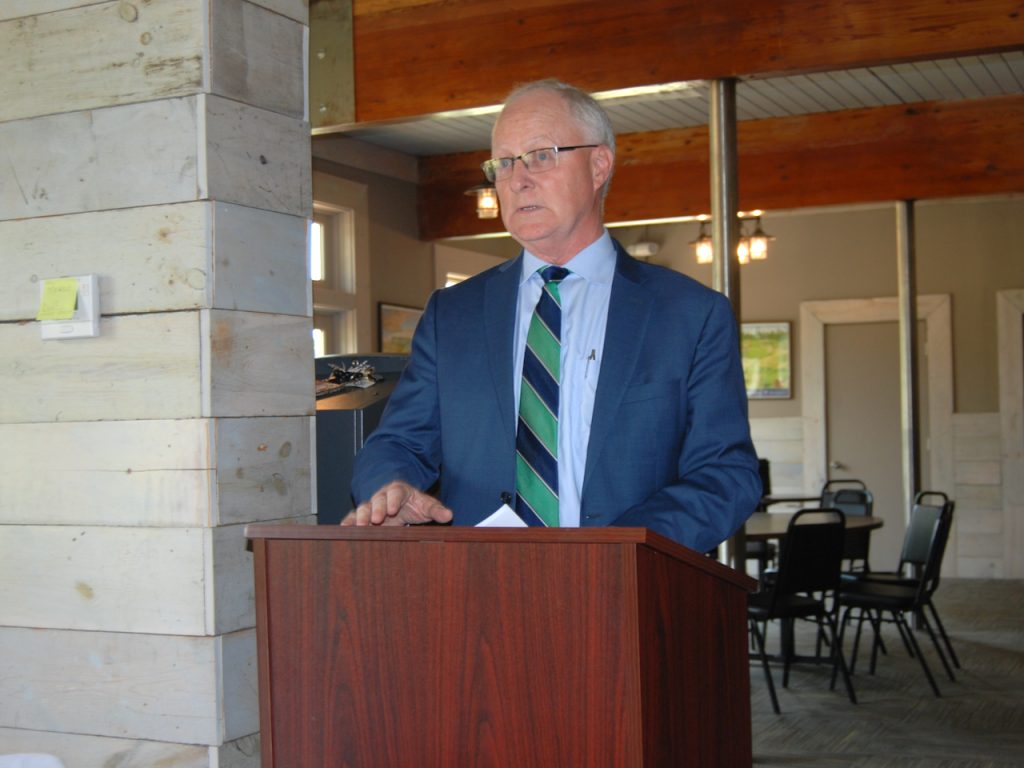
Whitewater Unified School District Board of Education President Larry Kachel addresses attendees at the 2023 Retirement Dinner.
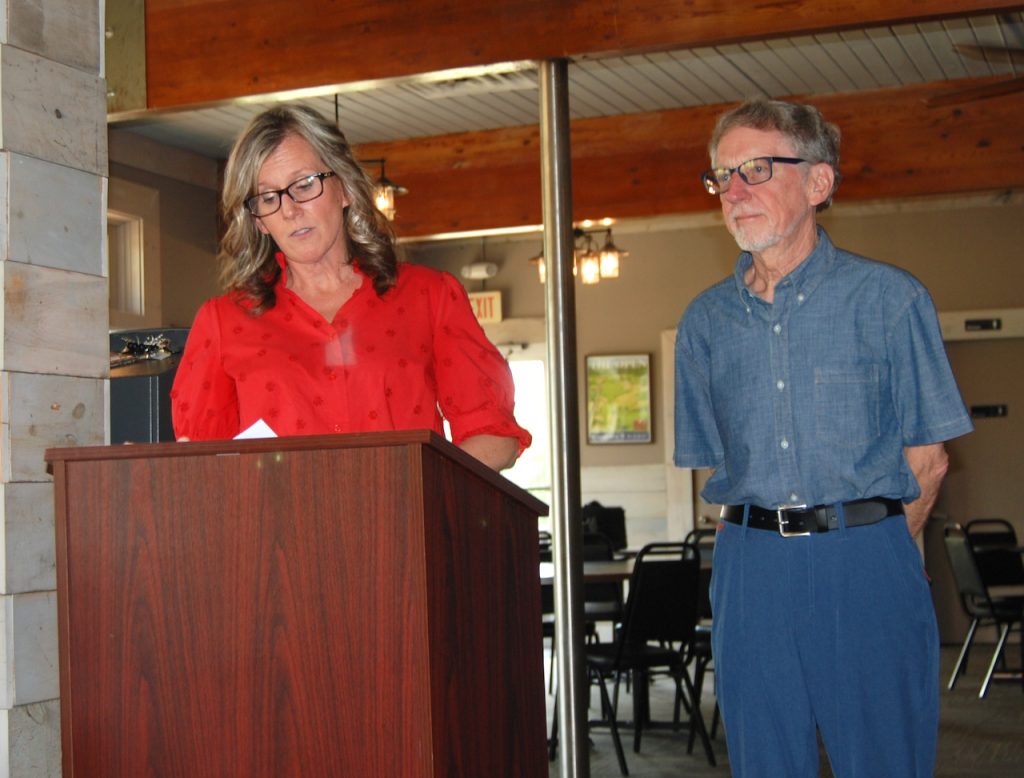
Whitewater Unified School District Superintendent Caroline Pate-Hefty presents exiting school board member Steve Ryan during the district’s retirement dinner.
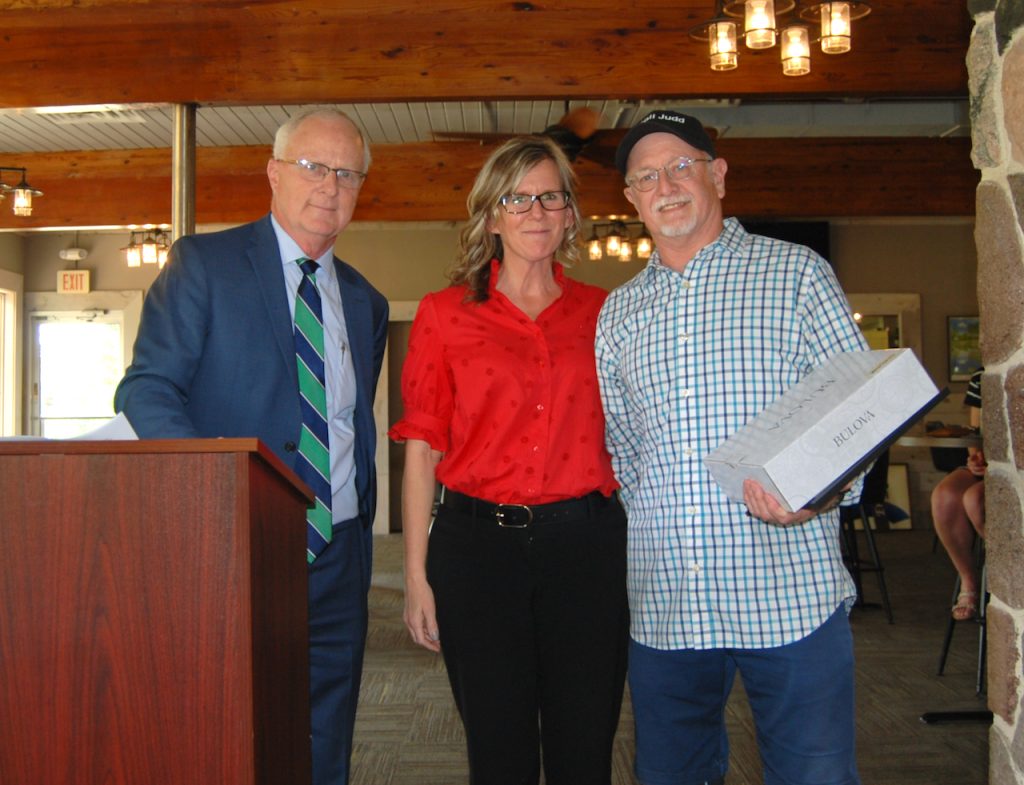
Whitewater Unified School District Board of Education President Larry Kachel, from left, Whitewater Unified School District Superintendent Caroline Pate-Hefty and exiting school board member Casey Judd gather near the podium during the district’s retirement dinner.
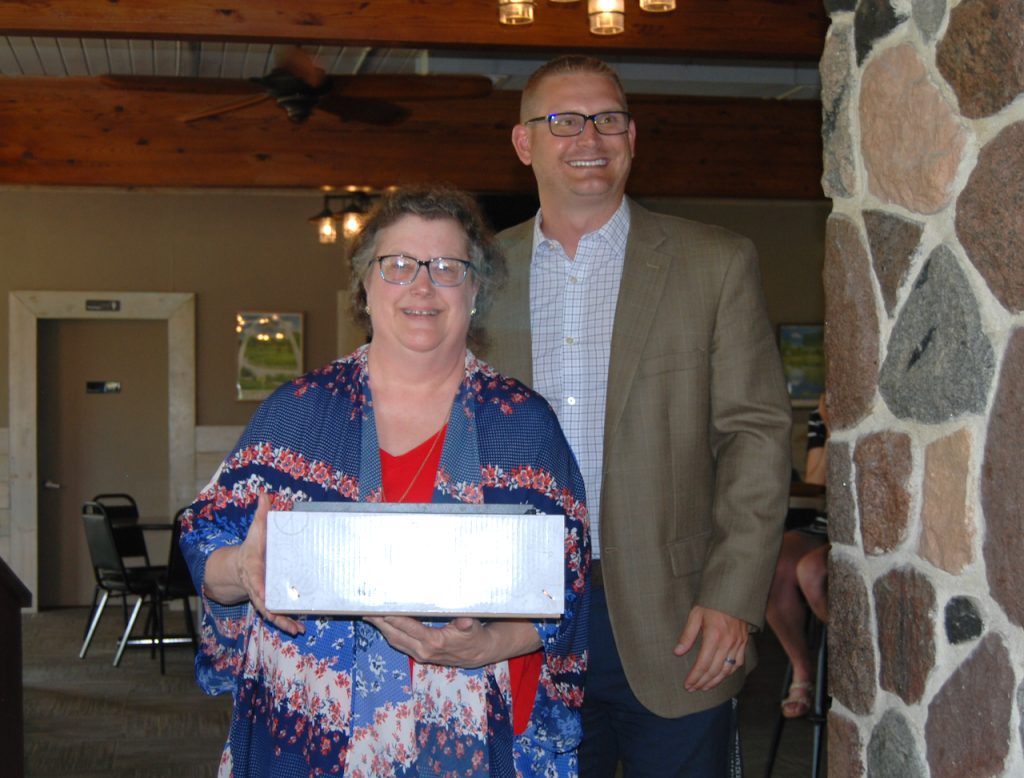
Retiring Whitewater High School head cook Patty Germundson displays her token of appreciation during the Whitewater Unified School District’s retirement dinner. She is accompanied at the podium by high school principal Brent Mansky.
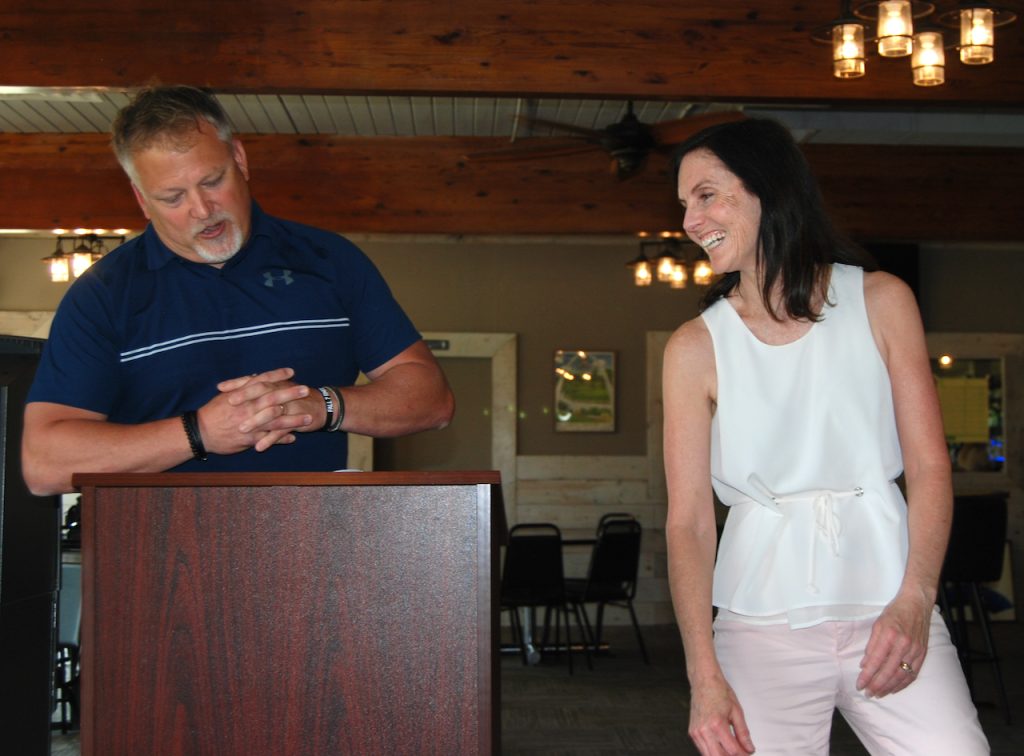
Washington Elementary School Principal Tom Grosinske presents retiring teacher Carol Weisbrod.
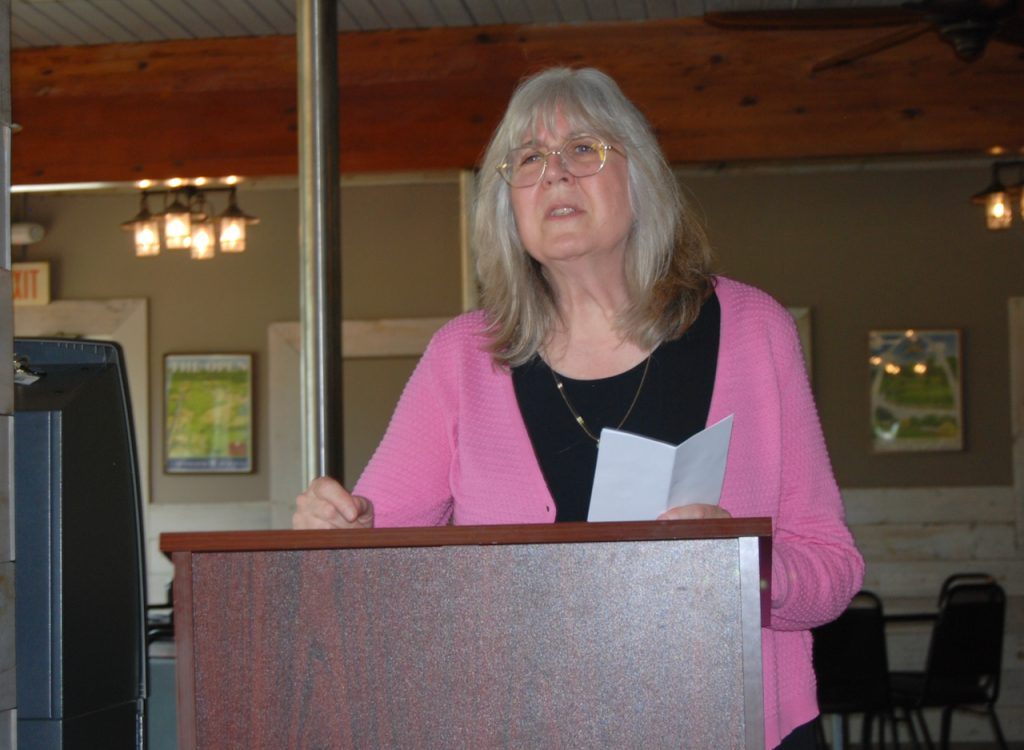
Retiring Washington Elementary School multilingual teacher Pamela Dennis addresses guests and colleagues during the 2023 Retirement Dinner.
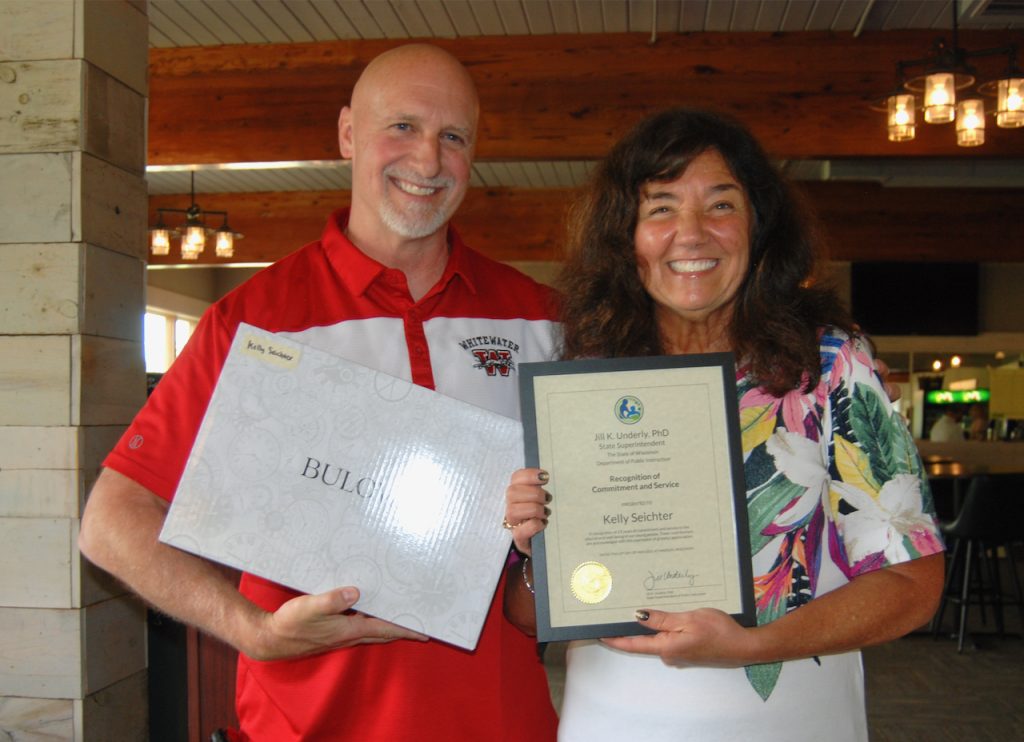
Whitewater Middle School Principal Chris Fountain and retiring director of instruction and curriculum Kelly Seichter display tokens of appreciation bestowed upon Seichter.
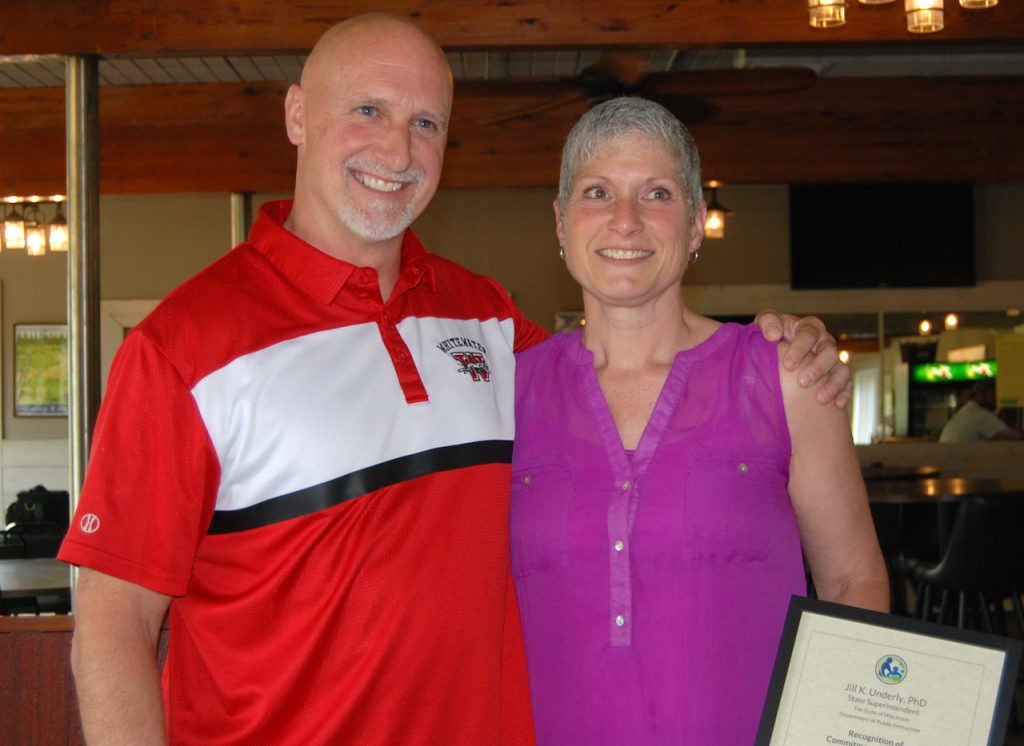
From the podium, Whitewater Middle School Principal Chris Fountain presents retiring math teacher Diana Callope.

Lincoln Elementary School Principal Brad Gefvert and retiring music teacher Christine Hayes display a token of appreciation bestowed upon Hayes.

Some 80 well-wishers and retirees fill the dining room at the Willow Brook Golf Course clubhouse Thursday.
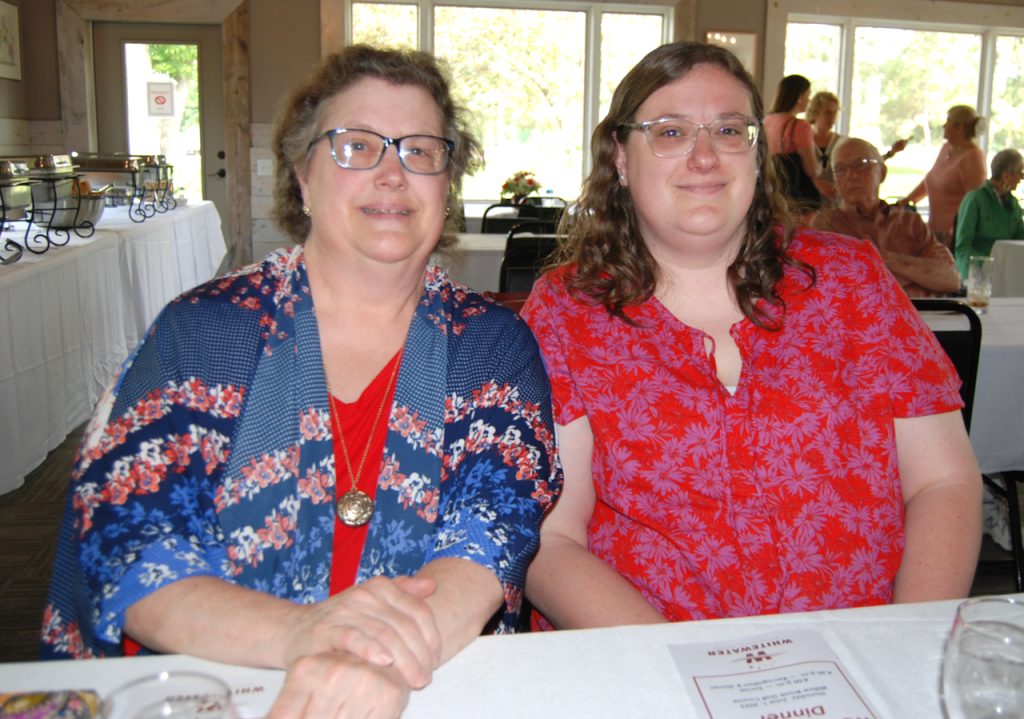
Retiring Whitewater High School head cook, Patty Germundson, at left, and her daughter are seated at the Willow Brook Golf Course clubhouse in advance of the Whitewater Unified School District’s retirement dinner.

Retiring elementary school teacher Carol Weisbrod, at left, is joined by her daughters during a reception held Thursday in advance of the Whitewater Unified School District’s 2023 Retirement Dinner.
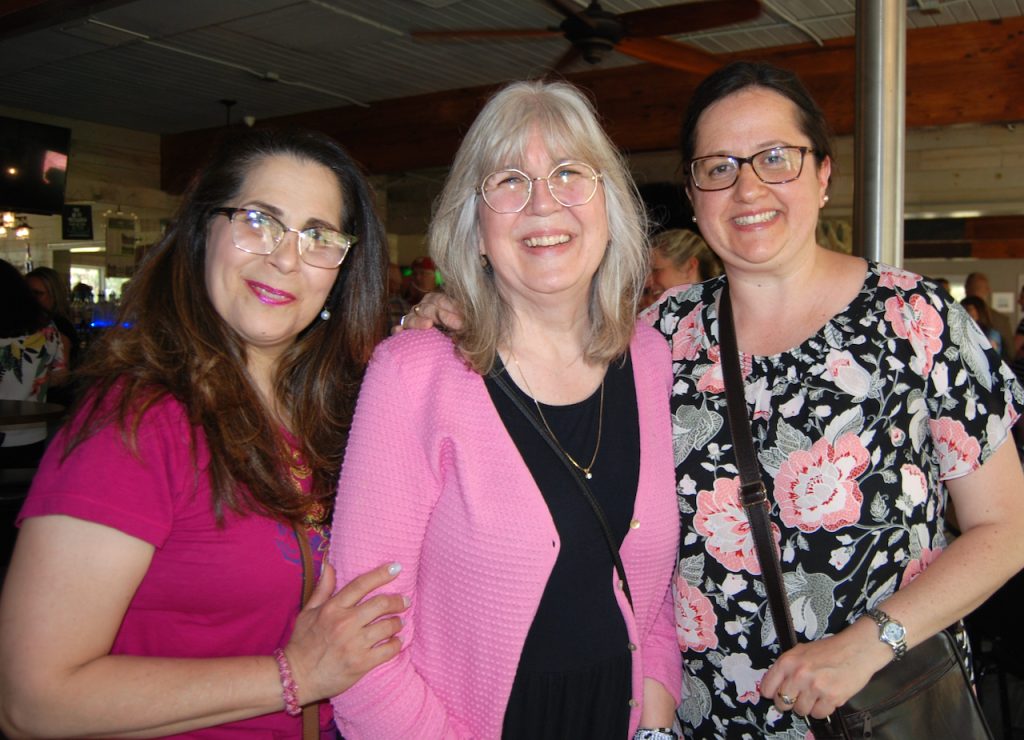
Retiring Washington Elementary School multilingual teacher Pamela Dennis, at center, is flanked by colleagues during the Whitewater Unified School District’s 2023 Retirement Dinner reception.
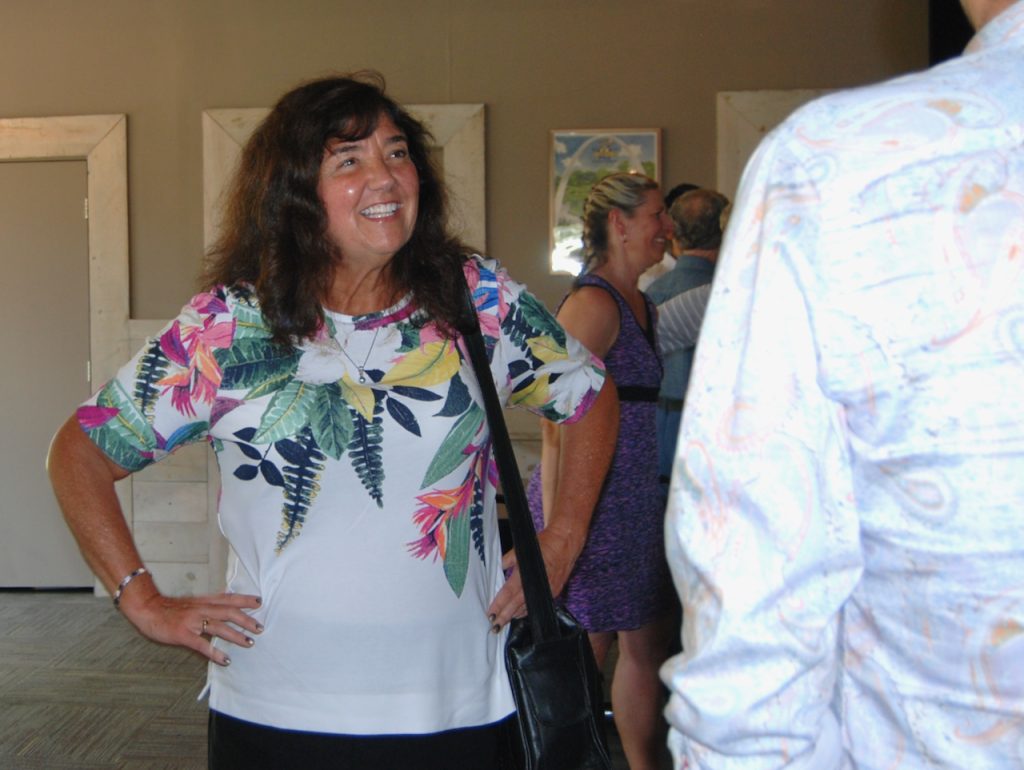
Retiring Director of Instruction and Curriculum Kelly Seichter visits with retirement dinner attendees during the event’s reception.

Retiree Diana Callope visits with colleagues during a reception held in advance of the 2023 Retirement Dinner. The event was held Thursday at the Willow Brook Golf Course clubhouse, Whitewater.
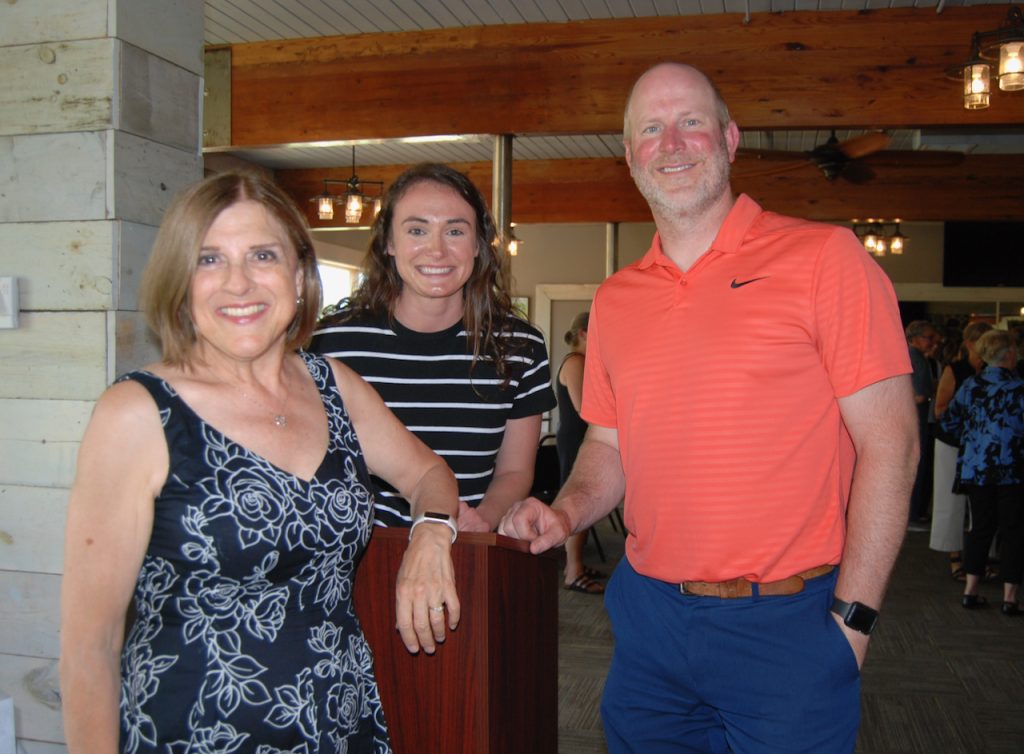
Visiting during Thursday’s reception are retiree and district music teacher Christine Hayes, from left, Administrative Assistant to the Superintendent Jaclyn Tueting, and Lincoln Elementary School Principal Brad Gefvert.
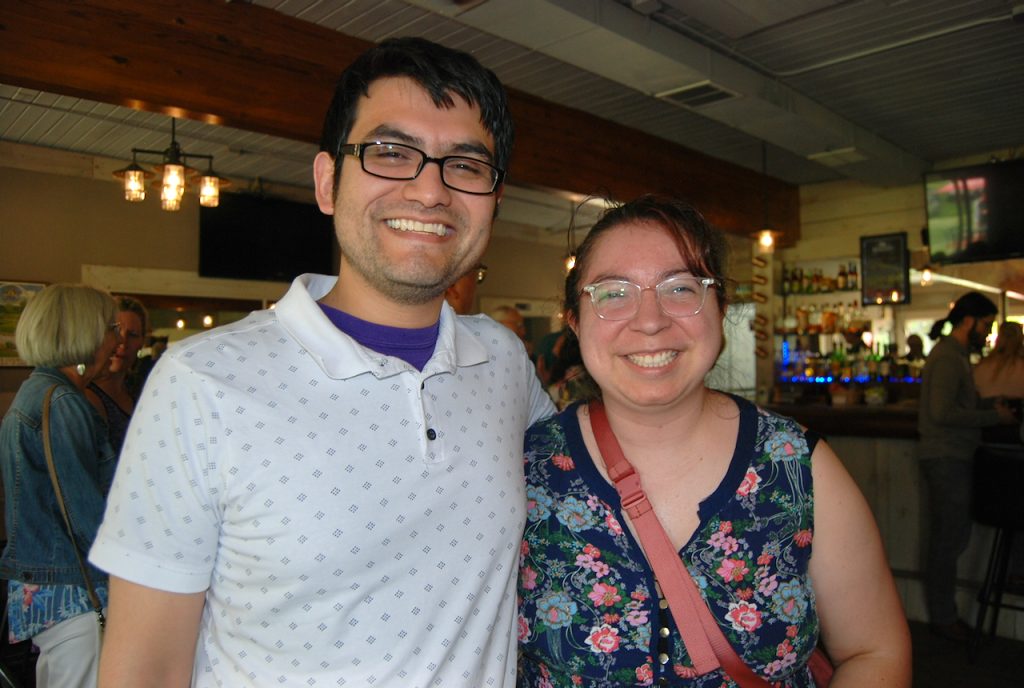
Whitewater Unified School District Board of Education member Miguel Aranda, and his wife, Fabiola, mingle during a reception held Thursday in advance of the district’s 2023 Retirement Dinner.
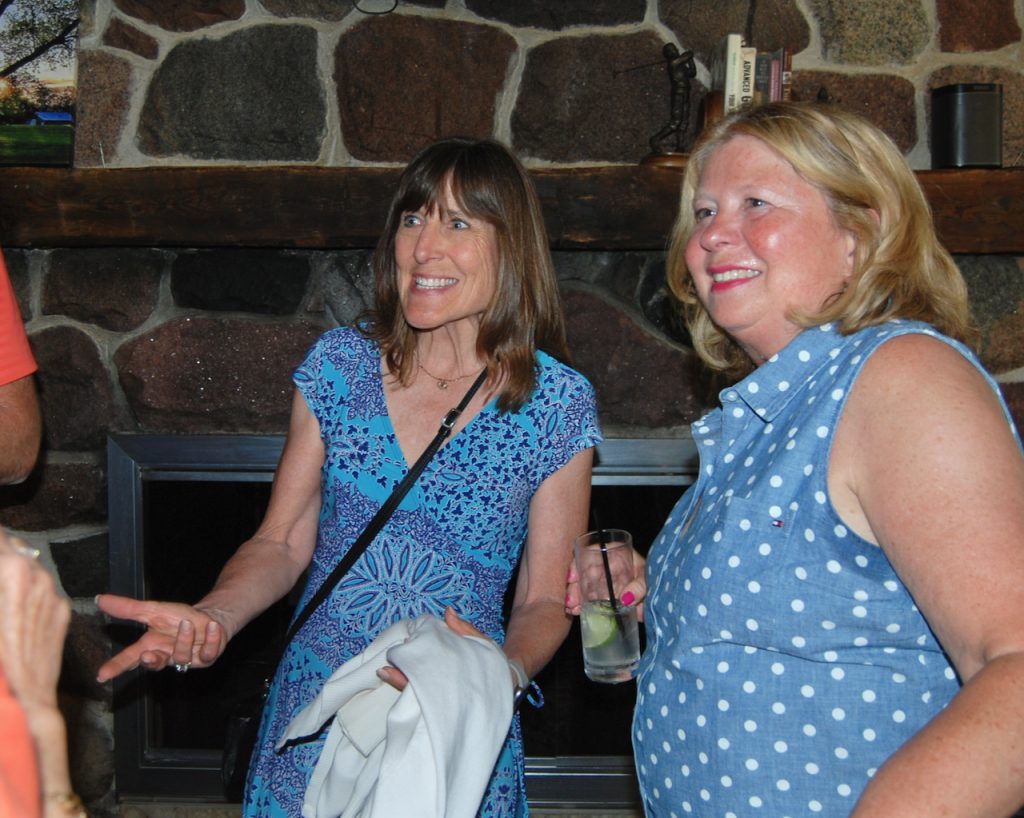
Whitewater Unified School District Board of Education member Lisa Huempfner, at left, visits during a reception held in honor of the district’s retirees.
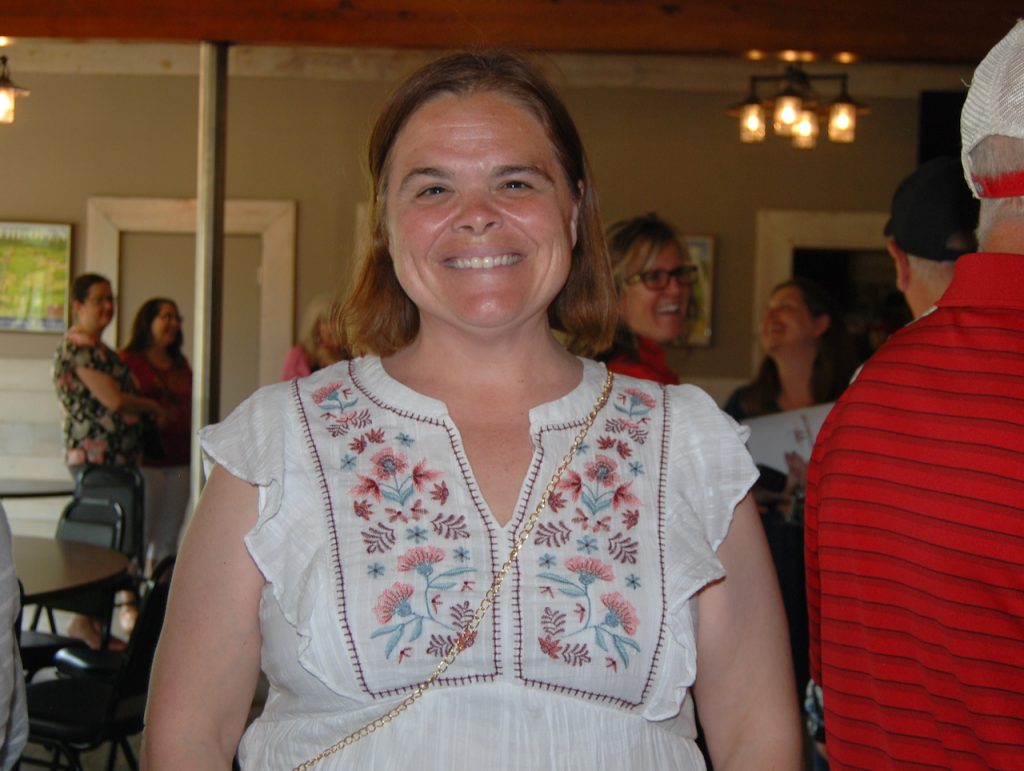
Whitewater Unified School District Board of Education member Stephanie Hicks visits with attendees during a reception held in advance of the district’s 2023 Retirement Dinner.

Tokens of appreciation adorn a table during the Whitewater Unified School District 2023 Retirement Dinner. The event was held Thursday at the Willow Brook Golf Course clubhouse, Whitewater.
Kim McDarison photos.
Whitewater man pleads guilty to charges of sex assault of a student by school staff
(Originally published June 5, 2023.)
By Kim McDarison
A Whitewater man has pleaded guilty to five counts of sex assault of a student by school staff.
Anthony P. Hansen, 35, appeared before Walworth County Circuit Court Judge Kristine Drettwan on May 26 via video conference and entered guilty pleas in response to five counts of sex assault of a student by school staff that had been filed against him.
A sentencing hearing has been scheduled for Aug. 15, at 10 a.m.
Two additional counts of child enticement, sexual contact were dismissed by the court, but read into the record, according to court documents.
Hansen was arrested last July by members of the Whitewater Police Department after they received a report of an alleged suicidal male.
At that time, according to information released by the police department, police alleged that Hansen was involved in an “ongoing sexual relationship with a minor.”
In addition, police reported at the time of the arrest that Hansen was an employee of the Whitewater Unified School District.
Following Hansen’s arrest, on July 25, 2022, the court set a cash bond of $10,000. On July 26, Hansen’s then-attorney, Michael Barth, asked the court to modify the bond, a motion to which the state objected and the court denied.
Hansen appeared in court on Aug. 16, 2022, at which time a preliminary hearing was set for Sept. 19, 2022.
On Aug. 26, 2022, documents report that the court issued a notice of arrest and the defendant was taken into custody.
Documents further note that the defendant had resigned from “Whitewater Schools,” and a “cash bond to cover both cases, plus new conditions,” was set. A new cash bond was set at $20,000.
With Judge Phillip A. Koss presiding, a new charge of one count of bail jumping-felony, was filed with the court on Aug. 30, 2022, with those charges listed as “dismissed, but read in.”
The defendant was prohibited from having any contact with any victims associated with the case.
A preliminary hearing and arraignment was held with Judge Peter Navis presiding on Sept. 19, and which time, Hansen appeared by video conference along with his attorney, Michael Barth, who appeared in court.
Detective Jacob Hintz was called upon to testify as a witness for the state. After hearing his testimony, the court found probable cause that a felony had been committed, and that the defendant likely committed it, and bound the defendant over to stand trial.
A status conference was scheduled for Nov. 7, 2022.
In November, 2022, prosecuting attorney J.J. Crawford, according to court documents, told the court the state had received an offer and needed time to review.
A status conference was scheduled for Dec. 20, 2022.
During the Dec. 20, 2022 status conference, court documents note that a counter offer was submitted, further noting that the defendant’s attorney “feels resolution can be reached.”
The court scheduled a 12-person jury trial for March 6, 2023.
In January, attorney Jacob Hilton appeared in court on behalf of the defendant. He requested that the trial date be reset “as he was just appointed,” the court document stated.
The court set a new date for a 12-person jury trial of June 5.
On May 22, attorney Ashley L. Renz was in court on behalf of the defendant. According to the court document, at that time, the parties stated that they were “close to a resolution.”
The document notes that the “court will set this matter later this week for potential plea and sentencing.”
A status conference was set for May 26.
On May 26, Hansen appeared via video conference with attorney Renz appearing on his behalf.
During the hearing, the defendant pleaded guilty to the five counts of sex assault of student by school staff.
The document notes that the plea was made “freely, knowingly, voluntarily and intelligently.”
After the plea was accepted by the court, the court canceled the jury trial.
The five counts of sex assault of a student by school staff to which the defendant has pleaded guilty are each of felony Class H.
A Class H felony in Wisconsin carries a maximum penalty of six year confinement, a $10,000 fine or both.
An earlier story about Hansen’s arrest is here: https://fortatkinsononline.com/whitewater-police-arrest-suspect-accused-of-sexual-relationship-with-a-minor/.

File photo.
Court binds Hearn, defendant in May Whitewater gas station robbery, over for trial
(Originally published June 6, 2023.)
By Kim McDarison
Willie Hearn, a Whitewater resident who is alleged to have robbed a BP gas station and convenience store on the city’s west side, was bound over for trial Friday after appearing before Walworth County Circuit Court Judge Peter Navis.
Hearn, 68, was arrested in May by members of the Whitewater Police Department after the agency received a report that an individual had displayed an object, believed to be a weapon, and forced an employee of the gas station to open the cash register, according to information released by the police department also in May.
The gas station and convenience store, known as the Raceway Food Mart, is located at 1138 W. Main Street, Whitewater.
Hearn has been charged with one felony count of armed robbery with a threat of force and five misdemeanor counts, ranging from resisting arrest to possession of cocaine, according to information released on the circuit court website.
On May 23, appearing before Walworth County Circuit Court Judge David Johnson, Hearn’s bail was set at $25,000.
On Friday, Hearn appeared before the judge via video conferencing and was represented by a court appointed public defender Mackenzie Renner.
During Friday’s hearing, Hearn waived his right to a preliminary hearing after which the court bound him over for trial.
An arraignment is set for June 26 at 2 p.m., according to court documents.
Hearn faces the following charges: a felony C count of armed robbery with threat of force, two misdemeanor A counts of resisting or obstructing an officer, a misdemeanor B count of disorderly conduct, and two misdemeanor U counts, including possession of cocaine and possession of drug paraphernalia.
In Wisconsin, a Class C felony is punishable by up to 40 years of confinement, a $100,000 fine or both. A Class A misdemeanor can carry a fine of up to $10,000, up to nine month of confinement or both. A Class B misdemeanor can carry a fine up to $1,000 and up to 90 days of confinement. A Class U misdemeanor can carry a fine up to $1,000 and up to six months of confinement.
An earlier story about the case is here: https://fortatkinsononline.com/whitewater-gas-station-robbery-suspect-to-face-one-felony-five-misdemeanor-counts/.

File photo.
Council receives Whitewater Aquatic Center marketing plans; some deficit funding achieved
(Originally published June 7, 2023.)
By Kim McDarison
The Whitewater Common Council Tuesday received a “Whitewater Aquatic and Fitness Center Action Plan,” as presented by Whitewater Parks and Recreation Director Eric Boettcher, and approved a resolution allowing the city’s finance department to move funds within the city’s budget to pay for a portion of the aquatic center’s growing deficit.
On Tuesday, Jeremiah Thomas, an accountant within the city’s finance department, said that the school district, on May 15, also has paid a portion of the center’s ongoing deficit expenses.
Marketing action plan
Offering a printed copy of a report that had yet to be included in the council packet, Boettcher told city council members that his action plan is “kind of what we put together based on what our goals are for the next year, (and) in 2024 and 2025.”
Boettcher said the document outlines the city’s plans to retain and gain lifeguards for the facility and to attract new members.
He noted that plans called for the city to work with the Whitewater Unified School District and the high school to provide lifeguard training courses.
He called the plan “ a blueprint on how we are going to move forward.”
A copy of the three-page action plan, which offers three goals, has been received by Fort Atkinson Online.
The plan’s first goal is defined as “lifeguard recruitment and retention.”
According to the document, the goal will be developed using three steps. The first seeks to develop and implement a lifeguard incentive program in conjunction with “Friends of the Aquatic Center,” a community-based group that has traditionally worked with the Whitewater Unified School District to provide money for swimming lessons for students who might otherwise struggle to afford them.
Within the document, plans call for the step to develop an incentive program with “benchmarks that would be used to entice new lifeguards to join and reward those who work a certain number of hours per season.” The document defines three seasons: first semester, second semester and summer.
According to the document, the Friends group has offered a “limited time incentive program” for qualified lifeguards. The group will provide training reimbursement to qualified aquatic center employees.
In addition, the document noted, the Friends group will offer a $250-sign-on bonus to new lifeguards who qualify. A requirement towards eligibility is defined within the city’s action plan as signing an agreement to work at the aquatic center for between 18 and 20 hours a week.
The program is anticipated to be implemented this fall, and has a goal of developing eight new lifeguards, four by Dec. 31, 2023, and four by June 1, 2024, through the district-offered courses.
A second step builds upon the high school training program during the 2023-24 school year.
A step three outlines the implementation of a “junior lifeguard” program, which the document describes as a “feeder program” to the aquatic center lifeguard training program. The junior lifeguard program is anticipated to be implemented by the spring/summer of 2025 as part of a summer school course offering, the document states.
A second goal is described as “Increase aquatic center membership.”
The document cites a target membership goal of “40 annual memberships per year,” with an added goal of keeping on average 950 primary members per month. The goal also notes a desire to increase membership revenue by 5% annually through 2024 and 2025.
Steps to achieve the goal include a plan to “reinvigorate corporate members by redeveloping and implementing the program.”
According to the document, the city currently has “relationship(s)” with Generac, First Citizens Bank, the Whitewater Unified School District and the city’s employees.
A timeline notes that the process is underway across the next 30 days and promotions to develop relationships will continue over the next 3 to 6 months.
A goal is to add two new corporate membership accounts by December, and at least one new corporate account annually thereafter, the document states.
A next step includes membership drives in concert with a “set promotion schedule produced by the marketing plan,” the document reads.
The plan will be updated and audited quarterly.
Further, the document includes an “incentive and referral program,” which will be developed through surveys, asking the membership about concepts that serve as incentives and motivations to join, and which incentives could be employed to engage them in making referrals.
An initial incentive program is anticipated to be launched on July 1.
The process remains ongoing through use of such tools as social media, Survey Monkey, and general membership surveys, the document notes.
Another step includes the development of “free trial” programs.
Included in the action plan is a desire to interact with those members opting to leave the facility through followup contacts, asking such questions as: Why did they leave? and: What changes or incentives might entice them to renew?
A third goal, titled: “Operations within budget,” looks to the 2024 and 2025 budget years, and sets as a priority operating the facility within “budget constraints of all expense areas of the budget,” including staffing, programming, and supply.
Budgets will be checked on a monthly basis, the document states, adding: “Reduced contributions will require a reduction in staffing hours and services to stay within budget.”
The full action plan is here: http://fortatkinsononline.com/wp-content/uploads/2023/06/Whitewater-Aquatic-and-Fitness-Center-Action-Plan.pdf.
On Tuesday, Boettcher also referenced charts offering information about costs associated with operating the center.
An earlier story identifying costs within the charts discussed Tuesday is here: https://fortatkinsononline.com/city-releases-aquatic-center-costs-consessions-revenues-considers-fitness-center-only-lease/.
Deficit payments
Council members on Tuesday learned that on May 15, the school district had paid its portion of the center’s outstanding debt, accrued between Jan. 1, 2016 and June 30, 2021, in the amount of $222,008.
The full debt during the aforementioned time frame was $373,767, according to Thomas, who asked council to approve a resolution, allowing the city to move its portion of the debt, some $151,758, into an account earmarked to support the aquatic center.
Following the unanimous vote in affirmation of the move, City Manager John Weidl said the money would come from the city’s “unappropriated fund balance,” which, he said, is typically used by the city to pay for unforeseen expenses such as emergencies.
He called the actions taken by the city and the district, a “good first step.”
In addition, Weidl sought to remind council members that the city’s transfer of funds and the payment made by the district would not cover the full amount of aquatic center-related debt.
Said Weidl: “This doesn’t get rid of the entire unfunded liability. We still have July 1, 2021, through today. I’m not sure how that’s going to be dealt with, but that’s something that will need to be dealt with. And currently, the trajectory we are on, we are continuing to accumulate a deficit. So, again, good first step, we still have some structural issues that need to be corrected, otherwise we will be back here in several years.”
Weidl noted that the city’s unappropriated fund balance currently holds $2.5 million. Funding the city’s portion of the deficit, he said, “it’s going to represent a reduction in our unrestricted fund balance. Right now, we’re about 25%. We have an ordinance, I believe, that requires us to be above 20%. This is certainly a good thing. It is a good first step on the road to financial recovery (for) the aquatic center. I just want to be clear this is coming out of our undesignated fund reserves, which is also the fund balance we use to fund other emergencies and things that may come up. So, eyes wide open.”
Council member Lisa Dawsey Smith likened the measure to “settling debt with ourselves.”
Public comments:
During the meeting, several members of the public addressed council, offering their thoughts about the aquatic center.
Whitewater resident Geoff Hale said: “I would also like to commend the city manager and the city council for their wonderful efforts and diligence in moving forward to get the aquatic center, I think, pretty close to mission accomplished.”
Another commenter talked about the pool, saying that it was closed during times when it was, in her estimation, meant to be open. She specifically noted that it was closed on a Saturday when it was supposed to be open and her grandchildren were disappointed.
“We have this wonderful pool, and nobody can use it, because it’s not open most of the time,” she said.
Chuck Mills, Whitewater, offered several “observations,” noting that he believed operations at the pool had improved, calling them “so much better than last December or January.
“The pool is warm, most of the time, it’s staffed,” he said.
He compared the pool schedule to those offered by facilities in Fort Atkinson and Palmyra, citing both as “seasonal.” He said they had schedules that have been made available to the public.
In Whitewater, he said, which has a year-round pool, “We’ve been 365 (days a year) and we’re not staffed. So somebody’s dropped the ball there. Things are better, but not good enough.”
Further, he said: “The other thing I had on my mind was, while the school board and the city are in negotiations, John Weidl, you came out with your own spiel.”
He noted reading that the city manager had offered as a negotiating consideration the discontinuing of aquatic operations by the city, opting, as a consideration, for a lease agreement between the city and district of the fitness center only.
Said Mills: “I was wondering why you would chime in in the middle of negotiations between the city and the schools — during negotiating — and this wasn’t anything part of this council … I don’t understand where that’s coming from.”
He added: “We are not giving up this pool,” further stating: “This is the community’s pool.”
Whitewater Common Council President Jim Allen advised Mills that the city manager could not respond to his comments made during the public comments portion of the agenda. He suggested the commenter contact the city manager’s office at a later date.
Mills continued: “You know the school system asked us for a referendum so that they could continue their operations.”
In the time that followed, he said, the district expressed interest in offering less funding for the pool.
“So you give them money to go, and then they are going to hold back money on the pool. That doesn’t make any sense,” he said.
Referencing the city’s ongoing discussions about the pool and the condition of Trippe and Cravath lakes, he said: “For whatever reason, anything to do with water, we can’t get it together around here.”
Closed session
Tuesday’s meeting also included a closed session, from which, according to the published agenda, the council would not reconvene into open session.
The closed session topic, as listed on the agenda, was “negotiation of Aquatic and Fitness Center agreement with the school district.”
Contractual negotiations between the two parties, the city and the district, are anticipated to resume in open session during the next meeting of the Aquatic and Fitness Center Subcommittee on June 14.

Whitewater Municipal Building, File photo/Kim McDarison.
Council postpones until next month Cravath, Trippe lakes cattail abatement plans
(Originally published June 8, 2023.)
Editor’s note: The spelling of Trippe lake has been updated. An earlier spelling omitted the letter “e.” Fort Atkinson Online regrets the error.
By Kim McDarison
The Whitewater Common Council Tuesday, after hearing proposals from city staff for cattail abatement on two of the community’s lakes, opted to postpone further discussion before approving a contract, pending the development by staff of further information.
Whitewater City Manager John Weidl said staff would return before council in one month with information about options beyond vegetation cutting and root ball removal through the process of dredging.
During Tuesday’s meeting, several city residents suggested the city explore purchasing weed-cutting equipment, employing herbicides, raising lake water levels, and forming a lakes management association.
Cutting or dredging
Discussion began with two presentations offered by Whitewater Parks and Recreation Director Eric Boettcher.
Offered information during “staff reports,” Boettcher shared an update on the city’s two lakes — Cravath and Trippe — and the ongoing restoration project begun by the city in 2019. In May, during an interview with Fort Atkinson Online, Boettcher estimated some $1.5 million had been spent on the project.
He noted that Wisconsin Department of Natural Resources (DNR) biologist Heidi Bunk, who has been working with the city over the course of the project, visited the lakes in May to access the project’s progress.
Bunk offered suggestions for cattail abatement, he said, focusing specifically on vegetation growing along the lakes’ shorelines.
Aided by slides, Boettcher said each of two options for further cattail abatement came with “benefits” and “drawbacks.”
Among options, Boettcher proposed cutting shoreline cattails, which, he said, was relatively cost-effective, but came with the “negative aspect” that the vegetation could grow back, as compared with a second option, that of root ball removal, which was viewed by the DNR as dredging. The dredging process, he said, was less cost effective, but offered “more permanence,” regarding longterm abatement.
According to Boettcher, the DNR is the agency that makes decisions about how much vegetation can be removed from waterbodies.
“So we are looking at doing pathways along the park area, and clearing out some of that vegetation,” Boettcher said.
A slide showed areas marked along the shoreline in front of Cravath Lakefront and Trippe Lakefront parks and the Clay Street Nature Area which could be cut or dredged, Boettcher said, adding that two years remain on a previously approved DNR five-year dredging permit, which would allow the city to engage in further dredging activities without making a new application for the next two years.
The city had obtained estimates from two vendors regarding both cutting and dredging of the proposed areas, he said.
Additionally, he said, the city’s staff explored employing dredging, along with its associated costs, with such activity taking place several times, potentially in 2023, and 2024, and, would the city opt to apply for an additional dredging permit, again in 2025.
A slide, showing costs project over the remaining two years of the city’s dredging permit, indicated that the city, through dredging, could incur costs of $70,000 in 2024, and $75,000 in 2025.
Funding sources for the project were identified as coming through a borrowing, in the amounts of $60,000 in 2024, and $65,000 in 2025. An additional $10,000 in each year was achieved through use of dollars within the city’s stormwater utility fund.
Following Boettcher’s staff report, council member David Stone noted that within his packet, he read a statement coming from the DNR agent, saying the water was cleaner and clearer within the lakes’ centers.
“I think the public assessment is different,” he said.
Councilwoman Jill Gerber queried Boettcher about a tour of the lakes’ shorelines which had been requested by council at a previous meeting.
Boettcher said staff was working on scheduling the requested tour, which, he said, he anticipated would take place sometime after the Fourth of July.
Councilwoman Brienne Brown asked if, after the city dredged, if that plan was approved, there was a plan to replace the removed vegetation with “something else.”
“Anybody with gardens knows that something will be back. It may not be that (cattails), but something will show up,” she said.
Boettcher said the city could explore the possibility.
Brown expressed concern that the city was “picking the same areas,” that were previously dredged.
She cited vegetation growing farther away from the shorelines, asking: “Are you eventually planning on hitting across there or are we just going to contain the area where we originally dredged?”
Boettcher said the city was focusing on the shorelines.
He said the areas indicated on his slides were not areas that had been previously dredged.
Gerber asked if the city had plans to “hit the green areas in the middle of the lake.”
Boettcher responded by saying that if the water level in the lake “comes up high enough,” then some of the vegetation would die off.
“That’s going to take time,” he said.
Council President Jim Allen asked about the use of herbicide.
Within a memo to council, Boettcher wrote: “The vegetation along the shoreline will continue to die back and the timing of this will depend on future weather conditions.”
He continued: “Recommendations given to us to help control and speed up the process are to allow us to cut pathways to the open water. Although we are not able to remove all of the cattails, we are able to create pathways from around the boat launch areas and in designated areas in front of the parks. Residents who live along the lake are also able to perform these types of remedies along their shoreline.”
Staff makes recommendation to dredge
In a second memo and presentation, Boettcher retuned to the podium requesting council to take action by approving a proposed lake dredging contract.
Within his second memo, Boettcher wrote that the focus of the lakes project has shifted to address the shoreline of the lakes, adding that the vegetation along the shoreline is anticipated to recede. However, he wrote, additional cutting or dredging will help facilitate the outcome.
Boettcher presented quotes for vegetation cutting and root ball removal or dredging received by two vendors: Eco-Waterways and Field and Stream Restoration.
Looking at the less expensive option — cutting — Boettcher said a cost estimate provided by Eco Waterways to perform cutting of vegetation in the three areas earlier indicated on a slide — in front of the Cravath Lakefront Park concrete platform, the Trippe Lakefront Park shoreline and an area of shoreline at the Clay Street Nature Area — was $29,750.
An itemization of services provided by the company showed an estimate of $22,400 for weed cutting based on the city’s map of Cravath Lake and an additional $7,350 based on the map of Tripp Lake.
Field and Stream Restoration provided an estimate of $46,000 for “cutting and restoration.”
For dredging services, based on the maps provided by the city, Eco-Waterways estimated the project at between $62,000 and $74,000.
According to Boettcher, dredging requires that work is publicly bid, with work perhaps taking place as early as late summer or early fall.
In addition, Boettcher noted that the city has $25,000 available in its lakes project budget, pointing again to options to obtain funding for the project through borrowing and stormwater unity funds.
A slide noted that borrowing for the project, if approved, would be supported through the city’s tax levy.
Addressing council after the presentation, Weidl said: “I guess the biggest thing staff is looking for guidance on is the cutting, it’s less expensive and you can get more volume done, but it is highly likely that all of those cattails will be back the following year. The dredging is more expensive and you get less volume per year. It removes the root ball and the vegetation, and the likelihood is high it will not return that year, and you can make progressive gains year after year. So it comes down to two things: What are you looking for in terms of immediate impact, and then the money, because the dredging is significantly more expensive. Not that we can’t figure that out.”
Councilman Neil Hicks said he was in favor of dredging the visible areas of shoreline in front of the parks, as indicated on the slide.
“It’s going to cost us more, but that also gives us the rest of the year to enjoy that park, you know, fireworks and shows and whatnot,” he said.
He expressed an interest in learning more about combining activities, such as cutting and applying herbicide, in future years.
“But I’d say, at least for the first year, while we still have permits available, my opinion is we dredge it and remove it completely for longevity,” Hicks said.
Gerber focused again on the areas identified for cutting or dredging.
“I guess I’m not understanding why we would spend money to cut the cattails if they are all going to grow back. Is it just for aesthetics? Or is there another purpose to this?” Gerber asked.
Said Boettcher: “So the cutting of the cattails, if it’s in deep enough water, they shouldn’t come back, but when I talked with Eco Waterways and Field and Stream, and then we add the dredging permit, I think that’s why we are looking at doing the dredging. Because it’s more permanent. I mean if you cut the vegetation, the vegetation along the shore is going to grow back. The vegetation farther out may not. But by dredging, you are giving yourself the best chance to eliminate it.”
Council member Lisa Dawsey Smith asked if efforts to raise the water level had been made.
Weidl said it was a good question.
Public comments
From the podium and during public comments, Whitewater resident Geoff Hale said the lakes were “probably the biggest asset that we’ve got,” adding: “Right now, you are looking at ‘Grand Marsh Upper’ and ‘Grand Marsh Lower.’”
While he said he believed “some phenomenal people” worked at the DNR, he also described the department as “one of the most despised agencies in the state of Wisconsin.
“They put every roadblock in place for us not to do this right the first time. (They) wouldn’t allow a bulldozer to go in there and just heave up, I mean acres and acres of dirt into two or three islands, which would have probably cost one-third of what we paid, the $1.3 million, to do, and now you’ve got nothing but vegetation that’s growing everywhere.”
He called the city’s lake project “systematic poor planning,” which, he said, “has created a monstrous floating bog on both the upper lake and the lower lake.”
He suggested that the city might explore purchasing a weed cutter, rather than “a Band-Aid for some small park areas.”
He said another area resident had researched the cost of weed cutting equipment, citing $65,000 as the arrived-upon figure.
Another commenter noted that he and his wife arrived in Whitewater six years ago, and had the benefit of enjoying the lake behind their home for three years.
The loss of the lake “does tear me up,” he said, further citing his opinion that the lake’s current condition contributes to the loss of tourism dollars.
“You need an attractive town to attract people,” he said.
Another commenter said he had contacted several governmental bodies, including the DNR, the city and Walworth County, and he’d come up empty trying to learn who controlled water levels on Trippe and Cravath lakes.
“There’s water going into Cravath Lake 365 (days) a year, it doesn’t matter that there’s been a little bit of a drought. That level can be lifted; the level can be brought up,” he said.
Yet another resident told those in attendance that he believed the DNR had “totally dropped the ball,” by allowing the lakes to remain drained for two years. He saw a missed opportunity for the use of herbicide while the lakes were drained, he said, calling the decision “a catastrophic mistake.”
He called the DNR representative working with the city “uncooperative.”
The commenter said he held permits for dredging, cutting and herbicide application for his own property and would be willing to help other landowners undertake the process if they wanted to apply for permits from the DNR.
He also advocated for the formation of a lakes association.
Following comments made by members of the public, Allen said that he was not sure that the council was ready to decide about a remedy for cattails. He thought the council should learn more from the DNR about “spray versus cutting.”
He also was interested in learning more about water levels and different vegetation cutting machinery, he said.
Said Hicks: “I shouldn’t ask, but I’m going to: Do we know what the fine would be to just go and remove everything along the shore?”
Allen responded by saying: “next question.”
Stone also expressed an interest in learning more about weed cutters.
Said Brown: “My biggest problem is that, so far, the DNR has told us a lot of things like, well, if the weather does this, or if the weather does that, we don’t know what’s going to happen. And that’s exactly what happened to us. We weren’t able to get things done except during certain weather; we weren’t able to get burns done at a certain period of time. We can’t control the weather, and I feel like we are going to keep throwing money at this, and, most of the time, we are going to be disappointed.
“That’s what really concerns me is that we are going to keep trying everything and it’s still going to want to become a wetlands because that’s what it is. Why are we not even considering how to make the wetlands look prettier? Like a Japanese garden?”
Hale expressed frustration with the comment, saying: “She (Brown) wants to turn it into a flower garden.”
Brown responded, saying: “No, no, I’m saying, let’s spend money, but I’m sick and tired of people getting mad at us for spending money because we spent money wrong, when half the time we are spending money the way people told us was the best way, given the projected weather.”
Also among speakers was former council member Carol McCormick, who served on council while the dredging process and lake restoration work was undertaken. McCormick opted against making a run in April.
She described herself as a 20-year resident of the lake.
Of Boettcher’s oversight of the project, she said, he had done “the best he could with the advice he got.”
Of council’s decision-making, she said: “We got the advice from the DNR; we did what they said we had to do.
“The result was not what we had thought,” she added.
She said she and others “have spent thousands of dollars dredging their property” and I have no access to the main channel now. I am land locked.”
She, too, advocated for a lakes management association.
Looking ahead, she said, she anticipated that “the whole city is going to have to contribute to this project. We have already invested $1.3 million, and, she said, she believed that more money will be “trickling, down the line, too.
“I thought we had a light at the end of the tunnel and obviously, that light is shutting down right now,” she said.
Weidl said staff would return before council in a month with more information.
Council opted to postpone further discussion until more information could be developed by staff.
An earlier story about cattail abatement as described in an interview by Weidl and Boettcher is here: https://fortatkinsononline.com/lake-restoration-project-continues-with-cattail-abatement-plans-city-officials-say/.
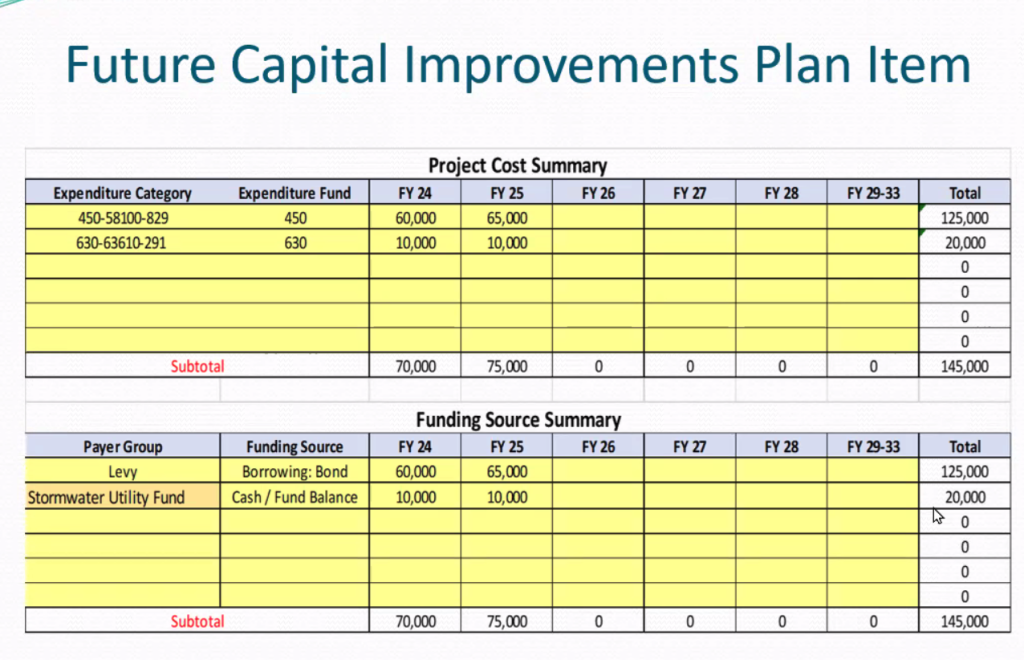
A chart, provided as one of several slides Tuesday by Whitewater Parks and Recreation Director Eric Boettcher, shows a “project costs summary,” for proposed dredging in specific areas along the shores of Cravath and Tripp lakes.

A color-coded graphic shows areas that Whitewater city staff has proposed for dredging over a three-year period. Offering an explanation of the graphic, Whitewater City Manager John Weidl, on Tuesday, said the colors — blue, red, and green — represent, in that order, proposed dredging areas to be completed in 2023, 2024 and 2025. The city’s dredging permit allows the city to dredge through 2024. To complete the areas designed in green, he said, the city would need to apply for an additional permit.
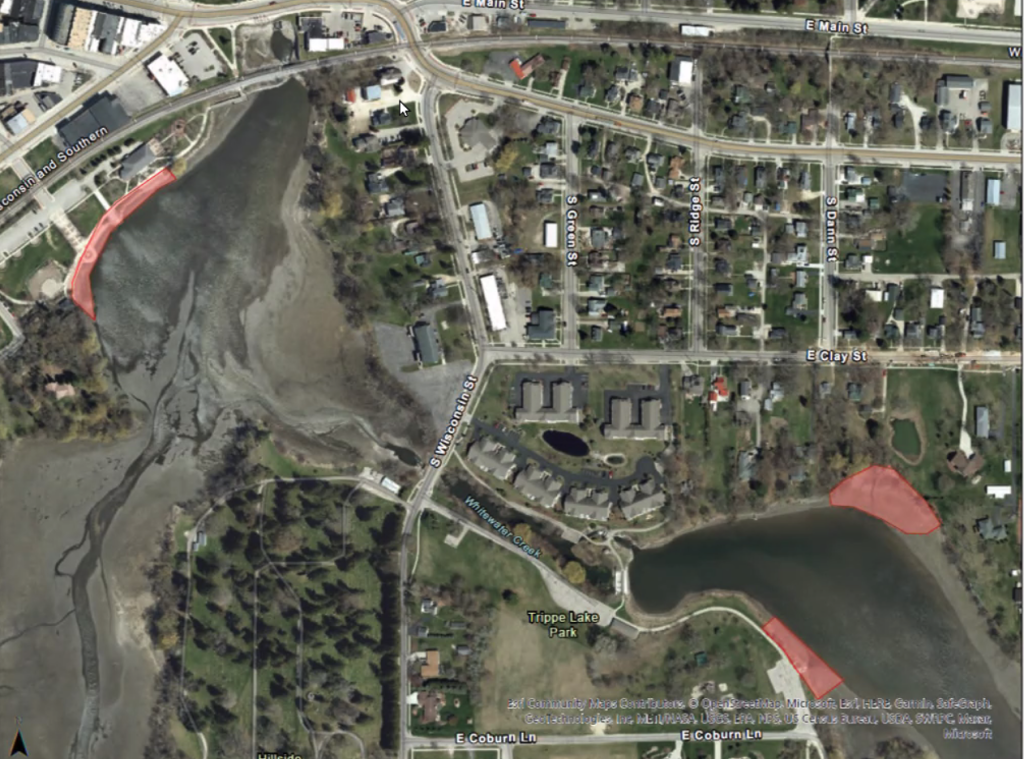
A map, presented by Whitewater Parks and Recreation Director Eric Boettcher, to the city’s common council Tuesday, shows areas city staff has proposed for additional dredging. A decision by council has been postponed until next month. Areas indicate shoreline in front of Cravath Lakefront Park, the full area of which is proposed to undergo dredging over a course of three years, at left, and areas on Trippe Lake, at right, in front of Trippe Lake Park and the Clay Street Nature Area. Both areas are proposed to undergo addition dredging as early as this year.

A variety of vegetation protrudes from the lakebed as viewed recently from the shoreline of Cravath Lakefront Park, Whitewater. Contributed photo.
Whitewater police say FCCU robbery investigation ongoing; seeking the public’s help
(Originally published June 9, 2023.)
By Kim McDarison
Whitewater Police Chief Dan Meyer recently noted that the department continues to investigate a robbery at the Whitewater branch of the Fort Community Credit Union (FCCU), 203 E. Milwaukee St.
In an email shared Tuesday with Fort Atkinson Online, Meyer said that no arrests associated with the incident had been made.
“We are still investigating leads in the case. We strongly encourage anyone who has any information to contact WPD,” Meyer stated in the email.
Those with information are asked to call 262-473-0555, and use “option No. 4,” or submit an anonymous tip using P3tips.com, the chief said.
In addition, he said: “We are also asking any residents in the neighborhoods adjacent to FCCU who may have surveillance systems to contact us if they are willing to provide footage.”
According to information earlier released by the department, the robbery occurred Friday, May 12, at 3:11 p.m.
At that time, police released a description of an individual of interest and credit union security camera footage of a hooded and masked individual entering the credit union building and approaching a teller.
According to the earlier released description, police are looking for the male individual captured on security footage as he entered FCCU wearing sunglasses, a black medical mask, a gray zip-up hoodie over a bright yellow shirt with dark lettering beginning with the letter “Y” that was larger than the rest of the lettering on the upper chest, and dark cargo pants.
Police also have released a description of a vehicle that may have been used by a suspect leaving the building at approximately 3:14 p.m. The vehicle is described as a dark hatchback with white stripes that possibly could be a newer model Mini Cooper.
An earlier story about the FCCU robbery, with additional security footage images of a person of interest who is being sought by police, is here: https://fortatkinsononline.com/whitewater-pd-fort-community-credit-union-robbery-under-investigation/.

Whitewater police are looking for an individual whom they describe as male, wearing sunglasses, a black medical mask, a gray zip-up hoodie over a bright yellow shirt with dark lettering beginning with the letter “Y” that was larger than the rest of the lettering on the upper chest, and dark cargo pants. Police are seeking help from the public in identifying the individual who was captured on a security camera at the Whitewater branch of FCCU last month and remains a person of interest in connection with a robbery at the facility. Contributed photo.
CDA to consider two drafts of an affordable housing policy outlining parameters for use of $1.9 million
(Originally published June 13, 2023.)
By Kim McDarison
Two drafts of a proposed affordable housing policy, outlining parameters through which some $1.9 million in taxpayer-supported assistance can be applied, will be presented Thursday to the Whitewater Community Development Authority (CDA).
The policy could receive approval by the CDA for recommendation for adoption by the city council on Thursday.
According to Whitewater City Manager John Weidl, both drafts seek to create parameters through which some $1.9 million in funds can be applied to the development of affordable housing within the city of Whitewater, however one draft, as developed by city staff, stipulates that any single-family units built using the taxpayer-supported assistance funding must become owner-occupied, and may not be owned by a landlord or investor.
A second draft, which uses the city’s draft proposal as a baseline and includes edits made, according to Weidl, by Jim Caldwell, the owner of Whitewater-based First Citizens Bank, also will be submitted Thursday for consideration by the CDA. Among suggested edits, the second draft allows landlords and investors to buy taxpayer-incentivized, single-family housing, Weidl noted recently by email.
In a memo written Tuesday to the Whitewater Common Council, Weidl noted his concerns about allowing taxpayer-incentivized, single-family housing units to become owned by investors, stating: “I need to maintain my stance that owner-occupied is the intent of the policy and that the elected officials moving taxpayer money into units that end up owned by investors for rent only exacerbates the problem we have with too many rentals and not enough owner-occupied units.”
Further, he wrote: “To create a policy that takes $1.9 million of taxpayer money and allows that to flow into single-family units that end up owned by the existing landlords in this community would be a failure of the policy to provide single-family dwellings to those who need it.”
Affordable housing and the $1.9 million earmarked by the city to address such shortages have been a discussion amongst city officials since at least 2020, when a Southern Wisconsin Regional Planning Commission (SEWRPC) study identified the state’s Tax Incremental Financing (TIF) program as a means by which to fund programing to address housing shortages. City officials identified Tax Incremental Financing District (TID) No. 4 as a mechanism through which some $1.9 million in housing funding might be achieved.
In 2020, the city identified TID No. 4 as “expiring,” and looked at two options: allow the TID to expire in the spring of 2021 or extend the TID for one year, as allowed by the state, to procure money to fund a residential project. The city chose the second option, noting in 2020 that, through use of the state program, housing project funding would be realized within the increment from the 2021 tax base and become available to launch a residential project in 2022.
A timeline, as drafted by city officials in 2020, is here: https://www.whitewater-wi.gov/DocumentCenter/View/2042/TID-Extention_Potential-Site-Maps.
Where did the $1.9 million come from?
In December, Weidl reminded council members — as they revisited the SEWRPC study conducted in 2020 — that, through use of the state’s TID extension program, some $1.9 million would be made available to help alleviate issues surrounding a shortage of affordable housing within the city.
Within the report, a history of TIF and its uses were outlined. The report noted that Wisconsin’s TIF program was begun in 1975 for the purpose of providing a method through which communities could promote tax base expansion.
As stated in the 2020 report: “TIF is aimed at eliminating blight, rehabilitating declining property values, and promoting industrial and mixed-use development. TIF is intended to spur development that would not otherwise occur by using increased property taxes from new real estate development to finance the cost of development.”
The report stated that while active taxing jurisdictions that gain revenue from property within the TID do not gain benefit in revenue above the base value until unit project costs are recovered, and the TID is retired, at that point the increase in property value, called “the increment,” is added back to the base and the taxing jurisdictions share the revenue from the increased property value.
In addition, the report stated, in 2009, the state amended its TIF legislation to allow municipalities to extend the life of a TID by one year after paying off the TID’s project costs. The amendment allows a municipality to use 75% of tax revenue received from the value increment for the sole purpose of benefiting affordable housing within the municipality, with the remainder used to improve the municipality’s housing stock.
Within the report, recommendations were outlined for use of the city’s gains procured through the one-year extension as granted through the amendment made in 2009.
According to the report, state law does not specify how the funds must be used in support of affordable housing, and allows funds to be used anywhere within the municipality. The report cited the following uses as examples: funding a new or existing housing trust fund; funding a new or existing down payment assistance program for low-income households; providing gap financing, using vehicles such as low interest or no interest loans, for affordable housing development, including gap financing for Low Income Housing Tax Credit projects; funding new or existing rehabilitation programs for low-income households or for landlords who own low-income properties; funding permanent supportive housing for families experiencing homelessness, and using funds as matches for state or federal affordable housing grant programs.
An earlier story about the housing study as reviewed by council in December, including a link to the full 2020 SEWRPC study, is here: https://fortatkinsononline.com/whitewater-council-revisits-2020-housing-study/.
In 2021, as part of the city’s “State of the City” address, then-City Manager Cameron Clapper stressed a need within the city to address housing shortages, noting that plans were in the preliminary stages to create owner-occupied housing on the city’s northeast side.
In 2021, Clapper said: “The way that we would do that is utilizing some programs that have come our way. One is the tax increment districts that we have established (in 2021); another is an extension of some increment collection that we were able to obtain from the state with old districts that were recently closed also (in 2021). We should have somewhere between $1.5 and $2 million of revenue generated back exclusively for housing development, and then an additional amount to be determined based on need that we would finance through those new tax increment districts.”
An earlier story, including Clapper’s comments about affordable housing needs and TIF monies to fund such projects, is here: https://fortatkinsononline.com/whitewater-city-manager-shares-state-of-the-city-address/.
The Whitewater Common Council, last December, began discussing a process to hire a new CDA/economic development director, during which time Weidl made note of the city’s $1.9 million, achieved after the closing of the city’s TID No. 4, further noting that the city needed to develop a policy about how to spend those funds.
The CDA and the city manager continue their efforts to hire an economic development director.
An earlier story about the hiring of a new CDA/economic development director is here: https://fortatkinsononline.com/whitewater-city-looks-to-hire-new-cda-director-job-description-policy-clarifications-discussed/.
What’s in the staff-prepared draft?
According to the affordable housing fund policy draft, as prepared by city staff, the purpose of the policy is to “assist home buyers and developers by addressing the lack of housing stock available in the city of Whitewater by creation of affordable housing opportunities, such as supporting home buyers in acquiring homes and incentivizing contractors/developers with the construction of new housing units.”
The policy also sets a goal of aiding homebuyers and providing financial support for projects within the city that seek to increase the supply of safe, quality affordable housing and facilitate longterm affordability and sustainability.
The policy next sets “guidelines” that “suggest possible allowable use.”
Within the document, affordable housing is defined as costing no more than 30% of the household’s gross income.
It defines housing costs as the principal and interest payment of the mortgage associated with the housing unit.
The document also notes that funding for affordable housing will become available as the city’s TIDs close and the municipality can continue to make use of the one-year extension, as provided by the amendment made by the state in 2009.
Other provisions within the document allow for down payment assistance, up to $500,000, to be set aside by the city for use within its down payment assistance program, with those funds made available to income-qualifying home buyers who earn 100% or less of the county median income.
Income-qualifying homebuyers could receive a no interest loan for $25,000 to be used as a downpayment for a home.
Programs for developers of single-family or single-family attached homes include incentives up to $25,000 per dwelling unit sold to a person meeting the affordable housing definition, and an incentive up to $15,000 per market rate unit for those units sold to buyers not meeting the “affordable” definition.
Developers could achieve a maximum incentive of $500,000 per project. Incentives would be paid out to developers as homes are sold.
The document states: “Units developed under this program are designed to support family and owner-occupied residential projects.”
Also noted in the document, the city shall have the option to utilize these funds to purchase lots or land and install infrastructure to develop a subdivision that would fit within affordable housing guidelines.
Proposal with edits
The proposal built from staff’s submittal with edits from Caldwell change guidelines such that those qualifying for the city’s down payment assistance program must earn 100% or less of the U.S. Department of Housing and Urban Development (HUD) median income.
Edits remove from staff’s proposal a provision that “all units and/or projects receiving developer incentives are required to be rezoned R-O Non-family Residential Restriction Overlay per: https://library.municode.com/wi/whitewater/codes/code_of_ordinances?nodeId=TIT19ZO_CH19.25NOREREOVDI.
Also stricken is a provision noting “capital contributions to Homeowner Rehab Revolving Load Fund, a one-time contribution to the Homeowner Rehab Revolving Loan Fund to replenish funds for repairs in the amount of $200,000. Units developed under this program are designed to support family and owner occupied residential projects. All units and/or projects receiving monies from the Homeowners Rehab Revolving Loan fund are required to receive the designation R-O …, per: https://library.municode.com/wi/whitewater/codes/code_of_ordinances?nodeId=TIT19ZO_CH19.25NOREREOVDI.”
The document states: “While 75% of funding is required to be spent to advance affordable housing options in the city of Whitewater, the other 25% of TIF increment can be spent on housing that is available to projects and programs supporting residential development which doesn’t have an income-qualification of affordability. This could be a developer incentive … or other means of supporting housing development. Incentives could be provided for land acquisition, infrastructure, or certain amenities which would benefit a development. Up to $475,000 of the initial $1.9 million may be allocated toward projects meeting this criterion. Units developed under this program are designed to support family and owner-occupied residential projects.
Edits remove the following portion of the aforementioned provision: “All units and/or projects receiving funding through this mechanism are required to receive the designation R-O Non-family Residential Restriction Overlay District per: https://library.municode.com/wi/whitewater/codes/code_of_ordinances?nodeId=TIT19ZO_CH19.25NOREREOVDI.”
Under a subheading of “Application-Developers,” edits remove language that states: “To apply for the Affordable Housing Fund, applicants shall submit written correspondence through a letter of intent to the CDA for review at a public meeting. The letter of intent shall describe the proposed development concept and their experience developing and operating multi-family, affordable housing projects and also address items as outlined in sections b through g below.” The edits further omit items associated with the above language designated as sections b through g, opting instead for this language: “Applications will be taken throught the normal process of review by the Planning and Architectural Committee and the creation of a developer agreement as approved by city council.”
In his Tuesday memo to council, Weidl noted that he was “open” to using HUD standards for qualifying income levels and making that adjustment to the policy “provided the elected officials buy in.”
He added: “The area we seem to be stuck is whether or not these properties need to be owner-occupied or can be investor-occupied.”
Thursday’s CDA meeting will be held at the Whitewater Municipal Building, 312 W. Whitewater St., at 5:30 p.m.
An agenda item indicates that CDA members will “review draft No. 2, affordable housing policy (which is the edited version submitted by Caldwell) and (make a) possible recommendation for the consideration by the common council.”
The agenda notes that draft No. 1, as submitted by city staff, will be included for review by the panel for reference.
The full draft policy as prepared by city staff, identified on the agenda as “draft No. 1” is here: http://fortatkinsononline.com/wp-content/uploads/2023/06/602.01-Affordable-Housing-Fund-Policy-As-revised-06092023.pdf.
The full draft policy as prepared by city staff with edits made by local banker Jim Caldwell, identified on the agenda as “draft No. 2,“ is here: http://fortatkinsononline.com/wp-content/uploads/2023/06/06-15-2023-CDA-AGENDA-PACKET_AH-Fund-Section-Edits.pdf.

Whitewater Municipal Building, file photo/Kim McDarison.
Legislature, Evers, announce new shared revenue plan, includes 20% increase for municipalities
(Originally published June 16, 2023.)
By Kim McDarison
A final step to turn two shared revenue bills into law remains after both chambers of the Wisconsin Legislature — the Assembly and the Senate — voted on Wednesday in favor of the measures, which will, among other changes, increase state aid to municipalities, known as “shared revenue,” by 20%.
According to Mike Mikalsen, chief of staff serving in the office of State Sen. Steve Nass, the two bills, Assembly Bill (AB) 245 and Senate Bill (SB) 330 have been directed to the governor’s office. The governor, upon their receipt, has six days to decide if he will sign the bills, Mikalsen said, adding that the governor has indicated that he is “likely” to sign them.
Nass, R-Whitewater, represents State Senate District 11, which includes the cities of Fort Atkinson and Whitewater.
What’s in the bills?
Information released by the governor’s office on Thursday, June 8, noted that the bills also included at least six new provisions which would impact K-12 funding.
Evers noted that the bill, which he called a “compromise with the GOP,” includes more than $1 billion for K-12 education, $30 million in school-based mental health services, and a 20% increase in support to local communities statewide.
Last Thursday, according to the release, Evers, Senate Majority Leader Devin LeMahieu, R-Oostburg, and Assembly Speaker Robin Vos, R-Rochester, reached a tentative compromise regarding shared revenue, which the release described as “one of the most significant sources of funding provided by the state to local governments.” The agreement, the release stated, was contingent upon several provisions, including “a historic investment in K-12 schools and education.”
The release noted that the 20% increase in shared revenue as outlined in the agreement would be used to support “communities of every size statewide.”
“For too long, our communities have been asked to do more with less, and this agreement is critical to ensure our local partners have the resources they need to meet basic and unique needs alike. After working through much of last night (Wednesday, June 7), I have reached a tentative agreement with both Majority Leader LeMahieu and Speaker Vos on major provisions of a compromise on shared revenue that will mean historic increases in support for our local communities across Wisconsin,” Evers was quoted as saying within the release.
“This compromise will be transformative for our communities and our state, and coming to an agreement in principle on major parts of this proposal is a significant milestone in my negotiations with Republican leaders over the past few months,” Evers continued.
According to the release, the agreement makes investments in K-12 education statewide by:
• Providing more than $1 billion in spendable revenue for K-12 education to maintain two-thirds funding, including a $325 per pupil increase in each fiscal year on revenue limits;
• Setting aside $50 million to improve reading and literacy outcomes for K-12 students (details for exact implementation of the funding have not yet been determined);
• Providing a per pupil aid increase for choice and independent charter schools;
• Investing $30 million over the biennium to continue the governor’s initiative to support school-based mental health services statewide;
• Reaching 33.3% reimbursement for special education, and
• Increasing the low revenue ceiling from $10,000 to $11,000 per student.
Within the release, Evers stated: “What’s best for our kids is what’s best for our state, and I will never stop trying to do the right thing for our kids. This compromise ensures we make a historic investment in this budget for K-12 schools and education, providing more than $1 billion that can be used for our kids in the classroom, while also working to improve literacy and reading outcomes and support school-based mental health services statewide.”
According to information provided through a legislative memo, proposed 2024-25 supplemental aid payments to municipalities are as follow: in the city of Fort Atkinson, the bill, once signed into law, is anticipated to bring a 32.5%, or a $309,933, increase to existing municipal aid of $954,375, producing total aid of $1.264 million.
In the city of Whitewater, the bill, once signed into law, is anticipated to bring a 14.6%, or a $414,560, increase to existing municipal aid of $2.83 million, producing total aid of $3.25 million.
Looking at proposed shared revenue increases for counties, in Jefferson, existing aid of $1.17 million is anticipated to increase by $817,790, for a 2024-25 total of $1.99 million.
In Walworth County, existing aid of $100,182 is anticipated to increase by $1.22 million, for a new fiscal 2024-25 total of $1.32 million.
Charts itemizing proposed increased for individual school districts are not yet available, Mikalsen said.
A document in which a breakdown by county and municipality can be found, is here: https://docs.legis.wisconsin.gov/misc/lfb/bill_summaries/2023_25/0245_ab_245_relating_to_local_government_programming_and_funding_personal_property_tax_repeal_and_city_and_county_of_milwaukee_sales_and_use_tax_authority_and_pension_systems_5_16_23.pdf.
How did local representatives vote?
According to the Wisconsin State Legislature’s website, AB245 was presented to the governor on June 14, by directive of the speaker, and passed in the Assembly by a vote of 68-26. State Rep. Scott Johnson, who represents Assembly District 33, which includes Fort Atkinson and the portion of Whitewater which resides in Jefferson County, voted in favor of the bill. State Rep. Ellen Schutt, R-Clinton, who represents Assembly District 31, including the portion of Whitewater residing in Walworth County, also voted in favor of the measure.
AB245 was passed in the Senate by a vote of 21-12, with Nass voting against the bill.
According to a “Wisconsin Legislative Council Amendment Memo,” the bill: (1) modifies the state’s approach to shared revenue for counties and municipalities; (2) repeals Wisconsin’s personal property tax; and (3) authorizes the city of Milwaukee and Milwaukee County to impose sales and use taxes, primarily to address the city’s and county’s unfunded pension system liabilities. The bill also makes other changes to state law, including some provisions specific to the city of Milwaukee and Milwaukee County and other provisions that apply throughout the state.
The full legislative memo is here: https://docs.legis.wisconsin.gov/2023/related/lcamendmemo/ab245.pdf.
The full bill, AB245, is here: https://docs.legis.wisconsin.gov/2023/proposals/ab245.
According to the Wisconsin State Legislature’s website, SB330 was presented to the governor on June 14, by directive of the majority leader. After undergoing three readings, the bill passed in the Senate by a vote of 24-9. Nass voted in favor of SB330.
The bill passed in the Assembly by a vote of 62-31. Johnson and Schutt each voted in favor of the bill.
The full Senate bill, SB330, is here: https://docs.legis.wisconsin.gov/2023/proposals/sb330.
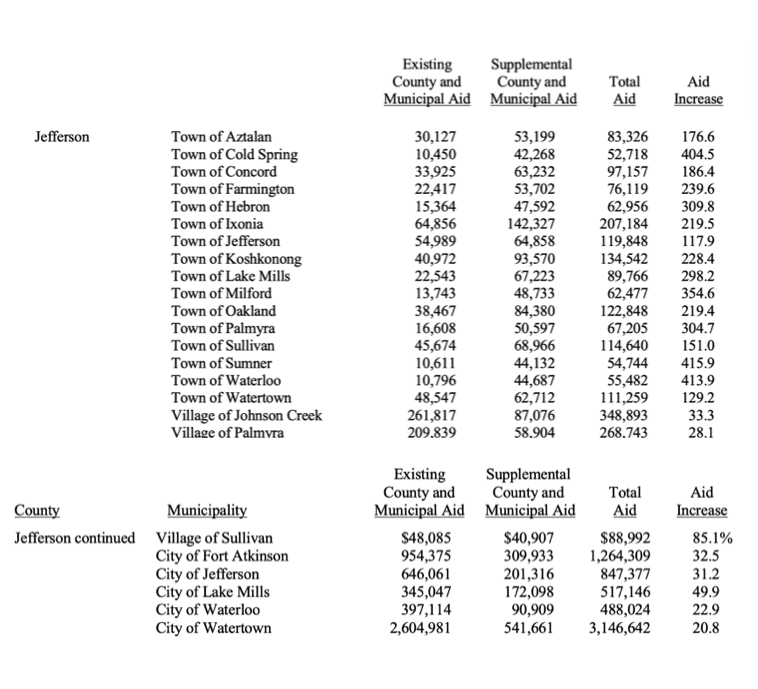

Two charts above: proposed 2024-25 supplemental aid as provided in a legislative memo is shown for municipalities within Jefferson County, at top, and Walworth County, above. The legislative document, showing the proposed supplemental aids for all municipalities and counties statewide, is here: https://docs.legis.wisconsin.gov/misc/lfb/bill_summaries/2023_25/0245_ab_245_relating_to_local_government_programming_and_funding_personal_property_tax_repeal_and_city_and_county_of_milwaukee_sales_and_use_tax_authority_and_pension_systems_5_16_23.pdf. Charts showing a breakdown of proposed supplemental aid by school districts are not yet available, according to a spokesperson in State Sen. Steve Nass’ office.
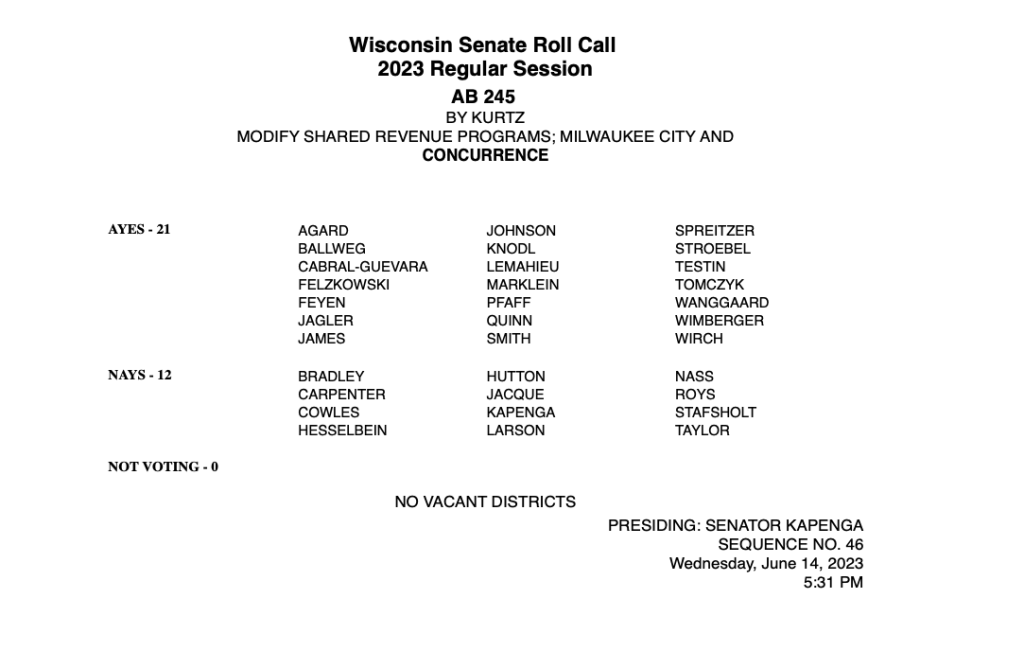

Two charts above: As shared on the Wisconsin legislative website, a chart, at top, shows which members of the Senate voted for and against AB245. The measure passed the Senate by a vote of 21-12, with Sen. Steve Nass among those voting against the measure. Above, a chart shows which members of the Assembly voted for and against AB245. The measure passed by a vote of 68-26, with Reps. Scott Johnson and Ellen Schutt each voting in favor of the measure.
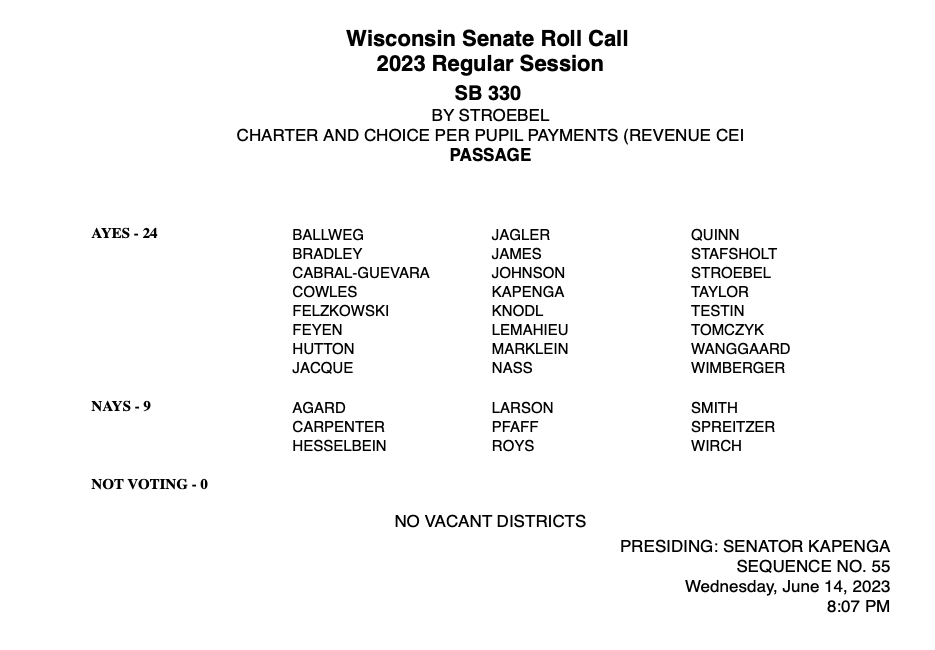

Two charts above: As shared on the Wisconsin legislative website, a chart, at top, shows which members of the Senate voted for and against SB330. The measure passed the Senate by a vote of 24-9, with Sen. Steve Nass among those voting in favor the measure. Above, a chart shows which members of the Assembly voted for and against SB330. The measure passed by a vote of 62-31, with Reps. Scott Johnson and Ellen Schutt each voting in favor of the measure.

The Wisconsin State Capitol, file photo/Kim McDarison.
Single unit receives damage after apartment building fire on Tratt Street
(Originally published June 18, 2023.)
The Whitewater Fire Department Saturday responded to an apartment fire on Tratt Street.
According to information released by the department also on Saturday firefighters and EMS personnel were dispatched at 8:16 a.m. after receiving a report of a fire at 370 N. Tratt St.
Initial reports noted that fire alarms in the building had been activated and there was reportedly smoke and flames of an unknown origin coming from an apartment.
Crews arrived on the scene at approximately 8:20 a.m. at which time they found smoke visible from the exterior of the building and “numerous” occupants evacuating.
The released noted that firefighters determined that the fire was coming from a downstairs apartment, and was “believed to have started in the kitchen.”
To battle the fire, crews were able to “stretch a line” into the building to extinguish the fire and limit the amount of damage to the structure, the release stated.
Damage from the fire was limited to the apartment of origin. No other apartments within the building were affected, the release noted.
Department officials report that there was no loss of life in the fire, and only the occupants of the apartment in which the fire originated were displaced.
Firefighters remained on the scene after the fire was extinguished to remove smoke from the building using a ventilation process, which, the release noted, took “a couple hours.”
During the fire, a request for mutual aid was made, with help arriving from the following departments: Lauderdale/LaGrange, Jefferson, Lakeside Fire, and Elkhorn.

Smoke and fire damage occurs in a single apartment within a building on Tratt Street. According to Whitewater Fire Department officials, the fire began in the apartment’s kitchen.
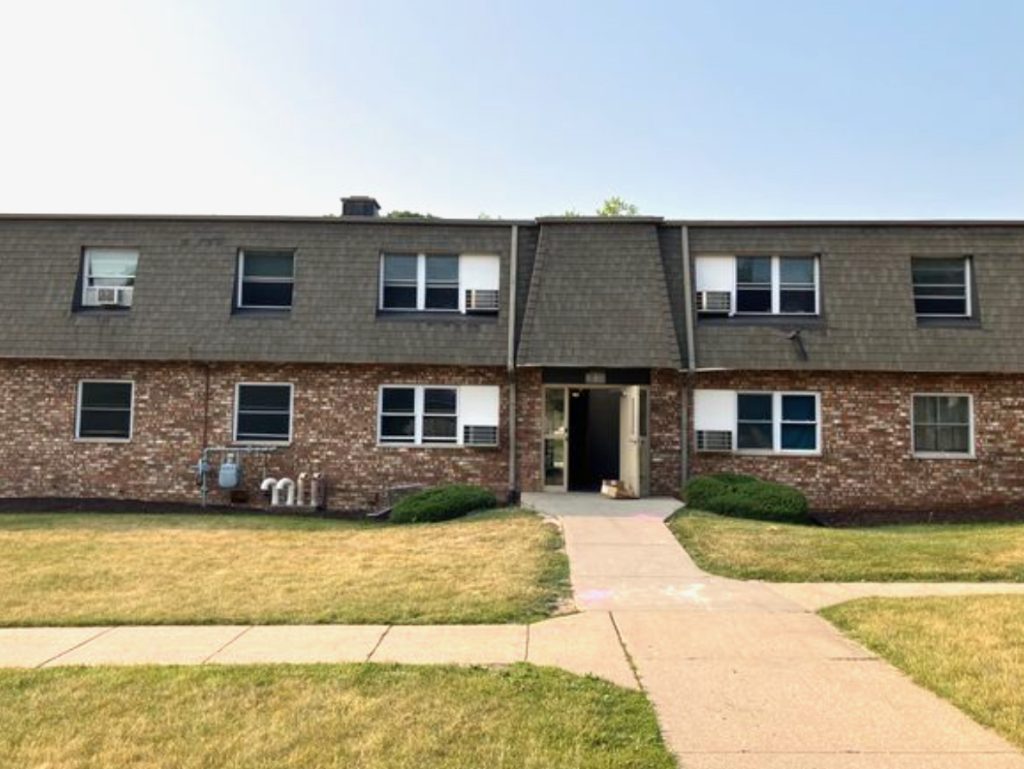
An apartment building on Tratt Street. A fire was extinguished at the site, in the 300 block of N. Tratt Street, Saturday morning.
Photos contributed by the fire department through Facebook.
Tensions escalate during Aquatic Center Subcommittee meeting; district proposes operating lap pool
(Originally published June 20, 2023.)
By Kim McDarison
A two-part meeting of the Whitewater Aquatic and Fitness Center Subcommittee Wednesday was characterized by heightening tensions between the two negotiating entities — the school district and the city.
Discussions between the entities intensified as subcommittee members grappled with two proposals, one offered by each entity, for aquatic center operations and capital improvement expenditures.
During the meeting, which was held in the library at the Whitewater High School, subcommittee members learned about a new proposal offered by the district, indicating its desire to assume operational responsibilities for the center’s lap pool, leaving the operations of the leisure pool and the fitness center with the city. The agreement further proposed that the district would become responsible for maintenance and repair to the center’s roof over the lap pool and its utilities room, along with any maintenance to the center’s parking lot, while the city would become responsible for the roof over the center’s leisure pool and fitness center.
At the onset, tensions flared over issues concerning agenda items, which stemmed from confusion about which of two agendas — one created by the city and one created by the district — would be used to guide the meeting, and, as the meeting progressed, during discussion about whether high school students could be allowed to visit the aquatic center’s concession stand during their scheduled lunch periods.
As frustrations became more apparent, City Council President Jim Allen, who also serves on the subcommittee, asked if the tables at which the subcommittee members sat could be reconfigured from a dais-style, with subcommittee members facing the audience, to a configuration more consistent with that found in a conference room, with subcommittee members facing one another. Additionally, he asked district and city support staff members, including Whitewater City Manager John Weidl and the city’s Parks and Recreation Director Eric Boettcher, along with Whitewater Unified School District Superintendent Caroline Pate-Hefty and the district’s director of buildings and grounds, David Friend, and finance director Ben Prather, to disengage from the discussion and find seating in the gallery along with members of the public.
With tables reconfigured, a second half of the meeting proceeded, with discussion continuing between Allen, and council members Lisa Dawsey Smith and Jill Gerber, and board of education members Jennifer Kienbaum, who served Wednesday as subcommittee chairperson, and Lisa Huempfner. A third board member, Miguel Aranda, was not in attendance.
While Allen assured those in attendance that the meeting, as posted on both agendas, would remain open, those seated in the room could not hear the conversation conducted during the meeting’s second half, and recording equipment provided by the district produced audio that was difficult to understand. In accordance with open meeting laws, Fort Atkinson Online also made an audio recording of the full meeting.
Some 15 people were in attendance as audience members, including Whitewater Unified School District Board of Education President Larry Kachel and board member Stephanie Hicks, and Whitewater Common Council member, David Stone, along with several members of a community-organized group called: “Save the Pool,” including Jeff Knight and Geoff Hale.
Disagreement arose early in the meeting after audience members became confused about which agenda — one submitted by the city and one submitted by the school district — would guide the meeting. Kienbaum told those in attendance that the meeting would follow an agenda as submitted by the school district because the meeting was being held in a building owned by the district. Members of the public objected, suggesting, instead, that an agenda submitted by the city was more appropriate because it offered more opportunities for public comments.
One commenter noted that the city’s agenda was published on an online community website, making it more available to residents than the district’s agenda.
Kienbaum asked the district’s Administrative Assistant to the Superintendent Jaclyn Tueting to make meeting attendees aware of where the district’s agenda had been published. Tueting said the agenda had been published in the district’s official newspaper, which, she said, is the Whitewater Register.
Public comments
Kienbaum, opening the floor at the top of the meeting to public comments, told those in attendance that the agenda section would be the only opportunity during which members of the public would be allowed to speak.
Hale pointed to a format used as part of the city’s open meeting process which offered additional opportunities for public comment.
He asked: “Are we allowed a rebuttal if we don’t like what happens tonight?”
Pate-Hefty told Hale he would not be afforded that opportunity during Wednesday’s meeting.
“This is a meeting of the school board, so this will be the only section in which public comments can be made,” Kienbaum said.
Also, as a matter of process, printed on the city’s agenda and read as a motion by Dawsey Smith, subcommittee members representing the city were asked to waive a 72-hour notice required by the city’s transparency ordinance.
Weidl noted that the motion was required because the city had not received some documents from the school board in time to publish them 72 hours before the meeting. City representatives on the subcommittee unanimously approved the motion.
Frustrations escalated over whether to allow public comments beyond the single opportunity provided on the district’s agenda.
Allen cited the “joint” nature of the meeting, further noting that the city’s process would allow additional comments.
Kienbaum asked members of the public to sign in and come to the podium.
Arriving at the podium, Whitewater resident Chuck Mills said: “I’ve never seen so much division from the school board and the council, and the general public.”
Mills said he had been trying to determine why, by his understanding, a “$50,000 deficit per year in the last five or six years” would have an impact that might cause the community to “give up the pool.” He described the pool as costing “$20 million to build,” and worth, by his estimation, “$50 million” would the community try to build the same facility today.
He alleged that some people might be speculating that turning the facility into a daycare center might look like a “cash cow.”
He said, by his calculation, some “2,000 people in this community” use the pool, and that finding $50,000 a year to offset what he saw as the deficit was something the community needed to resolve, adding: “it’s nothing we couldn’t overcome. We built the thing to begin with and let me remind you, it is our pool. It’s not the school system’s pool; it’s the public’s pool. So we need to, as the public, not let them take this facility from us.”
Addressing subcommittee members, Hale said he would make his comments at a later section within the agenda.
Discussion ensued about whether he would be offered another opportunity to speak.
Allen said he didn’t have an issue with allowing comments further down in the agenda.
Kienbaum said the district’s agenda was not the same as the city’s.
“This is our agenda for our meetings in our facilities. We follow their (city council member’s) rules when we are at their location and they are running the meeting. I’m sorry,” she said.
Directing his comments at school board representatives, Hale said: “That’s why this is so screwed up; this whole thing is so screwed up.”
Knight also addressed the subcommittee, saying: “I just wanted to highlight probably one of my bigger concerns is the lack of communication between the school board and the city. This is the agenda that was posted, this is the one that we got” he said of the city’s agenda. “We don’t get a mail from you Jen (Kienbaum),” he added.
City, district proposals
The subcommittee next reviewed proposals as submitted by the city and the school district to operate the aquatic facility. Offering a recap, Weidl said the city’s proposal called for a four-year agreement between the city and the district, calling for each entity to earmark $219,000 for facility operations in 2024, with that number increasing by 3% in subsequent years of the contract. The proposal also called for each entity to set aside $70,000 for a combined total of $140,000 for capital expenditures. In addition, the city would take responsibility for any operational deficits moving forward.
Weidl called the proposal a “starting point,” noting that he believed the council’s objective was to create a “multi-year agreement” that would support “the service levels and hours as they exist.
“We want to do that in a shared way, both on the risk side and the payment side,” he said, adding that $219,000 represented a $40,000 increase from last year.
Kienbaum confirmed that the total ask by the city from the school district for operational and capital expenditures at the center in 2024 would be $289,000.
Weidl agreed with her calculation.
She pointed to an earlier calculation made by the city in which a total cost to operate the lap pool was calculated at $370,472.
Weidl agreed the earlier number was high, saying: “We found an error.”
A new memo, he said, noted a figure of $326,000 to operate the lap pool.
Kienbaum said the district was interested in making a proposal in which it would only become responsible for the lap pool.
Said Kienbaum: “We will be 100% responsible for all costs incurred, we will have it separately metered so we will be able to ensure the cost of utilities are accurate, we’ll be responsible for all the maintenance and upkeep of it, we’ll separate out the boilers, we’ll be responsible for the roof over the top and you guys can take over the leisure pool and the fitness center. And then I believe if you are taking your $326,000, minus the $289 that you would expect from us on an annual basis, that would be a difference of about $37,000. We would just ask that that could be applied to the deficit for the past year that’s been incurring.”
Dawsey Smith asked if the district’s proposal would continue to make the lap pool available to members of the Whitewater Aquatic and Fitness Center.
Said Kienbaum: “As long as you guys have a membership and you want to use it, we would then work on an agreement where, yes, the individuals that currently have memberships could continue to use it.”
Gerber asked what the outcome for the public would be if the city opted not to provide access to the lap pool as part of its offered memberships.
Kienbaum said the district would discuss and decide what it might offer to the public.
Gerber asked about such services as fee collections for memberships, staff to greet members and provide towels. She wondered if the city would continue to provide those services and if it would be compensated.
Kienbaum said those details would need to be worked out, but, she said, she hoped the city would want to “work out a negotiated arrangement” through which it could continue to “use those facilities.”
Said Gerber: “How would we sell memberships if we don’t have control of the hours of when it’s available, to set hours for people, and if you start cutting in more into the programming, and then you remove it to the public, how are we going to sell memberships? Part of us selling memberships is fees to the lap pool.”
“It’s not our intention to cut into those hours,” Keinbaum said, adding: “It’s no different than us utilizing your facility during summer school or swim team … it would just be kind of a reverse.”
Allen asked who would staff the lap pool.
Kienbaum said the district would staff the pool while it was open for its swim team and summer school use, but during other hours of operation, when the district was not using the lap pool, the city would need to provide staff, including lifeguards.
Gerber asked why the city, as an entity that is leasing the space, would be interested in paying for the repairs to any portion of the building’s roof.
“It’s your roof. Why should we pay for it?” she asked.
“Because we are taking on over $300,000 in risk,” Pate-Hefty said.
“But you wanted the pool, so take the pool, and let’s say we are not going to do any memberships or open it to the public. So it’s your pool, its completely your roof,” Gerber said.
Friend said to maintain the pool facilities, the rent charged to the city, which, he noted, was $1, would need to increase.
“So we are in the same spot. We can’t agree,” Gerber said.
She added: “Your choice of taking on the pool affects our memberships, again, which affects us hiring people, us hiring lifeguards, and we are in the same spot, it’s just you’re controlling the hours of the lap pool and how much access we have.”
Pate-Hefty said the city would be provided with the same number of hours it currently has.
“There’s no limitations,” she said.
Huempfner said a goal of the board was to simplify the agreement.
“I think it makes a lot of sense for the public as well if you look at it this way. Neither of us wants to have to go to referendum,” she said.
“We don’t have to,” Weidl said.
Said Huempfner: “We need to provide for education, and the lap pool presents that piece for us. That is the biggest piece toward education (and) then the summer school programming, which we would figure out an agreement with you to rent your space for our summer school program, but I think that this simplifies it for the public. The public can see that more clear, and to me, as a community member, it’s more clear that the part that is more of a community service is the waterpark/leisure pool, and the fitness center, and the part that is more of the academic piece for the school district, if it gets divided this way, it just makes sense. Your numbers show that we have the greater cost.”
Expressing some frustration, Allen said “I came into this (negotiation) assuming, wanting to stop the ‘us, them’ ok?” He added: “And yet, every time we come to a negotiation with you, you don’t even address our concerns or our proposals, and we are back to debating yours. I don’t see a real give and take here. And I’m not criticizing the voting members.”
Kienbaum said the district was “trying to make it abundantly clear” that it was not “in the business of running a leisure pool or a fitness center.”
The district was providing proposals focused on its support of capital expenditures because, she said, “it is our building and we do have sufficient staff that are trained that could adequately maintain it.”
Weidl said he didn’t believe either entity was in “the business of anything,” citing both as nonprofit organizations. He defined both as service-based, and characterized the negotiations as becoming “extremely transactional,” further defining the aquatic center as “something that was fundraised for and developed to be transformational.”
He suggested the body should “stop worrying so much about who’s paying for what,” and instead “focus on services we are providing.”
Kienbaum expressed concern over what she described as the board’s inability to have control over day-to-day operations of the facility, pointing, additionally, to her concern about weekends during which the pool was closed.
On the capital improvement side, Kienbaum said the city was not providing adequate documentation about how capital funds were being spent.
“At the end of every year, I don’t know what happens to it. I don’t know if you are putting it in a rainy day fund or — so I guess there’s a lot of concerns by the board as to capital and what it’s going to be used for — the upkeep of maintenance, because we haven’t seen it in the past, and I think that’s where our first proposal was coming from is we want to make sure that’s getting done and it’s getting done correctly,” she said.
Weidl said perhaps the city council would be open to allowing the school district to hold onto the monies set aside by both organizations for capital improvements.
Subcommittee members agreed to a contractual term of four years.
Also included in the district’s proposal was a desire on the district’s part to survey the community about the pool.
Pate-Hefty said the survey would include questions beyond those associated with the pool and would likely be conducted by a third party.
Kienbaum said a “driving factor” of the survey was to learn from the public, whether, would the district accept any of the city’s proposals, it would be behind any associated increases in taxes.
Concessions
Allen noted that the city would be interested in seeing concession sales made available to high school students at lunchtime.
Said Pate Hefty: “Closing concessions is an administrative determination, not a board-level determination.”
She noted that during COVID, the Wisconsin Department of Public Instruction was looking to separate students at lunchtime. With 100 to 150 students in the high school cafeteria during a single period, Pate-Hefty said the district allowed students to go off campus for lunch. During that time, she said, “we had two serious accidents,” and, she noted, attendance rates were “significantly impacted following lunchtimes.”
Pate-Hefty said the district consulted its insurance carrier and other schools within the Rock Valley conference before deciding to close campus during lunchtime.
Additionally, she said, in September, 2022, the federal provisions for free and reduced lunch “reactivated.”
She said that would the district allow the sales of foods that were not federally approved, it would risk losing funding for its free and reduced meal program.
Foods sold at the center’s concession stand are not approved, she said.
Discussion ensued around how the concession stand at the aquatic center was defined.
With the stand defined as an off-campus site, Weidl said, “a pen stroke” on the part of the superintendent could allow the students to visit the aquatic center.
“You could, literally, if you wanted to, as the administrator, say we are not allowing off campus lunches, except for this one place, which is right here, down a hallway, and we would both comply with the federal guidelines, plus the WAFC would be allowed to sell concessions,” he said.
“And what we are telling you is that we can’t and won’t sacrifice safety …” Pate-Hefty said.
She said the decision to close campus was made by a leadership team, including herself, and the high school principal.
“I support and back it, and it will not be changed,” she said.
Said Weidl: “It’s down the hallway. You have cameras. There’s a cop in the building.”
Pate-Hefty said there was not a camera in the hallway adjoining the center to the school, and additional safety issues were present because students might have to walk past the pool.
Weidl said the city would install a camera.
“You’re undermining the necessary supervision that needs to occur for students,” Pate-Hefty said, adding: “my job and the high school principal and leadership team’s job is to make sure kids are safe, that is not your call.”
Kienbaum suggested the city consider selling concessions to students before and after school.
Gerber said she was concerned about labels associated with the concession stand, noting that sometimes the district calls it an on-campus facility, in which case it would need to follow rules about federally approved foods so the school is in compliance with free and reduced meal guidelines, while other times, the district labels the stand as off-campus, which eliminates a need to be within federal guidelines about foods, but makes the site a safety concern.
She noted that visiting the stand did not require getting into a car, nor did students need to walk past the pool.
“We are willing to comply with things that provide another option for students to have lunch,” she said, adding: “We are either on campus or we are off campus, so you confuse me each time you say we are or aren’t.”
Kienbaum suggested the city consider a cart that could be brought to the cafeteria during lunchtime from which the students could purchase foods sold by the stand.
Weidl said the city would be willing to address issues of food compliance and safety.
Said Pate-Hefty: “For $9,000,” the amount, she said, the city cited as income it could make from selling snacks at lunchtime, “you cannot address our students’ safety — ever. I won’t ever put our kids at risk for that. I’m not going to put a kid down a back hallway, walking across a pool, so that they can get a snack … I would encourage you to look at your business model, and look at other options. And we’re glad to help you with other options if you need ideas, because that’s what businesses do when things change.”
Pate-Hefty called the $9,000 figure “contrived,” noting that is was based on “hours in a day” rather than calculated through “POS” (point of sales).
Subcommittee members discussed the possibility of the aquatic center selling concessions during school dances and other events.
Weidl said the district was making a decision without giving any consideration to the city’s ask.
City’s action plan
Boettcher next offered a brief presentation recapping the city’s action plan to improve memberships.
Among challenges, he said, was hiring more lifeguards.
He noted plans to create training opportunities for lifeguards in conjunction with the school district through a lifeguard training class.
In addition, he was working with the Friends of the Whitewater Aquatic Center group to provide an incentive program for those taking training classes and signing up to work “a certain number of hours” for the city, he said.
He hoped to have staff “built up” in the next one to three months, he said.
The city also has set a goal of signing up 40 new annual members over the next year.
Kienbaum suggested the city consider contacting communities with outdoor pools to see if their lifeguards would be interested in picking up more hours when cooler weather arrived, closing their pools for the season.
Boettcher agreed that was a good idea.
Weidl said the city also hoped to be able to offer over time a more competitive wage to attract lifeguards. Currently the city pays between $13 and $16 an hour for lifeguards.
“Our average needs to be more like $15 an hour,” he said.
Weidl said he was taking the lifeguard training so he could offer his services on weekends. He called the situation one of “all hands on deck.”
Whitewater Aquatic and Fitness Center Manager Lorelei Bowen, who was among members of the audience, was invited by the panel to talk about new ideas for the center.
She said she, Weidl and Boettcher had visited the YMCA in Janesville and were exploring such ideas as virtual fitness, which would allow members to participate in a fitness program virtually from a location of their choosing at a time of their choosing.
The option could be provided without additional staff, but would require some equipment like a screen and lighting, she said.
Kienbaum suggested the city consider making use of the district’s mailing list as a means through which to communicate with the district’s families. She also suggested the city create a program that could be included in the district’s employee handbook, offering a “discount or benefit” to district employees.
“So, if it’s all hands on deck and we’re really trying to push this, then I guess we’d like to see a little bit more information so that we can make sure it’s getting marketed,” Kienbaum said.
Discussion excluding support staff
During the second half of the meeting, subcommittee members moved their chairs together so they could have, according to Allen, “a quick, frank discussion before we move forward. I think we are close, I’m not asking anybody to leave, just leave the space, stay in the room, but we might be able to get some things accomplished rather than waiting for another month.”
Said Pate-Hefty: “How are you doing that and continuing to have a public meeting?”
Allen said he would ask support staff to “step away,” leaving the voting members to continue a conversation.
“Everyone else can hear us,” he said.
During the ensuing discussion, Gerber said she was interested in opening a babysitting room at the aquatic center.
“I just don’t know how that would work with insurances,” she said.
“You’ve got amazing ideas, and I feel like I have great ideas, but none of us are doing the day-to-day operations. I’m not making sure the door’s open,” Kienbaum said. She described the board’s view of operations as one from 30,000 feet.
She said the board did not want to meddle, but there were issues.
Said Gerber: “You had a say, you just didn’t take advantage of it.”
She said mistakes were made by prior boards and councils, and that the Park and Recreation Board, which has oversight of the center, has two school district representatives. The individuals just needed to show up and speak up, Gerber said.
Kienbaum asked if the Park and Recreation Board was in charge of hiring and firing.
Gerber said it was not. The responsibility of hiring and firing rests with the city manager.
“They can recommend, they can say they are not happy with the things that are not happening, but John (Weidl) ultimately has the power to hire and fire,” Gerber said.
Kienbaum said she has brought friends from out of town to the aquatic center on weekends and found it closed.
Allen said the city needed more staff.
Kienbaum said that she would like to see more accountability.
She said the district had concerns about accountability and capital expenditures.
Gerber said she was supportive of the district taking on the responsibilities of capital expenditures.
“I consider it your building anyway, so if you want to control the capital, I don’t have a problem, but the same thing, I think it has to go through the Park and Rec Board with your two members and just get approval from the Park and Rec Board. That way, we both have a say,” she said.
Kienbaum stressed the board’s desire to keep the capital improvements money in a district fund.
Gerber responded by saying, “fine.
“We just need to make sure that that Park and Rec Board is an active body and the aquatic center stays on a monthly agenda every time it’s there. And when you have two people assigned, they need to be present or send people in their place.”
Said Kienbaum: “I can probably get the board to come to an agreement if we could contribute more in capital than operations, because for our constituents, it’s our building and it’s an easier sell for us to be able to say it’s our building, it’s our equipment, as opposed to we’re running a leisure pool and a fitness center.”
Subcommittee members talked about the value of the lap pool as an academic component.
“Our phy-ed classes can now use it year-round,” Kienbaum said.
“Your phy-ed classes could incorporate our leisure pool or our fitness center, too,” Gerber said.
Along with athletic program benefits, Gerber said the fitness center offers opportunities to students who are not necessarily involved in athletics.
“You are incorporating a group of kids that aren’t being supplied by your school district by having our fitness center attached,” she said.
She added: “Keep in mind, you’re looking for open enrollment. Your leisure pool is pulling in people from East Troy, Elkhorn, Fort Atkinson, you’re missing the opportunity to hit them up for open enrollment and showing your school. They are coming here, they see your school, they see your facility, so it does serve a purpose. You may not need the leisure pool for your students, but it serves for your open enrollment and also marketing on your end. And attracting teachers.”
Gerber asked Kienbaum for a dollar amount with which the district would be comfortable as its contribution to the center’s operating costs.
Kienbaum asked Prather to join the conversation.
“There’s a threshold where we cross a certain amount, we then are guaranteed to raise taxes on our constituents, and we can’t cross it,” Kienbaum said.
Gerber said that splitting the costs as proposed by the city was likely the least expensive option for both entities.
When asked if the city’s ask of $289,000 would cause the district to need to raise taxes, Prather said: “It’s a huge calculation.”
He asked: “Is the overall number changing? If the overall number is not changing, we are going from $178(,000) right now to $289(,000), then yes, it would increase, but with tax formulas, there are so many variables, there’s how many students, the Legislature, because the Legislature hasn’t passed a budget, and so I told (former City of Whitewater Finance Director) Steve (Hatton) this … I said: ‘hey, don’t tie yourself to our assumptions because our assumptions aren’t final until November.’
“So just simple math would be that we’re increasing through our Fund 80 levy from what it was. … so it would be an increase. Maybe our student count decreases, which could offset that, but right now the state is looking to kick in over $300 onto the revenue limit, the tax formula per kid.”
Prather continued: “I don’t know if the rationale was ever shared, I’m thinking over the last pool overall costs, … we hired a new maintenance guy who’s skilled in pools that we thought we could bring that maintenance cost down running the lap pool. That’s why we’re willing to swallow a little bit more up front toward the longterm goal.”
Prather said he could “run an estimate,” but his budget was tied to the state budget. He said he could create estimates based on enrollment numbers which will become known to the district in September, further noting that the district will create an “actual budget” in October.
Whatever the solution, Kienbaum said, it could not bring higher taxes to the district’s constituents.
From the district’s perspective, she said, the plan was for the maintenance person to become a certified plumber and he was taking courses for pools. He then could help reduce costs, which, she said, is why the district is interested in taking on more of the maintenance expenses.
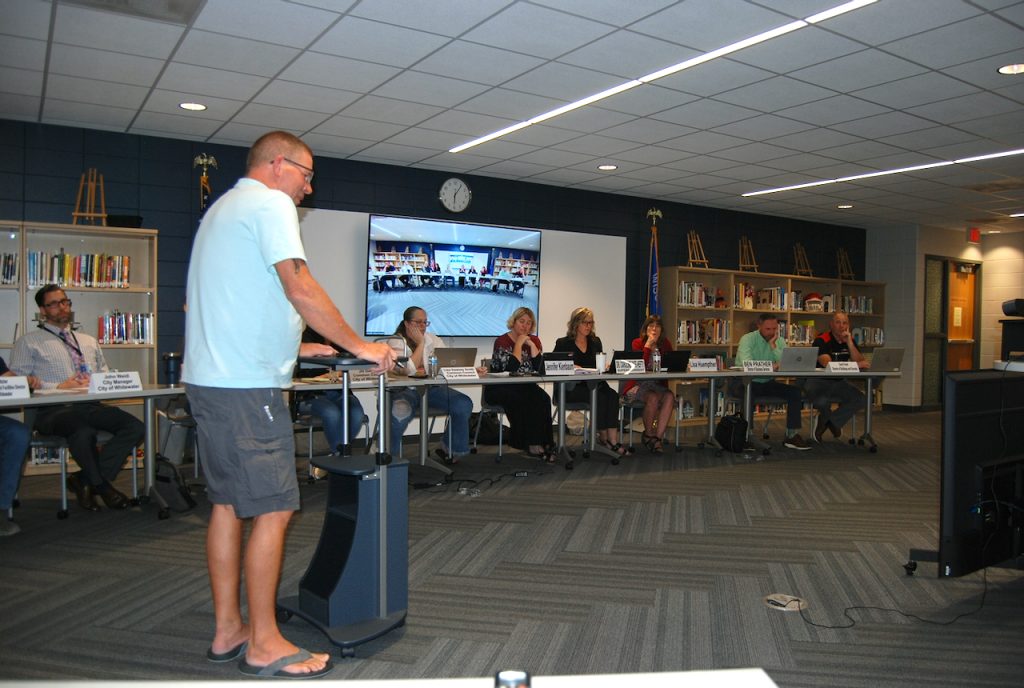
Members of the Whitewater Aquatic and Fitness Center Subcommittee assemble Wednesday at the Whitewater High School library. The committee began its meeting assembled in a dais configuration in front of its audience. Chuck Mills, a Whitewater resident, was among four speakers arriving at the podium during public comments.
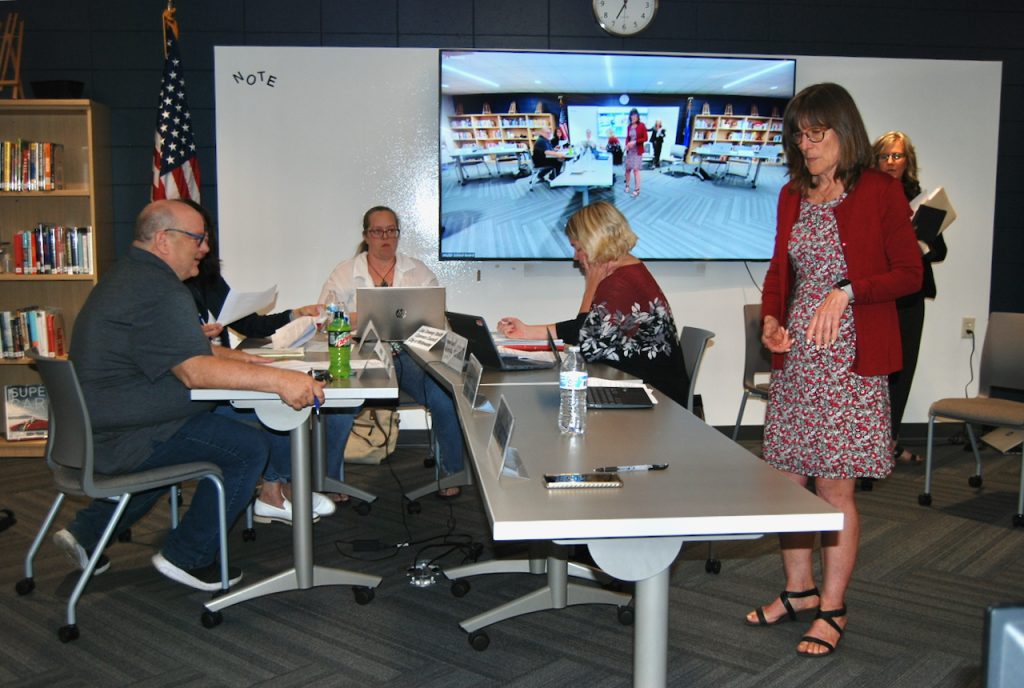
At the request of aquatic center subcommittee member Jim Allen, at left, aquatic center subcommittee members rearrange their tables into a configuration similar to one found in a conference room. Remaining at the table are Whitewater Common Councilwoman Jill Gerber, pictured behind Allen, Whitewater Common Councilwoman Lisa Dawsey Smith, following Allen, from left, Whitewater Unified School District Board of Education member Jennifer Kienbaum and Whitewater Unified School District Board of Education member Lisa Huempfner. Supporting staff members formerly seated at the dais were asked to leave the discussion table.

Whitewater Aquatic and Fitness Center Manager Lorelei Bowen, from left, Whitewater Parks and Recreation Director Eric Boettcher and Whitewater City Manager John Weidl find seats in the audience after being asked to disengage from discussion during the Whitewater Aquatic and Fitness Center subcommittee meeting.

Whitewater Unified School District Director of Buildings and Grounds David Friend, from left, district Finance Director Ben Prather and district Superintendent Caroline Pate-Hefty find seats in the audience after being asked to disengage from discussion during the Whitewater Aquatic and Fitness Center subcommittee meeting.
Kim McDarison photos.
Meisner Legacy Band attracts more than 100 fans to Whitewater’s ‘Savory Sounds’ concert
(Originally published June 23, 2023.)
By Kim McDarison
As polka and other music filled the air some 100 Steve Meisner fans founds vantage points in the shade near the Birge Fountain in Whitewater.
The small park, located in front of the Whitewater Cultural Arts Center, is home to the “Savory Sounds” annual concert series. The Steve Meisner Legacy Band performed Thursday, offering the first concert in the series, which is facilitated through the Whitewater Arts Alliance.
Thursday’s concert was the fifth performed by the legacy band and the first performed in Whitewater, since the death of Steve Meisner on June 1. Meisner lived in Whitewater, and members of his family continue to make the city their home.
Meisner died shortly after receiving a diagnosis of stage 4 cancer. He was 62. His music has been an area staple over the course of his career, as he and the band performed in indoor and outdoor venues, and were often featured favorites at area festivals and parades.
According to his obituary, “Steve was a multi-talented musician, entertainer, composer, and arranger who traveled the country and world with his band.”
The obituary noted that Steve Meisner began playing the squeezebox when he was 5, and later mastered the accordion, and “took on” the trumpet, tuba, bass guitar, button box and, occasionally, drums and banjo.
He enjoyed a career spanning more than 50 years, and performed with the nation’s top accordionists, polka icons and musicians, “sometimes averaging over 250 performances annually. He has either produced, performed on or created nearly 50 projects, including LPs, CDs, singles, jingles, commercials, movies, and videos — including appearing as a guest on other artist’s recordings. He appeared in two movies, countless times on radio and on national, regional and local television,” the obituary noted.
He also was the recipient of “numerous awards from nearly every polka and ethnic organization, including the International Polka Association (IPA), National Cleveland-Style Polka Hall of Fame, Wisconsin Polka Hall of Fame, Wisconsin Area Music Industry (WAMI), Iron World Polka Hall of Fame (and) Maryland Accordion Club,” among others, the obituary stated.
Steve Meisner’s full obituary is here: https://nitardyfuneralhome.com/tribute/details/319479/Steven-Meisner/obituary.html#content-start.
Among members of the audience Thursday were Meisner’s wife, Barbara, two daughters, Lindsey and Whitney, Whitney’s fiancé, Adam Issa, all of Whitewater, and Meisner’s sister, Michelle Bush, Milton.
As members of the band set up their equipment on the steps of the Cultural Arts Center, they talked about their time as members of the Steve Meisner Band and the recently formed legacy band.
Members performing Thursday included Tom Brusky, Milwaukee, who played the accordion during the Savory Sounds concert. He has served, on and off, and in different capacity’s with the Steve Meisner Band for about 20 years, he said; Drummer, “BB” Carter, Oak Creek, described himself as an “on and off” band member for some 40 years; Don Hunjadi, Wind Lake, who plays saxophone and sings, said, he has found “steady” involvement with the band for 12 years, and Jerry Bieniek, Cudahy, the group’s banjo and guitar player, has been involved for more than 20 years.
Remembering Steve Meisner and describing the goals of the legacy band, Hunjadi said: “There’s nobody that’s going to do what he did the way he did it. We have to acknowledge that going in.”
As members of the legacy band, he said: “Our attempt is to provide the same songs and the same variety of music,” but, he said, “It’s going to sound different.”
As the band continues its legacy tour, he said some four or five musicians who have played with Steve Meisner have been identified to perform as accordion players and vocalists during different concerts.
The legacy band is continuing with Meisner’s musical commitments, with plans to fill in for at least the next six months, he said.
When they formed as a legacy band, their first performance was at a Polish festival, Hunjadi said, adding that band members, as they performed, believed Steve’s spirit was with them.
“The accordion broke three times, and a cable fell out,” he said. A piano came on by itself, he added.
“We thought: ‘Steve is toying with us,” Hunjadi said.
Playing in Whitewater held special meaning for them, he noted, adding that the community is Steve’s hometown and they were aware that members of his family would be in the audience.
The legacy band plans to be back in Whitewater for the city’s upcoming Fourth of July celebration, Hunjadi noted.
The Savory Sounds concerts offer a pairing of music and onsite lunch venues. Thursday’s onsite lunch opportunity was provided by The Sweet Spot.
The full schedule of Savory Sounds concerts is here: https://fortatkinsononline.com/summertime-music-forts-community-band-offers-full-itinerary-whitewater-continues-with-savory-sounds/.
Photos from Thursday’s event follow.

Members of the Steve Meisner Legacy Band, including: Jerry Bieniek, from left, Don Hunjadi, Tom Brusky and “BB” Carter, perform Thursday from the steps of the Whitewater Cultural Arts Center.
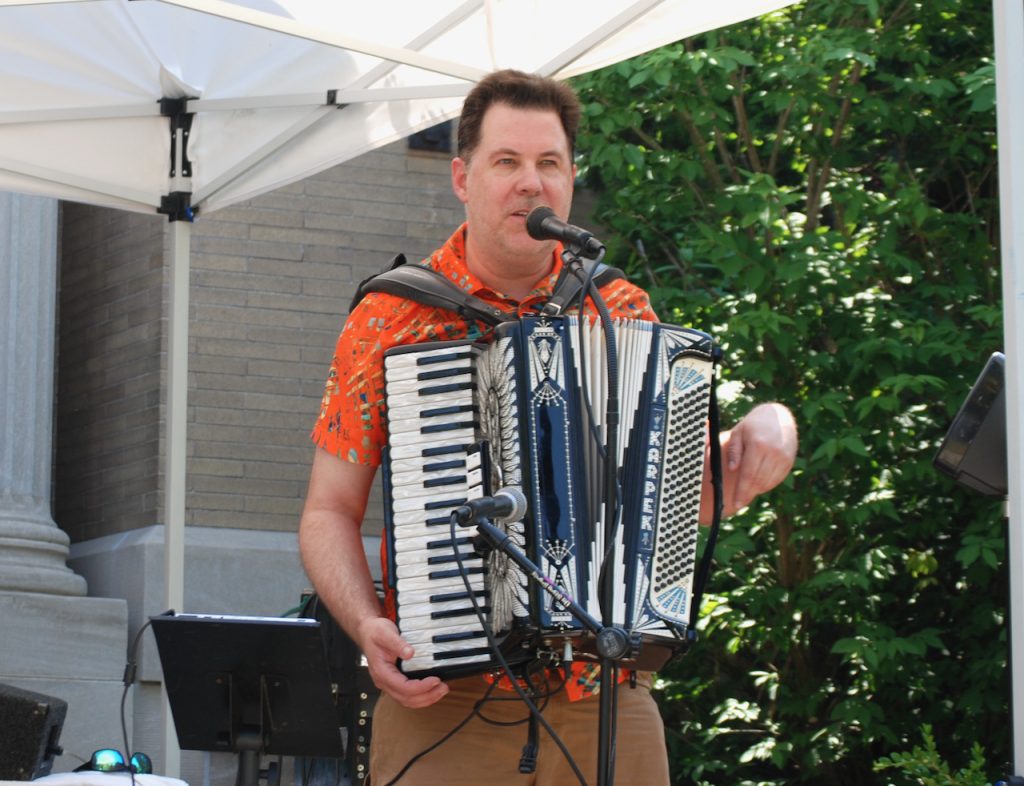
Playing the accordion, Tom Brusky fills in for the late Steve Meisner. A resident of Milwaukee, he served as a member of the Steve Meisner Band “on and off” for 20 years. The Steve Meisner Legacy Band has formed to honor The Steve Meisner Band’s commitments for at least the next six months. Steve Meisner lost his battle with cancer on June 1.
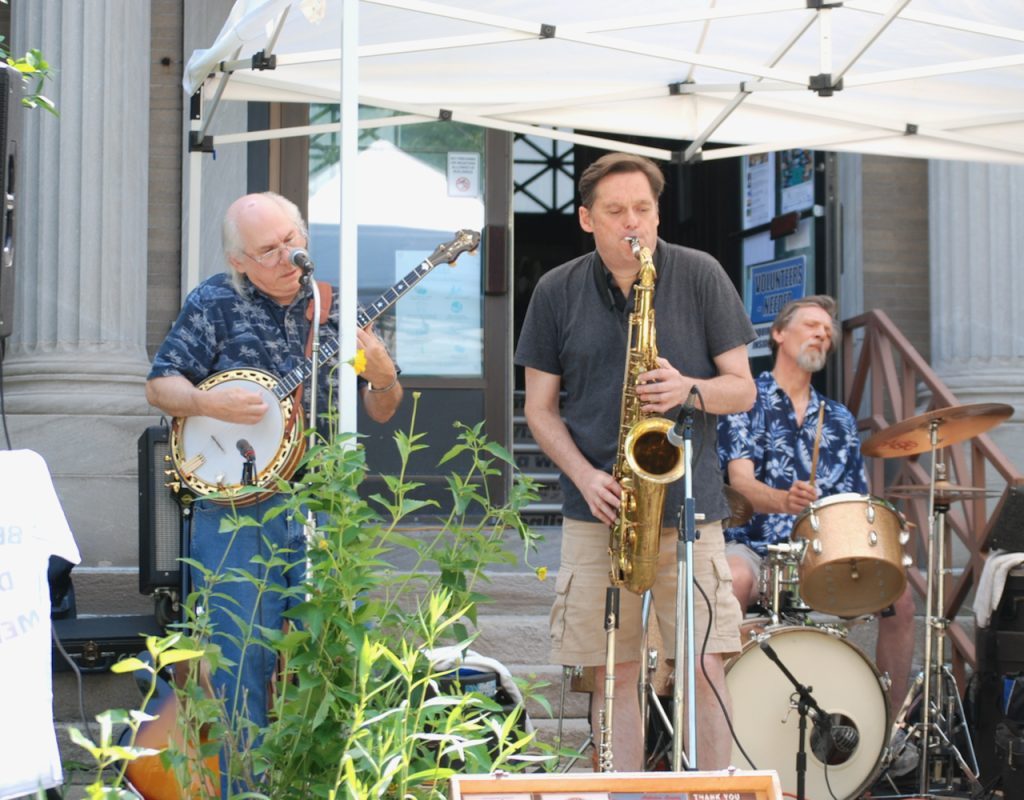
Jerry Bieniek, from left, Don Hunjadi and BB Carter play from the steps of the Whitewater Cultural Arts Center.
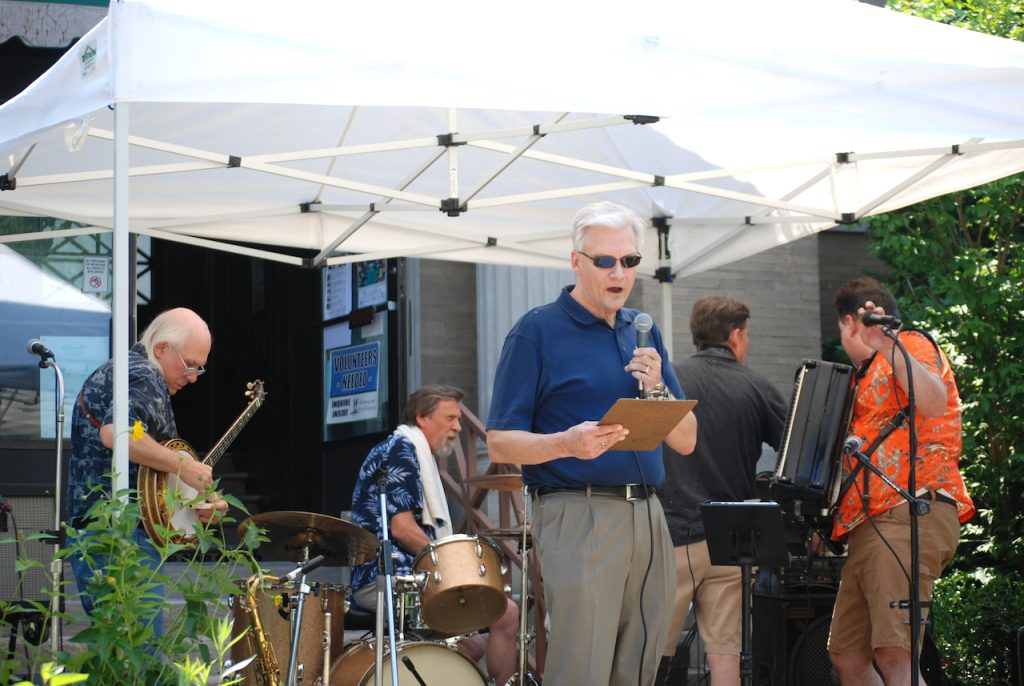
Whitewater Arts Alliance Board of Directors member Art Thompson welcomes event-goers to the first Savory Sounds concert of 2023.
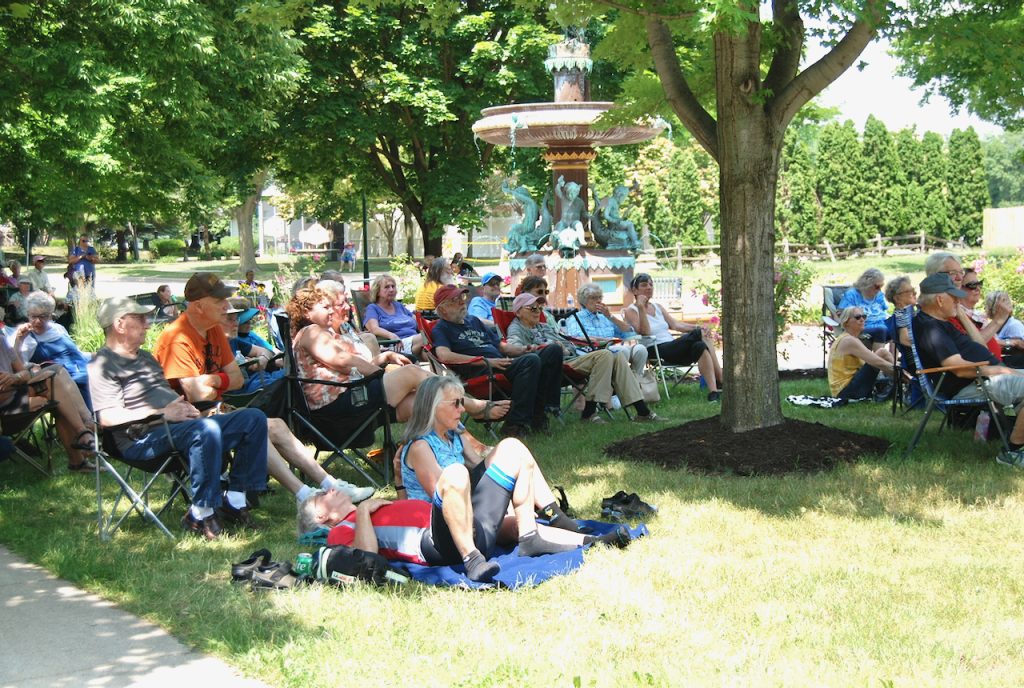

Two photos above: A crowd of approximately 100 people find places in the shade from which to enjoy the Steve Meisner Legacy Band.

Michelle Bush, Steve Meisner’s sister, Milton, at right, arrives at the Savory Sounds concert with her friend Angie Hoffman, Richmond.

Ellie Hartmann, at left, attends the Steve Meisner Legacy Band concert with her friend, Barbara Meisner. Barbara, Whitewater, is the wife of the late Steve Meisner for whom the band is named.

Meisner family members, including Steve’s daughters, Lindsey, from left, and Whitney, and Whitney’s finance, Adam Issa, all of Whitewater, are among event-goers to Thursday’s concert.

The Sweet Spot owner Elena Gildemeister, at right, helps a customer. The Sweet Spot, a Whitewater-based eatery, provided lunch opportunities during the Savory Sounds concert.
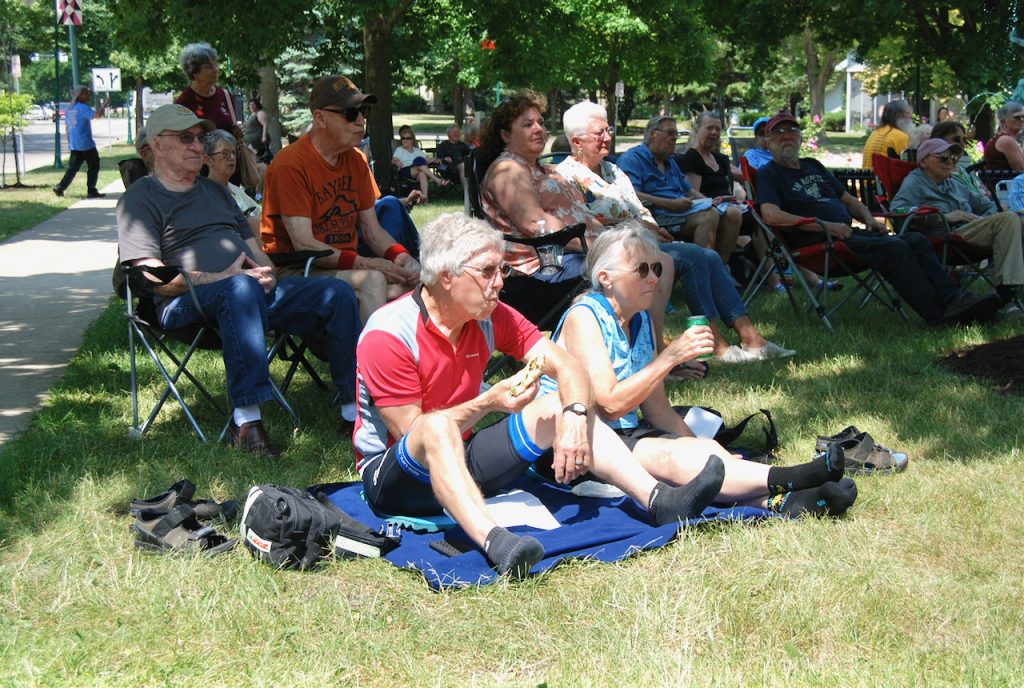
A couple enjoys lunch and music during Thursday’s Savory Sounds concert. The concert is the first in a series planed over the course of the summer. The series is facilitated by the Whitewater Arts Alliance.
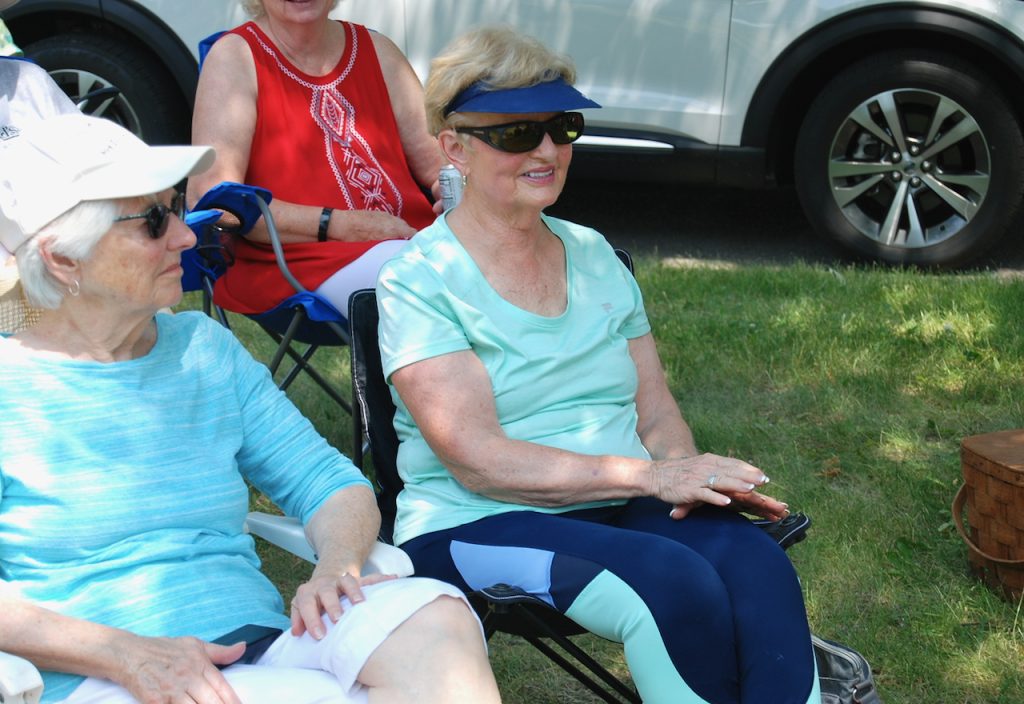
A concert-goer moves to the music.
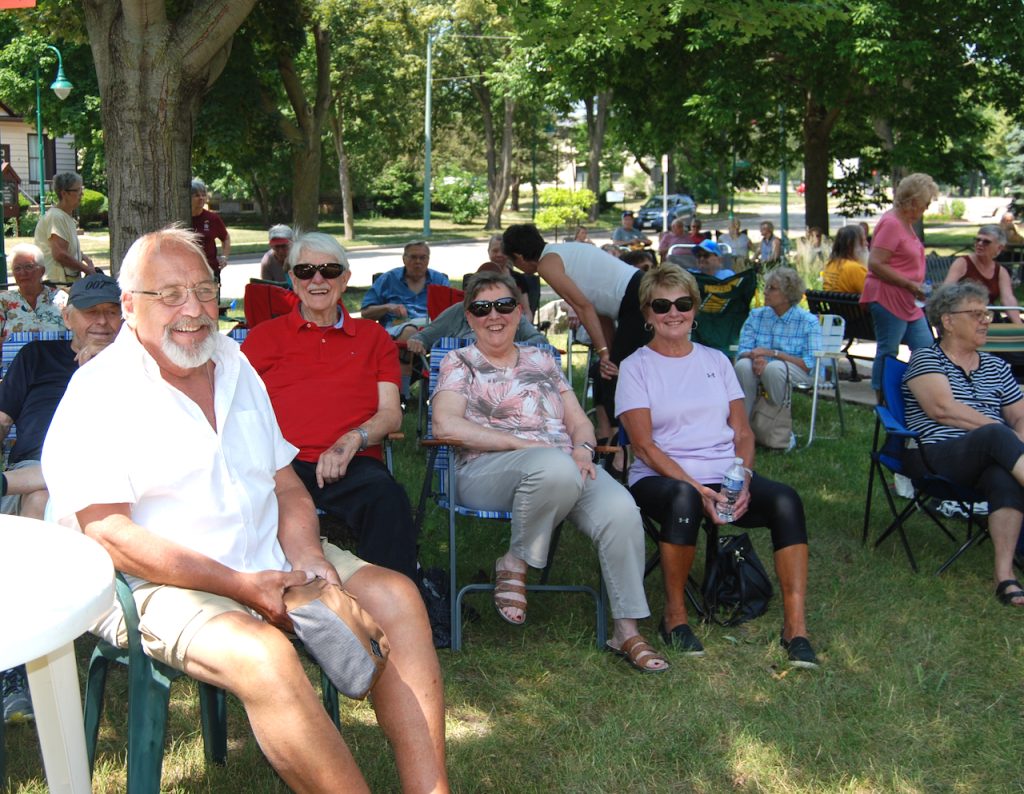
Concert-goers assemble in the shade in advance of Thursday’s performance.

A concert-goer sports a Meisner t-shirt.
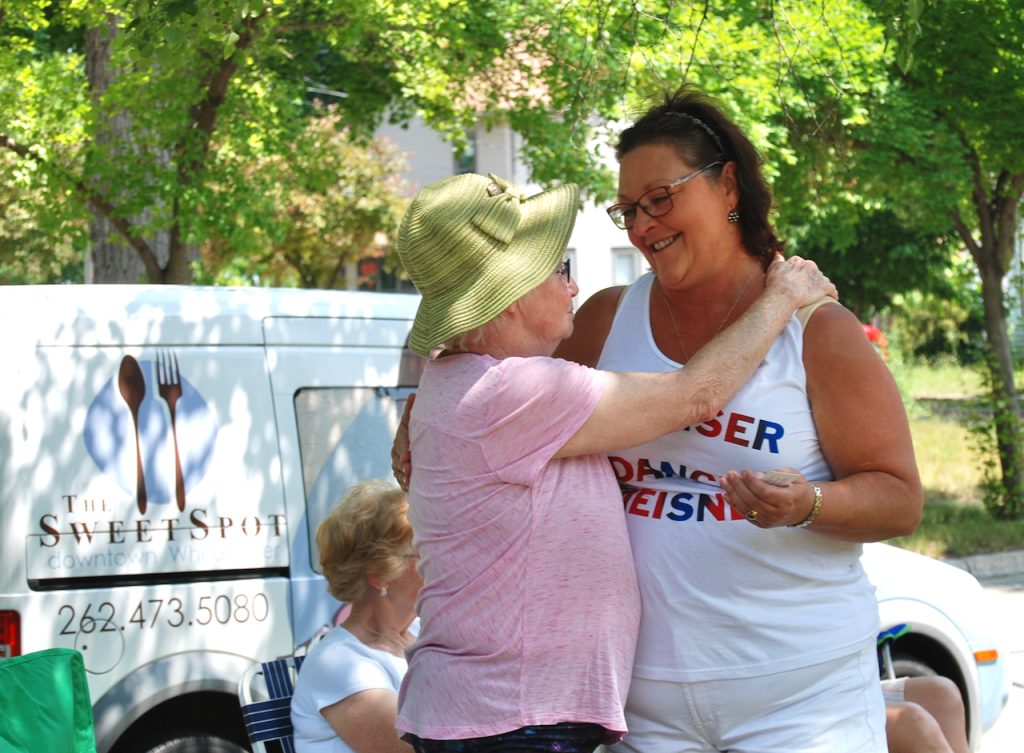
An audience member embraces Michelle Bush, a sister of the late Steve Meisner.
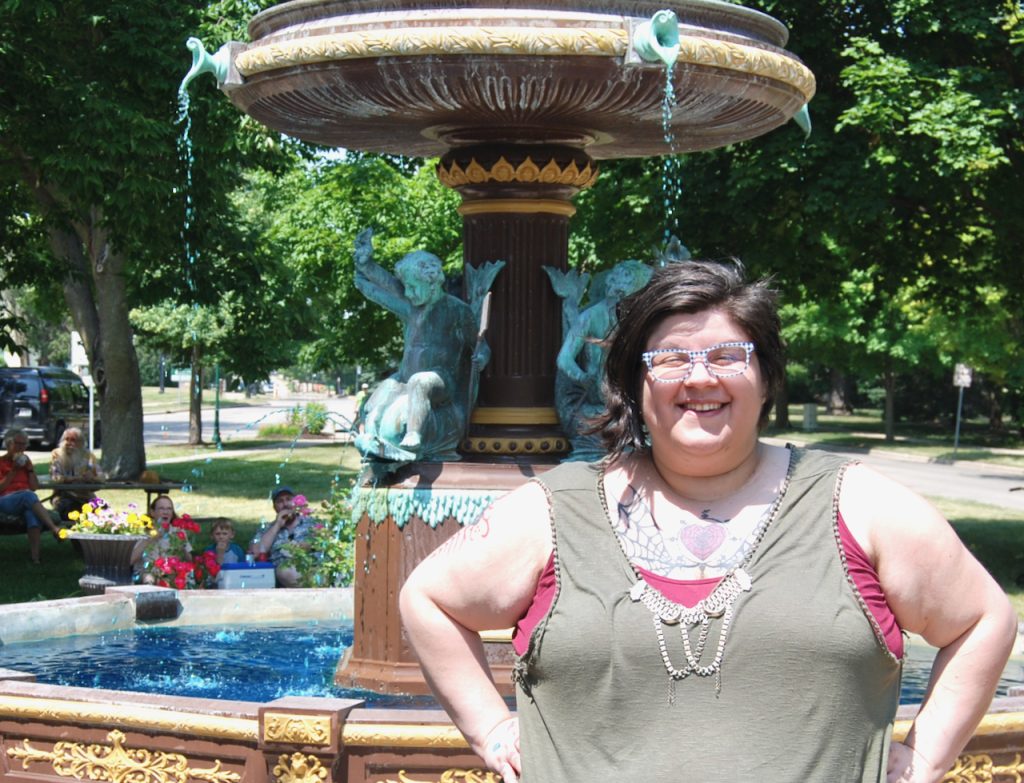
Ashley McDarison, manager of the Whitewater Arts Alliance, helps organize the season’s first Savory Sounds concert. Members of the public are invited to attend upcoming concerts within the series, the full schedule is here: https://fortatkinsononline.com/summertime-music-forts-community-band-offers-full-itinerary-whitewater-continues-with-savory-sounds/.
Kim McDarison photos.
Robinson installed as new marketing director at Fairhaven
(Originally published June 23, 2023.)
Fairhaven Senior Services, Whitewater, has announced that Brian Robinson has been installed as the marketing and community relations director for the facility.
Robinson follows outgoing marketing director Tim Probst, who will be retiring effective June 30, according to information released by the organization.
Within the release, Robinson was described as “no stranger to Fairhaven,” with the release further noting his continued service to the retirement community which is “approaching” nine years.
During his tenure, the release noted, Robinson has “created a solid leisure service program,” and has “fostered many contacts throughout the surrounding communities” and at the University of Wisconsin-Whitewater.
He has more than 18 years of experience working within the senior living/healthcare industry, the release noted.
As marketing and community relations director, Robinson will find involvement in such levels of Fairhaven operations as “apartments, assisted living and ‘Healthstone,’” the release continued.
In addition, the release announced that Shannon Schoville is the newly installed marketing manager at Prairie Village in Whitewater.
According to the release, Schoville has been with the company for six months and has a “passion (for) adding to the culture of care throughout Fairhaven.
She has previous experience in marketing and fundraising, the release stated.
To learn more about Fairhaven, visit its website: https://www.fairhaven.org.
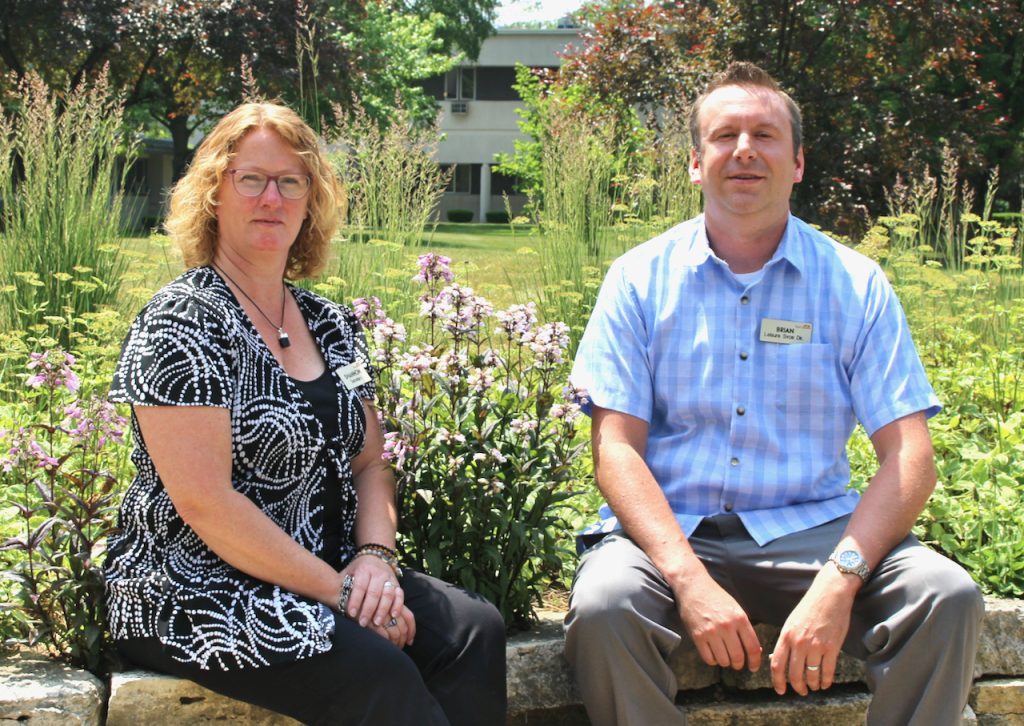
Shannon Schoville and Brian Robinson, contributed photo.
County Trunk N between Milton and Whitewater scheduled for closure July 5
(Originally published June 30, 2023.)
By Kim McDarison
County Trunk N between Milton and Whitewater will be closed beginning Wednesday, July 5, with a scheduled reopening date of Friday, Sept. 1.
According to Nick Elmer, Rock County assistant director of public works, the road will close to through traffic at approximately 6 a.m. on Wednesday, but the department will work with local residents to provide access to their properties.
The work area on County N is approximately 7.5 miles.
The road closure will begin at Warner Road, west of the city of Whitewater, and the U.S. Highway 12 bypass, and continue west to State Road 26, near the city of Milton.
For those traveling west from Whitewater, a detour route begins on Highway 12, heading southeast, with travelers then heading north on State Road 89. Travelers will then head west on Highway 59, to northbound Highway 26.
For those approaching the work area from the east, a detour route begins with travelers heading southbound on Highway 26, to eastbound State Road 59, to southbound State Road 89, and then westbound on U.S. 12.
Elmer said work on County Truck N includes the replacement of some culverts and pavement. Culverts will be replaced first, he said, with a pavement pulverizing machine coming into the work area on July 17.
He anticipated new pavement would be laid in August.
All scheduled work is weather dependent, he said.
Looking ahead, Elmer said work on County Trunk M in Rock County is scheduled to begin Monday Aug. 21, and complete Thursday, Sept. 7, with the road reopening to through traffic on Sept. 8.
The approximately 1-mile closure will begin in the community of Indianford, ending at the county highway’s intersection with State Road 51. A detour is still being formulated, Elmer said.
Work on County M is similar in nature to that which will be performed on County N, he noted.
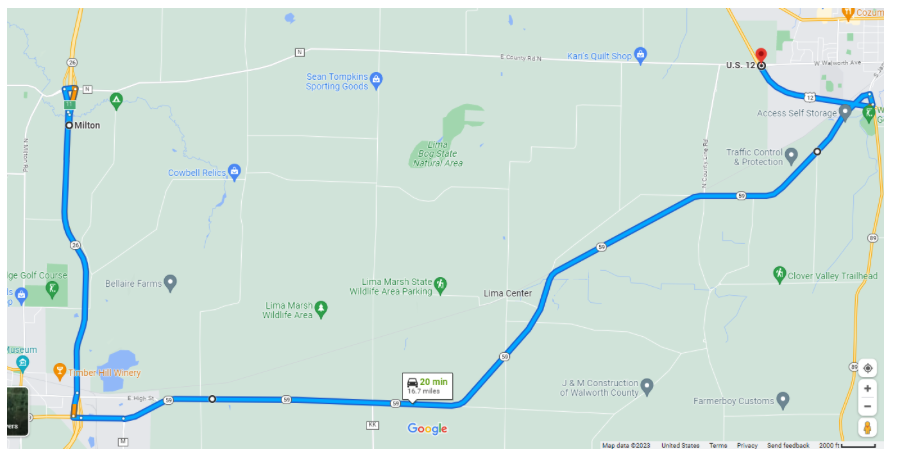
A map, as developed by the Rock County Department of Public Works, shows a detour route, denoted in blue, between the cities of Milton and Whitewater. The detour is in place for through traffic while work is performed on a 7.5-mile stretch of County Truck N, shown at the top of the map. The road will close Wednesday, July 5, at 6 a.m. and is scheduled to reopen Friday, Sept. 1.
Photographic continuum: a peer through time
(Originally published July 1, 2023.)
By Kim McDarison
Whitewater Arts Alliance Board of Directors member Jeff McDonald likes photography.
He has served as the chairperson of the annual Fran Achen photography exhibition for nine years, and while, he said, he did not know Achen, he has found a connection to the late photographer through their mutual love of photography.
The 14th Annual Fran Achen Juried Photography Exhibition opens Saturday, July 1.
A preview of the exhibition, which is installed in the Whitewater Arts Alliance’s gallery in the Whitewater Cultural Arts Center, was made available Thursday afternoon, following the alliance’s most recent Savory Sounds concert which featured the 132 Army Band of the Wisconsin Army National Guard.
The event marked the second in the summertime series which pairs musical performances with onsite opportunities to purchase lunch from a local vendor.
Seated in the gallery during Thursday’s preview, McDonald shared his thoughts about the evolution of the show, his development as an amateur photographer, and some history about Achen and the alliance’s desire to continue a show in his name.
McDonald said founding members of the arts alliance began the exhibition in 2009, which was just a few years after Achen died, in 2004.
“Fran was a local photographer. He was a (Whitewater) high school teacher and he had a studio in Whitewater at one point,” McDonald said.
The Achen collection
McDonald recalled that a collection of Achen’s photographic images were donated to the Whitewater Historical Society and the Irvin L. Young Memorial Library sometime around a sesquicentennial celebration held in the city.
With help from the assistant director of the Irvin L. Young Memorial Library, Diane Jaroch, a history of the collection emerged: according to information published in the Whitewater Register in the summer of 1987, as part of the city’s sesquicentennial celebration, an exhibit of Achen’s work, titled: “A Long Look at Whitewater,” was held in the University of Wisconsin-Whitewater’s Crossman Gallery.
Within the library’s archives, Jaroch found a news clipping, printed in 1989, which stated that Achen had donated more than “$4,210 worth” of historical prints of Whitewater and the surrounding area to the city’s historical society and library. The clipping noted that Achen, after his show in 1987, donated 210 prints to the city, bringing his total donation of prints made available for public viewing to 370. Not all of the pieces in his collection were his own work. The clipping featured a photo of Whitewater taken in April of 1881. Achen was born in 1916.
In addition, Jaroch’s research located a story in the Whitewater Register, printed in January of 1987, noted that the “A Long Look at Whitewater” exhibit was placed on display that January, featuring 150 images of Whitewater, at a then-business in the community called Commercial Bank. The story noted that Achen “got the idea to make a collection of old time photographs” after “a discussion of Whitewater’s sesquicentennial.” Among prints within the collection, the story noted, were “some he took and others that were given to him by people here.”
Who was Fran Achen?
According to the “Find a Grave” website, Frances “Fran” Moses Achen was born Dec. 7, 1916, in Kenosha County. He is buried in the Hillside Cemetery, Whitewater. He died on Jan. 4, 2004 at the age of 87.
Information provided by Ancestors, Family Search, notes that Achen married Lydia Emma Nickos on Dec. 27, 1941, in Whitewater.
Information provided through geni.com describes Achen during his life as a photographer of “renown” in both the Whitewater and University of Wisconsin-Whitewater communities.
According to the site, Achen was raised in Kenosha and was a graduate of Kenosha High School. He next, in 1938, began attending classes at the Wisconsin State Teachers College at Whitewater, where he became a roving photographer and served as a reporter for the Royal Purple.
In 1941, Achen received a bachelor’s degree, majoring in geography. He married a college classmate in 1941.
After World War II, the narrative reports, he “returned to Whitewater,” where, between 1946 and 1956, he operated a portrait studio. He next joined the faculty at Whitewater High School where he taught history and geography.
He is also credited as the “official game photographer” for the UW-Whitewater Warhawks football team, enjoying that role for 20 years and ending his tenure in that capacity in 1984. He was inducted into the Warhawk Hall of Fame in 2000.
The full narrative about Achen is here: https://www.geni.com/people/Francis-Achen/1883723.
Evolution of the show
On Thursday, McDonald, surrounded by more than 80 photographic works, said during his tenure as chairperson, the show has evolved.
During previously held shows, he borrowed some of the photographs from the Fran Achen collection and displayed them in the arts alliance’s gallery, he said.
Last year, the show included 25 pieces from the collection, he added.
McDonald said he looks forward each year to organizing the show.
“I like photographs, and I like being a photographer, and talking to other photographers, and I like showing their work,” he said.
He particularly looks forward to the annual show’s opening reception. This year, the reception will be held Sunday, July 2, at the Whitewater Cultural Arts Center, 402 W. Main St., Whitewater, beginning at 1 p.m.
During the reception, an awards presentation will be held.
McDonald, an IT professional and accountant, describes himself as an amateur photographer.
In the early 2000s, he said, he found that his life’s obligations were changing in a way that made room for a hobby. His interests drew him to digital photography just as the medium, and digital cameras, were becoming popular, he said.
“They were just starting to supersede film,” he noted.
In 2006, McDonald said he purchased his first professional quality camera, a Canon EOS-1Ds Mark II.
He found himself drawn to shooting landscapes.
Today, he said, he most enjoys creating images in black and white, and while he said he enjoys shooting a variety of subjects, his favorite photos tend to exhibit images in high contrast.
Before he became chairperson of the Fran Achen exhibition, he would enter his work in the show, and he won Best of Show two year in a row, he said.
As he progresses as a hobbyist, McDonald said he has come to appreciate the Canon system. On Thursday, he was carrying an EOS R6 mirrorless camera, which, he noted, was one of five Canon camera bodies he uses.
Once he became chairperson of the Fran Achen exhibition, his focus was on building the show and attracting other artists, he said.
While the show has been a popular Whitewater Arts Alliance staple, when the COVID pandemic arrived in 2020 and 2021, McDonald said, it underwent some changes.
There was a decline in people looking to engage with the exhibition, he said, adding: “In the aftermath of COVID, it was really hard to put up a show. People did not want to come to the gallery. In 2020 and 2021, we started using the virtual show idea, with a gallery show and a virtual show running at the same time.”
The format —with in-gallery and virtual shows running concurrently — remains in place in 2023.
This year, he said, the show is again experiencing growth. With some 145 entries made, different from past shows, not every entry submitted is included.
“It’s a juried competition,” McDonald said.
This year, space within the gallery necessitated a decision. Some 83 pieces, representing 35 photographers are on display.
While in past years, McDonald said he was honored to be able to exhibit every entry, space limitations this year precipitated a new decision; one, he said, he believes will enhance the flavor of the show and attract a different group of artists to future shows.
“Accomplished artists look for juries shows and they seem to feel more confident when exhibiting their work in juried shows,” McDonald said.
The judging process
Among reasons he no longer enters his own work in the show, McDonald said, as chairperson, he is involved with the judging process.
“I’m not a judge, but I know whose images are whose,” he said, adding that his piece of the process includes digitizing the images and assigning them random numbers so the judges do not know which artist has submitted each piece.
McDonald said this year’s two judges, Gerald Emmerich, Jr. and Steve Heraly, are both recognized and accomplished photographers, and both have judged the show in the past.
Emmerich, a resident of East Troy, has been a member of the Photographic Society of America (PSA) since 1979. In 2001, he was awarded PSA’s Region Director of the Year award, in 2003 he was the recipient of the Peabody Award, and in 2012 he received the PSA President’s Award. Emmerich served on the PSA Board of Directors as PSA conventions vice president from 2003 to 2009, and as PSA secretary and member of the PSA Executive and Finance committees from 2009 to 2013. He was awarded HonPSA honors in 2013, according to information provided by the Southwestern Michigan Council of Camera Clubs.
He has served as a judge during the Fran Achen exhibition for at least three years, McDonald said.
Heraly is a photographer, resident of Hubertus, and the recipient of “numerous awards,” McDonald noted, further describing him as a photographer who is affiliated with charitable causes. Heraly is returning for his second year as a Fran Achen competition judge.
Opening reception
During Sunday’s opening reception, Emmerich will be on hand to announce the exhibition winners as chosen by the judges and offer discussion about the works and photography in general.
“Jerry will talk about photographs like crazy. He has judged thousands of exhibitions. He knows his stuff, and he loves to talk to people about how they can improve their photographs,” McDonald said.
The reception offers attendees a chance to see the works, meet the artists, make connections and learn about the craft, McDonald said.
The reception is free, open to the public, and light refreshments will be offered, according to information released by the alliance.
Voting for a “Viewer’s Choice” award will remain open during the course of the exhibition, with a winner announced on Sunday, July 30.
The gallery in the Whitewater Cultural Arts Center is open Thursdays, Fridays, Saturdays, and Sundays from noon to 4 p.m.
An earlier story, including a history of Fran Achen’s life, is here: https://fortatkinsononline.com/whitewater-fran-achen-art-exhibition-slated/.
To view the 14th Annual Fran Achen Juried Exhibition virtually, visit: https://www.whitewaterarts.org/fran-achen-2023.
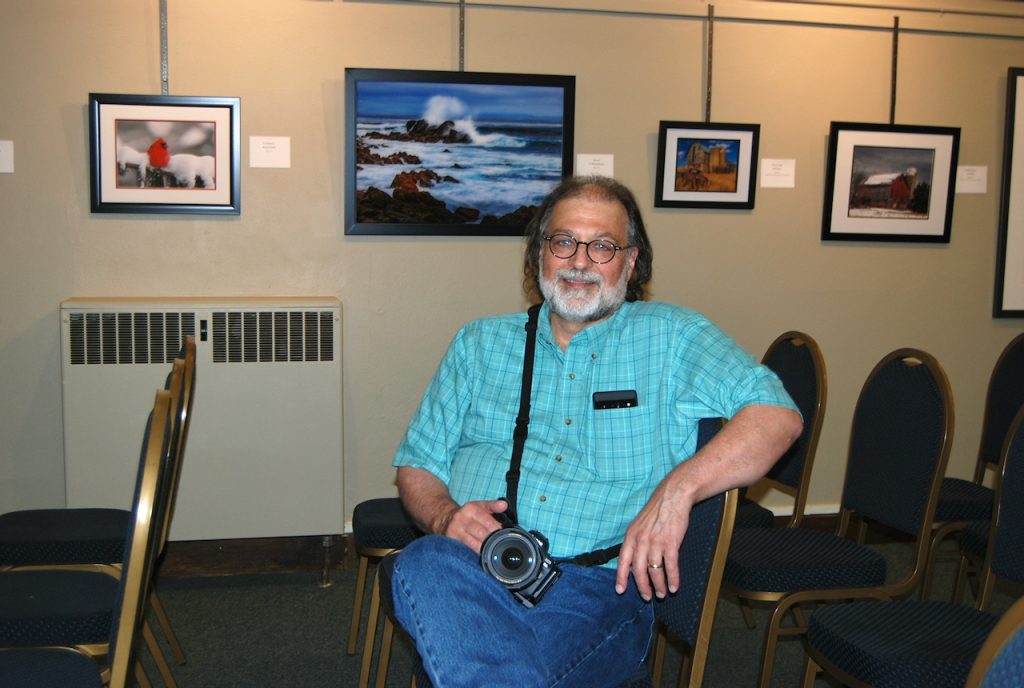
Jeff McDonald, Whitewater Art Alliance board member and chairperson of the Fran Achen juried photography exhibition for nine years, visits with attendees arriving at the Whitewater Arts Alliance gallery located in the Whitewater Cultural Arts Center. He is surrounded by more than 80 pieces of photographic art on display during this, the 14th Annual Fran Achen Juried Photography Exhibition. The exhibition opened Saturday for in-gallery viewing. An opening reception will be held Sunday in the gallery beginning at 1 p.m. Kim McDarison photo.

Fran Achen, file photo/contributed.
Picture this: Whitewater hosts annual Fourth of July parade
(Originally published July 8, 2023.)
Approximately 50 exhibits, including an array of floats, bands, marchers, trucks, tractors, and animals, among others, made their way down Whitewater’s Main Street Tuesday as part of the 2023 five-day Fourth of July celebration. The full celebration began Friday, kicking off with carnival midway rides in the city’s Cravath Lakefront Park, along with civic food vendors and live music, and closed Tuesday, with an evening fireworks display, also held in Cravath Lakefront Park.
This year’s parade marshal was Terry Phelps, who, according to the Whitewater Fourth of July celebration website, “joined the Whitewater Volunteer Fire Department on July 5, 1973.”
After 50 years of service, he will be retiring this year.
The website notes that Terry’s father, Charles, was a 25-year veteran of the department and took his son on “many calls before he officially became a member.”
Terry was named Firefighter of the Year by the department in both 1982 and 1990, and Fire Officer of the Year in 2014. He was named a Home Town Hero by a Whitewater community group in 2022. He has served as a department captain for over 30 years and as a certified instructor at Gateway Technical College for 25 years, the website noted.
Pictures from the parade, and its associated Whippet City Mile run, which took place along the parade route in advance of the parade, follow.
Kim McDarison photos.
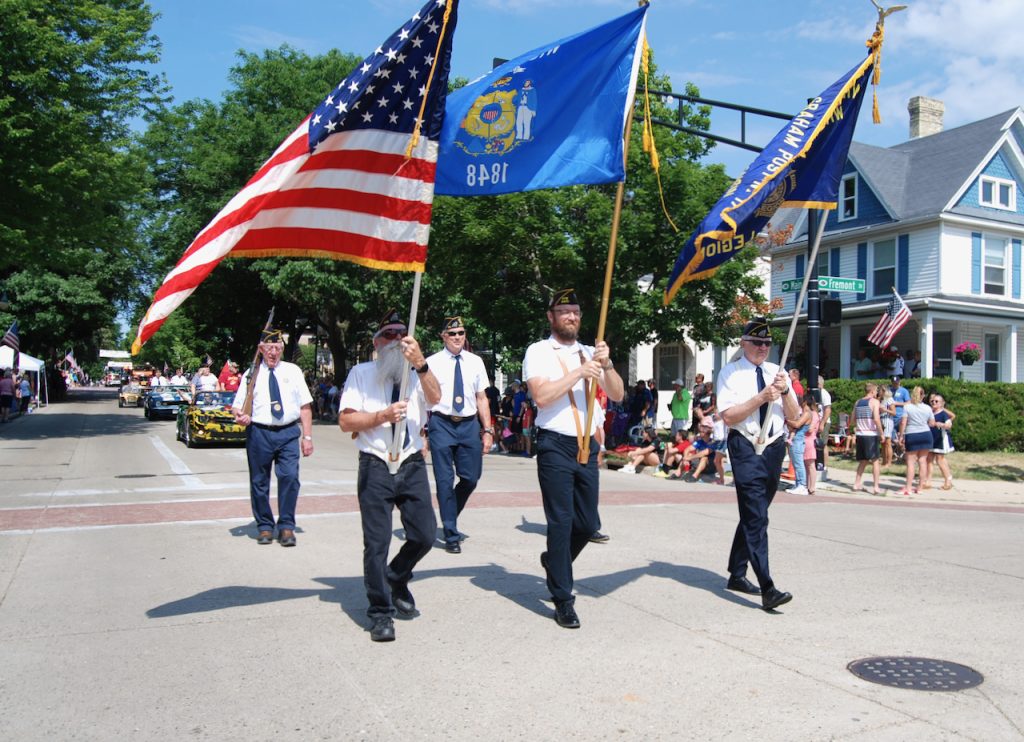

Members of the American Legion William Graham Post 173 present the colors as they move along Main Street. Members from both the Whitewater Veterans of Foreign Wars Post 5470 and the legion participated in the parade.
Parade Grand Marshal Terry Phelps, at left, greets parade-goers from his seat aboard an old fashioned fire truck. Phelps has been a member of the Whitewater Fire Department for 50 years. He is retiring in 2023.

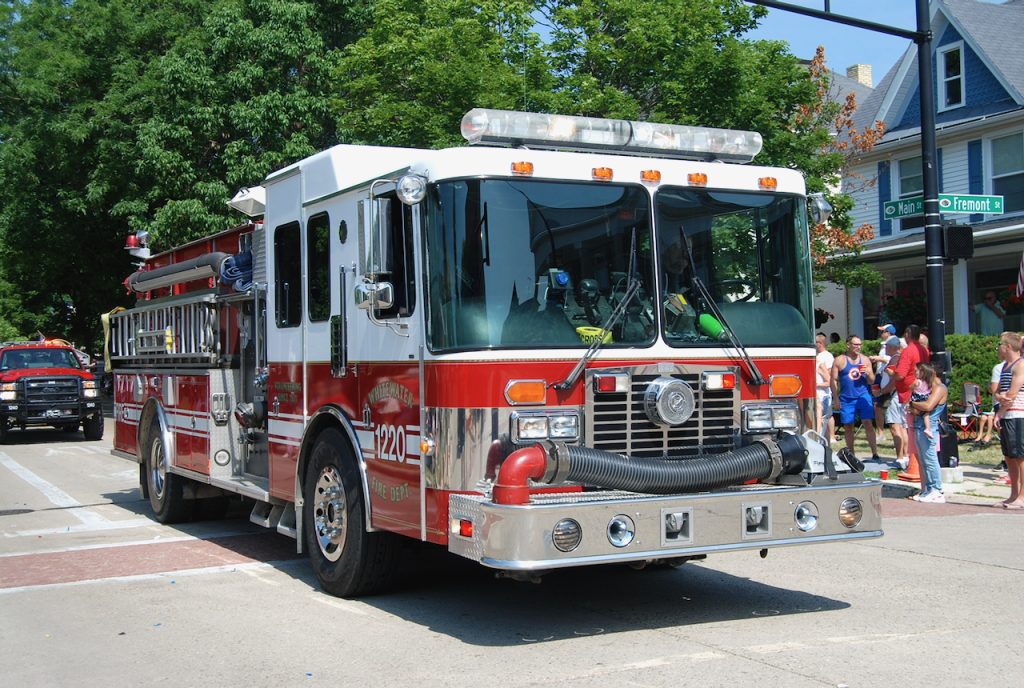
A Whitewater Police Department vehicle leads the parade.
Whitewater Fire Department equipment, including fire truck 1220, moves through the intersection of Main and Fremont streets.

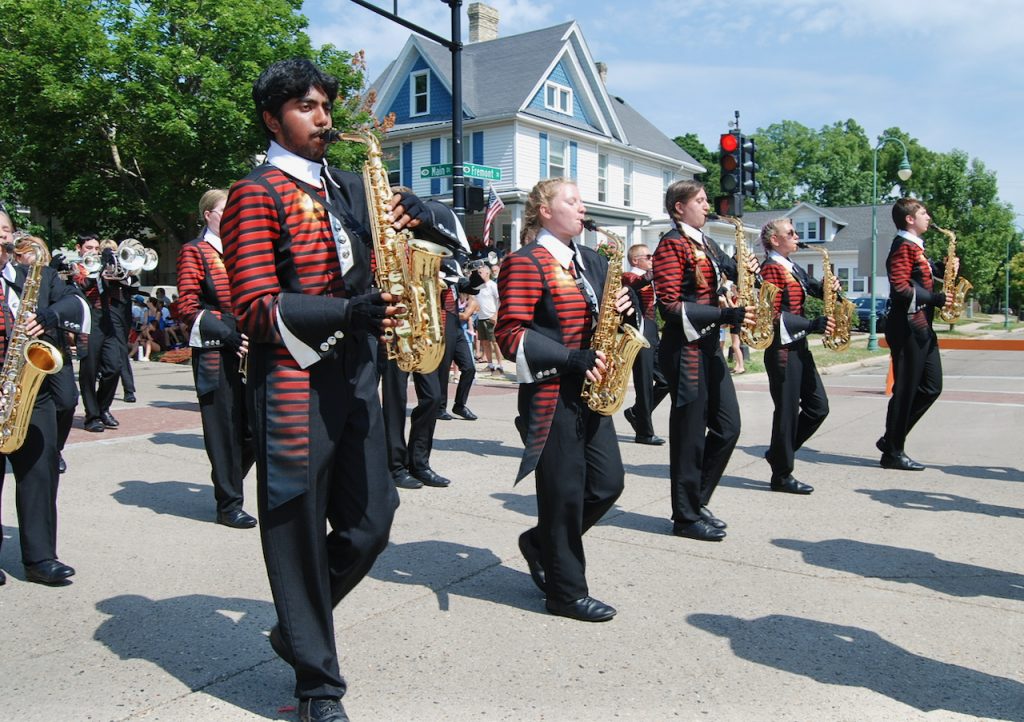
State Sen. Steve Nass, at left, rides with fellow members of the Whitewater Veterans of Foreign Wars Post 5470.
Members of the “Sound of Sun Prairie” school district marching band perform during Tuesday’s parade.
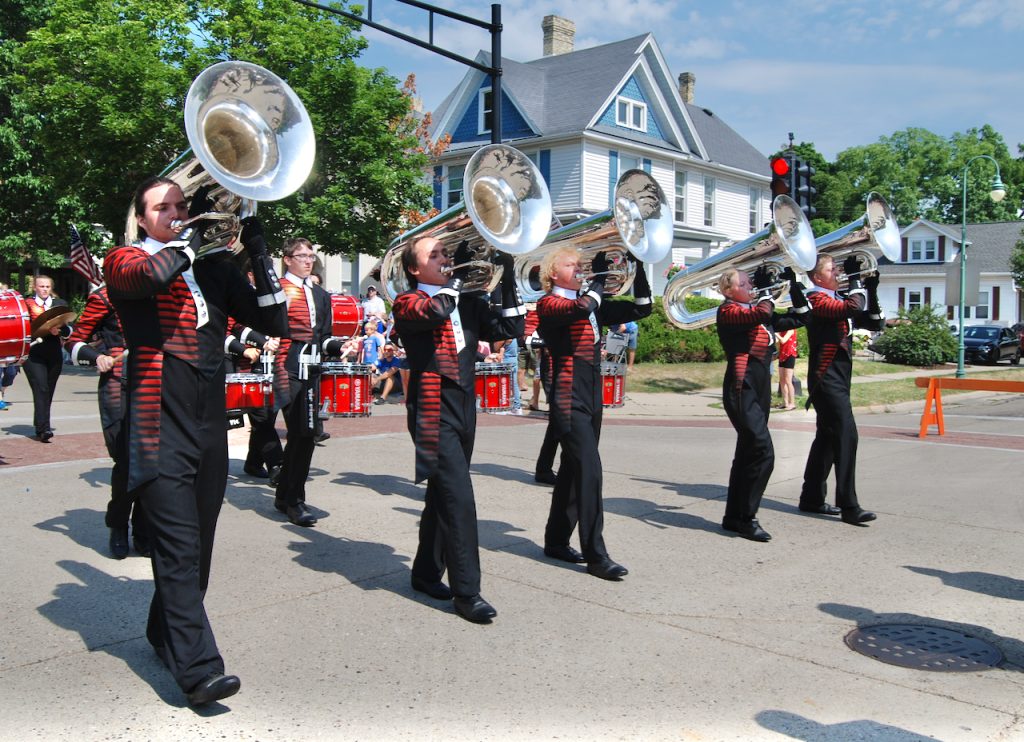
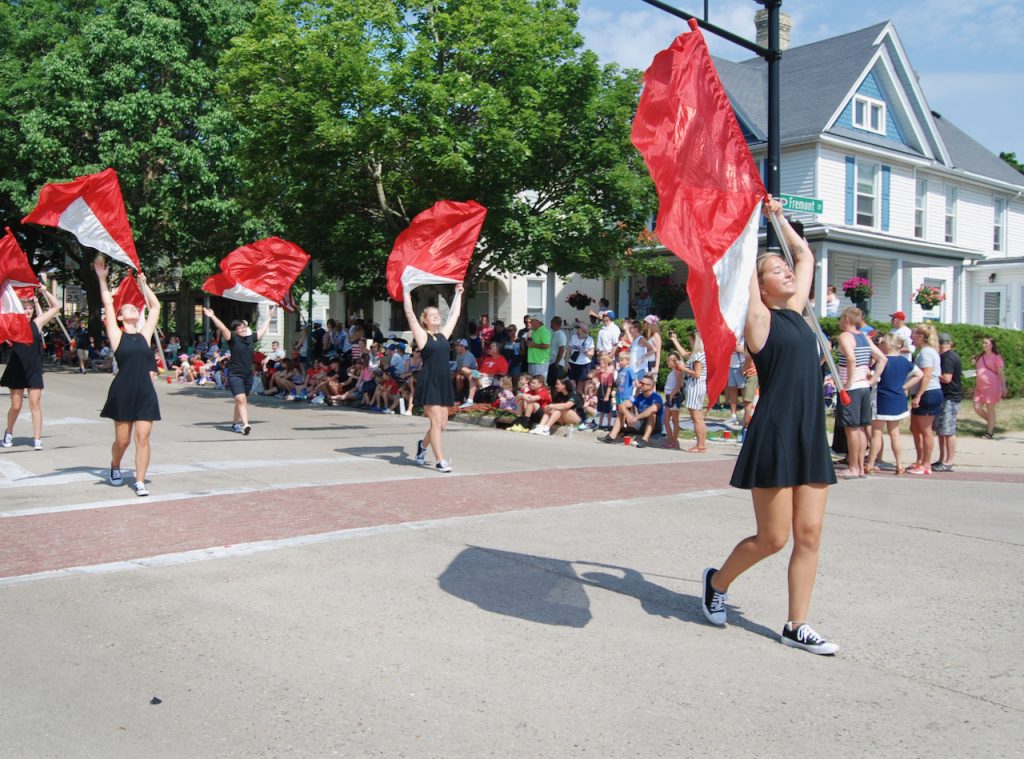
“Sound of Sun Prairie” band members continue through the intersection of Main and Fremont streets.
Unfurling flags with choreographed precision, members of the Sun Prairie marching band move along Main Street.

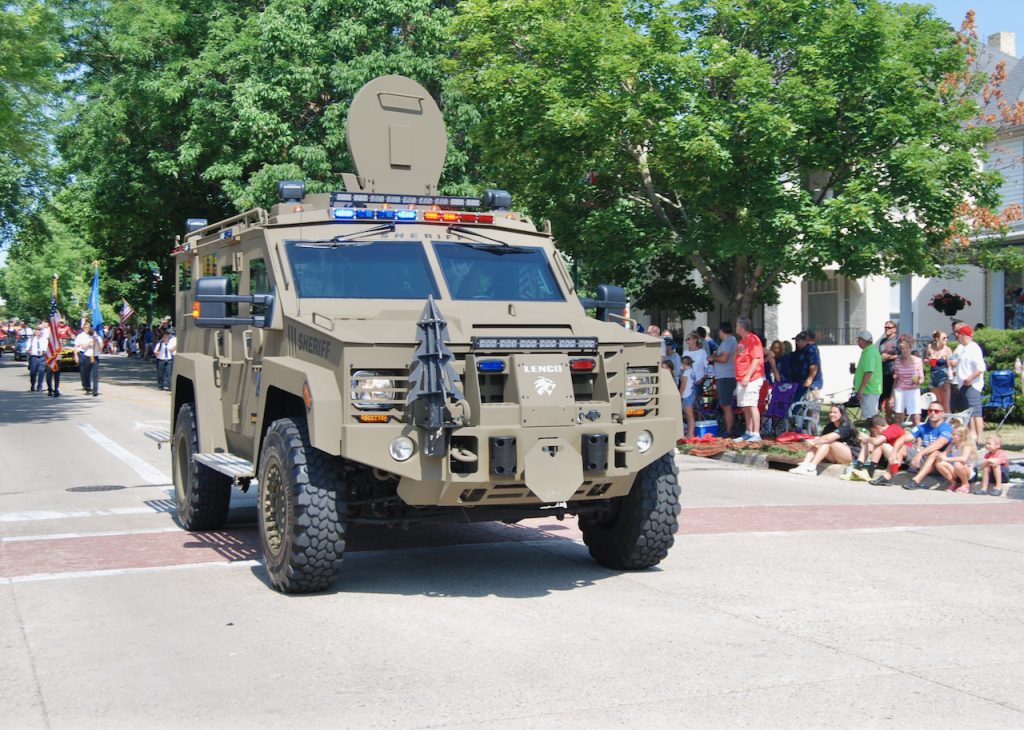
Members of the U.S. Marine Corps wave to the crowd as they drive through the intersection of Main and Fremont streets.
Equipment operated by the Walworth County Sheriff’s Department moves along Main Street.


Riders aboard the Underground Cutz float greet the crowd.
A pair of Case tractors make their way down Main Street.


Trinity Smith-Hicks waves to parade-goers from atop her festively decorated mount.
Riding the pavement are members of the Southern Wakes United Show Ski Team.


Southern Wakes United Show Ski Team members march alongside their float.
A car sports its Independence Day paint job.


State Rep. Scott Johnson waves enthusiastically to the crowd.
Moving along Main Street on roller skates, a parade participant distributes candy to the crowd.

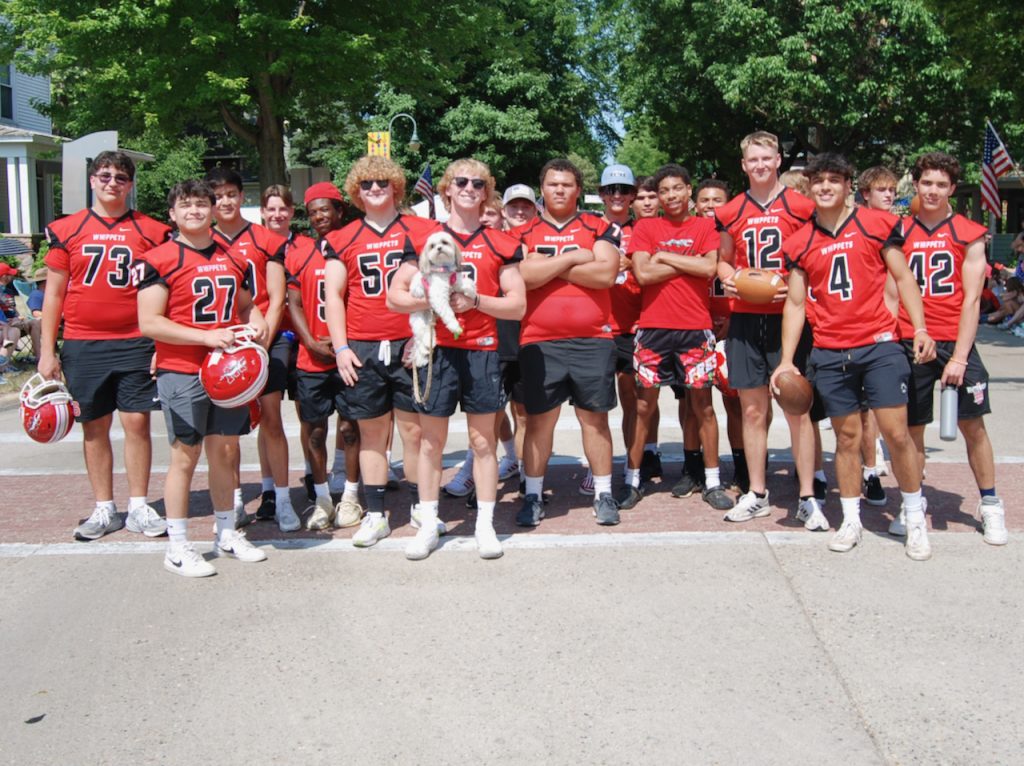
Rod Lorenz drives his 1953 Chevy truck.
Members of the Whitewater High School Whippets Football team strike a pose before moving into the intersection of Main and Fremont streets.


With its logo prominently placed, the Whitewater Kiwanis Club float moves down Main Street.
Parade participants wave from a float entered into the parade by the Walworth County Democratic Party.


Gemütlichkeit Days marchers dance along Main Street.
More Gemütlichkeit Days marchers dance in advance of the arrival of the Gemütlichkeit Days float as it enters the intersection of Main and Fremont streets.


Whitewater Area Mounted Search Team and Rescue (WAMSTAR) riders enter the intersection of Main and Fremont streets.
Additional WAMSTAR riders enter the intersection.
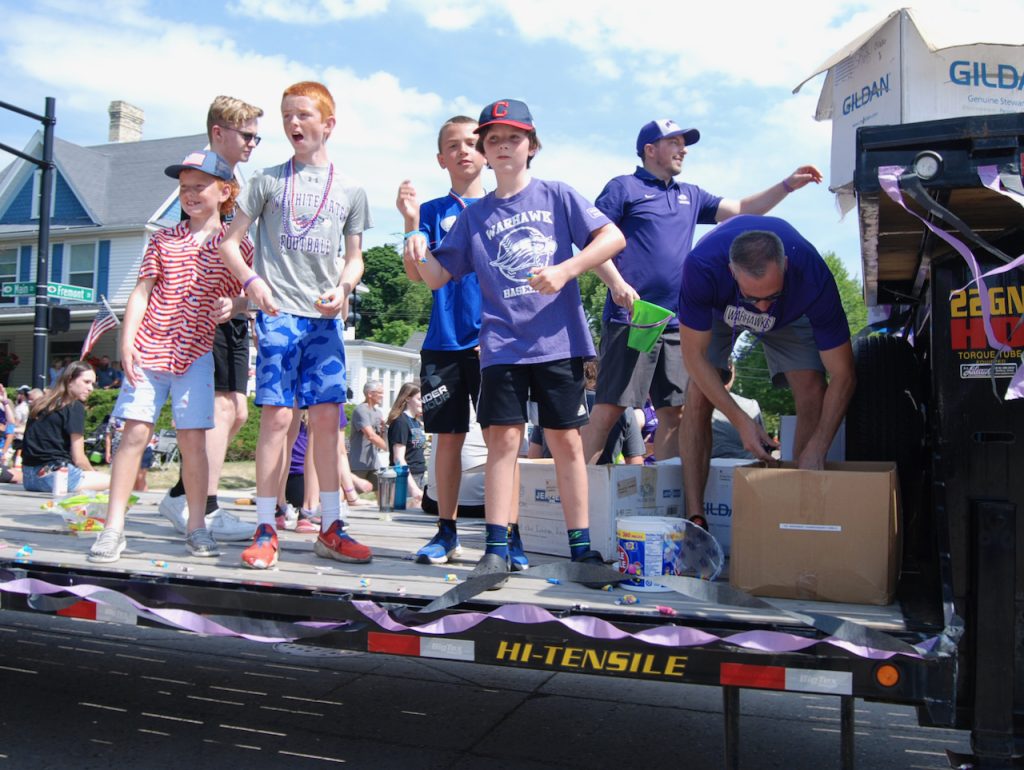
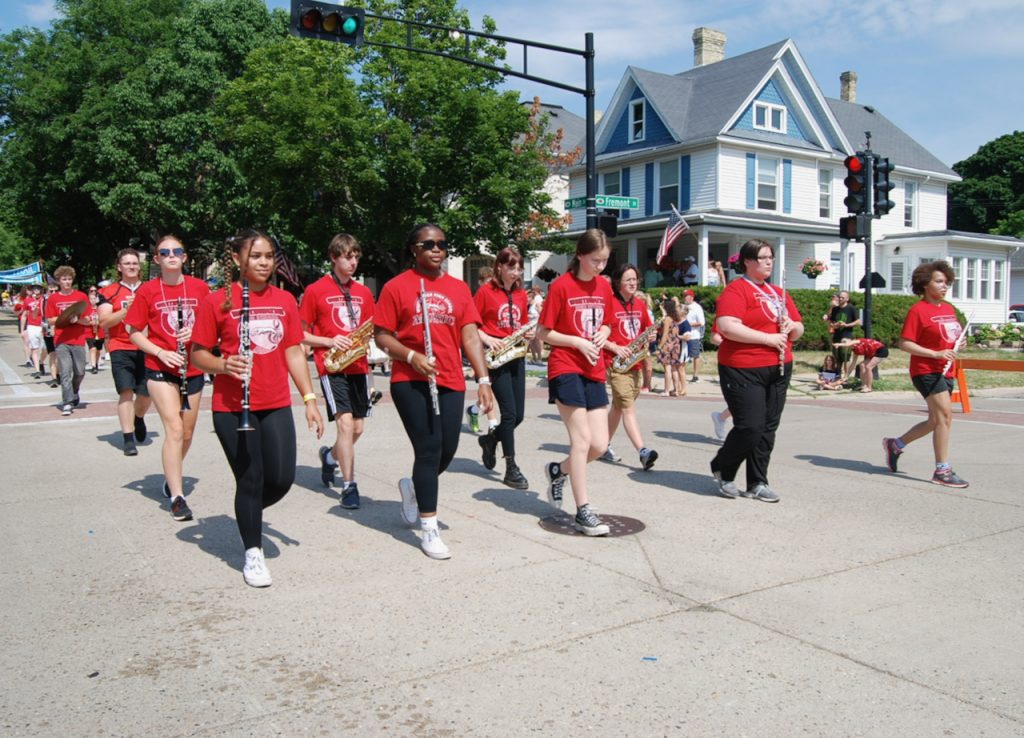
Children distribute candy to the crowd from aboard the University of Wisconsin-Whitewater Athletics float.
The Whitewater High School Marching Band approaches the intersection of Main and Fremont streets.


The Whitewater High School Marching Band drum section moves through the intersection.
State Rep. Ellen Schutt greets the crowd.


From atop a colorful float, the “Caffeine Queen” waves to parade-goers.
A horse and rider, entered into the parade as “Autumn Bultman and BiBi Juna,” display their festive decor.


“Teen Miss Halee” at right, and “Junior Miss Zoe” ride together along Main Street.
Little Miss 2023 Lilly Eisner, at right, and Miss Whitewater Emily Eisner wave to the crowd.

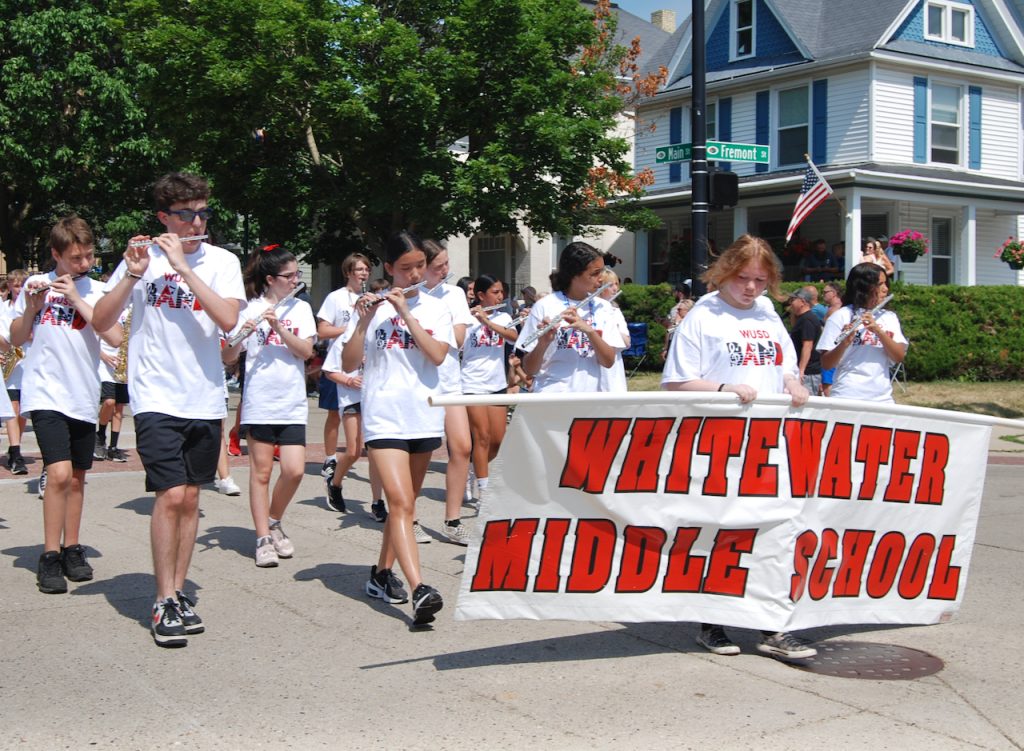
LSM Chiropractic maneuvers a giant spine down Main Street.
Members of the Whitewater Middle School Band march along Main Street.


Whitewater Middle School Band members perform as they move through the intersection of Main and Fremont streets.
Mariachi band performers play for the crowd.

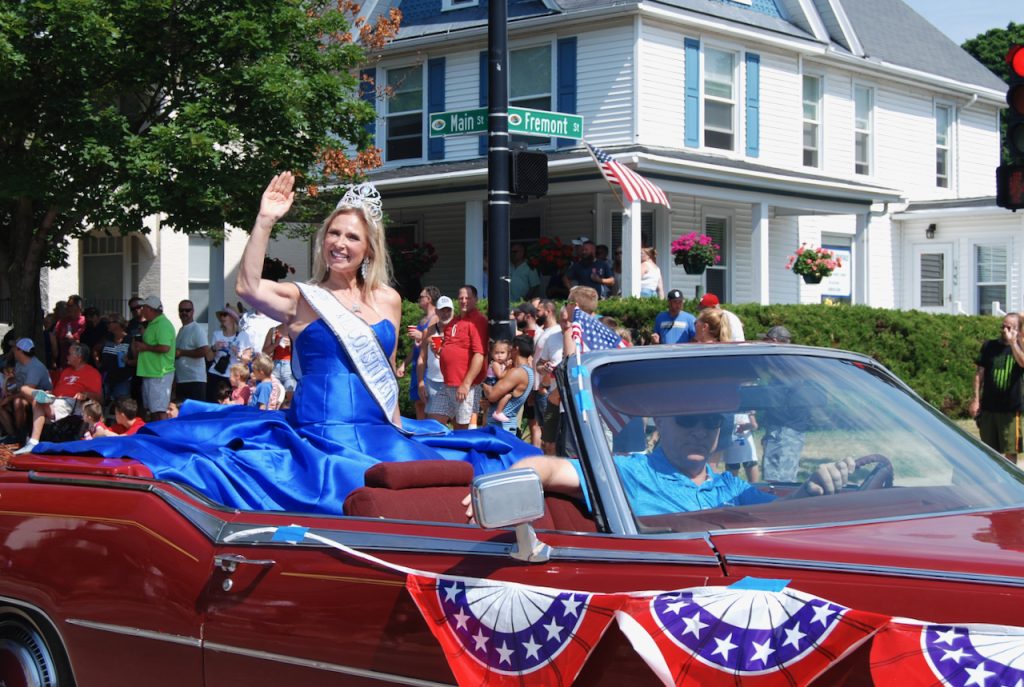
“Lulu Top Dog” marches along Main Street.
Elite Ms. Wisconsin Petite Kathleen Wojtasiak greets the crowd. According to a parade banner, the royal’s mission is to “end bullying and abuse.”
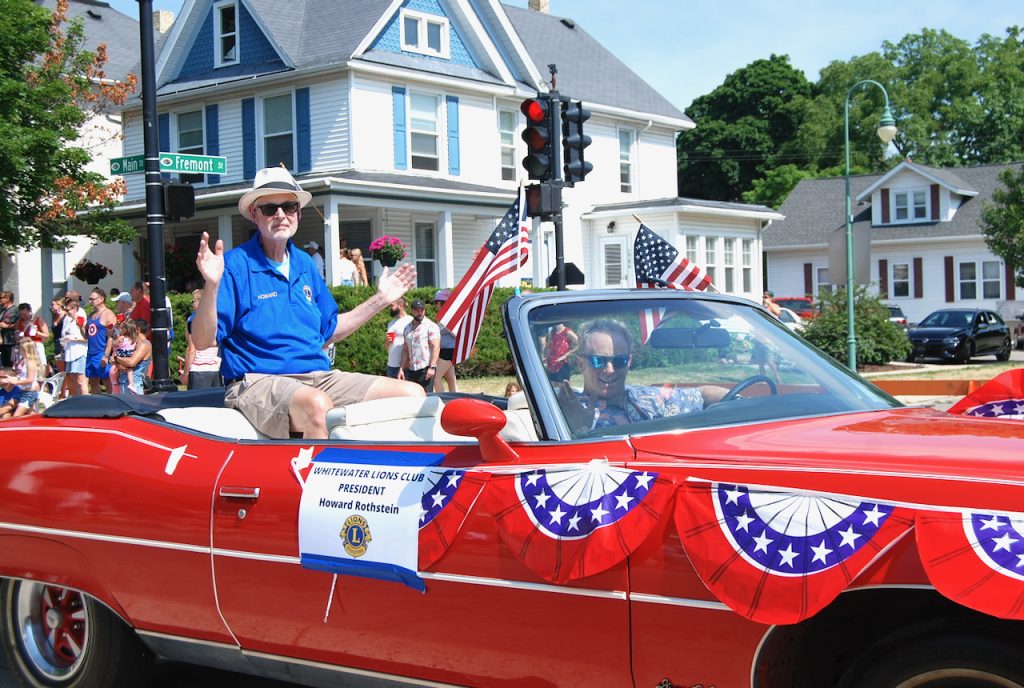
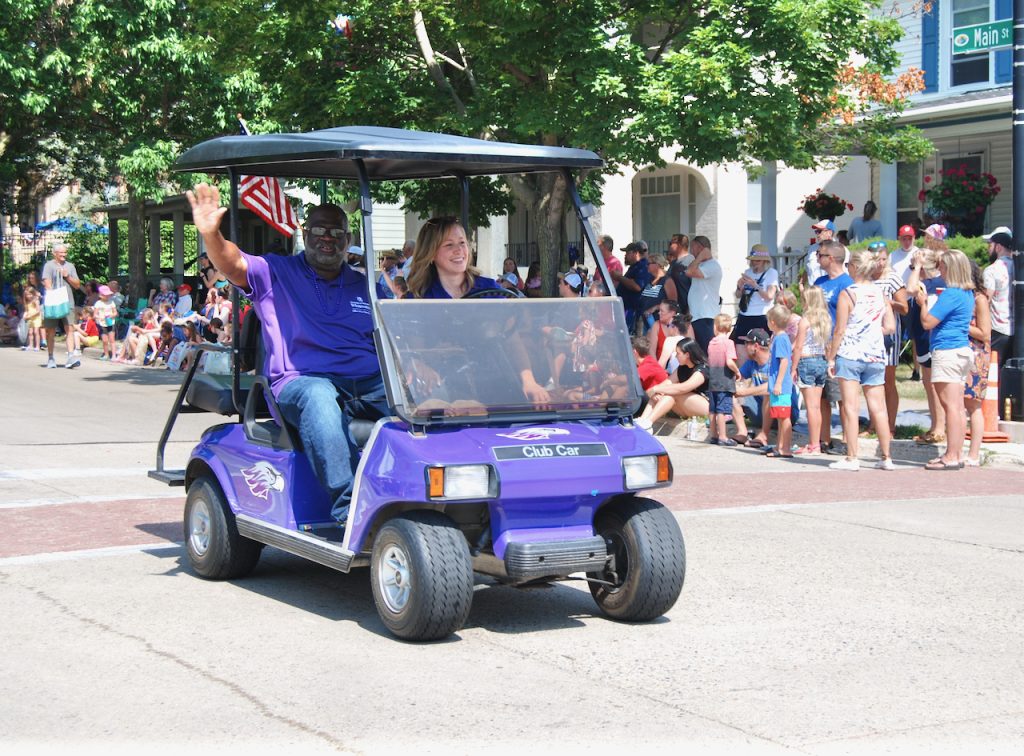
Whitewater Lions Club President Howard Rothstein, at left, rides along Main Street.
University of Wisconsin-Whitewater Chancellor Corey King, at left, greets the crowd.
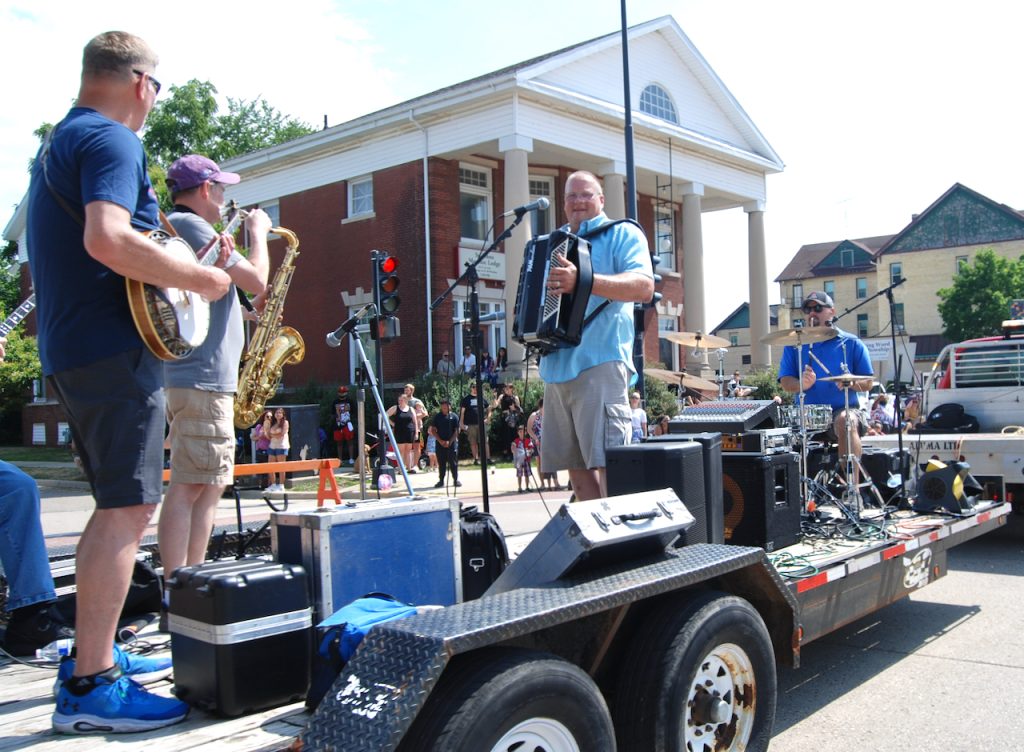
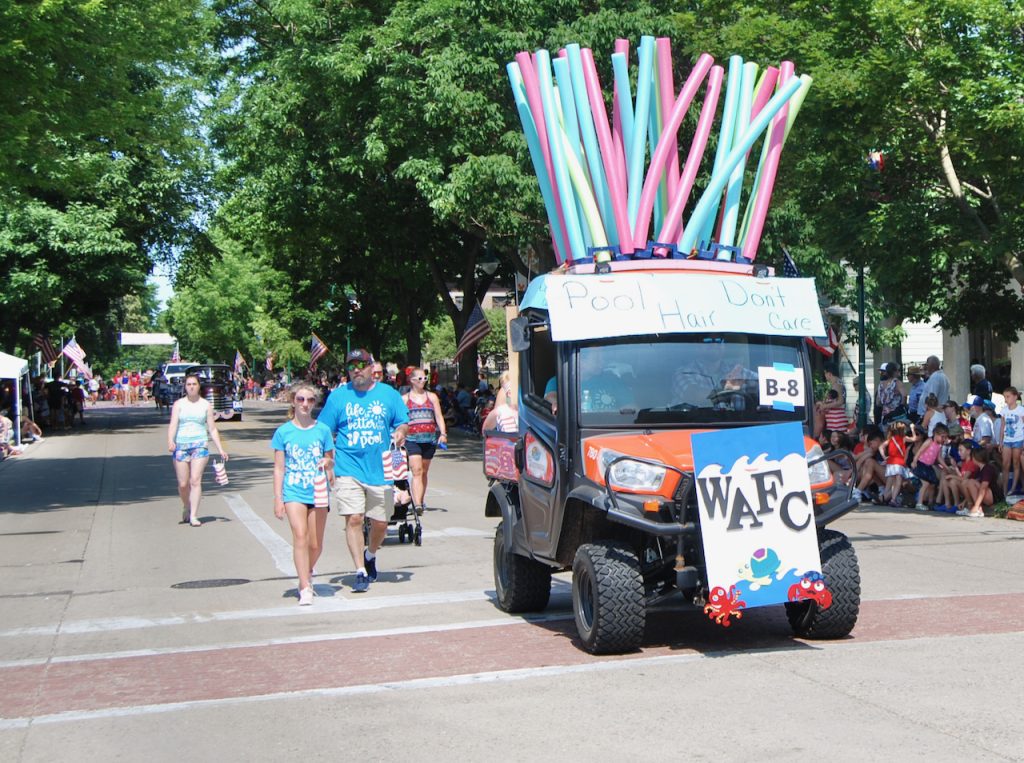
Members of the Meisner Legacy Band perform from a float. Steve Meisner, for whom the band is named, died last month. The band played in Cravath Lakefront Park Tuesday afternoon.
A float representing the Whitewater Aquatic and Fitness Center moves along Main Street.
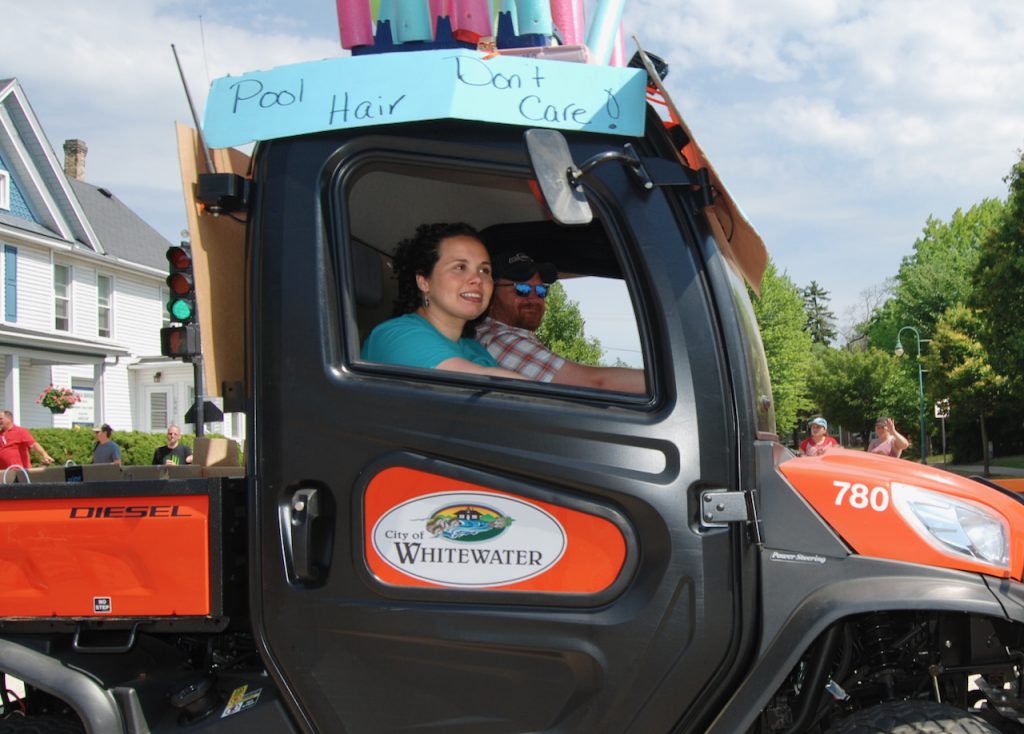

Whitewater Aquatic and Fitness Center Programmer Lorelei Bowen greets the crowd from the aquatic center’s float.
UW-Whitewater mascot “Willie the Warhawk” greets the crowd.
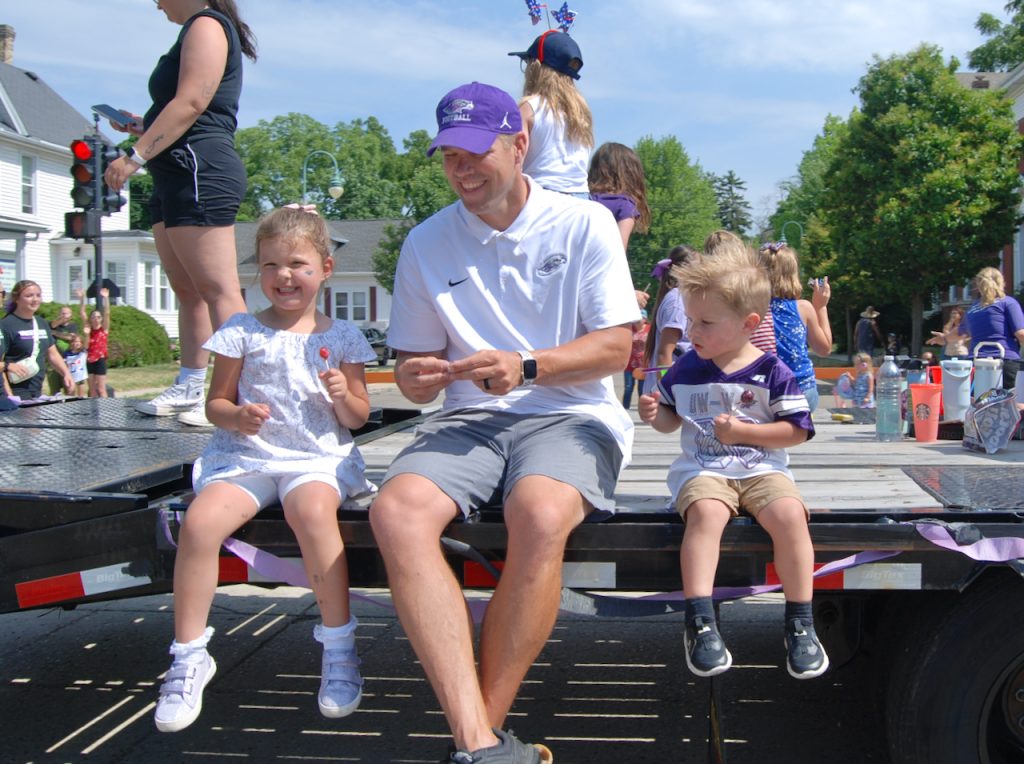
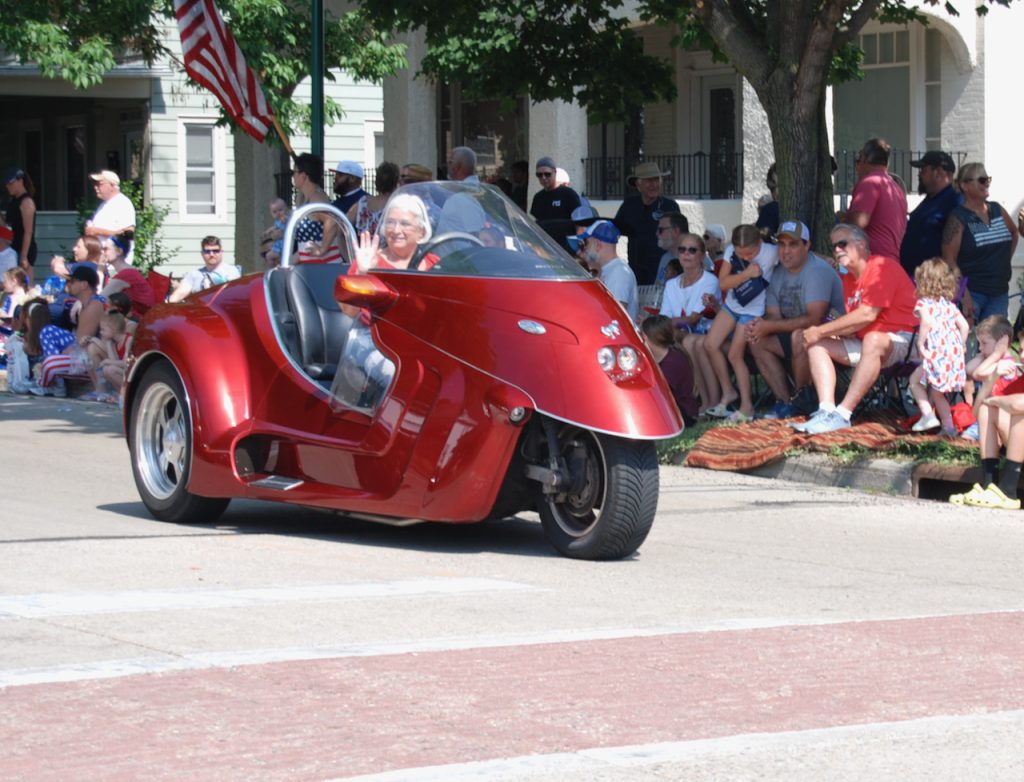
Riders aboard the UW-Whitewater Athletics float take a moment to enjoy some candy.
A member of the Banner City Bikers club rides along Main Street.


Sharing his seat with a plushy friend, a Banner City Biker club member moves through the intersection of Main and Fremont streets.
Yet another Banner City Biker club member greets the crowd.

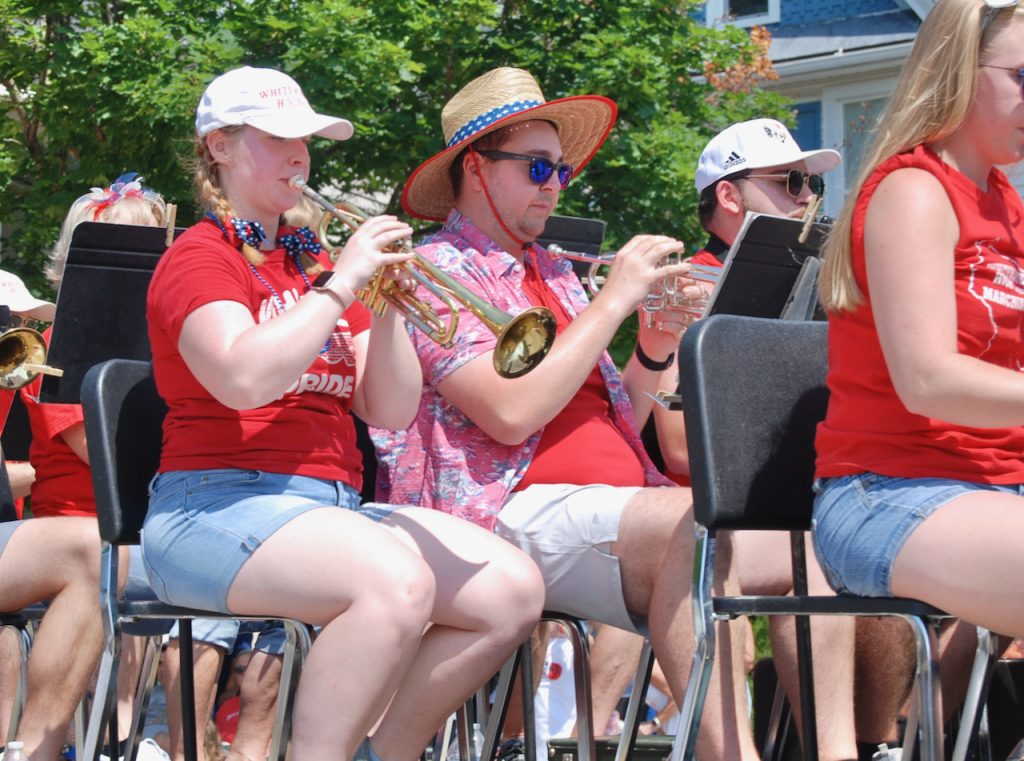
A parade entry supplied by Willow Brook Golf Course, Whitewater, moves along Main Street.
Members of the Whitewater High School Alumni Band perform while aboard a float.
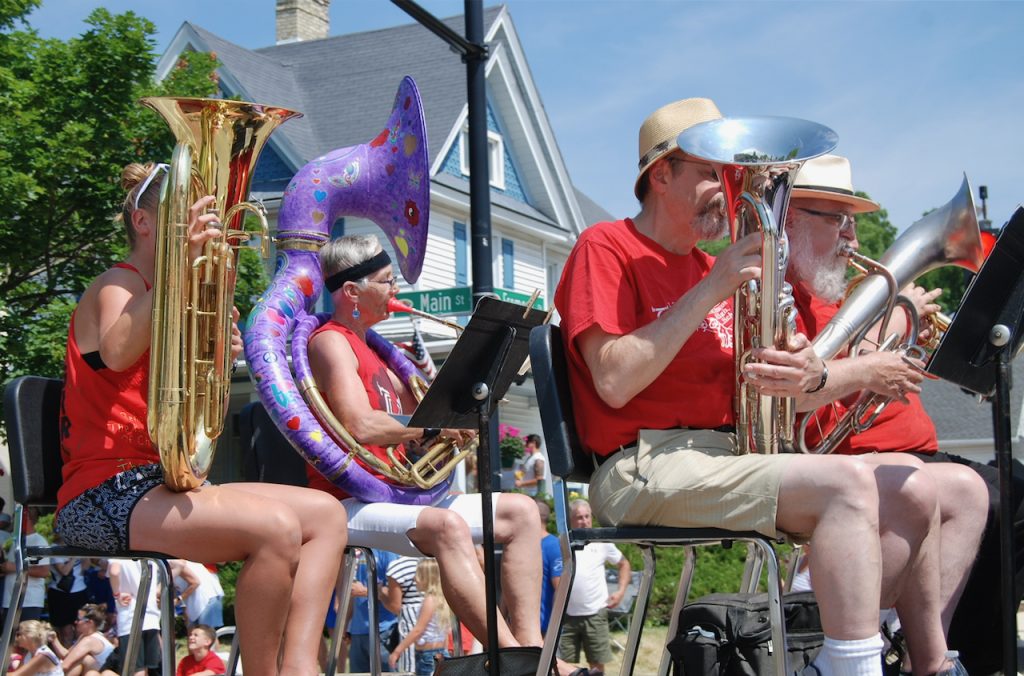

Whitewater High School Alumni Band members continue to perform.
A Zor Shriners mini car operator enters the intersection of Main and Fremont streets.


Zor Shriners mini car operators ride in circles within the intersection of Main and Fremont streets.
A cluster of mini cars, operated by Zor Shriners, enters the intersection of Main and Fremont streets.


A horseback rider waves to the crowd.
Horseback riders stop to visit with parade-goers along Main Street.


A family participates in the Whippet City Mile run. The runners occupied the parade route in advance of the parade.
Runners of all ages accept the challenge of the Whippet City Mile run.


More runners move through the intersection of Main and Fremont streets.
Whitewater Police Officer Taylor Krahn arrives in the intersection of Main and Fremont streets, signaling the end of the parade.
Five Fourths: Tuesday’s parade in Whitewater
(Originally published July 8, 2023.)
By Kim McDarison
Whitewater residents and those in the broader surrounding area once again were treated to a Fourth of July Festival spanning several days.
In 2023, the festival commenced on Friday, June 30, and ended on Tuesday, July 4.
Over the course of the five days, those celebrating the Independence Day holiday were offered opportunities to participate in carnival midway rides, civic food vendor booths, a beer tent, myriad live music performances, a car show, petting zoo and animal rides, Miss Whitewater Pageant, two opportunities to view fireworks, and a parade.
Most of the event’s activities were held in the city’s Cravath Lakefront Park, with the parade, and its associated Whippet City Mile Run, taking place along several blocks within the city’s downtown, including Prince, Main and Whitewater streets.
FAO reporters visited several events, with reporter Kim McDarison covering the parade, and freelance photographer Tom Ganser covering the Miss Whitewater Pageant and the petting zoo and animal rides. The animal-related activities were free to the public as part of Sunday’s “Family Day” and were provided with sponsorship from Generac.
The Whitewater Fourth of July celebration comes with a long history, reaching back to a day when events were held in the city’s Starin Park.
In 2000, a then-event organizer, Jean Mills, recently told Fort Atkinson Online, the celebration was moved to the city’s Cravath Lakefront Park.
In 2004, information in the Whitewater Register reported, the celebration occupied three days, and continues to grow, offering both familiar staple events and new activities.
In 2023, event organizer Lisa Dawsey Smith recently told Fort Atkinson Online, the event expanded into five days largely because of where the Friday preceding July 5 fell.
“We always try to include a Friday acknowledging that some members of our community desire that,” Dawsey Smith said.
According to information shared by this year’s event organizers, approximately 50 exhibits were entered into Tuesday’s parade.
Streets were fully lined by members of the public, both young and old, as the array of colorful floats and marchers moved through the intersection of Main and Fremont streets.
A photo album, including more than 60 photos of the parade, can be viewed by clicking the image below.
Stories about the Miss Whitewater Pageant and animal-related activities sponsored by Generac will soon be published.
Click on the image above to view our full album of Whitewater Fourth of July parade photos.
132 Army Band Wisconsin National Guard performs in Whitewater
(Originally published July 10, 2023.)
By Kim McDarison
Area residents attending the second in a musical series called “Savory Sounds” were treated to a performance by the 132 Army Band Wisconsin Army National Guard.
The band performed in Whitewater late last month.
Savory Sounds is a summertime concert series hosted by the Whitewater Arts Alliance, Whitewater.
The series typically invites concert-goers to assemble on the lawn in front of the Whitewater Cultural Arts Center and seeks to pair a musical performance with an onsite lunch opportunity provided by an area restaurant.
On Thursday, June 29, organizers moved the concert indoors in response to poor air quality in the Whitewater area attributed to smoke coming from timber fires burning in Canada.
The hour-long concert was instead held at the First United Methodist Church, Whitewater.
Concert attendees were invited into the church’s sanctuary to listen to the performance, with lunch opportunities provided by La Preferida. Lunch was made available in the church’s fellowship hall.
Under the command of Chief Warrant Officer Brad Anderson and enlisted band leader 1st Sgt. Kyle Coppinger, some 30 band members performed for an audience of approximately 70 people.
In advance of the performance, Anderson said band members participating in the Savory Sounds performance were from Wisconsin, Minnesota and Illinois.
Before the full band played, a quintet, called “The Guardian Winds,” composed of members of the 132 Army Band Wisconsin Army National Guard, performed. Among its members was Coppinger, who told concert-goers that he was a 1997 graduate of the University of Wisconsin-Whitewater.
During the performance, Sgt. 1st Class Lauren Tredinnick addressed the audience, offering information about each branch of the U.S. military and introducing its official song. Tredinnick also played the saxophone.
After the quintet played several songs, the full band was seated. The band opened with a rendition of “The Star Spangled Banner,” which was performed with an accompanying performance given by vocal soloist Sgt. Vicky Wilda.
Within her introductions, Tredinnick noted that the U.S. Army National Guard personnel train fewer than 40 days each year, and yet remain “ever-ready to respond to the needs of our state and nation.”
A goal of all U.S. Army bands, she said, “is to instill in our soldiers the will to fight and win, foster the support of our citizens, and promote our national interests at home and abroad.”
The band next presented a tribute to all veterans by playing the official song for each service branch. Veterans and service members were asked to rise during the playing of their service song.
Introducing the U.S. Army’s service song, “The Army Goes Rolling Along,” Tredinnick said the Army is the “senior branch of the armed forces,” noting that the branch was established on June 14, 1775, and known at the time as the “Continental Army.” Today, she said, the Army has 1.1 million personnel members actively serving.
Also formed in 1775, Tredinnick said the U.S. Marine Corps “serves as an expeditionary force, responsible for providing our protection from the sea, using the mobility of the United States Navy. The Marine Corps’ Latin motto, semper fidelis, means “always faithful.”
Marines have served America for more than two centuries, she said.
Following her introduction, the band played the “Marines’ Hymn.”
Tredinnick next offered information about the United States Navy, noting that it “preserves and protects our national interests at sea, patrolling the skies above and depths below, making it an active player in U.S. foreign and defense policy. The U.S. Navy played a central role in the defeat of Japan in World War II, and today it is larger than the next 13 navies combined. since its inception in 1794, the Navy has forged a legacy of service to the nation both in peacetime and in war.”
After she spoke, the band played “Anchors Aweigh.”
Tredinnick told those in attendance that the U.S. Air Force, with roots dating to 1907, was established in 1947.
“Today’s Air Force is the largest, most capable and most technologically advanced air force in the world,” she said.
The band played “Wild Blue Yonder.”
Said Tredinnick: “The Space Force was created as a new branch of the United States Armed Forces on Dec. 20, 2019. The Space Force protects U.S. interests in space, maintains its technological advantage, and it develops new technology to enhance space capabilities and protect against potential threats.”
The band played “Semper Supra.” The song’s Latin title means “always above.”
Sharing information about the U.S. Coast Guard, Tredinnick said the military branch, which today functions within the Department of Homeland Security, was founded in 1790, and is responsible for “enforcing domestic and international maritime law. The motto of the coast guard is semper paratus, which means “always ready.”
As a branch of the Department of Homeland Security, the coast guard is responsible for enforcing domestic and international maritime law. The motto of the coast guard is Semper Paratus, which means “always ready.”
The band played “Semper Paratus.”
Among other selections, the band played Wisconsin’s state song: “On, Wisconsin.”
Upcoming concerts within the Savory Sounds series include:
• July 13, “Cole and Company,” described within alliance literature as “classic jazz music,” featuring romantic songs. The band is paired with food vendor Casual Joes BBQ.
• July 20, “Tapestry,” described by the alliance as a five-piece acoustic string band with vocals, the music will be paired with food vendor Jersey Mikes.
• July 27, “Cream City Brass Band,” described by the alliance as “fun for the whole family,” featuring “high energy, modern, New Orleans-style” music. The band is paired with food vendor Rocky Rococo.
Performances will be held at the Birge Fountain, 402 W. Main St., Whitewater, from 11:30 a.m. to 12:45 p.m.
Photos from the 132 Army Band Wisconsin Army National Guard concert, along with a video, follow.
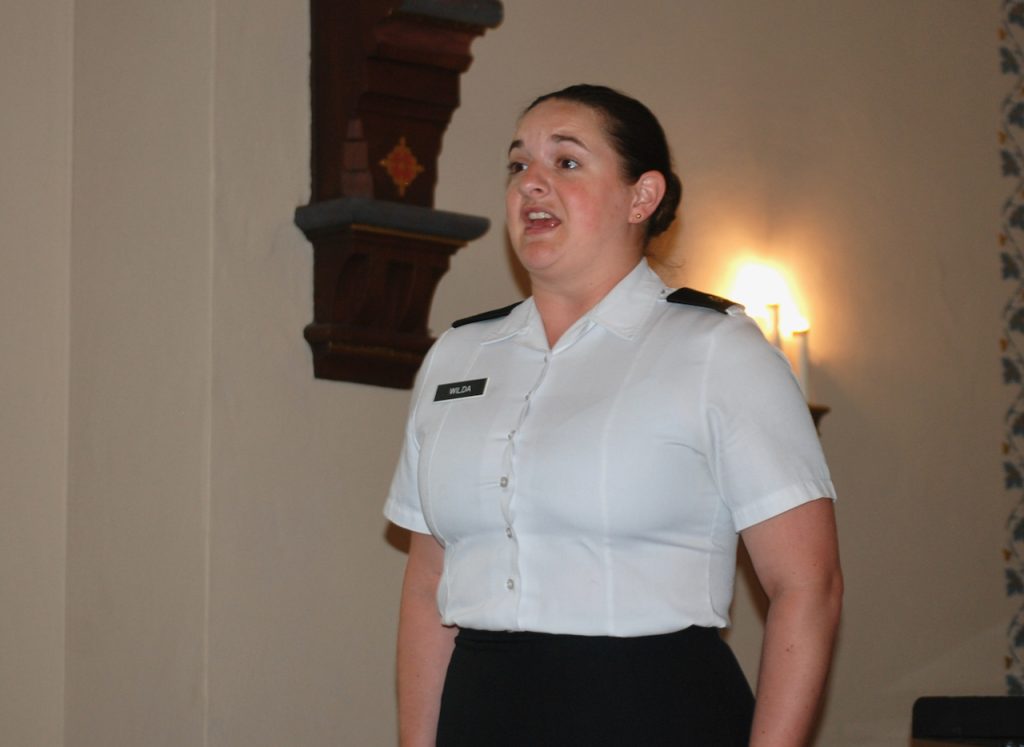
Vocal soloist Sgt. Vicky Wilda sings “The Star Spangled Banner,” during the opening of a performance given recently in Whitewater by the approximately 30-member 132 Army Band Wisconsin Army National Guard. The full band performance followed a performance from a quintet, called “The Guardian Winds,” which was composed of members from the larger group.

Concert-goers stand while vocal soloist Sgt. Vicky Wilda sings the National Anthem.
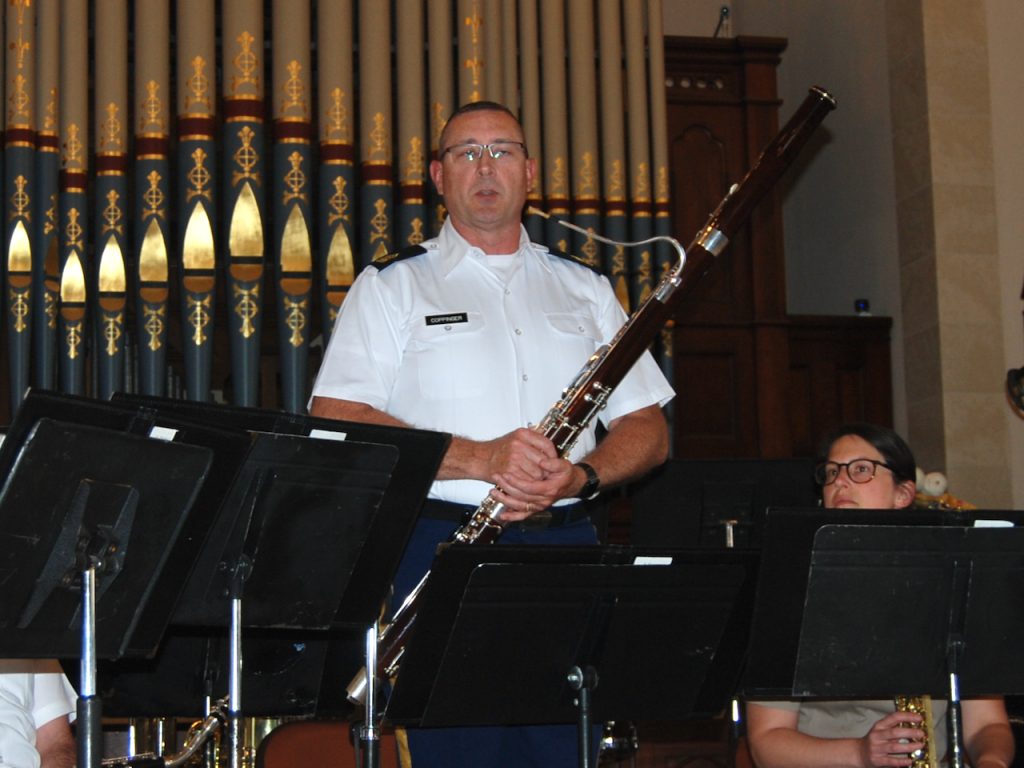
A member of “The Guardian Winds,” enlisted 132 Army Band Wisconsin Army National Guard leader 1st Sgt. Kyle Coppinger introduces himself to the audience. Coppinger told those in attendance that he is a 1997 graduate of the University of Wisconsin-Whitewater.

Sgt. 1st Class Lauren Tredinnick addresses the audience, offering information about each branch of the U.S. military and introducing its official song. Tredinnick also played the saxophone.
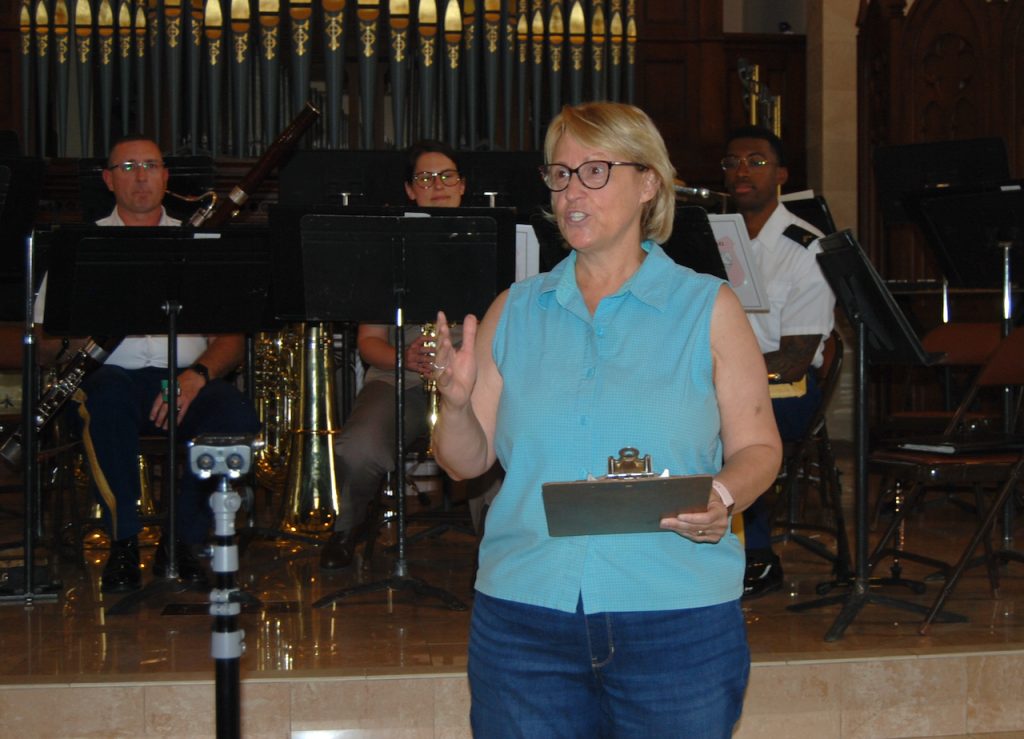
Whitewater Arts Alliance Board of Directors President Megan Matthews welcomes event-goers to the second concert in the 2023 summertime “Savory Sounds” series. Following statewide alerts informing the public of poor air quality produced by smoke from fires in Canada, the event, which is traditionally held outside, was moved indoors, and held at the First United Methodist Church, Whitewater. During her remarks, Matthews noted that alliance board member Christine Hayes, who was unable to attend the event, had spent several months engaging with the band and its organizers to schedule a performance in Whitewater.
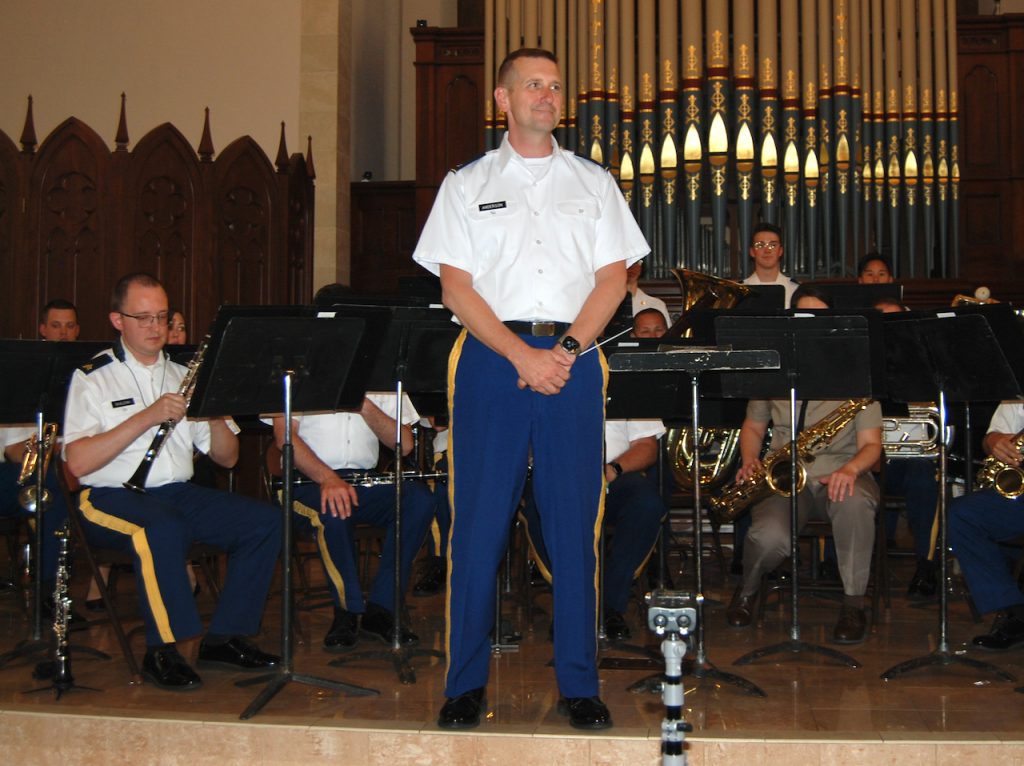
Band commander and Chief Warrant Officer Brad Anderson stands before the 30-member 132 Army Band Wisconsin Army National Guard. Anderson served as band conductor. The band is additionally led by its enlisted leader 1st Sgt. Kyle Coppinger, not pictured.

Some 70 concert-goers fill the sanctuary of the First United Methodist Church, Whitewater, during the second Savory Sounds concert held late last month.
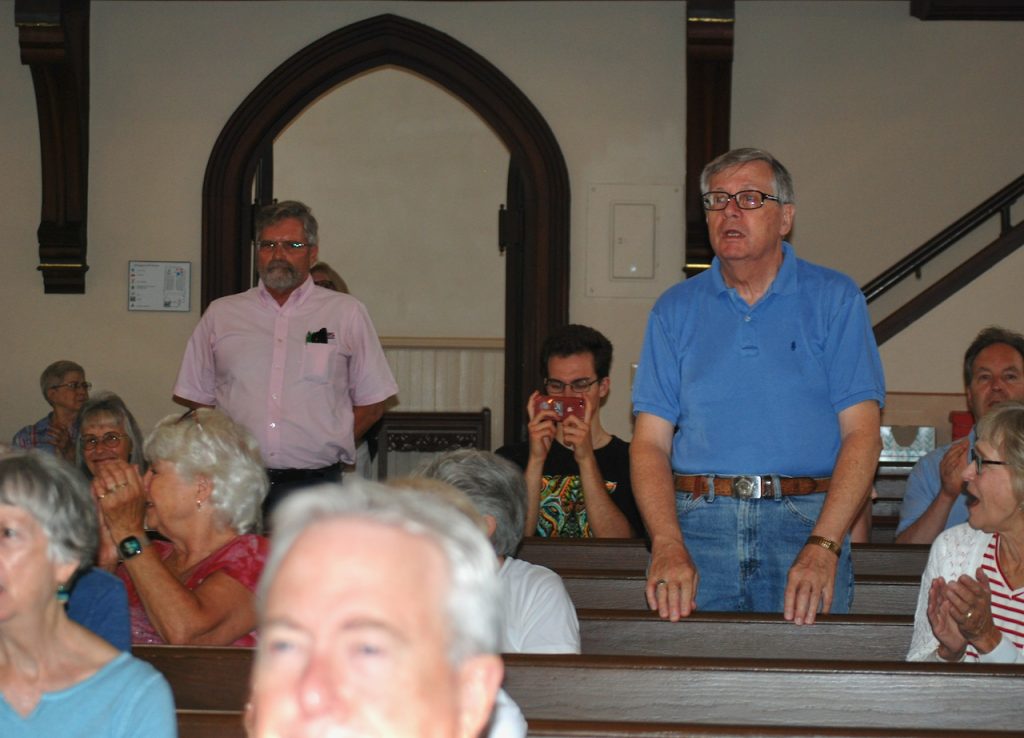
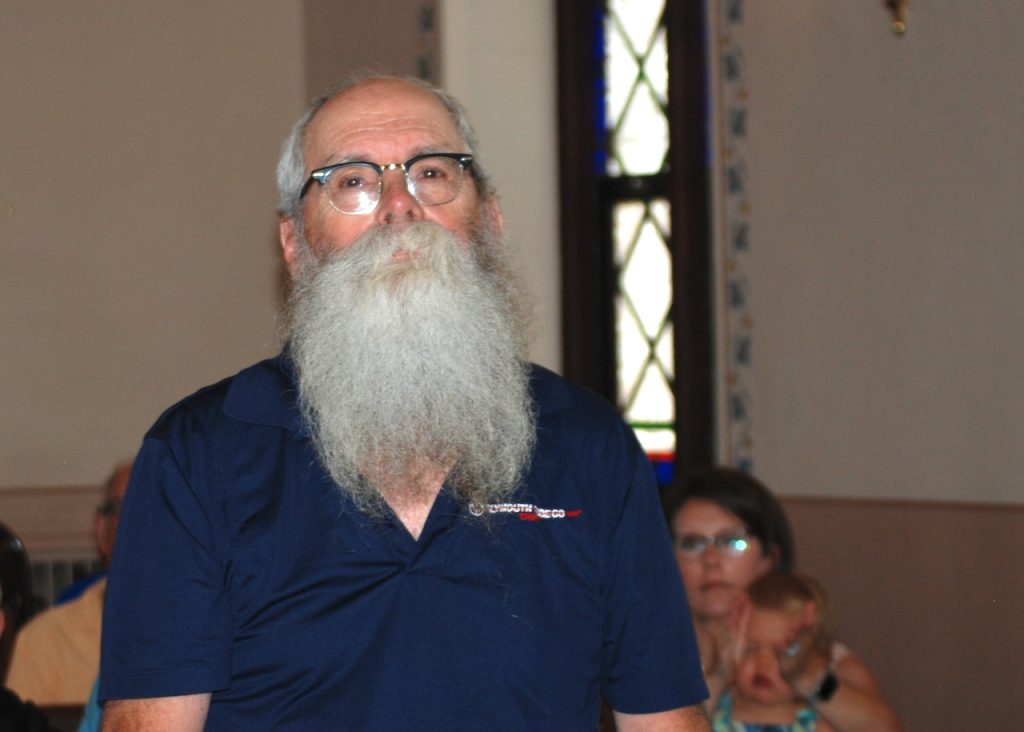
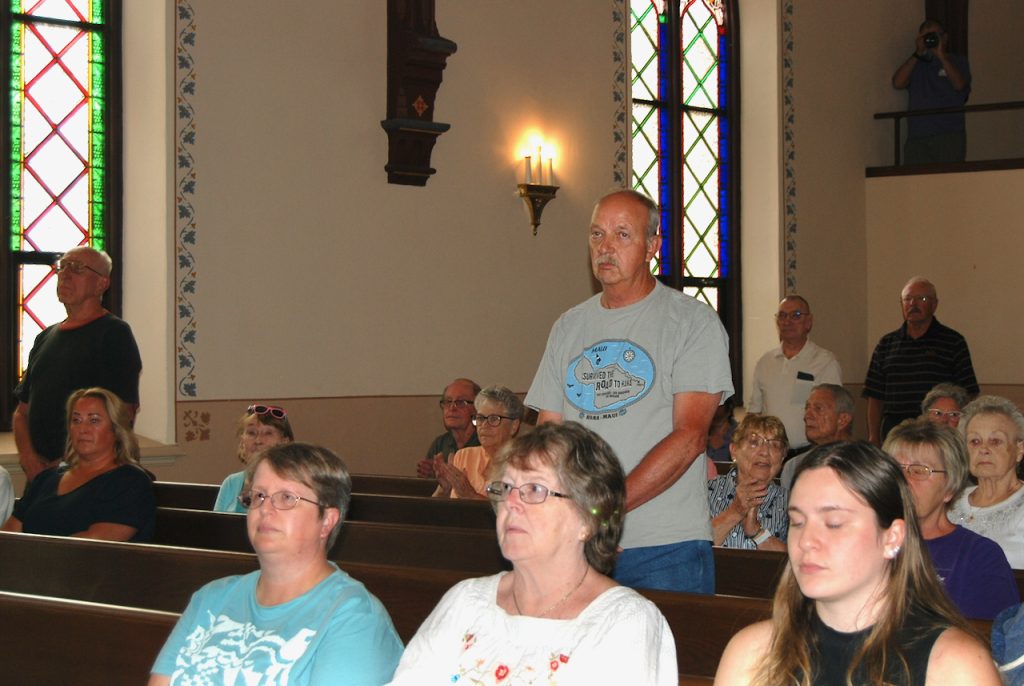
Three photos above: Veterans and members of various branches of the military stand as the official song of the branch in which they served or serve is played by the 132 Army Band Wisconsin Army National Guard.



Three photos above: Members of the 132 Army Band Wisconsin Army National Guard play.
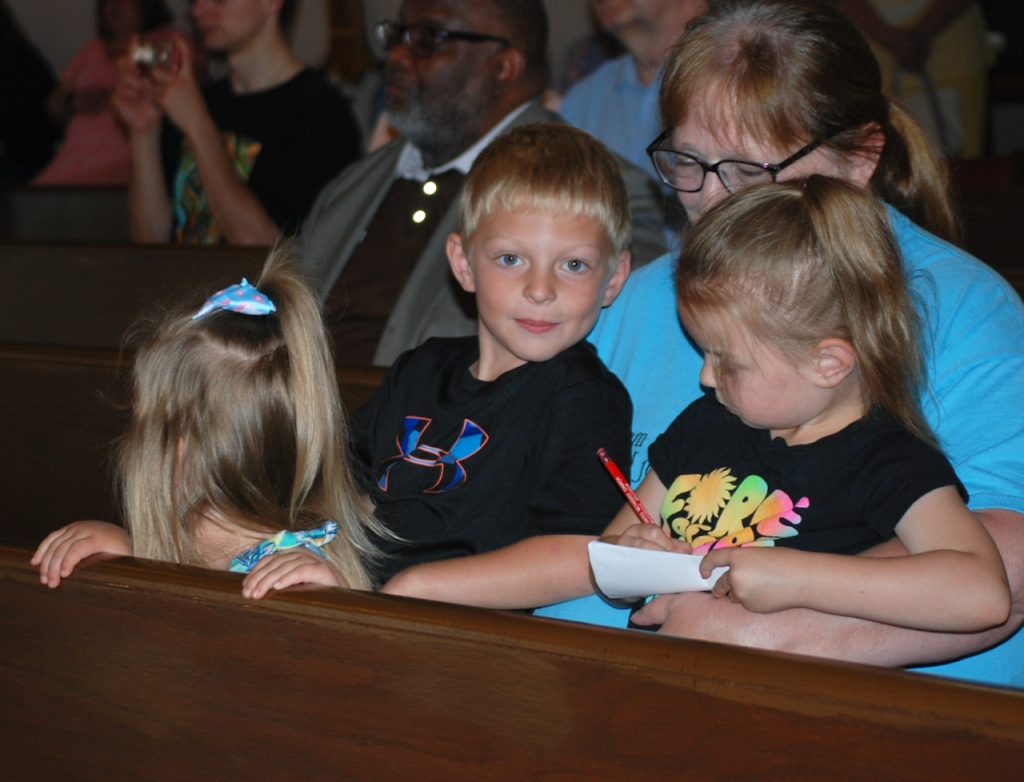
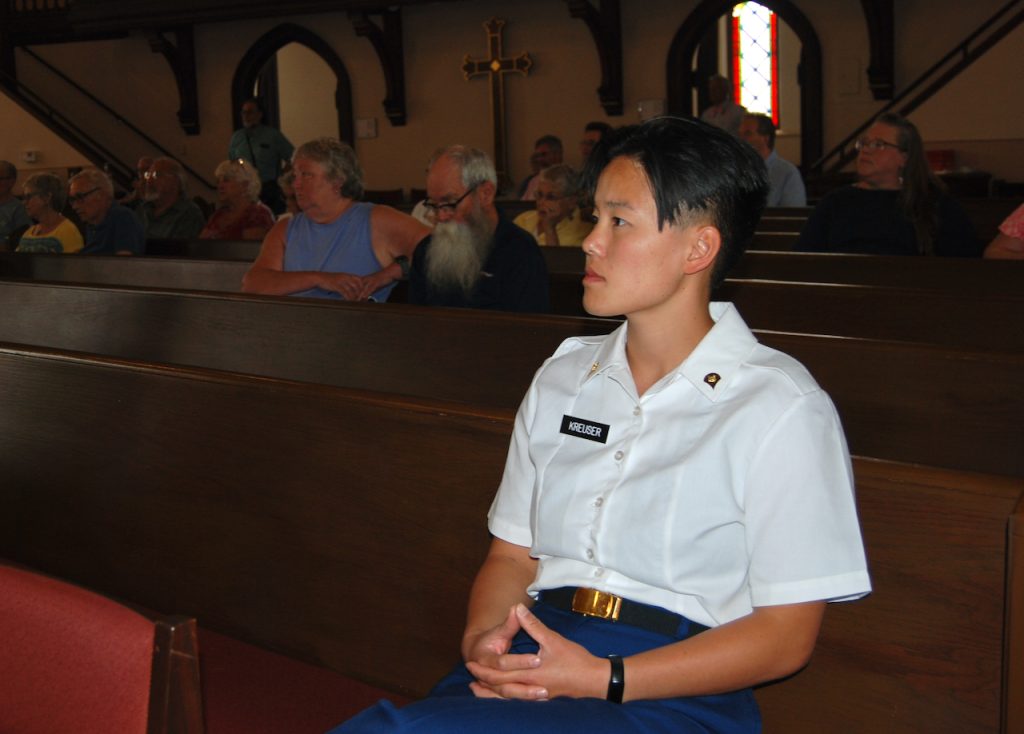

Three photos above: Audience members listen and respond to the music.
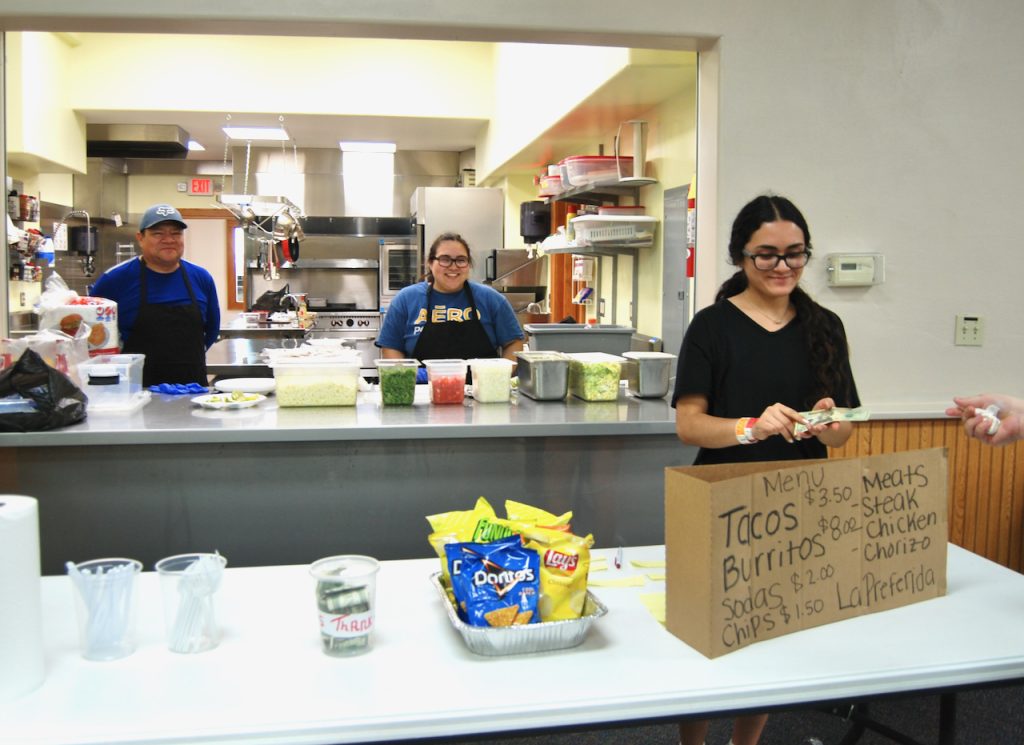
Members of the Islas family and owners of La Preferida, Whitewater, including Luis, from left, Gaby and Emy, prepare food. The restaurant was paired with the concert as part of the Savory Sounds concept. Patrons of the onsite vendor were provided with dining space in the fellowship hall of the First United Methodist Church, Whitewater.
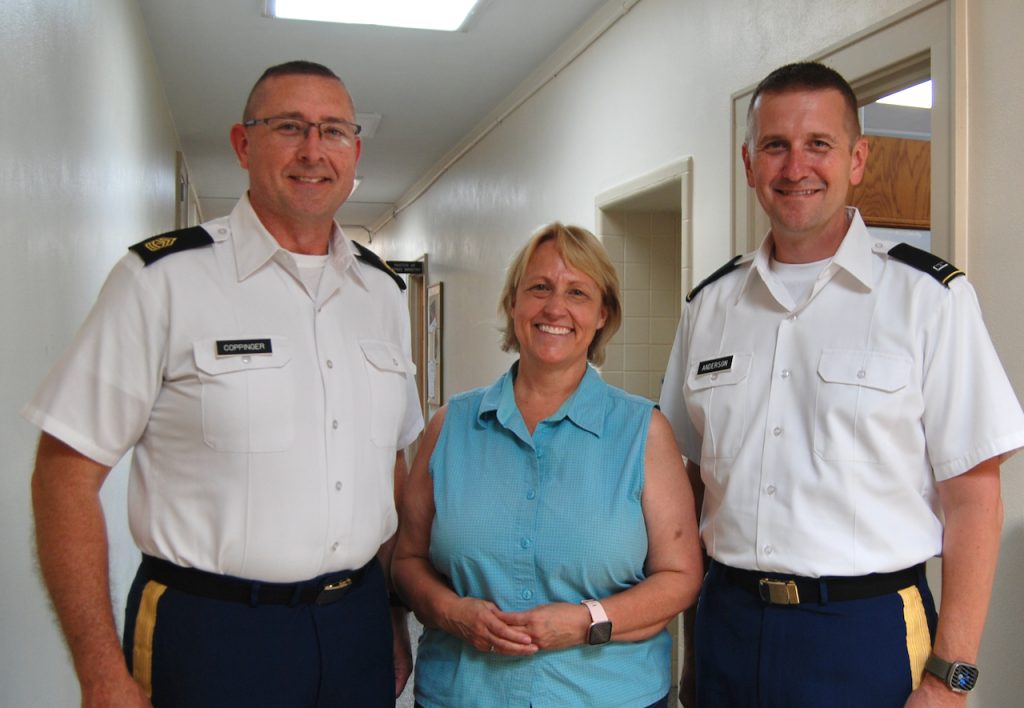
Gathering at the First United Methodist Church in advance of the concert are enlisted band leader 1st Sgt. Kyle Coppinger, from left, Whitewater Arts Alliance Board of Directors President Megan Matthews, and 132 Army Band Wisconsin Army National Guard commander Chief Warrant Officer Brad Anderson.
Kim McDarison photos.
Click on the image above to watch the full performance of the 132 Army Band Wisconsin Army National Guard given in Whitewater in June.
Weidl: ‘pivotal conversation’ to shape city and aquatic center Thursday
(Originally published July 13, 2023.)
Letter to the editor:
I am writing to the stakeholders of the city of Whitewater and to the membership of the Whitewater Aquatic and Fitness Center (WAFC), both as vital foundations of our vibrant community and our future. I write to invite you to participate in a pivotal conversation that will shape the future of our city and the WAFC.
On Thursday, July 13, at 6 p.m., the city of Whitewater and the Whitewater Unified School District (WUSD) will hold a joint meeting to discuss a proposal that has been meticulously developed by the city’s Whitewater Aquatic and Fitness Center (WAFC) subcommittee.
This meeting, which will take place both in person at the city of Whitewater Municipal Building and virtually via Zoom, is more than just another city council meeting. It is a platform for you to engage in a dialogue that will directly impact the health, wellness, and community spirit of Whitewater as well as the long-term viability of one of our city’s gems, the WAFC. We strongly encourage you to join us, whether via computer, smartphone or telephone, and lend your voice to this important discussion.
The proposal in the meeting agenda linked at the end and under consideration is a comprehensive six-year budget plan and operating framework for the WAFC. This plan, which includes contributions for operations and capital made by both the city of Whitewater and WUSD, as well as shared oversight, is designed to ensure the financial stability and continued operation of the WAFC. Of note, the city is proposing to freeze the school district’s contribution for operational contributions at 2023 levels for 2024 while the city will be contributing $70,000 per year, demonstrating our commitment preserving the integrity of the current hours and operations of this important facility. Though the WAFC is not just a facility; it is a symbol of our community’s commitment to promoting regional health, wellness, and collaboration. Its continued operation and pathway to growth is vital to the fabric of our city.
To that end, this proposal is the result of a proactive effort, combining elements from both the city’s proposal and the most recent WUSD proposal. The plan lays out explicit financial contributions from both parties, providing clarity and transparency that will aid in future financial planning. It also includes an annual adjustment of 3% to account for inflation, a practical measure that ensures the sustainability of our partnership over time.
Perhaps most importantly, the proposal calls for the formation of a shared leadership committee. This committee, consisting of representatives from the WUSD, city council, and community members, is designed to foster inclusivity and ensure diverse perspectives in decision-making. It is a clear demonstration of our commitment to a democratic and participatory approach to managing the WAFC.
We firmly believe that this proposal offers a practical, sustainable, and equitable solution to the challenges facing the WAFC. However, its success is not guaranteed. It hinges on the support and participation of our community. We urge you to inform yourself about the proposal, participate in the discussion, and ultimately lend your support to this initiative.
The meeting will include a period for citizen comments, during which you are invited to voice your thoughts, concerns, and suggestions. This is your chance to make a difference, to contribute to the dialogue and shape the future of our city. In addition to participating in the meeting, I urge you to reach out to your school board representatives and city council alderperson.
https://www.wwusd.org/page/school-board
https://www.whitewater-wi.gov/308/Common-Council
I’m asking that you express support and desire for the success of the WAFC. Your voice can make a difference. Your advocacy can help secure the future of the WAFC. I assure you that any correspondence I receive will be added to the public record, further emphasizing the importance of your input.
The future of the WAFC, and by extension our city, is in our hands. Let us come together, engage in constructive dialogue, and make decisions that will ensure the continued growth and prosperity of Whitewater. We look forward to your participation in this important conversation and to hearing your valuable insights.
Thank you for your time, attention, and commitment to our community. Together, we can build a Whitewater that future generations will be proud to call home.
Sincerely,
John S. Weidl
Whitewater city manager

John Weidl
Jefferson, Walworth counties hit by storms; downed trees cause extensive power outages
(Originally published July 30, 2023.)
By Kim McDarison
Storms moving through Jefferson and Walworth counties Friday night caused damage to several trees throughout the region, bringing damage to the We Energies power grid, both the National Weather Service and We Energies have been reporting since late Friday night.
For approximately 70,000 customers within the extended Milwaukee region, including Jefferson and Walworth counties, trouble began around 10:30 p.m. on Friday.
On Saturday, the Nation Weather Service, operating from Milwaukee/Sullivan, reported that damage received to the area was not created by tornados, but instead was the result of widespread wind between 60 and 70 miles per hour, with some areas seeing wind speeds up to 80 miles per hour.
“One thing that was unique about last night is how long the winds lasted,” the service reported on its Facebook page, noting that in some cases the extreme winds were sustained for 10 minutes or longer.
“This likely accounts for the amount of widespread tree damage — especially in places like Fort Atkinson.” the service noted on Facebook.
“Trees are often able to handle short bursts of 60 or 70 mile-per-hour winds, but long duration winds like last night put enormous force on the trees, and over such a long period of time many will fall or otherwise be damaged,” the report continued.
The service reported that it was unaware of any injuries resulting from the storm.
Reports on Facebook from within the community also reported strong winds, damage to trees and power outages.
On his Facebook page, Fort Atkinson Online freelance reporter Ryan Whisner noted that his power was off, and his phone was likewise losing its power.
He reported that at his home, branches were down, but there was no damage to his house.
Numerous people took to the community’s Facebook group pages making similar reports.
We Energies, too, reported through its webpage, interactive outages map, and media outlets that by Saturday morning, the storm had caused outages for more than 58,000 Wisconsin customers, with more than 11,000 of them residing in Jefferson County.
By Saturday afternoon, the utility reported, power restorations were underway, with just over 37,000 customers in southeastern Wisconsin, with approximately 8,700 of those customers residing in Jefferson County, remaining without power. Walworth County was reported to have about 2,800 customers without power at that time.
As of Sunday, the company continues to report on its website that “Severe storms have caused widespread outages in southeastern Wisconsin. We are encountering extensive damage including downed trees and damaged power equipment. We expect 95% of customers who lost power will have their power restored by midnight tonight. The remaining customers will have their outage restored Monday. All available We Energies crews, including specialized forestry workers and extra contract crews, will continue to work around the clock to make repairs and restore power to customers affected by these severe storms. Customers can see their expected restoration time on the outage map. Customers can sign up for outage alerts to receive updates as crews restore specific outages.”
In Whitewater, on Saturday morning, power was out across the community’s downtown. Around 11:00 a.m., the traffic light at the intersection of Main and Janesville street was not operational, although the light was restored right around noon.
Also on Saturday, a We Energies crew was busy at work adjacent to the Irvin L. Young Memorial Library on Center street.
A foreman told Fort Atkinson Online that the crew had been dispatched to repair a power line that had been damaged by a tree. As the crew completed its work, the foreman said that the restored line would likely return power to at least 1,000 Whitewater customers.
Reporting on the city’s Facebook page, Whitewater city officials told residents that many municipal buildings were without power Saturday.
Whitewater Arts Alliance manager Ashe McDarison arrived at the Whitewater Cultural Arts Center, in the city’s downtown, around 11:30 a.m. to discover the building without power. She, like many establishments in Fort Atkinson and Whitewater, placed signage alerting patrons of the day’s temporary closure.
By Saturday afternoon, city officials reported on their Facebook page that the city’s municipal building’s power had been restored.
In Fort Atkinson, Fort Atkinson Online freelance reporter Chris Spangler noted that downed trees and branches littered Fort Atkinson after Friday’s severe thunderstorm.
Reports on a community Facebook page noted that residents heard the city’s warning sirens sound twice Friday night.
It appeared that no street was exempt from damage to trees, Spangler observed Saturday as she made her way through the city.
Additionally, she noted that the high winds wreaked havoc at Evergreen Cemetery on the city’s north side.
Numerous large trees, particular those toward the eastern end of the cemetery, sustained damage, closing off entrances. The tops of some appeared to have been sheared off by the straight-line winds, she reported.
Trees in several parks also were damaged, including several in Jones Park, a couple in Barrie Park and a few near the Wisconservation Club in Rock River Park. High winds blew over a pole holding a weather siren.
Trees along Riverside Drive/State Highway 106 sustained damage, as did those along Rankin and Van Buren streets. The 200 block of South High Street, Hillcrest Drive, Adams Street also were among those with branches and trees down. Felled trees brought down utility wires, including one in the alley between the 600 block of Monroe and Robert streets.
The power outage closed Festival Foods, which also was expected to be closed Sunday. On Saturday, employees were busy tossing dairy and refrigerated food, as well as some frozen items and produce, into dumpsters, Spangler reported.
The city’s compost site will be open Sunday, from 6 a.m. to dark, to accept brush from the storm.
Social media was helping keep residents informed about what was happening, with residents posting damage reports, power outages and sharing contact information for those looking for help with cleanup. Neighbors were helping neighbors pick up branches and good Samaritans were seen driving around town offering their help gratis.
Photos from both communities — Fort Atkinson and Whitewater — showing storm aftermath on Saturday, follow.
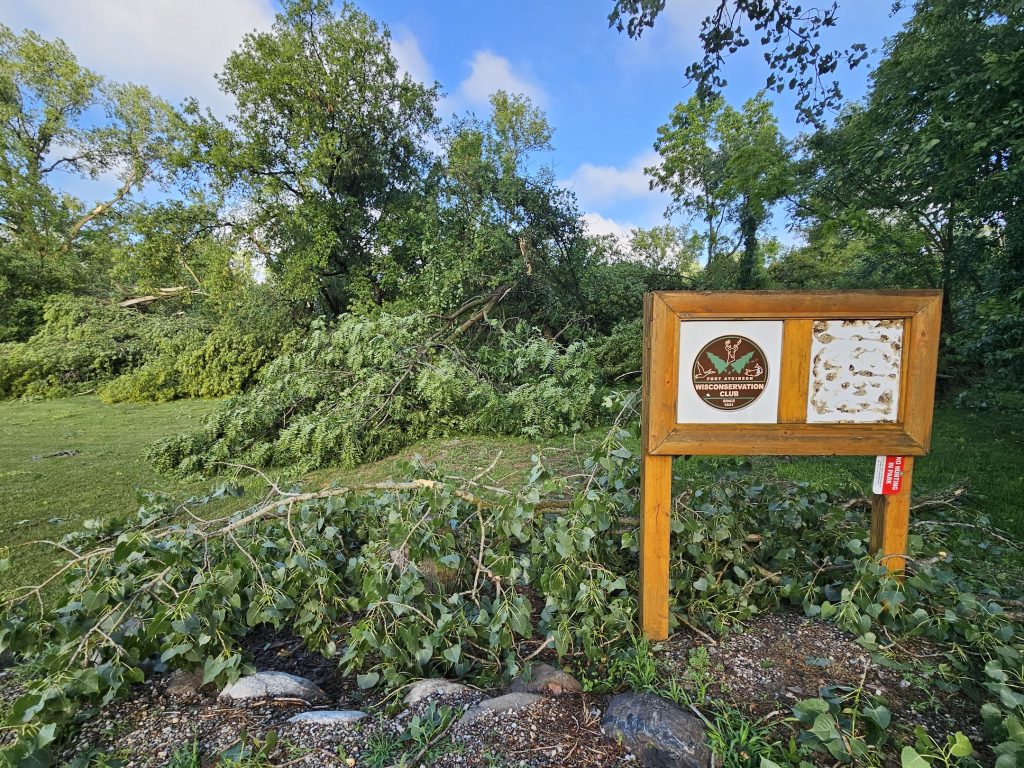
Trees are down near Wisconservation Club signage in Fort Atkinson’s Rock River Park. The damage resulted form Friday night’s severe thunderstorm.
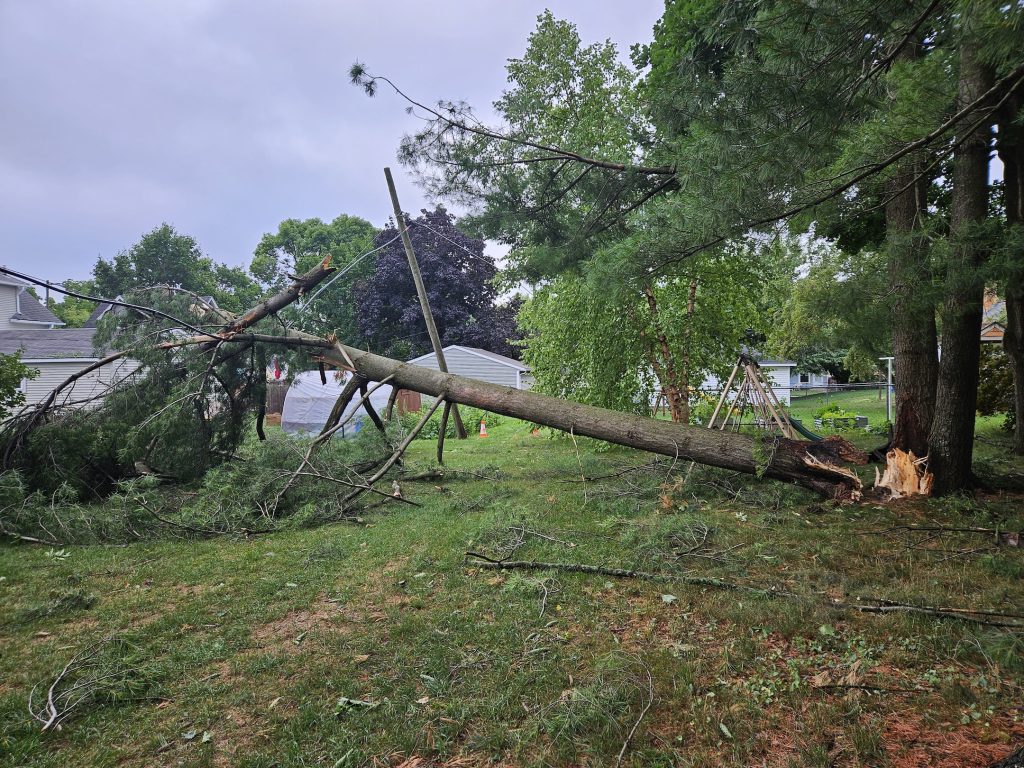
A large tree brings down a utility line in the alley between the 600 blocks of Monroe and Robert streets on the city’s north side.
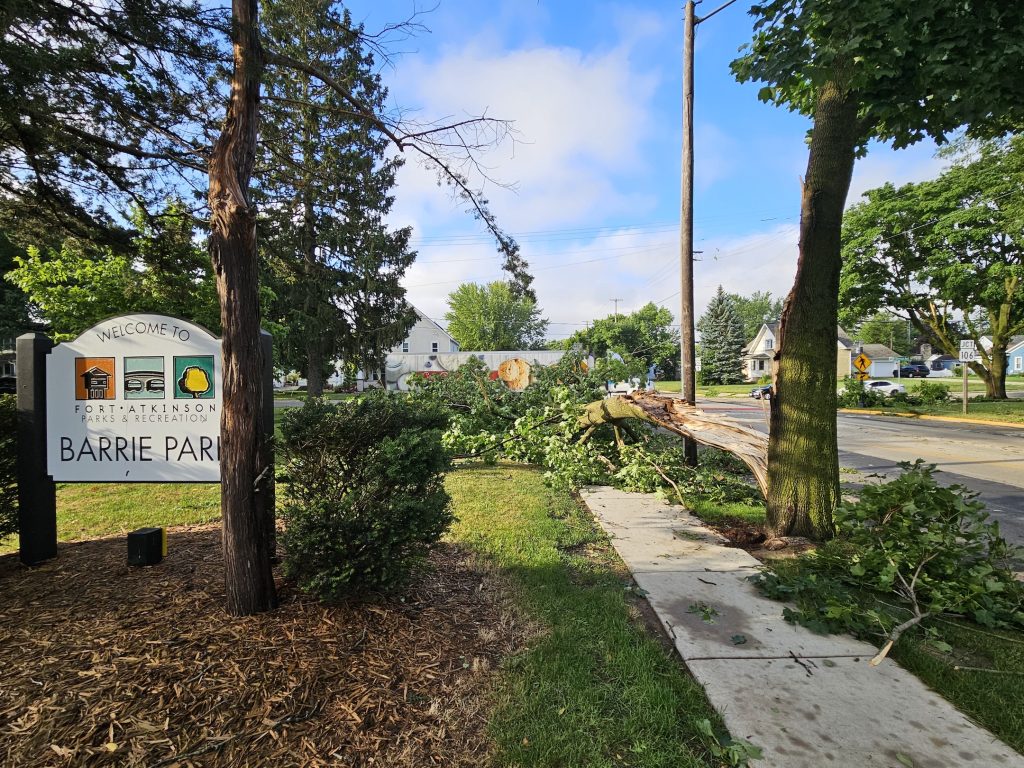
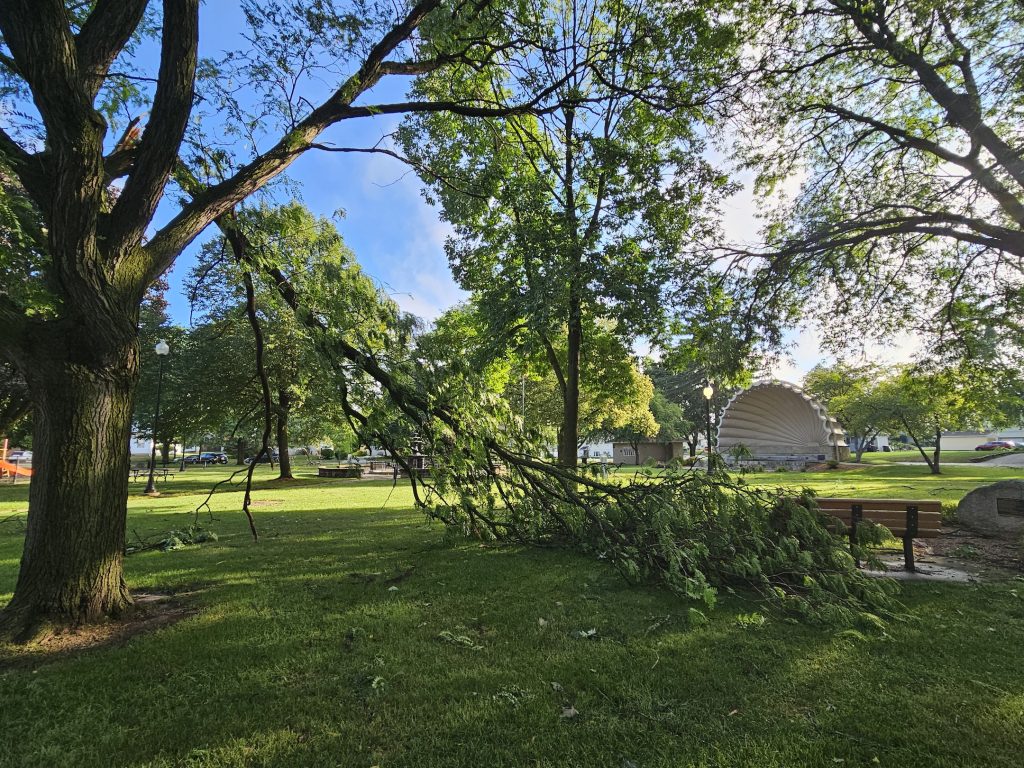
Two photos above: Produced by sustained high winds during Friday night’s storms, Fort Atkinson’s Barrie Park is littered with branches.
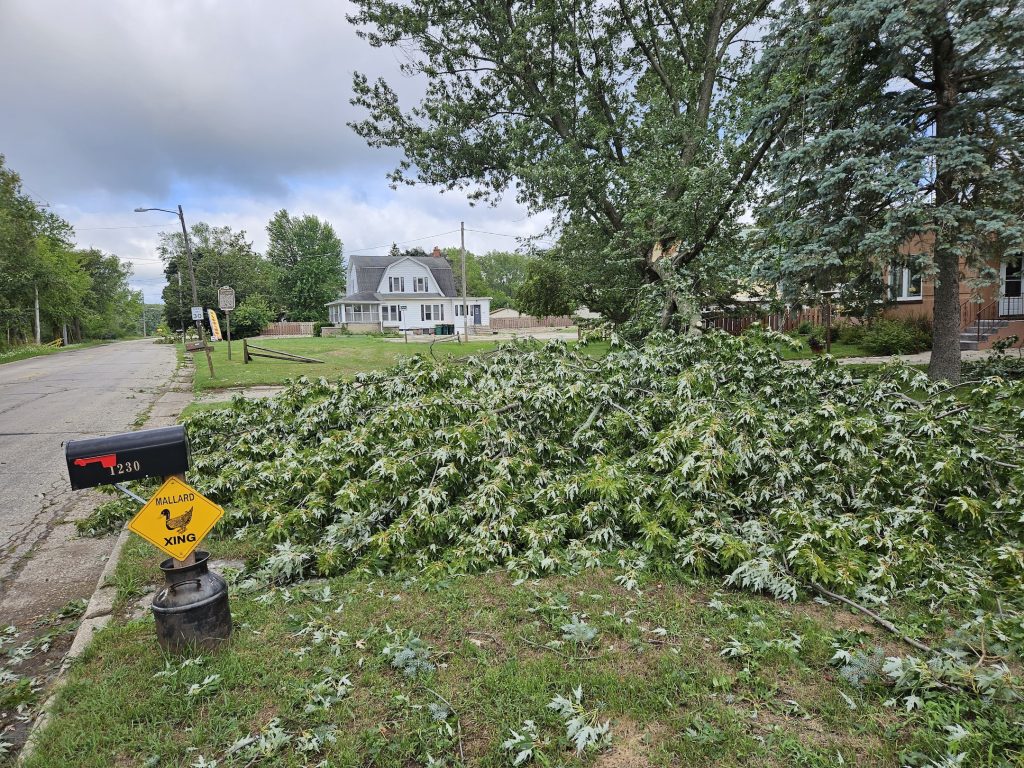
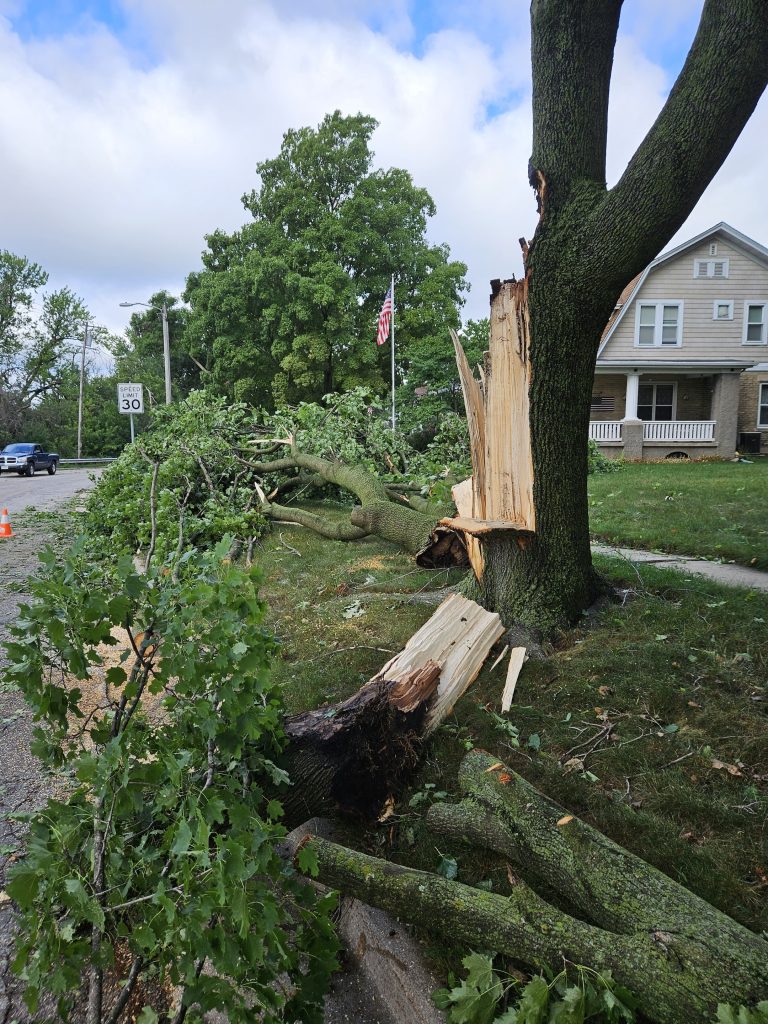
Two photos above: Tree damage is sustained on Riverside Drive/State Highway 106 in the aftermath of Friday’s storms.
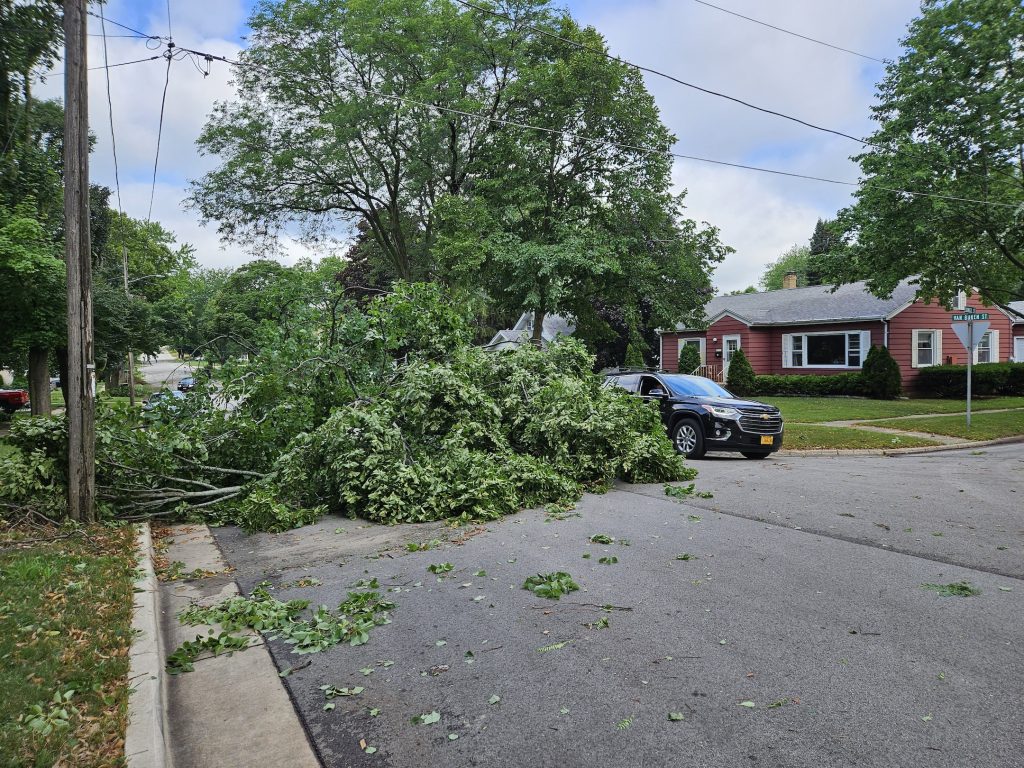
A portion of Van Buren Street at its intersection with Council Street is blocked after storms roll through Fort Atkinson Friday night.
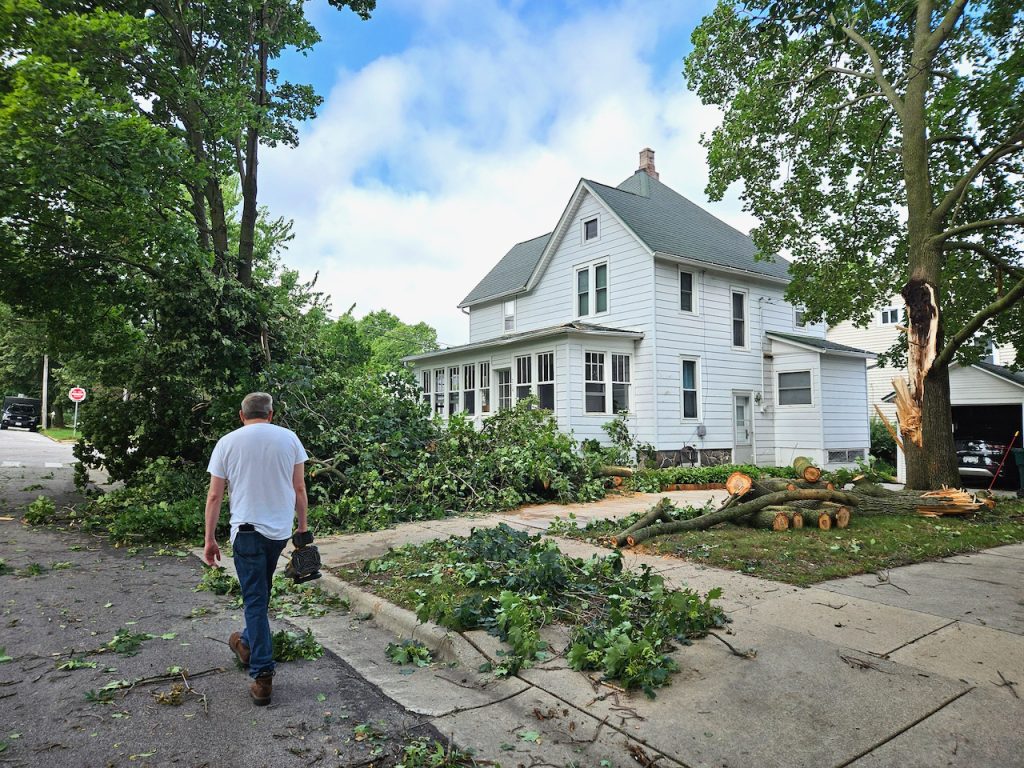

Two photos above: The 200 block of South High Street near downtown Fort Atkinson shows damage from Friday’s storm. At 214 S. High St., a tree fell onto the enclosed front porch, damaging its roof. Saturday morning, a crew had been dispatched to remove the tree from across the driveway and off the roof. At 207 S. High St., a tree on the terrace split and fell along the front yard.
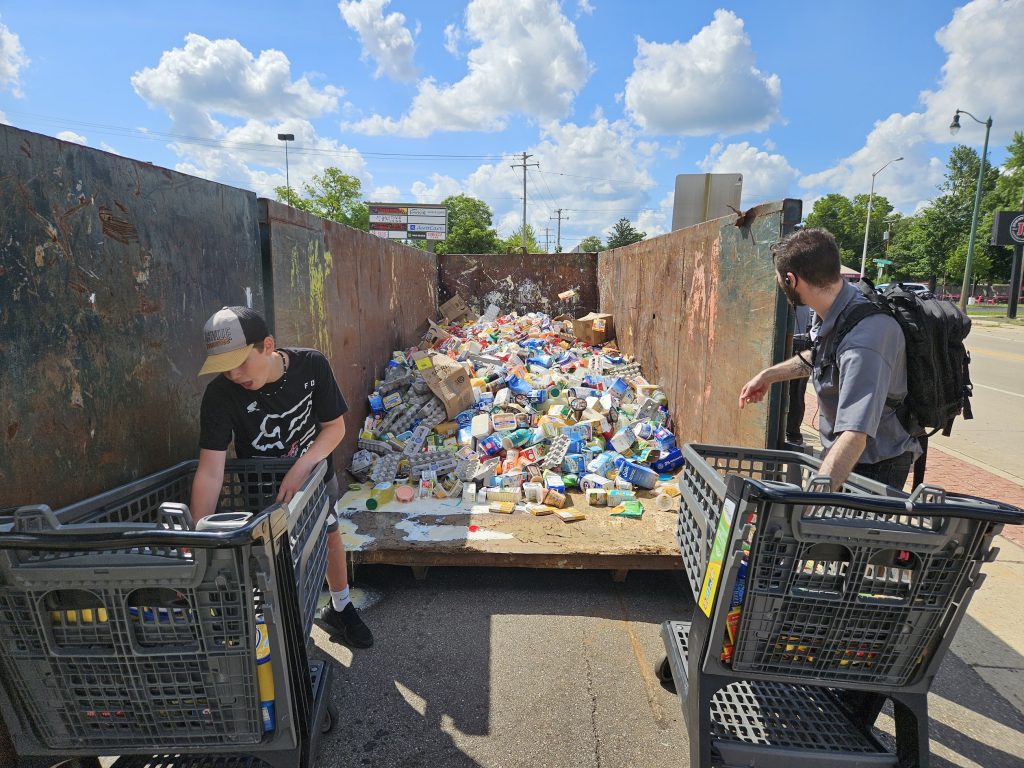
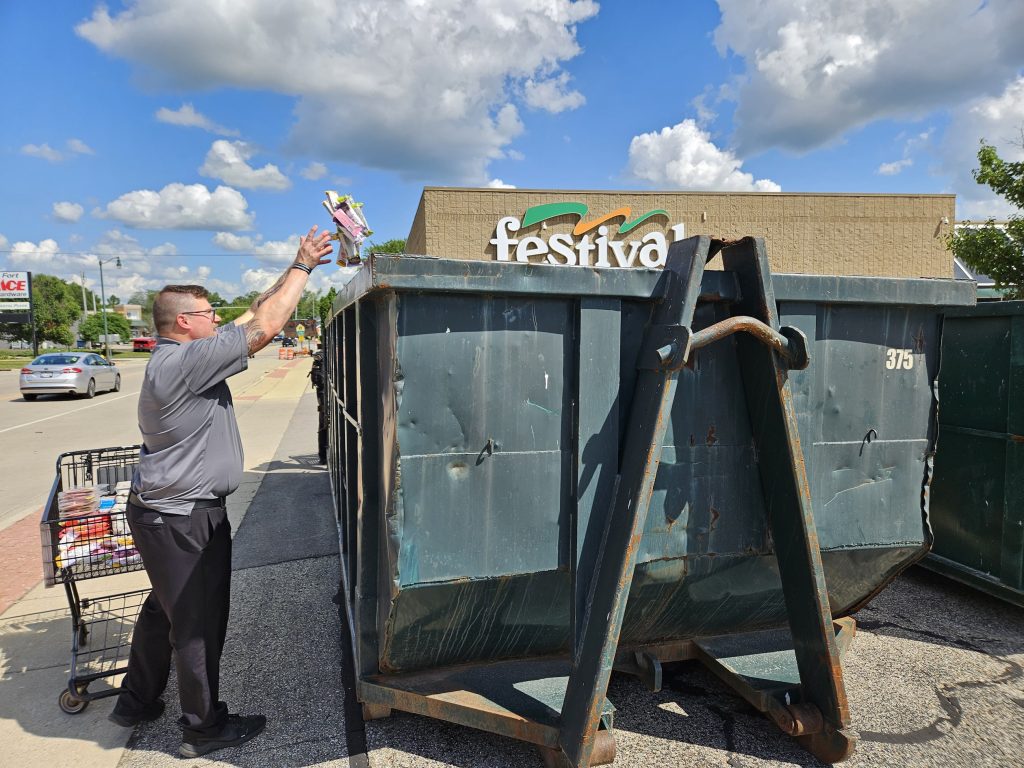
Two photos above: Festival Food employees discard some of the store’s inventory that require refrigeration and and freezer storage. The long power outage caused by Friday night’s severe thunderstorm and high winds closed Festival Foods on Saturday. An employee told FortAtkinsonOnline that all of the refrigerated and dairy products were being thrown away, as well as some frozen foods and produce.

A large branch takes down a utility wire on Adams Street on the city’s north side.
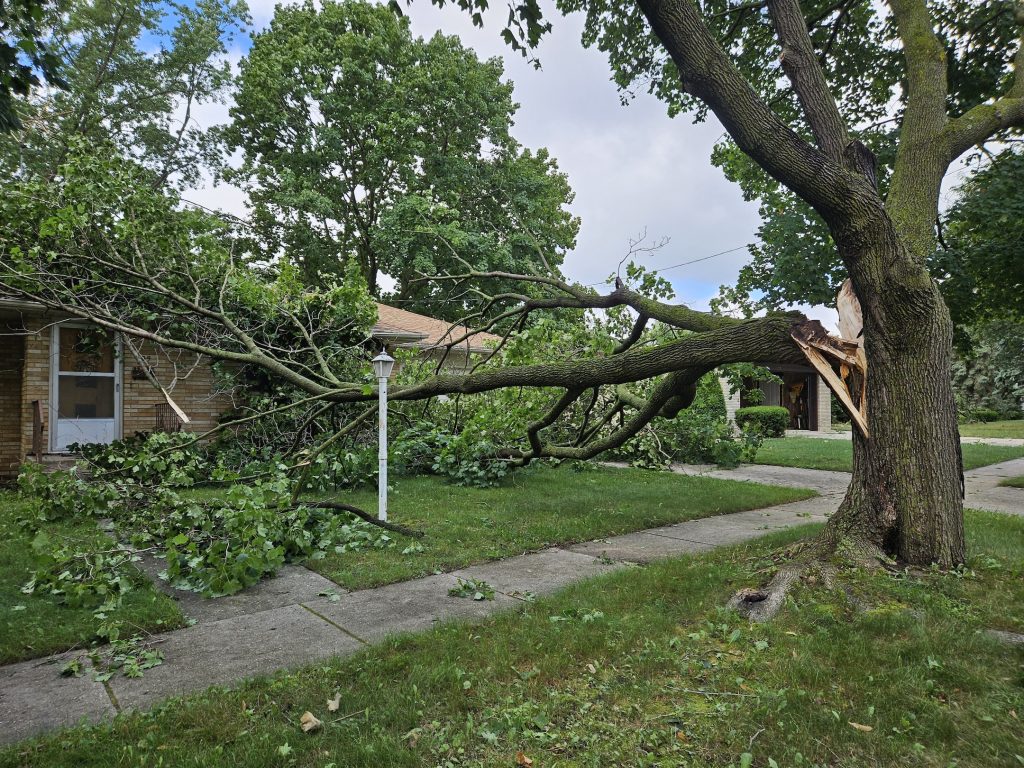
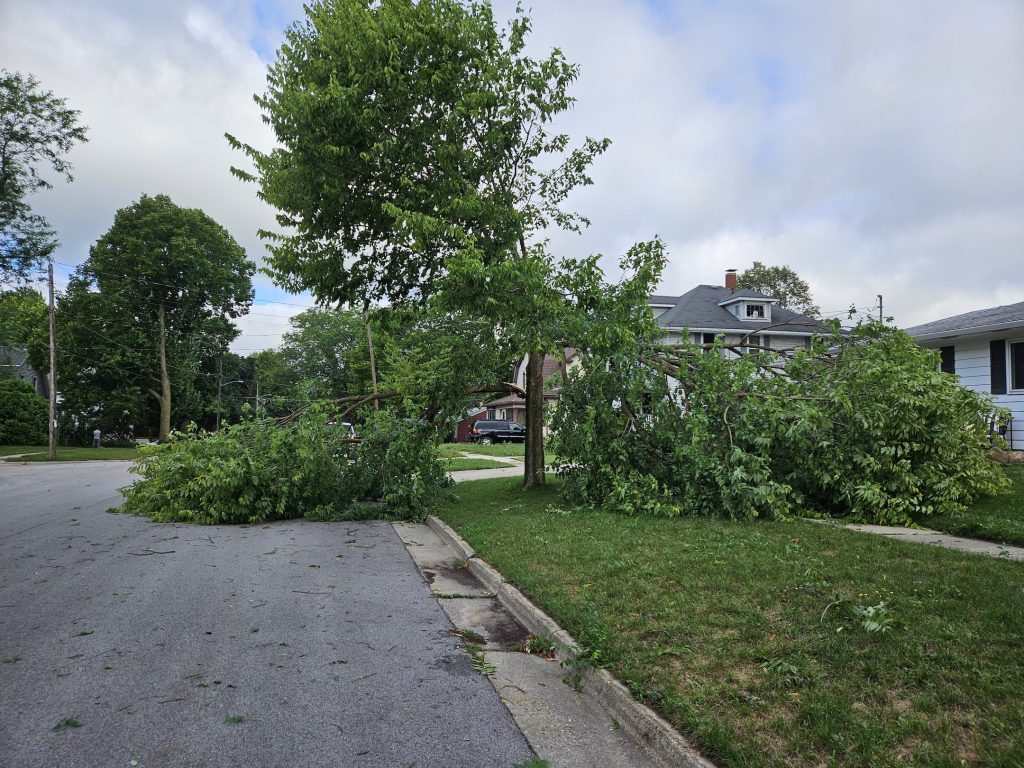
Two photos above: Tree branches are down in the 700 block of Rankin Street. The damage resulted from Friday night’s storms.
All photos above by Chris Spangler.
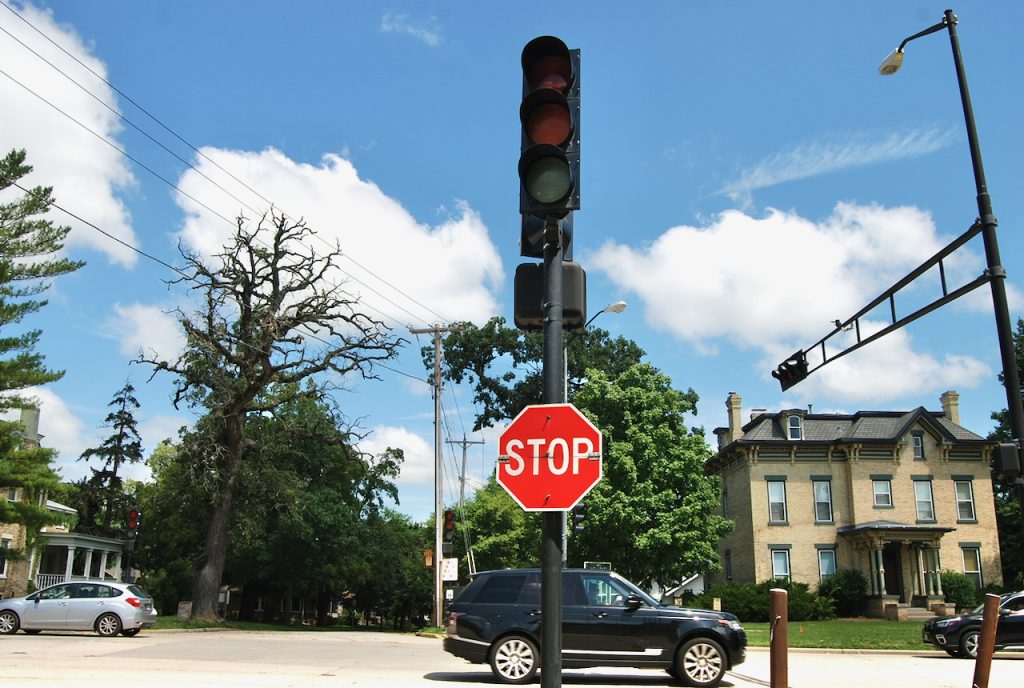
A traffic light at the intersection of Main and Janesville streets in downtown Whitewater is dark. Motorists were provided with stop signs to help direct traffic. The light was restored to working order right around noon on Saturday.
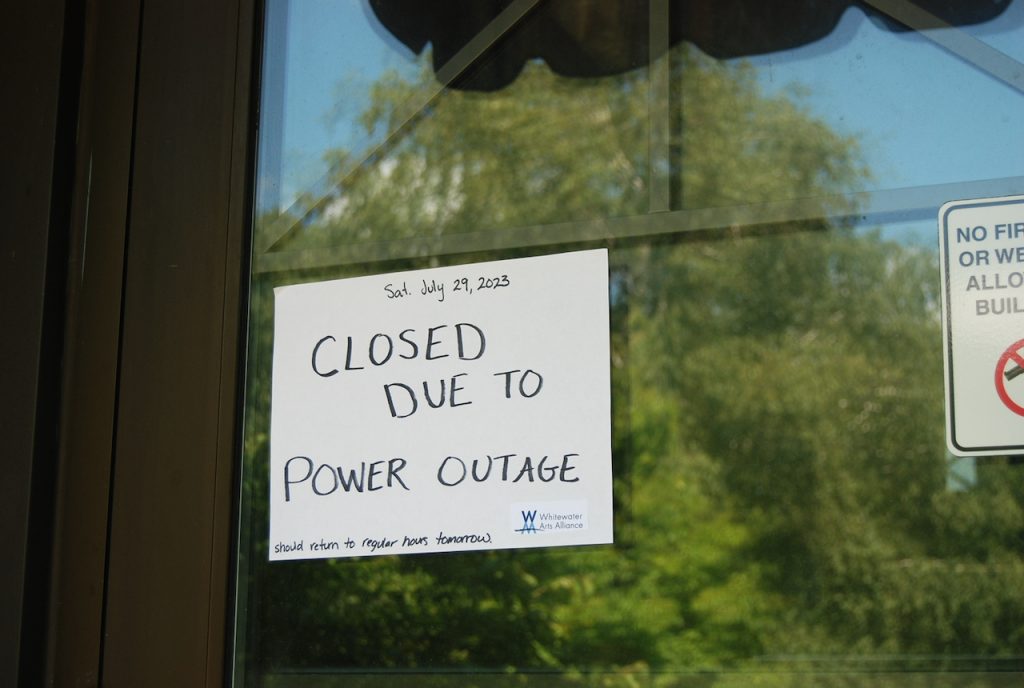
Signage placed at the Whitewater Cultural Arts Center in downtown Whitewater alerts would-be guests that the building is closed due to the ongoing power outage. The sign was placed Saturday morning. Power has since been restored to the building.
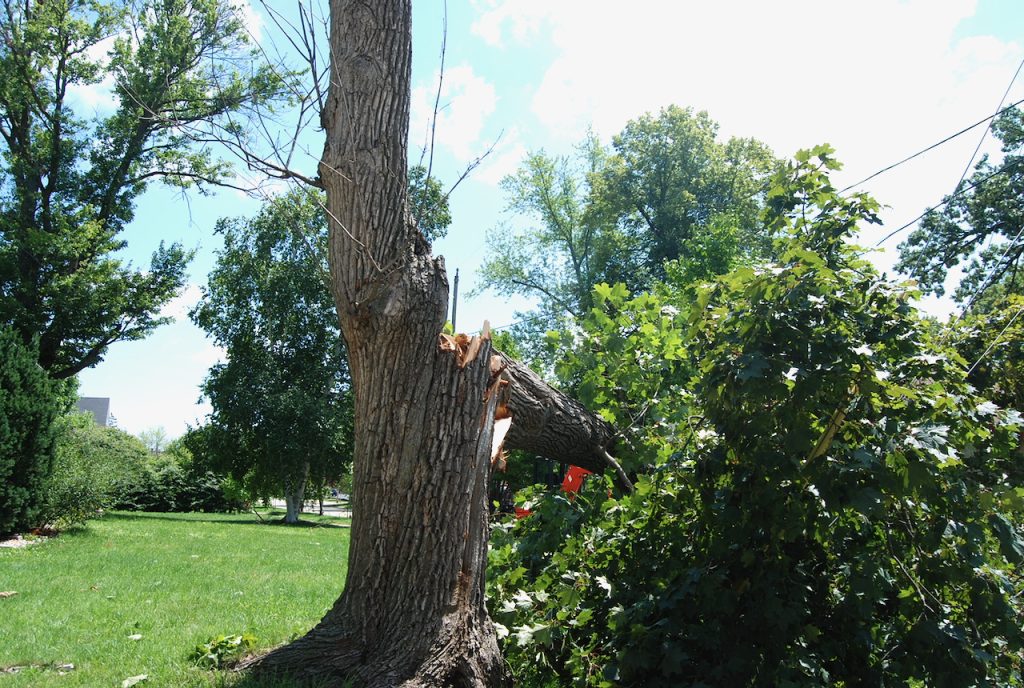
A large tree snaps at its trunk. The damage resulted from sustained gusts of wind, some of which reached speeds of 80 miles per hour and lasted for 10 minutes, according to information provided by the National Weather Service.
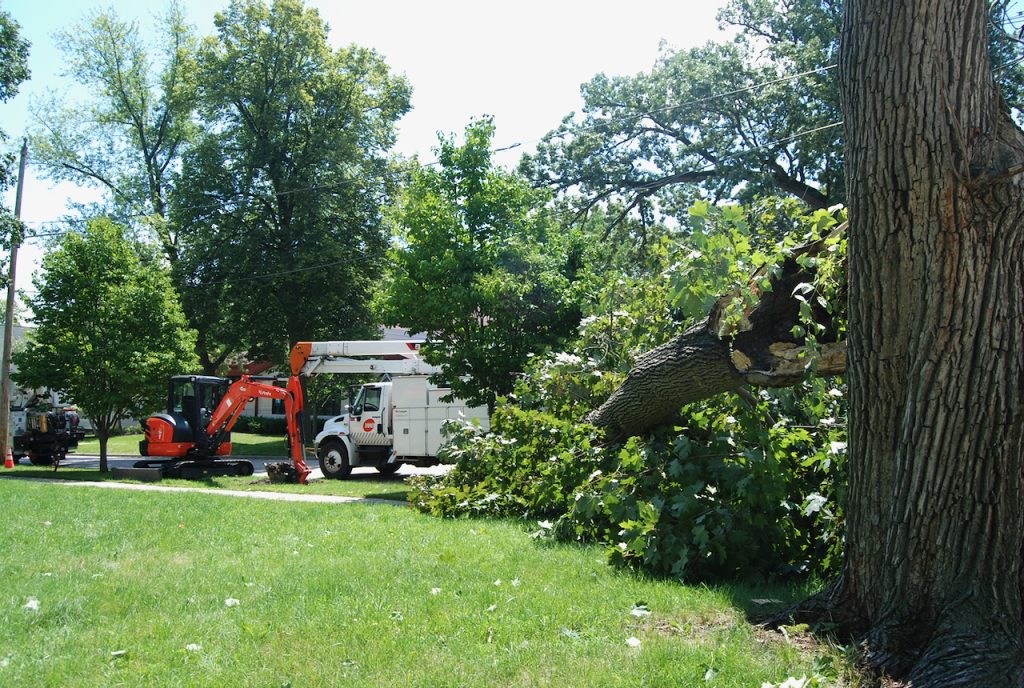
Various equipment is on hand near a fallen tree on Whitewater’s Center Street.
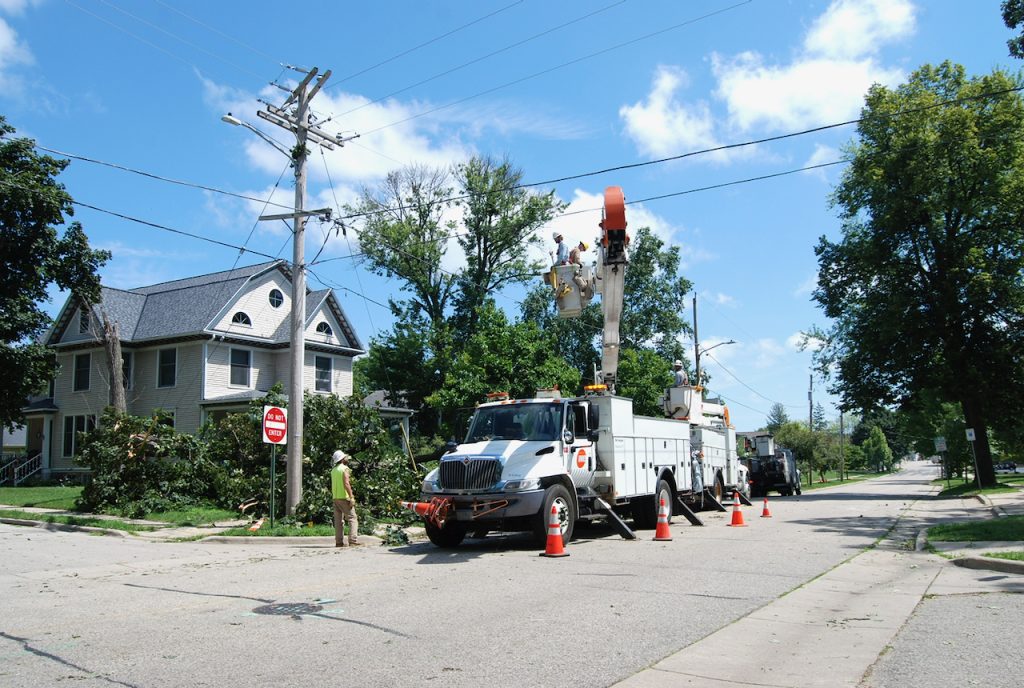
A Waukesha-based We Energies crew working in Whitewater completes its repair of a pole which had been damaged by a fallen tree resulting from Friday’s storms. A crew foreman said Saturday morning that the repaired pole likely would restore power to about 1,000 customers. The pole is located near the Irvin L. Young Memorial Library in Whitewater.
Kim McDarison photos.
UW-Whitewater holds Intergenerational Technology Services grand opening
(Originally published Nov. 7, 2023.)
By Chris Spangler
Feel like your grandchildren know more about computers and cellphones than you do? Well, it doesn’t have to be that way.
Area adults age 60-plus can receive free technology services through a new program at the University of Wisconsin-Whitewater.
Intergenerational Technology Services (IGeTS) recently held a grand opening at its new home in Room 124 of UW-Whitewater’s Community Engagement Center, where college students are providing free assistance with using cell phones, computers, social media and other technological devices and services to residents of Walworth, Jefferson, Rock and Waukesha counties.
The Wisconsin Department of Health Services awarded UW-Whitewater a $378,400 grant for the program, which is being offered in both English and Spanish. Services include group technology training classes, one-on-one technology assistance and telehealth visit support. The grant is part of a total $12.75 million given to 91 organizations statewide that was made possible by the American Rescue Plan Act.
The center is staffed by Tanya Mordecai, IGeTS director; graduate student Nicole Romero, IGeTS associate; university students and community volunteers. In addition to area residents 60 and over, it also serves persons 18 and over enrolled in IRIS, Family Care, Family Care Partnership or PACE.
The grand opening, held Wednesday, featured remarks by Mordecai, Jeannine Rowe, a social work and gerontology professor and IGeTS ambassador, and UW-Whitewater Chancellor Corey A. King.
“What’s happening here speaks directly to the Wisconsin Idea,” King said, referring to the general principle that education should influence people’s lives beyond the boundaries of the classroom. “The opportunity to engage in the community in this technology space … in advancing and growing our citizens and our members of our communities … is important. And for the university, Jeannine and your team, to be a part of this and for those who supported it is just incredible.
“So thank you for being a part of this; thank you for the vision, the leadership,” he added. “Understanding the intergenerational connection, especially in this technology space, is (wonderful), and so I want to thank all of you for making this happen. Speaking to the vision and mission of our university and this belief in the Wisconsin Idea, we are advancing our community and our region.”
Rowe was among those who spearheaded the intergenerational initiative.
“This space was born out of a need and the recognition that older people and persons with disabilities benefit greatly from technology, and it has a unique opportunity to help people age in place and reside in their own home communities,” she said. “And we also know that young people, folks that we serve here, tend to be the best teachers of technology. We’re really grateful to have that kind of workforce on hand, so this became a unique opportunity to broker the two generations where we could actually meet the needs of the community, which really fits with our values here at UW-Whitewater.”
Rowe said it took a team of people and organizations to make IGeTS a reality. They included the City of Whitewater Seniors In the Park, Fairhaven Senior Services, Greater Wisconsin Agency on Aging Resources and Aging & Disability Resource Centers, among others.
“And we’re grateful to provide students with a unique opportunity for a place where they actually grow their skills,” she said.
Mordecai also thanked attendees for their support and gave a brief synopsis of services.
“We are a free technology service provider to older individuals. We provide one-on-one tech support with their personal devices, we provide group training classes in which we have monthly rotating schedule that’s posted on our website that you can follow, we post weekly tech tips on Facebook for anybody who’s interested … and then we also provide telehealth visit support.”
She explained that the latter is designed for individuals who are working with a specialist or healthcare provider and find it difficult to travel to visit in person. IGeTS has space and computers they may use to attend to their business in private.
Mordecai also announced that IGeTS has broadened its services to adults age 18 and older who are enrolled in home and community-based programs such as IRIS, Family Care, Family Care Partnership or PACE. These typically are people who are living with some kind of a challenge or disability and are enrolled in those programs through Medicaid.
“We also are looking at going out into the community a couple days a week to provide some mobile services to different community partners — libraries, senior centers or assisted-living facilities — just to make sure that we can provide these services to many people in the community” Mordecai said, noting that IGeTS recently taught streaming at one such facility.
During a tour after the program, Mordecai expanded on her remarks.
“We’ve had individuals that are coming in with varying degrees of technology knowledge, which is what makes our one-on-one tech services so optimal for individuals,” she said. “We’ve had individuals who have gotten a new phone and weren’t able to disconnect a phone call — it was like 20 minutes later and all of sudden they heard somebody talking.”
Mordecai said IGeTS also has worked with seniors who have learned how to use the computer keyboard keys but do not know how to, for example, connect to Wifi.
“We’ve had individuals come in and are looking for help connecting with family members, sharing photos through media reels and Facebook, wanting to sell something on Marketplace and how to do Zoom and Facetime,” she added. “So it’s really run the gamut, and we’re branching out in more cybersecurity (subjects) for classes.”
November’s classes, in both English and Spanish, include those on the basics of using Apple and android devices, cybersecurity and using Ancestry.com. The schedule is available at https://www.uww.edu/igets#technology-training-classes.
“Technology can be intimidating, so our goal is to be able to meet people where their needs are. We want them to feel empowered and we want them to celebrate their learning and be able to maintain independence, and to support themselves through health community interaction and engagement,” Mordecai said.
“One of my favorite things is to watch this service delivered to somebody who might feel a little intimidated, but who leaves with a huge smile on their face, realizing they have learned something and they can go home and implement it,” she noted. “While they have a big smile on their face, so do the students offering the services. So you really get an opportunity to see that intergenerational connection and sharing of information to ensure that everyone in the community is able to meet their needs.”
The Community Engagement Center is located at 1260 W. Main St. in Whitewater near Walmart. Room 124 is located in the rear of the building, with free parking nearby.
Hours are 8:30 a.m. to 1:30 p.m., Mondays through Thursdays. IGeTS is closed on federal and state holidays, and Dec. 22 through Jan. 2, 2024.
For more information about IGeTS, visit the program’s website: www.uww.edu/igets, call: 262-472-1837 or email: igets@uww.edu.
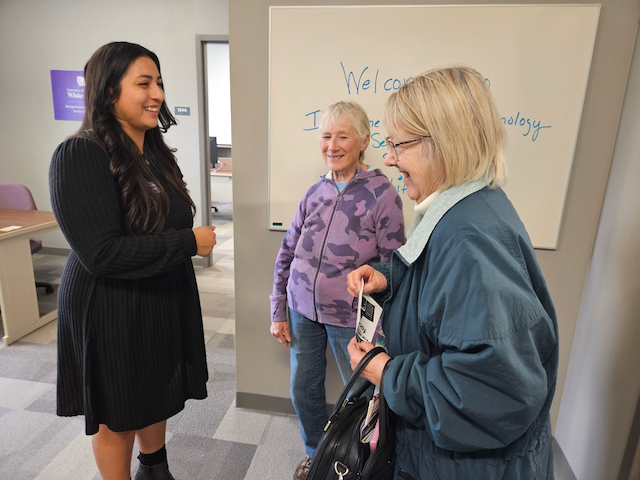
Nicole Romero, a University of Wisconsin-Whitewater graduate student and Intergenerational Technology Services (IGeTS) associate, at left, talks about the services the program offers to grand opening attendees, including Judy Wildermuth, Fort Atkinson, at center.

Tanya Mordecai, IGeTS director, at left, visits with a grand opening attendee in the room where group classes and training will be held.
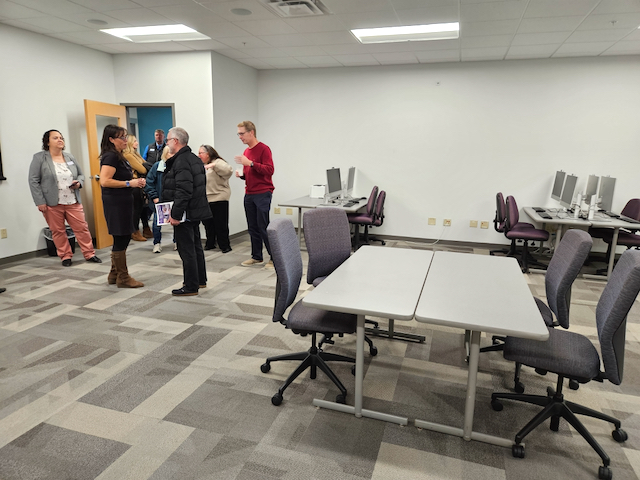
The IGeTS classroom features computers for group technological training.
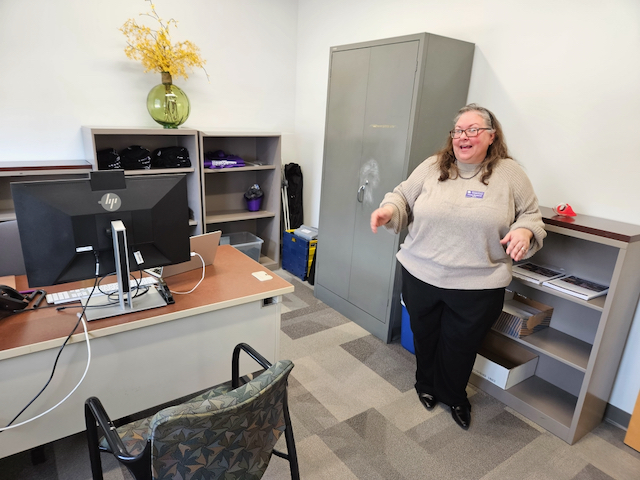
IGeTS directors Tanya Mordecai directs grand opening attendees to office space in which private conversations with health agencies and caregivers may be held.
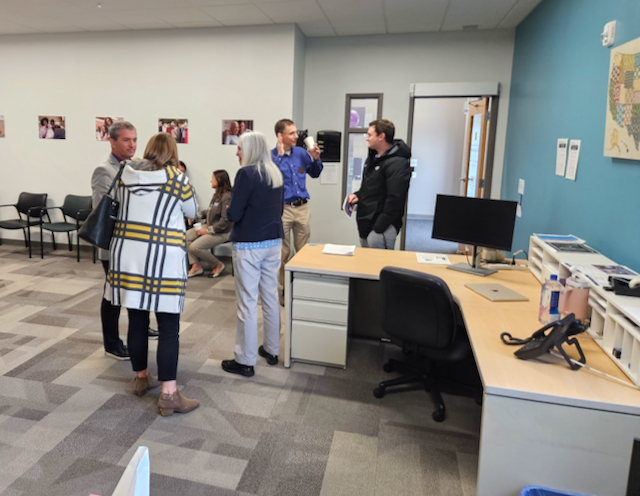
Attendees gather in a waiting room and area where 30-minute, drop-in, one-on-one technology services will be provided.
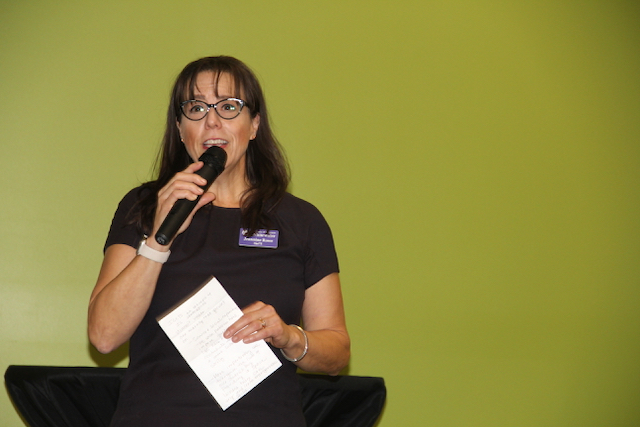
Jeannine Rowe, a social work and gerontology professor and IGeTS ambassador, offers remarks during the grand opening.
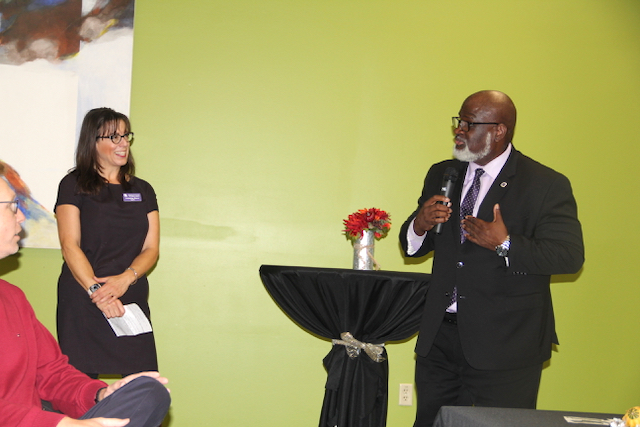
UW-Whitewater Chancellor Corey King, at right, recognizes Jeannine Rowe, a social work and gerontology professor and IGeTS ambassador, for her work to help spearhead the Intergenerational Technology Services program.
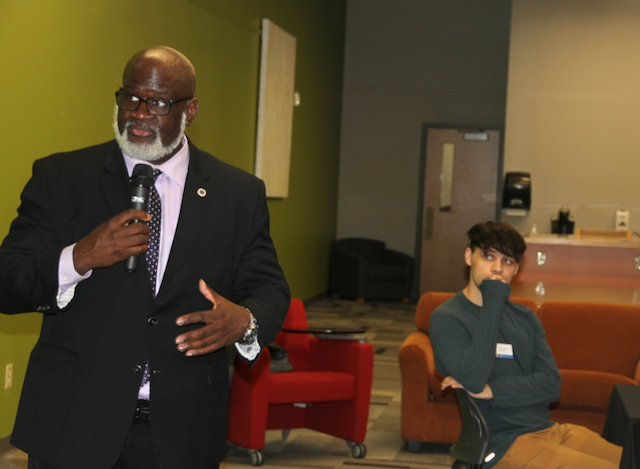
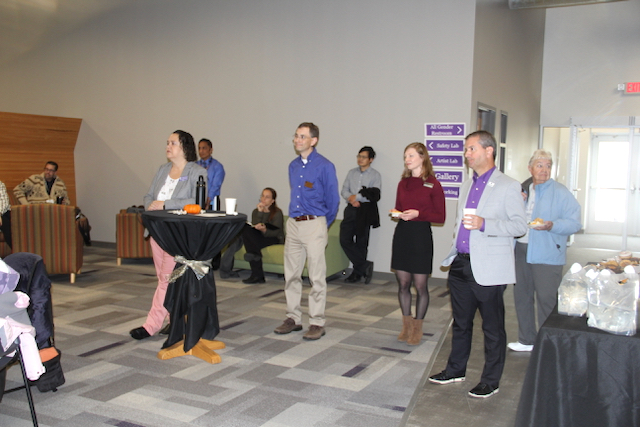
Two photos above: Chancellor Corey King, top, at right, offers remarks to attendees, shown above, about the IGeTS grand opening.
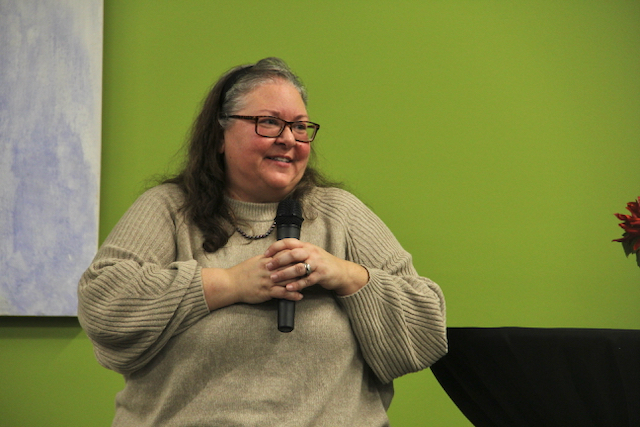
Tanya Mordecai speaks about IGeTS services during the grand opening.
Chris Spangler photos.
DPI releases 2022-23 district, school report cards
(Originally published Nov. 18, 2023.)
The Wisconsin Department of Public Instruction (DPI) Tuesday released its 2022-23 school year district report cards.
According to a DPI news release: “Statewide, achievement improved from 2021-22 to 2022-23, though for many schools and districts, 2022-23 achievement performance is lower than pre-pandemic levels.”
The release noted that, following the pandemic, “report card achievement scores, overall scores, and ratings may have decreased despite upward trending achievement performance.”
Additionally, the release stated: “This is the first report card that does not include achievement data from assessments occurring prior to the start of the COVID-19 pandemic. The DPI urges caution when interpreting scores and ratings due to impacts resulting from the pandemic.”
School achievement report cards, published annually, include data on multiple indicators for multiple school years across four priority areas: achievement, growth, target group outcomes, and an area titled “on-track to graduation.”
Districts are given an “overall accountability score,” placing them, and their schools, into one of five overall accountability ratings: “Significantly Exceeds Expectations,” represented with five stars; “Exceeds Expectations,” represented with four stars; “Meets Expectations,” represented with three stars; “Meets Few Expectations,” represented with two stars, and “Fails to Meet Expectations,” represented with one star.
Overall statewide findings
As stated in the release, of 378 public school districts receiving report card ratings for 2022-23 school year, 357, or 94%, met, exceeded or significantly exceeded expectations. Among districts receiving report card scores for both the 2022-23 and 2021-22 school years, 19 increased by one rating category compared to the prior year, 52 decreased by one rating category, and 306 had no change in rating.
There were 2,098 report cards produced for public schools for 2022-23. Among public schools, 158, or 8%, were unable to be scored due to insufficient data. Of the scored public school report cards, 1,601, or 83%, met, exceeded or significantly exceeded expectations. Among public schools receiving scored report cards for both 2022-23 and 2021-22, 255 increased in rating at least one category compared to the prior year, 394 decreased in rating at least one category, and 1,254 had no change in rating.
Additionally, the release noted, there were 405 private schools participating in a Private School Choice Program for 2022-23. Of scored private choice school report cards, 136, or 80%, met, exceeded or significantly exceeded expectations. Among private choice schools receiving a score for both 2022-23 and 2021-22, 26 increased in rating at least one category compared to the prior year, 48 decreased in rating at least one category, and 80 had no change in rating. Some 235 private choice schools, or 58%, were unable to be scored due to insufficient data. This is in part due to the tested choice student population being too small to meet the conditions required to produce report cards, either because of low test participation rates, or total choice student population size.
Further, the release stated, along with achievement, growth, and graduation rates, another component of the report cards is chronic absenteeism, which is the percentage of students enrolled for at least 90 days who missed more than 10% of school days. Wisconsin students, attending both public and choice schools, had a 23% chronic absenteeism rate for 2021-22, the most recent year of data for absenteeism. In line with national trends, this represents an increase from 2017-18 through 2019-20 of 13%, and 2020-2 of 16%. The DPI continues to work with schools, districts, and CESAs to support strategies to decrease chronic absenteeism rates.
Individualized 2022-23 data for area districts
School districts within and surrounding the Fort Atkinson Online readership area received the following overall accountability scores:
Fort Atkinson
According to the 2022-23 report card, the district educates students in grades K4-12, and has 2,523 students enrolled. Of that population, 7.4% use the state’s open enrollment program. The district’s overall score is 69.1, which is up from last year, when the district’s overall score was 68.3. Both scores fall within the “meets expectations,” category represented by three stars. The full report 2022-23 card is here: http://fortatkinsononline.com/wp-content/uploads/2023/11/DRCDetail_Public_Fort_Atkinson_2022-23_006510.pdf.
Whitewater
According to the 2022-23 report card, the district educates students in grades K4-12, and has 1,986 students enrolled. Of that population, 3% use the state’s open enrollment program. The district’s overall score is 61.9, which is up from last year, when the district’s overall score was 61.6. Both scores fall within the “meets expectations,” category represented by three stars. The full report 2022-23 card is here: http://fortatkinsononline.com/wp-content/uploads/2023/11/DRCDetail_Public_Whitewater_Unified_2022-23_004160.pdf.
Jefferson
According to the 2022-23 report card, the district educates students in grades K4-12, and has 1,731 students enrolled. Of that population, 13.6% use the state’s open enrollment program. The district’s overall score is 63.5, which is down from last year, when the district’s overall score was 64.7. Both scores fall within the “meets expectations,” category represented by three stars. The full report 2022-23 card is here: http://fortatkinsononline.com/wp-content/uploads/2023/11/DRCDetail_Public_Jefferson_2022-23_006733.pdf.
Milton
According to the 2022-23 report card, the district educates students in grades K4-12, and has 3,425 students enrolled. Of that population, 10.9% use the state’s open enrollment program. The district’s overall score is 69.0, which is up from last year, when the district’s overall score was 68.3. Both scores fall within the “meets expectations,” category represented by three stars. The full report 2022-23 card is here: http://fortatkinsononline.com/wp-content/uploads/2023/11/DRCDetail_Public_Milton_2022-23_006991.pdf.
Palmyra-Eagle
According to the 2022-23 report card, the district educates students in grades K4-12, and has 574 students enrolled. Of that population, 8% use the state’s open enrollment program. The district’s overall score is 67.3, which is down from last year, when the district’s overall score was 68.0. Both scores fall within the “meets expectations,” category represented by three stars. The full report 2022-23 card is here: http://fortatkinsononline.com/wp-content/uploads/2023/11/DRCDetail_Public_Palmyra-Eagle_Area_2022-23_003578.pdf.
Watertown
According to the 2022-23 report card, the district educates students in grades K4-12, and has 3,202 students enrolled. Of that population, 2.9% use the state’s open enrollment program. The district’s overall score is 64.9, which is down from last year, when the district’s overall score was 66.1. Both scores fall within the “meets expectations,” category represented by three stars. The full report 2022-23 card is here: http://fortatkinsononline.com/wp-content/uploads/2023/11/DRCDetail_Public_Watertown_Unified_2022-23_002410.pdf.
Janesville
According to the 2022-23 report card, the district educates students in grades K4-12, and has 9,526 students enrolled. Of that population, 6.3% use the state’s open enrollment program. The district’s overall score is 57.3, which is down from last year, when the district’s overall score was 60.2. The scores fall within the “meets few expectations,” represented by two stars, and “meets expectations” represented by three stars, categories, respectively. The full report 2022-23 card is here: http://fortatkinsononline.com/wp-content/uploads/2023/11/DRCDetail_Public_Janesville_2022-23_006597.pdf.
Delavan-Darien
According to the 2022-23 report card, the district educates students in grades K4-12, and has 1,817 students enrolled. Of that population, 4.5% use the state’s open enrollment program. The district’s overall score is 63.8, which is up from last year, when the district’s overall score was 62.8. Both scores fall within the “meets expectations,” category represented by three stars. The full report 2022-23 card is here: http://fortatkinsononline.com/wp-content/uploads/2023/11/DRCDetail_Public_Delavan-Darien_2022-23_002730.pdf.
Lake Mills
According to the 2022-23 report card, the district educates students in grades K4-12, and has 1,511 students enrolled. Of that population, 7.1% use the state’s open enrollment program. The district’s overall score is 72.0, which is up from last year, when the district’s overall score was 71.9. Both scores fall within the “exceeds expectations,” category represented by four stars. The full report 2022-23 card is here: http://fortatkinsononline.com/wp-content/uploads/2023/11/DRCDetail_Public_Lake_Mills_Area_2022-23_006785.pdf.
Elkhorn
According to the 2022-23 report card, the district educates students in grades K4-12, and has 3,281 students enrolled. Of that population, 17.7% use the state’s open enrollment program. The district’s overall score is 70.0, which is down from last year, when the district’s overall score was 71.9. Both scores fall within the “exceeds expectations,” category represented by four stars. The full report 2022-23 card is here: http://fortatkinsononline.com/wp-content/uploads/2023/11/DRCDetail_Public_Elkhorn_Area_2022-23_002827.pdf.
2022-23 data for schools within the School District of Fort Atkinson
Overall accountability scores earned by each school within the School District of Fort Atkinson follow.
Barrie Elementary
Within the 2022-23 school year, the building held 223 students, with 6.7% participating through the open enrollment program. The school earned an overall accountability score of 83.5 which is up from last year’s score of 83.2. Both scores fall within the “significantly exceeds expectations,” category, which is represented by five stars.
Luther Elementary
Within the 2022-23 school year, the building held 226 students, with 4.9% participating through the open enrollment program. The school earned an overall accountability score of 89.9 which is up from last year’s score of 78.8. The scores fall within the “significantly exceeds expectations,” represented by five stars, and “exceeds expectations” represented by four stars, categories, respectively.
Purdy Elementary
Within the 2022-23 school year, the building held 268 students, with 5.6% participating through the open enrollment program. The school earned an overall accountability score of 84.5 which is up from last year’s score of 70.2. The scores fall within the “significantly exceeds expectations,” represented by five stars, and “exceeds expectations” represented by four stars, categories, respectively.
Rockwell Elementary
Within the 2022-23 school year, the building held 231 students, with 7.8% participating through the open enrollment program. The school earned an overall accountability score of 80.4 which is up from last year’s score of 70.2. Both scores fall within the “exceeds expectations,” category represented by four stars.
Fort Atkinson Middle School
Within the 2022-23 school year, the building held 504 students, with 8.3% participating through the open enrollment program. The school earned an overall accountability score of 77.9 which is up from last year’s score of 76.6. Both scores fall within the “exceeds expectations,” category represented by four stars.
Fort Atkinson High School
Within the 2022-23 school year, the building held 960 students, with 7.6% participating through the open enrollment program. The school earned an overall accountability score of 55.0 which is down from last year’s score of 57.3. Both scores fall within the “meets few expectations,” category represented by two stars.
2022-23 data for schools within the Whitewater Unified School District
Overall accountability scores earned by each school within the Whitewater Unified School District follow.
Lakeview Elementary
Within the 2022-23 school year, the building held 193 students, with 4.7% participating through the open enrollment program. The school earned an overall accountability score of 68.8 which is up from last year’s score of 67.0. Both scores fall within the “meets expectations,” category represented by three stars.
Lincoln Elementary
Within the 2022-23 school year, the building held 382 students, with 3.9% participating through the open enrollment program. The school earned an overall accountability score of 61.0 which is up from last year’s score of 58.2. Both scores fall within the “meets expectations,” category represented by three stars.
Washington Elementary
Within the 2022-23 school year, the building held 325 students, with 0.9% participating through the open enrollment program. The school earned an overall accountability score of 76.6 which is down from last year’s score of 80.3. Both scores fall within the “exceeds expectations,” category represented by four stars.
Whitewater Middle School
Within the 2022-23 school year, the building held 444 students, with 1.4% participating through the open enrollment program. The school earned an overall accountability score of 60.6 which is up from last year’s score of 54.3. The scores fall within the “meets expectations,” represented by three stars, and “meets few expectations” represented by two stars, categories, respectively.
Whitewater High School
Within the 2022-23 school year, the building held 612 students, with 3.6% participating through the open enrollment program. The school earned an overall accountability score of 58.6 which is down from last year’s score of 64.8. Both scores fall within the “meets expectations,” category represented by three stars.
More about school report cards
According to the release, the DPI publishes school and district report cards annually, as required by Wis. Stat. 115.385. Report cards include data for multiple school years across four priority areas: Achievement, Growth, Target Group Outcomes, and On-Track to Graduation. The Achievement and Growth priority areas are weighted based on a district or school percentage of economically disadvantaged pupils, as required by state law. A district or school’s overall accountability score places it into one of five overall accountability ratings: Significantly Exceeds Expectations (five stars), Exceeds Expectations (four stars), Meets Expectations (three stars), Meets Few Expectations (two stars), and Fails to Meet Expectations (one star). Report cards use up to three years of data, including achievement data from 2020-21, 2021-22, and 2022-23.
For detailed district and school report cards, visit the DPI’s website. The DPI recommends careful review of not only the report card front page, but of the multiple pages of student performance data broken down by student group and across years to highlight trends and deepen analysis of group, school, and district performance. Additional information on report cards can also be found on the DPI’s Office of Educational Accountability webpage.
A story about last year’s school report cards is here: https://fortatkinsononline.com/dpi-releases-2021-22-district-school-report-cards/.
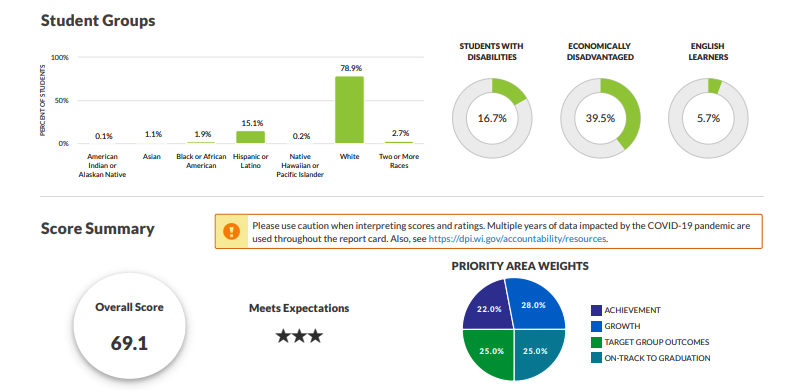
The graphic above, as supplied by the Wisconsin Department of Public Instruction (DPI), shows a portion of the 10-page accountability report card for the School District of Fort Atkinson in the 2022-23 school year.
DPI releases 2022-23 ACT, PreACT Secure, Forward Exam scores
(Originally published Nov. 18, 2023.)
By Kim McDarison
The Wisconsin Department of Public Instruction (DPI) has released ACT, PreACT Secure and Forward exam scores earned by students during the 2022-23 school year in districts from across the state.
The scores, which were released last month, offer data from the three exams which together comprise the Wisconsin Student Assessment System (WSAS).
According to information released regarding student test scores across the state, “standardized testing results for the 2022-23 school year show Wisconsin public school students are continuing to recover in proficiency rates after the learning disruption caused by the COVID-19 pandemic.”
As stated in the release, “public school student proficiency rates in English language arts and mathematics were at 38.9 percent and 37.4 percent, respectively, for 2022-23. This data represents an overall improvement in public school student achievement in comparison to the previous two school years — 2020-21 and 2021-22 — though testing data indicates proficiency rates are not yet back to pre-pandemic levels, with the exception of an increase in proficiency in the ELA section of the ACT. Public-school student subgroups also experienced increases in proficiency when compared to 2021-22. Students participating in the state’s Private School Choice Programs had proficiency rates of 22.1 percent (ELA) and 17.9 percent (mathematics) in 2022-23.”
Additionally, the release noted: “A 2021 study by the U.S. Department of Education found performance level expectations in Wisconsin are among the highest in the nation compared to proficiency standards of the National Assessment of Educational Progress (NAEP).
“Statewide participation rates for public school students increased about 1 percentage point from 2021-22 to approximately 95% of eligible students being tested, while PSCP student participation declined 2 percentage points from the previous school year to approximately 80% for 2022-23.”
Further, the release noted, testing data released in October is part of the Wisconsin Student Assessment System (WSAS), a statewide program designed to provide information about what students know in core academic areas at a given time and to help educators and schools understand where additional support may be needed.
The WSAS includes the Forward Exam given in Grades 3-8 and 10, the PreACT Secure given in Grades 9 and 10, the ACT with writing in Grade 11, and Dynamic Learning Maps, which is given across all tested grades to students with the most significant cognitive disabilities. Results from the WSAS are a foundational component of the state-legislated school and district report cards.
A story about the report card data released this month is here: https://fortatkinsononline.com/dpi-releases-2022-23-district-school-report-cards/.
“These standardized, large-scale assessments represent only one measure of student achievement, and should be used in conjunction with other measures to provide a full picture of student learning. It is advised to use caution when comparing assessment data for groups of students across years as differences between years in test participation rates and/or the makeup of student groups are important considerations when interpreting proficiency rates,” the release stated.
State and district averages
ACT (taken by all students in grade 11)
According to the information made available on the DPI website, the statewide composite average score for all students in grade 11 taking the ACT during the 2022-23 school year was 19.3. The score is slightly up from the 2021-22 school year, when it was reported at 19.2.
The highest score a student can achieve on the test is 36.
According to statistics collected by worldpopulationreview.com, a listing of composite ACT scores earned by students within each U.S. state, compiled in 2023, reports an average composite score in Wisconsin of 19.4. A state-by-state ranking made by worldpopulationreview.com in 2023 is here: https://worldpopulationreview.com/state-rankings/average-act-score-by-state.
In 2022-23, the average scores earned by 11th-grade students taking the ACT exam, served by school districts within the broader Fort Atkinson Online readership area, followed by the same score earned by students within each district last year, are as follows:
Fort Atkinson: 19.9, up from last year’s score of 19.3
Lake Mills: 19.8, up from last year’s score of 19.2
Elkhorn: 19.2, up from last year’s score of 19.1
Milton: 20.2, up from last year’s score of 18.9
Palmyra-Eagle: 17.6, down from last year’s score of 18.5
Watertown: 18.6, up from last year’s score of 18.3
Jefferson: 17.7, down from last year’s score of 18.2
Janesville: 17.8, down from last year’s score of 18.2
Whitewater: 17.2, down from last year’s score of 17.6
Delavan-Darien: 17.3, up from last year’s score of 17
PreAct Secure (taken by students in grades 9 and 10)
Last school year, students in grades 9 and 10 were given the ACT Aspire test. The average ACT Aspire score earned by all students statewide taking the exam in the area of English language arts in 2021-22 among ninth-graders was 425.2 and 10th-graders, 426.8.
The highest score a student can earn is 460.
This year, according to information released by DPI in its October news release, students in grades 9 and 10 took the PreACT Secure exam.
According to information found on the DPI website, the PreAct Secure “is a summative assessment given to 9th and 10th grade students, that is aligned to the ACT and ACT College and Career Readiness Standards. PreACT Secure measures what students have learned in the areas of English, reading, mathematics and science.”
The site notes that the exam “closely mirrors the ACT.”
During the 2022-23 school year, the average scores earned by ninth- and tenth-grade students taking the PreACT secure exam within school districts across the broader Fort Atkinson Online readership area, are shown below. The scores are broken into two categories: language arts and mathematics.
Fort Atkinson: Language arts, ninth-graders, 16.1; tenth-graders, 18.4, and mathematics, ninth-graders, 16.8; tenth-graders, 18.9
Lake Mills: Language arts, ninth-graders, 17.5; tenth-graders, 18.8, and mathematics, ninth-graders, 18.5; tenth-graders, 19.0
Elkhorn: Language arts, ninth-graders, 16.8; tenth-graders, 18.2, and mathematics, ninth-graders, 17.4; tenth-graders, 18.7
Milton: Language arts, ninth-graders, 16.9; tenth-graders, 17.8, and mathematics, ninth-graders, 17.8; tenth-graders, 18.0
Palmyra-Eagle: Language arts, ninth-graders, 14.6; tenth-graders, 16.3, and mathematics, ninth-graders, 17.1; tenth-graders, 18.0
Watertown: Language arts, ninth-graders, 16.4; tenth-graders, 16.9, and mathematics, ninth-graders, 17.3; tenth-graders, 18.6
Jefferson: Language arts, ninth-graders, 16.1; tenth-graders, 17.0, and mathematics, ninth-graders, 16.2; tenth-graders, 17.6
Janesville: Language arts, ninth-graders, 15.6; tenth-graders, 16.5, and mathematics, ninth-graders, 16.2; tenth-graders, 17.0
Whitewater: Language arts, ninth-graders, 15.2; tenth-graders, 15.9, and mathematics, ninth-graders, 16.2; tenth-graders, 17.9
Delavan-Darien: Language arts, ninth-graders, 15.2; tenth-graders, 16.7, and mathematics, ninth-graders, 16.7; tenth-graders, 17.4
Forward Exam (taken by students in Grades 3-8 and 10)
The Forward Exam is administered to students statewide in grades 3-8 in the subjects of English language arts and math; grades 4 in science, and grades 4, 8 and 10 in social studies. Results are calculated using a “scale score.”
State averages
In 2022-23, average statewide Forward Exam scores are as follows:
• English language arts, grade 3, 553, up from last year’s score of 551; grade 4, 585, up from last year’s score of 579; grade 5, 594, slightly up from last year’s score of 595; grade 6, 605, up from last year’s score of 603; grade 7, 623, up from last year’s score of 619, and grade 8, 629, up from last year’s score of 623.
• Math, grade 3, 554, which is the same as last year’s score; grade 4, 578, up from last year’s score of 575; grade 5, 603, up from last year’s score of 601; grade 6, 612, up from last year’s score of 606; grade 7, 621, up from last year’s score of 618, and grade 8, 639, up from last year’s score of 636.
• Science, grade 4, 497, which is the same as last year’s score.
•Social studies, grade 4, 500, slightly down from last year’s score of 501; grade 8, 701, slightly up from last year’s score of 700, and grade 10, 797, slightly down from last year’s score of 799.
Forward scores in Fort Atkinson
Students taking the Forward exam in Fort Atkinson on average earned the following scores:
English language: grade 3, 564, down from last year’s score of 559; grade 4, 604, up from last year’s score of 590; grade 5, 606, up from last year’s score of 601; grade 6, 616, down from last year’s score of 618; grade 7, 637, up from last year’s score of 630, and grade 8, 641, up from last year’s score of 635.
Math: grade 3, 558, up from last year’s score of 554; grade 4, 598, up from last year’s score of 581; grade 5, 615, up from last year’s score of 606; grade 6, 615, down from last year’s score of 619; grade 7, 638, up from last year’s score of 626, and grade 8, 653, up from last year’s score of 649.
Science: grade 4, 510, up from last year’s score of 498.
Social studies: grade 4, 515, up from last year’s score of 507; grade 8, 710, up from last year’s score of 702, and grade 10, 812, which is the same score as last year.
Forward scores in Whitewater
Students taking the Forward exam in Whitewater on average earned the following scores:
English language: grade 3, 548, down from last year’s score of 554; grade 4, 568, up from last year’s score of 584; grade 5, 592, up from last year’s score of 590; grade 6, 593, the same as last year’s score; grade 7, 621, up from last year’s score of 614, and grade 8, 621, up from last year’s score of 615.
Math: grade 3, 553, up from last year’s score of 544; grade 4, 570, up from last year’s score of 564; grade 5, 608, up from last year’s score of 591; grade 6, 598, up from last year’s score of 595; grade 7, 613. down from last year’s score of 616, and grade 8, 627, up from last year’s score of 618.
Science: grade 4, 489, down from last year’s score of 504.
Social studies: grade 4, 495, down from last year’s score of 510; grade 8, 699, down from last year’s score of 703, and grade 10, 795, down from last year’s score of 779.
Information about public school performance is made available by school and by district on the WISEdash Public Portal.
Student performance data for Wisconsin’s three parental choice programs are posted via the Parental Choice Program data page.
For more information about student assessment in Wisconsin, visit: https://dpi.wi.gov/assessment.
An earlier story about assessment tools, along with scores earned statewide and within the Fort Atkinson Online readership area last year, is here: https://fortatkinsononline.com/wisconsin-dpi-releases-2021-22-act-act-aspire-forward-exam-scores/.

A graph, as supplied by the Wisconsin Department of Public Instruction, shows average “scale scores” earned by Fort Atkinson students taking the Forward exam in the subject of language arts. The language arts section of the test is administered to students in grades 3-8.


